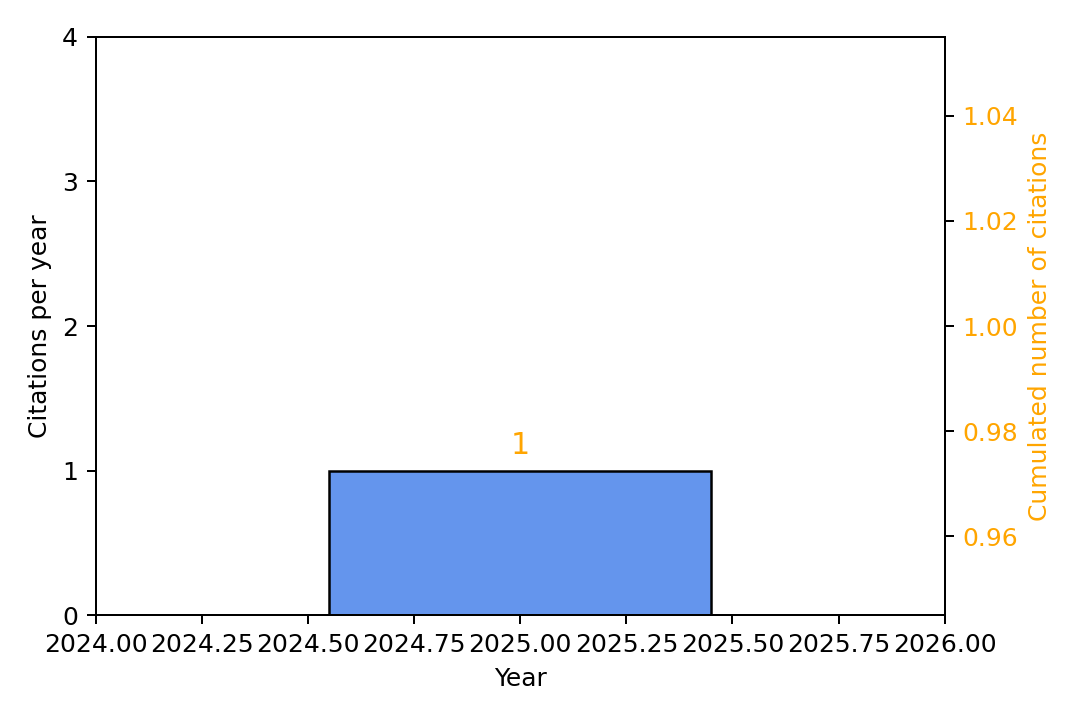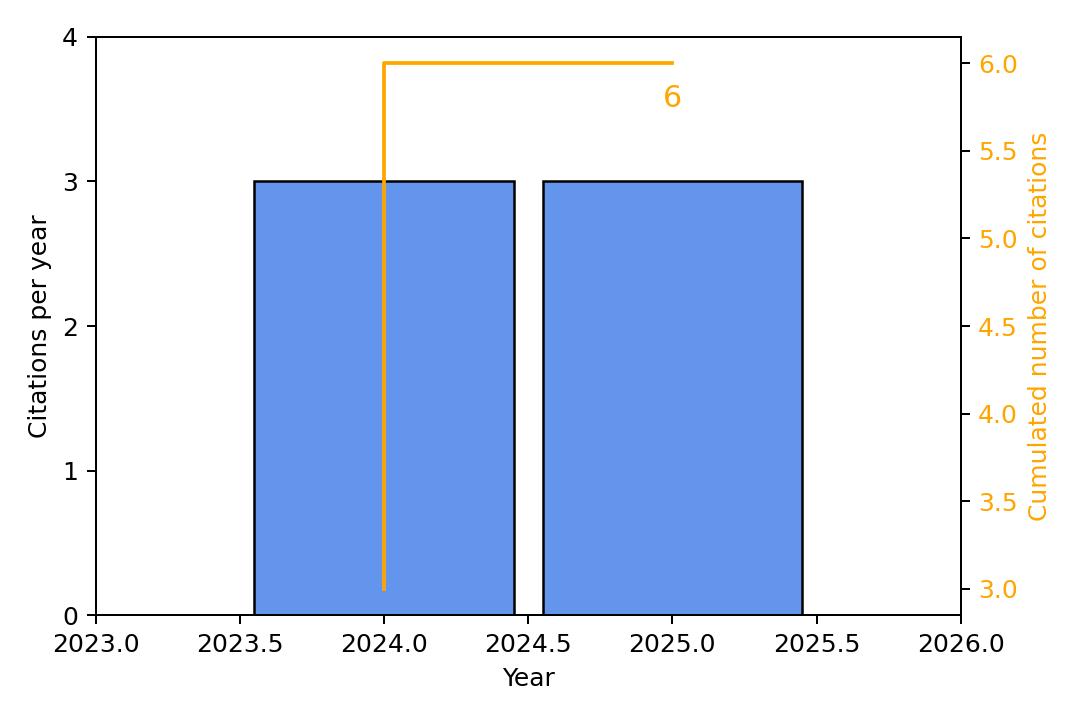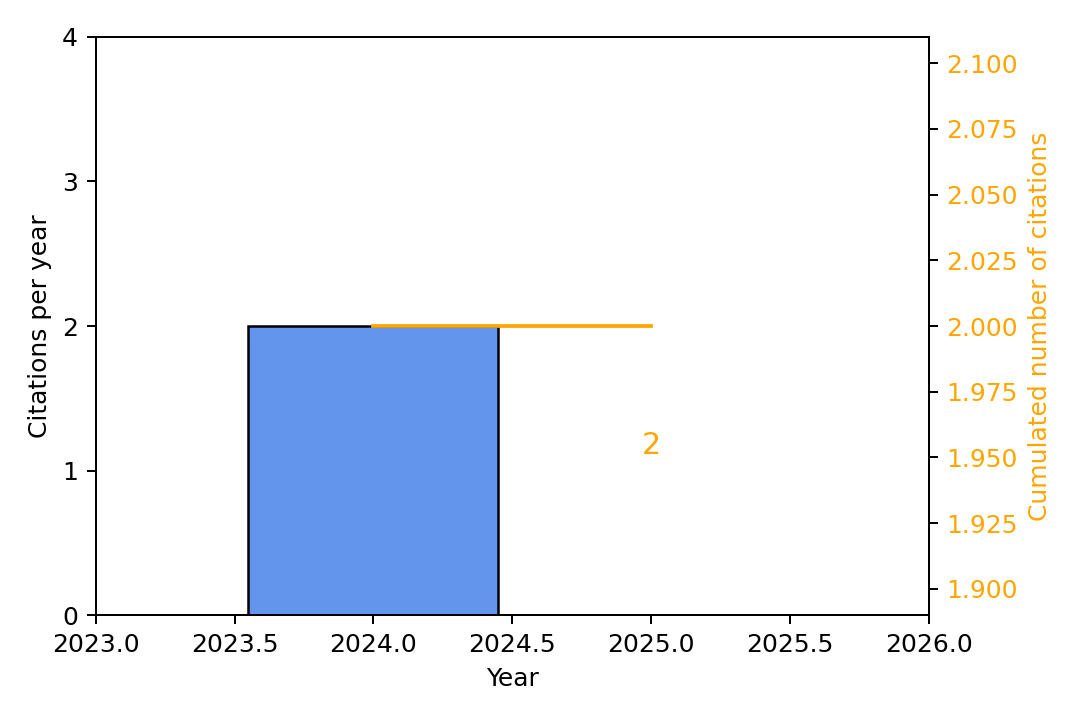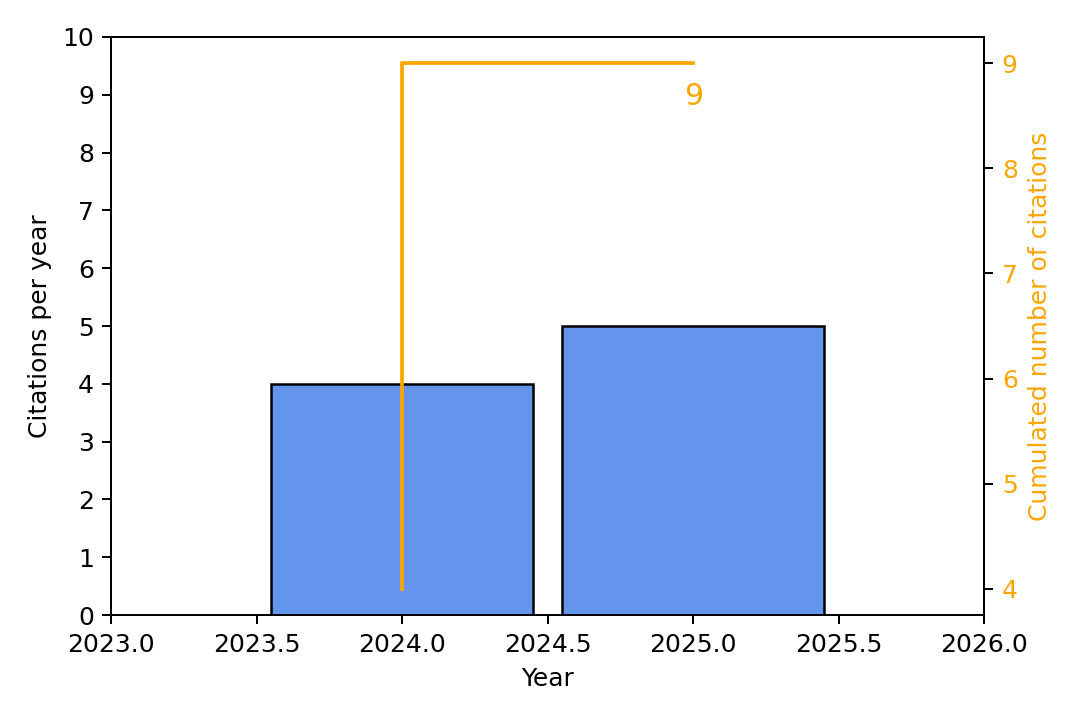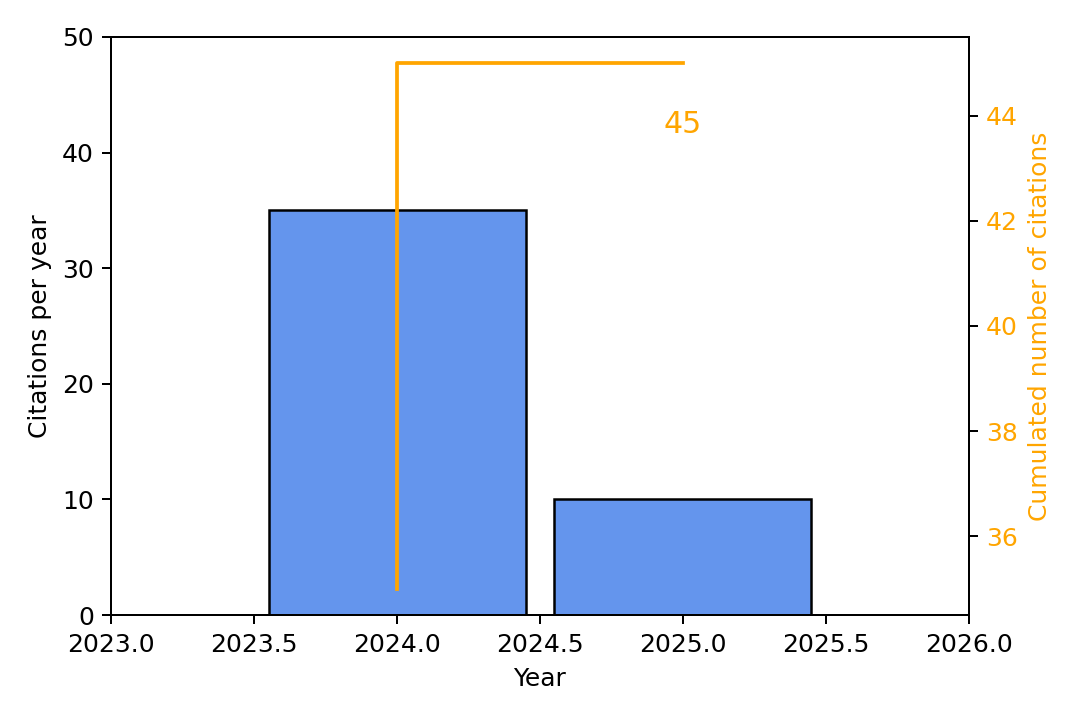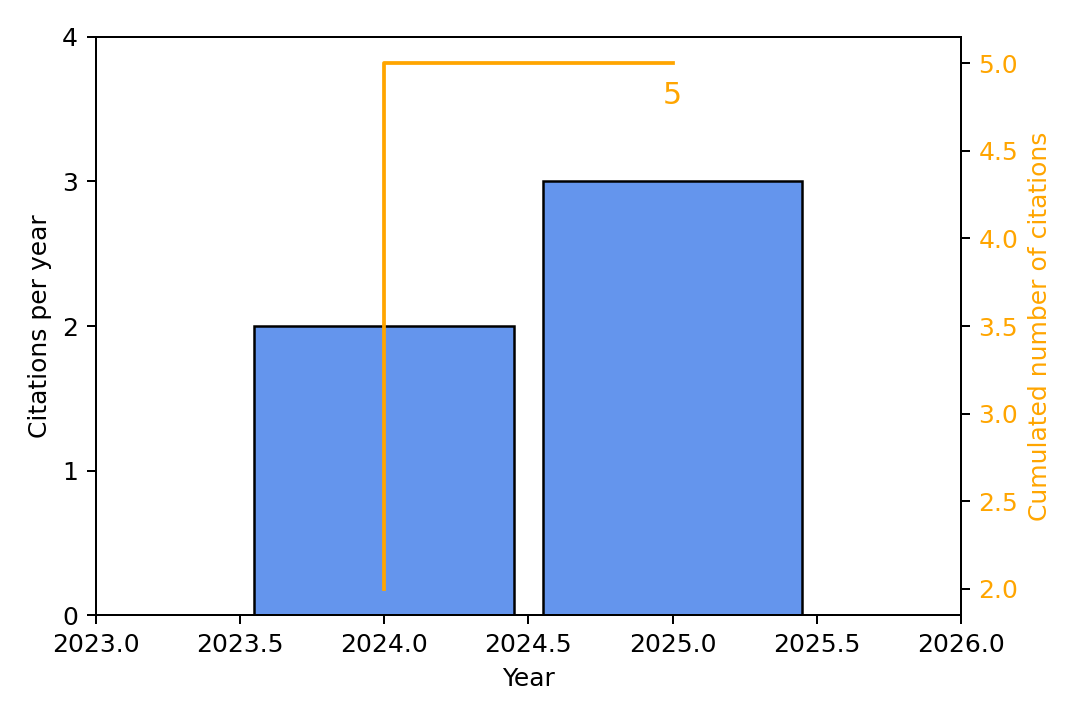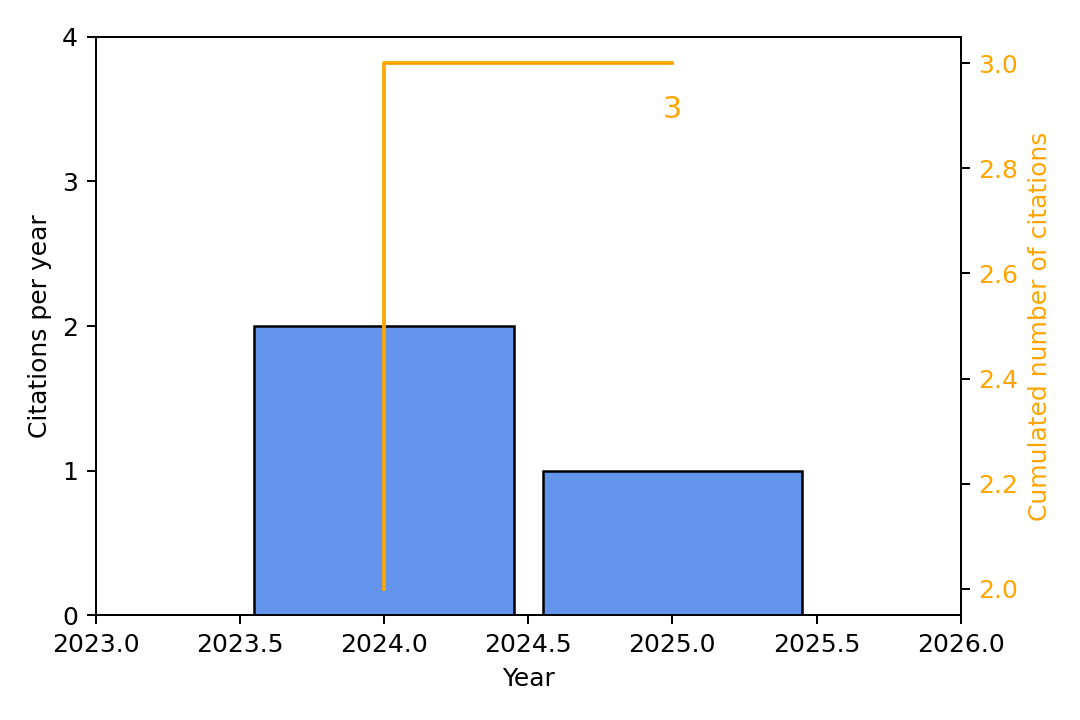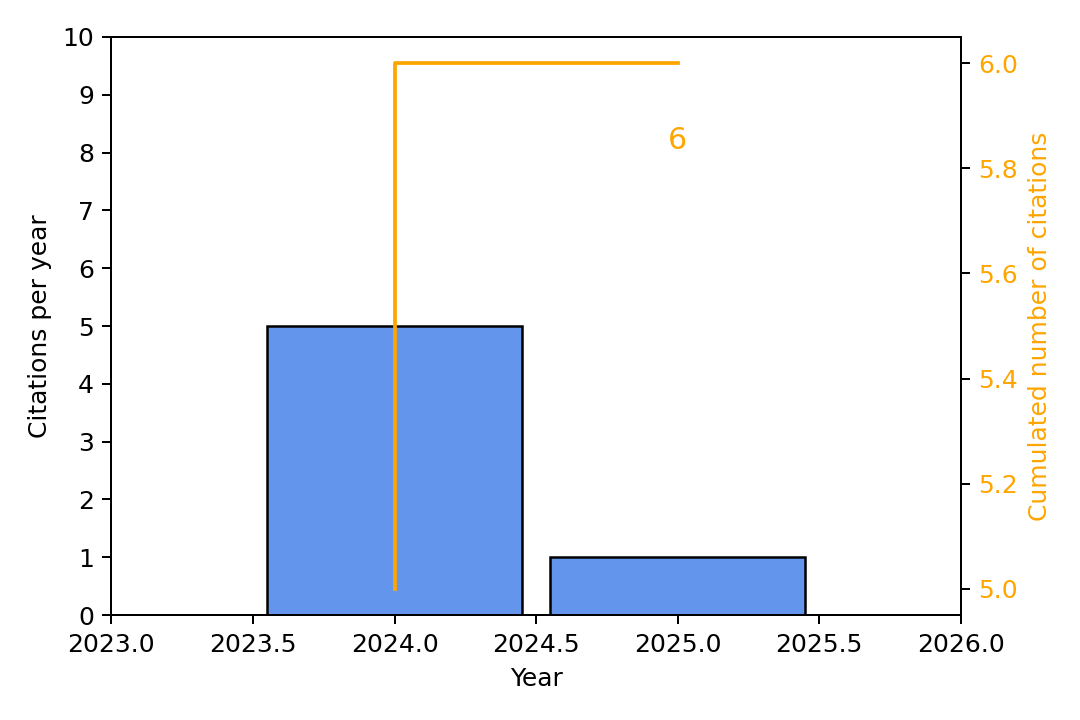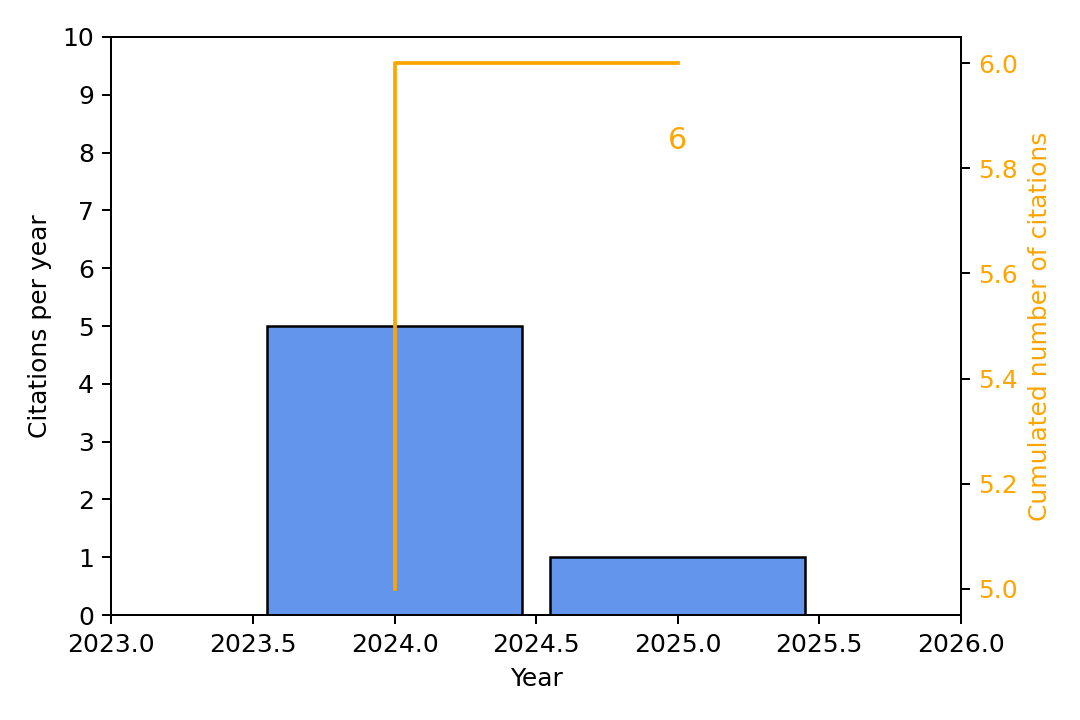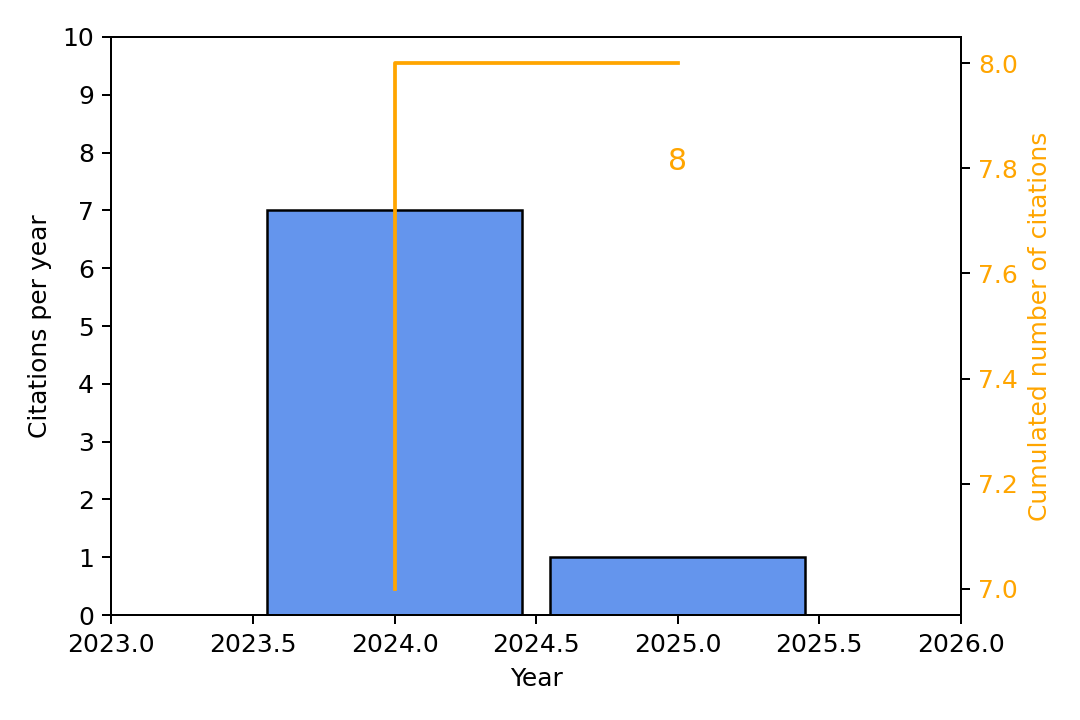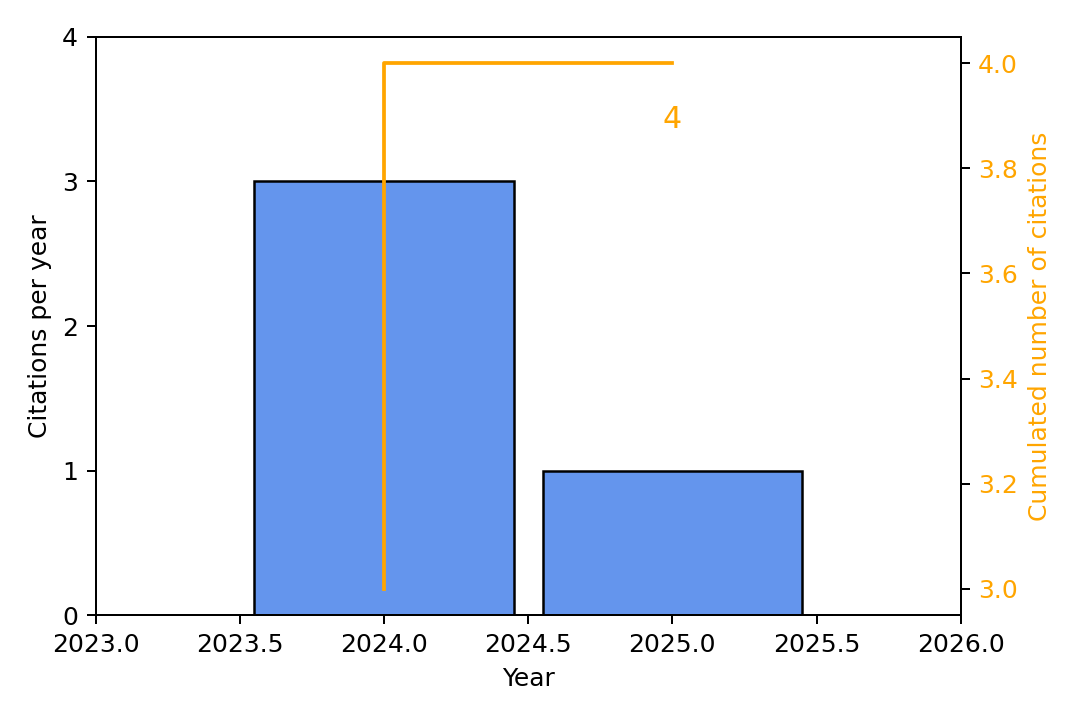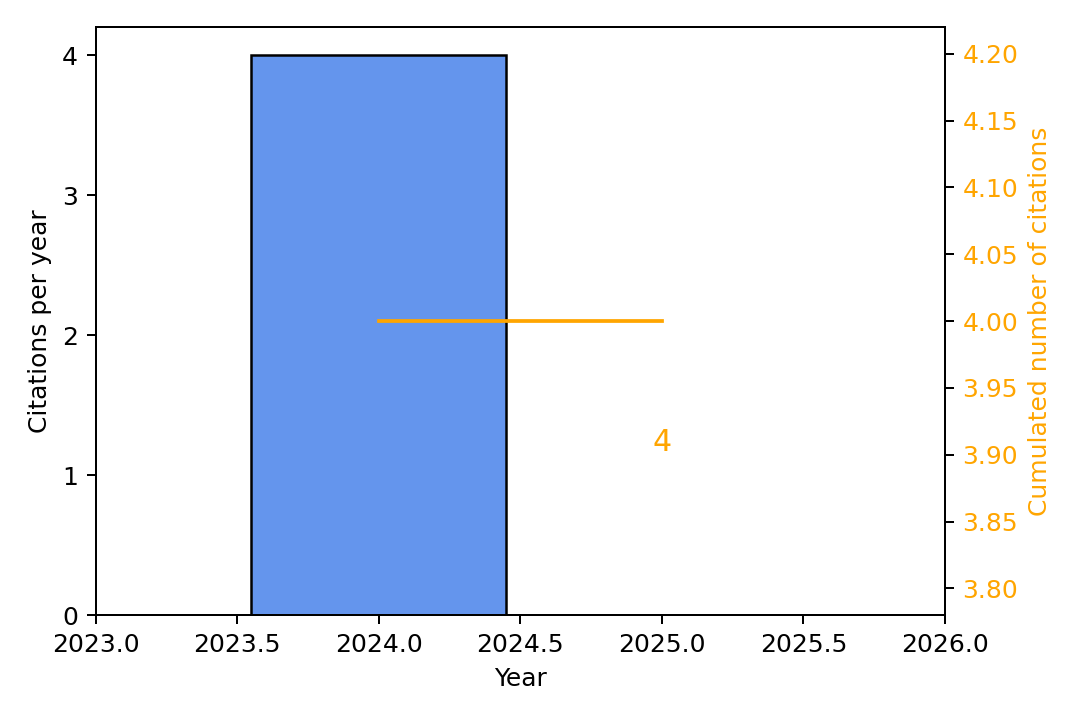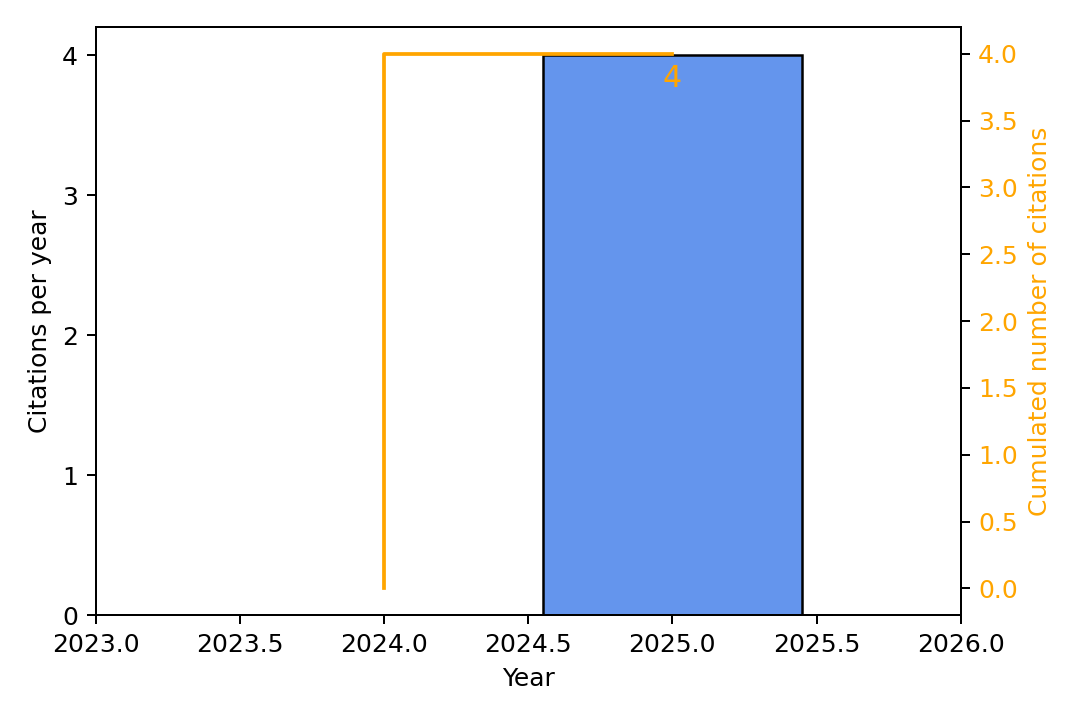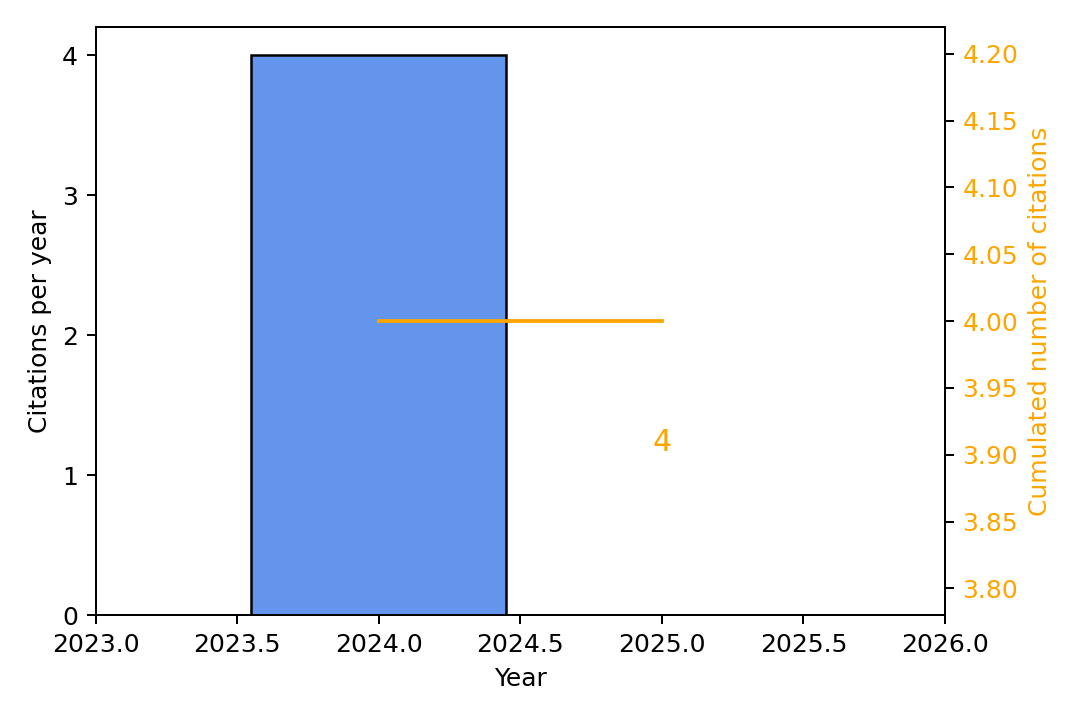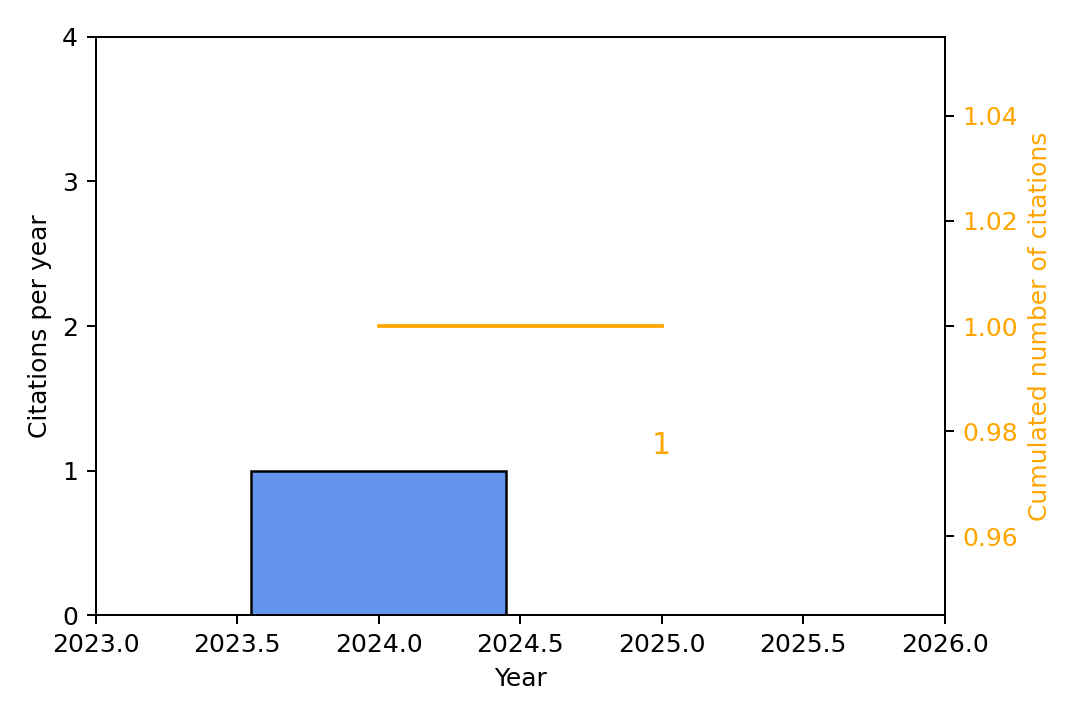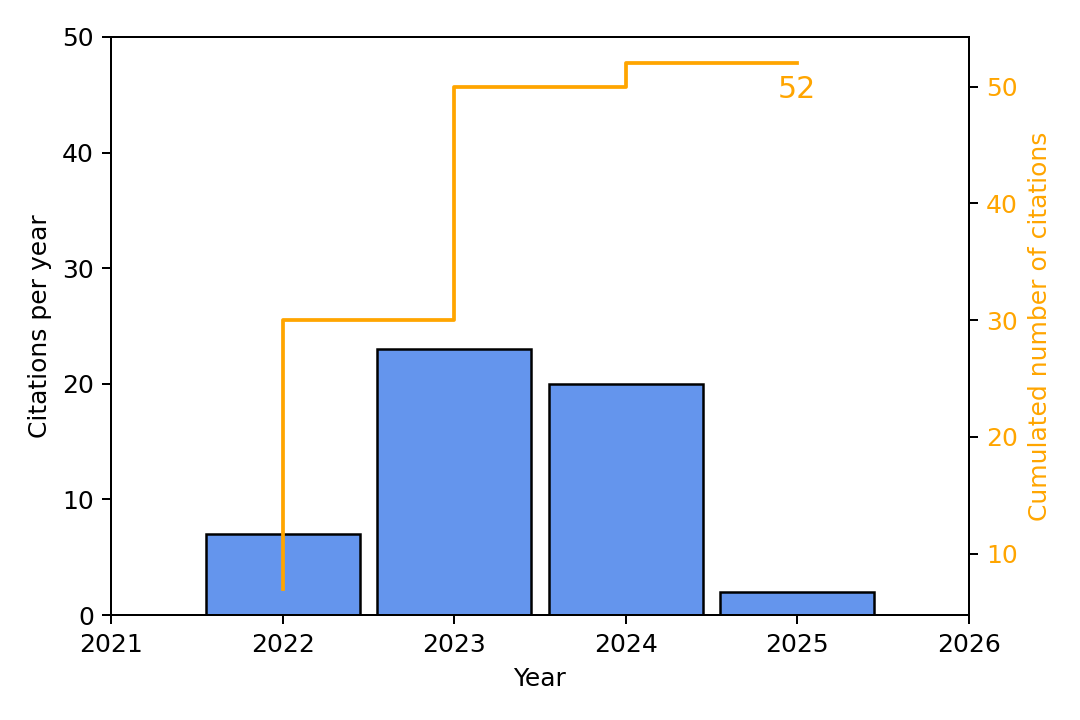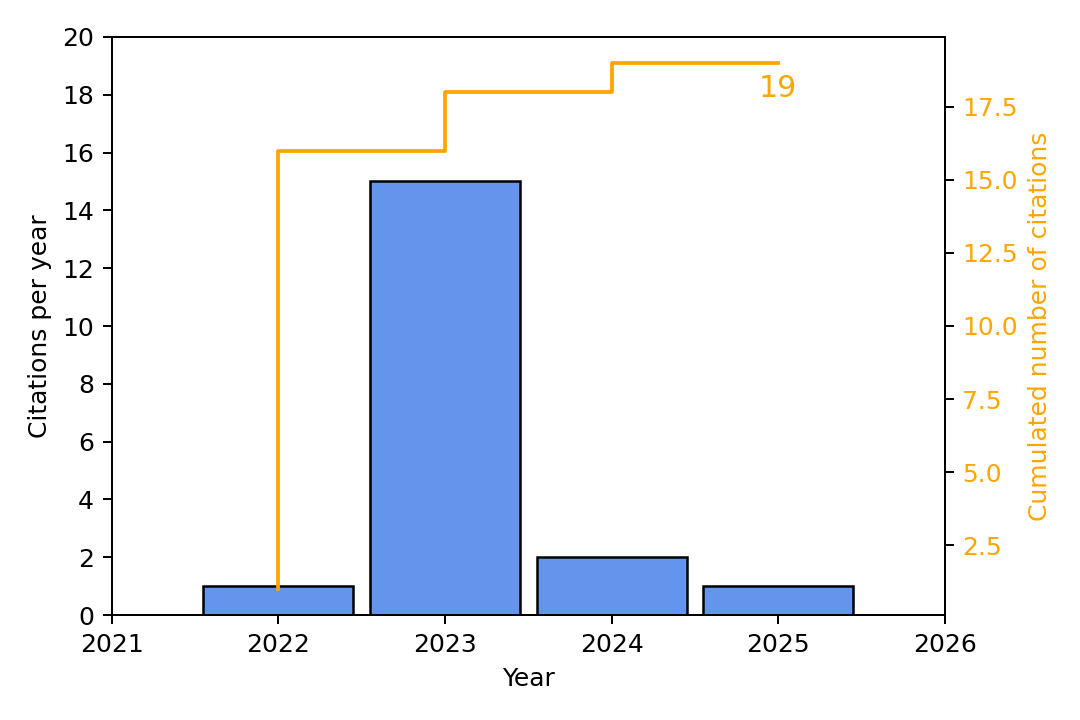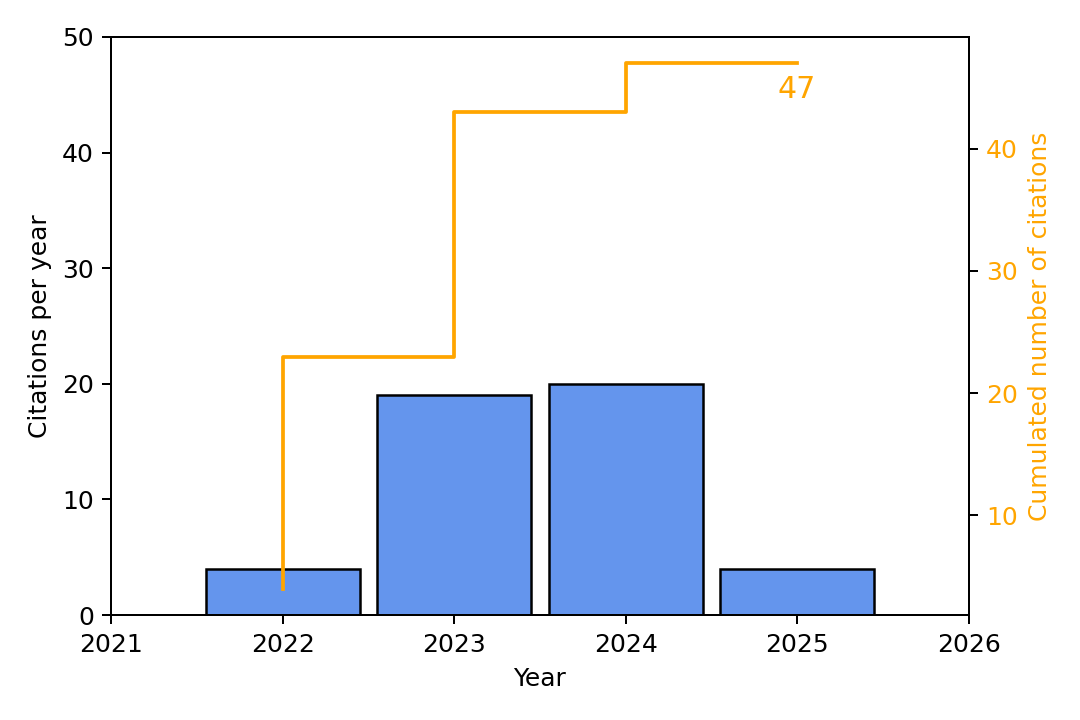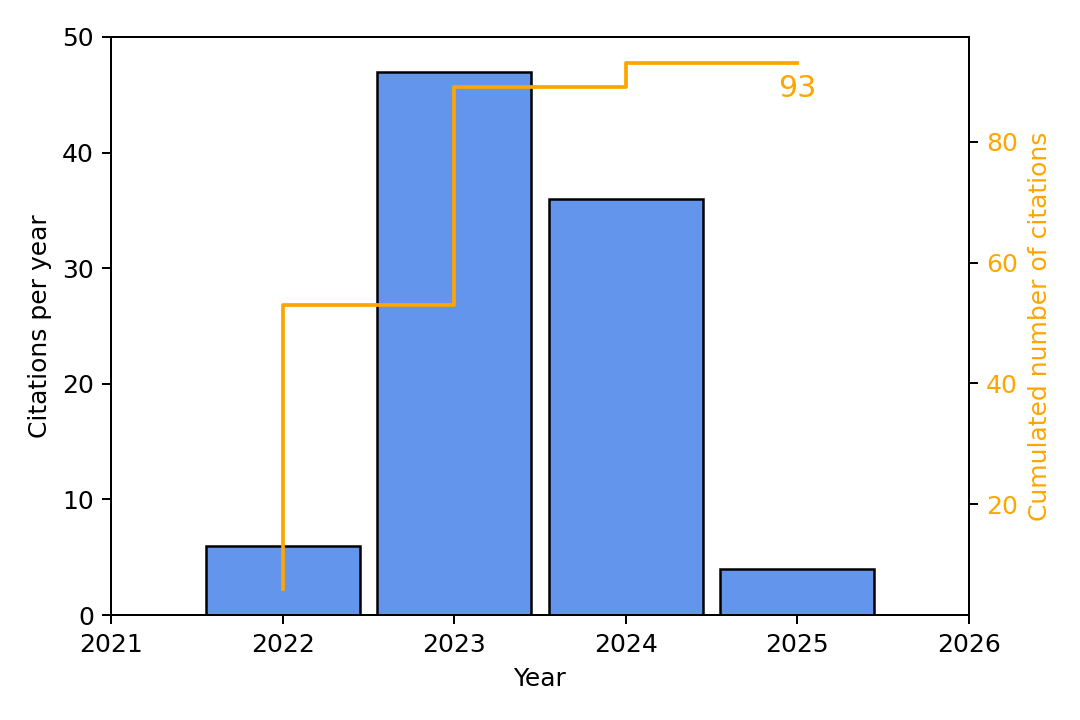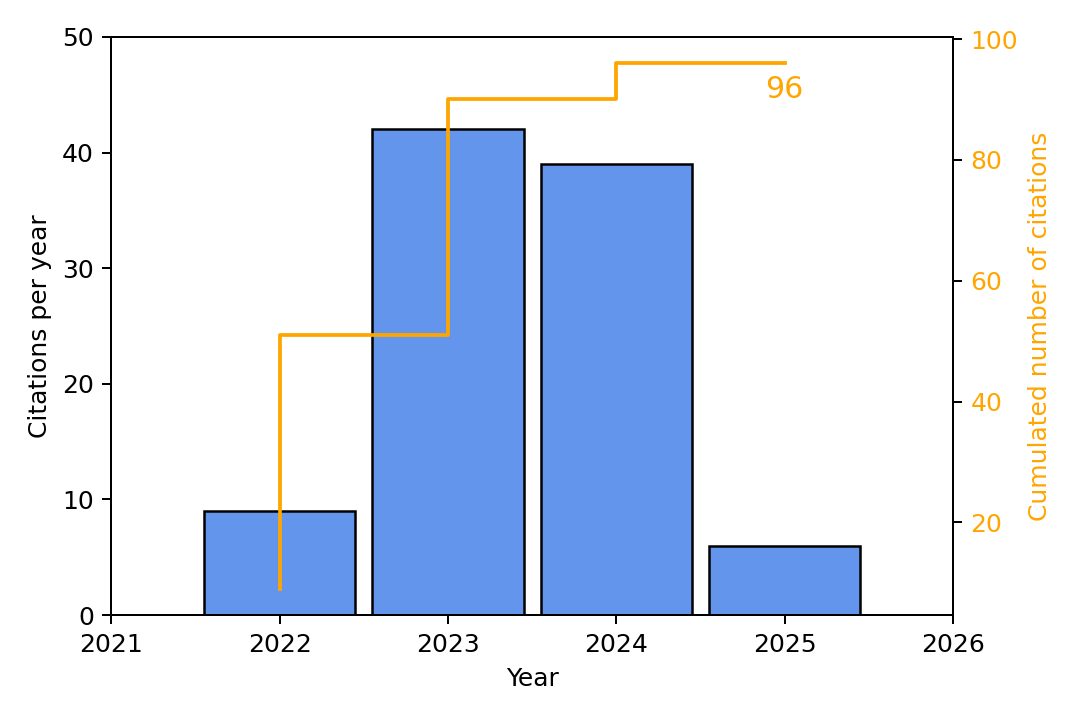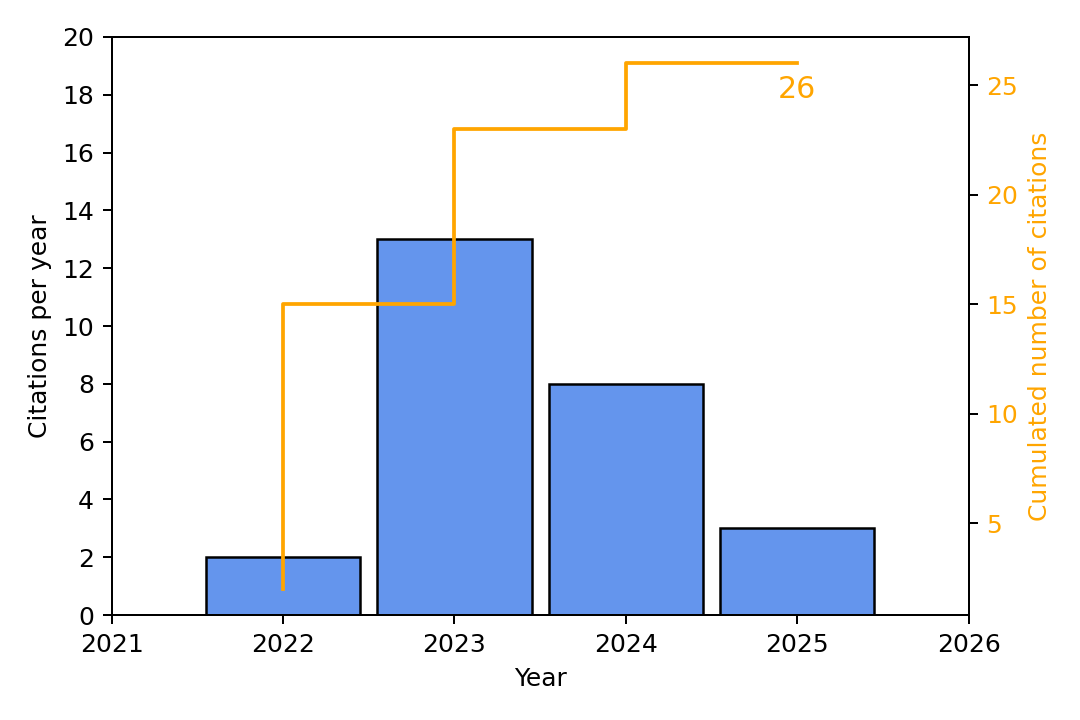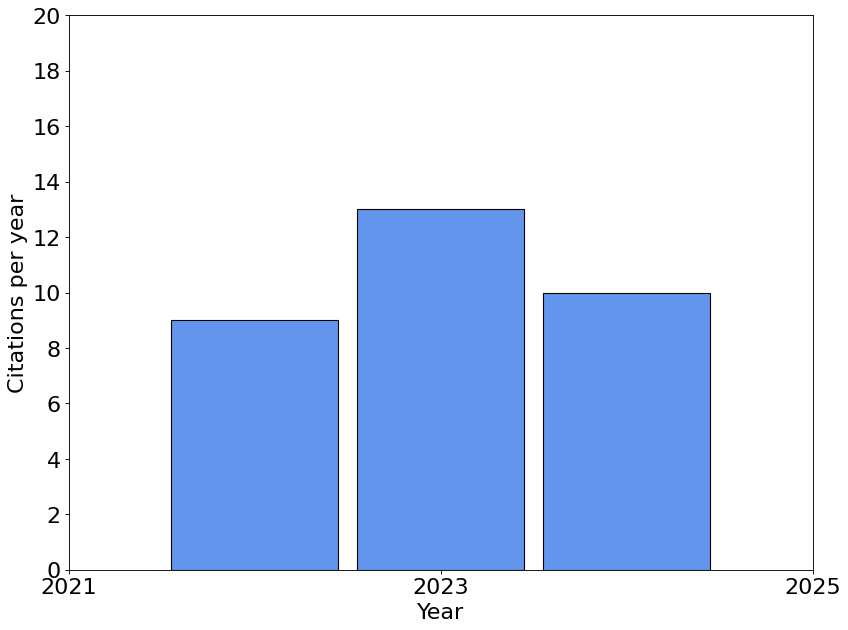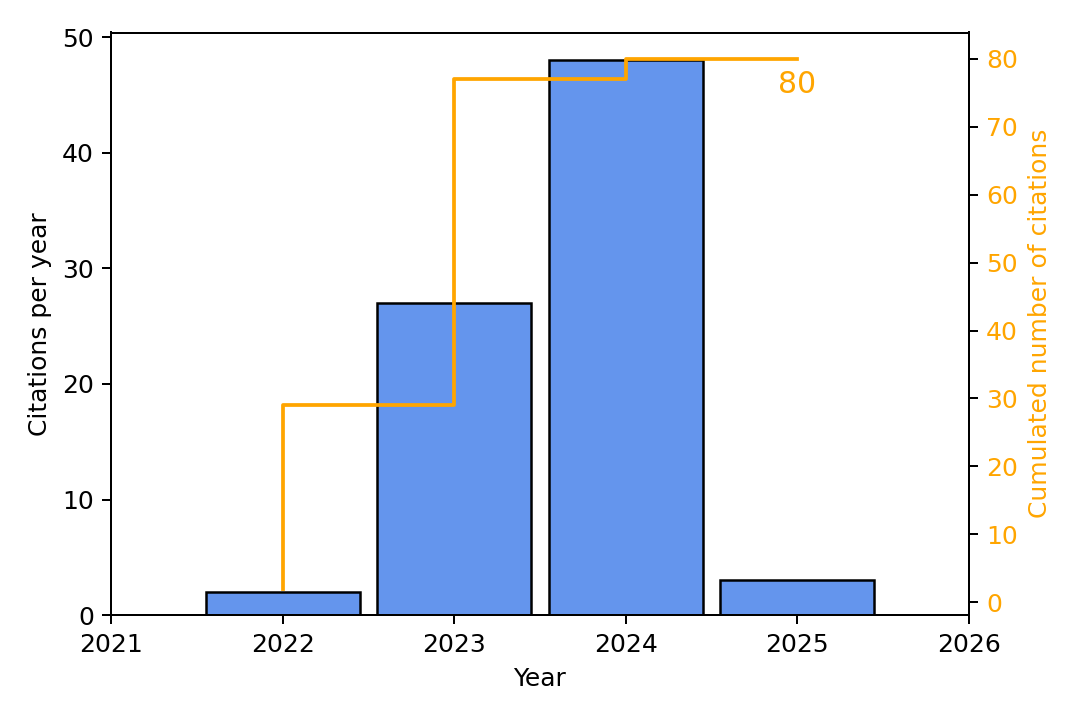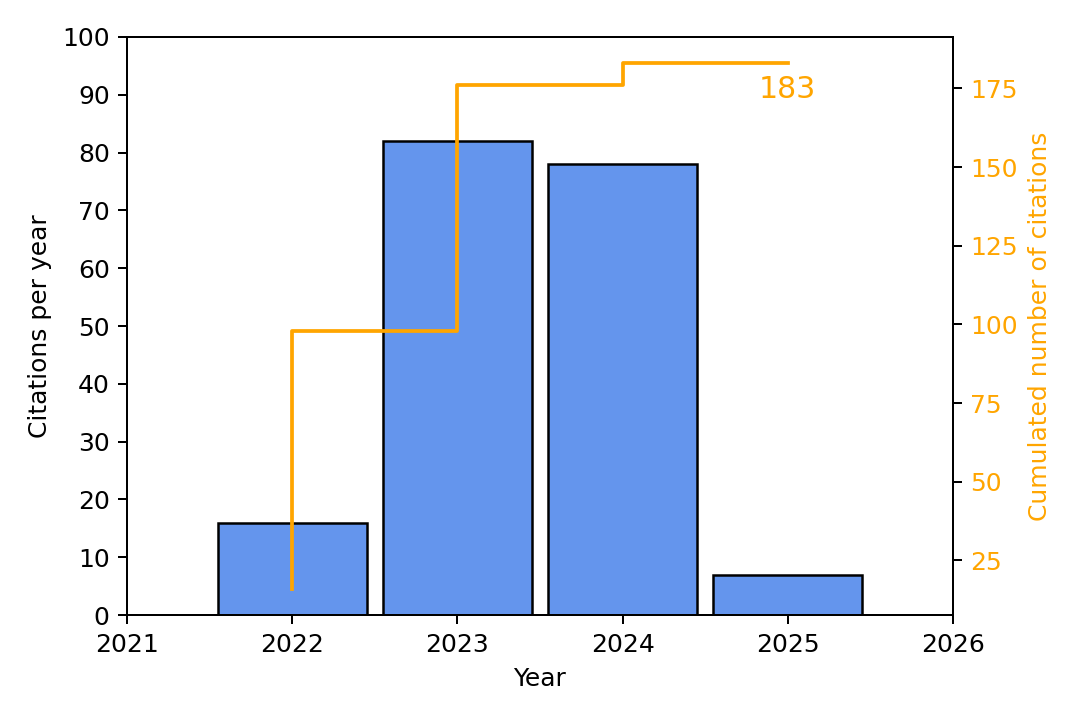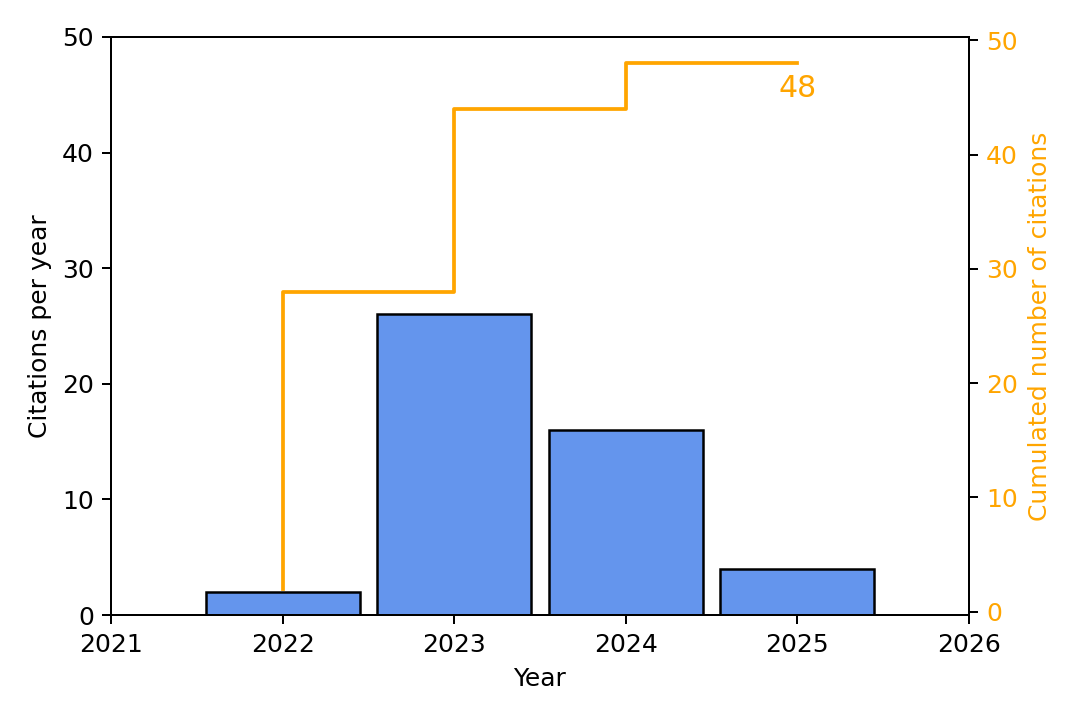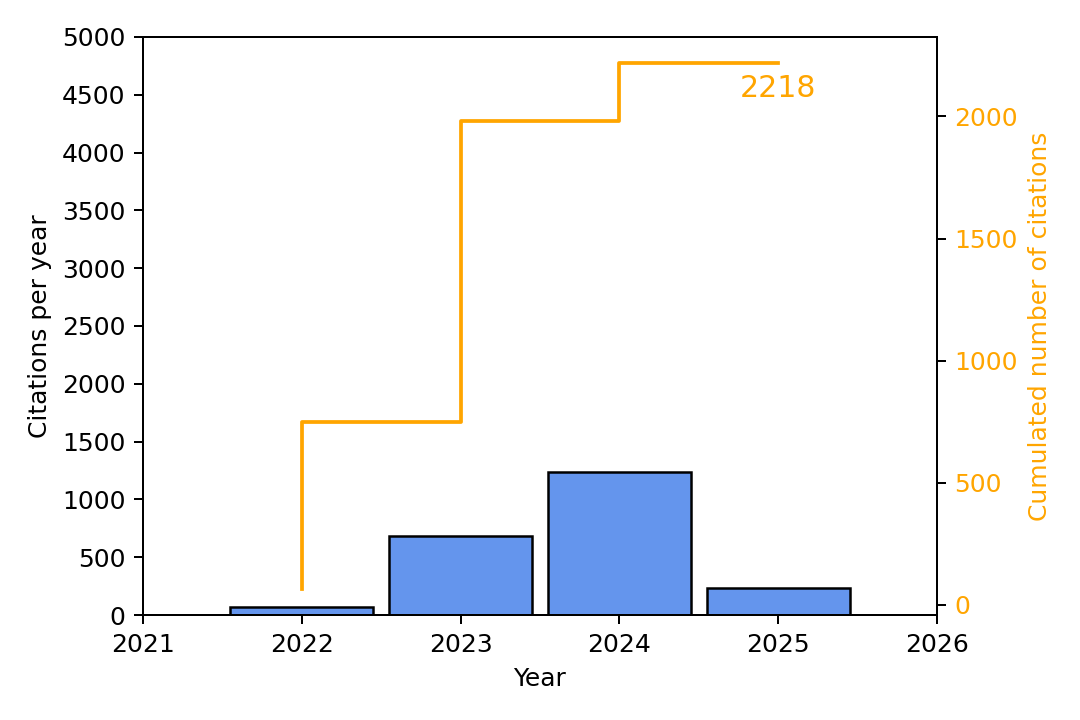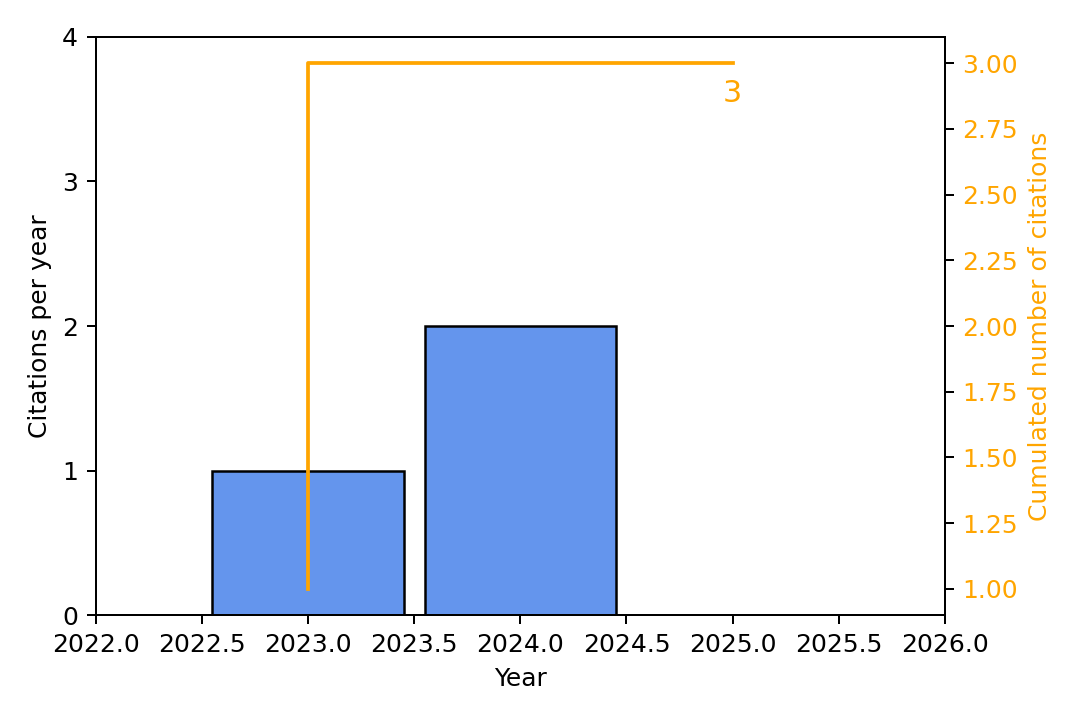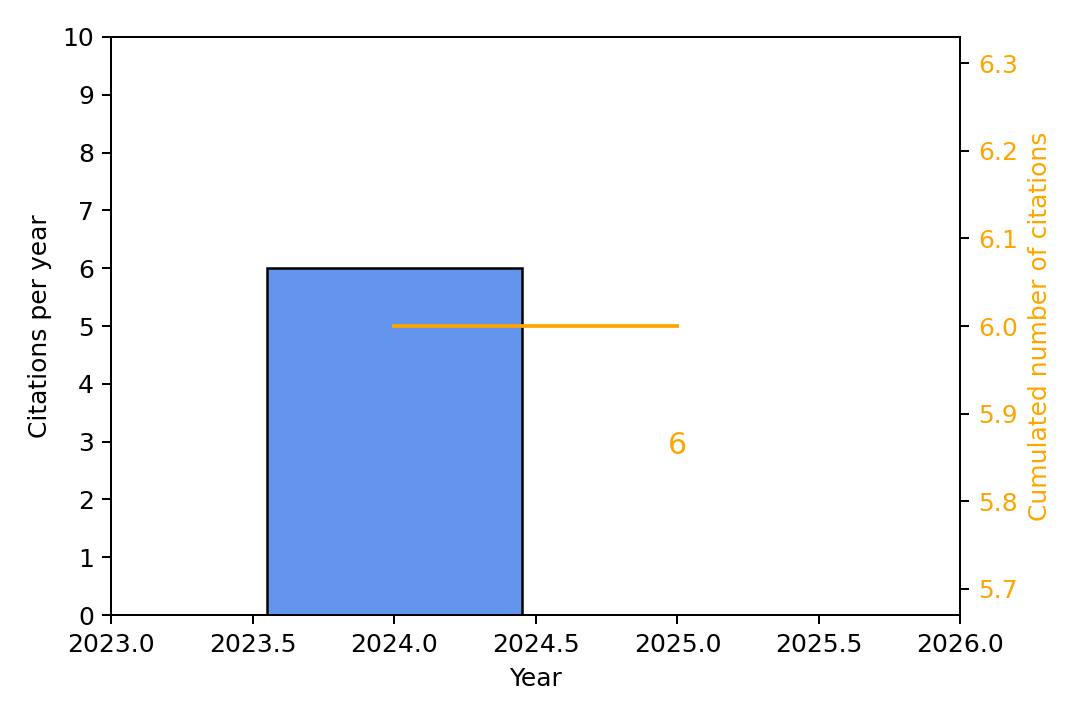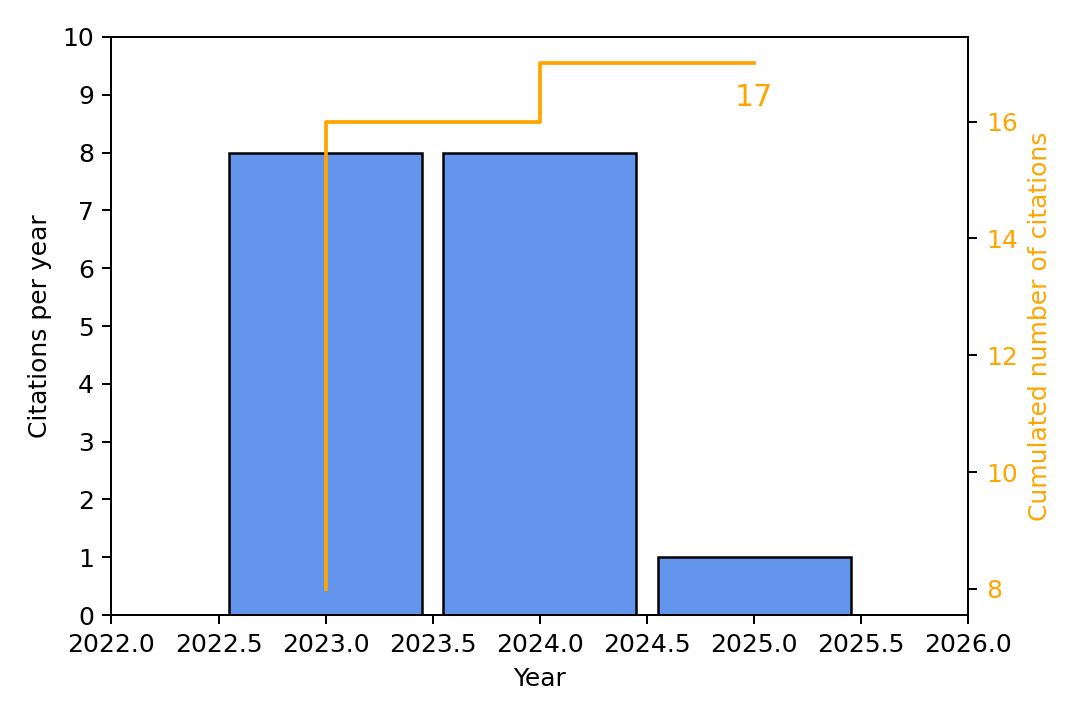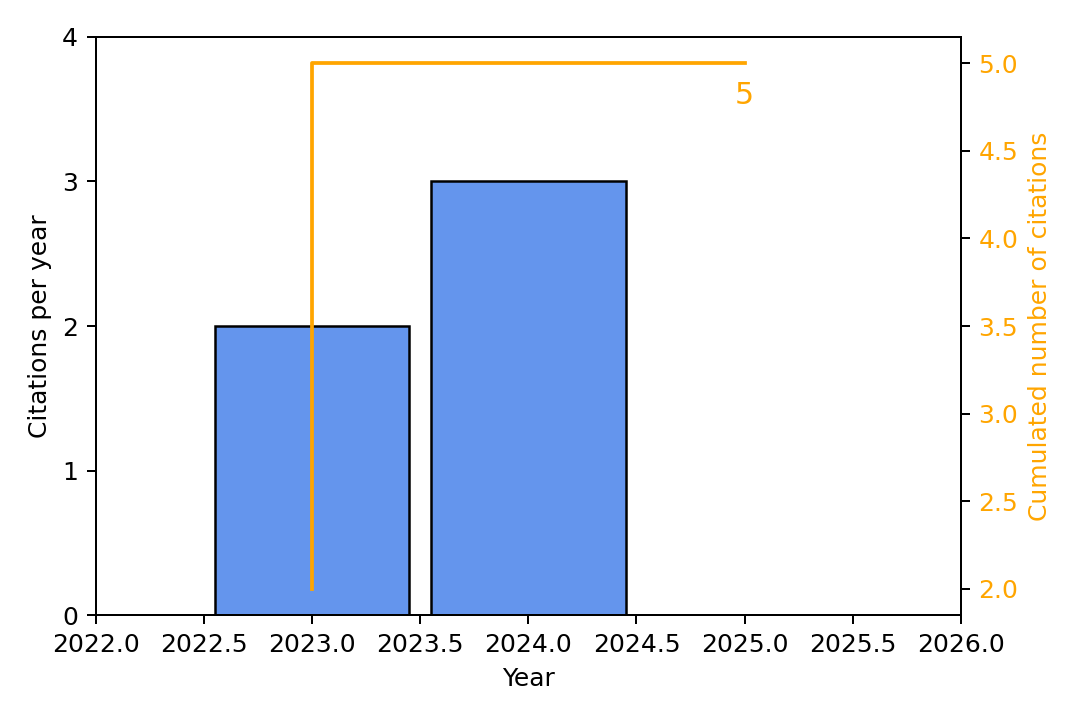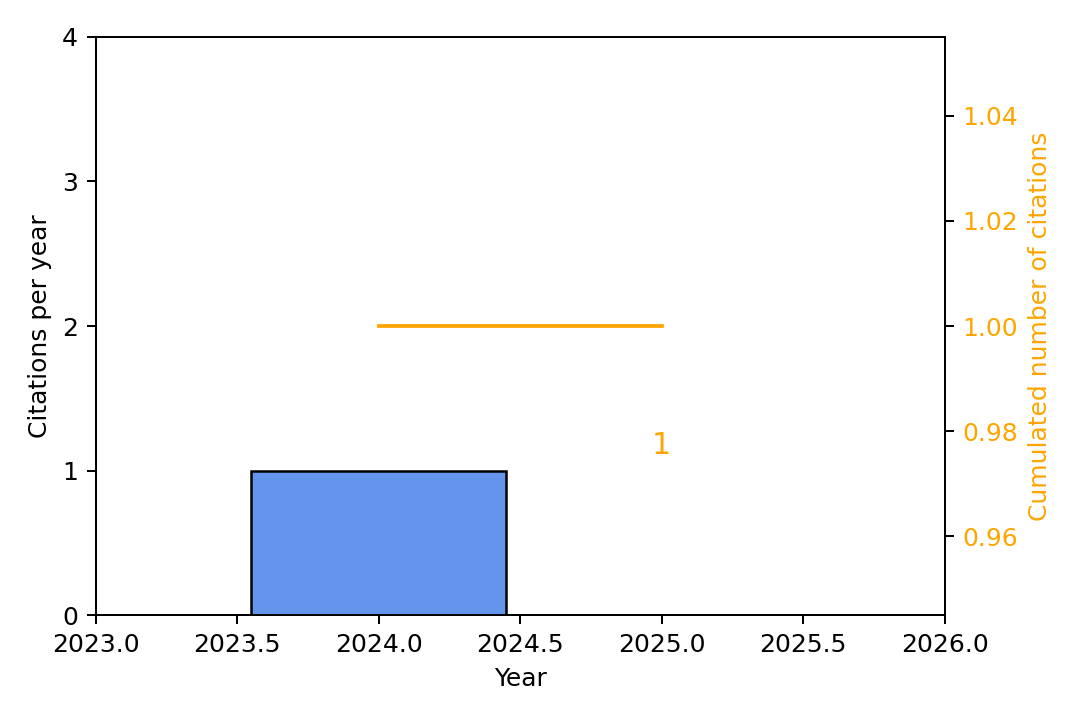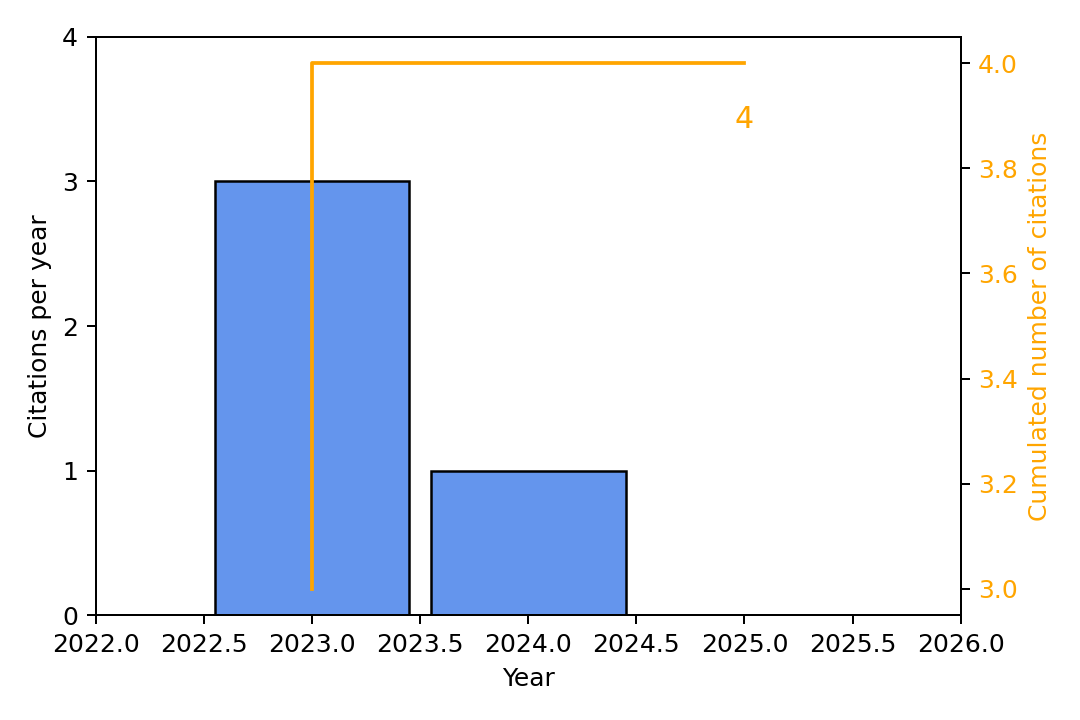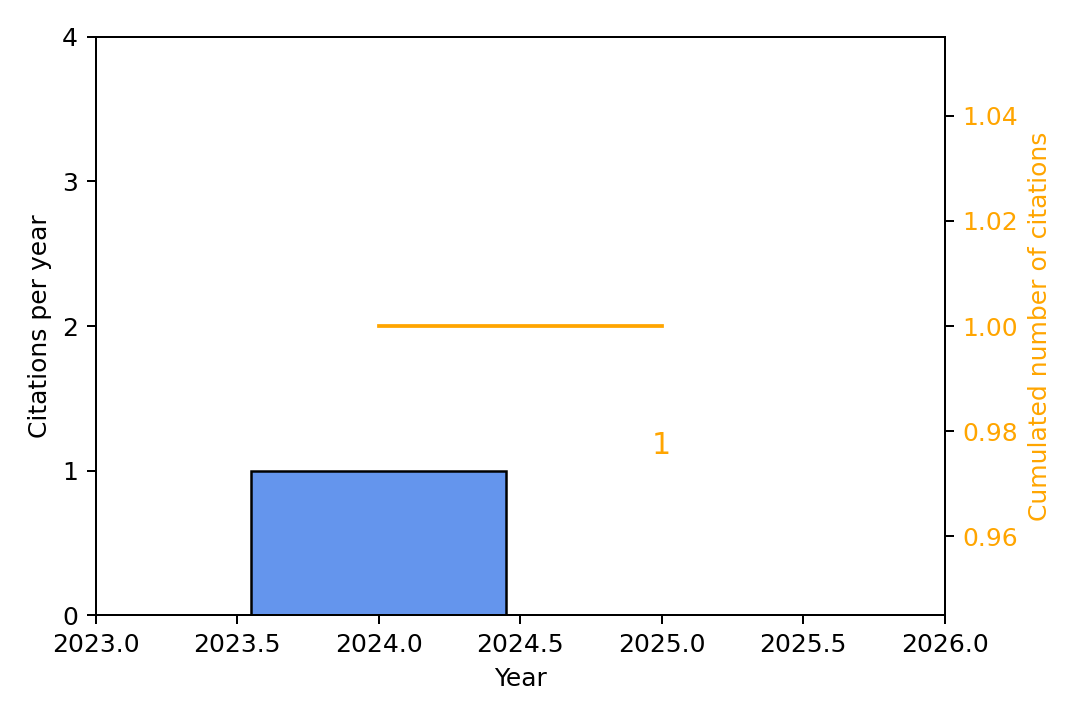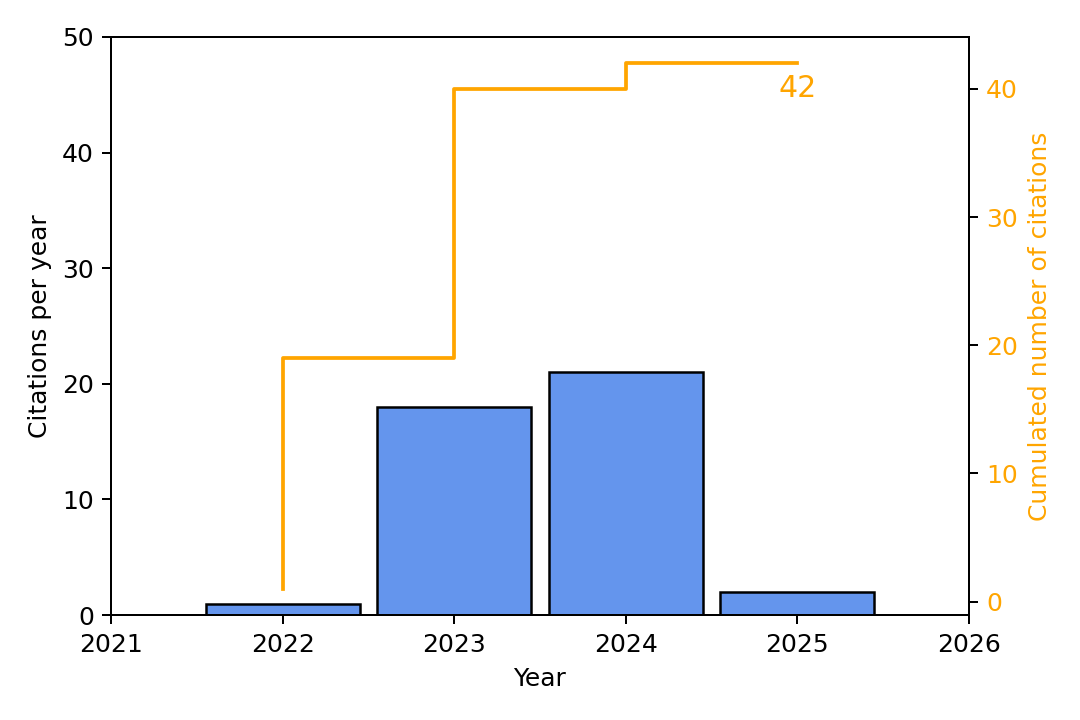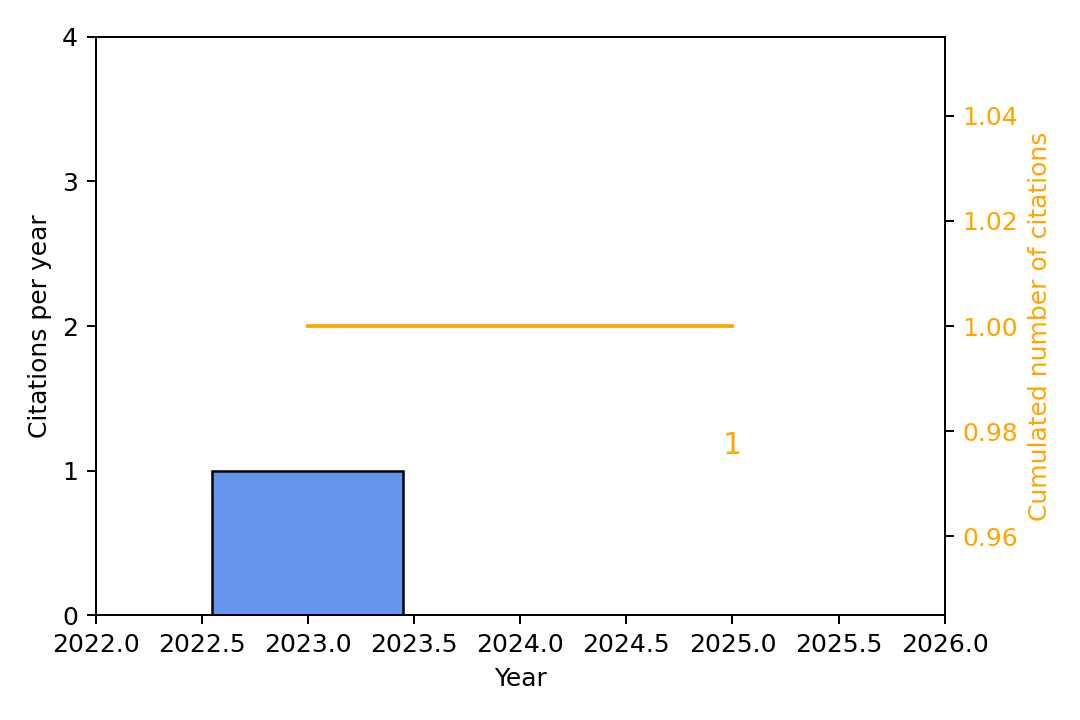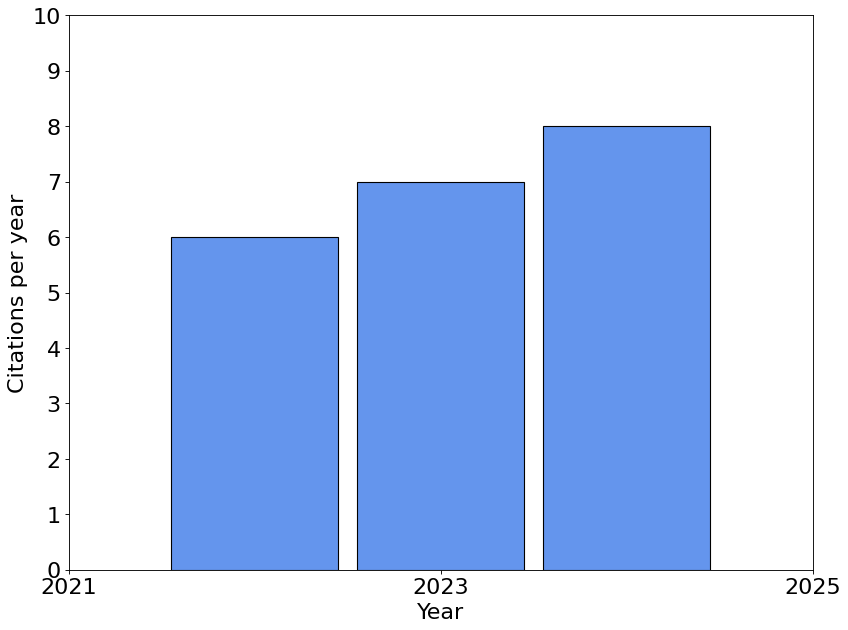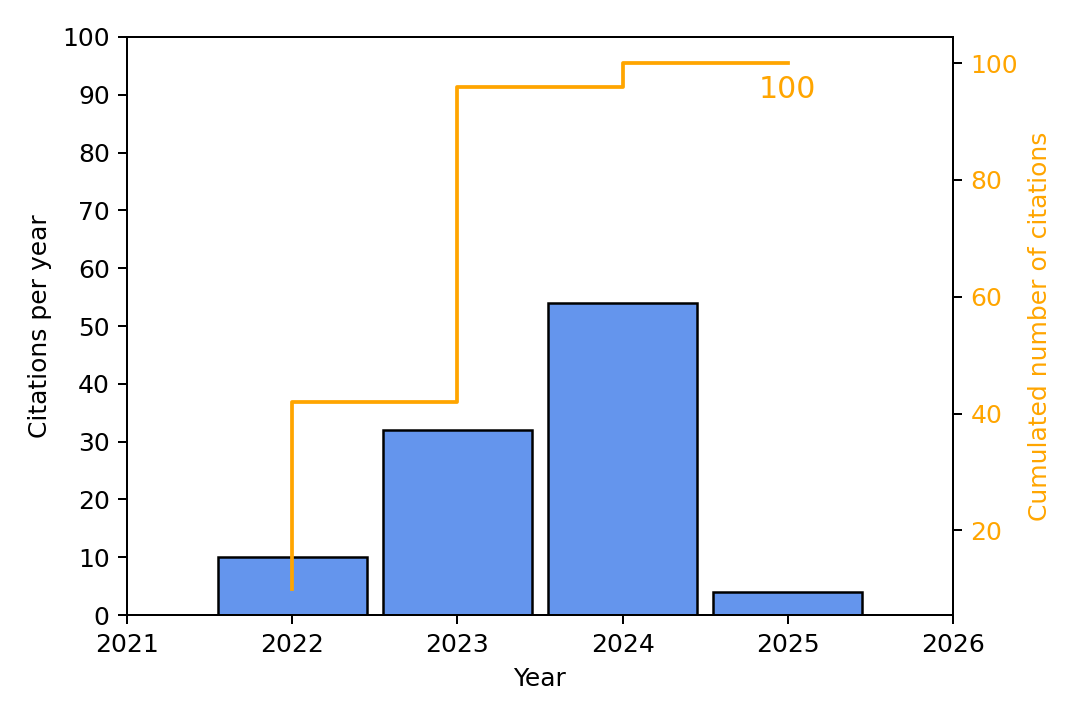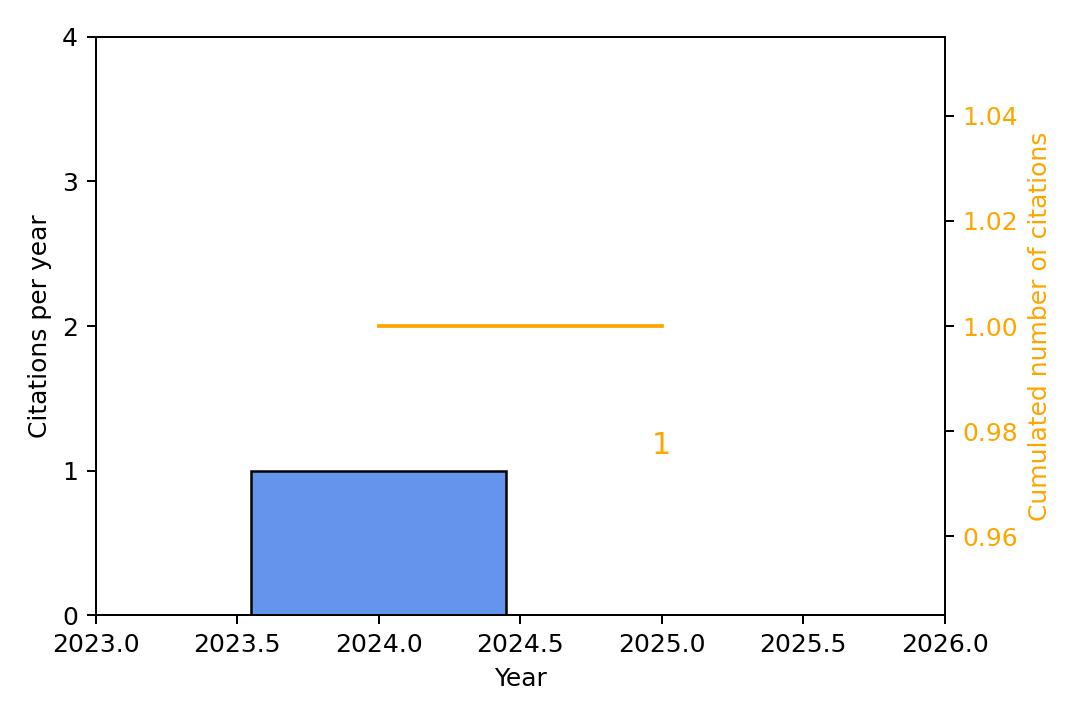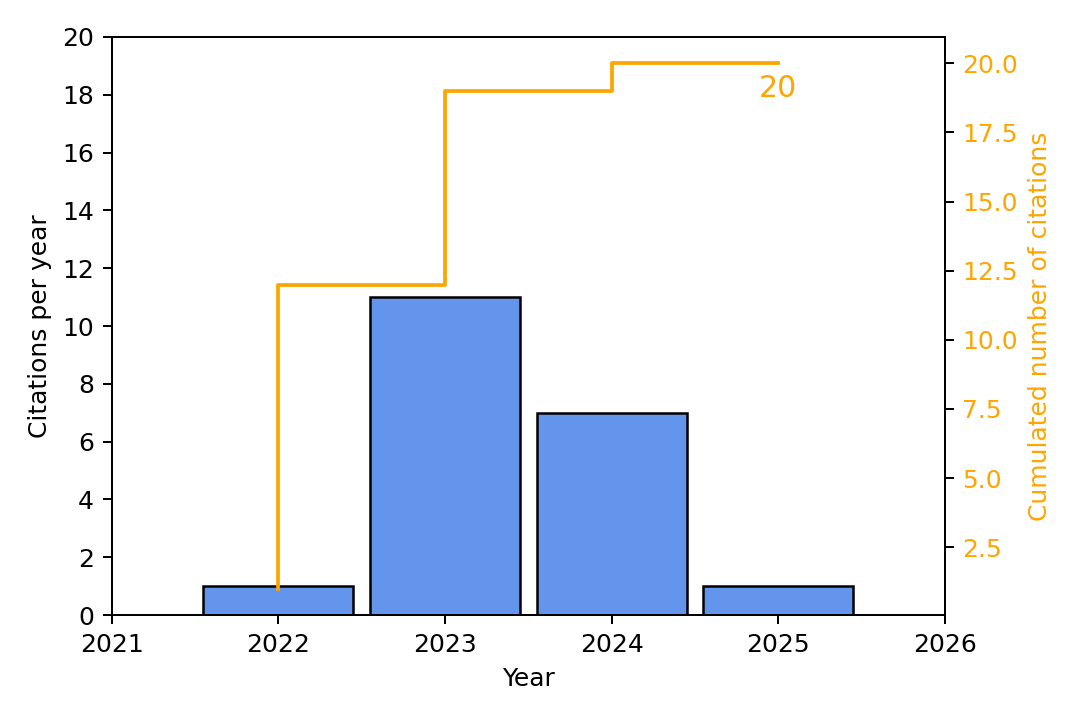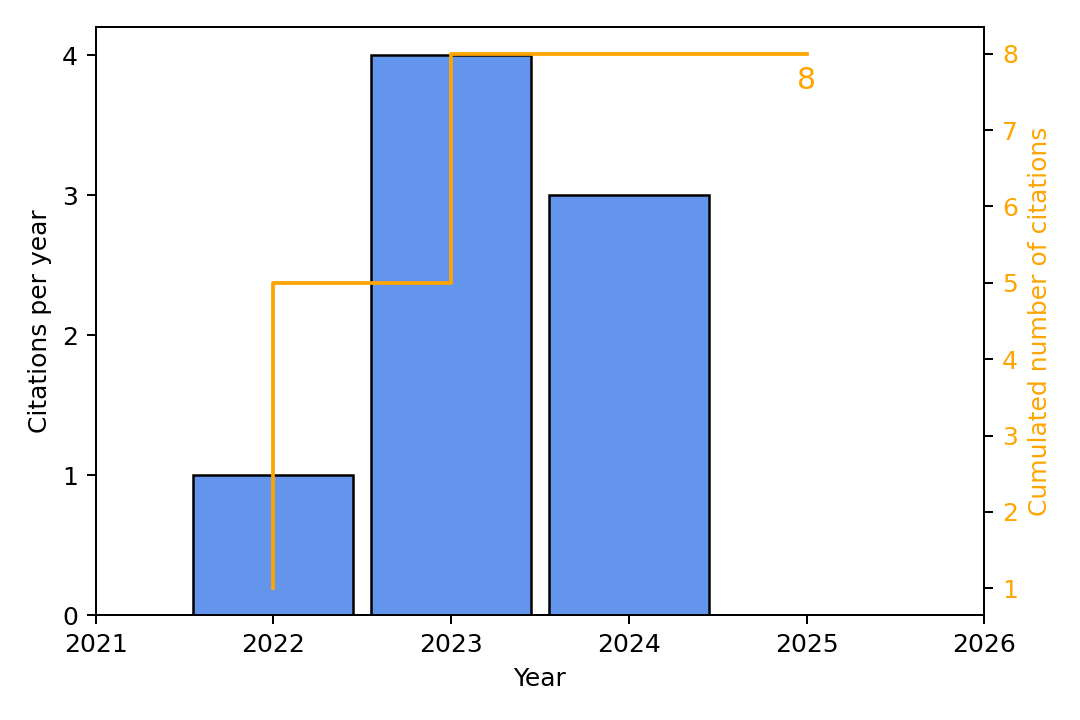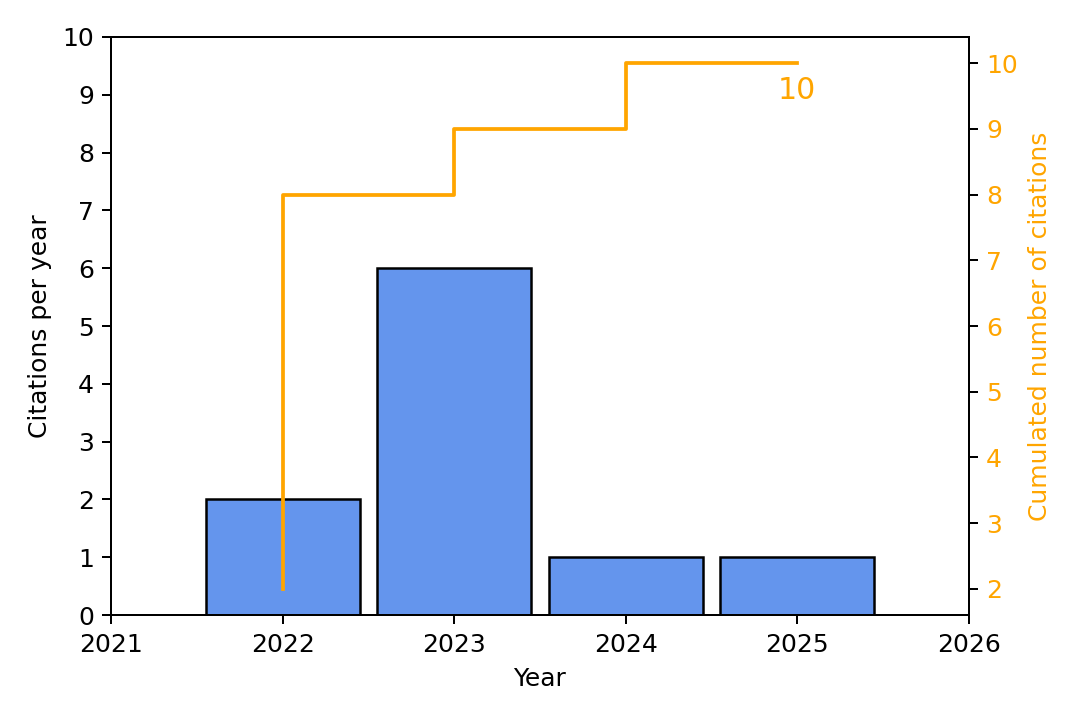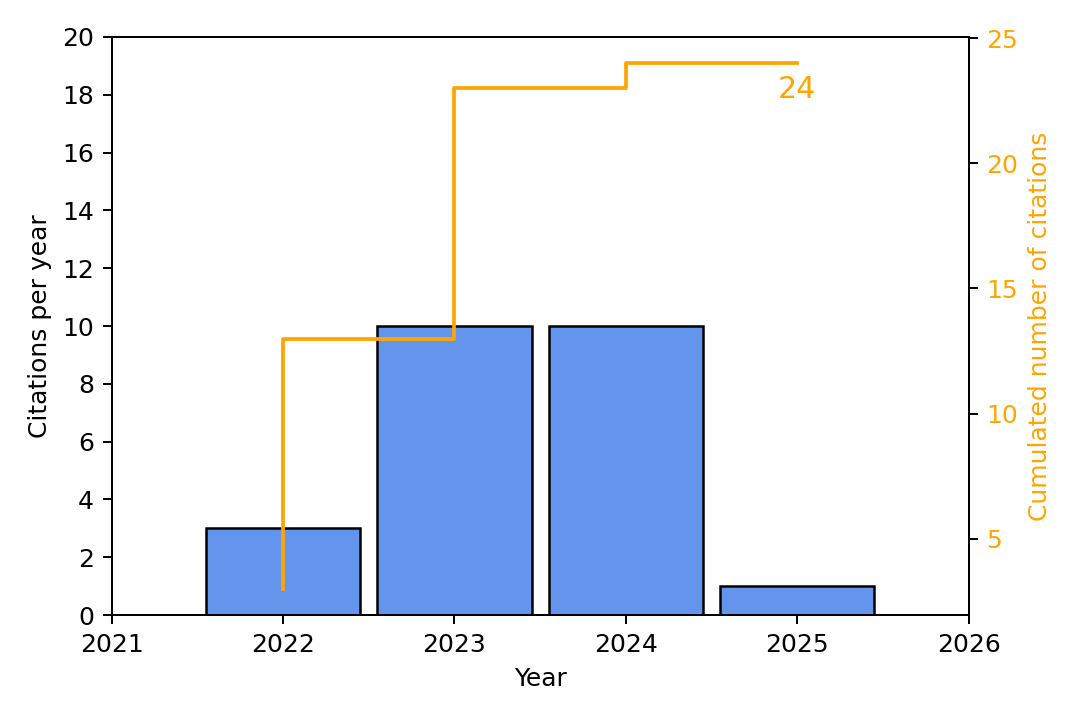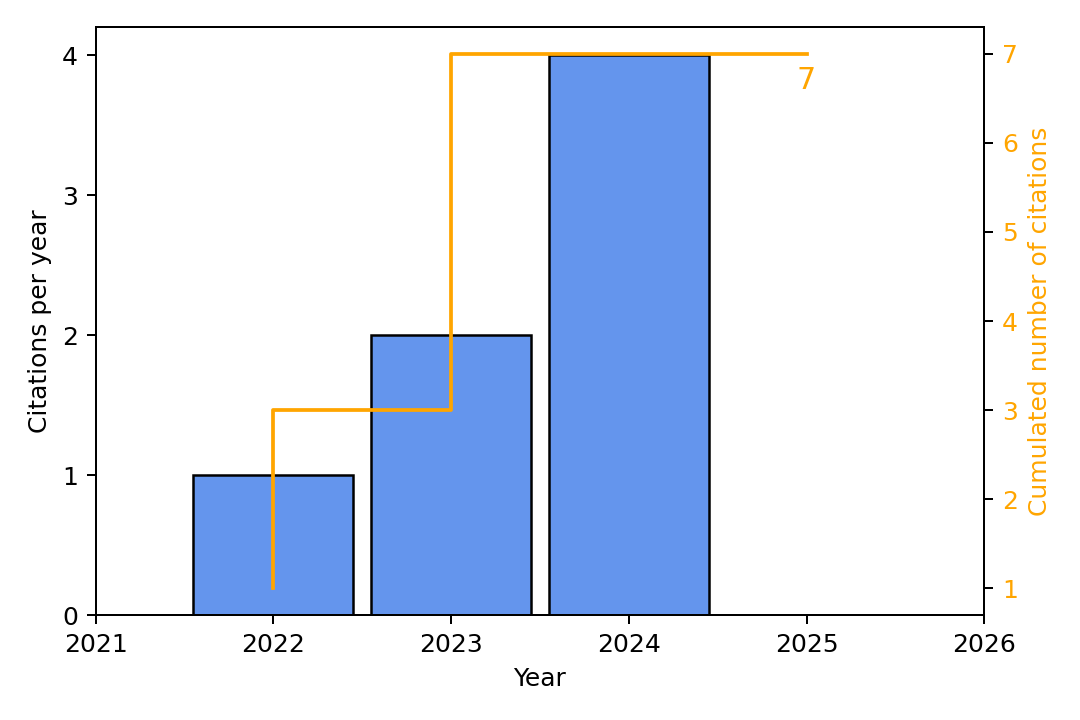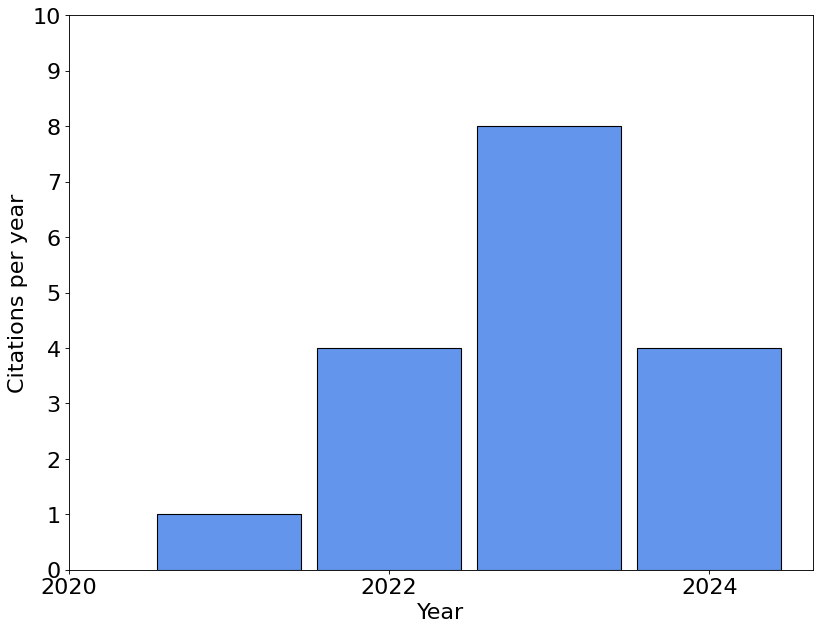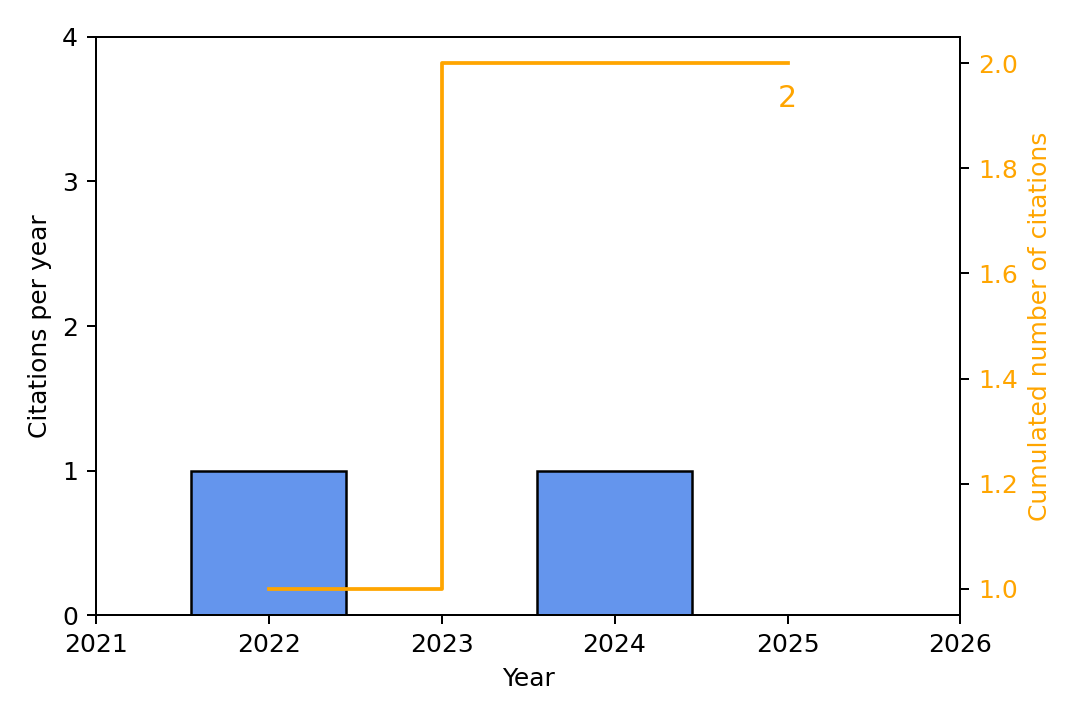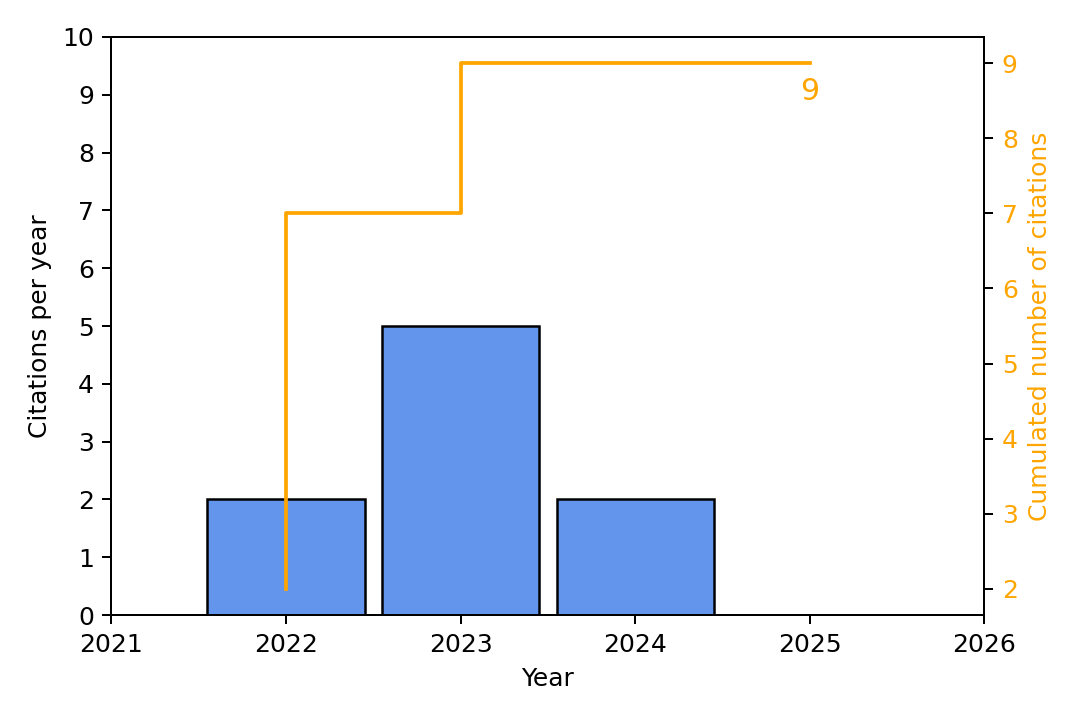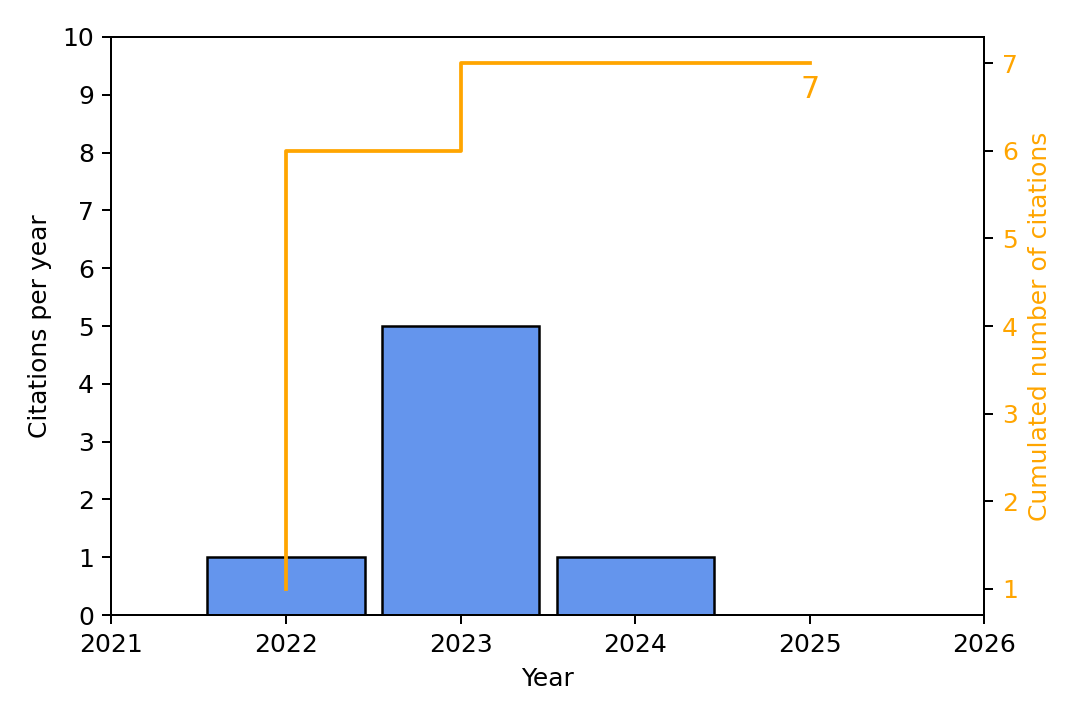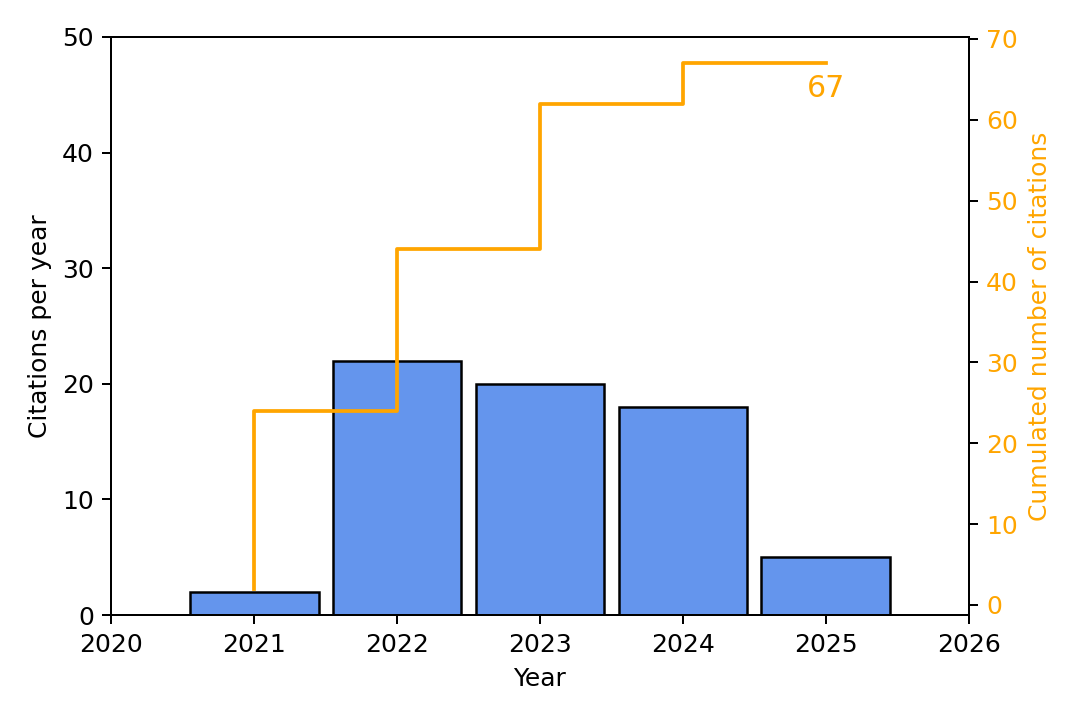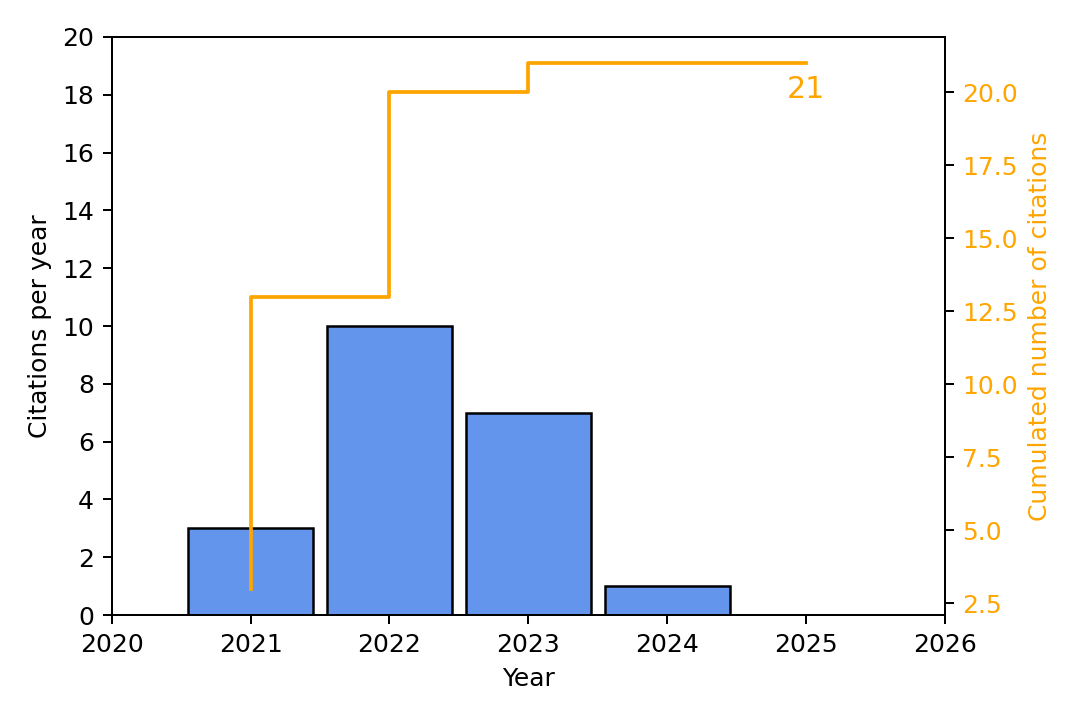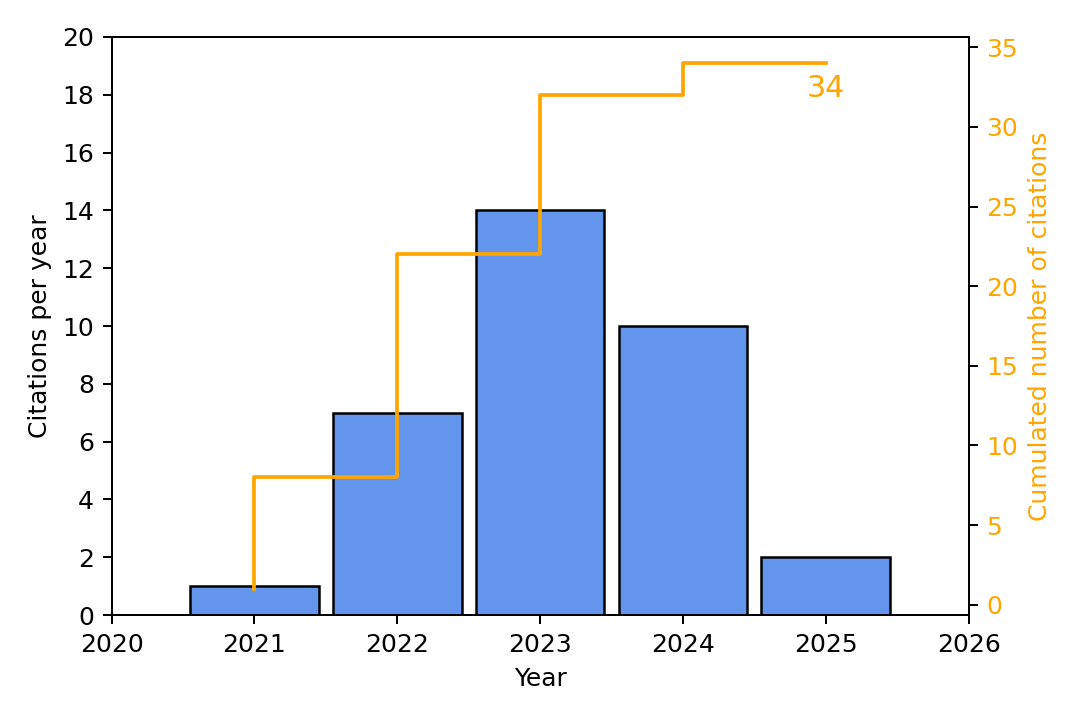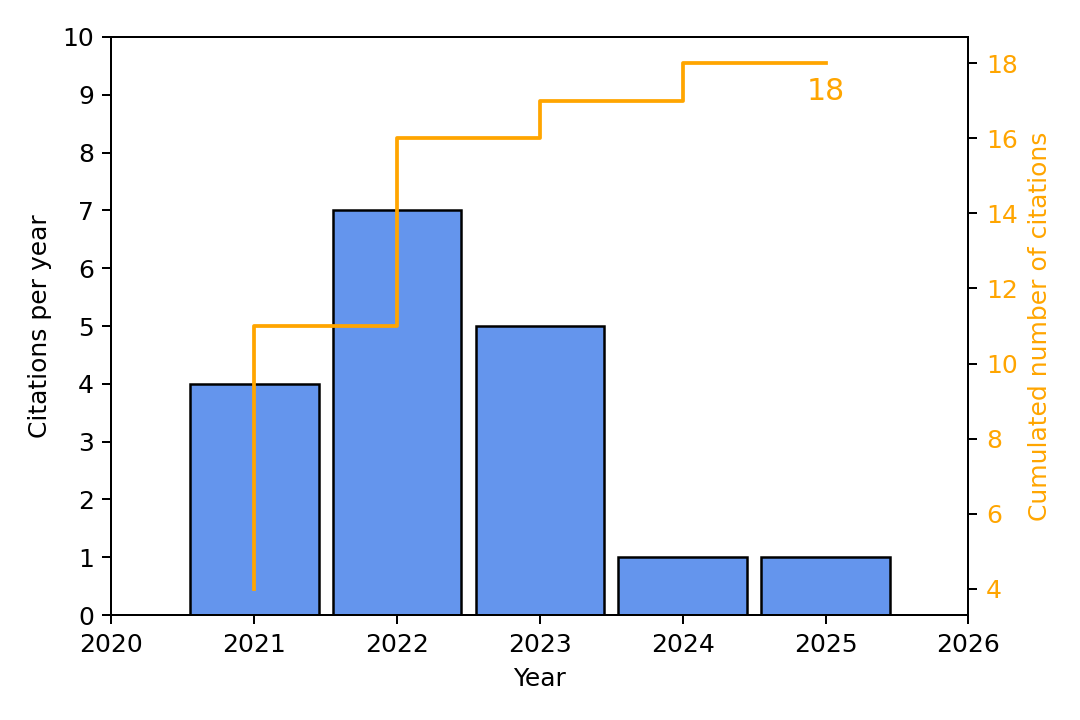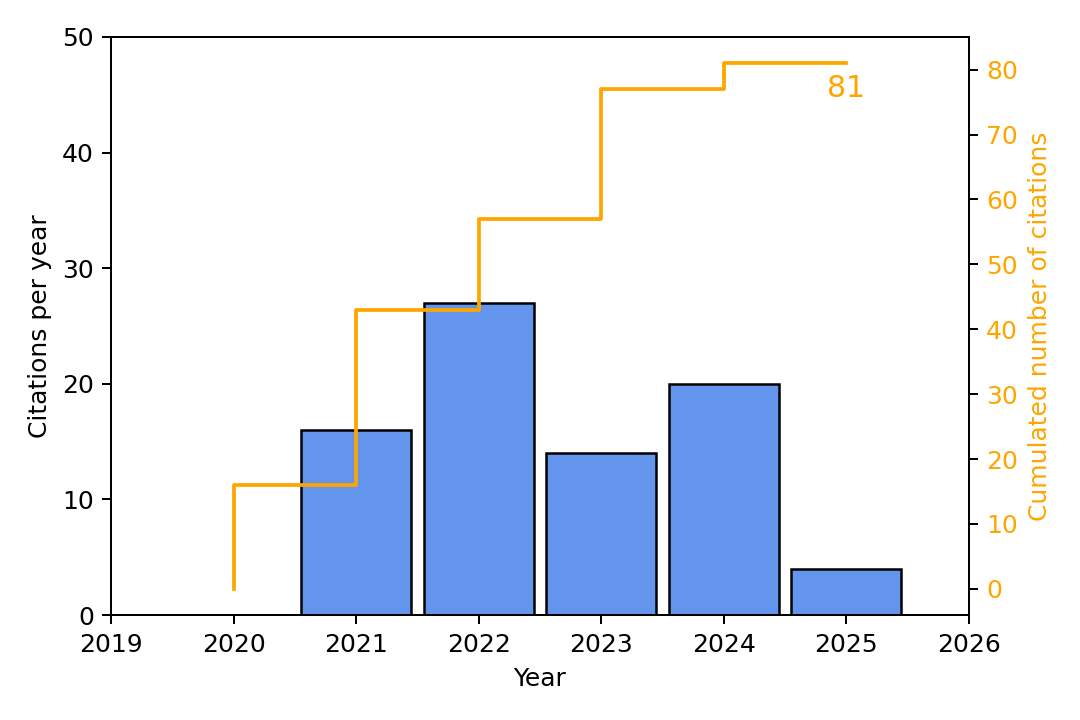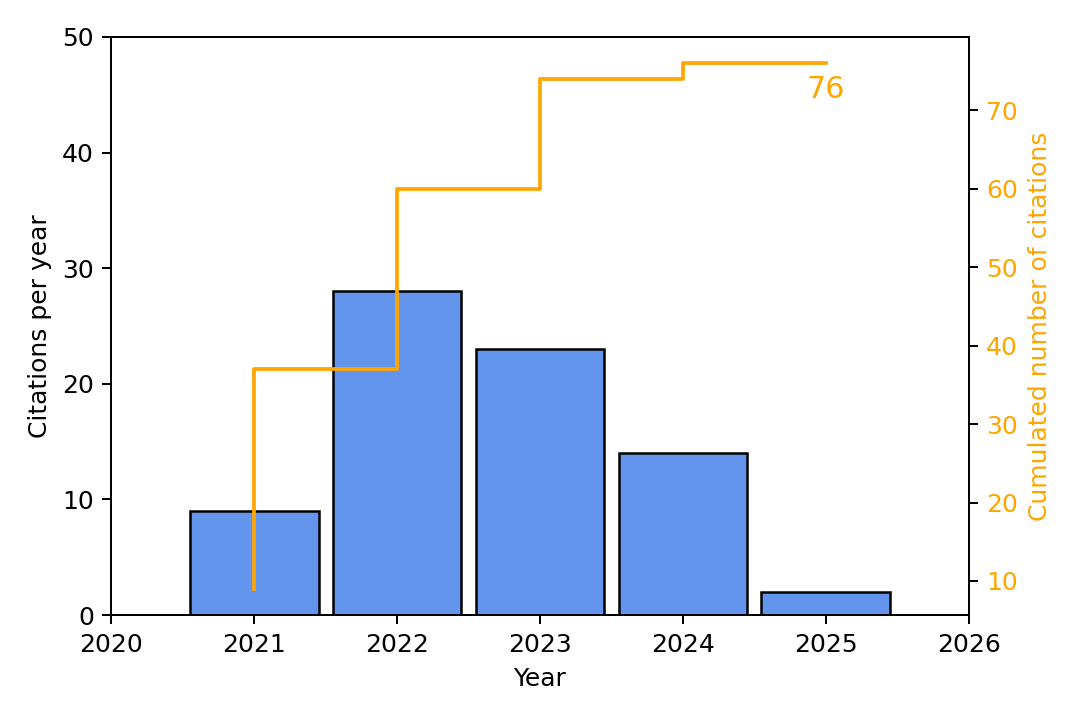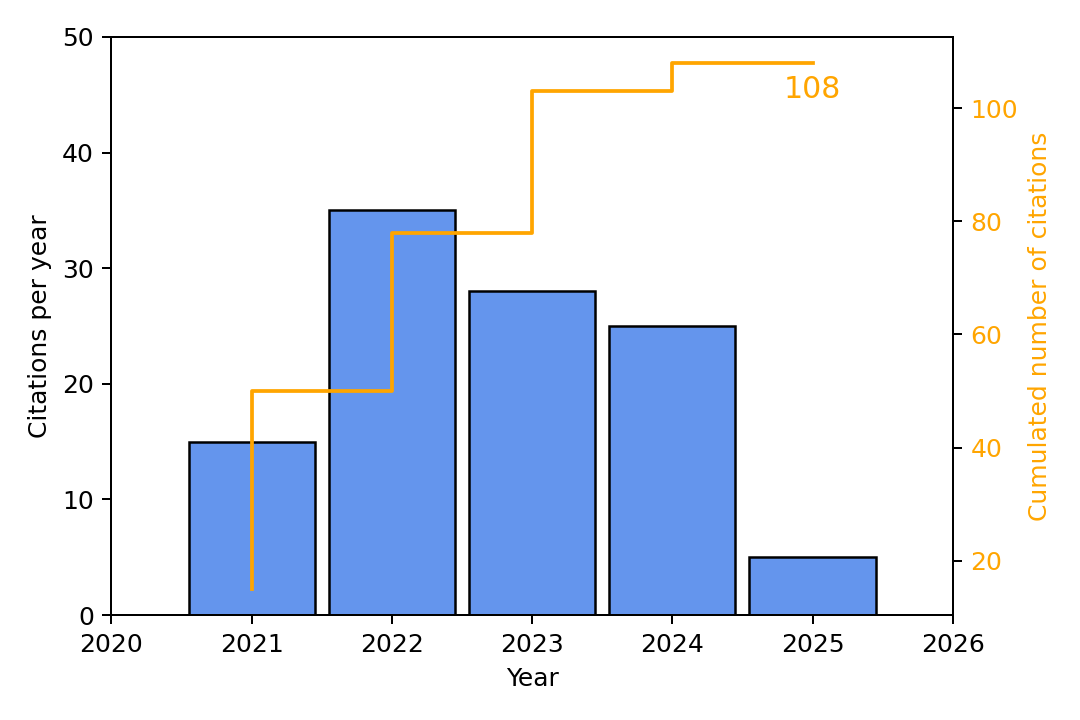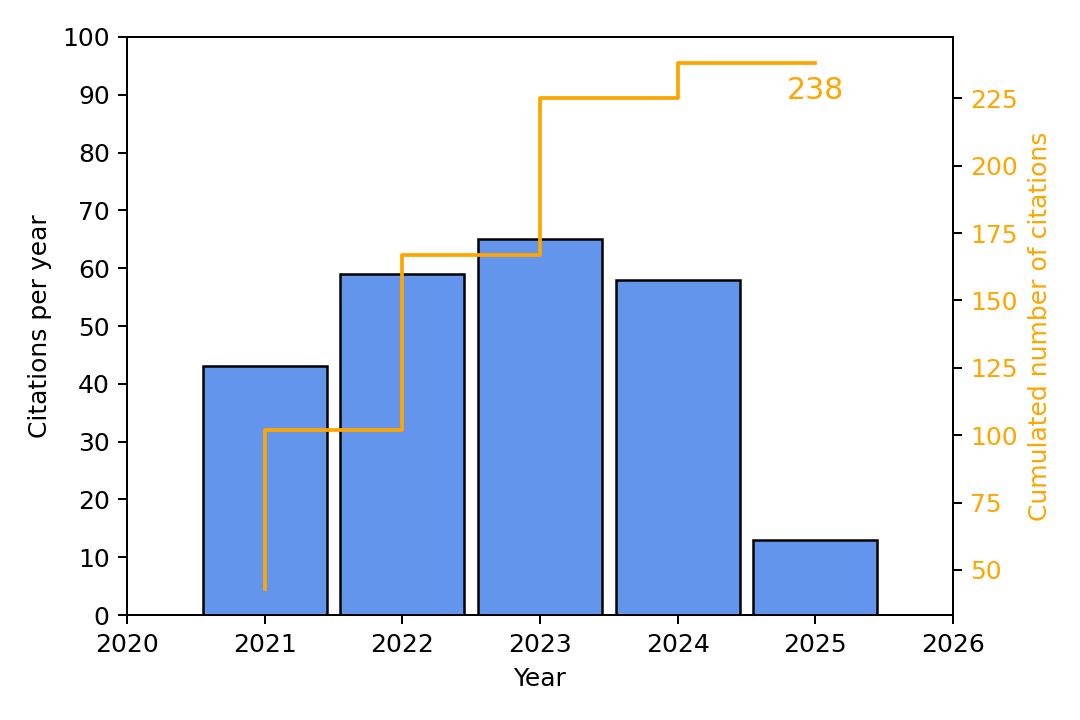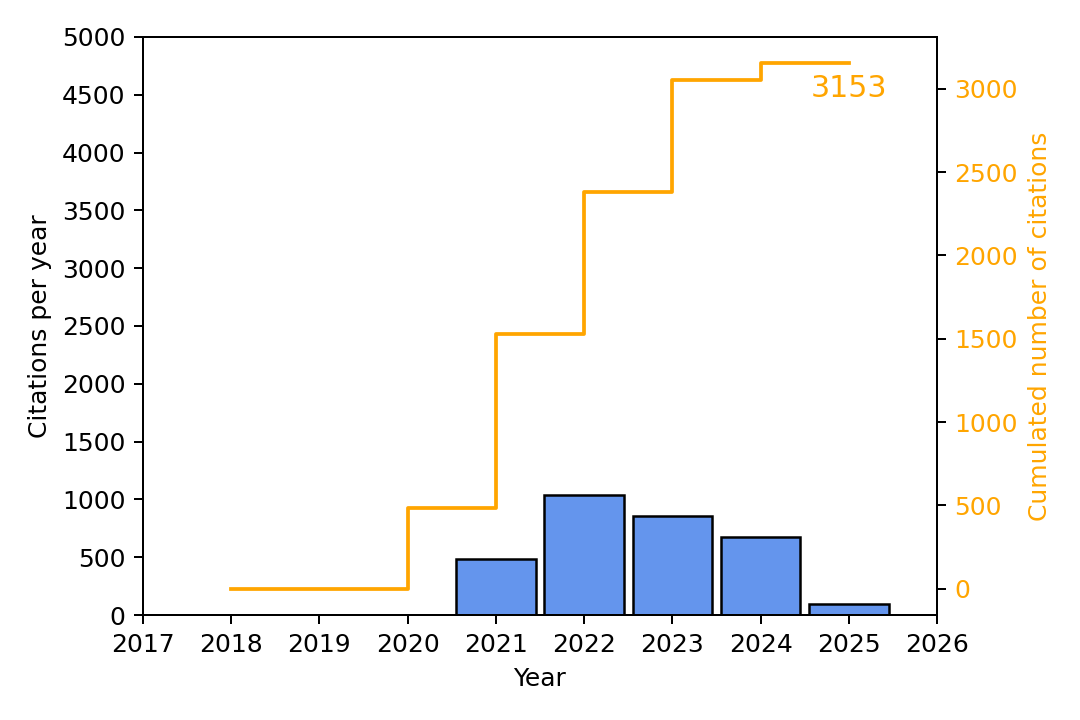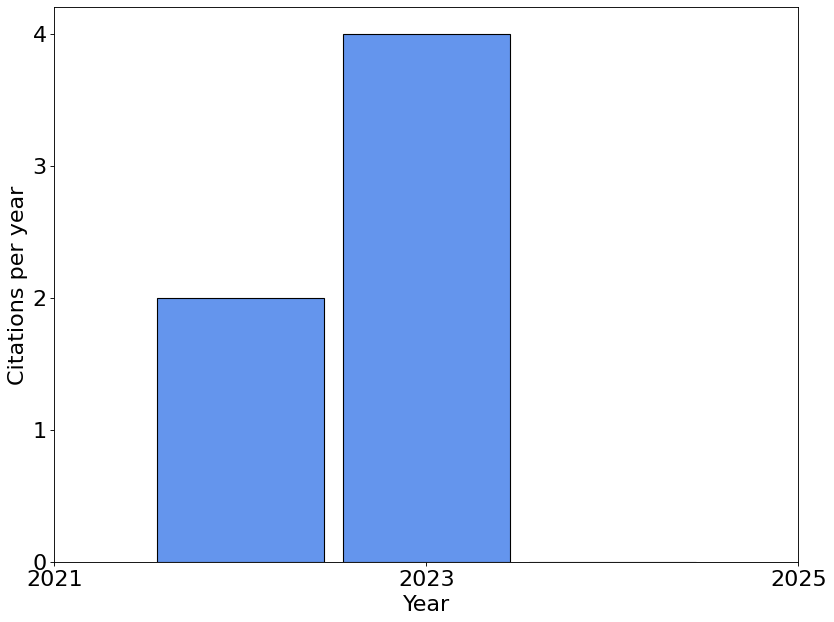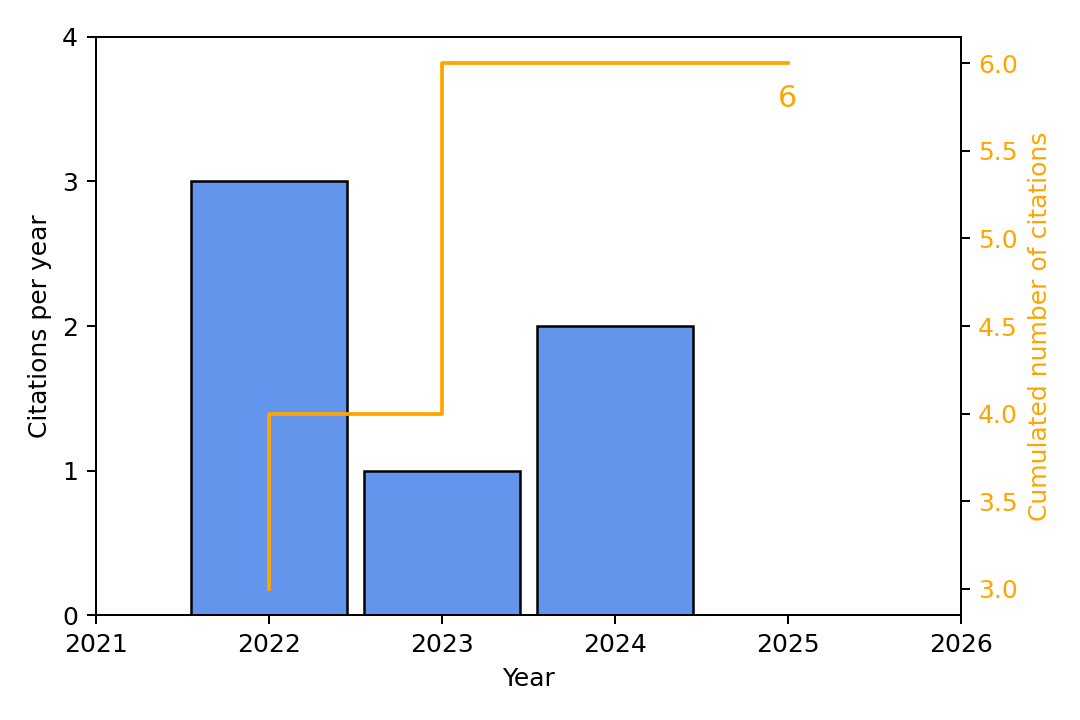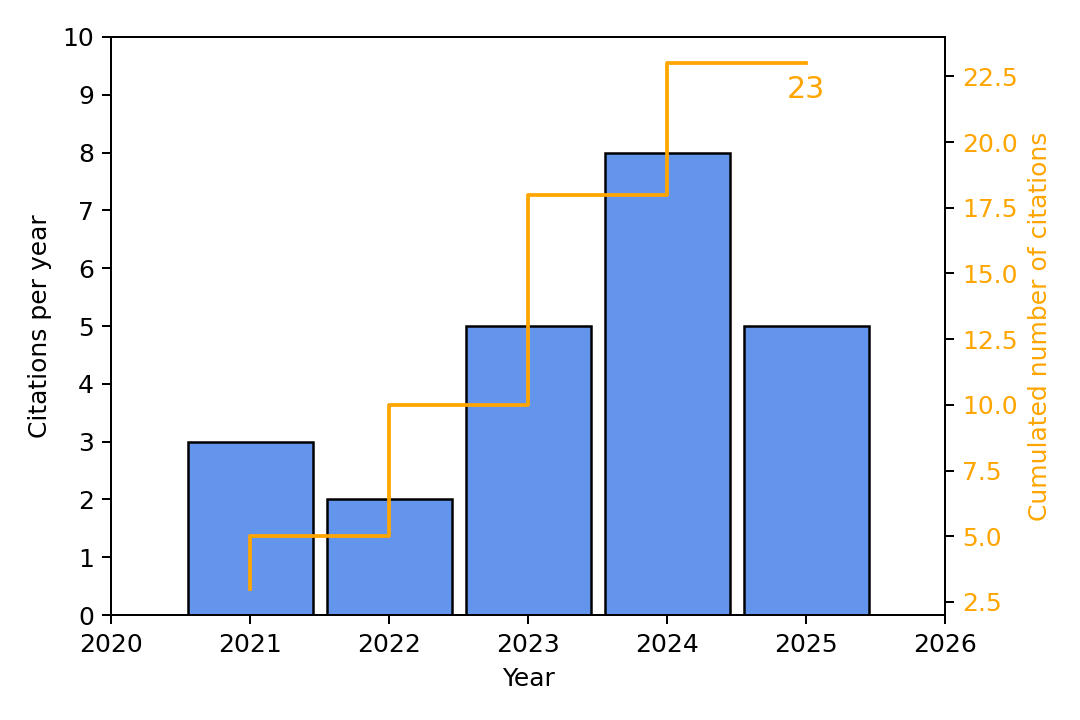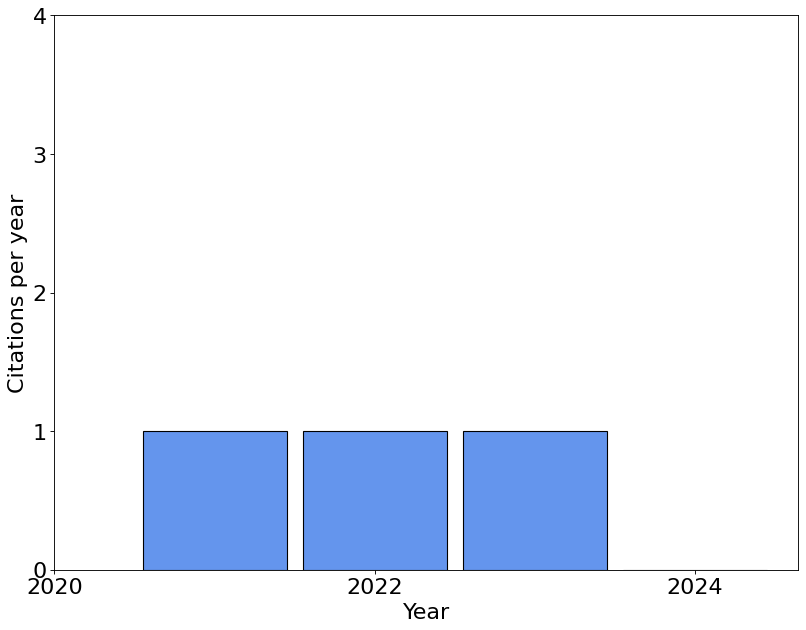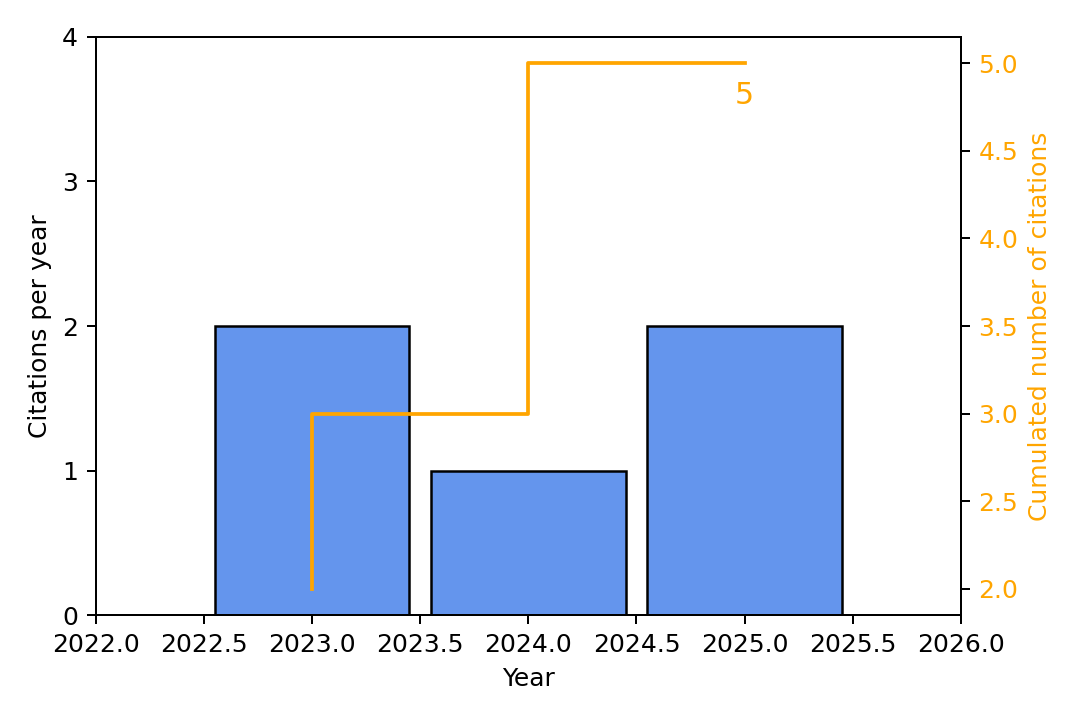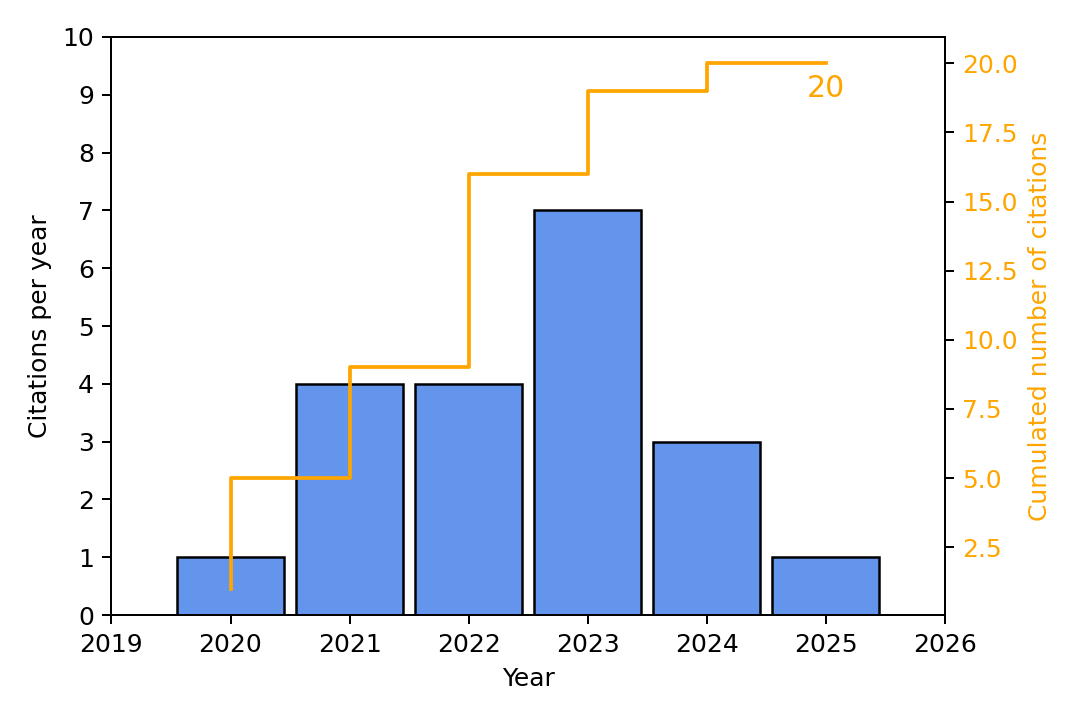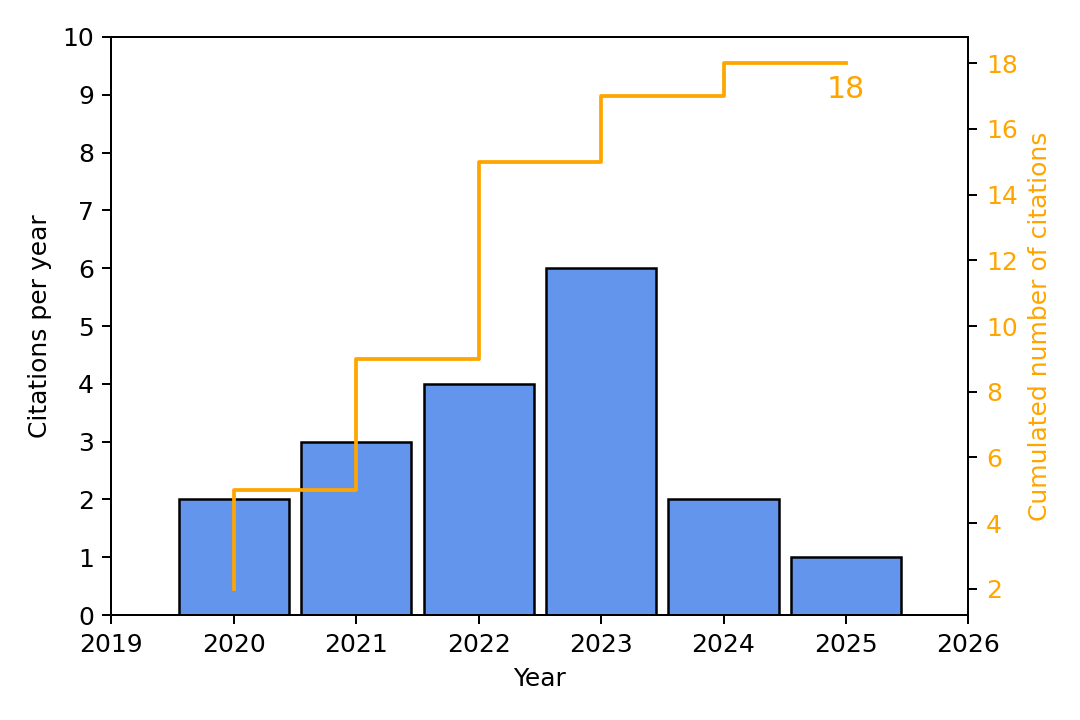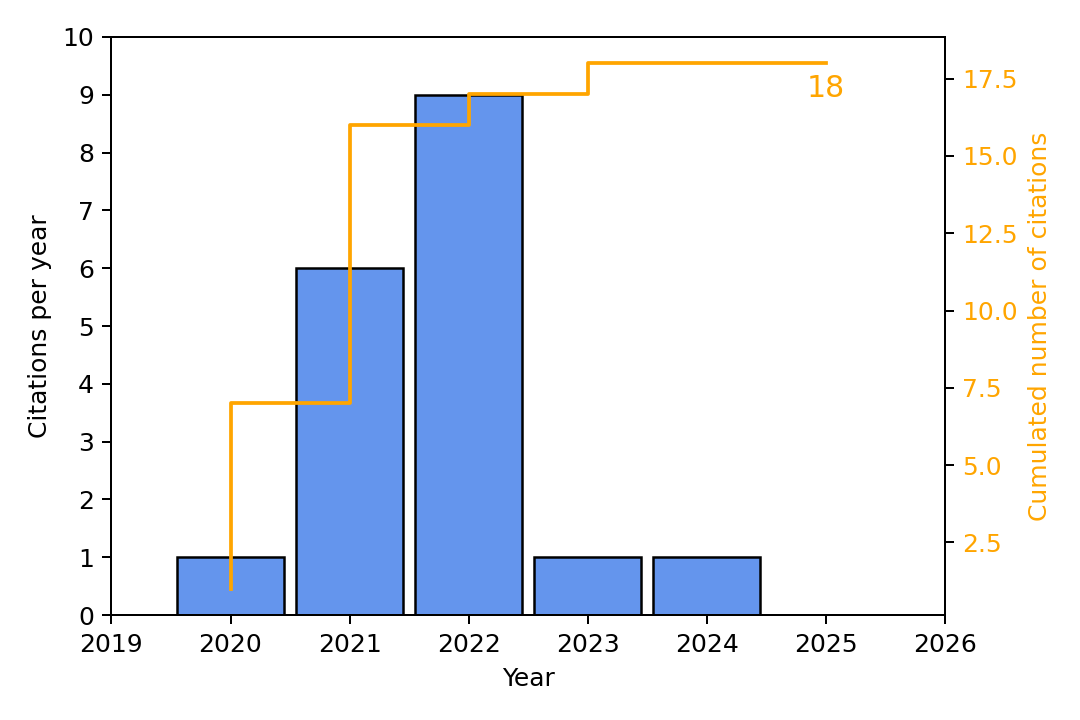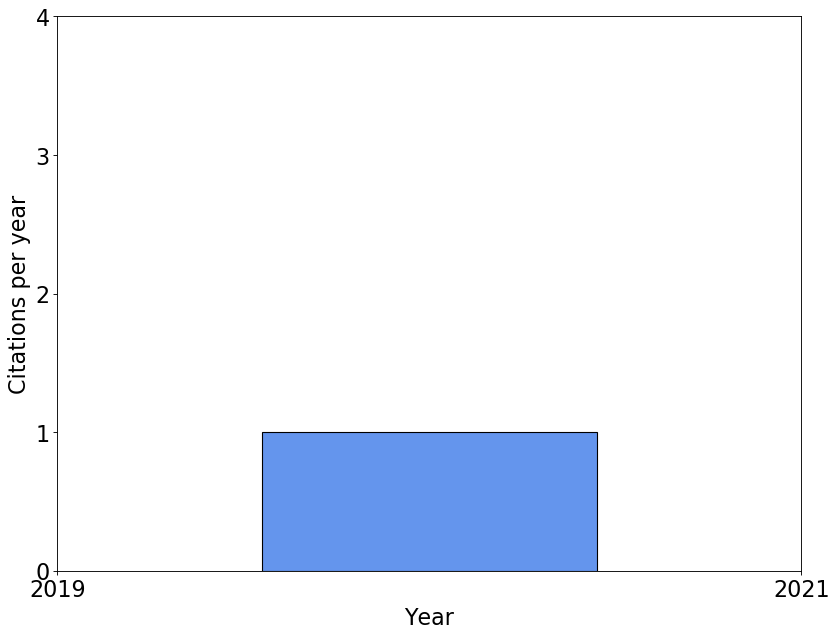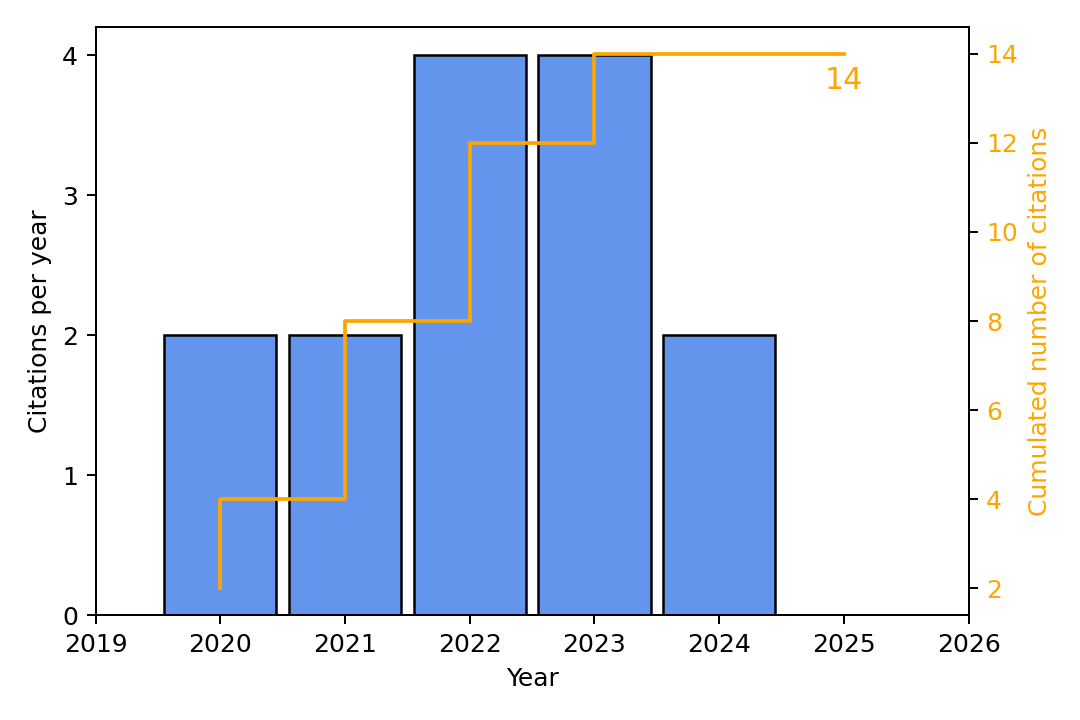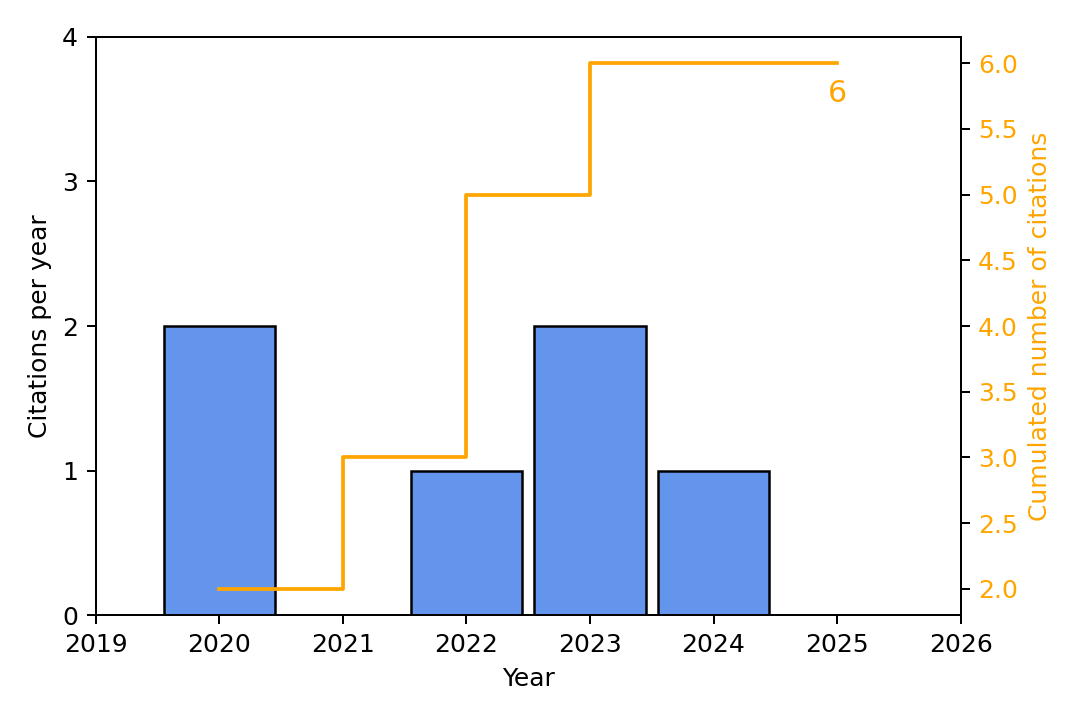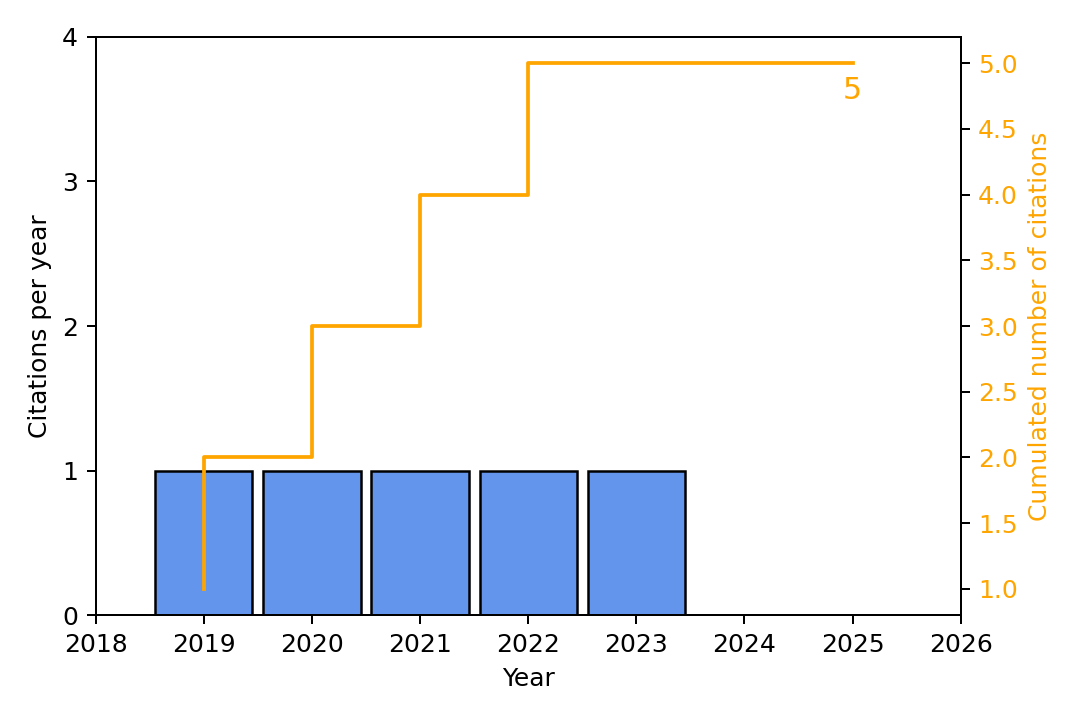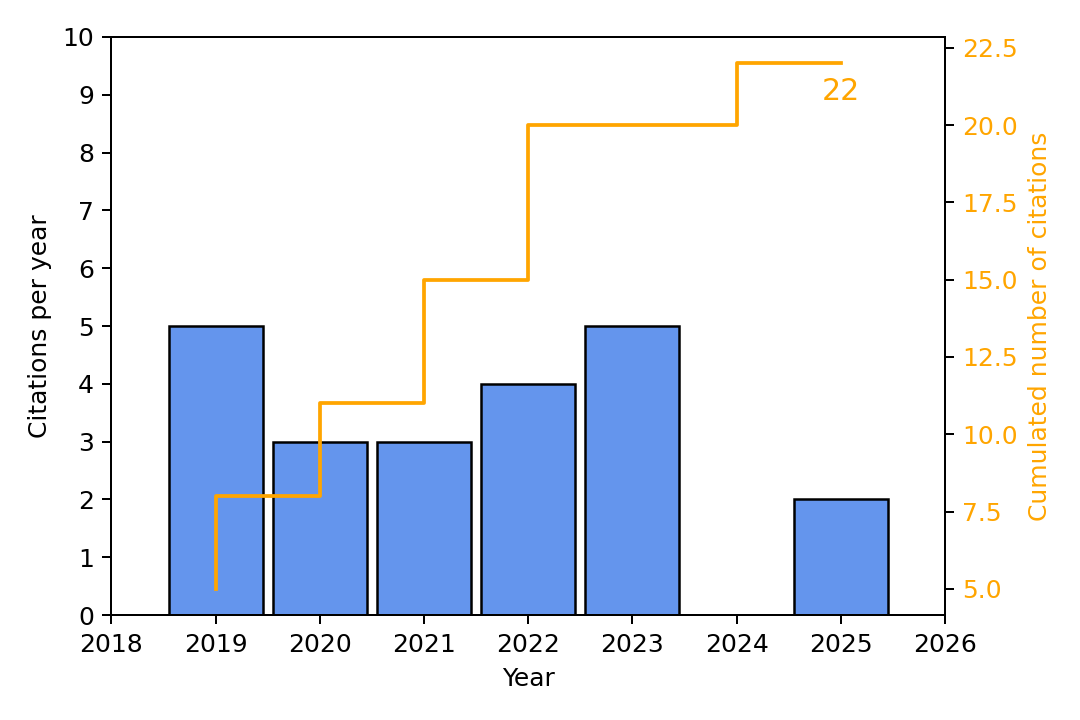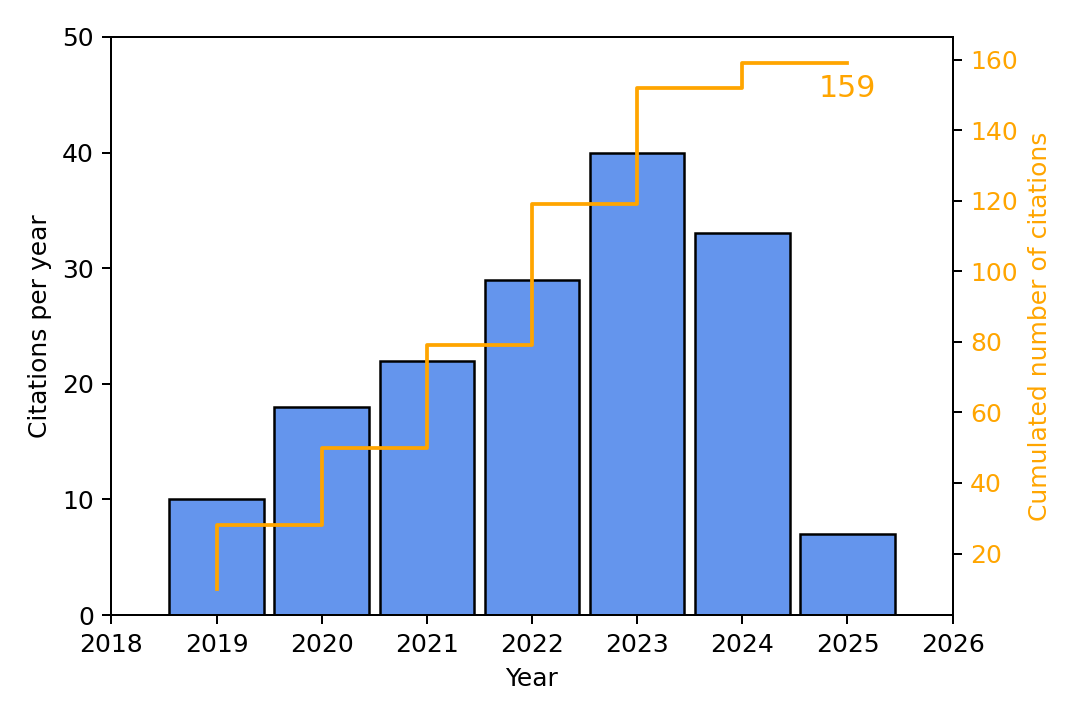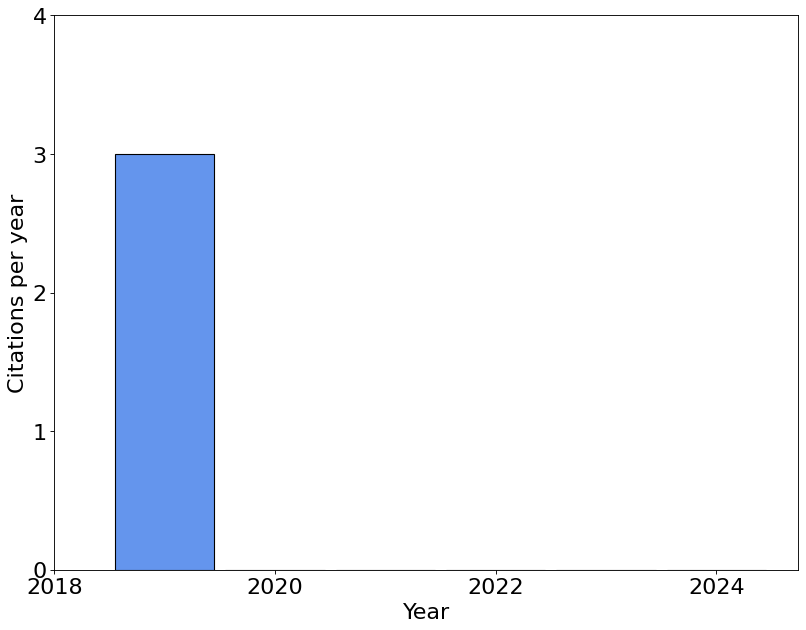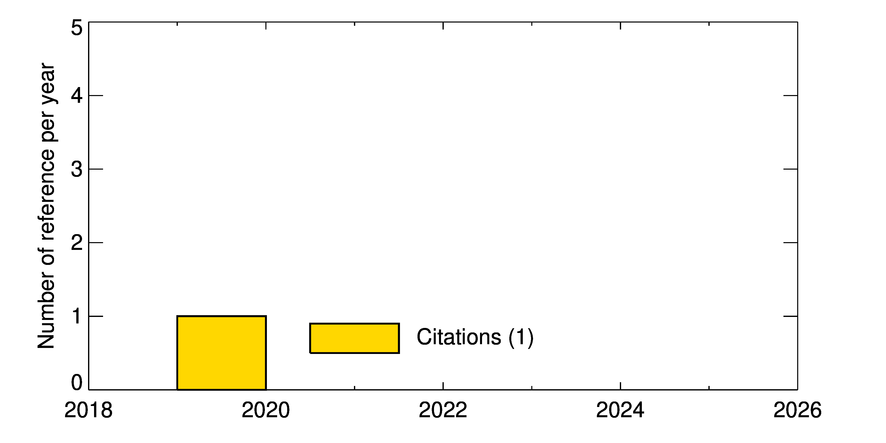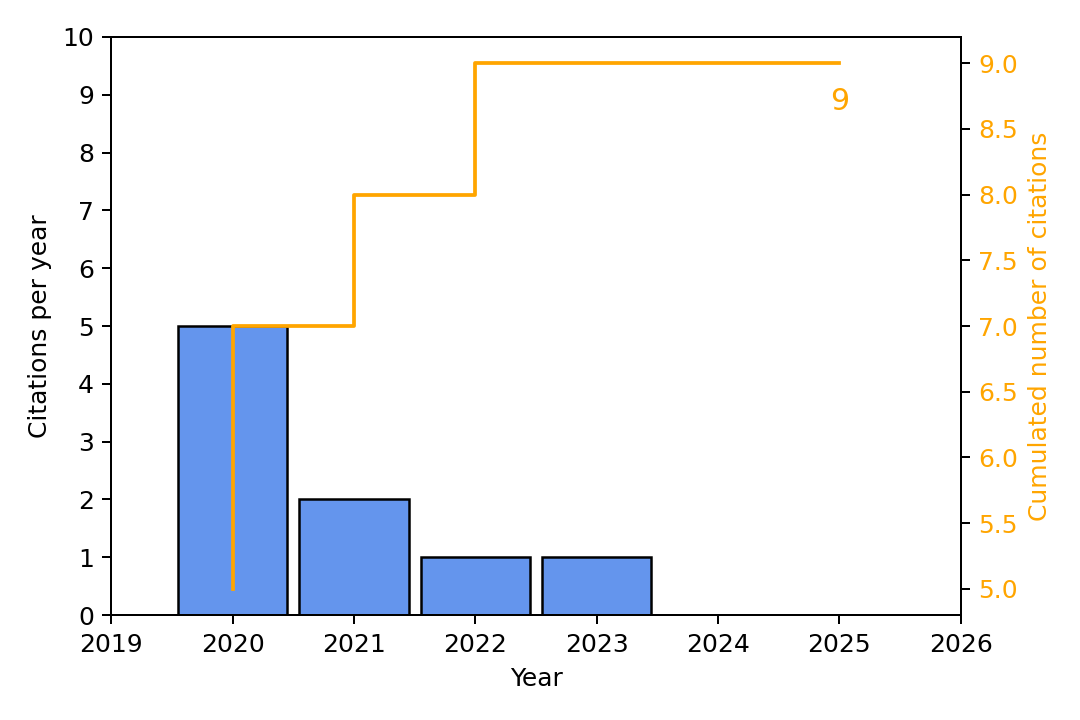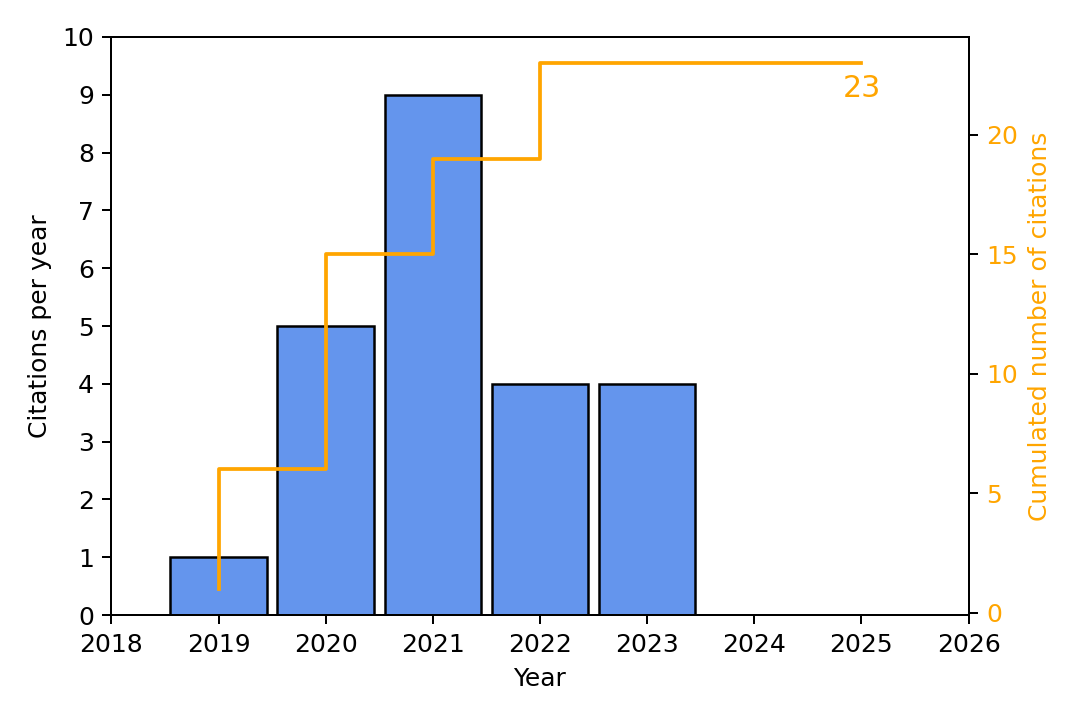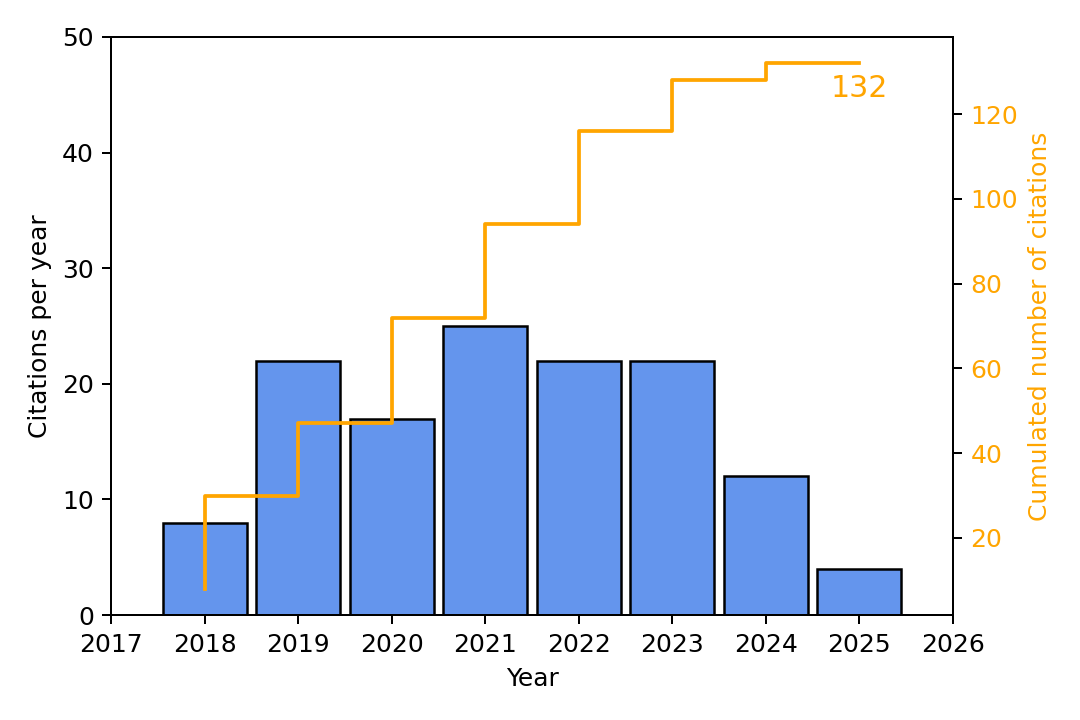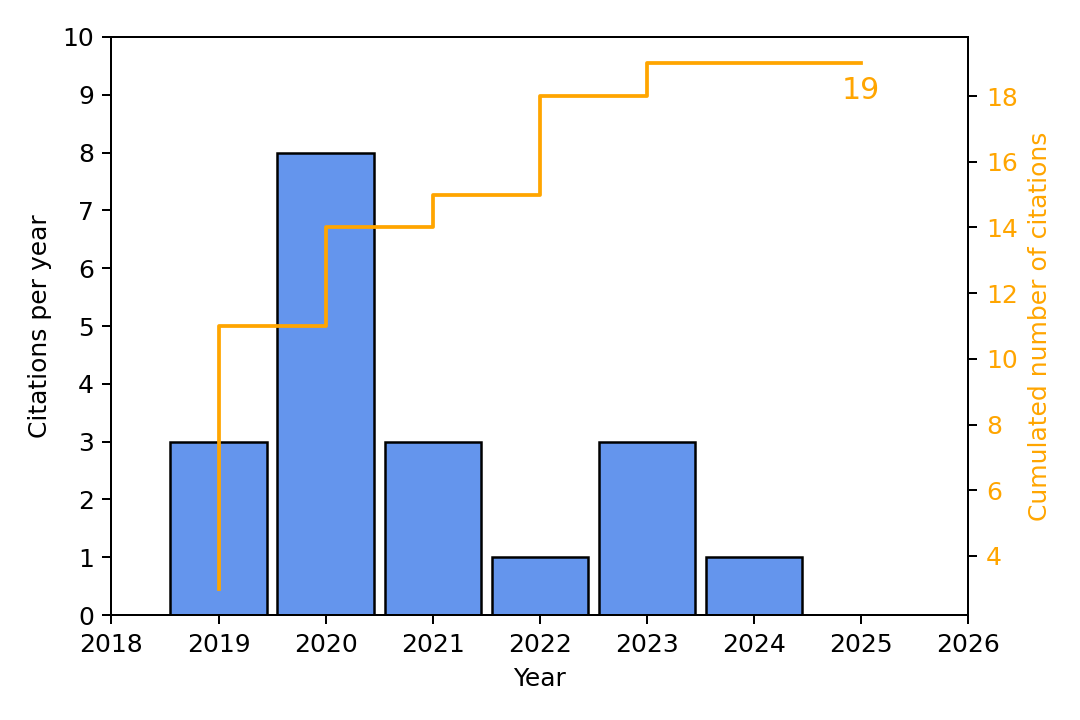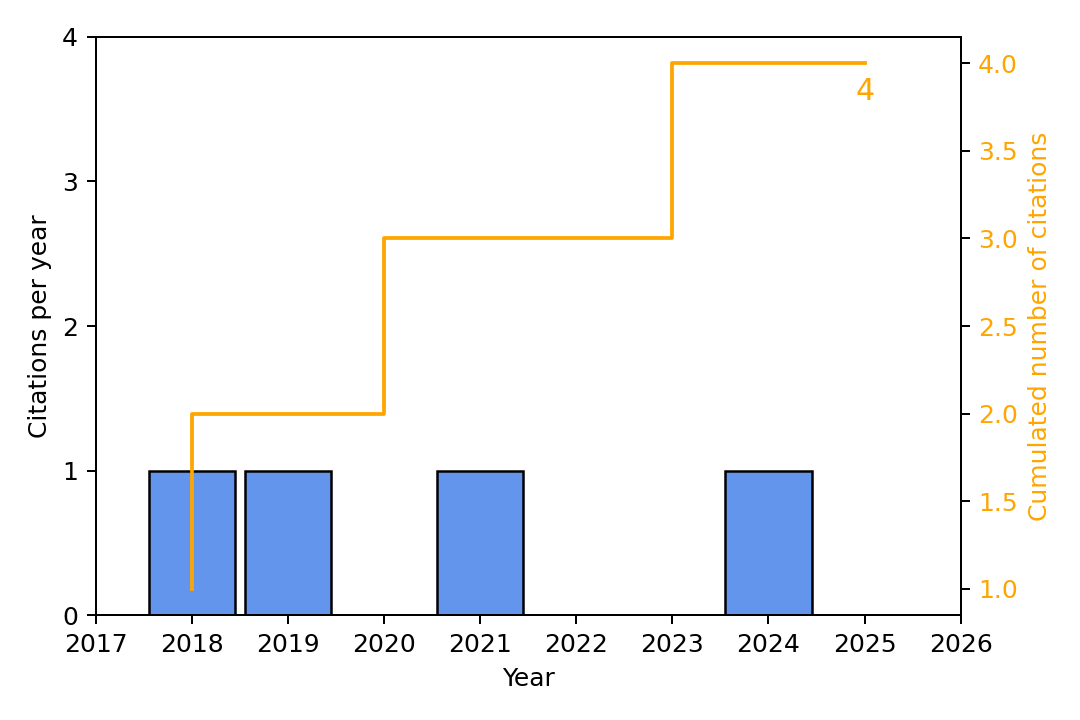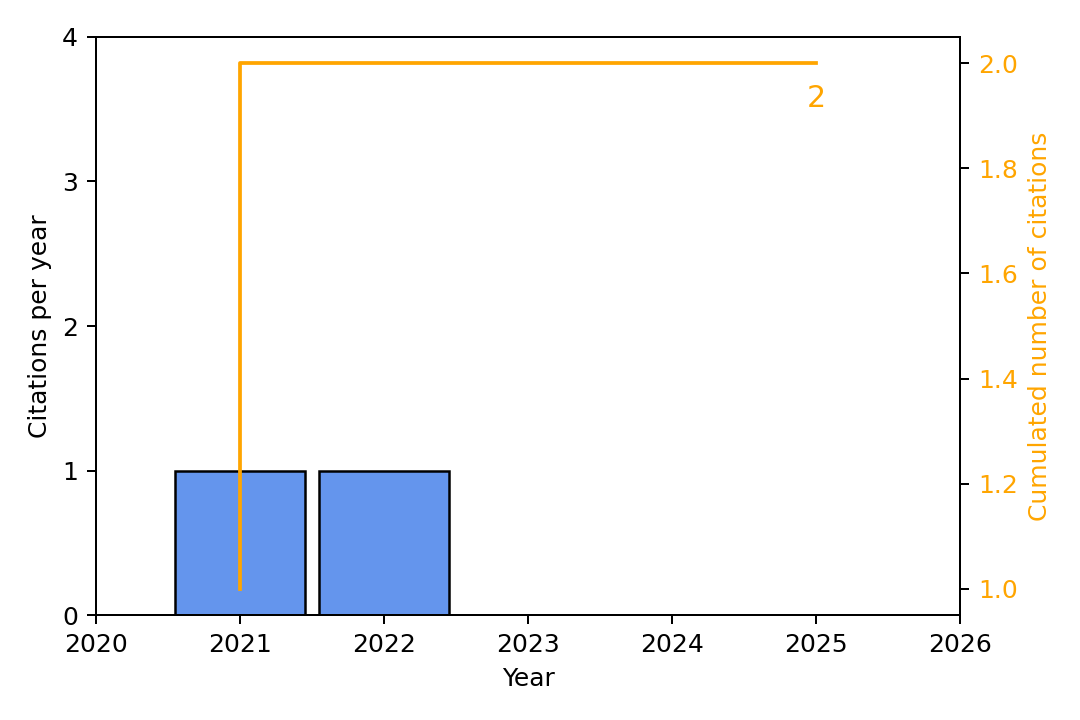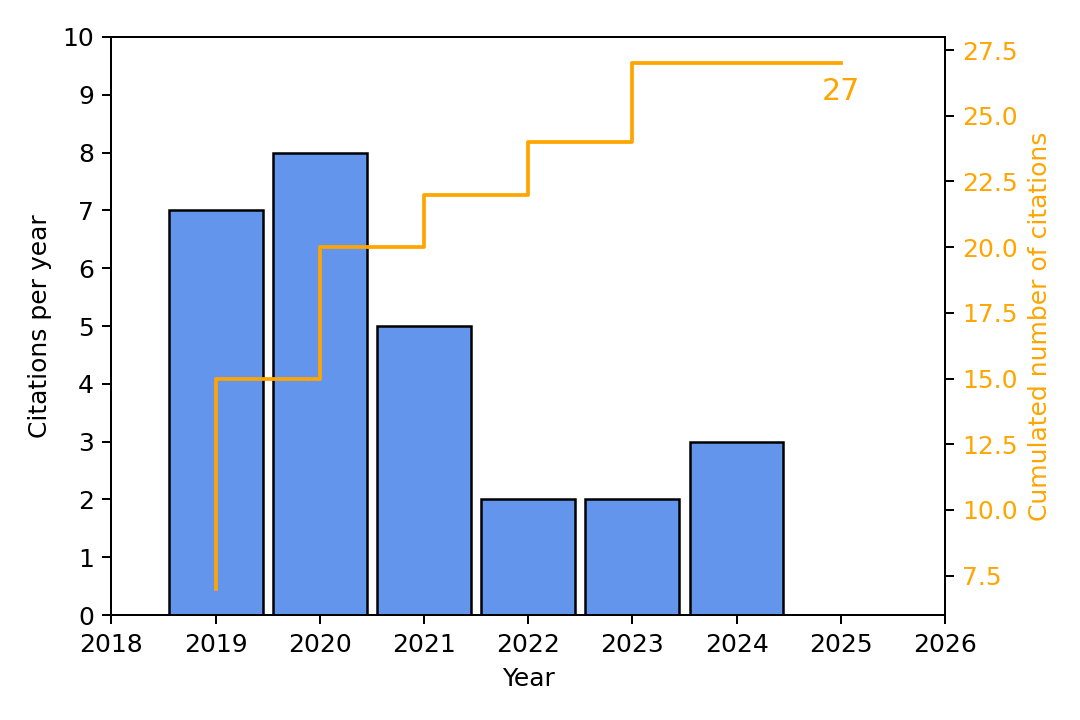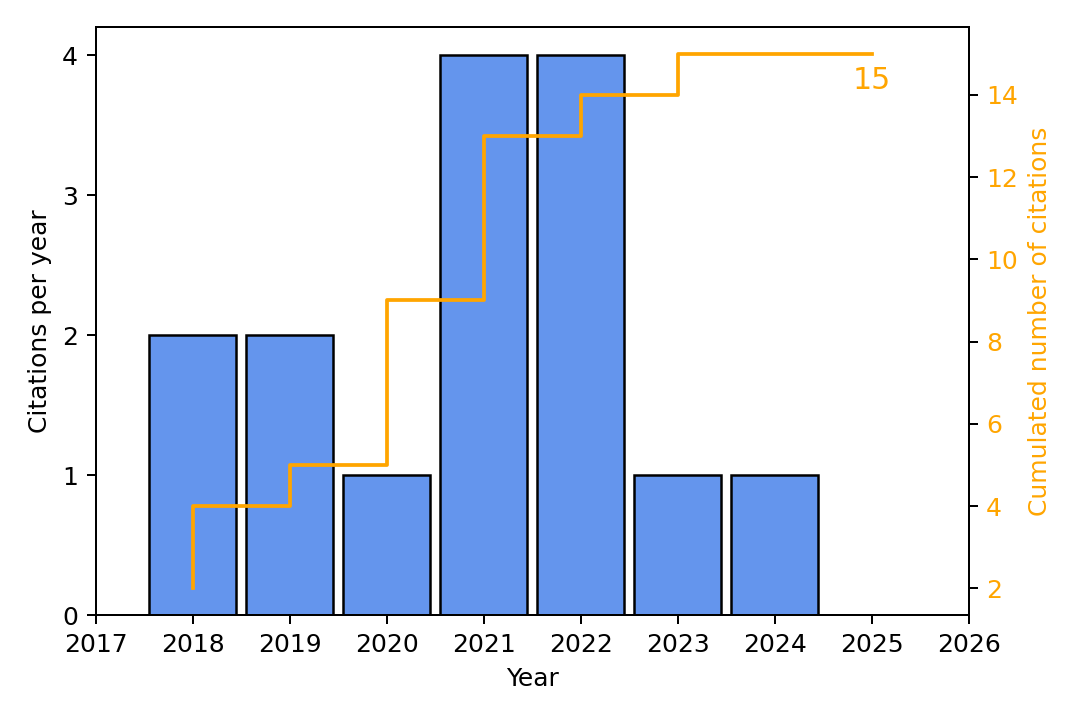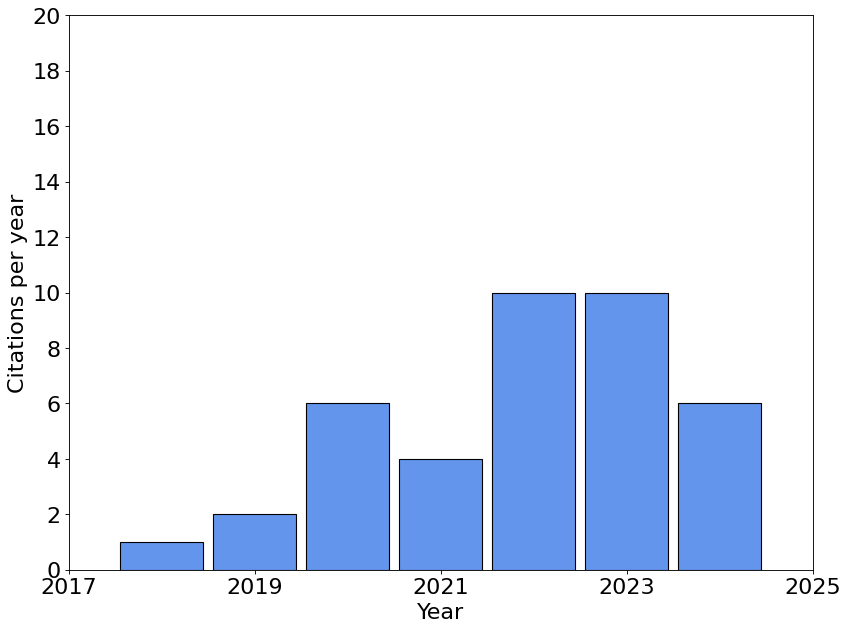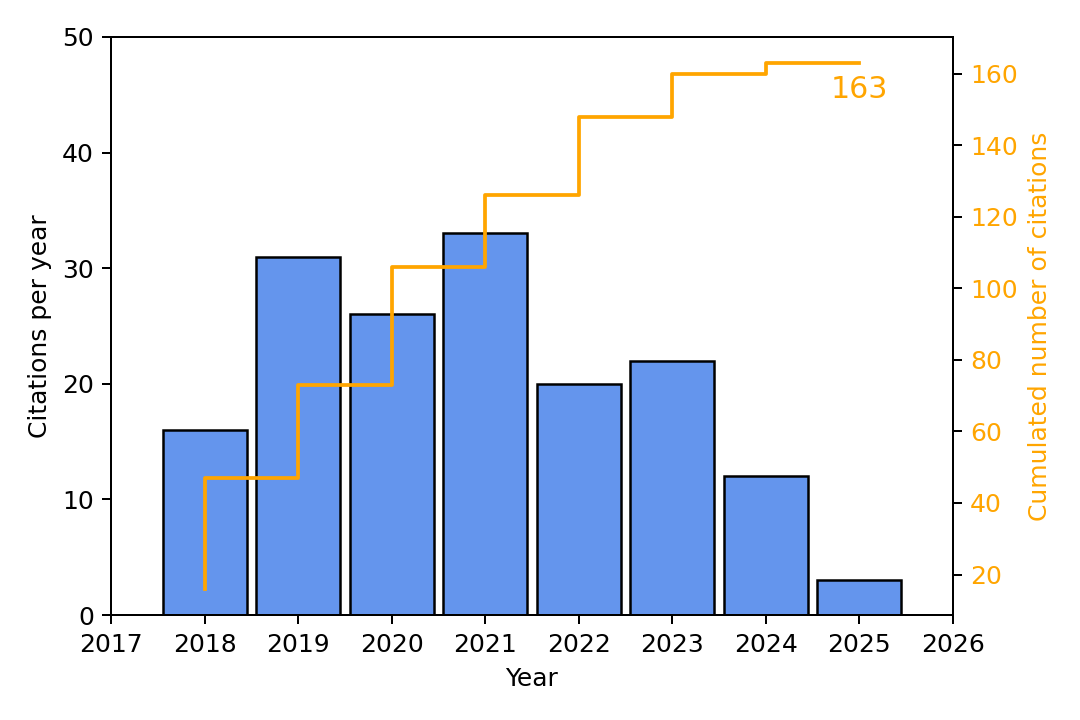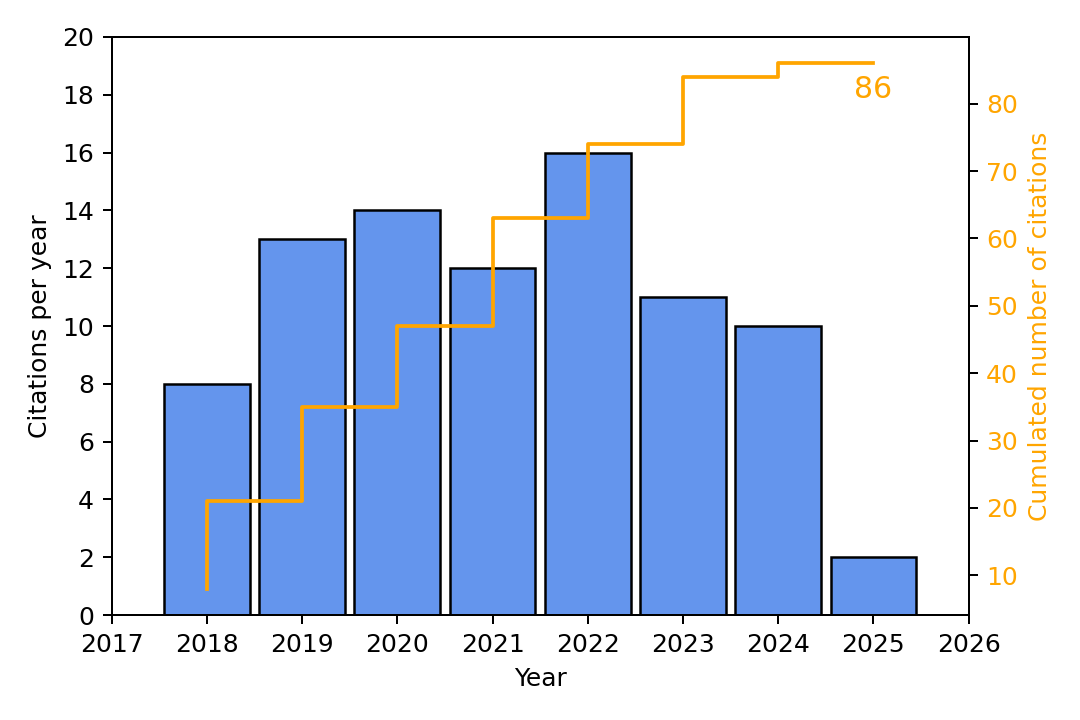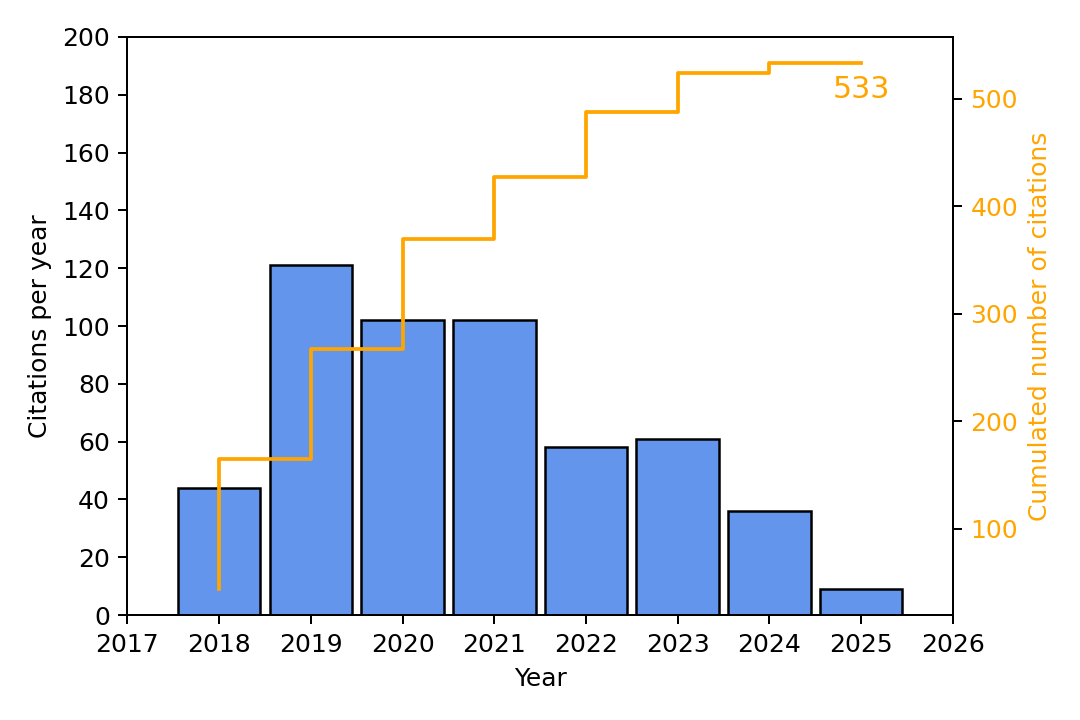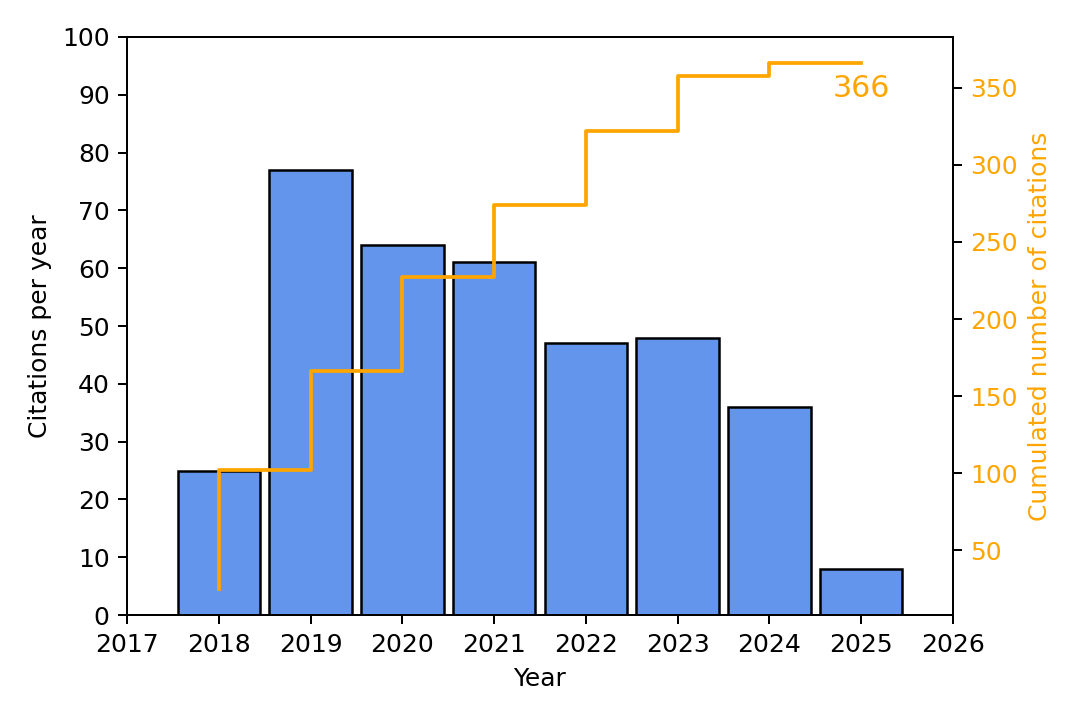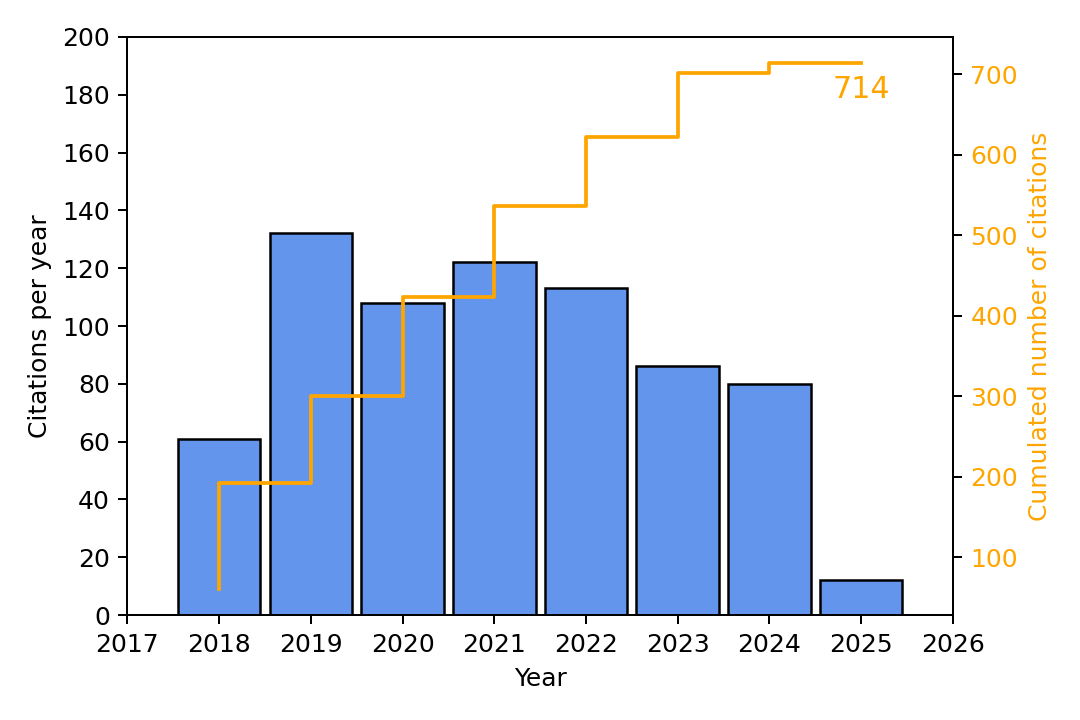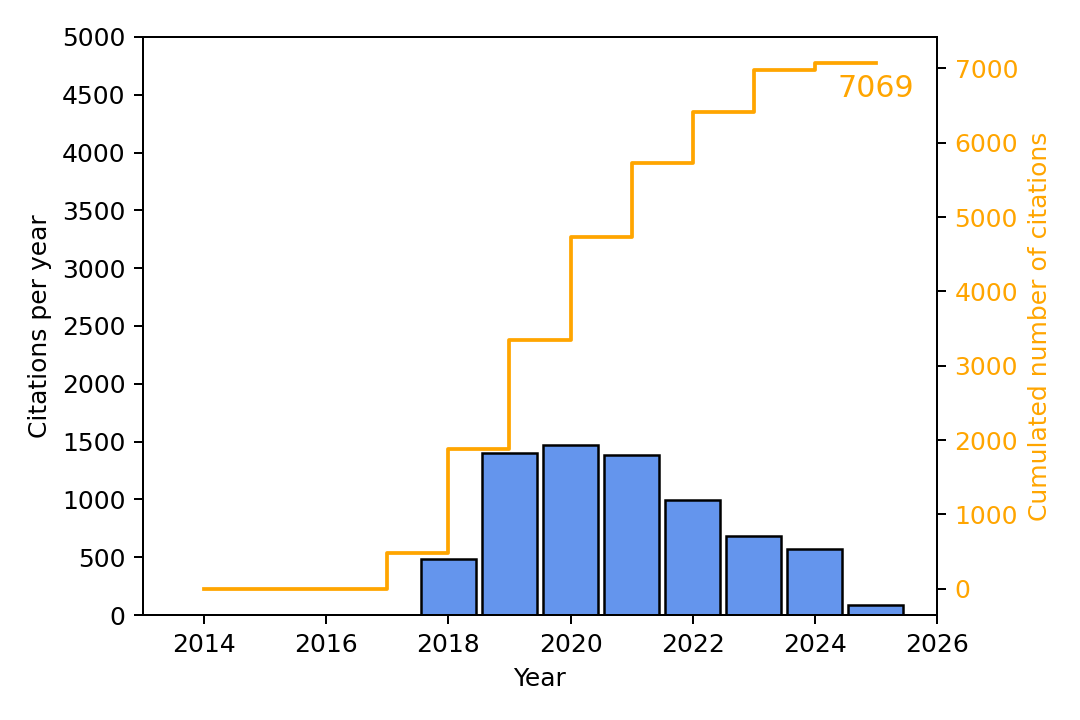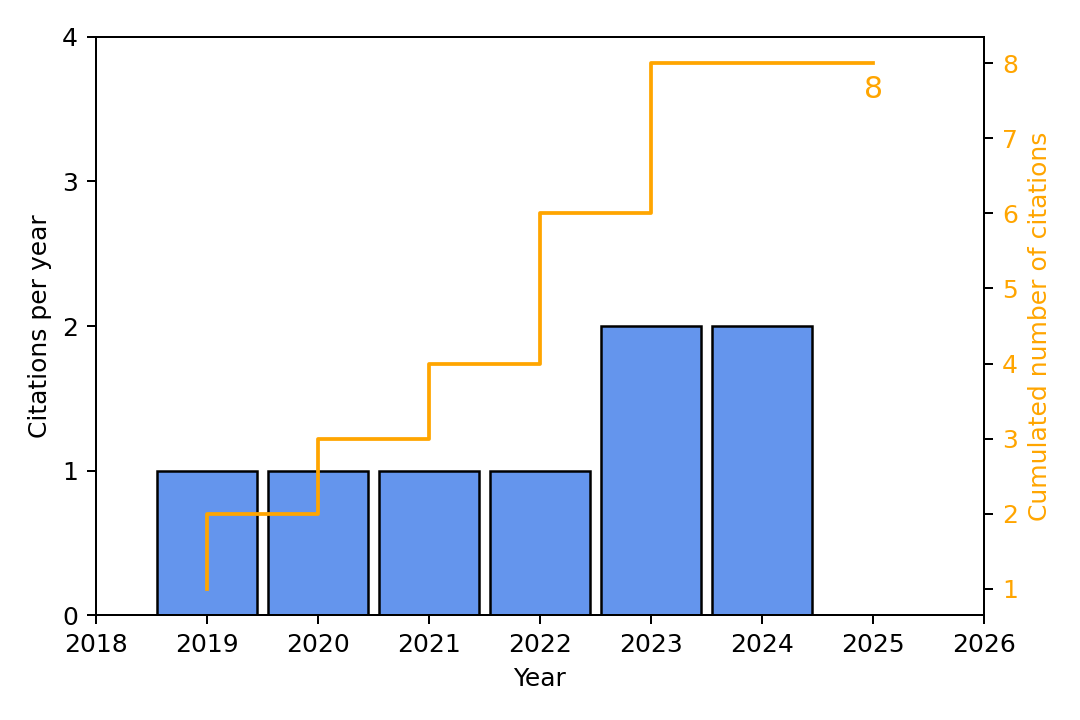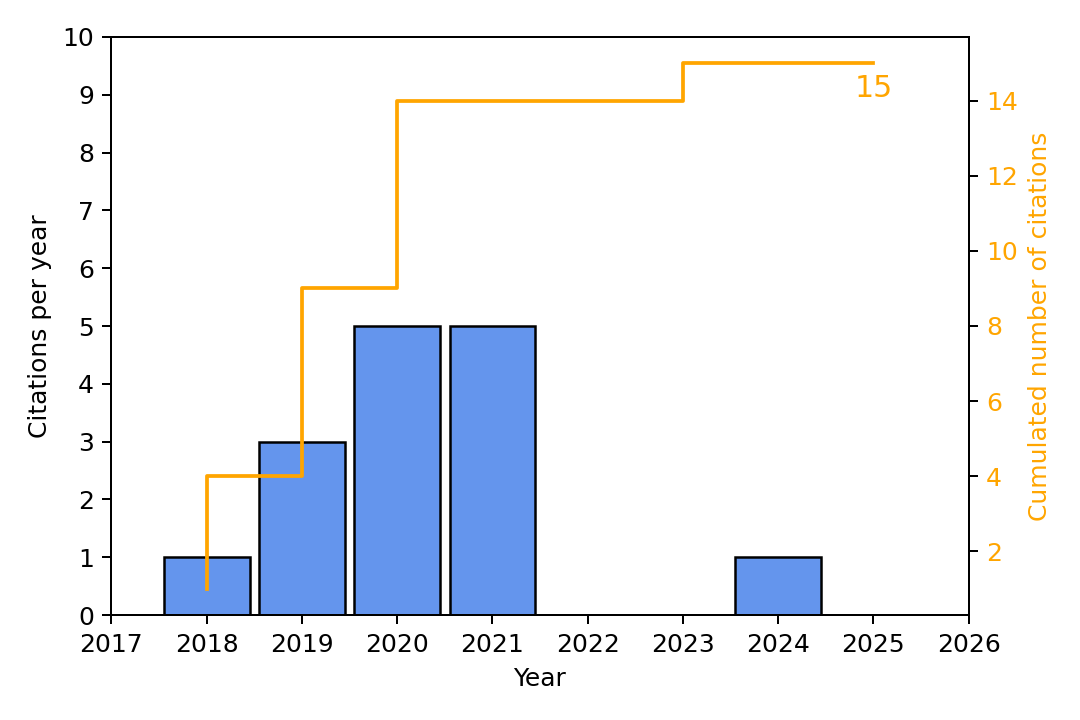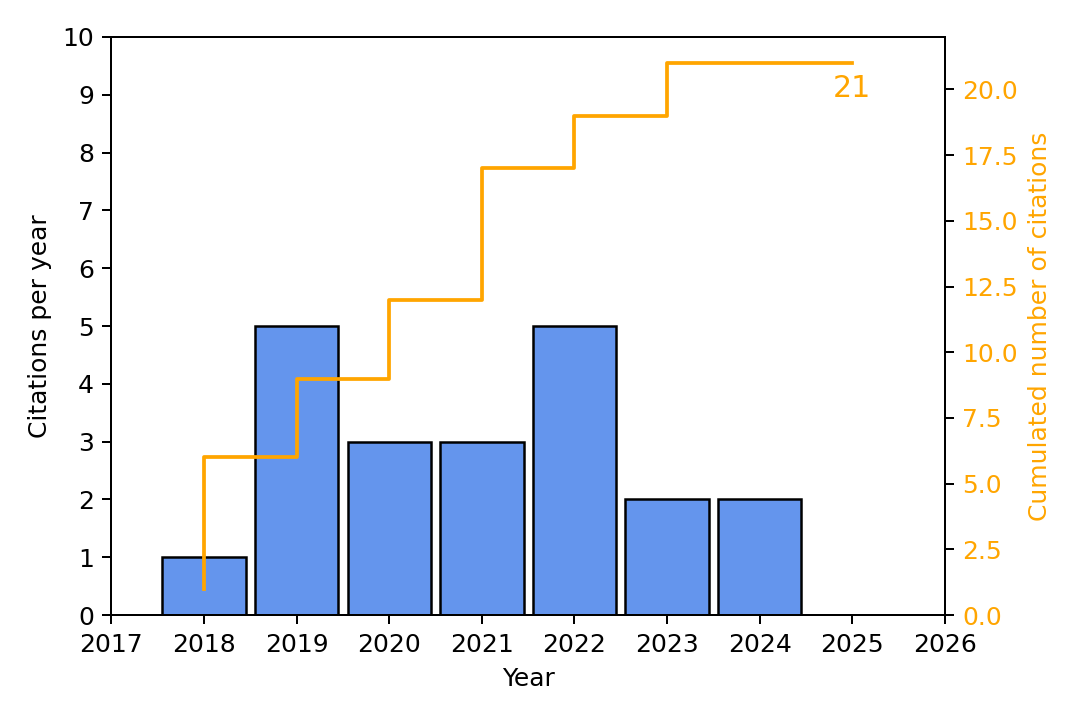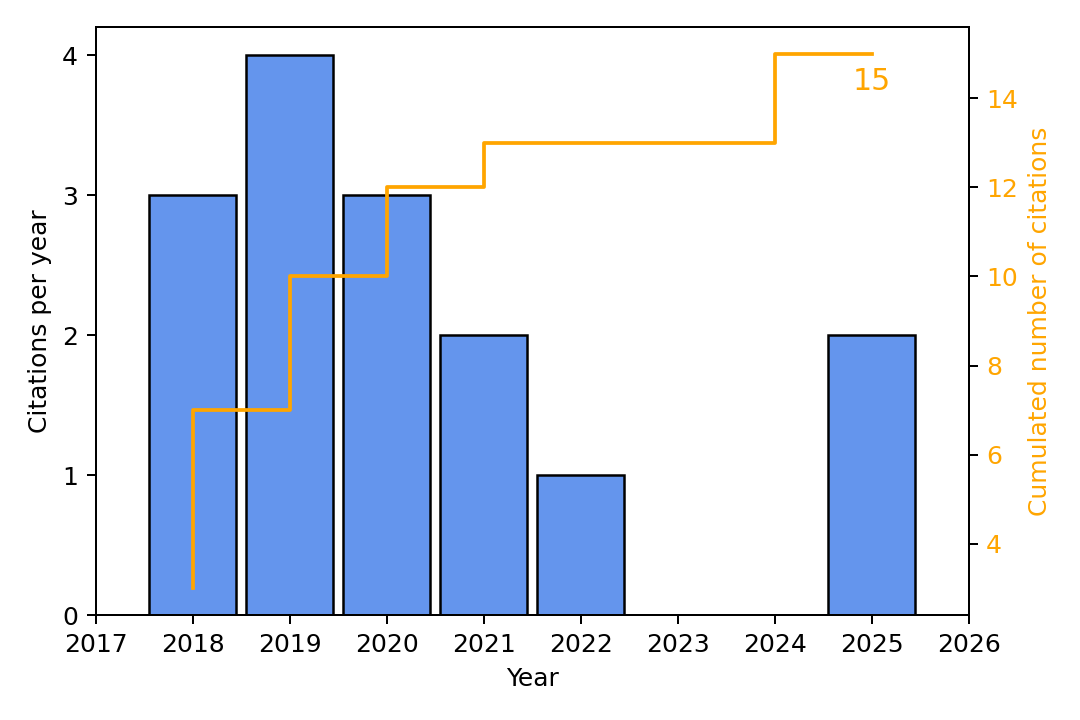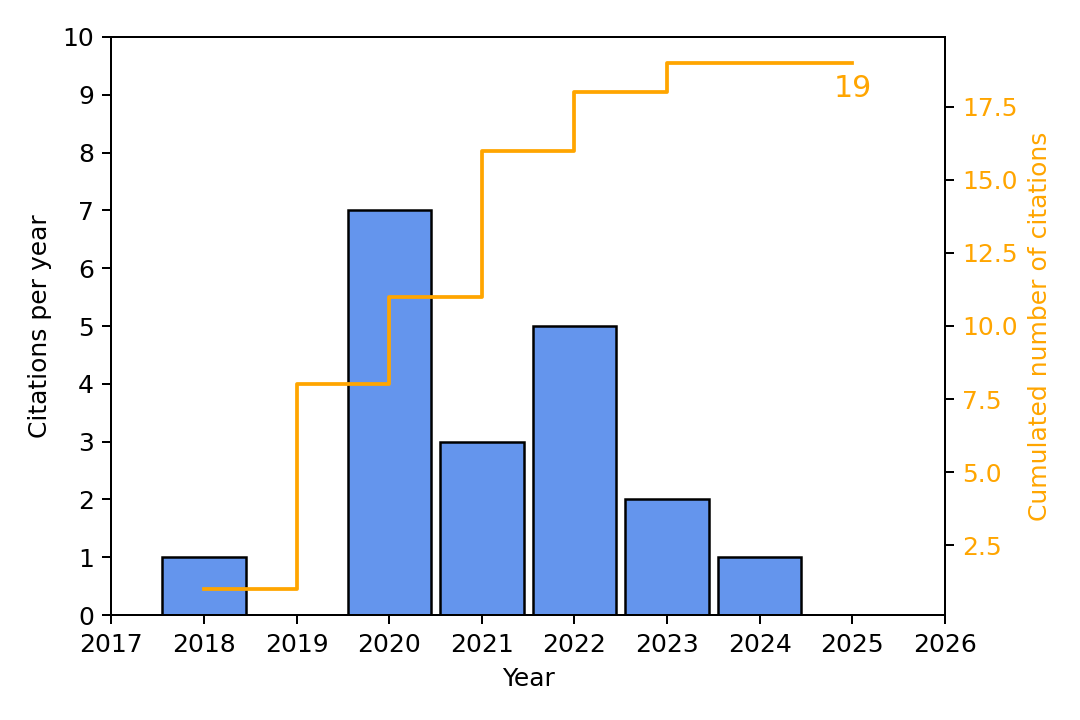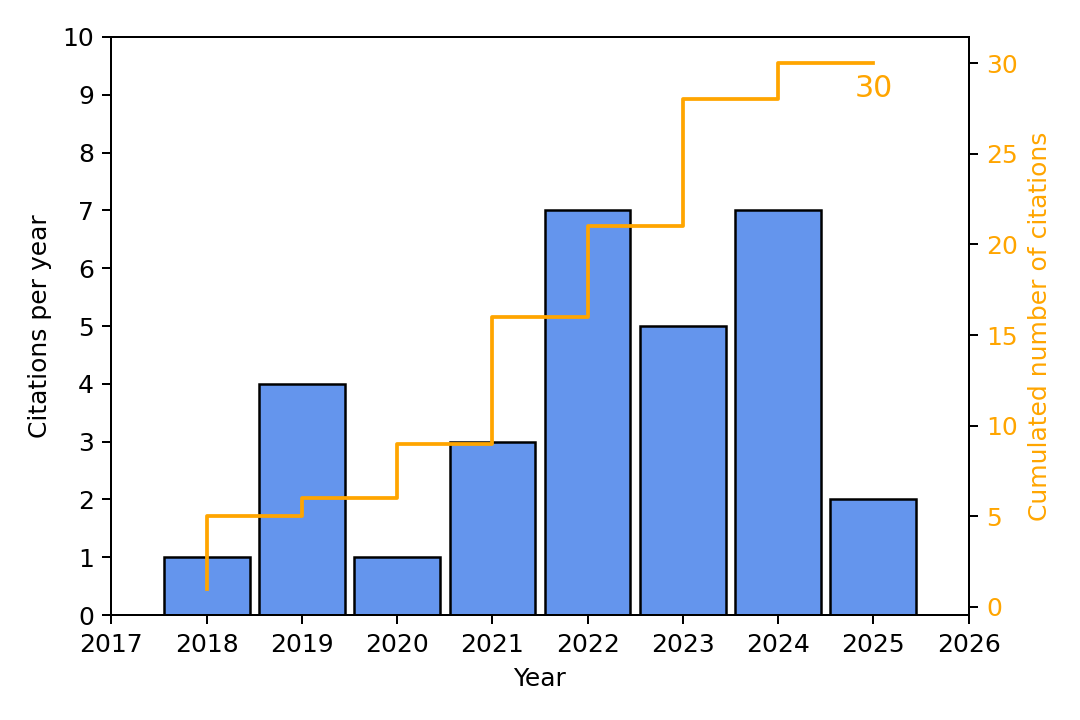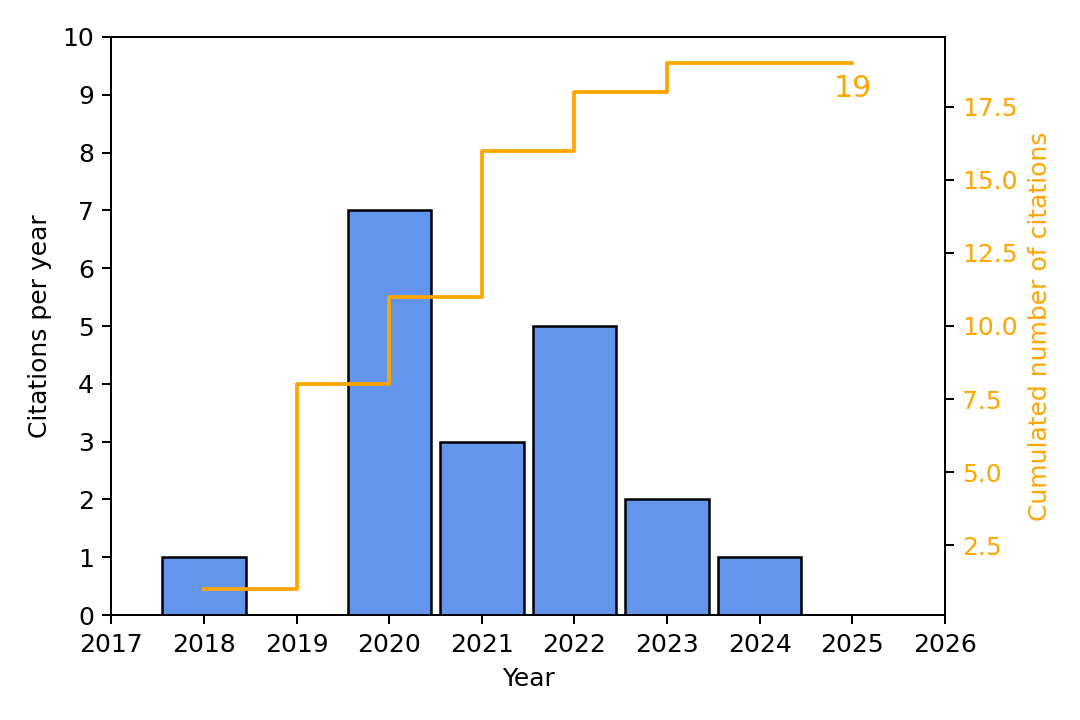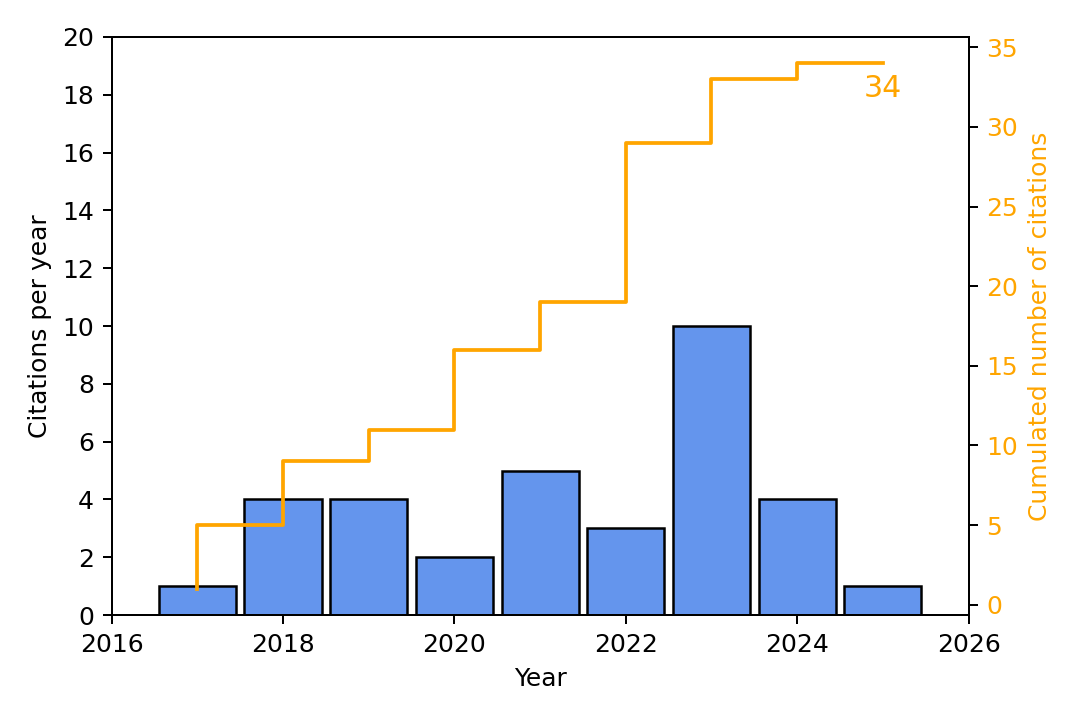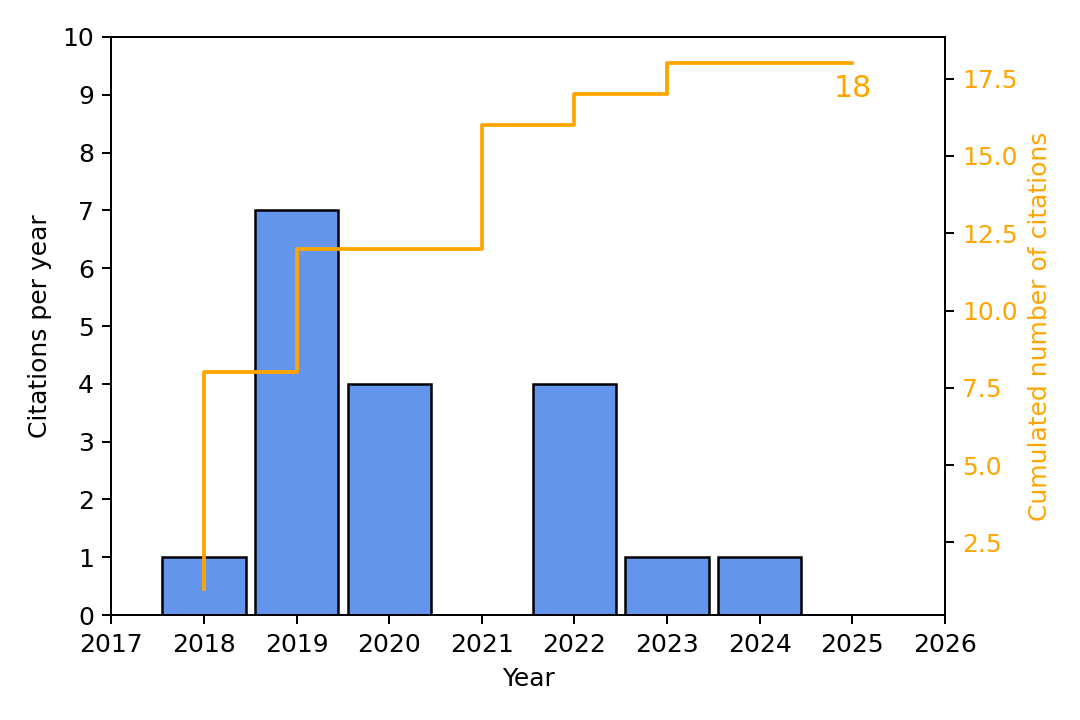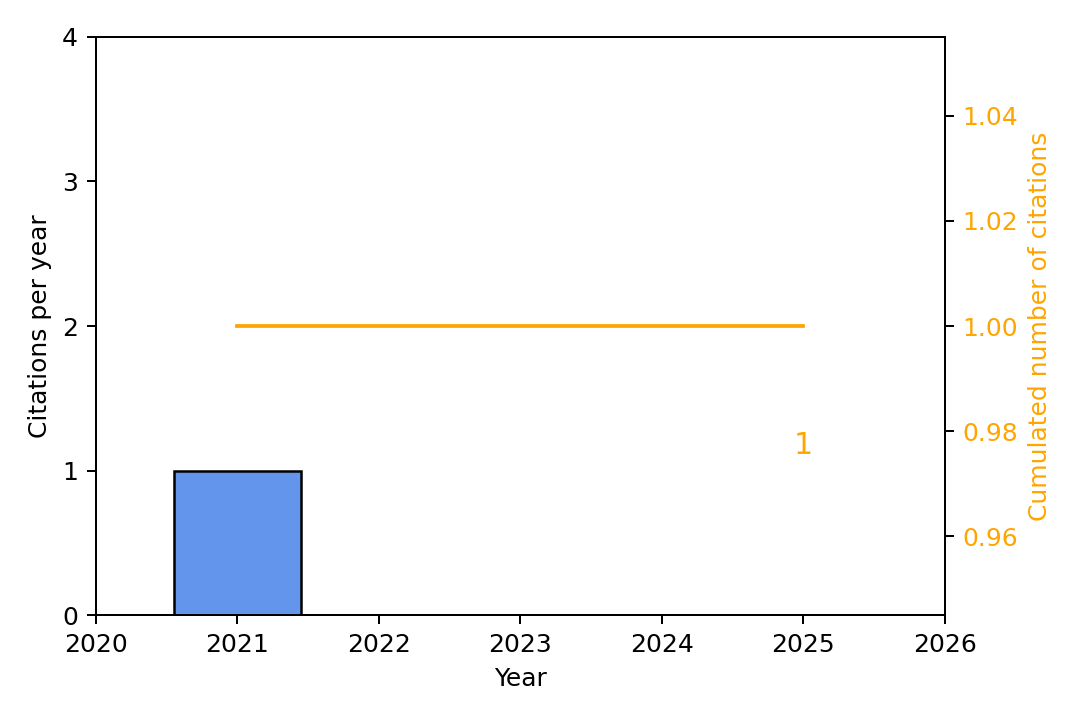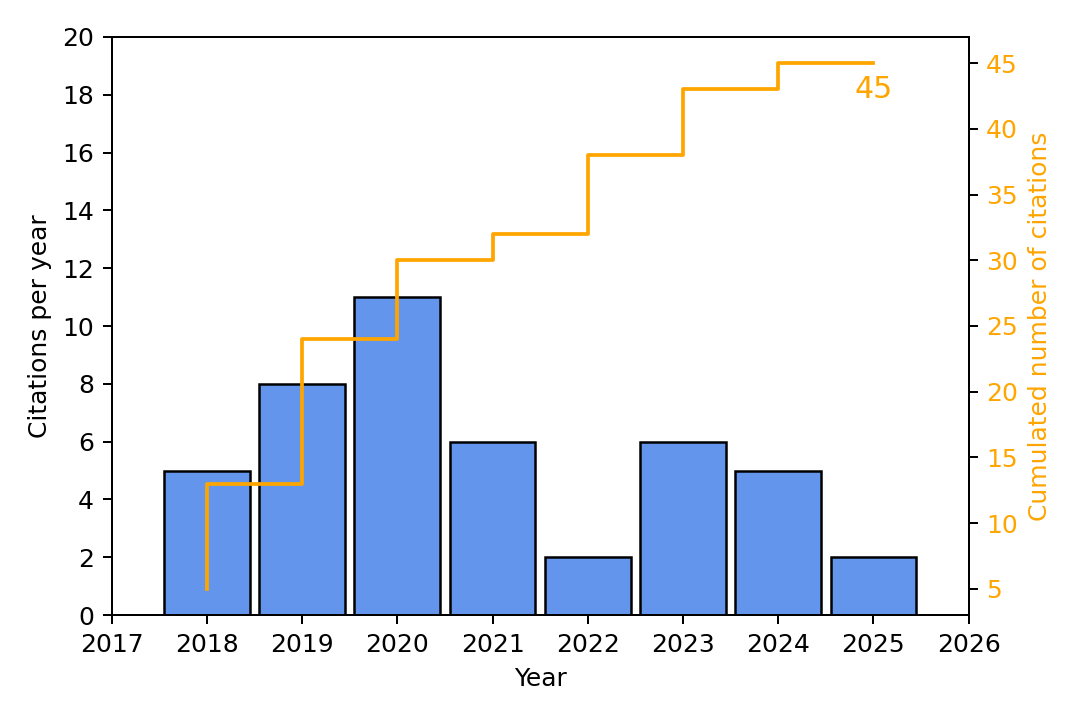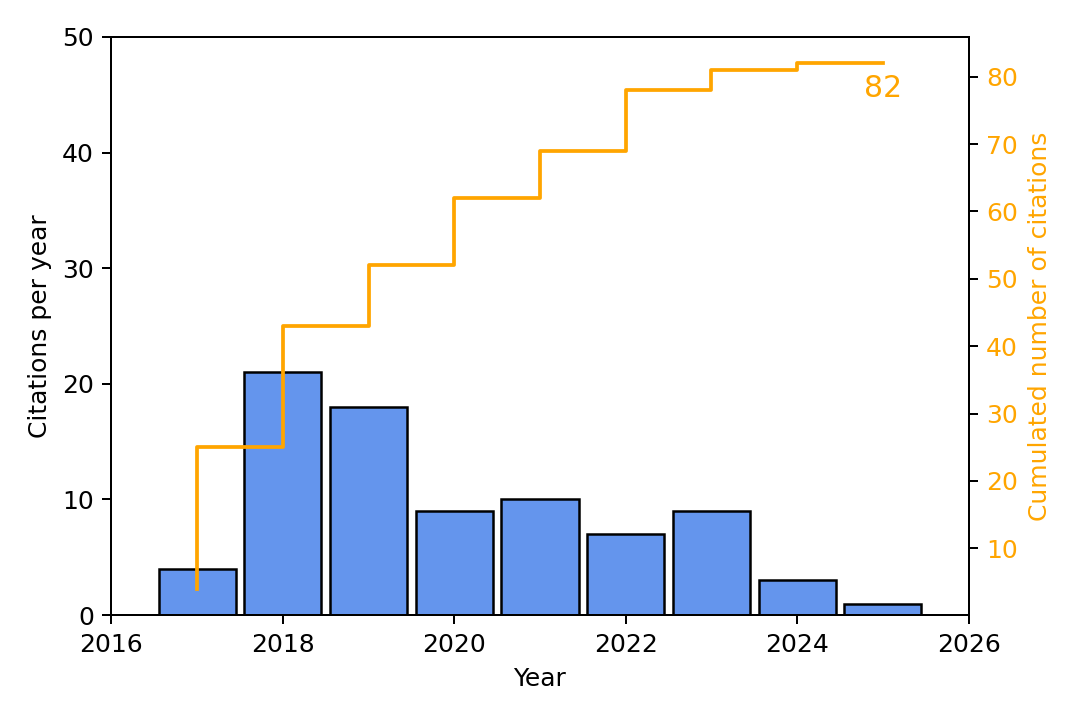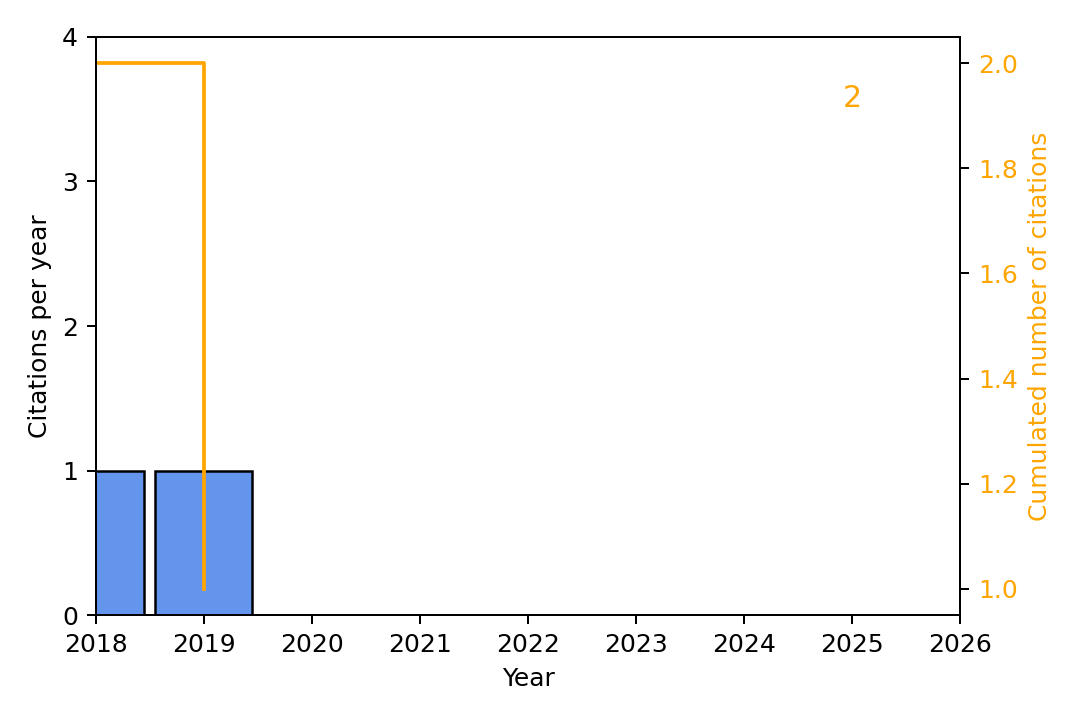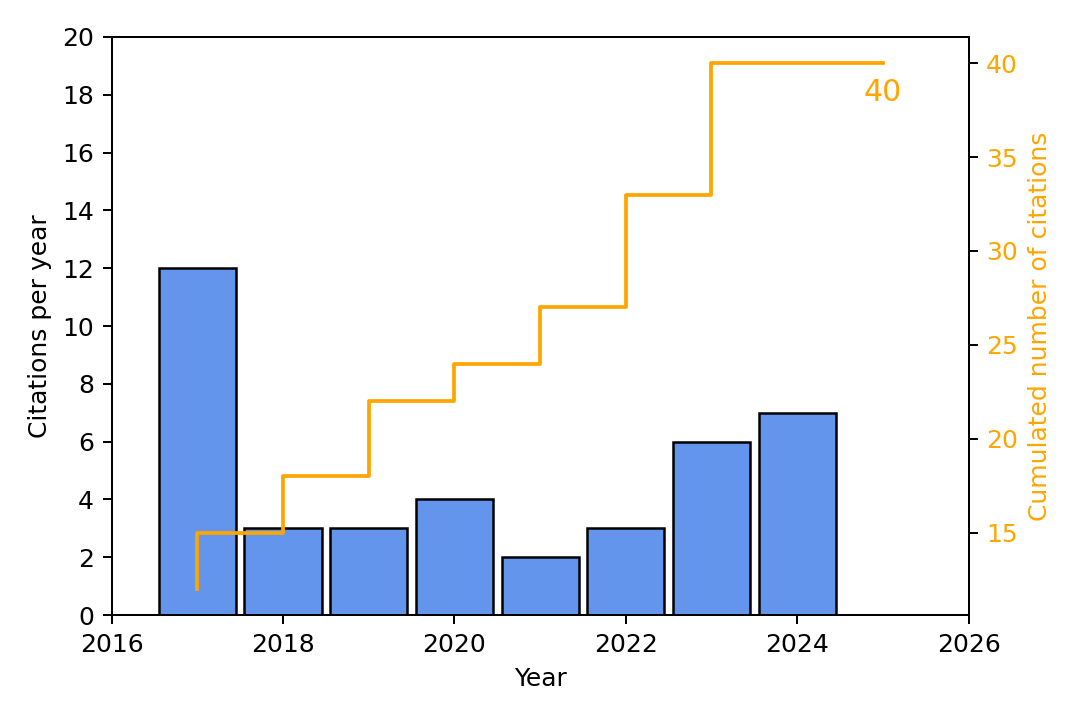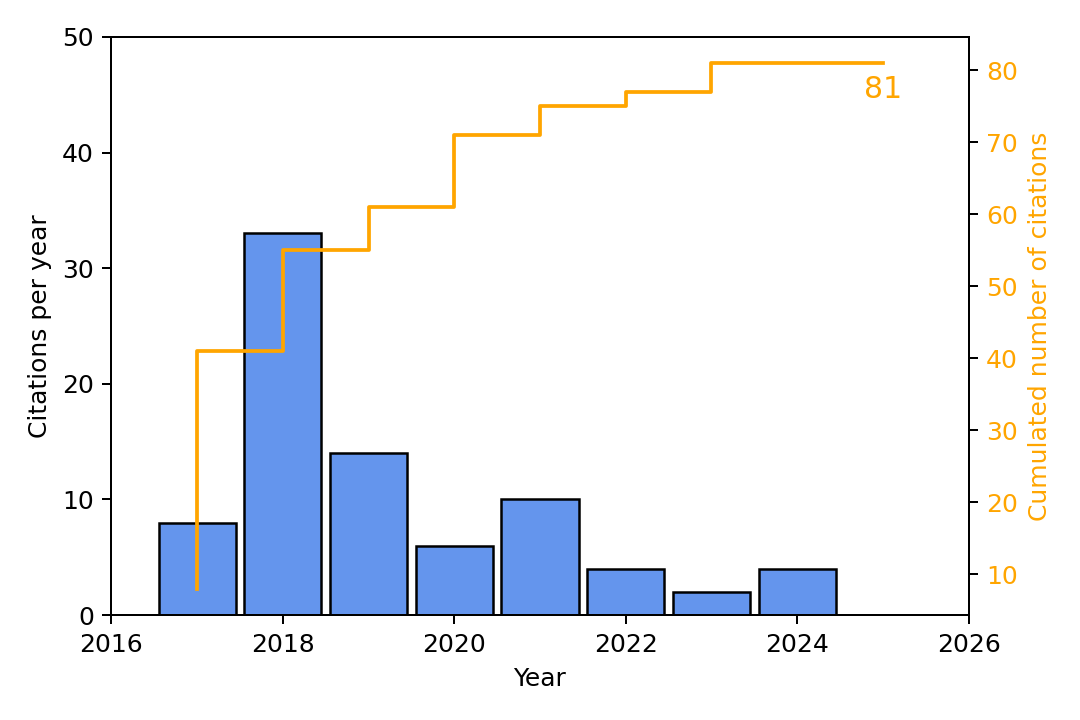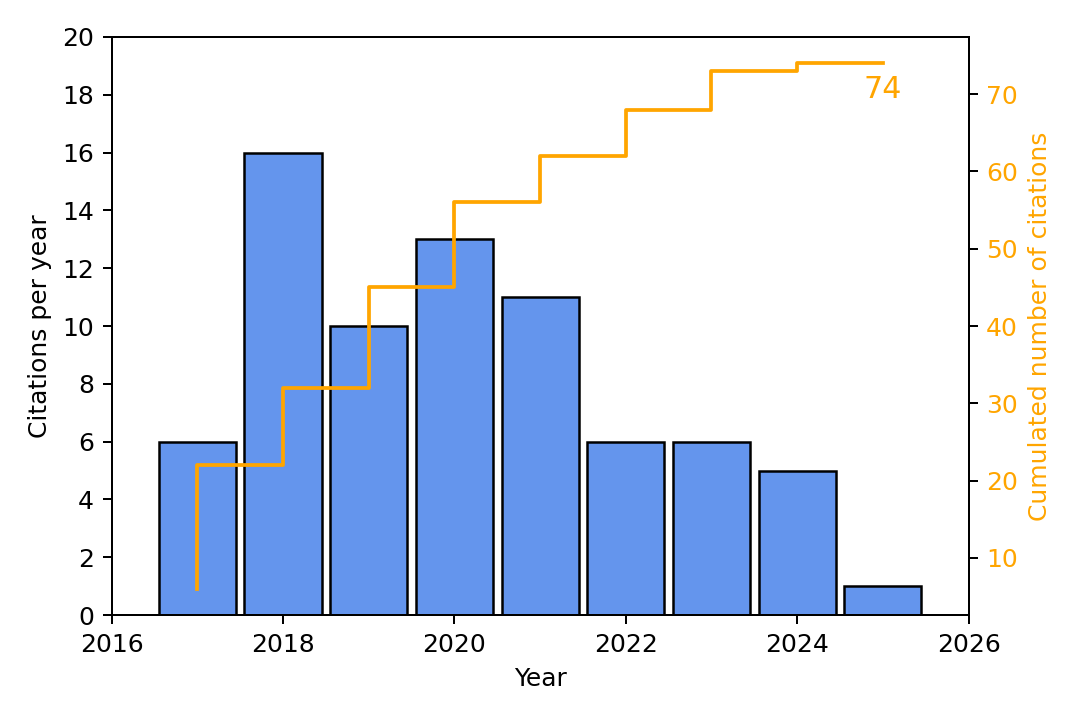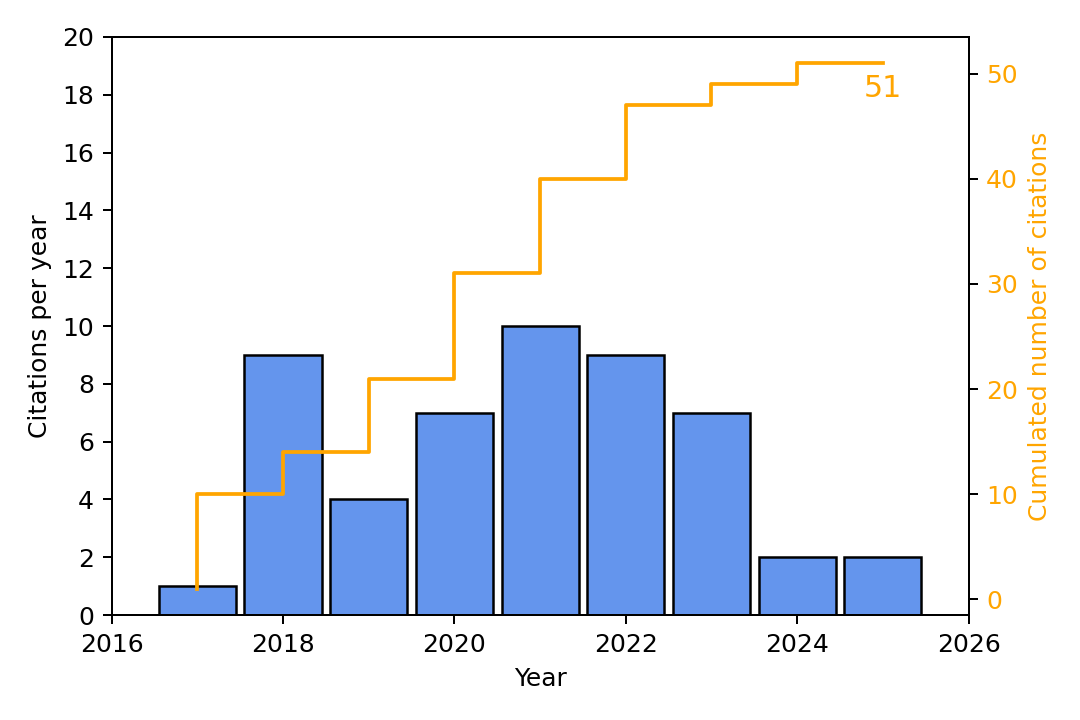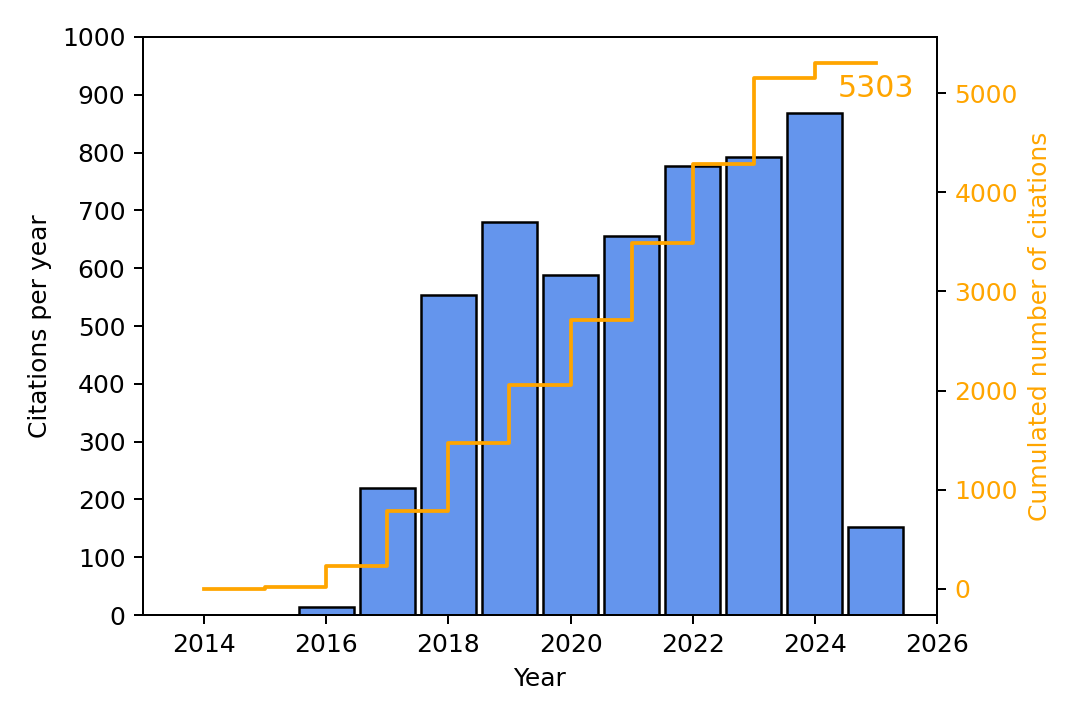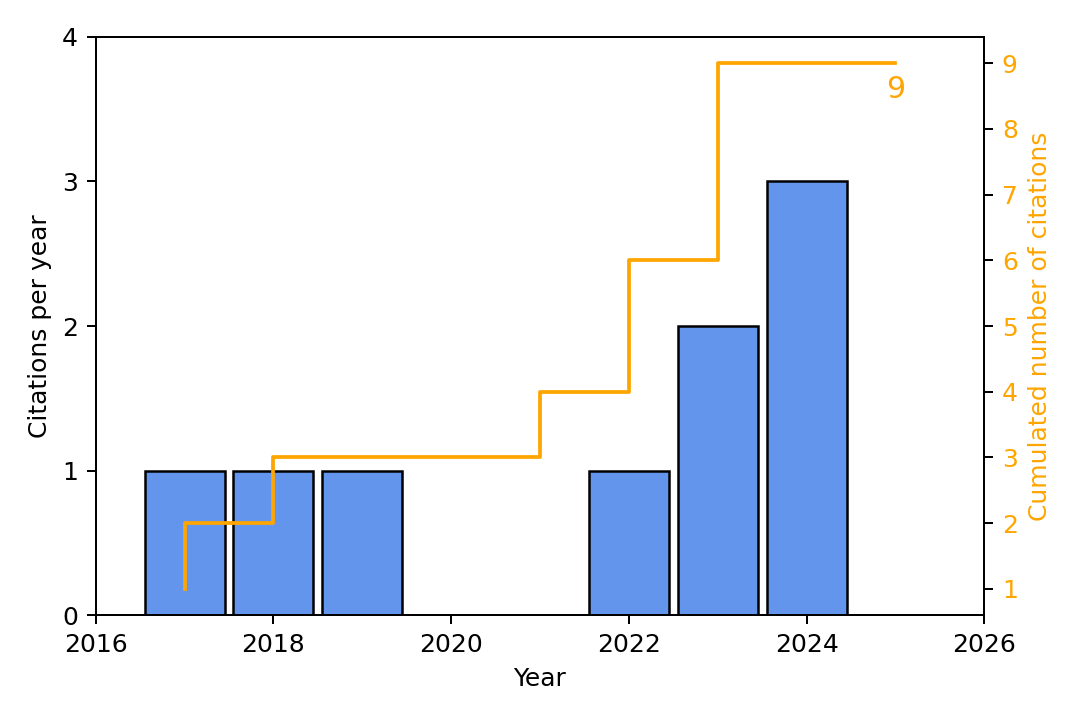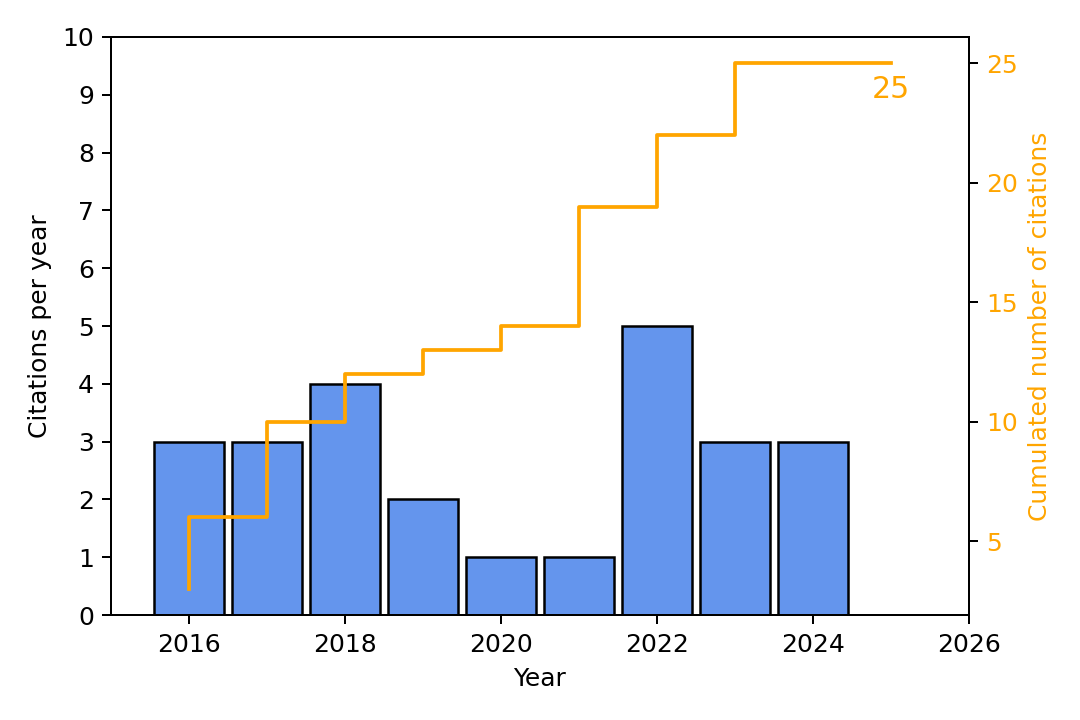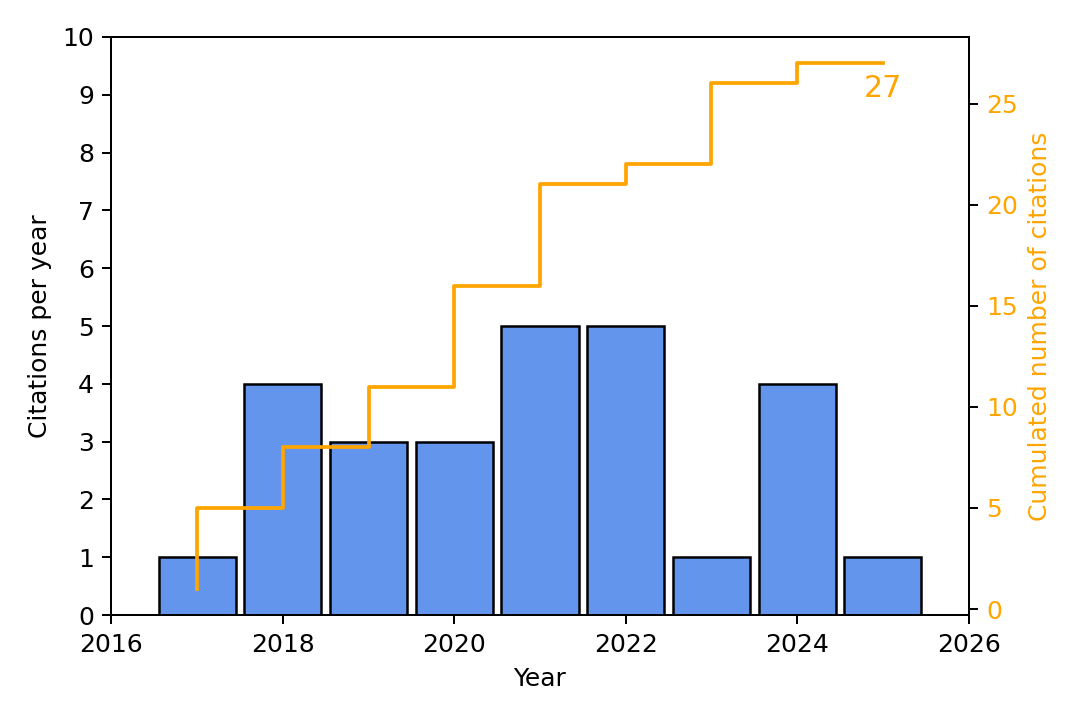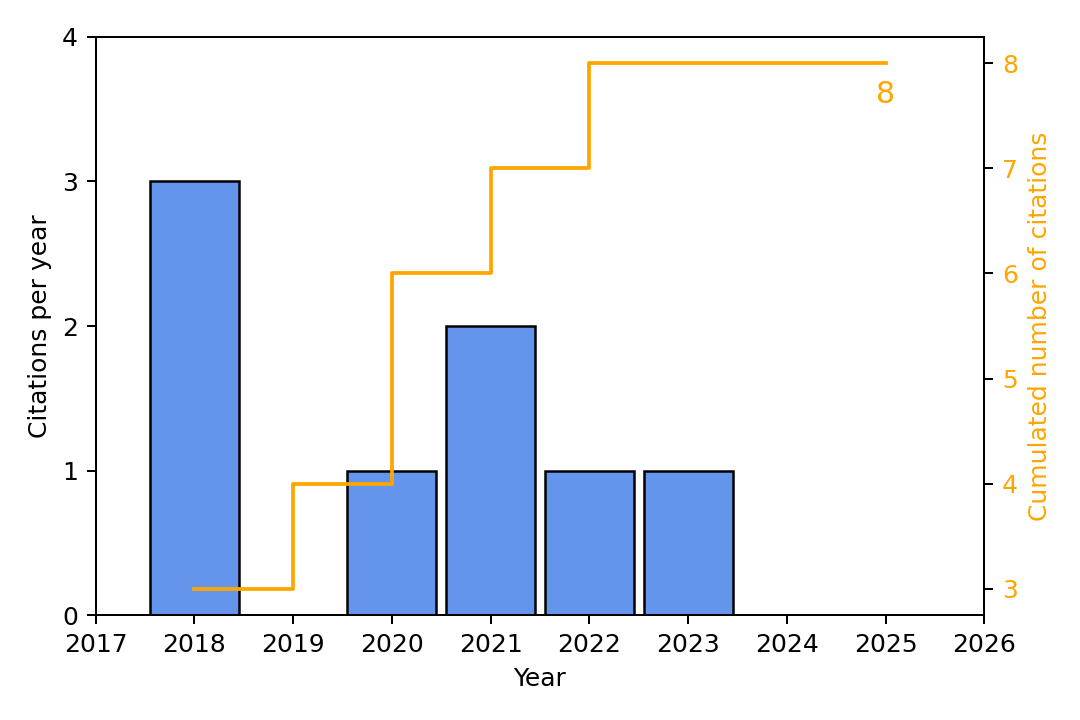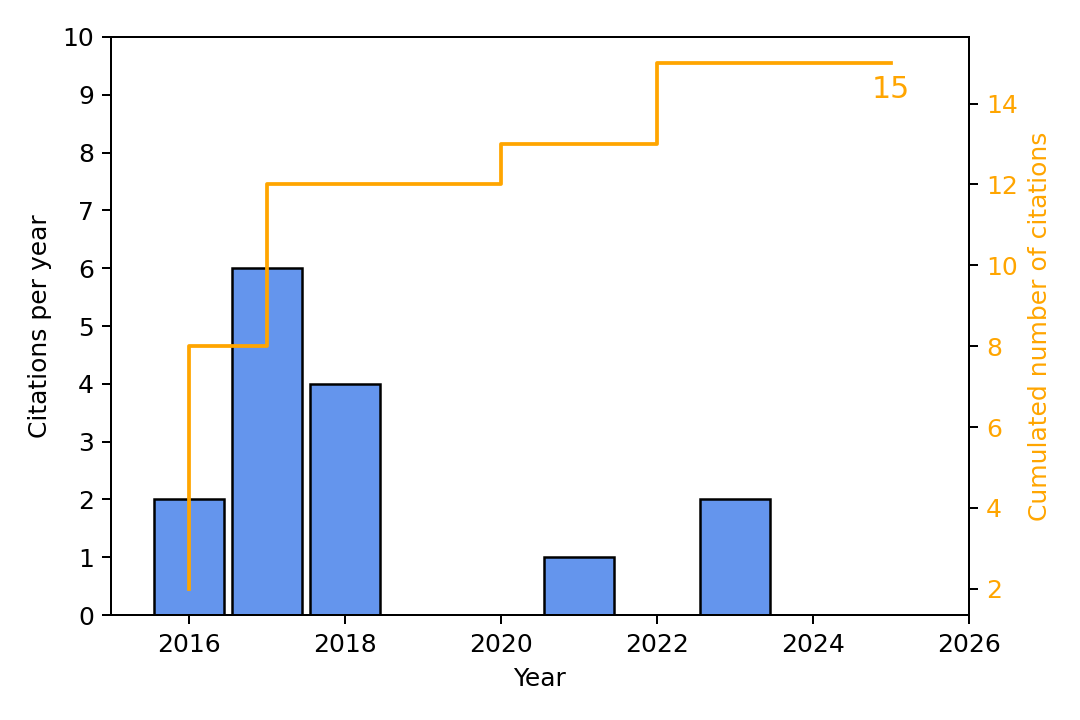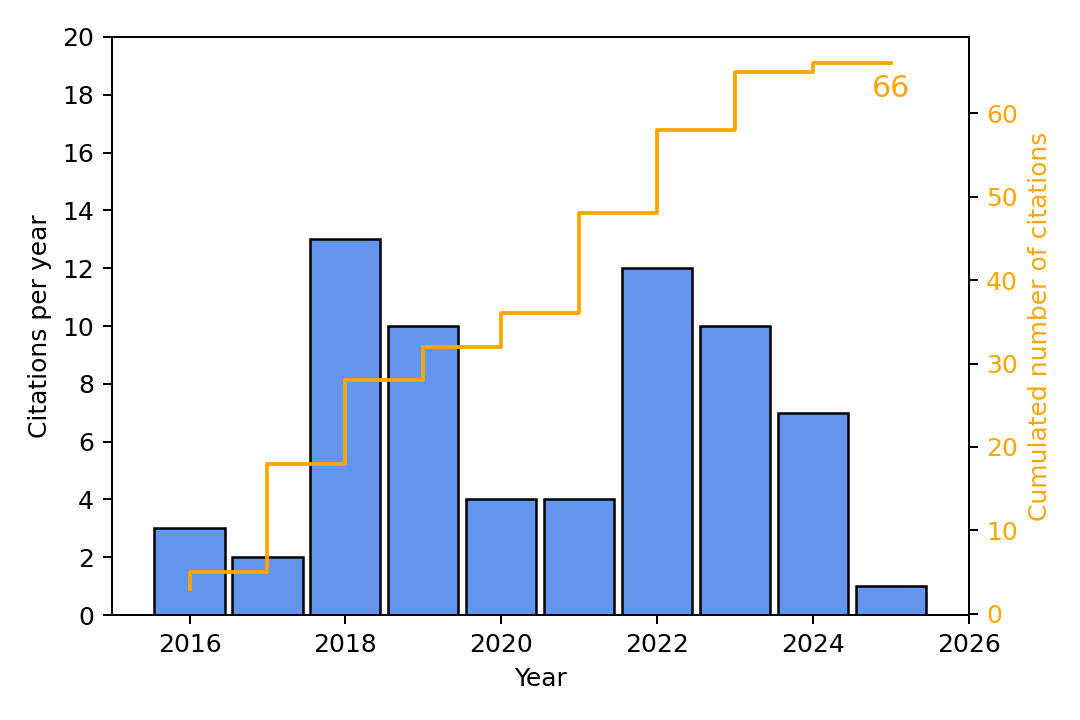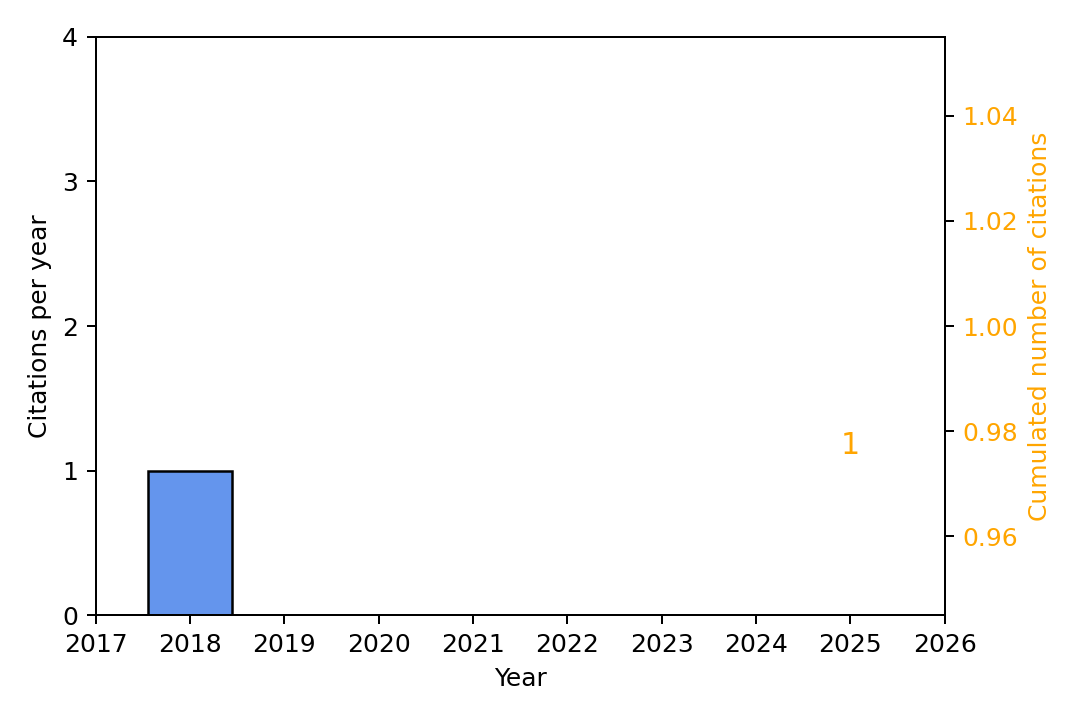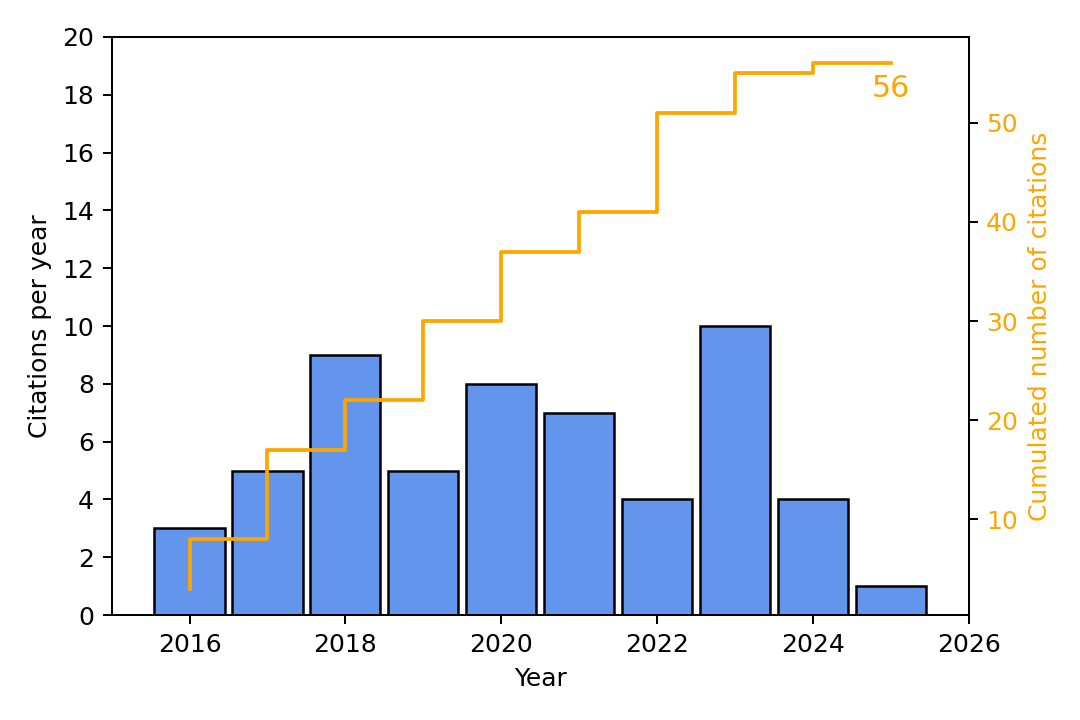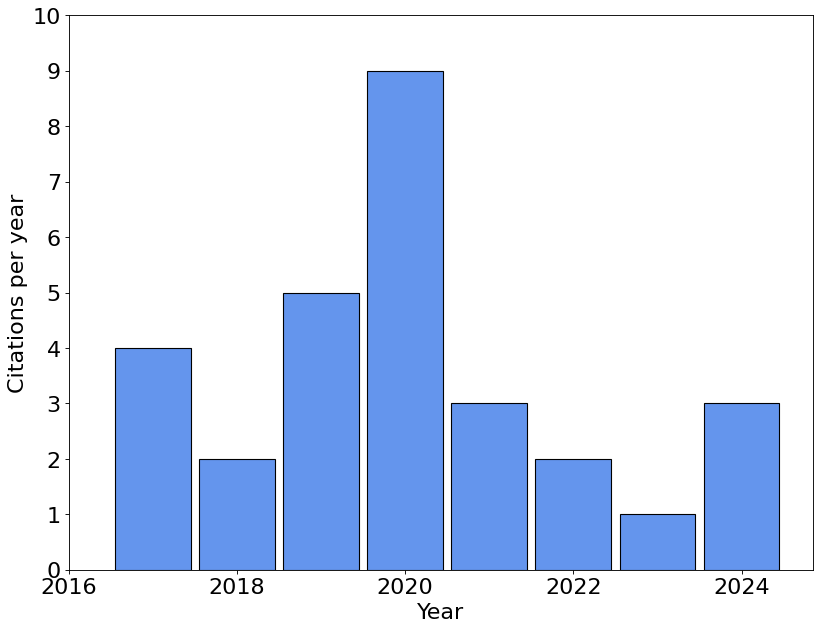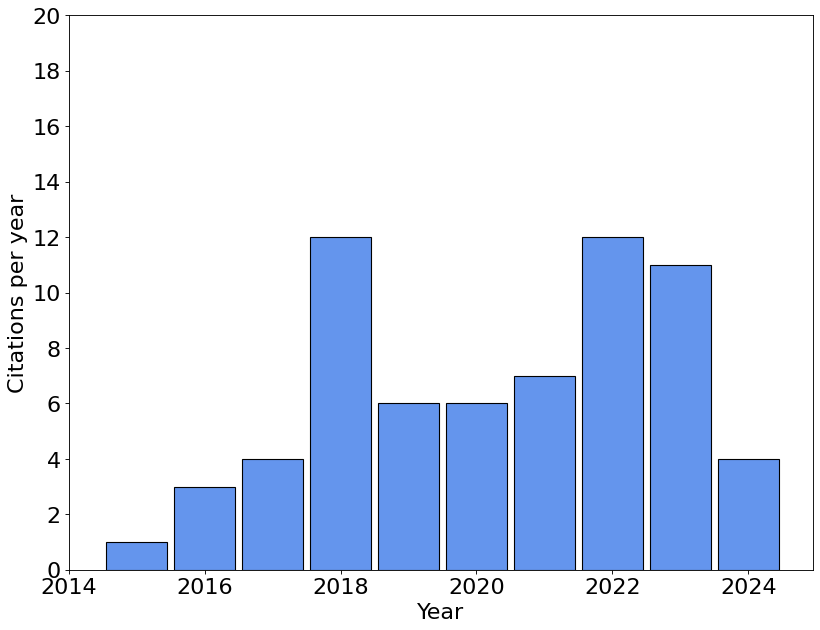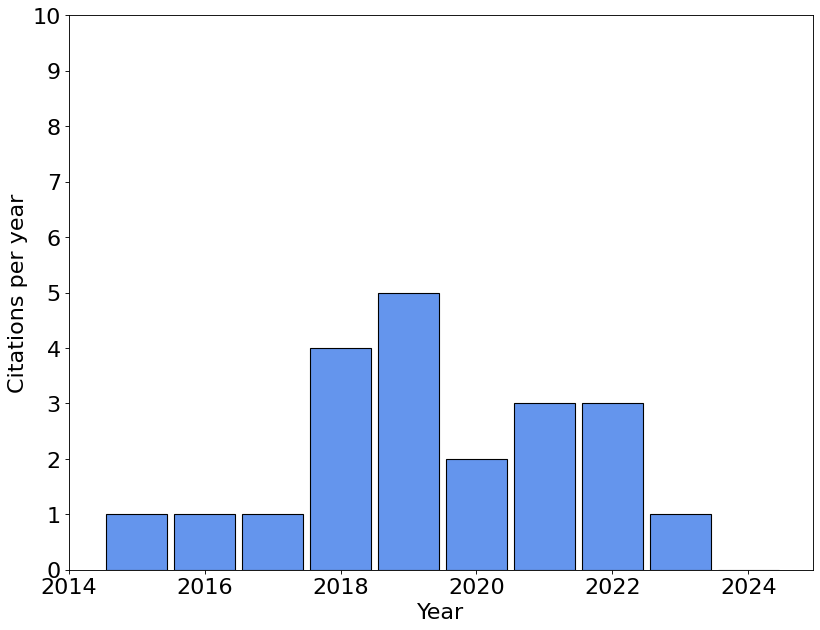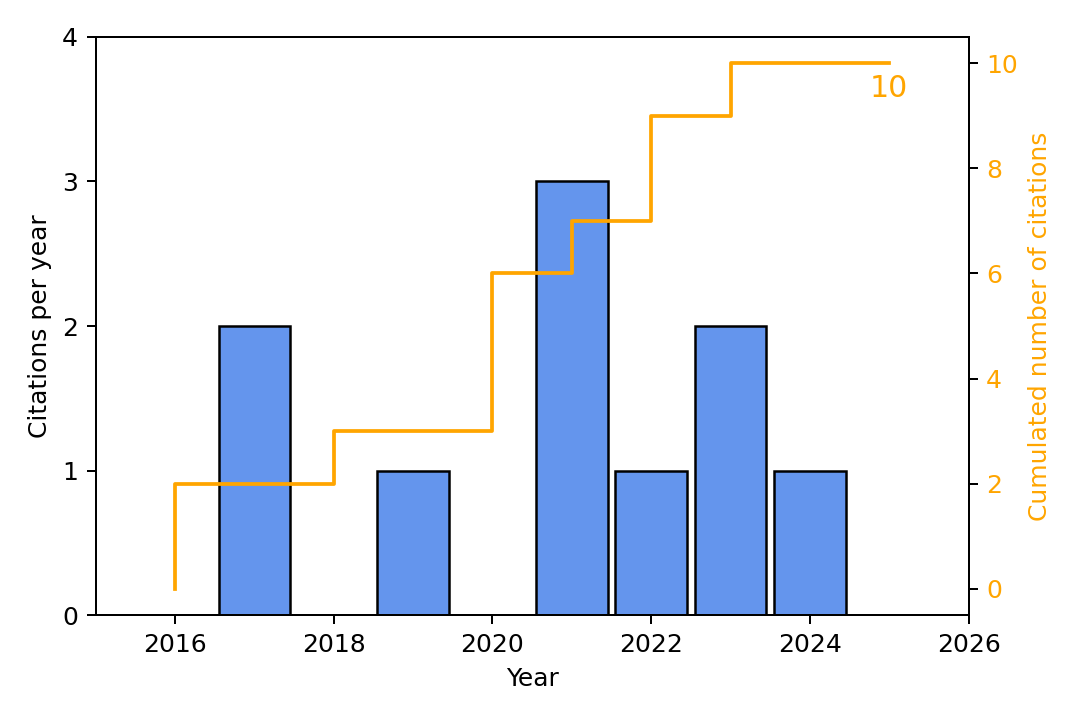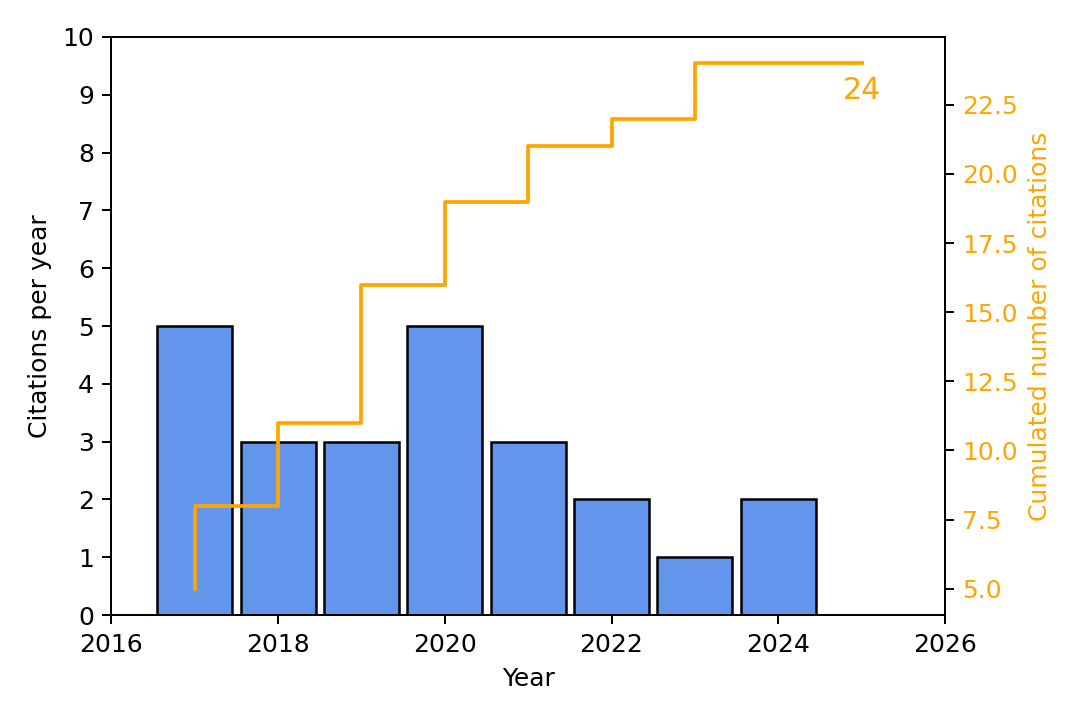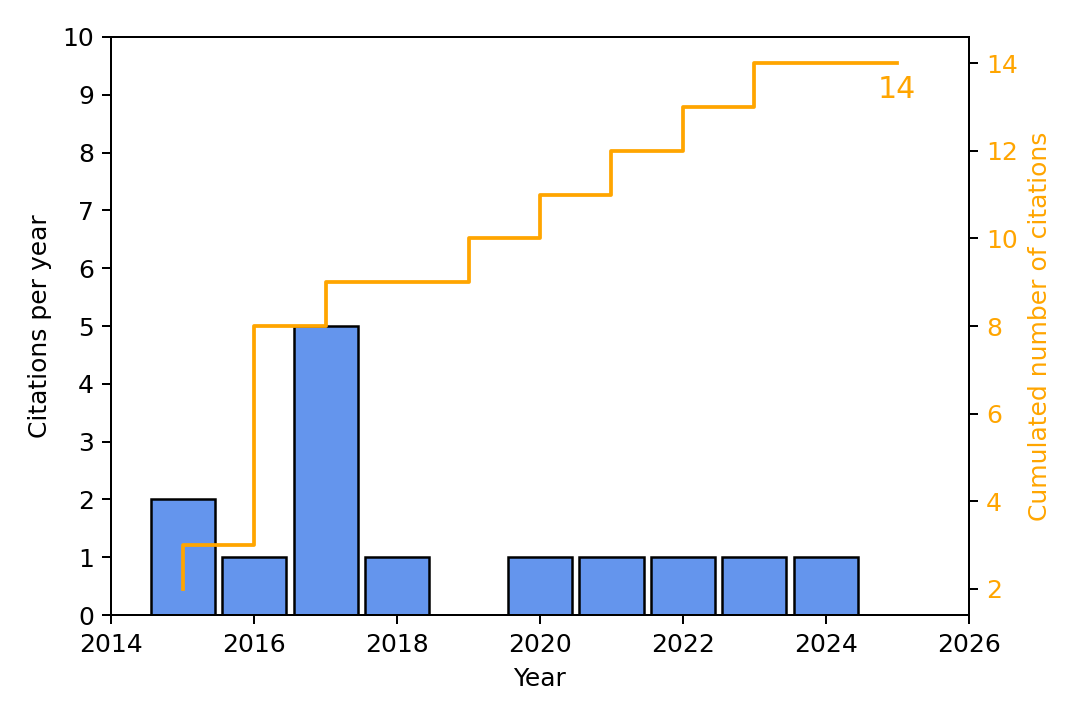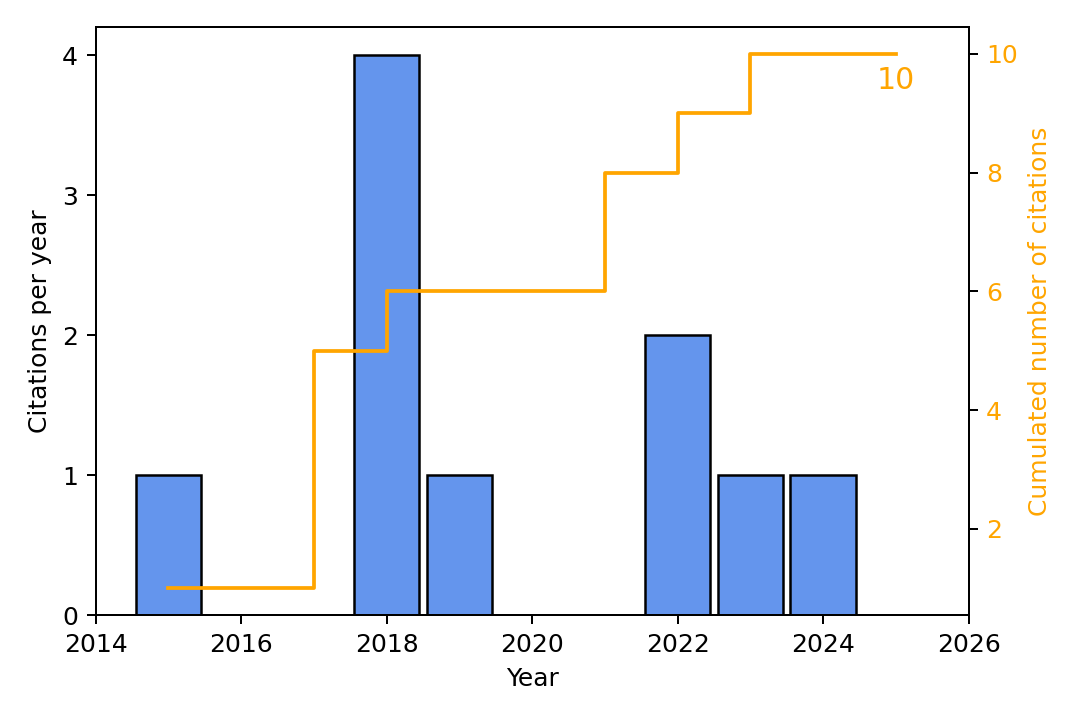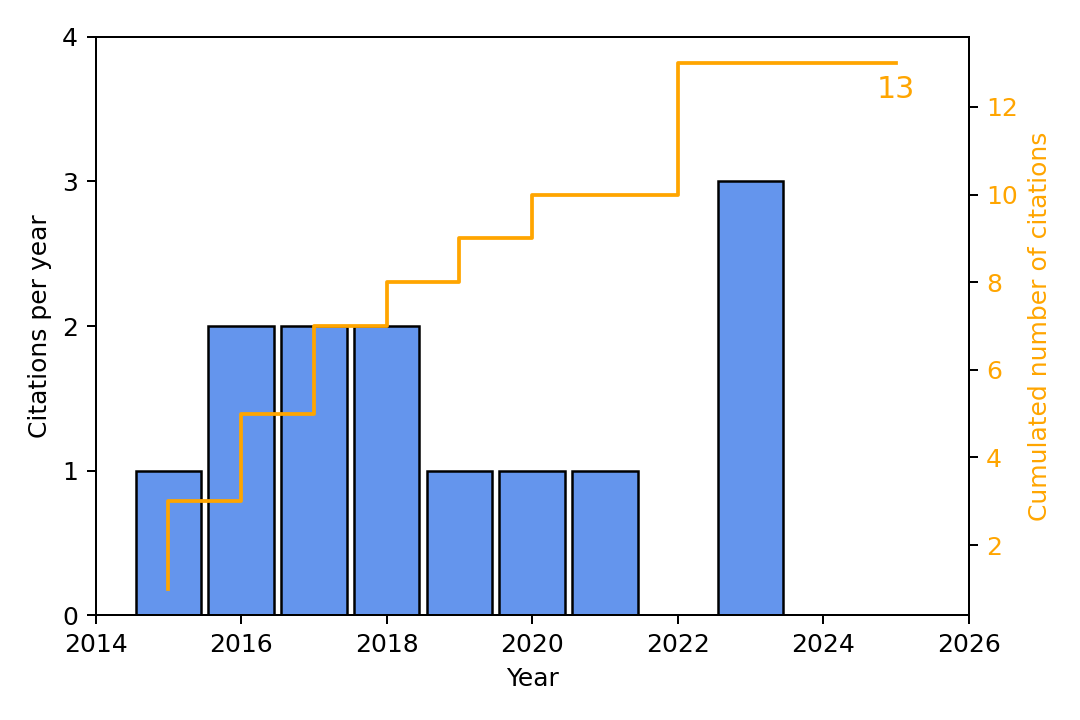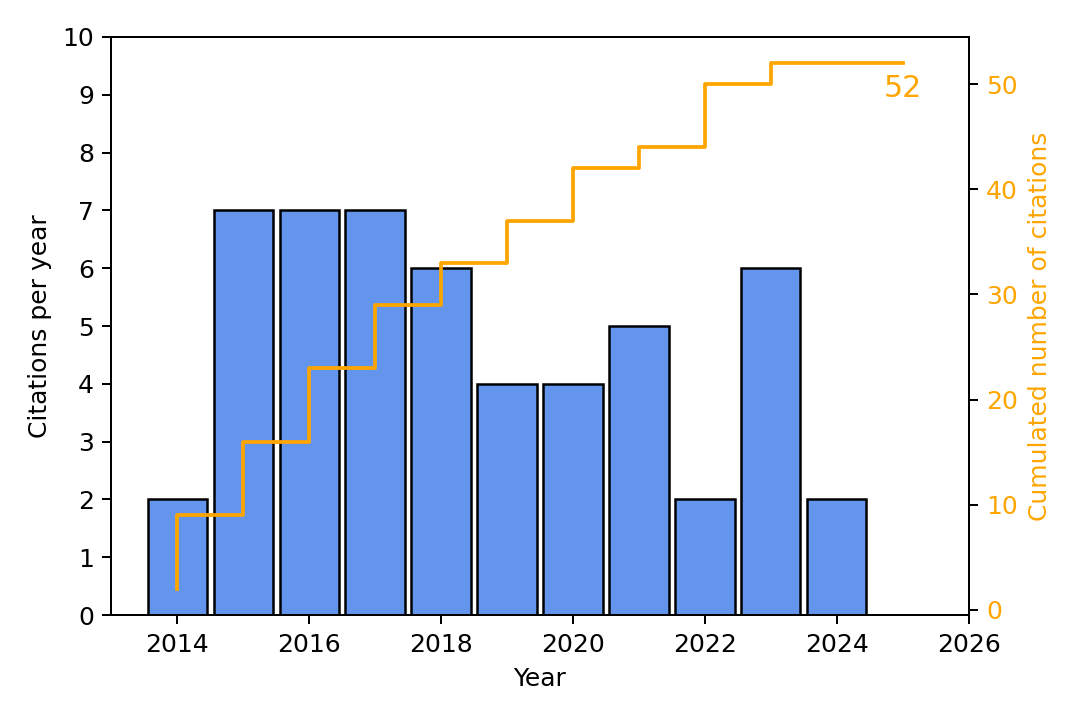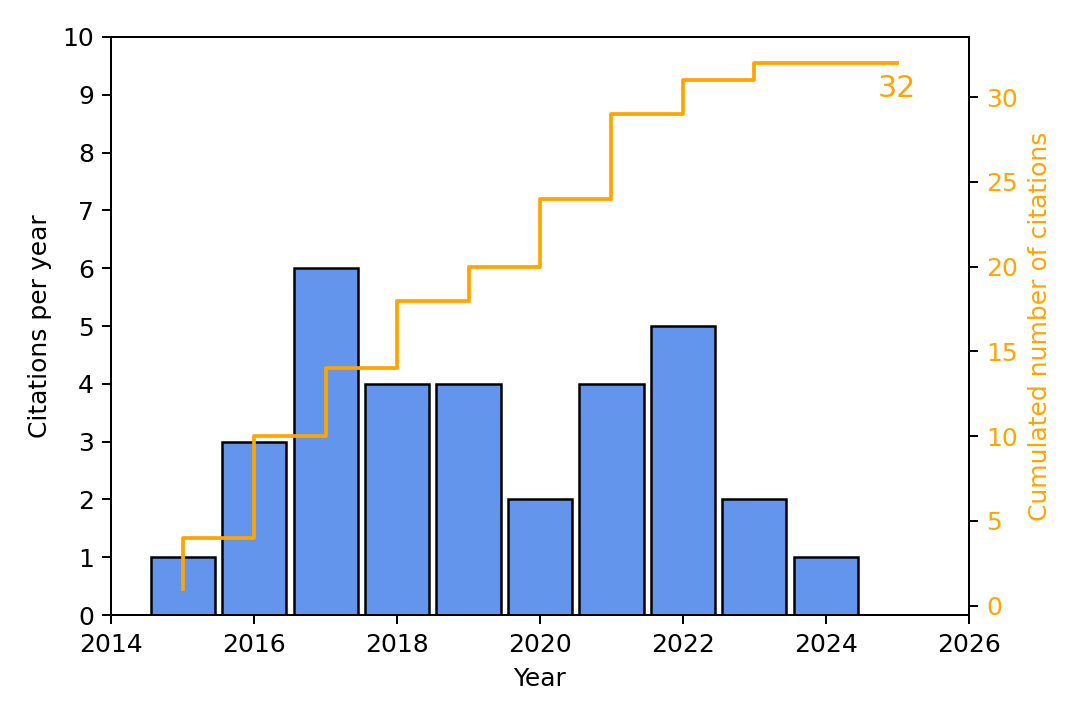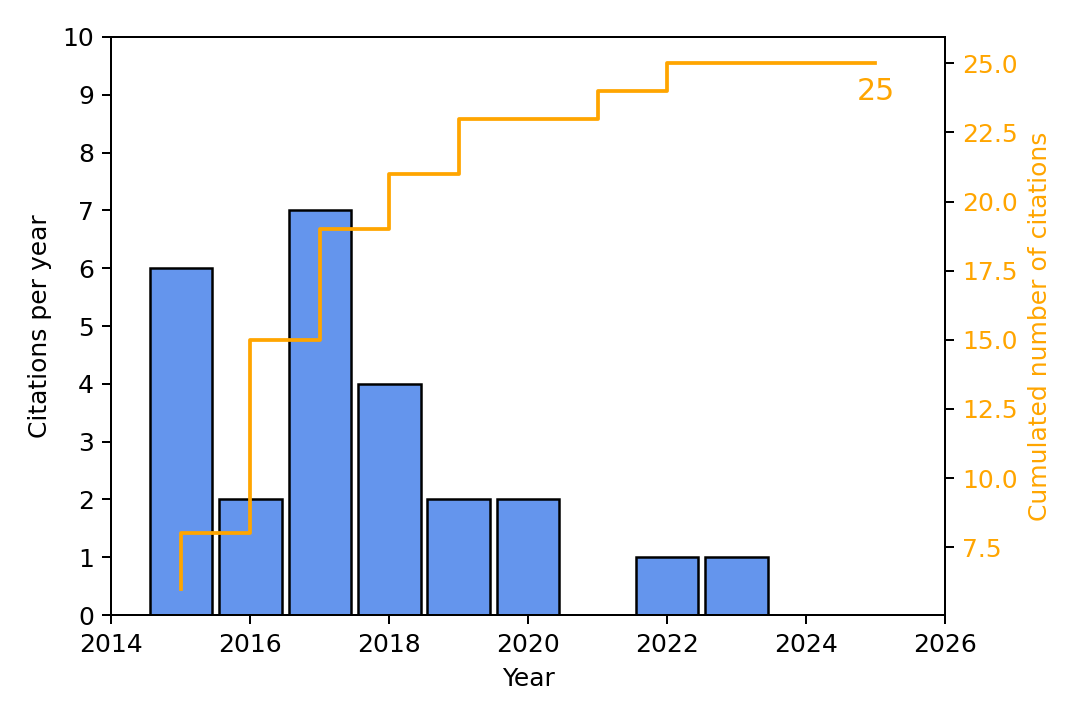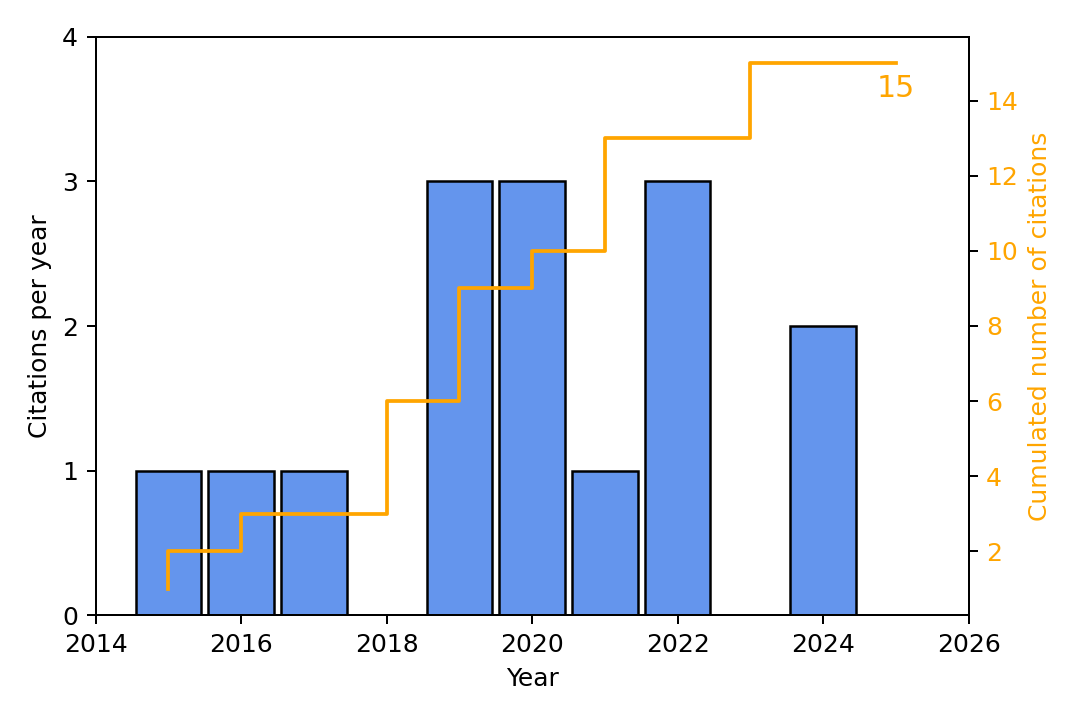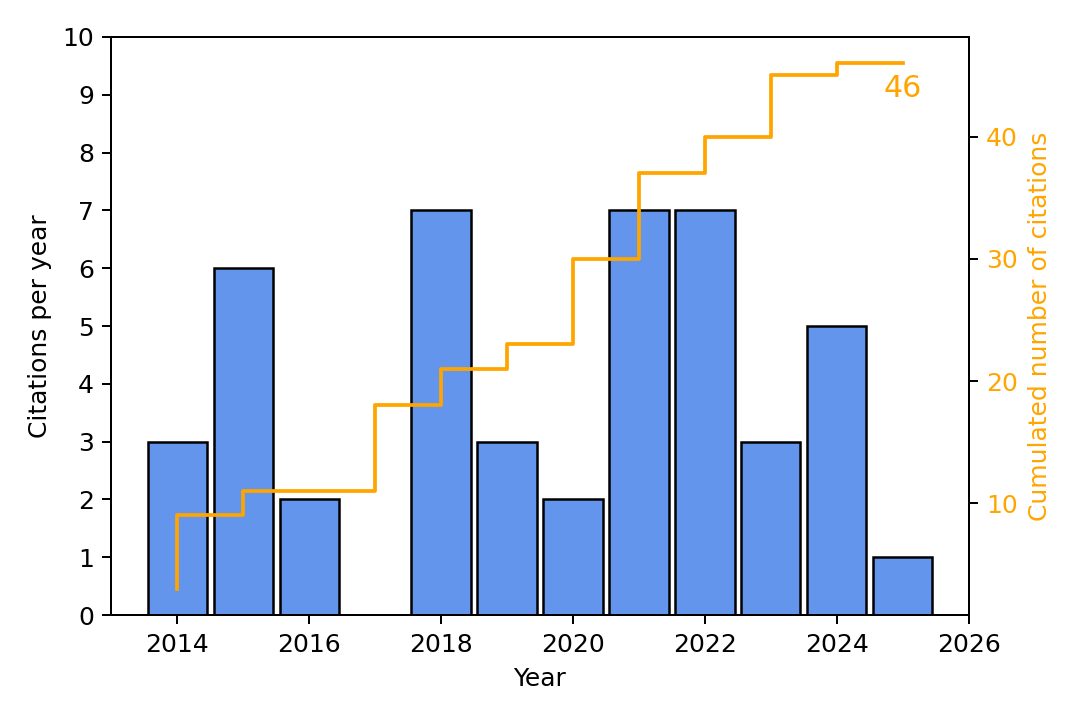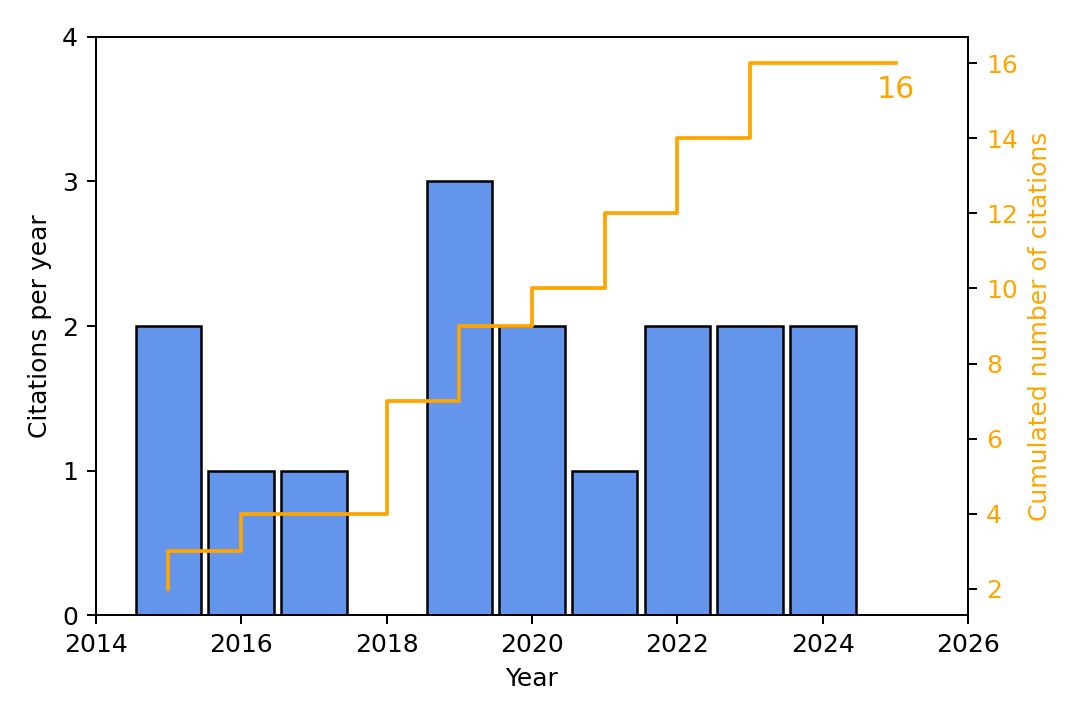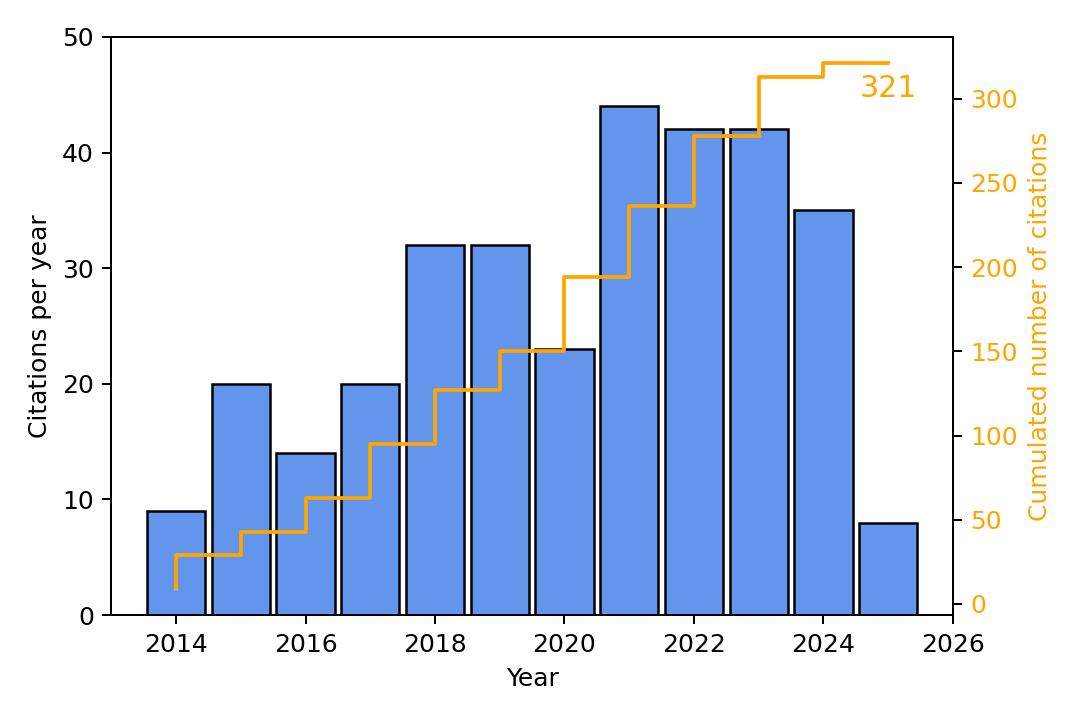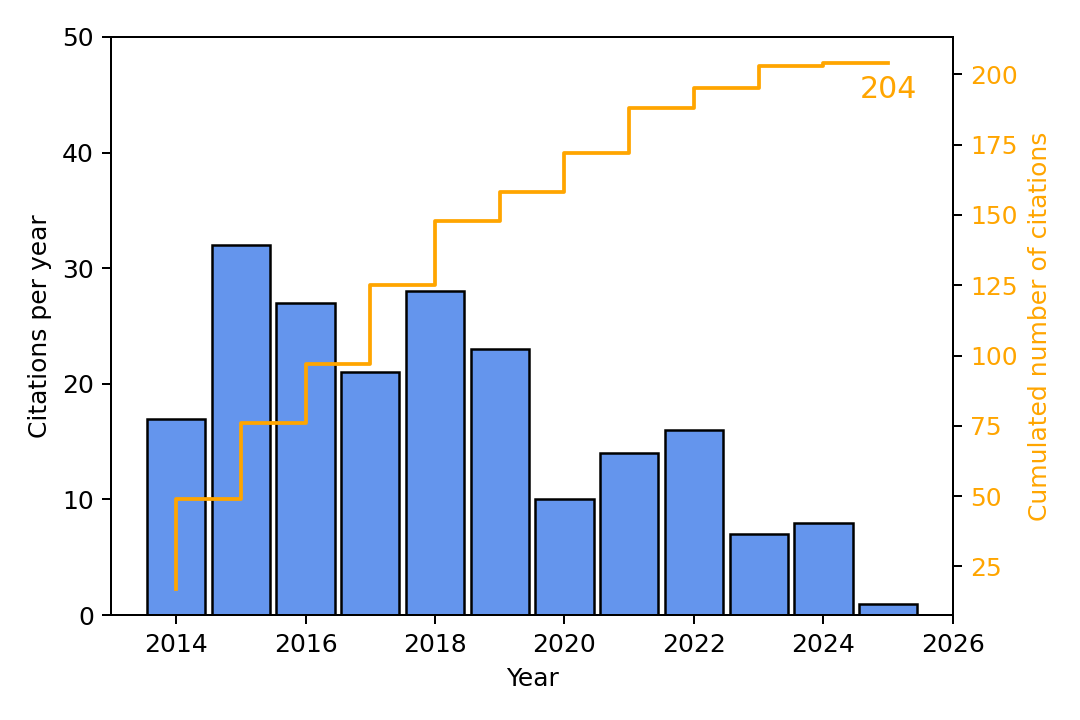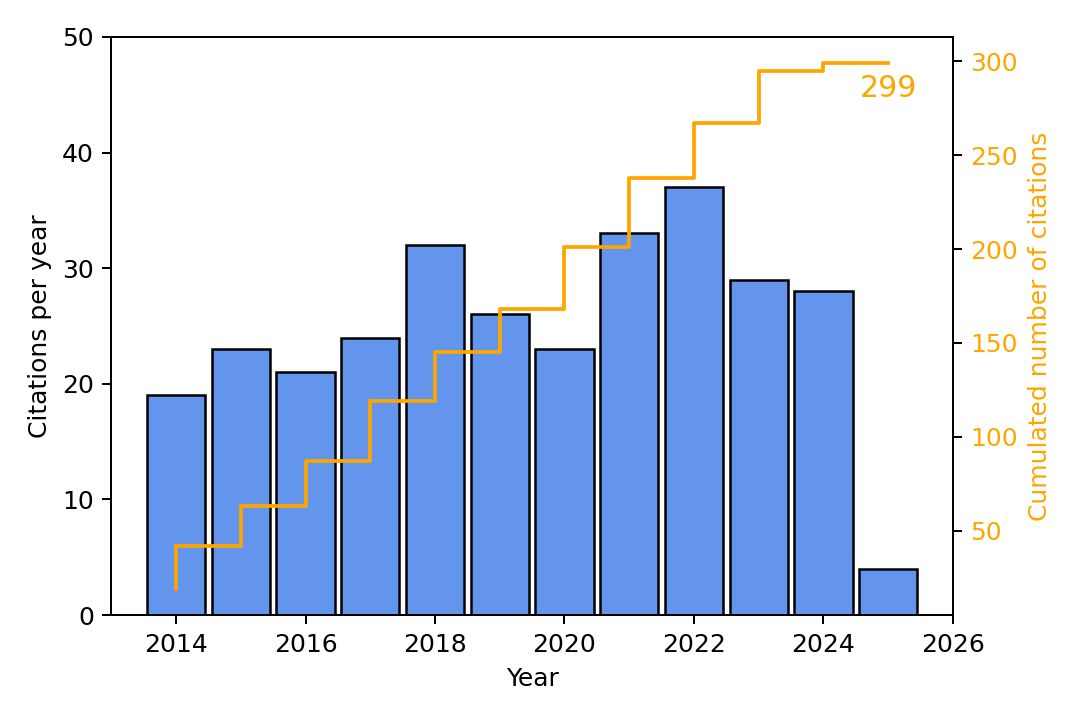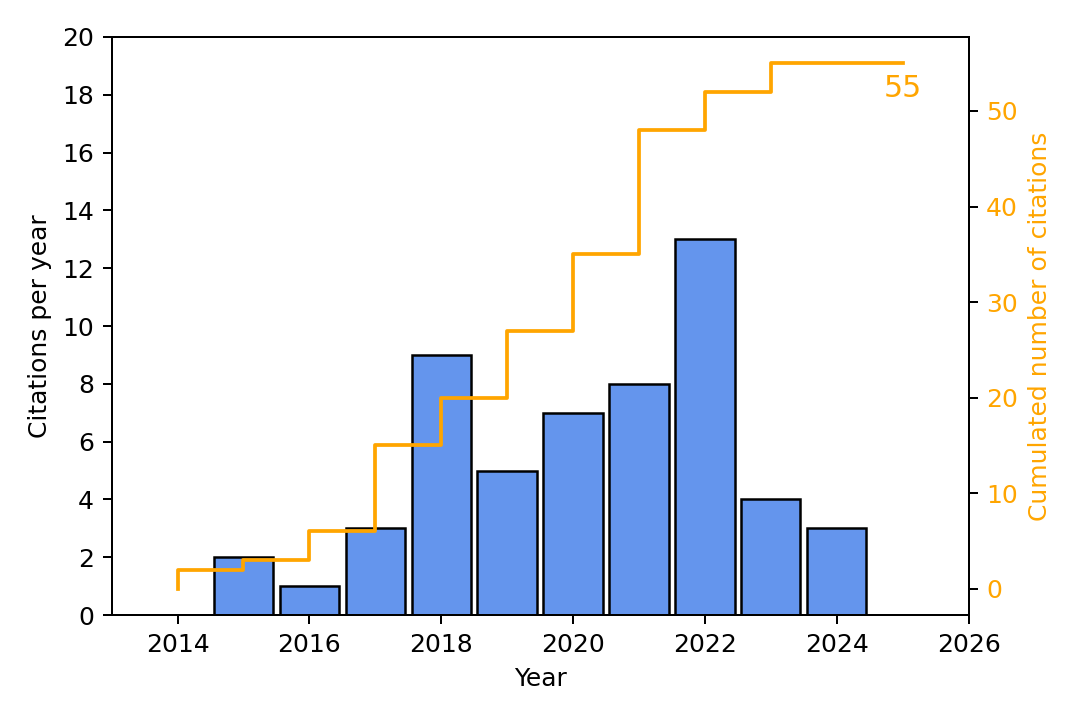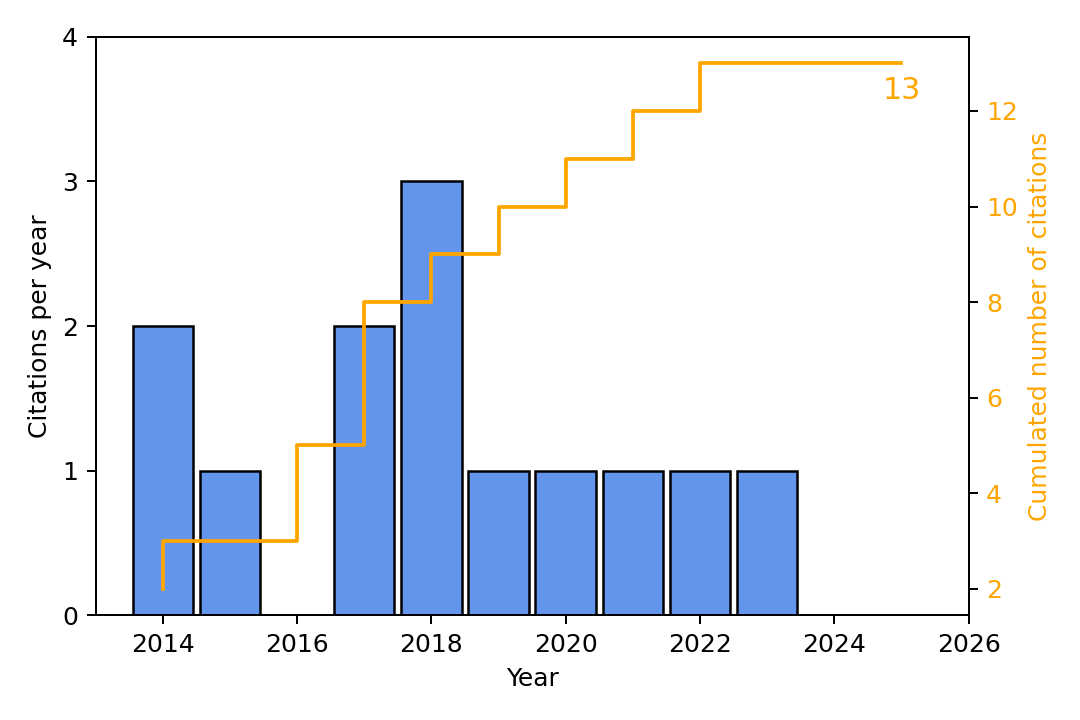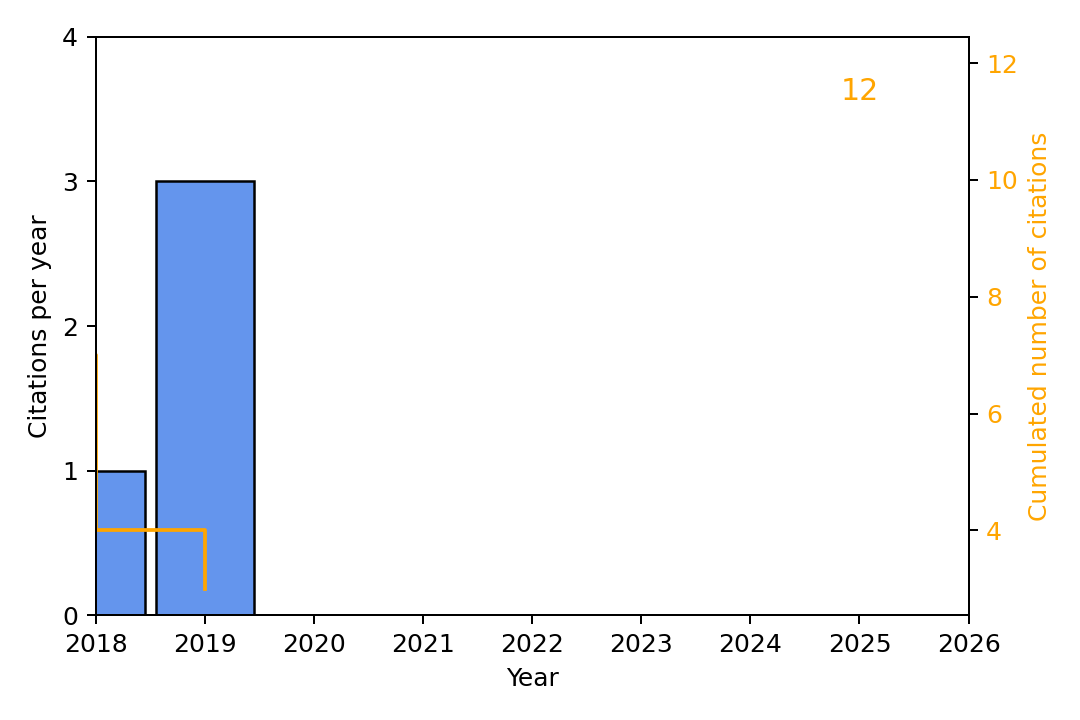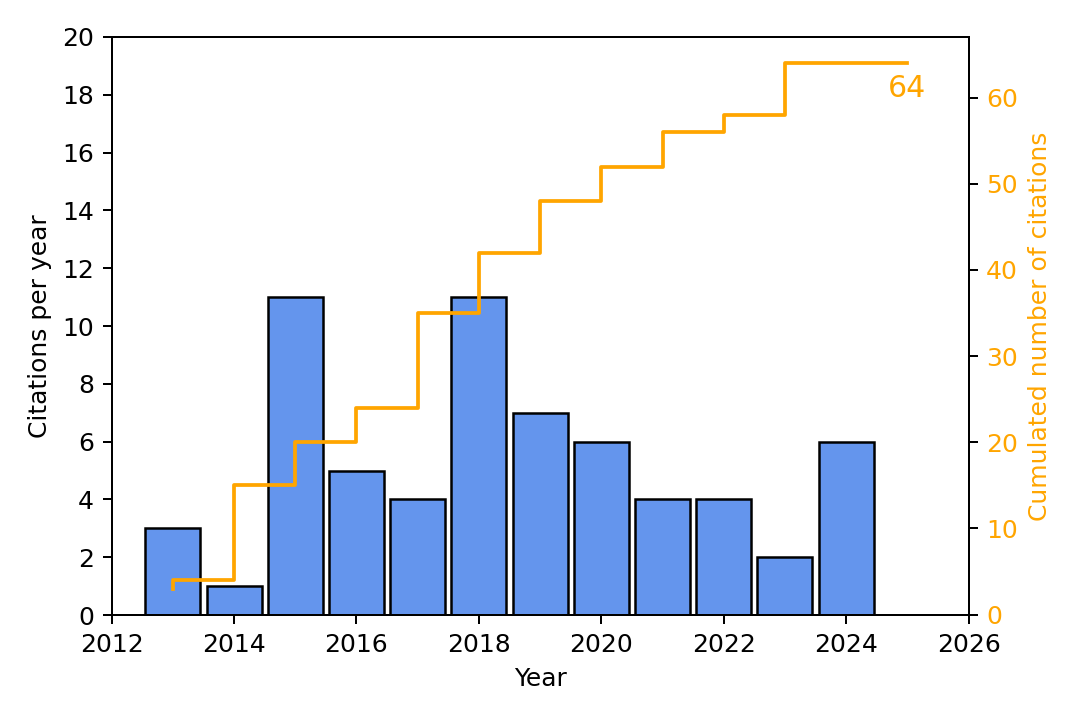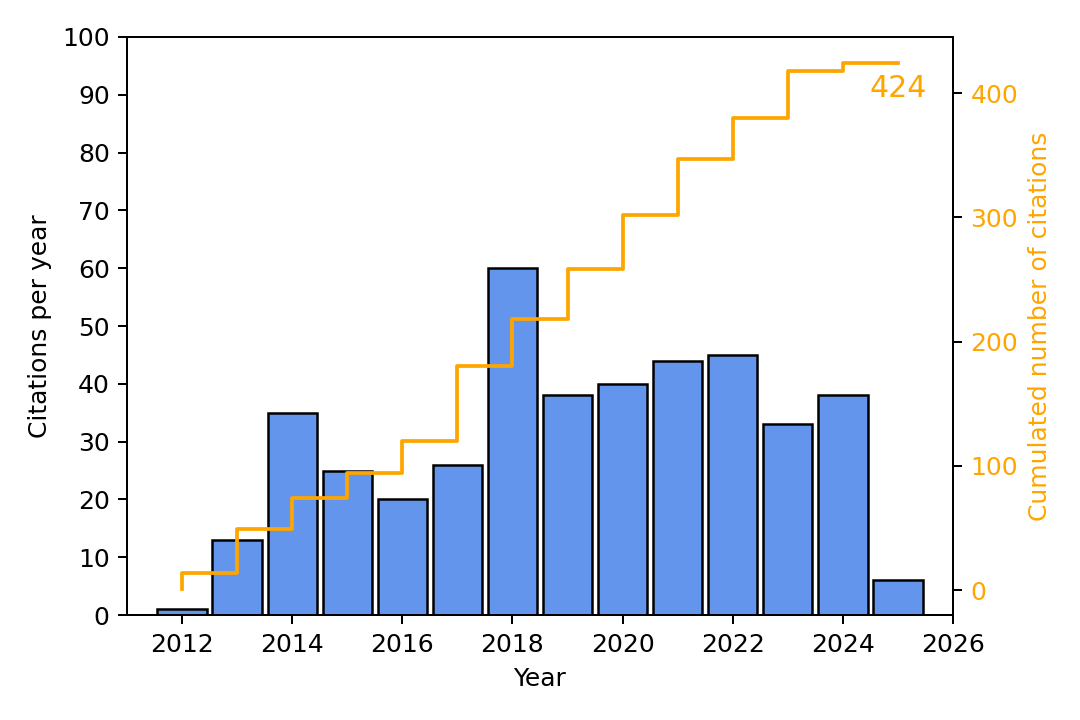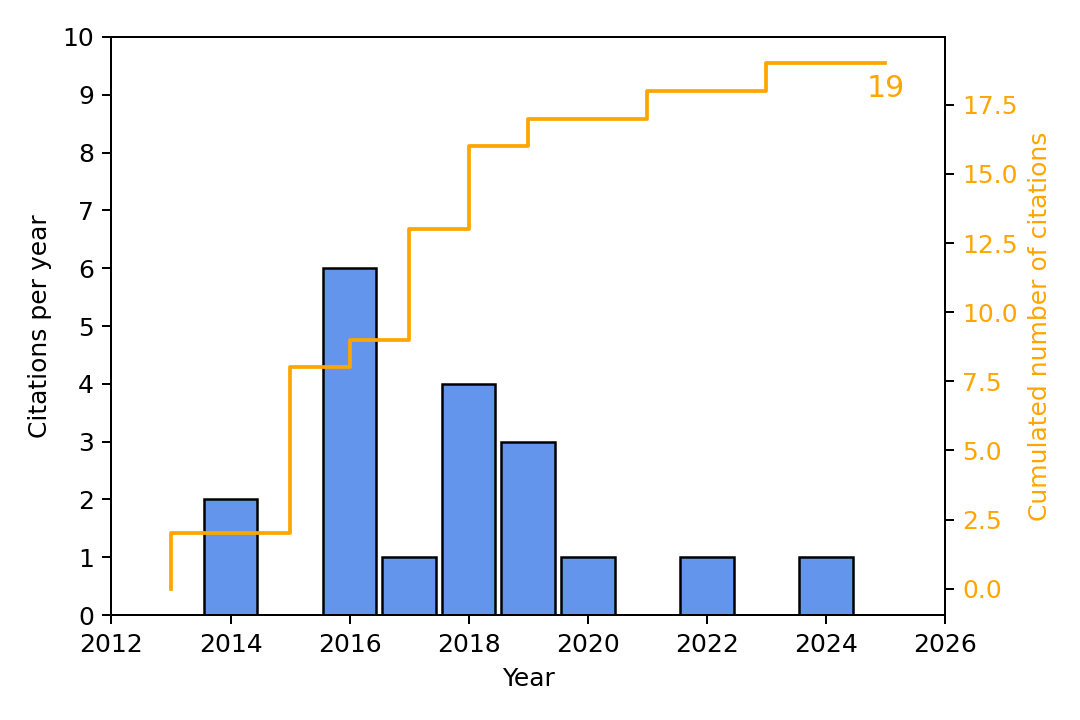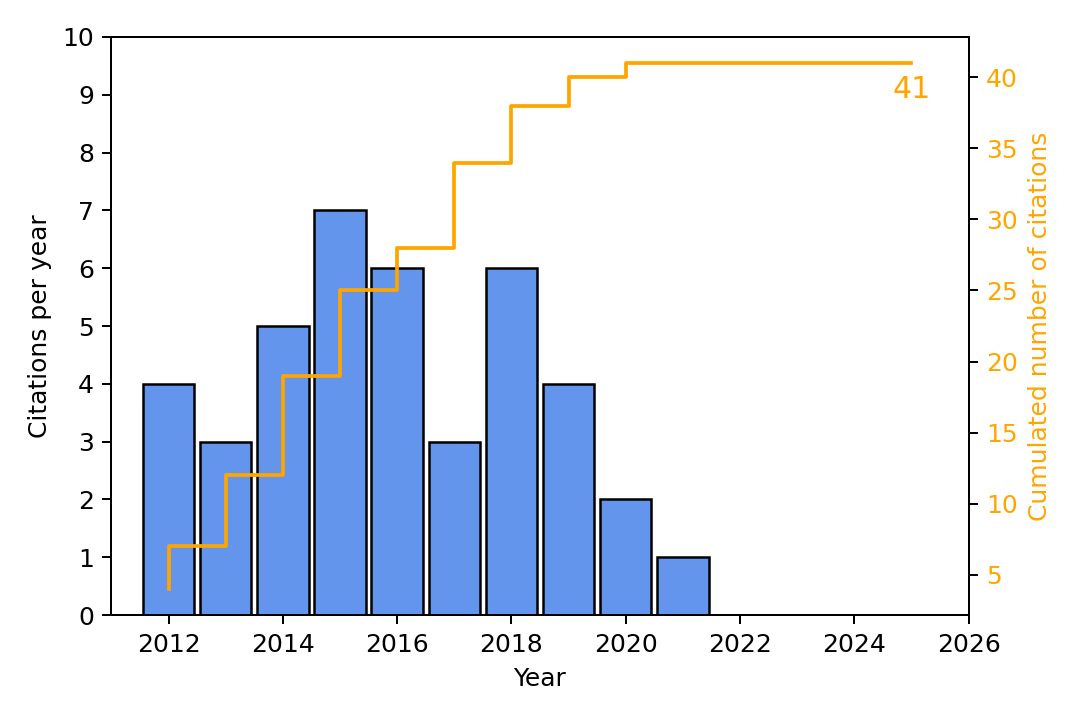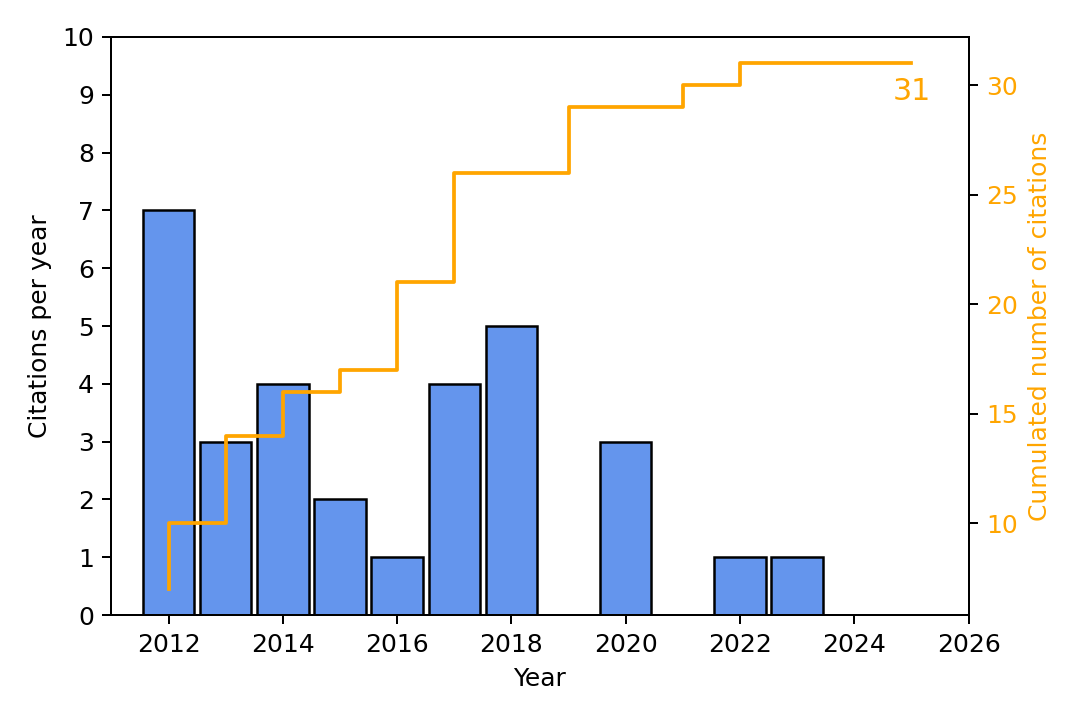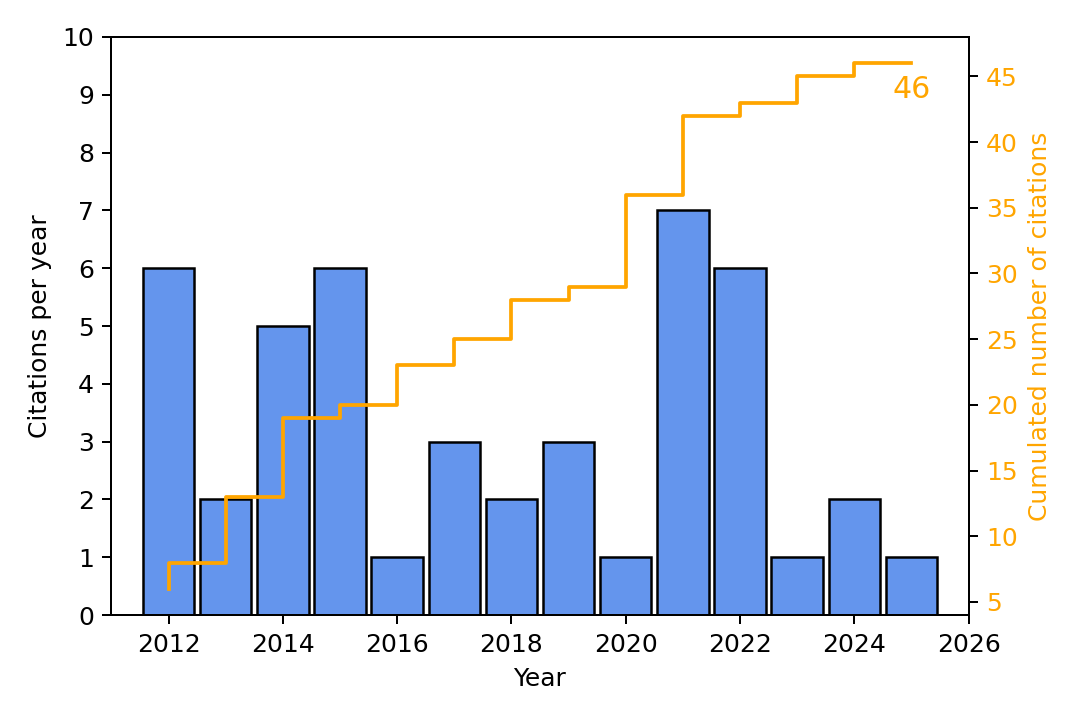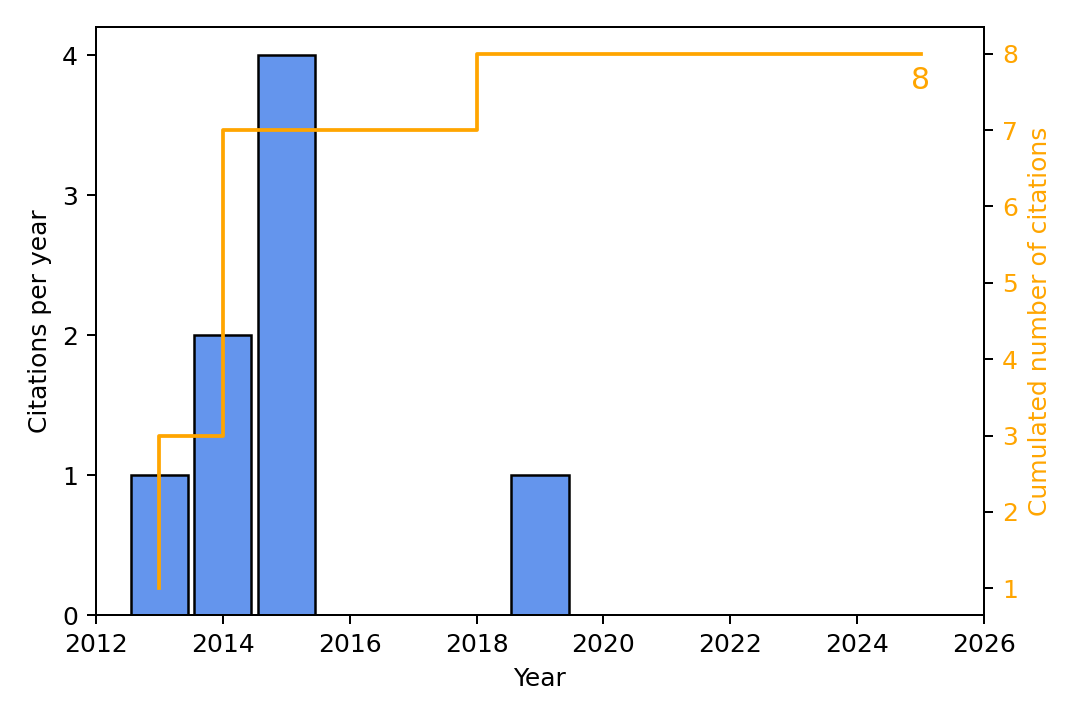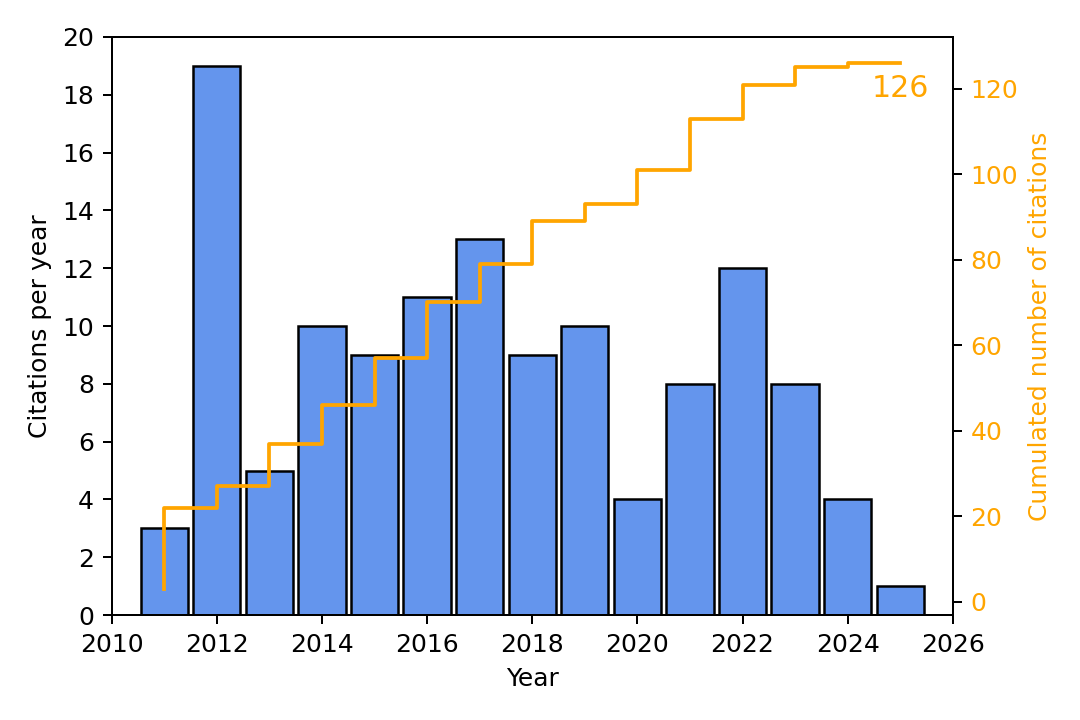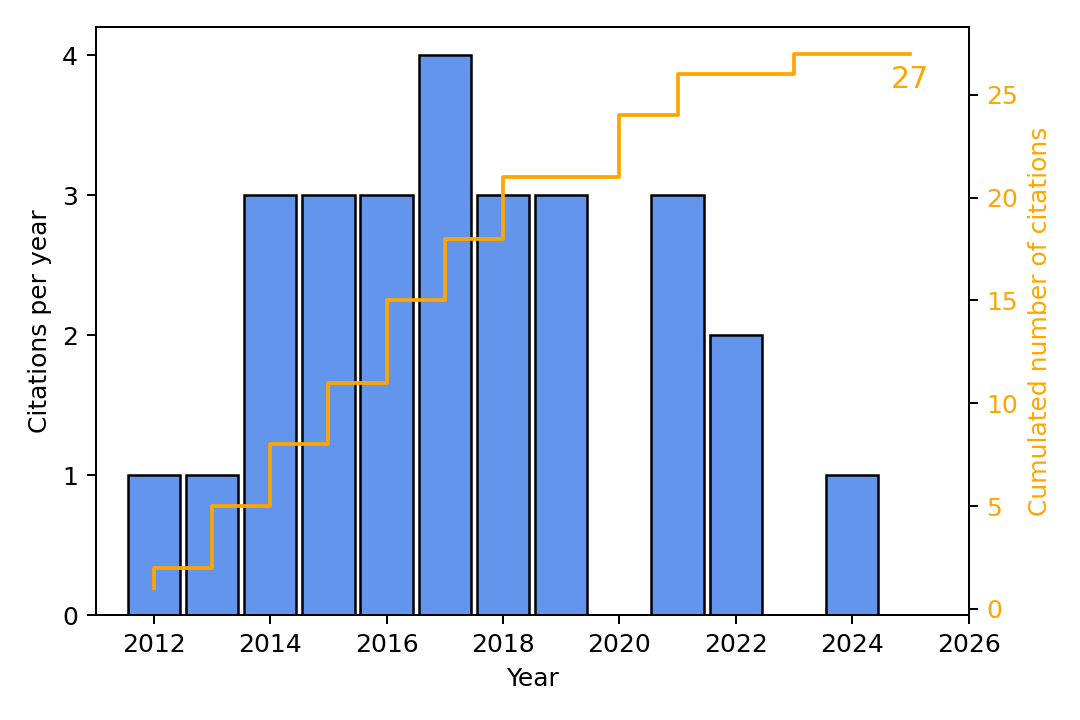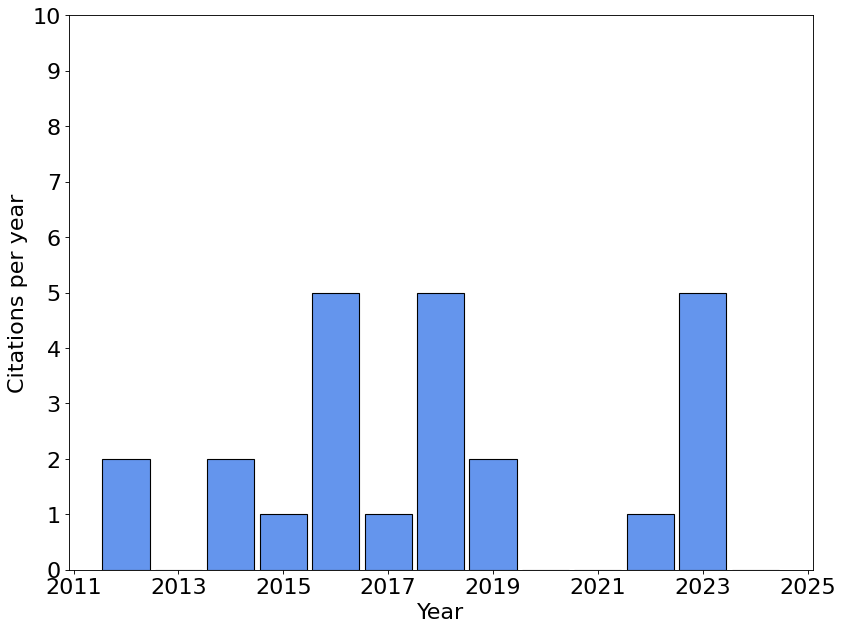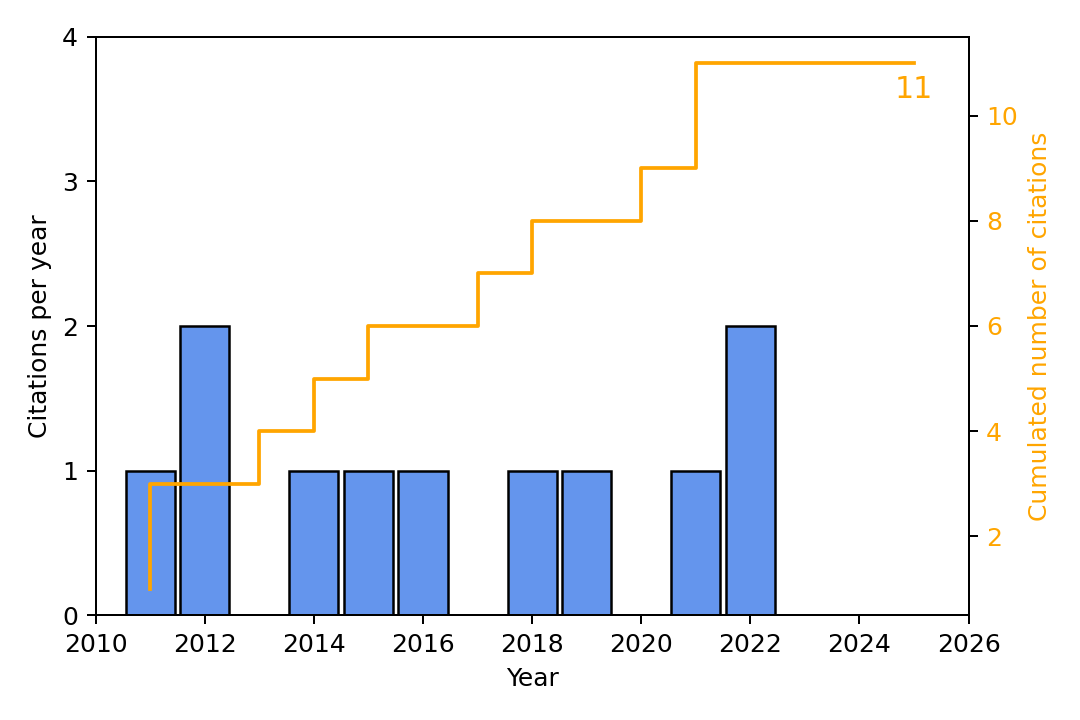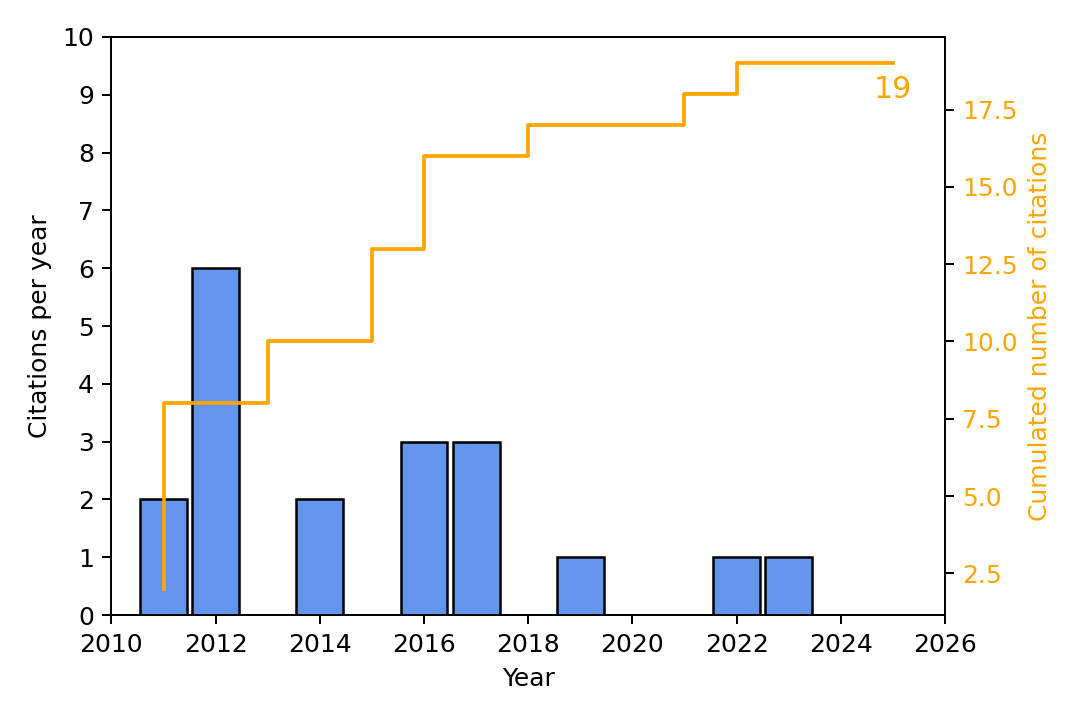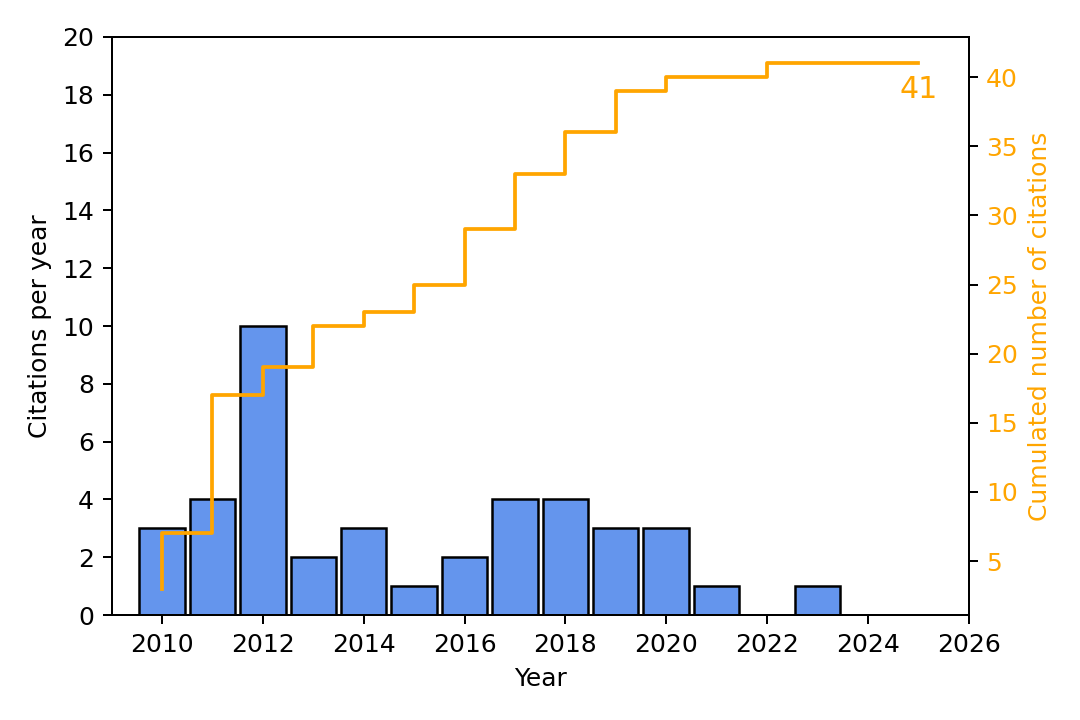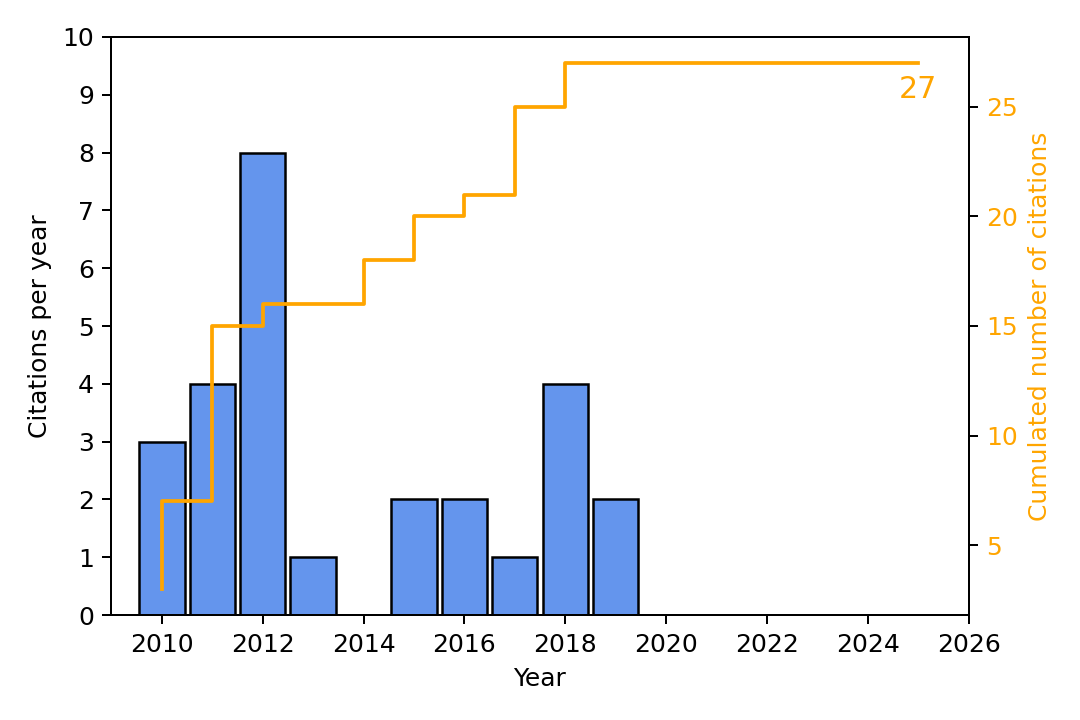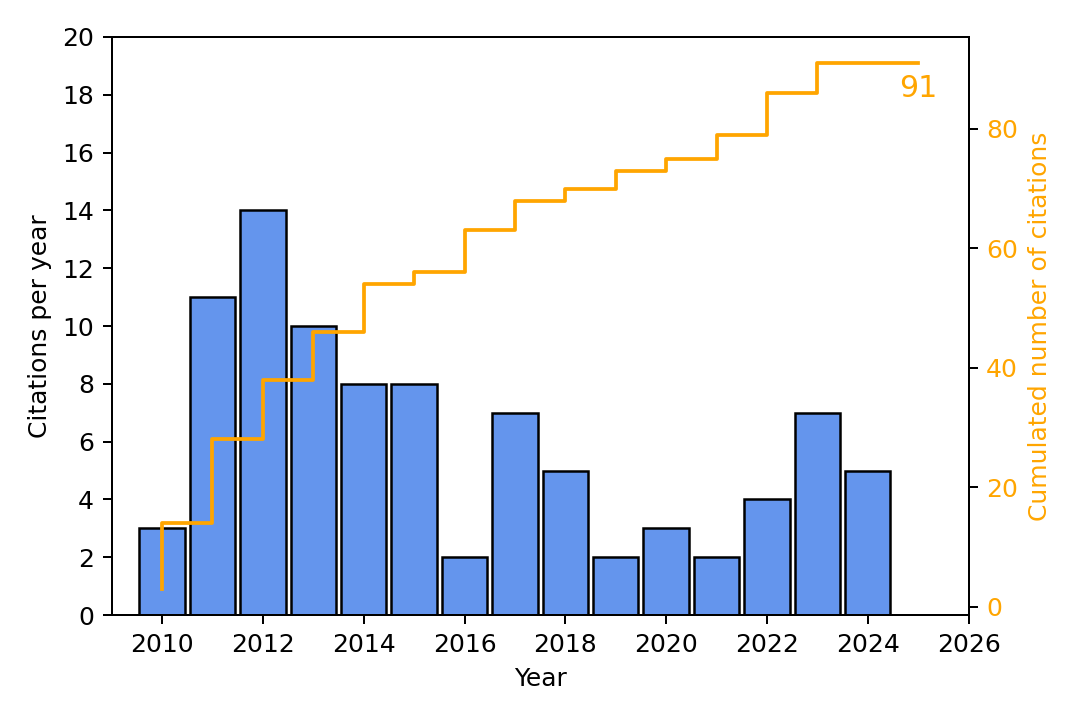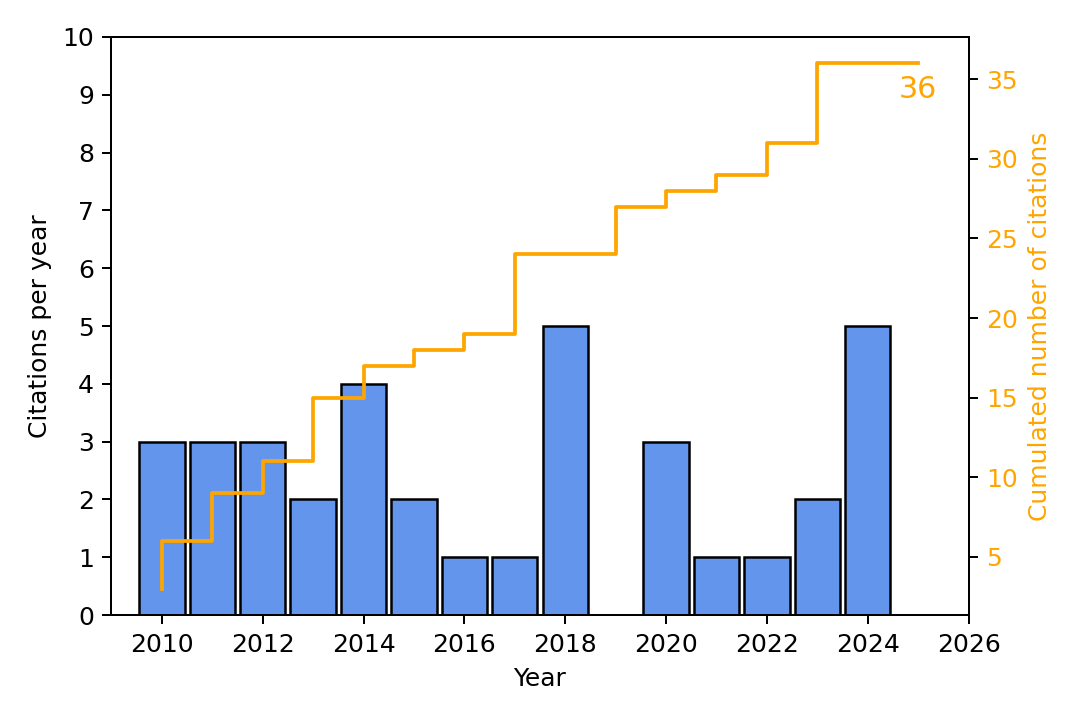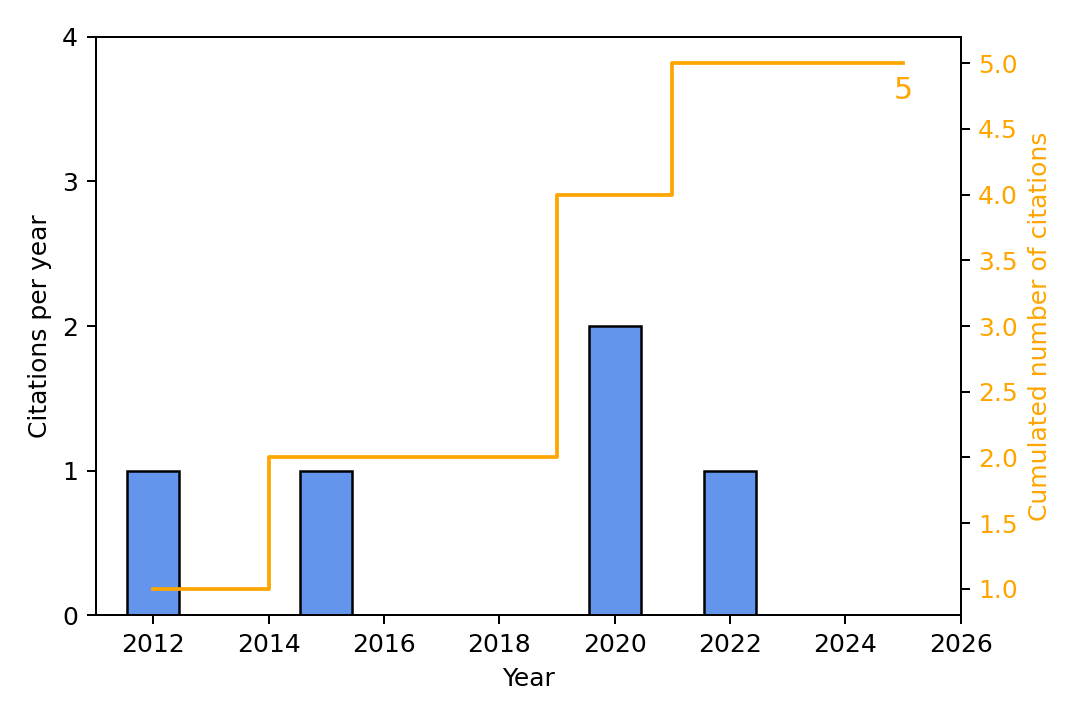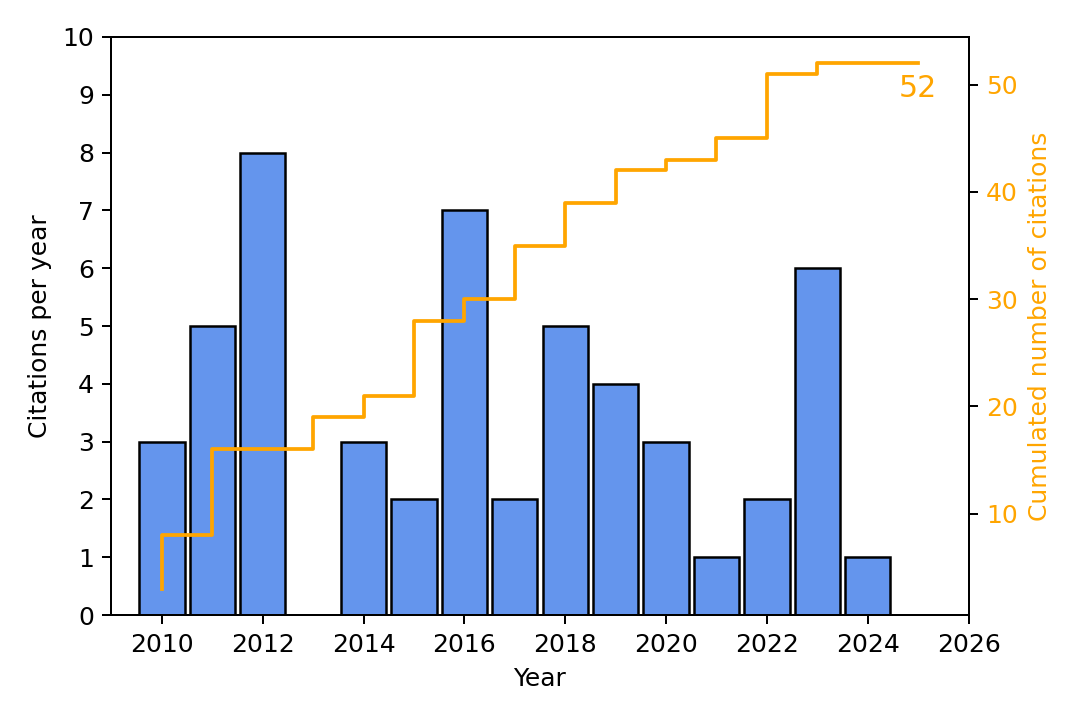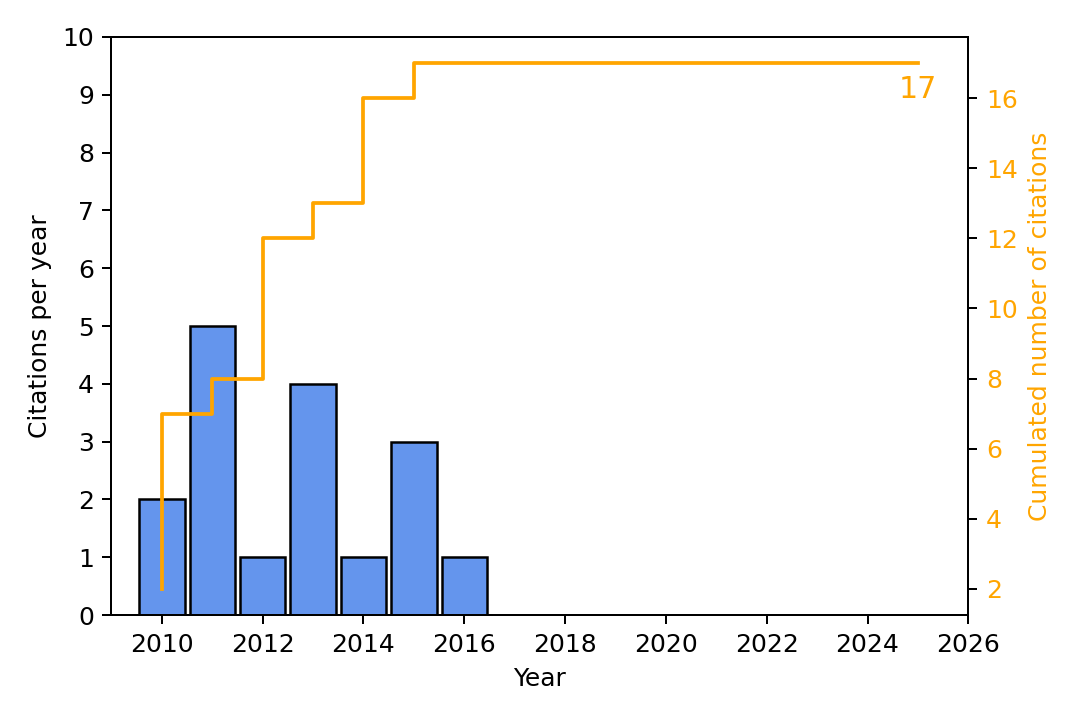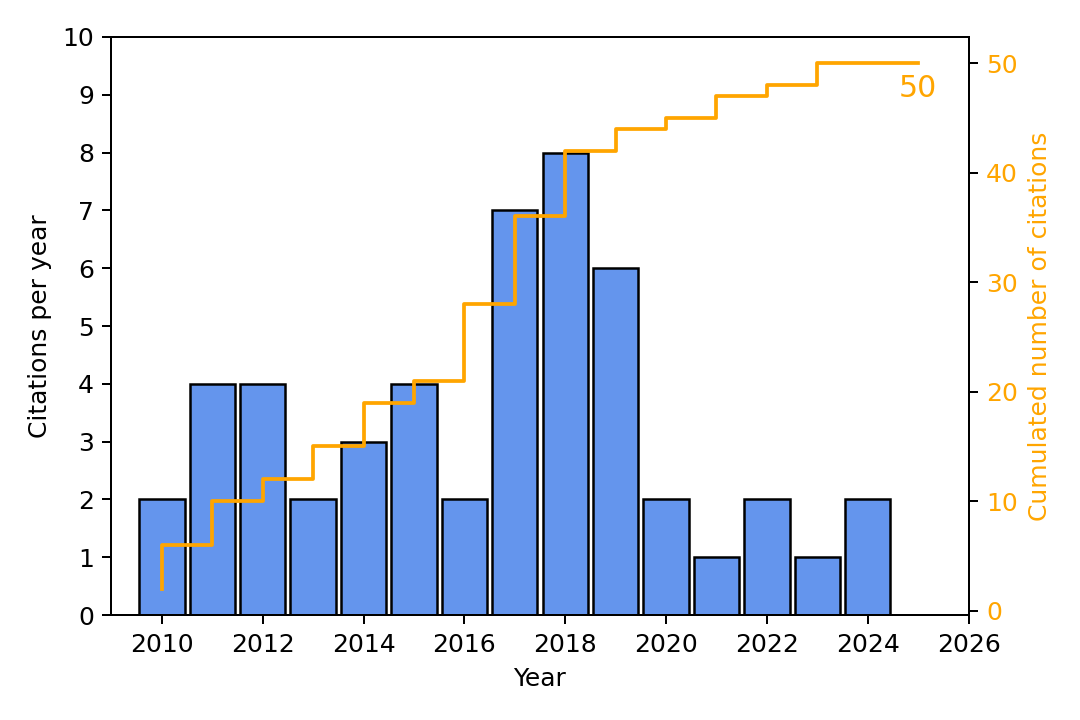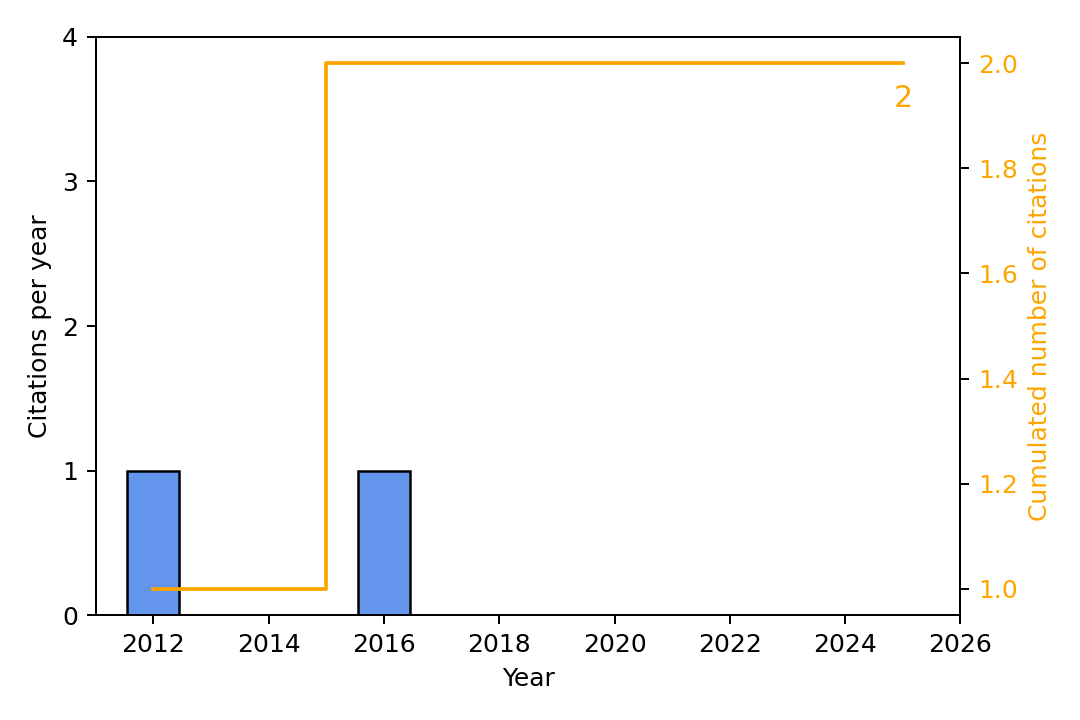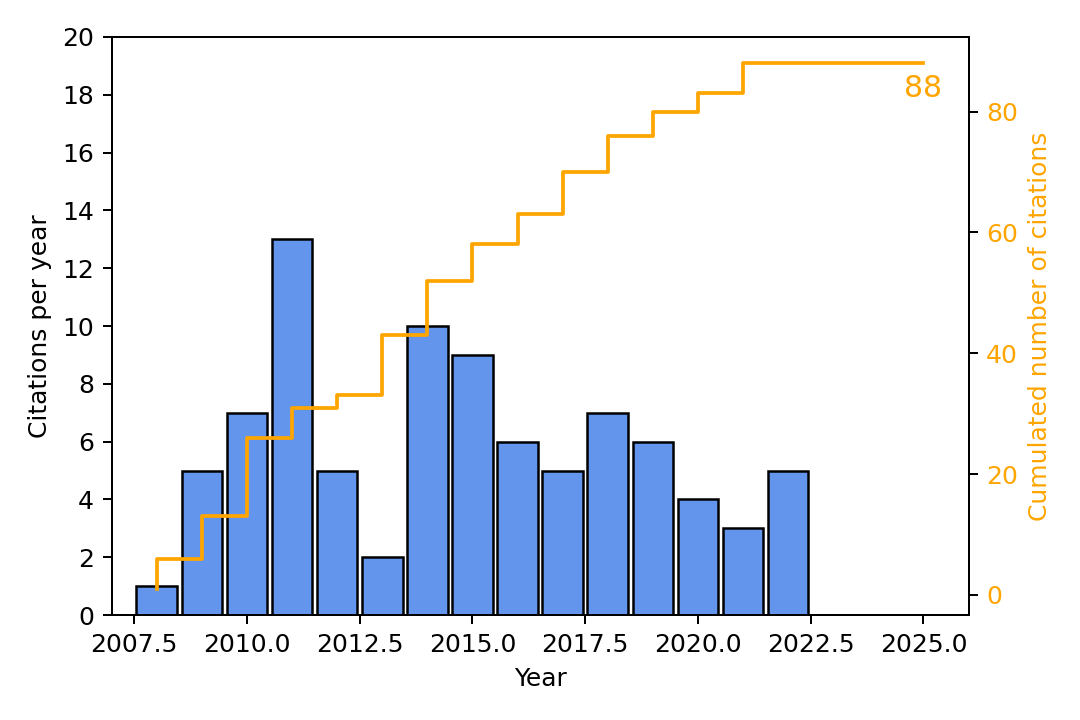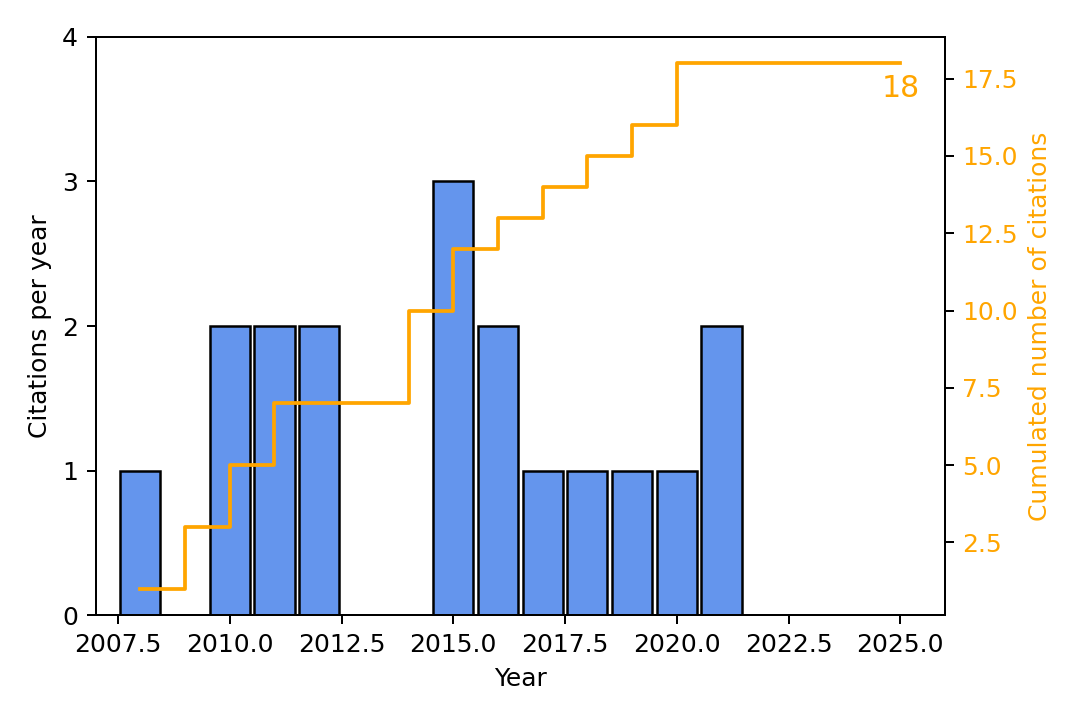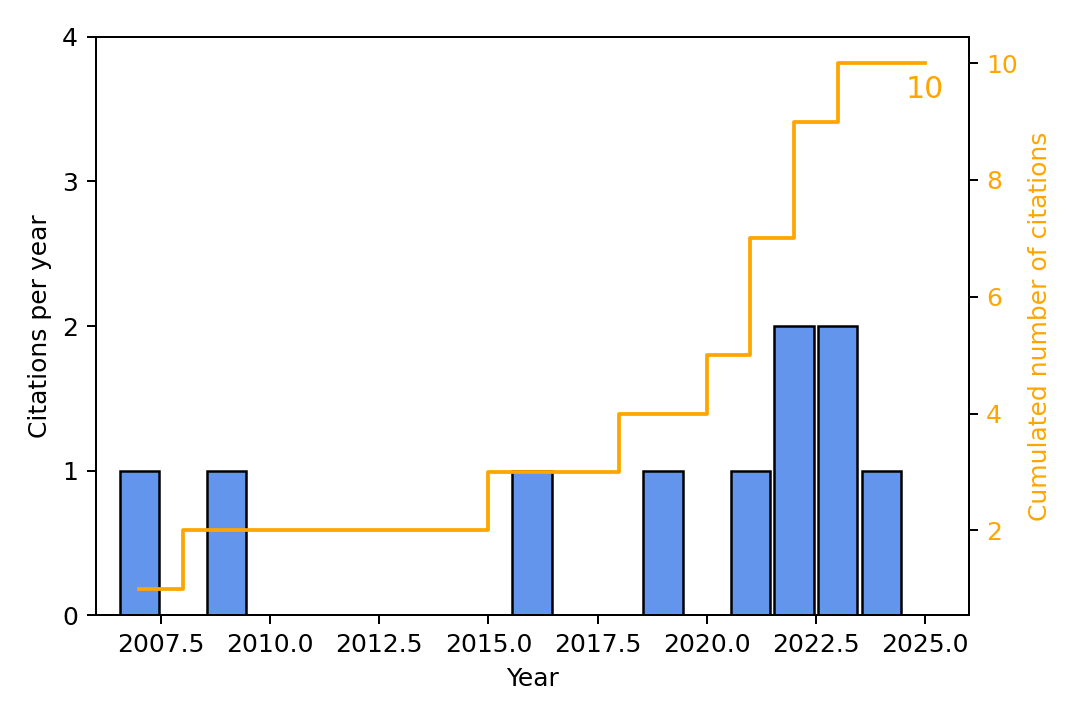Refereed publications: 173
Listed below are my peer-reviewed publications, sorted by chronological order with most recent publications first (click here to sort by citation count). For each, all the publication details,including the abstract, the citations, the PDF of the article itself, and links to NASA/Ads and BibTeX entry are available.See the entire list in NASA/Ads.
D. Vavilov & B. Carry
Astronomy & Astrophysics (A&A), 693, January 2025, A66 (PDF ![]() , NASA/Ads
, NASA/Ads , BibTeX, DOI
)
Context: Understanding the dynamical evolution of asteroids through the secular Yarkovsky effect requires the determination of many physical properties, including the rotation period.
Aims: We propose a method aimed at obtaining a robust determination of the rotation period of asteroids, while avoiding the pitfalls of aliases. We applied this approach to thousands of asteroid light curves measured by the NASA TESS mission.
Methods: We developed a robust period-analysis algorithm based on a Fourier series. Our approach includes a comparison of the results from multiple orders and tests on the number of extremes to identify and reject potential aliases. We also provide the uncertainty interval for the result as well as additional periods that may be plausible.
Results: We report the rotation period for 4521 asteroids within a precision of 10%. A comparison with the literature (whenever available) reveals a very good agreement and validates the approach presented here. Our approach also highlights cases for which the determination of the period should be considered invalid. The dataset presented here confirms the apparent small number of asteroids with a rotation between 50 and 100 h and correlated with diameter. The amplitude of the light curves is found to increase toward smaller diameters, as asteroids become less and less spherical. Finally, there is a systematic difference between the broad C and S complex in the amplitude-period, revealing the statistically lower density of C-types compared to S-type asteroids.
Conclusions: Our approach to the determination of asteroid rotation period is based on simple concepts, yet it is nonetheless robust. It can be applied to large corpora of time series photometry, such as those extracted from exoplanet transit surveys.
M. Marsset, P. Vernazza, M. Brož, C. A. Thomas, F. E. DeMeo, B. Burt, R. P. Binzel, V. Reddy, A. McGraw, C. Avdellidou, B. Carry, S. Slivan & D. Polishook
Nature, 634, October 2024, pp. 561-565 (PDF ![]() , NASA/Ads
, NASA/Ads , BibTeX, DOI
)
Studies of micrometeorites in mid-Ordovician limestones and impact craters on Earth indicate that our planet witnessed a massive infall of ordinary L chondrite material about 466 million years ago1–3 that may have been at the origin of an Ordovician ice age and major turnover in biodiversity4. The breakup of a large asteroid in the main belt is the likely cause of this massive infall. Currently, material originating from this breakup still dominates meteorite falls (>20% of all falls)5. Here we provide spectroscopic observations and dynamical evidence that the Massalia collisional family is the only plausible source of this catastrophic event and the most abundant class of meteorites falling on Earth today. This family of asteroids is suitably located in the inner belt, at low-inclination orbits, which corresponds to the observed distribution of L-chondrite-like near-Earth objects and interplanetary dust concentrated at 1.4°
C. Herrera, B. Carry, A. Lagain & D. Vavilov
Astronomy & Astrophysics (A&A), 688, August 2024, A176 (PDF ![]() , NASA/Ads
, NASA/Ads , BibTeX, DOI
)
Context: Airless planetary objects have their surfaces covered by craters, and these can be used to study the characteristics of asteroid populations. Planetary surfaces present binary craters that are associated with the synchronous impact of binary asteroids.
Aims: We identify binary craters on asteroids (1) Ceres and (4) Vesta, and aim to characterize the properties (size ratio and orbital plane) of the binary asteroids that might have formed them.
Methods: We used global crater databases developed in previous studies and mosaics of images from the NASA DAWN mission high-altitude and low-altitude mapping orbits. We established selection criteria to identify craters that were most likely a product of the impact of a binary asteroid. We performed numerical simulations to predict the orientation of the binary craters assuming the population of impactors has mutual orbits coplanar with heliocentric orbits, as the current census of binary asteroids suggests. We compared our simulations with our survey of binary craters on Ceres and Vesta through a Kolmogorov-Smirnov test.
Results: We find geomorphological evidence of 39 and 18 synchronous impacts on the surfaces of Ceres and Vesta, respectively. The associated binary asteroids are widely separated and similar in diameter. The distributions of the orientation of these binary craters on both bodies are statistically different from numerical impact simulations that assume binary asteroids with coplanar mutual and heliocentric orbits.
Conclusions: Although the identification of binary craters on both bodies and the sample size are limited, these findings are consistent with a population of well-separated and similarly sized binary asteroids with nonzero obliquity that remains to be observed, in agreement with the population of binary craters identified on Mars.
L. Liberato, P. Tanga, D. Mary, K. Minker, B. Carry, F. Spoto, P. Bartczak, B. Sicardy, D. Oszkiewicz & J. Desmars
Astronomy & Astrophysics (A&A), 688, August 2024, A50 (PDF ![]() , NASA/Ads
, NASA/Ads , BibTeX, DOI
)
Context: Asteroids with companions constitute an excellent sample for studying the collisional and dynamical evolution of minor planets. The currently known binary population were discovered by different complementary techniques that produce, for the moment, a strongly biased distribution, especially in a range of intermediate asteroid sizes (≈2-100 km) where both mutual photometric events and high-resolution adaptive optic imaging are poorly efficient.
Aims: A totally independent technique of binary asteroid discovery, based on astrometry, can help to reveal new binary systems and populate a range of sizes and separations that remain nearly unexplored.
Methods: In this work, we describe a dedicated period detection method and its results for the Gaia DR3 data set. This method looks for the presence of a periodic signature in the orbit post-fit residuals.
Results: After conservative filtering and validation based on statistical and physical criteria, we are able to present a first sample of astrometric binary candidates, to be confirmed by other observation techniques such as photometric light curves and stellar occultations.
Full Table 3 is available at the CDS via https://cdsarc.cds.unistra.fr/viz-bin/cat/J/A+A/688/A50.
B. Carry, J. Peloton, R. Le Montagner, M. Mahlke & J. Berthier
Astronomy & Astrophysics (A&A), 687, July 2024, A38 (PDF ![]() , NASA/Ads
, NASA/Ads , BibTeX, DOI
)
Context: Large sky surveys provide numerous non-targeted observations of small bodies of the Solar System. The upcoming LSST of the Vera C. Rubin Observatory will be the largest source of small body photometry in the next decade. With non-coordinated epochs of observation, colors - and therefore taxonomy and composition - can only be computed by comparing absolute magnitudes obtained in each filter by solving the phase function (evolution of brightness of the small body against the solar phase angle). Current models in use in the community (HG, HG12*, and HG1G2), however, fail to reproduce the long-term photometry of many targets due to the change in the aspect angle between apparitions.
Aims: We aim to derive a generic yet simple phase function model accounting for the variable geometry of the small bodies over multiple apparitions.
Methods: As a spinoff of the HG1G2 model, we propose the sHG1G2 phase function model in which we introduce a term describing the brightness changes due to spin orientation and polar oblateness. We applied this new model to 13 245 908 observations of 122 675 Solar System objects (SSOs). These observations were acquired in the g and r filters with the Zwicky Transient Facility between November 1, 2019 and December 1, 2023. We retrieved them and implemented the new sHG1G2 model in FINK, a broker of alerts designed for the LSST.
Results: The sHG1G2 model leads to smaller residuals than other phase function models, providing a better description of the photometry of asteroids. We determined the absolute magnitude, H, and phase function coefficients (G1, G2) in each filter, the spin orientation (α0, δ0), and the polar-to-equatorial oblateness, R, for 95 593 SSOs, which constitutes about a tenfold increase in the number of characterized objects compared to the current census.
Conclusions: The application of the sHG1G2 model to ZTF alert data using the FINK broker shows that the model is appropriate for extracting physical properties of asteroids from multi-band and sparse photometry, such as the forthcoming LSST survey.
The data presented here are available at the CDS via https://cdsarc.cds.unistra.fr/viz-bin/cat/J/A+A/687/A38
P. Panuzzo, T. Mazeh, F. Arenou, B. Holl, E. Caffau, A. Jorissen, C. Babusiaux, P. Gavras, J. Sahlmann, U. Bastian, Ł. Wyrzykowski, L. Eyer, N. Leclerc, N. Bauchet, A. Bombrun, N. Mowlavi, G. M. Seabroke, D. Teyssier, E. Balbinot, A. Helmi, A. G. Brown, A. Vallenari, T. Prusti, J. H. Bruijne, A. Barbier, M. Biermann, O. L. Creevey, C. Ducourant, D. W. Evans, R. Guerra, A. Hutton, C. Jordi, S. A. Klioner, U. Lammers, L. Lindegren, X. Luri, F. Mignard, C. Nicolas, S. Randich, P. Sartoretti, R. Smiljanic, P. Tanga, N. A. Walton, C. Aerts, C. A. Bailer-Jones, M. Cropper, R. Drimmel, F. Jansen, D. Katz, M. G. Lattanzi, C. Soubiran, F. Thévenin, F. van Leeuwen, R. Andrae, M. Audard, J. Bakker, R. Blomme, J. Castañeda, F. De Angeli, C. Fabricius, M. Fouesneau, Y. Frémat, L. Galluccio, A. Guerrier, U. Heiter, E. Masana, R. Messineo, K. Nienartowicz, F. Pailler, F. Riclet, W. Roux, R. Sordo, G. Gracia-Abril, J. Portell, M. Altmann, K. Benson, J. Berthier, P. W. Burgess, D. Busonero, G. Busso, C. Cacciari, H. Cánovas, J. M. Carrasco, B. Carry, A. Cellino, N. Cheek, G. Clementini, Y. Damerdji, M. Davidson, P. Teodoro, L. Delchambre, A. Dell'Oro, E. Fraile Garcia, D. Garabato, P. García-Lario, R. Haigron, N. C. Hambly, D. L. Harrison, D. Hatzidimitriou, J. Hernández, D. Hestroffer, S. T. Hodgkin, S. Jamal, G. Jevardat de Fombelle, S. Jordan, A. Krone-Martins, A. C. Lanzafame, W. Löffler, A. Lorca, O. Marchal, P. M. Marrese, A. Moitinho, K. Muinonen, M. Nuñez Campos, I. Oreshina-Slezak, P. Osborne, E. Pancino, T. Pauwels, A. Recio-Blanco, M. Riello, L. Rimoldini, A. C. Robin, T. Roegiers, L. M. Sarro, M. Schultheis, M. Smith, A. Sozzetti, E. Utrilla, M. van Leeuwen, K. Weingrill, U. Abbas, P. Ábrahám, A. Abreu Aramburu, S. Ahmed, G. Altavilla, M. A. Álvarez, F. Anders, R. I. Anderson, E. Anglada Varela, T. Antoja, S. Baig, D. Baines, S. G. Baker, L. Balaguer-Núñez, Z. Balog, C. Barache, M. Barros, M. A. Barstow, S. Bartolomé, D. Bashi, J. -. Bassilana, N. Baudeau, U. Becciani, L. R. Bedin, I. Bellas-Velidis, M. Bellazzini, W. Beordo, M. Bernet, C. Bertolotto, S. Bertone, L. Bianchi, A. Binnenfeld, S. Blanco-Cuaresma, J. Bland-Hawthorn, A. Blazere, T. Boch, D. Bossini, S. Bouquillon, A. Bragaglia, J. Braine, E. Bratsolis, E. Breedt, A. Bressan, N. Brouillet, E. Brugaletta, B. Bucciarelli, A. G. Butkevich, R. Buzzi, A. Camut, R. Cancelliere, T. Cantat-Gaudin, D. Capilla Guilarte, R. Carballo, T. Carlucci, M. I. Carnerero, J. Carretero, S. Carton, L. Casamiquela, A. Casey, M. Castellani, A. Castro-Ginard, L. Ceraj, V. Cesare, P. Charlot, C. Chaudet, L. Chemin, A. Chiavassa, N. Chornay, D. Chosson, W. J. Cooper, T. Cornez, S. Cowell, M. Crosta, C. Crowley, M. Cruz Reyes, C. Dafonte, M. Dal Ponte, M. David, P. Laverny, F. De Luise, R. De March, A. Torres, E. F. l Peloso, M. Delbo, A. Delgado, J. -. Delisle, C. Demouchy, E. Denis, T. E. Dharmawardena, F. Di Giacomo, C. Diener, E. Distefano, C. Dolding, K. Dsilva, H. Enke, C. Fabre, M. Fabrizio, S. Faigler, M. Fatović, G. Fedorets, J. Fernández-Hernández, P. Fernique, F. Figueras, C. Fouron, F. Fragkoudi, M. Gai, M. Galinier, A. Garcia-Serrano, M. García-Torres, A. Garofalo, E. Gerlach, R. Geyer, P. Giacobbe, G. Gilmore, S. Girona, G. Giuffrida, A. Gomboc, A. Gomez, I. González-Santamaría, E. Gosset, M. Granvik, V. Gregori Barrera, R. Gutiérrez-Sánchez, M. Haywood, A. Helmer, S. L. Hidalgo, T. Hilger, D. Hobbs, C. Hottier, H. E. Huckle, Ó. Jiménez-Arranz, J. Juaristi Campillo, Z. Kaczmarek, P. Kervella, S. Khanna, M. Kontizas, G. Kordopatis, A. J. Korn, Á. Kóspál, Z. Kostrzewa-Rutkowska, K. Kruszyńska, M. Kun, S. Lambert, A. F. Lanza, Y. Lebreton, T. Lebzelter, S. Leccia, G. Lecoutre, S. Liao, L. Liberato, E. Licata, E. Livanou, A. Lobel, J. López-Miralles, C. Loup, M. Madarász, L. Mahy, R. G. Mann, M. Manteiga, C. P. Marcellino, J. M. Marchant, M. Marconi, D. Marín Pina, S. Marinoni, D. J. Marshall, J. Martín Lozano, L. Martin Polo, J. M. Martín-Fleitas, G. Marton, D. Mascarenhas, A. Masip, A. Mastrobuono-Battisti, P. J. McMillan, J. Meichsner, J. Merc, S. Messina, N. R. Millar, A. Mints, D. Mohamed, D. Molina, R. Molinaro, L. Molnár, M. Monguió, P. Montegriffo, L. Monti, A. Mora, R. Morbidelli, D. Morris, R. Mudimadugula, T. Muraveva, I. Musella, Z. Nagy, N. Nardetto, C. Navarrete, S. Oh, C. Ordenovic, O. Orenstein, C. Pagani, I. Pagano, L. Palaversa, P. A. Palicio, L. Pallas-Quintela, M. Pawlak, A. Penttilä, P. Pesciullesi, M. Pinamonti, E. Plachy, L. Planquart, G. Plum, E. Poggio, D. Pourbaix, A. M. Price-Whelan, L. Pulone, V. Rabin, M. Rainer, C. M. Raiteri, P. Ramos, M. Ramos-Lerate, M. Ratajczak, P. Re Fiorentin, S. Regibo, C. Reylé, V. Ripepi, A. Riva, H. -. Rix, G. Rixon, G. Robert, N. Robichon, C. Robin, M. Romero-Gómez, N. Rowell, D. Ruz Mieres, K. A. Rybicki, G. Sadowski, A. Sagristà Sellés, N. Sanna, R. Santoveña, M. Sarasso, M. H. Sarmiento, C. Sarrate Riera, E. Sciacca, D. Ségransan, M. Semczuk, S. Shahaf, A. Siebert, E. Slezak, R. L. Smart, O. N. Snaith, E. Solano, F. Solitro, D. Souami, J. Souchay, E. Spitoni, F. Spoto, L. A. Squillante, I. A. Steele, H. Steidelmüller, J. Surdej, L. Szabados, F. Taris, M. B. Taylor, R. Teixeira, T. Tepper-Garcia, W. Thuillot, L. Tolomei, N. Tonello, F. Torra, G. Torralba Elipe, M. Trabucchi, E. Trentin, M. Tsantaki, C. Turon, A. Ulla, N. Unger, I. Valtchanov, O. Vanel, A. Vecchiato, D. Vicente, E. Villar, M. Weiler, H. Zhao, J. Zorec, S. Zucker, A. Župić & T. Zwitter
Astronomy & Astrophysics (A&A), 686, June 2024, L2 (PDF ![]() , NASA/Ads
, NASA/Ads , BibTeX, DOI
)
Context: Gravitational waves from black-hole (BH) merging events have revealed a population of extra-galactic BHs residing in short-period binaries with masses that are higher than expected based on most stellar evolution models - and also higher than known stellar-origin black holes in our Galaxy. It has been proposed that those high-mass BHs are the remnants of massive metal-poor stars.
Aims: Gaia astrometry is expected to uncover many Galactic wide-binary systems containing dormant BHs, which may not have been detected before. The study of this population will provide new information on the BH-mass distribution in binaries and shed light on their formation mechanisms and progenitors.
Methods: As part of the validation efforts in preparation for the fourth Gaia data release (DR4), we analysed the preliminary astrometric binary solutions, obtained by the Gaia Non-Single Star pipeline, to verify their significance and to minimise false-detection rates in high-mass-function orbital solutions.
Results: The astrometric binary solution of one source, Gaia BH3, implies the presence of a 32.70 ± 0.82 M☉ BH in a binary system with a period of 11.6 yr. Gaia radial velocities independently validate the astrometric orbit. Broad-band photometric and spectroscopic data show that the visible component is an old, very metal-poor giant of the Galactic halo, at a distance of 590 pc.
Conclusions: The BH in the Gaia BH3 system is more massive than any other Galactic stellar-origin BH known thus far. The low metallicity of the star companion supports the scenario that metal-poor massive stars are progenitors of the high-mass BHs detected by gravitational-wave telescopes. The Galactic orbit of the system and its metallicity indicate that it might belong to the Sequoia halo substructure. Alternatively, and more plausibly, it could belong to the ED-2 stream, which likely originated from a globular cluster that had been disrupted by the Milky Way.
A. Krone-Martins, C. Ducourant, L. Galluccio, L. Delchambre, I. Oreshina-Slezak, R. Teixeira, J. Braine, J. -. Le Campion, F. Mignard, W. Roux, A. Blazere, L. Pegoraro, A. G. Brown, A. Vallenari, T. Prusti, J. H. Bruijne, F. Arenou, C. Babusiaux, A. Barbier, M. Biermann, O. L. Creevey, D. W. Evans, L. Eyer, R. Guerra, A. Hutton, C. Jordi, S. A. Klioner, U. Lammers, L. Lindegren, X. Luri, S. Randich, P. Sartoretti, R. Smiljanic, P. Tanga, N. A. Walton, C. A. Bailer-Jones, U. Bastian, M. Cropper, R. Drimmel, D. Katz, C. Soubiran, F. van Leeuwen, M. Audard, J. Bakker, R. Blomme, J. Castañeda, F. De Angeli, C. Fabricius, M. Fouesneau, Y. Frémat, A. Guerrier, E. Masana, R. Messineo, C. Nicolas, K. Nienartowicz, F. Pailler, P. Panuzzo, F. Riclet, G. M. Seabroke, R. Sordo, F. Thévenin, G. Gracia-Abril, J. Portell, D. Teyssier, M. Altmann, K. Benson, J. Berthier, P. W. Burgess, D. Busonero, G. Busso, H. Cánovas, B. Carry, N. Cheek, G. Clementini, Y. Damerdji, M. Davidson, P. Teodoro, A. Dell'Oro, E. Fraile Garcia, D. Garabato, P. García-Lario, N. Garralda Torres, P. Gavras, R. Haigron, N. C. Hambly, D. L. Harrison, D. Hatzidimitriou, J. Hernández, S. T. Hodgkin, B. Holl, S. Jamal, S. Jordan, A. C. Lanzafame, W. Löffler, A. Lorca, O. Marchal, P. M. Marrese, A. Moitinho, K. Muinonen, M. Nuñez Campos, P. Osborne, E. Pancino, T. Pauwels, A. Recio-Blanco, M. Riello, L. Rimoldini, A. C. Robin, T. Roegiers, L. M. Sarro, M. Schultheis, C. Siopis, M. Smith, A. Sozzetti, E. Utrilla, M. van Leeuwen, K. Weingrill, U. Abbas, P. Ábrahám, A. Abreu Aramburu, C. Aerts, G. Altavilla, M. A. Álvarez, J. Alves, R. I. Anderson, T. Antoja, D. Baines, S. G. Baker, Z. Balog, C. Barache, D. Barbato, M. Barros, M. A. Barstow, S. Bartolomé, D. Bashi, N. Bauchet, N. Baudeau, U. Becciani, L. R. Bedin, I. Bellas-Velidis, M. Bellazzini, W. Beordo, A. Berihuete, M. Bernet, C. Bertolotto, S. Bertone, L. Bianchi, A. Binnenfeld, T. Boch, A. Bombrun, S. Bouquillon, A. Bragaglia, L. Bramante, E. Breedt, A. Bressan, N. Brouillet, E. Brugaletta, B. Bucciarelli, A. G. Butkevich, R. Buzzi, E. Caffau, R. Cancelliere, S. Cannizzo, R. Carballo, T. Carlucci, M. I. Carnerero, J. M. Carrasco, J. Carretero, S. Carton, L. Casamiquela, M. Castellani, A. Castro-Ginard, V. Cesare, P. Charlot, L. Chemin, V. Chiaramida, A. Chiavassa, N. Chornay, R. Collins, G. Contursi, W. J. Cooper, T. Cornez, M. Crosta, C. Crowley, C. Dafonte, P. Laverny, F. De Luise, R. De March, R. Souza, A. Torres, E. F. l Peloso, M. Delbo, A. Delgado, T. E. Dharmawardena, S. Diakite, C. Diener, E. Distefano, C. Dolding, K. Dsilva, J. Durán, H. Enke, P. Esquej, C. Fabre, M. Fabrizio, S. Faigler, M. Fatović, G. Fedorets, J. Fernández-Hernández, P. Fernique, F. Figueras, Y. Fournier, C. Fouron, M. Gai, M. Galinier, A. Garcia-Gutierrez, M. García-Torres, A. Garofalo, E. Gerlach, R. Geyer, P. Giacobbe, G. Gilmore, S. Girona, G. Giuffrida, R. Gomel, A. Gomez, J. González-Núñez, I. González-Santamaría, E. Gosset, M. Granvik, V. Gregori Barrera, R. Gutiérrez-Sánchez, M. Haywood, A. Helmer, A. Helmi, K. Henares, S. L. Hidalgo, T. Hilger, D. Hobbs, C. Hottier, H. E. Huckle, M. Jabłońska, F. Jansen, Ó. Jiménez-Arranz, J. Juaristi Campillo, S. Khanna, G. Kordopatis, Á. Kóspál, Z. Kostrzewa-Rutkowska, M. Kun, S. Lambert, A. F. Lanza, Y. Lebreton, T. Lebzelter, S. Leccia, I. Lecoeur-Taibi, G. Lecoutre, S. Liao, L. Liberato, E. Licata, H. E. Lindstrøm, T. A. Lister, E. Livanou, A. Lobel, C. Loup, L. Mahy, R. G. Mann, M. Manteiga, J. M. Marchant, M. Marconi, D. Marín Pina, S. Marinoni, D. J. Marshall, J. Martín Lozano, J. M. Martín-Fleitas, G. Marton, N. Mary, A. Masip, D. Massari, A. Mastrobuono-Battisti, T. Mazeh, P. J. McMillan, J. Meichsner, S. Messina, D. Michalik, N. R. Millar, A. Mints, D. Molina, R. Molinaro, L. Molnár, G. Monari, M. Monguió, P. Montegriffo, A. Montero, R. Mor, A. Mora, R. Morbidelli, T. Morel, D. Morris, N. Mowlavi, D. Munoz, T. Muraveva, C. P. Murphy, I. Musella, Z. Nagy, S. Nieto, L. Noval, A. Ogden, C. Ordenovic, C. Pagani, I. Pagano, L. Palaversa, P. A. Palicio, L. Pallas-Quintela, A. Panahi, C. Panem, S. Payne-Wardenaar, A. Penttilä, P. Pesciullesi, A. M. Piersimoni, M. Pinamonti, F. -. Pineau, E. Plachy, G. Plum, E. Poggio, D. Pourbaix, A. Prša, L. Pulone, E. Racero, M. Rainer, C. M. Raiteri, P. Ramos, M. Ramos-Lerate, M. Ratajczak, P. Re Fiorentin, S. Regibo, C. Reylé, V. Ripepi, A. Riva, H. -. Rix, G. Rixon, N. Robichon, C. Robin, M. Romero-Gómez, N. Rowell, F. Royer, D. Ruz Mieres, K. A. Rybicki, G. Sadowski, A. Sáez Núñez, A. Sagristà Sellés, J. Sahlmann, V. Sanchez Gimenez, N. Sanna, R. Santoveña, M. Sarasso, C. Sarrate Riera, E. Sciacca, J. C. Segovia, D. Ségransan, S. Shahaf, A. Siebert, L. Siltala, E. Slezak, R. L. Smart, O. N. Snaith, E. Solano, F. Solitro, D. Souami, J. Souchay, L. Spina, E. Spitoni, F. Spoto, L. A. Squillante, I. A. Steele, H. Steidelmüller, J. Surdej, L. Szabados, F. Taris, M. B. Taylor, K. Tisanić, L. Tolomei, F. Torra, G. Torralba Elipe, M. Trabucchi, M. Tsantaki, A. Ulla, N. Unger, O. Vanel, A. Vecchiato, D. Vicente, S. Voutsinas, M. Weiler, Ł. Wyrzykowski, H. Zhao, J. Zorec, T. Zwitter, L. Balaguer-Núñez, N. Leclerc, S. Morgenthaler, G. Robert & S. Zucker
Astronomy & Astrophysics (A&A), 685, May 2024, A130 (PDF ![]() , NASA/Ads
, NASA/Ads , BibTeX, DOI
)
Context: Strongly lensed quasars are fundamental sources for cosmology. The Gaia space mission covers the entire sky with the unprecedented resolution of 0.18" in the optical, making it an ideal instrument to search for gravitational lenses down to the limiting magnitude of 21. Nevertheless, the previous Gaia Data Releases are known to be incomplete for small angular separations such as those expected for most lenses.
Aims: We present the Data Processing and Analysis Consortium GravLens pipeline, which was built to analyse all Gaia detections around quasars and to cluster them into sources, thus producing a catalogue of secondary sources around each quasar. We analysed the resulting catalogue to produce scores that indicate source configurations that are compatible with strongly lensed quasars.
Methods: GravLens uses the DBSCAN unsupervised clustering algorithm to detect sources around quasars. The resulting catalogue of multiplets is then analysed with several methods to identify potential gravitational lenses. We developed and applied an outlier scoring method, a comparison between the average BP and RP spectra of the components, and we also used an extremely randomised tree algorithm. These methods produce scores to identify the most probable configurations and to establish a list of lens candidates.
Results: We analysed the environment of 3 760 032 quasars. A total of 4 760 920 sources, including the quasars, were found within 6″ of the quasar positions. This list is given in the Gaia archive. In 87% of cases, the quasar remains a single source, and in 501 385 cases neighbouring sources were detected. We propose a list of 381 lensed candidates, of which we identified 49 as the most promising ones. Beyond these candidates, the associate tables in this Focused Product Release allow the entire community to explore the unique Gaia data for strong lensing studies further.
García-Martín, S. Kruk, M. Popescu, B. Merín, K. R. Stapelfeldt, R. W. Evans, B. Carry & R. Thomson
Astronomy & Astrophysics (A&A), 683, March 2024, A122 (PDF ![]() , NASA/Ads
, NASA/Ads , BibTeX, DOI
)
Context: Determining the size distribution of asteroids is key to understanding the collisional history and evolution of the inner Solar System.
Aims: We aim to improve our knowledge of the size distribution of small asteroids in the main belt by determining the parallaxes of newly detected asteroids in the Hubble Space Telescope (HST) archive and subsequently their absolute magnitudes and sizes.
Methods: Asteroids appear as curved trails in HST images because of the parallax induced by the fast orbital motion of the spacecraft. Taking into account the trajectory of this latter, the parallax effect can be computed to obtain the distance to the asteroids by fitting simulated trajectories to the observed trails. Using distance, we can obtain the absolute magnitude of an object and an estimation of its size assuming an albedo value, along with some boundaries for its orbital parameters.
Results: In this work, we analyse a set of 632 serendipitously imaged asteroids found in the ESA HST archive. Images were captured with the ACS/WFC and WFC3/UVIS instruments. A machine learning algorithm (trained with the results of a citizen science project) was used to detect objects in these images as part of a previous study. Our raw data consist of 1031 asteroid trails from unknown objects, not matching any entries in the Minor Planet Center (MPC) database using their coordinates and imaging time. We also found 670 trails from known objects (objects featuring matching entries in the MPC). After an accuracy assessment and filtering process, our analysed HST asteroid set consists of 454 unknown objects and 178 known objects. We obtain a sample dominated by potential main belt objects featuring absolute magnitudes (H) mostly between 15 and 22 mag. The absolute magnitude cumulative distribution log N(H > H0) ∝ α log(H0) confirms the previously reported slope change for 15 < H < 18, from α ≈ 0.56 to α ≈ 0.26, maintained in our case down to absolute magnitudes of around H ≈ 20, and therefore expanding the previous result by approximately two magnitudes.
Conclusions: HST archival observations can be used as an asteroid survey because the telescope pointings are statistically randomly oriented in the sky and cover long periods of time. They allow us to expand the current best samples of astronomical objects at no extra cost in regard to telescope time.
K. Dziadura, D. Oszkiewicz, F. Spoto, B. Carry, P. Tanga & P. Bartczak
Astronomy & Astrophysics (A&A), 680, December 2023, A77 (PDF ![]() , NASA/Ads
, NASA/Ads , BibTeX, DOI
)
Aims: The primary objective of this study is to utilize Gaia DR3 asteroid astrometry to detect the Yarkovsky effect, a non-gravitational acceleration that affects the orbits of small asteroids. We then computed the bulk densities for the sample of objects for which we obtained an estimation of the Yarkovsky effect.
Methods: We used the version of the OrbFit software that is currently developed at the Minor Planet Center (MPC). We utilized the complete astrometric dataset from the MPC, encompassing all radar data and Gaia DR3 observations. The orbital computation was performed for a total of 446 Near-Earth Asteroids (NEAs; including 93 Potentially Hazardous Asteroids (PHAs)), and 54094 Inner Main Belt Asteroids (IMBAs) as well as Mars Crossing asteroids. Furthermore, we used a new validation method which involved computing the A2 (the Yarkovsky effect) using different observational arcs to observe the stability of the result. We applied the Yarkovsky effect to determine the density of the studied asteroids.
Results: Thanks to Gaia DR3 we significantly constrained orbital uncertainties and determined reliable A2 values for 49 Near-Earth Asteroids, including 10 new detections and for all improvements in signal-to-noise ratio. Additionally, we successfully determined the density, along with their uncertainties, for all of these objects. However, regarding IMBAs, although we have made progress, we do not detect Yarkovsky drift for any asteroid in the main belt.
Conclusions: Adding a relatively small amount of ultra-precise astrometry from Gaia DR3 to the observations from the Minor Planet Center (MPC) not only significantly improves the orbit of the asteroid but also enhances the detectability of non-gravitational parameters. Utilizing this improved dataset, we were able to determine the densities, along with their uncertainties, for the studied asteroids. Looking ahead, with the upcoming release of Gaia DR4, we anticipate even more detections for NEAs and new detections for IMBA and Mars Crossing Asteroids.
M. Schultheis, H. Zhao, T. Zwitter, C. A. Bailer-Jones, R. Carballo, R. Sordo, R. Drimmel, C. Ordenovic, F. Pailler, M. Fouesneau, O. L. Creevey, U. Heiter, A. Recio-Blanco, G. Kordopatis, P. Laverny, D. J. Marshall, T. E. Dharmawardena, A. G. Brown, A. Vallenari, T. Prusti, J. H. Bruijne, F. Arenou, C. Babusiaux, A. Barbier, M. Biermann, C. Ducourant, D. W. Evans, L. Eyer, R. Guerra, A. Hutton, C. Jordi, S. A. Klioner, U. Lammers, L. Lindegren, X. Luri, F. Mignard, S. Randich, P. Sartoretti, R. Smiljanic, P. Tanga, N. A. Walton, U. Bastian, M. Cropper, D. Katz, C. Soubiran, F. van Leeuwen, R. Andrae, M. Audard, J. Bakker, R. Blomme, J. Castañeda, F. De Angeli, C. Fabricius, Y. Frémat, L. Galluccio, A. Guerrier, E. Masana, R. Messineo, C. Nicolas, K. Nienartowicz, P. Panuzzo, F. Riclet, W. Roux, G. M. Seabroke, F. Thévenin, G. Gracia-Abril, J. Portell, D. Teyssier, M. Altmann, K. Benson, J. Berthier, P. W. Burgess, D. Busonero, G. Busso, H. Cánovas, B. Carry, N. Cheek, G. Clementini, Y. Damerdji, M. Davidson, P. Teodoro, L. Delchambre, A. Dell'Oro, E. Fraile Garcia, D. Garabato, P. García-Lario, N. Garralda Torres, P. Gavras, R. Haigron, N. C. Hambly, D. L. Harrison, D. Hatzidimitriou, J. Hernández, S. T. Hodgkin, B. Holl, S. Jamal, S. Jordan, A. Krone-Martins, A. C. Lanzafame, W. Löffler, A. Lorca, O. Marchal, P. M. Marrese, A. Moitinho, K. Muinonen, M. Nuñez Campos, I. Oreshina-Slezak, P. Osborne, E. Pancino, T. Pauwels, M. Riello, L. Rimoldini, A. C. Robin, T. Roegiers, L. M. Sarro, C. Siopis, M. Smith, A. Sozzetti, E. Utrilla, M. van Leeuwen, K. Weingrill, U. Abbas, P. Ábrahám, A. Abreu Aramburu, C. Aerts, G. Altavilla, M. A. Álvarez, J. Alves, F. Anders, R. I. Anderson, T. Antoja, D. Baines, S. G. Baker, Z. Balog, C. Barache, D. Barbato, M. Barros, M. A. Barstow, S. Bartolomé, D. Bashi, N. Bauchet, N. Baudeau, U. Becciani, L. R. Bedin, I. Bellas-Velidis, M. Bellazzini, W. Beordo, A. Berihuete, M. Bernet, C. Bertolotto, S. Bertone, L. Bianchi, A. Binnenfeld, A. Blazere, T. Boch, A. Bombrun, S. Bouquillon, A. Bragaglia, J. Braine, L. Bramante, E. Breedt, A. Bressan, N. Brouillet, E. Brugaletta, B. Bucciarelli, A. G. Butkevich, R. Buzzi, E. Caffau, R. Cancelliere, S. Cannizzo, T. Carlucci, M. I. Carnerero, J. M. Carrasco, J. Carretero, S. Carton, L. Casamiquela, M. Castellani, A. Castro-Ginard, V. Cesare, P. Charlot, L. Chemin, V. Chiaramida, A. Chiavassa, N. Chornay, R. Collins, G. Contursi, W. J. Cooper, T. Cornez, M. Crosta, C. Crowley, C. Dafonte, F. De Luise, R. De March, R. Souza, A. Torres, E. F. l Peloso, M. Delbo, A. Delgado, S. Diakite, C. Diener, E. Distefano, C. Dolding, K. Dsilva, J. Durán, H. Enke, P. Esquej, C. Fabre, M. Fabrizio, S. Faigler, M. Fatović, G. Fedorets, J. Fernández-Hernández, P. Fernique, F. Figueras, Y. Fournier, C. Fouron, M. Gai, M. Galinier, A. Garcia-Gutierrez, M. García-Torres, A. Garofalo, E. Gerlach, R. Geyer, P. Giacobbe, G. Gilmore, S. Girona, G. Giuffrida, R. Gomel, A. Gomez, J. González-Núñez, I. González-Santamaría, E. Gosset, M. Granvik, V. Gregori Barrera, R. Gutiérrez-Sánchez, M. Haywood, A. Helmer, A. Helmi, K. Henares, S. L. Hidalgo, T. Hilger, D. Hobbs, C. Hottier, H. E. Huckle, M. Jabłońska, F. Jansen, Ó. Jiménez-Arranz, J. Juaristi Campillo, S. Khanna, A. J. Korn, Á. Kóspál, Z. Kostrzewa-Rutkowska, M. Kun, S. Lambert, A. F. Lanza, J. -. Le Campion, Y. Lebreton, T. Lebzelter, S. Leccia, I. Lecoeur-Taibi, G. Lecoutre, S. Liao, L. Liberato, E. Licata, H. E. Lindstrøm, T. A. Lister, E. Livanou, A. Lobel, C. Loup, L. Mahy, R. G. Mann, M. Manteiga, J. M. Marchant, M. Marconi, D. Marín Pina, S. Marinoni, J. Martín Lozano, J. M. Martín-Fleitas, G. Marton, N. Mary, A. Masip, D. Massari, A. Mastrobuono-Battisti, T. Mazeh, P. J. McMillan, J. Meichsner, S. Messina, D. Michalik, N. R. Millar, A. Mints, D. Molina, R. Molinaro, L. Molnár, G. Monari, M. Monguió, P. Montegriffo, A. Montero, R. Mor, A. Mora, R. Morbidelli, T. Morel, D. Morris, N. Mowlavi, D. Munoz, T. Muraveva, C. P. Murphy, I. Musella, Z. Nagy, S. Nieto, L. Noval, A. Ogden, C. Pagani, I. Pagano, L. Palaversa, P. A. Palicio, L. Pallas-Quintela, A. Panahi, C. Panem, S. Payne-Wardenaar, L. Pegoraro, A. Penttilä, P. Pesciullesi, A. M. Piersimoni, M. Pinamonti, F. -. Pineau, E. Plachy, G. Plum, E. Poggio, D. Pourbaix, A. Prša, L. Pulone, E. Racero, M. Rainer, C. M. Raiteri, P. Ramos, M. Ramos-Lerate, M. Ratajczak, P. Re Fiorentin, S. Regibo, C. Reylé, V. Ripepi, A. Riva, H. -. Rix, G. Rixon, N. Robichon, C. Robin, M. Romero-Gómez, N. Rowell, F. Royer, D. Ruz Mieres, K. A. Rybicki, G. Sadowski, A. Sáez Núñez, A. Sagristà Sellés, J. Sahlmann, V. Sanchez Gimenez, N. Sanna, R. Santoveña, M. Sarasso, C. Sarrate Riera, E. Sciacca, J. C. Segovia, D. Ségransan, S. Shahaf, A. Siebert, L. Siltala, E. Slezak, R. L. Smart, O. N. Snaith, E. Solano, F. Solitro, D. Souami, J. Souchay, L. Spina, E. Spitoni, F. Spoto, L. A. Squillante, I. A. Steele, H. Steidelmüller, J. Surdej, L. Szabados, F. Taris, M. B. Taylor, R. Teixeira, K. Tisanić, L. Tolomei, F. Torra, G. Torralba Elipe, M. Trabucchi, M. Tsantaki, A. Ulla, N. Unger, O. Vanel, A. Vecchiato, D. Vicente, S. Voutsinas, M. Weiler, L. Wyrzykowski, J. Zorec, L. Balaguer-Núñez, N. Leclerc, S. Morgenthaler, G. Robert & S. Zucker
Astronomy & Astrophysics (A&A), 680, December 2023, A38 (PDF ![]() , NASA/Ads
, NASA/Ads , BibTeX, DOI
)
Diffuse interstellar bands (DIBs) are absorption features seen in optical and infrared spectra of stars and extragalactic objects that are probably caused by large and complex molecules in the galactic interstellar medium (ISM). Here we investigate the Galactic distribution and properties of two DIBs identified in almost six million stellar spectra collected by the Gaia Radial Velocity Spectrometer. These measurements constitute a part of the Gaia Focused Product Release to be made public between the Gaia DR3 and DR4 data releases. In order to isolate the DIB signal from the stellar features in each individual spectrum, we identified a set of 160 000 spectra at high Galactic latitudes (|b| > 65°) covering a range of stellar parameters which we consider to be the DIB-free reference sample. Matching each target spectrum to its closest reference spectra in stellar parameter space allowed us to remove the stellar spectrum empirically, without reference to stellar models, leaving a set of six million ISM spectra. Using the star's parallax and sky coordinates, we then allocated each ISM spectrum to a voxel (VOlume piXEL) on a contiguous three-dimensional grid with an angular size of 1.8° (level 5 HEALPix) and 29 unequally sized distance bins. Identifying the two DIBs at 862.1 nm (λ862.1) and 864.8 nm (λ864.8) in the stacked spectra, we modelled their shapes and report the depth, central wavelength, width, and equivalent width (EW) for each, along with confidence bounds on these measurements. We then explored the properties and distributions of these quantities and compared them with similar measurements from other surveys. Our main results are as follows: (1) the strength and spatial distribution of the DIB λ862.1 are very consistent with what was found in Gaia DR3, but for this work we attained a higher signal-to-noise ratio in the stacked spectra to larger distances, which allowed us to trace DIBs in the outer spiral arm and beyond the Scutum-Centaurus spiral arm; (2) we produced an all-sky map below ±65° of Galactic latitude to ~4000 pc of both DIB features and their correlations; (3) we detected the signals of DIB λ862.1 inside the Local Bubble (<200 pc); and (4) there is a reasonable correlation with the dust reddening found from stellar absorption and EWs of both DIBs with a correlation coefficient of 0.90 for λ862.1 and 0.77 for λ864.8.
P. David, F. Mignard, D. Hestroffer, P. Tanga, F. Spoto, J. Berthier, T. Pauwels, W. Roux, A. Barbier, A. Cellino, B. Carry, M. Delbo, A. Dell'Oro, C. Fouron, L. Galluccio, S. A. Klioner, N. Mary, K. Muinonen, C. Ordenovic, I. Oreshina-Slezak, C. Panem, J. -. Petit, J. Portell, A. G. Brown, W. Thuillot, A. Vallenari, T. Prusti, J. H. Bruijne, F. Arenou, C. Babusiaux, M. Biermann, O. L. Creevey, C. Ducourant, D. W. Evans, L. Eyer, R. Guerra, A. Hutton, C. Jordi, U. Lammers, L. Lindegren, X. Luri, S. Randich, P. Sartoretti, R. Smiljanic, N. A. Walton, C. A. Bailer-Jones, U. Bastian, M. Cropper, R. Drimmel, D. Katz, C. Soubiran, F. van Leeuwen, M. Audard, J. Bakker, R. Blomme, J. Castañeda, F. De Angeli, C. Fabricius, M. Fouesneau, Y. Frémat, A. Guerrier, E. Masana, R. Messineo, C. Nicolas, K. Nienartowicz, F. Pailler, P. Panuzzo, F. Riclet, G. M. Seabroke, R. Sordo, F. Thévenin, G. Gracia-Abril, D. Teyssier, M. Altmann, K. Benson, P. W. Burgess, D. Busonero, G. Busso, H. Cánovas, N. Cheek, G. Clementini, Y. Damerdji, M. Davidson, P. Teodoro, L. Delchambre, E. Fraile Garcia, D. Garabato, P. García-Lario, N. Garralda Torres, P. Gavras, R. Haigron, N. C. Hambly, D. L. Harrison, D. Hatzidimitriou, J. Hernández, S. T. Hodgkin, B. Holl, S. Jamal, S. Jordan, A. Krone-Martins, A. C. Lanzafame, W. Löffler, A. Lorca, O. Marchal, P. M. Marrese, A. Moitinho, M. Nuñez Campos, P. Osborne, E. Pancino, A. Recio-Blanco, M. Riello, L. Rimoldini, A. C. Robin, T. Roegiers, L. M. Sarro, M. Schultheis, C. Siopis, M. Smith, A. Sozzetti, E. Utrilla, M. van Leeuwen, K. Weingrill, U. Abbas, P. Ábrahám, A. Abreu Aramburu, C. Aerts, G. Altavilla, M. A. Álvarez, J. Alves, R. I. Anderson, T. Antoja, D. Baines, S. G. Baker, Z. Balog, C. Barache, D. Barbato, M. Barros, M. A. Barstow, S. Bartolomé, D. Bashi, N. Bauchet, N. Baudeau, U. Becciani, L. R. Bedin, I. Bellas-Velidis, M. Bellazzini, W. Beordo, A. Berihuete, M. Bernet, C. Bertolotto, S. Bertone, L. Bianchi, A. Binnenfeld, A. Blazere, T. Boch, A. Bombrun, S. Bouquillon, A. Bragaglia, J. Braine, L. Bramante, E. Breedt, A. Bressan, N. Brouillet, E. Brugaletta, B. Bucciarelli, A. G. Butkevich, R. Buzzi, E. Caffau, R. Cancelliere, S. Cannizzo, R. Carballo, T. Carlucci, M. I. Carnerero, J. M. Carrasco, J. Carretero, S. Carton, L. Casamiquela, M. Castellani, A. Castro-Ginard, V. Cesare, P. Charlot, L. Chemin, V. Chiaramida, A. Chiavassa, N. Chornay, R. Collins, G. Contursi, W. J. Cooper, T. Cornez, M. Crosta, C. Crowley, C. Dafonte, P. Laverny, F. De Luise, R. De March, R. Souza, A. Torres, E. F. l Peloso, A. Delgado, T. E. Dharmawardena, S. Diakite, C. Diener, E. Distefano, C. Dolding, K. Dsilva, J. Durán, H. Enke, P. Esquej, C. Fabre, M. Fabrizio, S. Faigler, M. Fatović, G. Fedorets, J. Fernández-Hernández, P. Fernique, F. Figueras, Y. Fournier, M. Gai, M. Galinier, A. Garcia-Gutierrez, M. García-Torres, A. Garofalo, E. Gerlach, R. Geyer, P. Giacobbe, G. Gilmore, S. Girona, G. Giuffrida, R. Gomel, A. Gomez, J. González-Núñez, I. González-Santamaría, E. Gosset, M. Granvik, V. Gregori Barrera, R. Gutiérrez-Sánchez, M. Haywood, A. Helmer, A. Helmi, K. Henares, S. L. Hidalgo, T. Hilger, D. Hobbs, C. Hottier, H. E. Huckle, M. Jabłońska, F. Jansen, Ó. Jiménez-Arranz, J. Juaristi Campillo, S. Khanna, G. Kordopatis, Á. Kóspál, Z. Kostrzewa-Rutkowska, M. Kun, S. Lambert, A. F. Lanza, J. -. Le Campion, Y. Lebreton, T. Lebzelter, S. Leccia, I. Lecoeur-Taibi, G. Lecoutre, S. Liao, L. Liberato, E. Licata, H. E. Lindstrøm, T. A. Lister, E. Livanou, A. Lobel, C. Loup, L. Mahy, R. G. Mann, M. Manteiga, J. M. Marchant, M. Marconi, D. Marín Pina, S. Marinoni, D. J. Marshall, J. Martín Lozano, J. M. Martín-Fleitas, G. Marton, A. Masip, D. Massari, A. Mastrobuono-Battisti, T. Mazeh, P. J. McMillan, J. Meichsner, S. Messina, D. Michalik, N. R. Millar, A. Mints, D. Molina, R. Molinaro, L. Molnár, G. Monari, M. Monguió, P. Montegriffo, A. Montero, R. Mor, A. Mora, R. Morbidelli, T. Morel, D. Morris, N. Mowlavi, D. Munoz, T. Muraveva, C. P. Murphy, I. Musella, Z. Nagy, S. Nieto, L. Noval, A. Ogden, C. Pagani, I. Pagano, L. Palaversa, P. A. Palicio, L. Pallas-Quintela, A. Panahi, S. Payne-Wardenaar, L. Pegoraro, A. Penttilä, P. Pesciullesi, A. M. Piersimoni, M. Pinamonti, F. -. Pineau, E. Plachy, G. Plum, E. Poggio, D. Pourbaix, A. Prša, L. Pulone, E. Racero, M. Rainer, C. M. Raiteri, P. Ramos, M. Ramos-Lerate, M. Ratajczak, P. Re Fiorentin, S. Regibo, C. Reylé, V. Ripepi, A. Riva, H. -. Rix, G. Rixon, N. Robichon, C. Robin, M. Romero-Gómez, N. Rowell, F. Royer, D. Ruz Mieres, K. A. Rybicki, G. Sadowski, A. Sáez Núñez, A. Sagristà Sellés, J. Sahlmann, V. Sanchez Gimenez, N. Sanna, R. Santoveña, M. Sarasso, C. Sarrate Riera, E. Sciacca, J. C. Segovia, D. Ségransan, S. Shahaf, A. Siebert, L. Siltala, E. Slezak, R. L. Smart, O. N. Snaith, E. Solano, F. Solitro, D. Souami, J. Souchay, L. Spina, E. Spitoni, L. A. Squillante, I. A. Steele, H. Steidelmüller, J. Surdej, L. Szabados, F. Taris, M. B. Taylor, R. Teixeira, K. Tisanić, L. Tolomei, F. Torra, G. Torralba Elipe, M. Trabucchi, M. Tsantaki, A. Ulla, N. Unger, O. Vanel, A. Vecchiato, D. Vicente, S. Voutsinas, M. Weiler, Ł. Wyrzykowski, H. Zhao, J. Zorec, T. Zwitter, L. Balaguer-Núñez, N. Leclerc, S. Morgenthaler, G. Robert & S. Zucker
Astronomy & Astrophysics (A&A), 680, December 2023, A37 (PDF ![]() , NASA/Ads
, NASA/Ads , BibTeX, DOI
)
Context: We report the exploitation of a sample of Solar System observations based on data from the third Gaia Data Release (Gaia DR3) of nearly 157 000 asteroids. It extends the epoch astrometric solution over the time coverage planned for the Gaia DR4, which is not expected before the end of 2025. This data set covers more than one full orbital period for the vast majority of these asteroids. The orbital solutions are derived from the Gaia data alone over a relatively short arc compared to the observation history of many of these asteroids.
Aims: The work aims to produce orbital elements for a large set of asteroids based on 66 months of accurate astrometry provided by Gaia and to assess the accuracy of these orbital solutions with a comparison to the best available orbits derived from independent observations. A second validation is performed with accurate occultation timings.
Methods: We processed the raw astrometric measurements of Gaia to obtain astrometric positions of moving objects with 1D sub-mas accuracy at the bright end. For each asteroid that we matched to the data, an orbit fitting was attempted in the form of the best fit of the initial conditions at the median epoch. The force model included Newtonian and relativistic accelerations to derive the observation equations, which were solved with a linear least-squares fit.
Results: Orbits are provided in the form of state vectors in the International Celestial Reference Frame for 156 764 asteroids, including near-Earth objects, main-belt asteroids, and Trojans. For the asteroids with the best observations, the (formal) relative uncertainty σa/a is better than 10-10. Results are compared to orbits available from the Jet Propulsion Laboratory and MPC. Their orbits are based on much longer data arcs, but from positions of lower quality. The relative differences in semi-major axes have a mean of 5 x 10-10 and a scatter of 5 x 10-9.
M. Trabucchi, N. Mowlavi, T. Lebzelter, I. Lecoeur-Taibi, M. Audard, L. Eyer, P. García-Lario, P. Gavras, B. Holl, G. Jevardat de Fombelle, K. Nienartowicz, L. Rimoldini, P. Sartoretti, R. Blomme, Y. Frémat, O. Marchal, Y. Damerdji, A. G. Brown, A. Guerrier, P. Panuzzo, D. Katz, G. M. Seabroke, K. Benson, R. Haigron, M. Smith, A. Lobel, A. Vallenari, T. Prusti, J. H. Bruijne, F. Arenou, C. Babusiaux, A. Barbier, M. Biermann, O. L. Creevey, C. Ducourant, D. W. Evans, R. Guerra, A. Hutton, C. Jordi, S. A. Klioner, U. Lammers, L. Lindegren, X. Luri, F. Mignard, S. Randich, R. Smiljanic, P. Tanga, N. A. Walton, C. A. Bailer-Jones, U. Bastian, M. Cropper, R. Drimmel, M. G. Lattanzi, C. Soubiran, F. van Leeuwen, J. Bakker, J. Castañeda, F. De Angeli, C. Fabricius, M. Fouesneau, L. Galluccio, E. Masana, R. Messineo, C. Nicolas, F. Pailler, F. Riclet, W. Roux, R. Sordo, F. Thévenin, G. Gracia-Abril, J. Portell, D. Teyssier, M. Altmann, J. Berthier, P. W. Burgess, D. Busonero, G. Busso, H. Cánovas, B. Carry, N. Cheek, G. Clementini, M. Davidson, P. Teodoro, L. Delchambre, A. Dell'Oro, E. Fraile Garcia, D. Garabato, N. Garralda Torres, N. C. Hambly, D. L. Harrison, D. Hatzidimitriou, J. Hernández, S. T. Hodgkin, S. Jamal, S. Jordan, A. Krone-Martins, A. C. Lanzafame, W. Löffler, A. Lorca, P. M. Marrese, A. Moitinho, K. Muinonen, M. Nuñez Campos, I. Oreshina-Slezak, P. Osborne, E. Pancino, T. Pauwels, A. Recio-Blanco, M. Riello, A. C. Robin, T. Roegiers, L. M. Sarro, M. Schultheis, C. Siopis, A. Sozzetti, E. Utrilla, M. van Leeuwen, K. Weingrill, U. Abbas, P. Ábrahám, A. Abreu Aramburu, C. Aerts, G. Altavilla, M. A. Álvarez, J. Alves, F. Anders, R. I. Anderson, T. Antoja, D. Baines, S. G. Baker, Z. Balog, C. Barache, D. Barbato, M. Barros, M. A. Barstow, S. Bartolomé, D. Bashi, N. Bauchet, N. Baudeau, U. Becciani, L. R. Bedin, I. Bellas-Velidis, M. Bellazzini, W. Beordo, A. Berihuete, M. Bernet, C. Bertolotto, S. Bertone, L. Bianchi, A. Binnenfeld, A. Blazere, T. Boch, A. Bombrun, S. Bouquillon, A. Bragaglia, J. Braine, L. Bramante, E. Breedt, A. Bressan, N. Brouillet, E. Brugaletta, B. Bucciarelli, A. G. Butkevich, R. Buzzi, E. Caffau, R. Cancelliere, S. Cannizzo, R. Carballo, T. Carlucci, M. I. Carnerero, J. M. Carrasco, J. Carretero, S. Carton, L. Casamiquela, M. Castellani, A. Castro-Ginard, V. Cesare, P. Charlot, L. Chemin, V. Chiaramida, A. Chiavassa, N. Chornay, R. Collins, G. Contursi, W. J. Cooper, T. Cornez, M. Crosta, C. Crowley, C. Dafonte, M. David, P. Laverny, F. De Luise, R. De March, J. De Ridder, R. Souza, A. Torres, E. F. l Peloso, M. Delbo, A. Delgado, T. E. Dharmawardena, S. Diakite, C. Diener, E. Distefano, C. Dolding, K. Dsilva, J. Durán, H. Enke, P. Esquej, C. Fabre, M. Fabrizio, S. Faigler, M. Fatović, G. Fedorets, J. Fernández-Hernández, P. Fernique, F. Figueras, Y. Fournier, C. Fouron, M. Gai, M. Galinier, A. Garcia-Gutierrez, M. García-Torres, A. Garofalo, E. Gerlach, R. Geyer, P. Giacobbe, G. Gilmore, S. Girona, G. Giuffrida, R. Gomel, A. Gomez, J. González-Núñez, I. González-Santamaría, E. Gosset, M. Granvik, V. Gregori Barrera, R. Gutiérrez-Sánchez, M. Haywood, A. Helmer, A. Helmi, K. Henares, S. L. Hidalgo, T. Hilger, D. Hobbs, C. Hottier, H. E. Huckle, M. Jabłońska, F. Jansen, Ó. Jiménez-Arranz, J. Juaristi Campillo, S. Khanna, G. Kordopatis, Á. Kóspál, Z. Kostrzewa-Rutkowska, M. Kun, S. Lambert, A. F. Lanza, J. -. Le Campion, Y. Lebreton, S. Leccia, G. Lecoutre, S. Liao, L. Liberato, E. Licata, H. E. Lindstrøm, T. A. Lister, E. Livanou, C. Loup, L. Mahy, R. G. Mann, M. Manteiga, J. M. Marchant, M. Marconi, D. Marín Pina, S. Marinoni, D. J. Marshall, J. Martín Lozano, J. M. Martín-Fleitas, G. Marton, N. Mary, A. Masip, D. Massari, A. Mastrobuono-Battisti, T. Mazeh, P. J. McMillan, J. Meichsner, S. Messina, D. Michalik, N. R. Millar, A. Mints, D. Molina, R. Molinaro, L. Molnár, G. Monari, M. Monguió, P. Montegriffo, A. Montero, R. Mor, A. Mora, R. Morbidelli, T. Morel, D. Morris, D. Munoz, T. Muraveva, C. P. Murphy, I. Musella, Z. Nagy, S. Nieto, L. Noval, A. Ogden, C. Ordenovic, C. Pagani, I. Pagano, L. Palaversa, P. A. Palicio, L. Pallas-Quintela, A. Panahi, C. Panem, S. Payne-Wardenaar, L. Pegoraro, A. Penttilä, P. Pesciullesi, A. M. Piersimoni, M. Pinamonti, F. -. Pineau, E. Plachy, G. Plum, E. Poggio, D. Pourbaix, A. Prša, L. Pulone, E. Racero, M. Rainer, C. M. Raiteri, P. Ramos, M. Ramos-Lerate, M. Ratajczak, P. Re Fiorentin, S. Regibo, C. Reylé, V. Ripepi, A. Riva, H. -. Rix, G. Rixon, N. Robichon, C. Robin, M. Romero-Gómez, N. Rowell, F. Royer, D. Ruz Mieres, K. A. Rybicki, G. Sadowski, A. Sáez Núñez, A. Sagristà Sellés, J. Sahlmann, V. Sanchez Gimenez, N. Sanna, R. Santoveña, M. Sarasso, C. Sarrate Riera, E. Sciacca, J. C. Segovia, D. Ségransan, S. Shahaf, A. Siebert, L. Siltala, E. Slezak, R. L. Smart, O. N. Snaith, E. Solano, F. Solitro, D. Souami, J. Souchay, L. Spina, E. Spitoni, F. Spoto, L. A. Squillante, I. A. Steele, H. Steidelmüller, J. Surdej, L. Szabados, F. Taris, M. B. Taylor, R. Teixeira, K. Tisanić, L. Tolomei, F. Torra, G. Torralba Elipe, M. Tsantaki, A. Ulla, N. Unger, O. Vanel, A. Vecchiato, D. Vicente, S. Voutsinas, M. Weiler, Ł. Wyrzykowski, H. Zhao, J. Zorec, T. Zwitter, L. Balaguer-Nunez, N. Leclerc, S. Morgenthaler, G. Robert & S. Zucker
Astronomy & Astrophysics (A&A), 680, December 2023, A36 (PDF ![]() , NASA/Ads
, NASA/Ads , BibTeX, DOI
)
Context: The third Gaia Data Release (DR3) provided photometric time series of more than 2 million long-period variable (LPV) candidates. Anticipating the publication of full radial-velocity data planned with Data Release 4, this Focused Product Release (FPR) provides radial-velocity time series for a selection of LPV candidates with high-quality observations.
Aims: We describe the production and content of the Gaia catalog of LPV radial-velocity time series, and the methods used to compute the variability parameters published as part of the Gaia FPR.
Methods: Starting from the DR3 catalog of LPV candidates, we applied several filters to construct a sample of sources with high-quality radial-velocity measurements. We modeled their radial-velocity and photometric time series to derive their periods and amplitudes, and further refined the sample by requiring compatibility between the radial-velocity period and at least one of the G, GBP, or GRP photometric periods.
Results: The catalog includes radial-velocity time series and variability parameters for 9614 sources in the magnitude range 6 < G/mag < 14, including a flagged top-quality subsample of 6093 stars whose radial-velocity periods are fully compatible with the values derived from the G, GBP, and GRP photometric time series. The radial-velocity time series contain a mean of 24 measurements per source taken unevenly over a duration of about three years. We identify the great majority of the sources (88%) as genuine LPV candidates, with about half of them showing a pulsation period and the other half displaying a long secondary period. The remaining 12% of the catalog consists of candidate ellipsoidal binaries. Quality checks against radial velocities available in the literature show excellent agreement. We provide some illustrative examples and cautionary remarks.
Conclusions: The publication of radial-velocity time series for almost ten thousand LPV candidates constitutes, by far, the largest such database available to date in the literature. The availability of simultaneous photometric measurements gives a unique added value to the Gaia catalog.
K. Weingrill, A. Mints, J. Castañeda, Z. Kostrzewa-Rutkowska, M. Davidson, F. De Angeli, J. Hernández, F. Torra, M. Ramos-Lerate, C. Babusiaux, M. Biermann, C. Crowley, D. W. Evans, L. Lindegren, J. M. Martín-Fleitas, L. Palaversa, D. Ruz Mieres, K. Tisanić, A. G. Brown, A. Vallenari, T. Prusti, J. H. Bruijne, F. Arenou, A. Barbier, O. L. Creevey, C. Ducourant, L. Eyer, R. Guerra, A. Hutton, C. Jordi, S. A. Klioner, U. Lammers, X. Luri, F. Mignard, S. Randich, P. Sartoretti, R. Smiljanic, P. Tanga, N. A. Walton, C. A. Bailer-Jones, U. Bastian, M. Cropper, R. Drimmel, D. Katz, C. Soubiran, F. van Leeuwen, M. Audard, J. Bakker, R. Blomme, C. Fabricius, M. Fouesneau, Y. Frémat, L. Galluccio, A. Guerrier, E. Masana, R. Messineo, C. Nicolas, K. Nienartowicz, F. Pailler, P. Panuzzo, F. Riclet, W. Roux, G. M. Seabroke, R. Sordo, F. Thévenin, G. Gracia-Abril, J. Portell, D. Teyssier, M. Altmann, K. Benson, J. Berthier, P. W. Burgess, D. Busonero, G. Busso, H. Cánovas, B. Carry, N. Cheek, G. Clementini, Y. Damerdji, P. Teodoro, L. Delchambre, A. Dell'Oro, E. Fraile Garcia, D. Garabato, P. García-Lario, N. Garralda Torres, P. Gavras, R. Haigron, N. C. Hambly, D. L. Harrison, D. Hatzidimitriou, S. T. Hodgkin, B. Holl, S. Jamal, S. Jordan, A. Krone-Martins, A. C. Lanzafame, W. Löffler, A. Lorca, O. Marchal, P. M. Marrese, A. Moitinho, K. Muinonen, M. Nuñez Campos, I. Oreshina-Slezak, P. Osborne, E. Pancino, T. Pauwels, A. Recio-Blanco, M. Riello, L. Rimoldini, A. C. Robin, T. Roegiers, L. M. Sarro, M. Schultheis, C. Siopis, M. Smith, A. Sozzetti, E. Utrilla, M. van Leeuwen, U. Abbas, P. Ábrahám, A. Abreu Aramburu, C. Aerts, G. Altavilla, M. A. Álvarez, J. Alves, F. Anders, R. I. Anderson, T. Antoja, D. Baines, S. G. Baker, Z. Balog, C. Barache, D. Barbato, M. Barros, M. A. Barstow, S. Bartolomé, D. Bashi, N. Bauchet, N. Baudeau, U. Becciani, L. R. Bedin, I. Bellas-Velidis, M. Bellazzini, W. Beordo, A. Berihuete, M. Bernet, C. Bertolotto, S. Bertone, L. Bianchi, A. Binnenfeld, A. Blazere, T. Boch, A. Bombrun, S. Bouquillon, A. Bragaglia, J. Braine, L. Bramante, E. Breedt, A. Bressan, N. Brouillet, E. Brugaletta, B. Bucciarelli, A. G. Butkevich, R. Buzzi, E. Caffau, R. Cancelliere, S. Cannizzo, T. Cantat-Gaudin, R. Carballo, T. Carlucci, M. I. Carnerero, J. M. Carrasco, J. Carretero, S. Carton, L. Casamiquela, M. Castellani, A. Castro-Ginard, V. Cesare, P. Charlot, L. Chemin, V. Chiaramida, A. Chiavassa, N. Chornay, R. Collins, G. Contursi, W. J. Cooper, T. Cornez, M. Crosta, C. Dafonte, P. Laverny, F. De Luise, R. De March, R. Souza, A. Torres, E. F. l Peloso, M. Delbo, A. Delgado, T. E. Dharmawardena, S. Diakite, C. Diener, E. Distefano, C. Dolding, K. Dsilva, J. Durán, H. Enke, P. Esquej, C. Fabre, M. Fabrizio, S. Faigler, M. Fatović, G. Fedorets, J. Fernández-Hernández, P. Fernique, F. Figueras, Y. Fournier, C. Fouron, M. Gai, M. Galinier, A. Garcia-Gutierrez, M. García-Torres, A. Garofalo, E. Gerlach, R. Geyer, P. Giacobbe, G. Gilmore, S. Girona, G. Giuffrida, R. Gomel, A. Gomez, J. González-Núñez, I. González-Santamaría, E. Gosset, M. Granvik, V. Gregori Barrera, R. Gutiérrez-Sánchez, M. Haywood, A. Helmer, A. Helmi, K. Henares, S. L. Hidalgo, T. Hilger, D. Hobbs, C. Hottier, H. E. Huckle, M. Jabłońska, F. Jansen, Ó. Jiménez-Arranz, J. Juaristi Campillo, S. Khanna, G. Kordopatis, Á. Kóspál, M. Kun, S. Lambert, A. F. Lanza, J. -. Le Campion, Y. Lebreton, T. Lebzelter, S. Leccia, I. Lecoeur-Taibi, G. Lecoutre, S. Liao, L. Liberato, E. Licata, H. E. Lindstrøm, T. A. Lister, E. Livanou, A. Lobel, C. Loup, L. Mahy, R. G. Mann, M. Manteiga, J. M. Marchant, M. Marconi, D. Marín Pina, S. Marinoni, D. J. Marshall, J. Martín Lozano, G. Marton, N. Mary, A. Masip, D. Massari, A. Mastrobuono-Battisti, T. Mazeh, P. J. McMillan, J. Meichsner, S. Messina, D. Michalik, N. R. Millar, D. Molina, R. Molinaro, L. Molnár, G. Monari, M. Monguió, P. Montegriffo, A. Montero, R. Mor, A. Mora, R. Morbidelli, T. Morel, D. Morris, N. Mowlavi, D. Munoz, T. Muraveva, C. P. Murphy, I. Musella, Z. Nagy, S. Nieto, L. Noval, A. Ogden, C. Ordenovic, C. Pagani, I. Pagano, P. A. Palicio, L. Pallas-Quintela, A. Panahi, C. Panem, S. Payne-Wardenaar, L. Pegoraro, A. Penttilä, P. Pesciullesi, A. M. Piersimoni, M. Pinamonti, F. -. Pineau, E. Plachy, G. Plum, E. Poggio, D. Pourbaix, A. Prša, L. Pulone, E. Racero, M. Rainer, C. M. Raiteri, P. Ramos, M. Ratajczak, P. Re Fiorentin, S. Regibo, C. Reylé, V. Ripepi, A. Riva, H. -. Rix, G. Rixon, N. Robichon, C. Robin, M. Romero-Gómez, N. Rowell, F. Royer, K. A. Rybicki, G. Sadowski, A. Sáez Núñez, A. Sagristà Sellés, J. Sahlmann, V. Sanchez Gimenez, N. Sanna, R. Santoveña, M. Sarasso, C. Sarrate Riera, E. Sciacca, J. C. Segovia, D. Ségransan, S. Shahaf, A. Siebert, L. Siltala, E. Slezak, R. L. Smart, O. N. Snaith, E. Solano, F. Solitro, D. Souami, J. Souchay, L. Spina, E. Spitoni, F. Spoto, L. A. Squillante, I. A. Steele, H. Steidelmüller, J. Surdej, L. Szabados, F. Taris, M. B. Taylor, R. Teixeira, L. Tolomei, G. Torralba Elipe, M. Trabucchi, M. Tsantaki, A. Ulla, N. Unger, O. Vanel, A. Vecchiato, D. Vicente, S. Voutsinas, M. Weiler, Ł. Wyrzykowski, H. Zhao, J. Zorec, T. Zwitter, L. Balaguer-Núñez, N. Leclerc, S. Morgenthaler, G. Robert & S. Zucker
Astronomy & Astrophysics (A&A), 680, December 2023, A35 (PDF ![]() , NASA/Ads
, NASA/Ads , BibTeX, DOI
)
Context: Gaia's readout window strategy is challenged by very dense fields in the sky. Therefore, in addition to standard Gaia observations, full Sky Mapper (SM) images were recorded for nine selected regions in the sky. A new software pipeline exploits these Service Interface Function (SIF) images of crowded fields (CFs), making use of the availability of the full two-dimensional (2D) information. This new pipeline produced half a million additional Gaia sources in the region of the omega Centauri (ω Cen) cluster, which are published with this Focused Product Release. We discuss the dedicated SIF CF data reduction pipeline, validate its data products, and introduce their Gaia archive table.
Aims: Our aim is to improve the completeness of the Gaia source inventory in a very dense region in the sky, ω Cen.
Methods: An adapted version of Gaia's Source Detection and Image Parameter Determination software located sources in the 2D SIF CF images. These source detections were clustered and assigned to new SIF CF or existing Gaia sources by Gaia s cross-match software. For the new sources, astrometry was calculated using the Astrometric Global Iterative Solution software, and photometry was obtained in the Gaia DR3 reference system. We validated the results by comparing them to the public Gaia DR3 catalogue and external Hubble Space Telescope data.
Results: With this Focused Product Release, 526 587 new sources have been added to the Gaia catalogue in ω Cen. Apart from positions and brightnesses, the additional catalogue contains parallaxes and proper motions, but no meaningful colour information. While SIF CF source parameters generally have a lower precision than nominal Gaia sources, in the cluster centre they increase the depth of the combined catalogue by three magnitudes and improve the source density by a factor of ten.
Conclusions: This first SIF CF data publication already adds great value to the Gaia catalogue. It demonstrates what to expect for the fourth Gaia catalogue, which will contain additional sources for all nine SIF CF regions.
B. Carry, P. Descamps, M. Ferrais, J. -. Rivet, J. Berthier, E. Jehin, D. Vernet, L. Abe, P. Bendjoya, F. Vachier, M. Pajuelo, M. Birlan, F. Colas & Z. Benkhaldoun
Astronomy & Astrophysics (A&A), 680, December 2023, A21 (PDF ![]() , NASA/Ads
, NASA/Ads , BibTeX, DOI
)
Context: Every population of small bodies in the Solar System contains a sizable fraction of multiple systems. Of these, the Jupiter Trojans have the lowest number of known binary systems and they are the least well characterized.
Aims: We aim to characterize the reported binary system (17365) Thymbraeus, one of only seven multiple systems of Jupiter Trojans known.
Methods: We conducted light curve observing campaigns in 2013, 2015, and 2021 with ground-based telescopes. We modeled these light curves using dumbbell figures of equilibrium.
Results: We show that Thymbraeus is unlikely a binary system. Its light curves are fully consistent with a bilobated shape: a dumbbell equilibrium figure. We determine a low density of 830 ± 50 kg.m-3, consistent with the reported density of other Jupiter-Trojan asteroids and small Kuiper belt objects. The angular velocity of Thymbraeus is close to fission. If separated, its components would become a similarly sized double asteroid, like the Jupiter-Trojan (617) Patroclus.
R. Le Montagner, J. Peloton, B. Carry, J. Desmars, D. Hestroffer, R. A. Mendez, A. C. Perlbarg & W. Thuillot
Astronomy & Astrophysics (A&A), 680, December 2023, A17 (PDF ![]() , NASA/Ads
, NASA/Ads , BibTeX, DOI
)
Context: With the advent of large-scale astronomical surveys, such as the Zwicky Transient Facility (ZTF) and the forthcoming Vera C. Rubin Observatory's Legacy Survey of Space and Time (LSST), the number of alerts generated by transient, variable, and moving astronomical objects is growing rapidly, reaching millions of alerts per night. Concerning the minor planets of the Solar System, their identification requires linking the alerts for many observations over a potentially lengthy period of time, leading to a very large combinatorial number.
Aims: The goal is to demonstrate how a third-party module dedicated to the identification of new minor planets of the Solar System can be integrated with the Fink alert broker real-time operations, which deals with massive alert data streams produced by large-scale surveys.
Methods: Our analysis takes advantage of the scientific surplus brought on by the Fink alert broker classification capabilities to first reduce the 111 275 131 processed alerts from ZTF between November 2019 and December 2022 (755 observation nights) to only 389 530 new Solar System alert candidates over the same period. We implemented a simple, yet pedagogical linking algorithm called Fink-FAT to create trajectory candidates in real time from alert data and extract orbital parameters. The analysis was validated on ZTF alert packets linked to confirmed Solar System objects from the Minor Planet Center (MPC) database. Finally, the candidates were confronted with follow-up observations.
Results: Between November 2019 and December 2022, Fink-FAT extracted 327 new orbits from candidate Solar System objects at the time of the observations, of which 65 had still remained unreported in the MPC database as of March 2023. After two late follow-up observation campaigns of six orbit candidates, four were associated with known minor planets of the Solar System, and two still remain unknown. In terms of performance, Fink-FAT took under 3 h to link alerts into trajectory candidates and to extract the orbital elements over the three years of Fink data, using a modest hardware configuration.
Conclusions: Despite a much lower efficiency than present linking algorithms, Fink-FAT reaches a high level of purity in reconstructing orbits and it runs fast, making it suitable for the real-time discovery of new minor planets. Fink-FAT is deployed in the Fink broker and analyzes, in real time, the alert data from the ZTF survey by regularly extracting new candidates for Solar System objects. Tests of scalability also show that Fink-FAT is capable of handling the even larger volume of alert data that will be sent by the Rubin Observatory's real-time difference image analysis processing.
A. Sergeyev, B. Carry M. Marsset, P. Pravec, D. Perna, F. E. DeMeo, V. Petropoulo, M. Lazzarin, F. La Forgia, I. de Petro & the NEOROCKS team
Astronomy & Astrophysics (A&A), 679, November 2023, A148 (PDF ![]() , NASA/Ads
, NASA/Ads , BibTeX, DOI
)
Context: The study of planet-crossing asteroids is of both practical and fundamental importance. As they are closer than asteroids in the Main Belt, we have access to a smaller size range, and this population frequently impacts planetary surfaces and can pose a threat to life.
Aims: We aim to characterize the compositions of a large corpus of planet-crossing asteroids and to study how these compositions are related to orbital and physical parameters.
Methods: We gathered publicly available visible colors of near-Earth objects (NEOs) from the Sloan Digital Sky Survey (SDSS) and SkyMapper surveys. We also computed SDSS-compatible colors from reflectance spectra of the Gaia mission and a compilation of ground-based observations. We determined the taxonomy of each NEO from its colors and studied the distribution of the taxonomic classes and spectral slope against the orbital parameters and diameter.
Results: We provide updated photometry for 470 NEOs from the SDSS, and taxonomic classification of 7401 NEOs. We classify 42 NEOs that are mission-accessible, including six of the seven flyby candidates of the ESA Hera mission. We confirm the perihelion dependence of spectral slope among S-type NEOs, likely related to a rejuvenation mechanism linked with thermal fatigue. We also confirm the clustering of A-type NEOs around 1.5-2 AU, and predict the taxonomic distribution of small asteroids in the NEO source regions in the Main Belt.
The catalog is available at the CDS via https://cdsarc.cds.unistra.fr/viz-bin/cat/J/A+A/679/A148.
M. Pöntinen, M. Granvik, A. A. Nucita, L. Conversi, B. Altieri, B. Carry, C. M. O'Riordan, D. Scott, N. Aghanim, A. Amara, L. Amendola, N. Auricchio, M. Baldi, D. Bonino, E. Branchini, M. Brescia, S. Camera, V. Capobianco, C. Carbone, J. Carretero, M. Castellano, S. Cavuoti, A. Cimatti, R. Cledassou, G. Congedo, Y. Copin, L. Corcione, F. Courbin, M. Cropper, A. Da Silva, H. Degaudenzi, J. Dinis, F. Dubath, X. Dupac, S. Dusini, S. Farrens, S. Ferriol, M. Frailis, E. Franceschi, M. Fumana, S. Galeotta, B. Garilli, W. Gillard, B. Gillis, C. Giocoli, A. Grazian, S. V. Haugan, W. Holmes, F. Hormuth, A. Hornstrup, K. Jahnke, M. Kümmel, S. Kermiche, A. Kiessling, T. Kitching, R. Kohley, M. Kunz, H. Kurki-Suonio, S. Ligori, P. B. Lilje, I. Lloro, E. Maiorano, O. Mansutti, O. Marggraf, K. Markovic, F. Marulli, R. Massey, E. Medinaceli, S. Mei, M. Melchior, Y. Mellier, M. Meneghetti, G. Meylan, M. Moresco, L. Moscardini, E. Munari, S. -. Niemi, T. Nutma, C. Padilla, S. Paltani, F. Pasian, K. Pedersen, V. Pettorino, S. Pires, G. Polenta, M. Poncet, F. Raison, A. Renzi, J. Rhodes, G. Riccio, E. Romelli, M. Roncarelli, E. Rossetti, R. Saglia, D. Sapone, B. Sartoris, P. Schneider, A. Secroun, G. Seidel, S. Serrano, C. Sirignano, G. Sirri, L. Stanco, P. Tallada-Crespí, A. N. Taylor, I. Tereno, R. Toledo-Moreo, F. Torradeflot, I. Tutusaus, L. Valenziano, T. Vassallo, G. Verdoes Kleijn, Y. Wang, J. Weller, G. Zamorani, J. Zoubian & V. Scottez
Astronomy & Astrophysics (A&A), 679, November 2023, A135 (PDF ![]() , NASA/Ads
, NASA/Ads , BibTeX, DOI
)
The material composition of asteroids is an essential piece of knowledge in the quest to understand the formation and evolution of the Solar System. Visual to near-infrared spectra or multiband photometry is required to constrain the material composition of asteroids, but we currently have such data, especially in the near-infrared wavelengths, for only a limited number of asteroids. This is a significant limitation considering the complex orbital structures of the asteroid populations. Up to 150 000 asteroids will be visible in the images of the upcoming ESA Euclid space telescope, and the instruments of Euclid will offer multiband visual to near-infrared photometry and slitless near-infrared spectra of these objects. Most of the asteroids will appear as streaks in the images. Due to the large number of images and asteroids, automated detection methods are needed. A non-machine-learning approach based on the Streak Det software was previously tested, but the results were not optimal for short and/or faint streaks. We set out to improve the capability to detect asteroid streaks in Euclid images by using deep learning. We built, trained, and tested a three-step machine-learning pipeline with simulated Euclid images. First, a convolutional neural network (CNN) detected streaks and their coordinates in full images, aiming to maximize the completeness (recall) of detections. Then, a recurrent neural network (RNN) merged snippets of long streaks detected in several parts by the CNN. Lastly, gradient-boosted trees (XGBoost) linked detected streaks between different Euclid exposures to reduce the number of false positives and improve the purity (precision) of the sample. The deep-learning pipeline surpasses the completeness and reaches a similar level of purity of a non-machine-learning pipeline based on the StreakDet software. Additionally, the deep-learning pipeline can detect asteroids 0.25-0.5 magnitudes fainter than StreakDet. The deep-learning pipeline could result in a 50% increase in the number of detected asteroids compared to the StreakDet software. There is still scope for further refinement, particularly in improving the accuracy of streak coordinates and enhancing the completeness of the final stage of the pipeline, which involves linking detections across multiple exposures.
E. Aristidi, B. Carry, K. Minker, J. -. Prieur, M. Scardia, J. -. Rivet, P. Bendjoya, L. Abe, R. -. Argyle, L. Koechlin, J. F. Ling, L. Maccarini, L. Pansecchi, L. Piccotti, J. Sérot & D. Vernet
Monthly Notices of the Royal Astronomical Society (MNRAS), 524, October 2023, 5225-5228 (PDF ![]() , NASA/Ads
, NASA/Ads , BibTeX, DOI
)
We present new speckle measurements of the position of Linus, the satellite of the asteroid (22) Kalliope, obtained at the 1 m Centre Pédagogique Plan&egrav;tes et Univers-Epsilon telescope on the Plateau de Calern, France. Observations were made in the visible domain with the speckle camera Pupil Interferometry Speckle camera and COronagraph. We obtained 122 measurements in February-March 2022 and April 2023, with a mean uncertainty close to 10 milliarcsec on the angular separation.
M. Mahlke, J. Eschrig, B. Carry, L. Bonal & P. Beck
Astronomy & Astrophysics (A&A), 676, August 2023, A94 (PDF ![]() , NASA/Ads
, NASA/Ads , BibTeX, DOI
)
Context: K- and L-type asteroids are considered to be the parent bodies of CV and CO chondrites. Spectral models of L-types invoke an enrichment in calcium-aluminium-rich inclusions (CAIs) with respect to the chondrites in the meteorite collection. Barbarian asteroids are associated to L-type asteroids yet the relationship between these populations is still not clear.
Aims: We aim to investigate the link between the K- and L-type and Barbarian asteroids and the CV and CO chondrites by means of spectral matching of a large number of reflectance spectra of objects from either population. We seek to identify matches based on observed rather than modelled spectral features.
Methods: We employ a matching criterion that accounts for the residuals and the correlation of the spectral features. The only free parameter in the comparison is the degree of alteration of the asteroids with respect to the meteorites expressed via an exponential model. We derive an absolute scale of similarity between the spectra using laboratory data from irradiation experiments.
Results: CVOxA chondrites are the best match to the asteroids, in particular to K-type (7 out of 11 asteroids matched) and Barbarians (11 out of 16). CO chondrites provide convincing matches for K-types (5 out of 11) and Barbarians (7 out of 16) as well. A single non-Barbarian L-type is matched to a meteorite. Only a few asteroids are matched to CVOxB and CVRed chondrites.
Conclusions: Barbarian asteroids are represented among CO and CVOxA chondrites without requiring an enrichment of CAIs in the asteroids. Four candidate Barbarian asteroids are identified, three of which are classified as K-types. These asteroids are favourable targets for polarimetric observations. The discrepancy between L-type asteroids and CV and CO chondrites is likely related to the ambiguity of the asteroid class itself. An extension of the taxonomy to include polarimetric properties is required.
M. Brož, J. Ďurech, M. Ferrais, H.-J. Lee, M.-J. Kim, D.-G. Roh, H.-S. Yim, E. Jehin, A. Burdanov, J. Wit, P. Fatka, J. Hanuš & B. Carry
Astronomy & Astrophysics (A&A), 676, August 2023, A60 (PDF ![]() , NASA/Ads
, NASA/Ads , BibTeX, DOI
)
Aims: The satellite Linus orbiting the main-belt asteroid (22) Kalliope exhibited mutual occultation and transit events in late 2021. A photometric campaign was organised and observations were undertaken by the TRAPPIST-South, SPECULOOS-Artemis, OWL-Net, and BOAO telescopes, with the goal to further constrain dynamical and photometric models of this sizeable asteroid-satellite system.
Methods: Our dynamical model is sufficiently complex, featuring multipoles (up to the order of l = 2), internal tides, and external tides. The model was constrained by astrometry (spanning 2001-2021), occultations, adaptive-optics imaging, and calibrated photometry, as well as relative photometry. Our photometric model was substantially improved. A new precise (<0.1 mmag) light curve algorithm was implemented, based on polygon intersections, which are computed exactly by including partial eclipses and partial visibility of polygons. Moreover, we implemented a "cliptracing" algorithm, again based on polygon intersections, in which partial contributions to individual pixels are computed exactly. Both synthetic light curves and synthetic images then become very smooth.
Results: Based on our combined solution, we confirmed the size of Linus, namely, (28 ± 1) km. However, this solution exhibits some tension among the light curves and the PISCO speckle-interferometry dataset, acquired simultaneously with the 2021 events. This indicates that improvements of the shape are still possible. In most solutions, Linus is darker than Kalliope, with the single-scattering albedos Aw = 0.40 vs. 0.44. This is confirmed on deconvolved images. A detailed revision of astrometric data has allowed us to revise also the J2 = -C20 value of Kalliope. Most importantly, a homogeneous body is excluded. For a differentiated body, two solutions exist: low-oblateness (C20 ≈ -0.12), with a spherical iron core, and, alternatively, high-oblateness (C20 ≈ -0.22) with an elongated iron core. These values correspond, respectively, to the low- and high-energy collisions we studied via SPH simulations in our previous work.
C. A. Bailer-Jones, D. Teyssier, L. Delchambre, C. Ducourant, D. Garabato, D. Hatzidimitriou, S. A. Klioner, L. Rimoldini, I. Bellas-Velidis, R. Carballo, M. I. Carnerero, C. Diener, M. Fouesneau, L. Galluccio, P. Gavras, A. Krone-Martins, C. M. Raiteri, R. Teixeira, A. G. Brown, A. Vallenari, T. Prusti, J. H. Bruijne, F. Arenou, C. Babusiaux, M. Biermann, O. L. Creevey, D. W. Evans, L. Eyer, R. Guerra, A. Hutton, C. Jordi, U. L. Lammers, L. Lindegren, X. Luri, F. Mignard, C. Panem, D. Pourbaix, S. Randich, P. Sartoretti, C. Soubiran, P. Tanga, N. A. Walton, U. Bastian, R. Drimmel, F. Jansen, D. Katz, M. G. Lattanzi, F. van Leeuwen, J. Bakker, C. Cacciari, J. Castañeda, F. De Angeli, C. Fabricius, Y. Frémat, A. Guerrier, U. Heiter, E. Masana, R. Messineo, N. Mowlavi, C. Nicolas, K. Nienartowicz, F. Pailler, P. Panuzzo, F. Riclet, W. Roux, G. M. Seabroke, R. Sordo, F. Thévenin, G. Gracia-Abril, J. Portell, M. Altmann, R. Andrae, M. Audard, K. Benson, J. Berthier, R. Blomme, P. W. Burgess, D. Busonero, G. Busso, H. Cánovas, B. Carry, A. Cellino, N. Cheek, G. Clementini, Y. Damerdji, M. Davidson, P. Teodoro, M. Nuñez Campos, A. Dell'Oro, P. Esquej, J. Fernández-Hernández, E. Fraile, P. García-Lario, E. Gosset, R. Haigron, J. -. Halbwachs, N. C. Hambly, D. L. Harrison, J. Hernández, D. Hestroffer, S. T. Hodgkin, B. Holl, K. Janßen, G. Jevardat de Fombelle, S. Jordan, A. C. Lanzafame, W. Löffler, O. Marchal, P. M. Marrese, A. Moitinho, K. Muinonen, P. Osborne, E. Pancino, T. Pauwels, A. Recio-Blanco, C. Reylé, M. Riello, T. Roegiers, J. Rybizki, L. M. Sarro, C. Siopis, M. Smith, A. Sozzetti, E. Utrilla, M. van Leeuwen, U. Abbas, P. Ábrahám, A. Abreu Aramburu, C. Aerts, J. J. Aguado, M. Ajaj, F. Aldea-Montero, G. Altavilla, M. A. Álvarez, J. Alves, R. I. Anderson, E. Anglada Varela, T. Antoja, D. Baines, S. G. Baker, L. Balaguer-Núñez, E. Balbinot, Z. Balog, C. Barache, D. Barbato, M. Barros, M. A. Barstow, S. Bartolomé, J. -. Bassilana, N. Bauchet, U. Becciani, M. Bellazzini, A. Berihuete, M. Bernet, S. Bertone, L. Bianchi, A. Binnenfeld, S. Blanco-Cuaresma, T. Boch, A. Bombrun, D. Bossini, S. Bouquillon, A. Bragaglia, L. Bramante, E. Breedt, A. Bressan, N. Brouillet, E. Brugaletta, B. Bucciarelli, A. Burlacu, A. G. Butkevich, R. Buzzi, E. Caffau, R. Cancelliere, T. Cantat-Gaudin, T. Carlucci, J. M. Carrasco, L. Casamiquela, M. Castellani, A. Castro-Ginard, L. Chaoul, P. Charlot, L. Chemin, V. Chiaramida, A. Chiavassa, N. Chornay, G. Comoretto, G. Contursi, W. J. Cooper, T. Cornez, S. Cowell, F. Crifo, M. Cropper, M. Crosta, C. Crowley, C. Dafonte, A. Dapergolas, P. David, P. Laverny, F. De Luise, R. De March, J. De Ridder, R. Souza, A. Torres, E. F. l Peloso, E. l Pozo, M. Delbo, A. Delgado, J. -. Delisle, C. Demouchy, T. E. Dharmawardena, S. Diakite, E. Distefano, C. Dolding, H. Enke, C. Fabre, M. Fabrizio, S. Faigler, G. Fedorets, P. Fernique, F. Figueras, Y. Fournier, C. Fouron, F. Fragkoudi, M. Gai, A. Garcia-Gutierrez, M. Garcia-Reinaldos, M. García-Torres, A. Garofalo, A. Gavel, E. Gerlach, R. Geyer, P. Giacobbe, G. Gilmore, S. Girona, G. Giuffrida, R. Gomel, A. Gomez, J. González-Núñez, I. González-Santamaría, J. J. González-Vidal, M. Granvik, P. Guillout, J. Guiraud, R. Gutiérrez-Sánchez, L. P. Guy, M. Hauser, M. Haywood, A. Helmer, A. Helmi, M. H. Sarmiento, S. L. Hidalgo, T. Hilger, N. Hładczuk, D. Hobbs, G. Holland, H. E. Huckle, K. Jardine, G. Jasniewicz, A. Jean-Antoine Piccolo, Ó. Jiménez-Arranz, J. Juaristi Campillo, F. Julbe, L. Karbevska, P. Kervella, S. Khanna, M. Kontizas, G. Kordopatis, A. J. Korn, Á. Kóspál, Z. Kostrzewa-Rutkowska, K. Kruszyńska, M. Kun, P. Laizeau, S. Lambert, A. F. Lanza, Y. Lasne, J. -. Le Campion, Y. Lebreton, T. Lebzelter, S. Leccia, N. Leclerc, I. Lecoeur-Taibi, S. Liao, E. L. Licata, H. E. Lindstrøm, T. A. Lister, E. Livanou, A. Lobel, A. Lorca, C. Loup, P. Madrero Pardo, A. Magdaleno Romeo, S. Managau, R. G. Mann, M. Manteiga, J. M. Marchant, M. Marconi, J. Marcos, M. M. Marcos Santos, D. Marín Pina, S. Marinoni, F. Marocco, D. J. Marshall, L. Martin Polo, J. M. Martín-Fleitas, G. Marton, N. Mary, A. Masip, D. Massari, A. Mastrobuono-Battisti, T. Mazeh, P. J. McMillan, S. Messina, D. Michalik, N. R. Millar, A. Mints, D. Molina, R. Molinaro, L. Molnár, G. Monari, M. Monguió, P. Montegriffo, A. Montero, R. Mor, A. Mora, R. Morbidelli, T. Morel, D. Morris, T. Muraveva, C. P. Murphy, I. Musella, Z. Nagy, L. Noval, F. Ocaña, A. Ogden, C. Ordenovic, J. O. Osinde, C. Pagani, I. Pagano, L. Palaversa, P. A. Palicio, L. Pallas-Quintela, A. Panahi, S. Payne-Wardenaar, X. Peñalosa Esteller, A. Penttilä, B. Pichon, A. M. Piersimoni, F. -. Pineau, E. Plachy, G. Plum, E. Poggio, A. Prša, L. Pulone, E. Racero, S. Ragaini, M. Rainer, P. Ramos, M. Ramos-Lerate, P. Re Fiorentin, S. Regibo, P. J. Richards, C. Rios Diaz, V. Ripepi, A. Riva, H. -. Rix, G. Rixon, N. Robichon, A. C. Robin, C. Robin, M. Roelens, H. R. Rogues, L. Rohrbasser, M. Romero-Gómez, N. Rowell, F. Royer, D. Ruz Mieres, K. A. Rybicki, G. Sadowski, A. Sáez Núñez, A. Sagristà Sellés, J. Sahlmann, E. Salguero, N. Samaras, V. Sanchez Gimenez, N. Sanna, R. Santoveña, M. Sarasso, M. Schultheis, E. Sciacca, M. Segol, J. C. Segovia, D. Ségransan, D. Semeux, S. Shahaf, H. I. Siddiqui, A. Siebert, L. Siltala, A. Silvelo, E. Slezak, I. Slezak, R. L. Smart, O. N. Snaith, E. Solano, F. Solitro, D. Souami, J. Souchay, A. Spagna, L. Spina, F. Spoto, I. A. Steele, H. Steidelmüller, C. A. Stephenson, M. Süveges, J. Surdej, L. Szabados, E. Szegedi-Elek, F. Taris, M. B. Taylor, L. Tolomei, N. Tonello, F. Torra, J. Torra, G. Torralba Elipe, M. Trabucchi, A. T. Tsounis, C. Turon, A. Ulla, N. Unger, M. V. Vaillant, E. van Dillen, W. van Reeven, O. Vanel, A. Vecchiato, Y. Viala, D. Vicente, S. Voutsinas, M. Weiler, T. Wevers, Ł. Wyrzykowski, A. Yoldas, P. Yvard, H. Zhao, J. Zorec, S. Zucker & T. Zwitter
Astronomy & Astrophysics (A&A), 674, June 2023, A41 (PDF ![]() , NASA/Ads
, NASA/Ads , BibTeX, DOI
)
The Gaia Galactic survey mission is designed and optimized to obtain astrometry, photometry, and spectroscopy of nearly two billion stars in our Galaxy. Yet as an all-sky multi-epoch survey, Gaia also observes several million extragalactic objects down to a magnitude of G ∼ 21 mag. Due to the nature of the Gaia onboard-selection algorithms, these are mostly point-source-like objects. Using data provided by the satellite, we have identified quasar and galaxy candidates via supervised machine learning methods, and estimate their redshifts using the low resolution BP/RP spectra. We further characterise the surface brightness profiles of host galaxies of quasars and of galaxies from pre-defined input lists. Here we give an overview of the processing of extragalactic objects, describe the data products in Gaia DR3, and analyse their properties. Two integrated tables contain the main results for a high completeness, but low purity (50−70%), set of 6.6 million candidate quasars and 4.8 million candidate galaxies. We provide queries that select purer sub-samples of these containing 1.9 million probable quasars and 2.9 million probable galaxies (both ∼95% purity). We also use high quality BP/RP spectra of 43 thousand high probability quasars over the redshift range 0.05−4.36 to construct a composite quasar spectrum spanning restframe wavelengths from 72−1000 nm.
M. Schultheis, H. Zhao, T. Zwitter, D. J. Marshall, R. Drimmel, Y. Frémat, C. A. Bailer-Jones, A. Recio-Blanco, G. Kordopatis, P. Laverny, R. Andrae, T. E. Dharmawardena, M. Fouesneau, R. Sordo, A. G. Brown, A. Vallenari, T. Prusti, J. H. Bruijne, F. Arenou, C. Babusiaux, M. Biermann, O. L. Creevey, C. Ducourant, D. W. Evans, L. Eyer, R. Guerra, A. Hutton, C. Jordi, S. A. Klioner, U. L. Lammers, L. Lindegren, X. Luri, F. Mignard, C. Panem, D. Pourbaix, S. Randich, P. Sartoretti, C. Soubiran, P. Tanga, N. A. Walton, U. Bastian, F. Jansen, D. Katz, M. G. Lattanzi, F. van Leeuwen, J. Bakker, C. Cacciari, J. Castañeda, F. De Angeli, C. Fabricius, L. Galluccio, A. Guerrier, U. Heiter, E. Masana, R. Messineo, N. Mowlavi, C. Nicolas, K. Nienartowicz, F. Pailler, P. Panuzzo, F. Riclet, W. Roux, G. M. Seabroke, F. Thévenin, G. Gracia-Abril, J. Portell, D. Teyssier, M. Altmann, M. Audard, I. Bellas-Velidis, K. Benson, J. Berthier, R. Blomme, P. W. Burgess, D. Busonero, G. Busso, H. Cánovas, B. Carry, A. Cellino, N. Cheek, G. Clementini, Y. Damerdji, M. Davidson, P. Teodoro, M. Nuñez Campos, L. Delchambre, A. Dell'Oro, P. Esquej, J. Fernández-Hernández, E. Fraile, D. Garabato, P. García-Lario, E. Gosset, R. Haigron, J. -. Halbwachs, N. C. Hambly, D. L. Harrison, J. Hernández, D. Hestroffer, S. T. Hodgkin, B. Holl, K. Janßen, G. Jevardat de Fombelle, S. Jordan, A. Krone-Martins, A. C. Lanzafame, W. Löffler, O. Marchal, P. M. Marrese, A. Moitinho, K. Muinonen, P. Osborne, E. Pancino, T. Pauwels, C. Reylé, M. Riello, L. Rimoldini, T. Roegiers, J. Rybizki, L. M. Sarro, C. Siopis, M. Smith, A. Sozzetti, E. Utrilla, M. van Leeuwen, U. Abbas, P. Ábrahám, A. Abreu Aramburu, C. Aerts, J. J. Aguado, M. Ajaj, F. Aldea-Montero, G. Altavilla, M. A. Álvarez, J. Alves, F. Anders, R. I. Anderson, E. Anglada Varela, T. Antoja, D. Baines, S. G. Baker, L. Balaguer-Núñez, E. Balbinot, Z. Balog, C. Barache, D. Barbato, M. Barros, M. A. Barstow, S. Bartolomé, J. -. Bassilana, N. Bauchet, U. Becciani, M. Bellazzini, A. Berihuete, M. Bernet, S. Bertone, L. Bianchi, A. Binnenfeld, S. Blanco-Cuaresma, T. Boch, A. Bombrun, D. Bossini, S. Bouquillon, A. Bragaglia, L. Bramante, E. Breedt, A. Bressan, N. Brouillet, E. Brugaletta, B. Bucciarelli, A. Burlacu, A. G. Butkevich, R. Buzzi, E. Caffau, R. Cancelliere, T. Cantat-Gaudin, R. Carballo, T. Carlucci, M. I. Carnerero, J. M. Carrasco, L. Casamiquela, M. Castellani, A. Castro-Ginard, L. Chaoul, P. Charlot, L. Chemin, V. Chiaramida, A. Chiavassa, N. Chornay, G. Comoretto, G. Contursi, W. J. Cooper, T. Cornez, S. Cowell, F. Crifo, M. Cropper, M. Crosta, C. Crowley, C. Dafonte, A. Dapergolas, P. David, F. De Luise, R. De March, J. De Ridder, R. Souza, A. Torres, E. F. l Peloso, E. l Pozo, M. Delbo, A. Delgado, J. -. Delisle, C. Demouchy, S. Diakite, C. Diener, E. Distefano, C. Dolding, H. Enke, C. Fabre, M. Fabrizio, S. Faigler, G. Fedorets, P. Fernique, F. Figueras, Y. Fournier, C. Fouron, F. Fragkoudi, M. Gai, A. Garcia-Gutierrez, M. Garcia-Reinaldos, M. García-Torres, A. Garofalo, A. Gavel, P. Gavras, E. Gerlach, R. Geyer, P. Giacobbe, G. Gilmore, S. Girona, G. Giuffrida, R. Gomel, A. Gomez, J. González-Núñez, I. González-Santamaría, J. J. González-Vidal, M. Granvik, P. Guillout, J. Guiraud, R. Gutiérrez-Sánchez, L. P. Guy, D. Hatzidimitriou, M. Hauser, M. Haywood, A. Helmer, A. Helmi, M. H. Sarmiento, S. L. Hidalgo, N. Hładczuk, D. Hobbs, G. Holland, H. E. Huckle, K. Jardine, G. Jasniewicz, A. Jean-Antoine Piccolo, Ó. Jiménez-Arranz, J. Juaristi Campillo, F. Julbe, L. Karbevska, P. Kervella, S. Khanna, A. J. Korn, Á. Kóspál, Z. Kostrzewa-Rutkowska, K. Kruszyńska, M. Kun, P. Laizeau, S. Lambert, A. F. Lanza, Y. Lasne, J. -. Le Campion, Y. Lebreton, T. Lebzelter, S. Leccia, N. Leclerc, I. Lecoeur-Taibi, S. Liao, E. L. Licata, H. E. Lindstrøm, T. A. Lister, E. Livanou, A. Lobel, A. Lorca, C. Loup, P. Madrero Pardo, A. Magdaleno Romeo, S. Managau, R. G. Mann, M. Manteiga, J. M. Marchant, M. Marconi, J. Marcos, M. M. Marcos Santos, D. Marín Pina, S. Marinoni, F. Marocco, L. Martin Polo, J. M. Martín-Fleitas, G. Marton, N. Mary, A. Masip, D. Massari, A. Mastrobuono-Battisti, T. Mazeh, P. J. McMillan, S. Messina, D. Michalik, N. R. Millar, A. Mints, D. Molina, R. Molinaro, L. Molnár, G. Monari, M. Monguió, P. Montegriffo, A. Montero, R. Mor, A. Mora, R. Morbidelli, T. Morel, D. Morris, T. Muraveva, C. P. Murphy, I. Musella, Z. Nagy, L. Noval, F. Ocaña, A. Ogden, C. Ordenovic, J. O. Osinde, C. Pagani, I. Pagano, L. Palaversa, P. A. Palicio, L. Pallas-Quintela, A. Panahi, S. Payne-Wardenaar, X. Peñalosa Esteller, A. Penttilä, B. Pichon, A. M. Piersimoni, F. -. Pineau, E. Plachy, G. Plum, E. Poggio, A. Prša, L. Pulone, E. Racero, S. Ragaini, M. Rainer, C. M. Raiteri, P. Ramos, M. Ramos-Lerate, P. Re Fiorentin, S. Regibo, P. J. Richards, C. Rios Diaz, V. Ripepi, A. Riva, H. -. Rix, G. Rixon, N. Robichon, A. C. Robin, C. Robin, M. Roelens, H. R. Rogues, L. Rohrbasser, M. Romero-Gómez, N. Rowell, F. Royer, D. Ruz Mieres, K. A. Rybicki, G. Sadowski, A. Sáez Núñez, A. Sagristà Sellés, J. Sahlmann, E. Salguero, N. Samaras, V. Sanchez Gimenez, N. Sanna, R. Santoveña, M. Sarasso, E. Sciacca, M. Segol, J. C. Segovia, D. Ségransan, D. Semeux, S. Shahaf, H. I. Siddiqui, A. Siebert, L. Siltala, A. Silvelo, E. Slezak, I. Slezak, R. L. Smart, O. N. Snaith, E. Solano, F. Solitro, D. Souami, J. Souchay, A. Spagna, L. Spina, F. Spoto, I. A. Steele, H. Steidelmüller, C. A. Stephenson, M. Süveges, J. Surdej, L. Szabados, E. Szegedi-Elek, F. Taris, M. B. Taylor, R. Teixeira, L. Tolomei, N. Tonello, F. Torra, J. Torra, G. Torralba Elipe, M. Trabucchi, A. T. Tsounis, C. Turon, A. Ulla, N. Unger, M. V. Vaillant, E. van Dillen, W. van Reeven, O. Vanel, A. Vecchiato, Y. Viala, D. Vicente, S. Voutsinas, M. Weiler, T. Wevers, Ł. Wyrzykowski, A. Yoldas, P. Yvard, J. Zorec & S. Zucker
Astronomy & Astrophysics (A&A), 674, June 2023, A40 (PDF ![]() , NASA/Ads
, NASA/Ads , BibTeX, DOI
)
Context: Diffuse interstellar bands (DIBs) are common interstellar absorption features in spectroscopic observations but their origins remain unclear. DIBs play an important role in the life cycle of the interstellar medium (ISM) and can also be used to trace Galactic structure.
Aims: Here, we demonstrate the capacity of the Gaia-Radial Velocity Spectrometer (RVS) in Gaia DR3 to reveal the spatial distribution of the unknown molecular species responsible for the most prominent DIB at 862 nm in the RVS passband, exploring the Galactic ISM within a few kiloparsecs from the Sun.
Methods: The DIBs are measured within the GSP-Spec module using a Gaussian profile fit for cool stars and a Gaussian process for hot stars. In addition to the equivalent widths and their uncertainties, Gaia DR3 provides their characteristic central wavelength, width, and quality flags.
Results: We present an extensive sample of 476 117 individual DIB measurements obtained in a homogeneous way covering the entire sky. We compare spatial distributions of the DIB carrier with interstellar reddening and find evidence that DIB carriers are present in a local bubble around the Sun which contains nearly no dust. We characterised the DIB equivalent width with a local density of 0.19 ± 0.04 Å kpc-1 and a scale height of 98.60-8.46+11.10 pc. The latter is smaller than the dust scale height, indicating that DIBs are more concentrated towards the Galactic plane. We determine the rest-frame wavelength with unprecedented precision (λ0 = 8620.86 ± 0.019 Å in air) and reveal a remarkable correspondence between the DIB velocities and the CO gas velocities, suggesting that the 862 nm DIB carrier is related to macro-molecules.
Conclusions: We demonstrate the unique capacity of Gaia to trace the spatial structure of the Galactic ISM using the 862 nm DIB.
O. L. Creevey, L. M. Sarro, A. Lobel, E. Pancino, R. Andrae, R. L. Smart, G. Clementini, U. Heiter, A. J. Korn, M. Fouesneau, Y. Frémat, F. De Angeli, A. Vallenari, D. L. Harrison, F. Thévenin, C. Reylé, R. Sordo, A. Garofalo, A. G. Brown, L. Eyer, T. Prusti, J. H. Bruijne, F. Arenou, C. Babusiaux, M. Biermann, C. Ducourant, D. W. Evans, R. Guerra, A. Hutton, C. Jordi, S. A. Klioner, U. L. Lammers, L. Lindegren, X. Luri, F. Mignard, C. Panem, D. Pourbaix, S. Randich, P. Sartoretti, C. Soubiran, P. Tanga, N. A. Walton, C. A. Bailer-Jones, U. Bastian, R. Drimmel, F. Jansen, D. Katz, M. G. Lattanzi, F. van Leeuwen, J. Bakker, C. Cacciari, J. Castañeda, C. Fabricius, L. Galluccio, A. Guerrier, E. Masana, R. Messineo, N. Mowlavi, C. Nicolas, K. Nienartowicz, F. Pailler, P. Panuzzo, F. Riclet, W. Roux, G. M. Seabroke, G. Gracia-Abril, J. Portell, D. Teyssier, M. Altmann, M. Audard, I. Bellas-Velidis, K. Benson, J. Berthier, R. Blomme, P. W. Burgess, D. Busonero, G. Busso, H. Cánovas, B. Carry, A. Cellino, N. Cheek, Y. Damerdji, M. Davidson, P. Teodoro, M. Nuñez Campos, L. Delchambre, A. Dell'Oro, P. Esquej, J. Fernández-Hernández, E. Fraile, D. Garabato, P. García-Lario, E. Gosset, R. Haigron, J. -. Halbwachs, N. C. Hambly, J. Hernández, D. Hestroffer, S. T. Hodgkin, B. Holl, K. Janßen, G. Jevardat de Fombelle, S. Jordan, A. Krone-Martins, A. C. Lanzafame, W. Löffler, O. Marchal, P. M. Marrese, A. Moitinho, K. Muinonen, P. Osborne, T. Pauwels, A. Recio-Blanco, M. Riello, L. Rimoldini, T. Roegiers, J. Rybizki, C. Siopis, M. Smith, A. Sozzetti, E. Utrilla, M. van Leeuwen, U. Abbas, P. Ábrahám, A. Abreu Aramburu, C. Aerts, J. J. Aguado, M. Ajaj, F. Aldea-Montero, G. Altavilla, M. A. Álvarez, J. Alves, F. Anders, R. I. Anderson, E. Anglada Varela, T. Antoja, D. Baines, S. G. Baker, L. Balaguer-Núñez, E. Balbinot, Z. Balog, C. Barache, D. Barbato, M. Barros, M. A. Barstow, S. Bartolomé, J. -. Bassilana, N. Bauchet, U. Becciani, M. Bellazzini, A. Berihuete, M. Bernet, S. Bertone, L. Bianchi, A. Binnenfeld, S. Blanco-Cuaresma, T. Boch, A. Bombrun, D. Bossini, S. Bouquillon, A. Bragaglia, L. Bramante, E. Breedt, A. Bressan, N. Brouillet, E. Brugaletta, B. Bucciarelli, A. Burlacu, A. G. Butkevich, R. Buzzi, E. Caffau, R. Cancelliere, T. Cantat-Gaudin, R. Carballo, T. Carlucci, M. I. Carnerero, J. M. Carrasco, L. Casamiquela, M. Castellani, A. Castro-Ginard, L. Chaoul, P. Charlot, L. Chemin, V. Chiaramida, A. Chiavassa, N. Chornay, G. Comoretto, G. Contursi, W. J. Cooper, T. Cornez, S. Cowell, F. Crifo, M. Cropper, M. Crosta, C. Crowley, C. Dafonte, A. Dapergolas, P. David, P. Laverny, F. De Luise, R. De March, J. De Ridder, R. Souza, A. Torres, E. F. l Peloso, E. l Pozo, M. Delbo, A. Delgado, J. -. Delisle, C. Demouchy, T. E. Dharmawardena, P. Di Matteo, S. Diakite, C. Diener, E. Distefano, C. Dolding, H. Enke, C. Fabre, M. Fabrizio, S. Faigler, G. Fedorets, P. Fernique, F. Figueras, Y. Fournier, C. Fouron, F. Fragkoudi, M. Gai, A. Garcia-Gutierrez, M. Garcia-Reinaldos, M. García-Torres, A. Gavel, P. Gavras, E. Gerlach, R. Geyer, P. Giacobbe, G. Gilmore, S. Girona, G. Giuffrida, R. Gomel, A. Gomez, J. González-Núñez, I. González-Santamaría, J. J. González-Vidal, M. Granvik, P. Guillout, J. Guiraud, R. Gutiérrez-Sánchez, L. P. Guy, D. Hatzidimitriou, M. Hauser, M. Haywood, A. Helmer, A. Helmi, T. Hilger, M. H. Sarmiento, S. L. Hidalgo, N. Hładczuk, D. Hobbs, G. Holland, H. E. Huckle, K. Jardine, G. Jasniewicz, A. Jean-Antoine Piccolo, Ó. Jiménez-Arranz, J. Juaristi Campillo, F. Julbe, L. Karbevska, P. Kervella, S. Khanna, G. Kordopatis, Á. Kóspál, Z. Kostrzewa-Rutkowska, K. Kruszyńska, M. Kun, P. Laizeau, S. Lambert, A. F. Lanza, Y. Lasne, J. -. Le Campion, Y. Lebreton, T. Lebzelter, S. Leccia, N. Leclerc, I. Lecoeur-Taibi, S. Liao, E. L. Licata, H. E. Lindstrøm, T. A. Lister, E. Livanou, A. Lorca, C. Loup, P. Madrero Pardo, A. Magdaleno Romeo, S. Managau, R. G. Mann, M. Manteiga, J. M. Marchant, M. Marconi, J. Marcos, M. M. Marcos Santos, D. Marín Pina, S. Marinoni, F. Marocco, D. J. Marshall, L. Martin Polo, J. M. Martín-Fleitas, G. Marton, N. Mary, A. Masip, D. Massari, A. Mastrobuono-Battisti, T. Mazeh, P. J. McMillan, S. Messina, D. Michalik, N. R. Millar, A. Mints, D. Molina, R. Molinaro, L. Molnár, G. Monari, M. Monguió, P. Montegriffo, A. Montero, R. Mor, A. Mora, R. Morbidelli, T. Morel, D. Morris, T. Muraveva, C. P. Murphy, I. Musella, Z. Nagy, L. Noval, F. Ocaña, A. Ogden, C. Ordenovic, J. O. Osinde, C. Pagani, I. Pagano, L. Palaversa, P. A. Palicio, L. Pallas-Quintela, A. Panahi, S. Payne-Wardenaar, X. Peñalosa Esteller, A. Penttilä, B. Pichon, A. M. Piersimoni, F. -. Pineau, E. Plachy, G. Plum, E. Poggio, A. Prša, L. Pulone, E. Racero, S. Ragaini, M. Rainer, C. M. Raiteri, P. Ramos, M. Ramos-Lerate, P. Re Fiorentin, S. Regibo, P. J. Richards, C. Rios Diaz, V. Ripepi, A. Riva, H. -. Rix, G. Rixon, N. Robichon, A. C. Robin, C. Robin, M. Roelens, H. R. Rogues, L. Rohrbasser, M. Romero-Gómez, N. Rowell, F. Royer, D. Ruz Mieres, K. A. Rybicki, G. Sadowski, A. Sáez Núñez, A. Sagristà Sellés, J. Sahlmann, E. Salguero, N. Samaras, V. Sanchez Gimenez, N. Sanna, R. Santoveña, M. Sarasso, M. Schultheis, E. Sciacca, M. Segol, J. C. Segovia, D. Ségransan, D. Semeux, S. Shahaf, H. I. Siddiqui, A. Siebert, L. Siltala, A. Silvelo, E. Slezak, I. Slezak, O. N. Snaith, E. Solano, F. Solitro, D. Souami, J. Souchay, A. Spagna, L. Spina, F. Spoto, I. A. Steele, H. Steidelmüller, C. A. Stephenson, M. Süveges, J. Surdej, L. Szabados, E. Szegedi-Elek, F. Taris, M. B. Taylor, R. Teixeira, L. Tolomei, N. Tonello, F. Torra, J. Torra, G. Torralba Elipe, M. Trabucchi, A. T. Tsounis, C. Turon, A. Ulla, N. Unger, M. V. Vaillant, E. van Dillen, W. van Reeven, O. Vanel, A. Vecchiato, Y. Viala, D. Vicente, S. Voutsinas, M. Weiler, T. Wevers, Ł. Wyrzykowski, A. Yoldas, P. Yvard, H. Zhao, J. Zorec, S. Zucker & T. Zwitter
Astronomy & Astrophysics (A&A), 674, June 2023, A39 (PDF ![]() , NASA/Ads
, NASA/Ads , BibTeX, DOI
)
Context: Gaia Data Release 3 (DR3) provides a wealth of new data products for the astronomical community to exploit, including astrophysical parameters for half a billion stars. In this work, we demonstrate the high quality of these data products and illustrate their use in different astrophysical contexts.
Aims: We produce homogeneous samples of stars with high-quality astrophysical parameters by exploiting Gaia DR3, while focusing on many regimes across the Hertzsprung-Russell (HR) diagram; spectral types OBA, FGKM, and ultracool dwarfs (UCDs). We also focus on specific subsamples of particular interest to the community: solar analogues, carbon stars, and the Gaia spectrophotometric standard stars (SPSS).
Methods: We query the astrophysical parameter tables along with other tables in Gaia DR3 to derive the samples of the stars of interest. We validate our results using the Gaia catalogue itself and by comparison with external data.
Results: We produced six homogeneous samples of stars with high-quality astrophysical parameters across the HR diagram for the community to exploit. We first focus on three samples that span a large parameter space: young massive disc stars (OBA; about 3 Million), FGKM spectral type stars (about 3 Million), and UCDs (about 20 000). We provide these sources along with additional information (either a flag or complementary parameters) as tables that are made available in the Gaia archive. We also identify 15 740 bone fide carbon stars and 5863 solar analogues, and provide the first homogeneous set of stellar parameters of the SPSS sample. We demonstrate some applications of these samples in different astrophysical contexts. We use a subset of the OBA sample to illustrate its usefulness in analysing the Milky Way rotation curve. We then use the properties of the FGKM stars to analyse known exoplanet systems. We also analyse the ages of some unseen UCD-companions to the FGKM stars. We additionally predict the colours of the Sun in various passbands (Gaia, 2MASS, WISE) using the solar-analogue sample. Conclusions.Gaia DR3 contains a wealth of new high-quality astrophysical parameters for the community to exploit.
A. Recio-Blanco, G. Kordopatis, P. Laverny, P. A. Palicio, A. Spagna, L. Spina, D. Katz, P. Re Fiorentin, E. Poggio, P. J. McMillan, A. Vallenari, M. G. Lattanzi, G. M. Seabroke, L. Casamiquela, A. Bragaglia, T. Antoja, C. A. Bailer-Jones, M. Schultheis, R. Andrae, M. Fouesneau, M. Cropper, T. Cantat-Gaudin, A. Bijaoui, U. Heiter, A. G. Brown, T. Prusti, J. H. Bruijne, F. Arenou, C. Babusiaux, M. Biermann, O. L. Creevey, C. Ducourant, D. W. Evans, L. Eyer, R. Guerra, A. Hutton, C. Jordi, S. A. Klioner, U. L. Lammers, L. Lindegren, X. Luri, F. Mignard, C. Panem, D. Pourbaix, S. Randich, P. Sartoretti, C. Soubiran, P. Tanga, N. A. Walton, U. Bastian, R. Drimmel, F. Jansen, F. van Leeuwen, J. Bakker, C. Cacciari, J. Castañeda, F. De Angeli, C. Fabricius, Y. Frémat, L. Galluccio, A. Guerrier, E. Masana, R. Messineo, N. Mowlavi, C. Nicolas, K. Nienartowicz, F. Pailler, P. Panuzzo, F. Riclet, W. Roux, R. Sordo, F. Thévenin, G. Gracia-Abril, J. Portell, D. Teyssier, M. Altmann, M. Audard, I. Bellas-Velidis, K. Benson, J. Berthier, R. Blomme, P. W. Burgess, D. Busonero, G. Busso, H. Cánovas, B. Carry, A. Cellino, N. Cheek, G. Clementini, Y. Damerdji, M. Davidson, P. Teodoro, M. Nuñez Campos, L. Delchambre, A. Dell'Oro, P. Esquej, J. Fernández-Hernández, E. Fraile, D. Garabato, P. García-Lario, E. Gosset, R. Haigron, J. -. Halbwachs, N. C. Hambly, D. L. Harrison, J. Hernández, D. Hestroffer, S. T. Hodgkin, B. Holl, K. Janßen, G. Jevardat de Fombelle, S. Jordan, A. Krone-Martins, A. C. Lanzafame, W. Löffler, O. Marchal, P. M. Marrese, A. Moitinho, K. Muinonen, P. Osborne, E. Pancino, T. Pauwels, C. Reylé, M. Riello, L. Rimoldini, T. Roegiers, J. Rybizki, L. M. Sarro, C. Siopis, M. Smith, A. Sozzetti, E. Utrilla, M. van Leeuwen, U. Abbas, P. Ábrahám, A. Abreu Aramburu, C. Aerts, J. J. Aguado, M. Ajaj, F. Aldea-Montero, G. Altavilla, M. A. Álvarez, J. Alves, F. Anders, R. I. Anderson, E. Anglada Varela, D. Baines, S. G. Baker, L. Balaguer-Núñez, E. Balbinot, Z. Balog, C. Barache, D. Barbato, M. Barros, M. A. Barstow, S. Bartolomé, J. -. Bassilana, N. Bauchet, U. Becciani, M. Bellazzini, A. Berihuete, M. Bernet, S. Bertone, L. Bianchi, A. Binnenfeld, S. Blanco-Cuaresma, T. Boch, A. Bombrun, D. Bossini, S. Bouquillon, L. Bramante, E. Breedt, A. Bressan, N. Brouillet, E. Brugaletta, B. Bucciarelli, A. Burlacu, A. G. Butkevich, R. Buzzi, E. Caffau, R. Cancelliere, R. Carballo, T. Carlucci, M. I. Carnerero, J. M. Carrasco, M. Castellani, A. Castro-Ginard, L. Chaoul, P. Charlot, L. Chemin, V. Chiaramida, A. Chiavassa, N. Chornay, G. Comoretto, G. Contursi, W. J. Cooper, T. Cornez, S. Cowell, F. Crifo, M. Crosta, C. Crowley, C. Dafonte, A. Dapergolas, P. David, F. De Luise, R. De March, J. De Ridder, R. Souza, A. Torres, E. F. l Peloso, E. l Pozo, M. Delbo, A. Delgado, J. -. Delisle, C. Demouchy, T. E. Dharmawardena, P. Di Matteo, S. Diakite, C. Diener, E. Distefano, C. Dolding, B. Edvardsson, H. Enke, C. Fabre, M. Fabrizio, S. Faigler, G. Fedorets, P. Fernique, F. Figueras, Y. Fournier, C. Fouron, F. Fragkoudi, M. Gai, A. Garcia-Gutierrez, M. Garcia-Reinaldos, M. García-Torres, A. Garofalo, A. Gavel, P. Gavras, E. Gerlach, R. Geyer, P. Giacobbe, G. Gilmore, S. Girona, G. Giuffrida, R. Gomel, A. Gomez, J. González-Núñez, I. González-Santamaría, J. J. González-Vidal, M. Granvik, P. Guillout, J. Guiraud, R. Gutiérrez-Sánchez, L. P. Guy, D. Hatzidimitriou, M. Hauser, M. Haywood, A. Helmer, A. Helmi, M. H. Sarmiento, S. L. Hidalgo, N. Hładczuk, D. Hobbs, G. Holland, H. E. Huckle, K. Jardine, G. Jasniewicz, A. Jean-Antoine Piccolo, Ó. Jiménez-Arranz, J. Juaristi Campillo, F. Julbe, L. Karbevska, P. Kervella, S. Khanna, A. J. Korn, Á. Kóspál, Z. Kostrzewa-Rutkowska, K. Kruszyńska, M. Kun, P. Laizeau, S. Lambert, A. F. Lanza, Y. Lasne, J. -. Le Campion, Y. Lebreton, T. Lebzelter, S. Leccia, N. Leclerc, I. Lecoeur-Taibi, S. Liao, E. L. Licata, H. E. Lindstrøm, T. A. Lister, E. Livanou, A. Lobel, A. Lorca, C. Loup, P. Madrero Pardo, A. Magdaleno Romeo, S. Managau, R. G. Mann, M. Manteiga, J. M. Marchant, M. Marconi, J. Marcos, M. M. Marcos Santos, D. Marín Pina, S. Marinoni, F. Marocco, D. J. Marshall, L. Martin Polo, J. M. Martín-Fleitas, G. Marton, N. Mary, A. Masip, D. Massari, A. Mastrobuono-Battisti, T. Mazeh, S. Messina, D. Michalik, N. R. Millar, A. Mints, D. Molina, R. Molinaro, L. Molnár, G. Monari, M. Monguió, P. Montegriffo, A. Montero, R. Mor, A. Mora, R. Morbidelli, T. Morel, D. Morris, T. Muraveva, C. P. Murphy, I. Musella, Z. Nagy, L. Noval, F. Ocaña, A. Ogden, C. Ordenovic, J. O. Osinde, C. Pagani, I. Pagano, L. Palaversa, L. Pallas-Quintela, A. Panahi, S. Payne-Wardenaar, X. Peñalosa Esteller, A. Penttilä, B. Pichon, A. M. Piersimoni, F. -. Pineau, E. Plachy, G. Plum, A. Prša, L. Pulone, E. Racero, S. Ragaini, M. Rainer, C. M. Raiteri, P. Ramos, M. Ramos-Lerate, S. Regibo, P. J. Richards, C. Rios Diaz, V. Ripepi, A. Riva, H. -. Rix, G. Rixon, N. Robichon, A. C. Robin, C. Robin, M. Roelens, H. R. Rogues, L. Rohrbasser, M. Romero-Gómez, N. Rowell, F. Royer, D. Ruz Mieres, K. A. Rybicki, G. Sadowski, A. Sáez Núñez, A. Sagristà Sellés, J. Sahlmann, E. Salguero, N. Samaras, V. Sanchez Gimenez, N. Sanna, R. Santoveña, M. Sarasso, E. Sciacca, M. Segol, J. C. Segovia, D. Ségransan, D. Semeux, S. Shahaf, H. I. Siddiqui, A. Siebert, L. Siltala, A. Silvelo, E. Slezak, I. Slezak, R. L. Smart, O. N. Snaith, E. Solano, F. Solitro, D. Souami, J. Souchay, F. Spoto, I. A. Steele, H. Steidelmüller, C. A. Stephenson, M. Süveges, J. Surdej, L. Szabados, E. Szegedi-Elek, F. Taris, M. B. Taylor, R. Teixeira, L. Tolomei, N. Tonello, F. Torra, J. Torra, G. Torralba Elipe, M. Trabucchi, A. T. Tsounis, C. Turon, A. Ulla, N. Unger, M. V. Vaillant, E. van Dillen, W. van Reeven, O. Vanel, A. Vecchiato, Y. Viala, D. Vicente, S. Voutsinas, M. Weiler, T. Wevers, Ł. Wyrzykowski, A. Yoldas, P. Yvard, H. Zhao, J. Zorec, S. Zucker & T. Zwitter
Astronomy & Astrophysics (A&A), 674, June 2023, A38 (PDF ![]() , NASA/Ads
, NASA/Ads , BibTeX, DOI
)
Context: The motion of stars has been used to reveal details of the complex history of the Milky Way, in constant interaction with its environment. Nevertheless, to reconstruct the Galactic history puzzle in its entirety, the chemo-physical characterisation of stars is essential. Previous Gaia data releases were supported by a smaller, heterogeneous, and spatially biased mixture of chemical data from ground-based observations.
Aims: Gaia Data Release 3 opens a new era of all-sky spectral analysis of stellar populations thanks to the nearly 5.6 million stars observed by the Radial Velocity Spectrometer (RVS) and parametrised by the GSP-Spec module. In this work, we aim to demonstrate the scientific quality of Gaia's Milky Way chemical cartography through a chemo-dynamical analysis of disc and halo populations.
Methods: Stellar atmospheric parameters and chemical abundances provided by Gaia DR3 spectroscopy are combined with DR3 radial velocities and EDR3 astrometry to analyse the relationships between chemistry and Milky Way structure, stellar kinematics, and orbital parameters.
Results: The all-sky Gaia chemical cartography allows a powerful and precise chemo-dynamical view of the Milky Way with unprecedented spatial coverage and statistical robustness. First, it reveals the strong vertical symmetry of the Galaxy and the flared structure of the disc. Second, the observed kinematic disturbances of the disc - seen as phase space correlations - and kinematic or orbital substructures are associated with chemical patterns that favour stars with enhanced metallicities and lower [α/Fe] abundance ratios compared to the median values in the radial distributions. This is detected both for young objects that trace the spiral arms and older populations. Several α, iron-peak elements and at least one heavy element trace the thin and thick disc properties in the solar cylinder. Third, young disc stars show a recent chemical impoverishment in several elements. Fourth, the largest chemo-dynamical sample of open clusters analysed so far shows a steepening of the radial metallicity gradient with age, which is also observed in the young field population. Finally, the Gaia chemical data have the required coverage and precision to unveil galaxy accretion debris and heated disc stars on halo orbits through their [α/Fe] ratio, and to allow the study of the chemo-dynamical properties of globular clusters.
Conclusions: Gaia DR3 chemo-dynamical diagnostics open new horizons before the era of ground-based wide-field spectroscopic surveys. They unveil a complex Milky Way that is the outcome of an eventful evolution, shaping it to the present day
R. Drimmel, M. Romero-Gómez, L. Chemin, P. Ramos, E. Poggio, V. Ripepi, R. Andrae, R. Blomme, T. Cantat-Gaudin, A. Castro-Ginard, G. Clementini, F. Figueras, M. Fouesneau, Y. Frémat, K. Jardine, S. Khanna, A. Lobel, D. J. Marshall, T. Muraveva, A. G. Brown, A. Vallenari, T. Prusti, J. H. Bruijne, F. Arenou, C. Babusiaux, M. Biermann, O. L. Creevey, C. Ducourant, D. W. Evans, L. Eyer, R. Guerra, A. Hutton, C. Jordi, S. A. Klioner, U. L. Lammers, L. Lindegren, X. Luri, F. Mignard, C. Panem, D. Pourbaix, S. Randich, P. Sartoretti, C. Soubiran, P. Tanga, N. A. Walton, C. A. Bailer-Jones, U. Bastian, F. Jansen, D. Katz, M. G. Lattanzi, F. van Leeuwen, J. Bakker, C. Cacciari, J. Castañeda, F. De Angeli, C. Fabricius, L. Galluccio, A. Guerrier, U. Heiter, E. Masana, R. Messineo, N. Mowlavi, C. Nicolas, K. Nienartowicz, F. Pailler, P. Panuzzo, F. Riclet, W. Roux, G. M. Seabroke, R. Sordo, F. Thévenin, G. Gracia-Abril, J. Portell, D. Teyssier, M. Altmann, M. Audard, I. Bellas-Velidis, K. Benson, J. Berthier, P. W. Burgess, D. Busonero, G. Busso, H. Cánovas, B. Carry, A. Cellino, N. Cheek, Y. Damerdji, M. Davidson, P. Teodoro, M. Nuñez Campos, L. Delchambre, A. Dell'Oro, P. Esquej, J. Fernández-Hernández, E. Fraile, D. Garabato, P. García-Lario, E. Gosset, R. Haigron, J. -. Halbwachs, N. C. Hambly, D. L. Harrison, J. Hernández, D. Hestroffer, S. T. Hodgkin, B. Holl, K. Janßen, G. Jevardat de Fombelle, S. Jordan, A. Krone-Martins, A. C. Lanzafame, W. Löffler, O. Marchal, P. M. Marrese, A. Moitinho, K. Muinonen, P. Osborne, E. Pancino, T. Pauwels, A. Recio-Blanco, C. Reylé, M. Riello, L. Rimoldini, T. Roegiers, J. Rybizki, L. M. Sarro, C. Siopis, M. Smith, A. Sozzetti, E. Utrilla, M. van Leeuwen, U. Abbas, P. Ábrahám, A. Abreu Aramburu, C. Aerts, J. J. Aguado, M. Ajaj, F. Aldea-Montero, G. Altavilla, M. A. Álvarez, J. Alves, F. Anders, R. I. Anderson, E. Anglada Varela, T. Antoja, D. Baines, S. G. Baker, L. Balaguer-Núñez, E. Balbinot, Z. Balog, C. Barache, D. Barbato, M. Barros, M. A. Barstow, S. Bartolomé, J. -. Bassilana, N. Bauchet, U. Becciani, M. Bellazzini, A. Berihuete, M. Bernet, S. Bertone, L. Bianchi, A. Binnenfeld, S. Blanco-Cuaresma, T. Boch, A. Bombrun, D. Bossini, S. Bouquillon, A. Bragaglia, L. Bramante, E. Breedt, A. Bressan, N. Brouillet, E. Brugaletta, B. Bucciarelli, A. Burlacu, A. G. Butkevich, R. Buzzi, E. Caffau, R. Cancelliere, R. Carballo, T. Carlucci, M. I. Carnerero, J. M. Carrasco, L. Casamiquela, M. Castellani, L. Chaoul, P. Charlot, V. Chiaramida, A. Chiavassa, N. Chornay, G. Comoretto, G. Contursi, W. J. Cooper, T. Cornez, S. Cowell, F. Crifo, M. Cropper, M. Crosta, C. Crowley, C. Dafonte, A. Dapergolas, P. David, P. Laverny, F. De Luise, R. De March, J. De Ridder, R. Souza, A. Torres, E. F. l Peloso, E. l Pozo, M. Delbo, A. Delgado, J. -. Delisle, C. Demouchy, T. E. Dharmawardena, P. Di Matteo, S. Diakite, C. Diener, E. Distefano, C. Dolding, H. Enke, C. Fabre, M. Fabrizio, S. Faigler, G. Fedorets, P. Fernique, Y. Fournier, C. Fouron, F. Fragkoudi, M. Gai, A. Garcia-Gutierrez, M. Garcia-Reinaldos, M. García-Torres, A. Garofalo, A. Gavel, P. Gavras, E. Gerlach, R. Geyer, P. Giacobbe, G. Gilmore, S. Girona, G. Giuffrida, R. Gomel, A. Gomez, J. González-Núñez, I. González-Santamaría, J. J. González-Vidal, M. Granvik, P. Guillout, J. Guiraud, R. Gutiérrez-Sánchez, L. P. Guy, D. Hatzidimitriou, M. Hauser, M. Haywood, A. Helmer, A. Helmi, M. H. Sarmiento, S. L. Hidalgo, N. Hładczuk, D. Hobbs, G. Holland, H. E. Huckle, G. Jasniewicz, A. Jean-Antoine Piccolo, Ó. Jiménez-Arranz, J. Juaristi Campillo, F. Julbe, L. Karbevska, P. Kervella, G. Kordopatis, A. J. Korn, Á. Kóspál, Z. Kostrzewa-Rutkowska, K. Kruszyńska, M. Kun, P. Laizeau, S. Lambert, A. F. Lanza, Y. Lasne, J. -. Le Campion, Y. Lebreton, T. Lebzelter, S. Leccia, N. Leclerc, I. Lecoeur-Taibi, S. Liao, E. L. Licata, H. E. Lindstrøm, T. A. Lister, E. Livanou, A. Lorca, C. Loup, P. Madrero Pardo, A. Magdaleno Romeo, S. Managau, R. G. Mann, M. Manteiga, J. M. Marchant, M. Marconi, J. Marcos, M. M. Marcos Santos, D. Marín Pina, S. Marinoni, F. Marocco, L. Martin Polo, J. M. Martín-Fleitas, G. Marton, N. Mary, A. Masip, D. Massari, A. Mastrobuono-Battisti, T. Mazeh, P. J. McMillan, S. Messina, D. Michalik, N. R. Millar, A. Mints, D. Molina, R. Molinaro, L. Molnár, G. Monari, M. Monguió, P. Montegriffo, A. Montero, R. Mor, A. Mora, R. Morbidelli, T. Morel, D. Morris, C. P. Murphy, I. Musella, Z. Nagy, L. Noval, F. Ocaña, A. Ogden, C. Ordenovic, J. O. Osinde, C. Pagani, I. Pagano, L. Palaversa, P. A. Palicio, L. Pallas-Quintela, A. Panahi, S. Payne-Wardenaar, X. Peñalosa Esteller, A. Penttilä, B. Pichon, A. M. Piersimoni, F. -. Pineau, E. Plachy, G. Plum, A. Prša, L. Pulone, E. Racero, S. Ragaini, M. Rainer, C. M. Raiteri, M. Ramos-Lerate, P. Re Fiorentin, S. Regibo, P. J. Richards, C. Rios Diaz, A. Riva, H. -. Rix, G. Rixon, N. Robichon, A. C. Robin, C. Robin, M. Roelens, H. R. Rogues, L. Rohrbasser, N. Rowell, F. Royer, D. Ruz Mieres, K. A. Rybicki, G. Sadowski, A. Sáez Núñez, A. Sagristà Sellés, J. Sahlmann, E. Salguero, N. Samaras, V. Sanchez Gimenez, N. Sanna, R. Santoveña, M. Sarasso, M. S. Schultheis, E. Sciacca, M. Segol, J. C. Segovia, D. Ségransan, D. Semeux, S. Shahaf, H. I. Siddiqui, A. Siebert, L. Siltala, A. Silvelo, E. Slezak, I. Slezak, R. L. Smart, O. N. Snaith, E. Solano, F. Solitro, D. Souami, J. Souchay, A. Spagna, L. Spina, F. Spoto, I. A. Steele, H. Steidelmüller, C. A. Stephenson, M. Süveges, J. Surdej, L. Szabados, E. Szegedi-Elek, F. Taris, M. B. Taylor, R. Teixeira, L. Tolomei, N. Tonello, F. Torra, J. Torra, G. Torralba Elipe, M. Trabucchi, A. T. Tsounis, C. Turon, A. Ulla, N. Unger, M. V. Vaillant, E. van Dillen, W. van Reeven, O. Vanel, A. Vecchiato, Y. Viala, D. Vicente, S. Voutsinas, M. Weiler, T. Wevers, Ł. Wyrzykowski, A. Yoldas, P. Yvard, H. Zhao, J. Zorec, S. Zucker & T. Zwitter
Astronomy & Astrophysics (A&A), 674, June 2023, A37 (PDF ![]() , NASA/Ads
, NASA/Ads , BibTeX, DOI
)
Context: With the most recent Gaia data release, the number of sources with complete 6D phase space information (position and velocity) has increased to well over 33 million stars, while stellar astrophysical parameters are provided for more than 470 million sources, and more than 11 million variable stars are identified.
Aims: Using the astrophysical parameters and variability classifications provided in Gaia DR3, we selected various stellar populations to explore and identify non-axisymmetric features in the disc of the Milky Way in configuration and velocity space.
Methods: Using more about 580 000 sources identified as hot OB stars, together with 988 known open clusters younger than 100 Myr, we mapped the spiral structure associated with star formation 4−5 kpc from the Sun. We selected over 2800 Classical Cepheids younger than 200 Myr that show spiral features extending as far as 10 kpc from the Sun in the outer disc. We also identified more than 8.7 million sources on the red giant branch (RGB), of which 5.7 million have line-of-sight velocities. This later sample allows the velocity field of the Milky Way to be mapped as far as 8 kpc from the Sun, including the inner disc.
Results: The spiral structure revealed by the young populations is consistent with recent results using Gaia EDR3 astrometry and source lists based on near-infrared photometry, showing the Local (Orion) Arm to be at least 8 kpc long, and an outer arm consistent with what is seen in HI surveys, which seems to be a continuation of the Perseus arm into the third quadrant. The subset of RGB stars with velocities clearly reveals the large-scale kinematic signature of the bar in the inner disc, as well as evidence of streaming motions in the outer disc that might be associated with spiral arms or bar resonances. A local comparison of the velocity field of the OB stars reveals similarities and differences with the RGB sample.
Conclusions: This cursory study of Gaia DR3 data shows there is a rich bounty of kinematic information to be explored more deeply, which will undoubtedly lead us to a clearer understanding of the dynamical nature of the non-axisymmetric structures of the Milky Way.
L. Galluccio, M. Delbo, F. De Angeli, T. Pauwels, P. Tanga, F. Mignard, A. Cellino, A. G. Brown, K. Muinonen, A. Penttilä, S. Jordan, A. Vallenari, T. Prusti, J. H. Bruijne, F. Arenou, C. Babusiaux, M. Biermann, O. L. Creevey, C. Ducourant, D. W. Evans, L. Eyer, R. Guerra, A. Hutton, C. Jordi, S. A. Klioner, U. L. Lammers, L. Lindegren, X. Luri, C. Panem, D. Pourbaix, S. Randich, P. Sartoretti, C. Soubiran, N. A. Walton, C. A. Bailer-Jones, U. Bastian, R. Drimmel, F. Jansen, D. Katz, M. G. Lattanzi, F. van Leeuwen, J. Bakker, C. Cacciari, J. Castañeda, C. Fabricius, M. Fouesneau, Y. Frémat, A. Guerrier, U. Heiter, E. Masana, R. Messineo, N. Mowlavi, C. Nicolas, K. Nienartowicz, F. Pailler, P. Panuzzo, F. Riclet, W. Roux, G. M. Seabroke, R. Sordo, F. Thévenin, G. Gracia-Abril, J. Portell, D. Teyssier, M. Altmann, R. Andrae, M. Audard, I. Bellas-Velidis, K. Benson, J. Berthier, R. Blomme, P. W. Burgess, D. Busonero, G. Busso, H. Cánovas, B. Carry, N. Cheek, G. Clementini, Y. Damerdji, M. Davidson, P. Teodoro, M. Nuñez Campos, L. Delchambre, A. Dell'Oro, P. Esquej, J. Fernández-Hernández, E. Fraile, D. Garabato, P. García-Lario, E. Gosset, R. Haigron, J. -. Halbwachs, N. C. Hambly, D. L. Harrison, J. Hernández, D. Hestroffer, S. T. Hodgkin, B. Holl, K. Janßen, G. Jevardat de Fombelle, A. Krone-Martins, A. C. Lanzafame, W. Löffler, O. Marchal, P. M. Marrese, A. Moitinho, P. Osborne, E. Pancino, A. Recio-Blanco, C. Reylé, M. Riello, L. Rimoldini, T. Roegiers, J. Rybizki, L. M. Sarro, C. Siopis, M. Smith, A. Sozzetti, E. Utrilla, M. van Leeuwen, U. Abbas, P. Ábrahám, A. Abreu Aramburu, C. Aerts, J. J. Aguado, M. Ajaj, F. Aldea-Montero, G. Altavilla, M. A. Álvarez, J. Alves, R. I. Anderson, E. Anglada Varela, T. Antoja, D. Baines, S. G. Baker, L. Balaguer-Núñez, E. Balbinot, Z. Balog, C. Barache, D. Barbato, M. Barros, M. A. Barstow, S. Bartolomé, J. -. Bassilana, N. Bauchet, U. Becciani, M. Bellazzini, A. Berihuete, M. Bernet, S. Bertone, L. Bianchi, A. Binnenfeld, S. Blanco-Cuaresma, T. Boch, A. Bombrun, D. Bossini, S. Bouquillon, A. Bragaglia, L. Bramante, E. Breedt, A. Bressan, N. Brouillet, E. Brugaletta, B. Bucciarelli, A. Burlacu, A. G. Butkevich, R. Buzzi, E. Caffau, R. Cancelliere, T. Cantat-Gaudin, R. Carballo, T. Carlucci, M. I. Carnerero, J. M. Carrasco, L. Casamiquela, M. Castellani, A. Castro-Ginard, L. Chaoul, P. Charlot, L. Chemin, V. Chiaramida, A. Chiavassa, N. Chornay, G. Comoretto, G. Contursi, W. J. Cooper, T. Cornez, S. Cowell, F. Crifo, M. Cropper, M. Crosta, C. Crowley, C. Dafonte, A. Dapergolas, P. David, P. Laverny, F. De Luise, R. De March, J. De Ridder, R. Souza, A. Torres, E. F. l Peloso, E. l Pozo, A. Delgado, J. -. Delisle, C. Demouchy, T. E. Dharmawardena, S. Diakite, C. Diener, E. Distefano, C. Dolding, H. Enke, C. Fabre, M. Fabrizio, S. Faigler, G. Fedorets, P. Fernique, F. Figueras, Y. Fournier, C. Fouron, F. Fragkoudi, M. Gai, A. Garcia-Gutierrez, M. Garcia-Reinaldos, M. García-Torres, A. Garofalo, A. Gavel, P. Gavras, E. Gerlach, R. Geyer, P. Giacobbe, G. Gilmore, S. Girona, G. Giuffrida, R. Gomel, A. Gomez, J. González-Núñez, I. González-Santamaría, J. J. González-Vidal, M. Granvik, P. Guillout, J. Guiraud, R. Gutiérrez-Sánchez, L. P. Guy, D. Hatzidimitriou, M. Hauser, M. Haywood, A. Helmer, A. Helmi, M. H. Sarmiento, S. L. Hidalgo, N. Hładczuk, D. Hobbs, G. Holland, H. E. Huckle, K. Jardine, G. Jasniewicz, A. Jean-Antoine Piccolo, Ó. Jiménez-Arranz, J. Juaristi Campillo, F. Julbe, L. Karbevska, P. Kervella, S. Khanna, G. Kordopatis, A. J. Korn, Á. Kóspál, Z. Kostrzewa-Rutkowska, K. Kruszyńska, M. Kun, P. Laizeau, S. Lambert, A. F. Lanza, Y. Lasne, J. -. Le Campion, Y. Lebreton, T. Lebzelter, S. Leccia, N. Leclerc, I. Lecoeur-Taibi, S. Liao, E. L. Licata, H. E. Lindstrøm, T. A. Lister, E. Livanou, A. Lobel, A. Lorca, C. Loup, P. Madrero Pardo, A. Magdaleno Romeo, S. Managau, R. G. Mann, M. Manteiga, J. M. Marchant, M. Marconi, J. Marcos, M. M. Marcos Santos, D. Marín Pina, S. Marinoni, F. Marocco, D. J. Marshall, L. Martin Polo, J. M. Martín-Fleitas, G. Marton, N. Mary, A. Masip, D. Massari, A. Mastrobuono-Battisti, T. Mazeh, P. J. McMillan, S. Messina, D. Michalik, N. R. Millar, A. Mints, D. Molina, R. Molinaro, L. Molnár, G. Monari, M. Monguió, P. Montegriffo, A. Montero, R. Mor, A. Mora, R. Morbidelli, T. Morel, D. Morris, T. Muraveva, C. P. Murphy, I. Musella, Z. Nagy, L. Noval, F. Ocaña, A. Ogden, C. Ordenovic, J. O. Osinde, C. Pagani, I. Pagano, L. Palaversa, P. A. Palicio, L. Pallas-Quintela, A. Panahi, S. Payne-Wardenaar, X. Peñalosa Esteller, J. -. Petit, B. Pichon, A. M. Piersimoni, F. -. Pineau, E. Plachy, G. Plum, E. Poggio, A. Prša, L. Pulone, E. Racero, S. Ragaini, M. Rainer, C. M. Raiteri, P. Ramos, M. Ramos-Lerate, P. Re Fiorentin, S. Regibo, P. J. Richards, C. Rios Diaz, V. Ripepi, A. Riva, H. -. Rix, G. Rixon, N. Robichon, A. C. Robin, C. Robin, M. Roelens, H. R. Rogues, L. Rohrbasser, M. Romero-Gómez, N. Rowell, F. Royer, D. Ruz Mieres, K. A. Rybicki, G. Sadowski, A. Sáez Núñez, A. Sagristà Sellés, J. Sahlmann, E. Salguero, N. Samaras, V. Sanchez Gimenez, N. Sanna, R. Santoveña, M. Sarasso, M. Schultheis, E. Sciacca, M. Segol, J. C. Segovia, D. Ségransan, D. Semeux, S. Shahaf, H. I. Siddiqui, A. Siebert, L. Siltala, A. Silvelo, E. Slezak, I. Slezak, R. L. Smart, O. N. Snaith, E. Solano, F. Solitro, D. Souami, J. Souchay, A. Spagna, L. Spina, F. Spoto, I. A. Steele, H. Steidelmüller, C. A. Stephenson, M. Süveges, J. Surdej, L. Szabados, E. Szegedi-Elek, F. Taris, M. B. Taylor, R. Teixeira, L. Tolomei, N. Tonello, F. Torra, J. Torra, G. Torralba Elipe, M. Trabucchi, A. T. Tsounis, C. Turon, A. Ulla, N. Unger, M. V. Vaillant, E. van Dillen, W. van Reeven, O. Vanel, A. Vecchiato, Y. Viala, D. Vicente, S. Voutsinas, M. Weiler, T. Wevers, Ł. Wyrzykowski, A. Yoldas, P. Yvard, H. Zhao, J. Zorec, S. Zucker & T. Zwitter
Astronomy & Astrophysics (A&A), 674, June 2023, A35 (PDF ![]() , NASA/Ads
, NASA/Ads , BibTeX, DOI
)
Context: The Gaia mission of the European Space Agency (ESA) has been routinely observing Solar System objects (SSOs) since the beginning of its operations in August 2014. The Gaia data release three (DR3) includes, for the first time, the mean reflectance spectra of a selected sample of 60 518 SSOs, primarily asteroids, observed between August 5, 2014, and May 28, 2017. Each reflectance spectrum was derived from measurements obtained by means of the Blue and Red photometers (BP/RP), which were binned in 16 discrete wavelength bands. For every spectrum, the DR3 also contains additional information about the data quality for each band.
Aims: We describe the processing of the Gaia spectral data of SSOs, explaining both the criteria used to select the subset of asteroid spectra published in Gaia DR3, and the different steps of our internal validation procedures. In order to further assess the quality of Gaia SSO reflectance spectra, we carried out external validation against SSO reflectance spectra obtained from ground-based and space-borne telescopes and available in the literature; we present our validation approach.
Methods: For each selected SSO, an epoch reflectance was computed by dividing the calibrated spectrum observed by the BP/RP at each transit on the focal plane by the mean spectrum of a solar analogue. The latter was obtained by averaging the Gaia spectral measurements of a selected sample of stars known to have very similar spectra to that of the Sun. Finally, a mean of the epoch reflectance spectra was calculated in 16 spectral bands for each SSO.
Results: Gaia SSO reflectance spectra are in general agreement with those obtained from a ground-based spectroscopic campaign specifically designed to cover the same spectral interval as Gaia and mimic the illumination and observing geometry characterising Gaia SSO observations. In addition, the agreement between Gaia mean reflectance spectra and those available in the literature is good for bright SSOs, regardless of their taxonomic spectral class. We identify an increase in the spectral slope of S-type SSOs with increasing phase angle. Moreover, we show that the spectral slope increases and the depth of the 1 μm absorption band decreases for increasing ages of S-type asteroid families. The latter can be interpreted as proof of progressive ageing of S-type asteroid surfaces due to their exposure to space weathering effects.
This article is dedicated to the memory of Dimitri Pourbaix, who laid the foundations and directed the Coordination Unit 4 (CU4) of the Data Processing and Analysis Consortium (DPAC) of the ESA mission Gaia.
J. De Ridder, V. Ripepi, C. Aerts, L. Palaversa, L. Eyer, B. Holl, M. Audard, L. Rimoldini, A. G. Brown, A. Vallenari, T. Prusti, J. H. Bruijne, F. Arenou, C. Babusiaux, M. Biermann, O. L. Creevey, C. Ducourant, D. W. Evans, R. Guerra, A. Hutton, C. Jordi, S. A. Klioner, U. L. Lammers, L. Lindegren, X. Luri, F. Mignard, C. Panem, D. Pourbaix, S. Randich, P. Sartoretti, C. Soubiran, P. Tanga, N. A. Walton, C. A. Bailer-Jones, U. Bastian, R. Drimmel, F. Jansen, D. Katz, M. G. Lattanzi, F. van Leeuwen, J. Bakker, C. Cacciari, J. Castañeda, F. De Angeli, C. Fabricius, M. Fouesneau, Y. Frémat, L. Galluccio, A. Guerrier, U. Heiter, E. Masana, R. Messineo, N. Mowlavi, C. Nicolas, K. Nienartowicz, F. Pailler, P. Panuzzo, F. Riclet, W. Roux, G. M. Seabroke, R. Sordo, F. Thévenin, G. Gracia-Abril, J. Portell, D. Teyssier, M. Altmann, R. Andrae, I. Bellas-Velidis, K. Benson, J. Berthier, R. Blomme, P. W. Burgess, D. Busonero, G. Busso, H. Cánovas, B. Carry, A. Cellino, N. Cheek, G. Clementini, Y. Damerdji, M. Davidson, P. Teodoro, M. Nuñez Campos, L. Delchambre, A. Dell'Oro, P. Esquej, J. Fernández-Hernández, E. Fraile, D. Garabato, P. García-Lario, E. Gosset, R. Haigron, J. -. Halbwachs, N. C. Hambly, D. L. Harrison, J. Hernández, D. Hestroffer, T. Hilger, S. T. Hodgkin, K. Janßen, G. Jevardat de Fombelle, S. Jordan, A. Krone-Martins, A. C. Lanzafame, W. Löffler, O. Marchal, P. M. Marrese, A. Moitinho, K. Muinonen, P. Osborne, E. Pancino, T. Pauwels, A. Recio-Blanco, C. Reylé, M. Riello, T. Roegiers, J. Rybizki, L. M. Sarro, C. Siopis, M. Smith, A. Sozzetti, E. Utrilla, M. van Leeuwen, U. Abbas, P. Ábrahám, A. Abreu Aramburu, J. J. Aguado, M. Ajaj, F. Aldea-Montero, G. Altavilla, M. A. Álvarez, J. Alves, F. Anders, R. I. Anderson, E. Anglada Varela, T. Antoja, D. Baines, S. G. Baker, L. Balaguer-Núñez, E. Balbinot, Z. Balog, C. Barache, D. Barbato, M. Barros, M. A. Barstow, S. Bartolomé, J. -. Bassilana, N. Bauchet, U. Becciani, M. Bellazzini, A. Berihuete, M. Bernet, S. Bertone, L. Bianchi, A. Binnenfeld, S. Blanco-Cuaresma, T. Boch, A. Bombrun, D. Bossini, S. Bouquillon, A. Bragaglia, L. Bramante, E. Breedt, A. Bressan, N. Brouillet, E. Brugaletta, B. Bucciarelli, A. Burlacu, A. G. Butkevich, R. Buzzi, E. Caffau, R. Cancelliere, T. Cantat-Gaudin, R. Carballo, T. Carlucci, M. I. Carnerero, J. M. Carrasco, L. Casamiquela, M. Castellani, A. Castro-Ginard, L. Chaoul, P. Charlot, L. Chemin, V. Chiaramida, A. Chiavassa, N. Chornay, G. Comoretto, G. Contursi, W. J. Cooper, T. Cornez, S. Cowell, F. Crifo, M. Cropper, M. Crosta, C. Crowley, C. Dafonte, A. Dapergolas, P. David, P. Laverny, F. De Luise, R. De March, R. Souza, A. Torres, E. F. l Peloso, E. l Pozo, M. Delbo, A. Delgado, J. -. Delisle, C. Demouchy, T. E. Dharmawardena, S. Diakite, C. Diener, E. Distefano, C. Dolding, H. Enke, C. Fabre, M. Fabrizio, S. Faigler, G. Fedorets, P. Fernique, F. Figueras, Y. Fournier, C. Fouron, F. Fragkoudi, M. Gai, A. Garcia-Gutierrez, M. Garcia-Reinaldos, M. García-Torres, A. Garofalo, A. Gavel, P. Gavras, E. Gerlach, R. Geyer, P. Giacobbe, G. Gilmore, S. Girona, G. Giuffrida, R. Gomel, A. Gomez, J. González-Núñez, I. González-Santamaría, J. J. González-Vidal, M. Granvik, P. Guillout, J. Guiraud, R. Gutiérrez-Sánchez, L. P. Guy, D. Hatzidimitriou, M. Hauser, M. Haywood, A. Helmer, A. Helmi, M. H. Sarmiento, S. L. Hidalgo, N. Hładczuk, D. Hobbs, G. Holland, H. E. Huckle, K. Jardine, G. Jasniewicz, A. Jean-Antoine Piccolo, Ó. Jiménez-Arranz, J. Juaristi Campillo, F. Julbe, L. Karbevska, P. Kervella, S. Khanna, G. Kordopatis, A. J. Korn, Á. Kóspál, Z. Kostrzewa-Rutkowska, K. Kruszyńska, M. Kun, P. Laizeau, S. Lambert, A. F. Lanza, Y. Lasne, J. -. Le Campion, Y. Lebreton, T. Lebzelter, S. Leccia, N. Leclerc, I. Lecoeur-Taibi, S. Liao, E. L. Licata, H. E. Lindstrøm, T. A. Lister, E. Livanou, A. Lobel, A. Lorca, C. Loup, P. Madrero Pardo, A. Magdaleno Romeo, S. Managau, R. G. Mann, M. Manteiga, J. M. Marchant, M. Marconi, J. Marcos, M. M. Marcos Santos, D. Marín Pina, S. Marinoni, F. Marocco, D. J. Marshall, L. Martin Polo, J. M. Martín-Fleitas, G. Marton, N. Mary, A. Masip, D. Massari, A. Mastrobuono-Battisti, T. Mazeh, P. J. McMillan, S. Messina, D. Michalik, N. R. Millar, A. Mints, D. Molina, R. Molinaro, L. Molnár, G. Monari, M. Monguió, P. Montegriffo, A. Montero, R. Mor, A. Mora, R. Morbidelli, T. Morel, D. Morris, T. Muraveva, C. P. Murphy, I. Musella, Z. Nagy, L. Noval, F. Ocaña, A. Ogden, C. Ordenovic, J. O. Osinde, C. Pagani, I. Pagano, P. A. Palicio, L. Pallas-Quintela, A. Panahi, S. Payne-Wardenaar, X. Peñalosa Esteller, A. Penttilä, B. Pichon, A. M. Piersimoni, F. -. Pineau, E. Plachy, G. Plum, E. Poggio, A. Prša, L. Pulone, E. Racero, S. Ragaini, M. Rainer, C. M. Raiteri, P. Ramos, M. Ramos-Lerate, P. Re Fiorentin, S. Regibo, P. J. Richards, C. Rios Diaz, A. Riva, H. -. Rix, G. Rixon, N. Robichon, A. C. Robin, C. Robin, M. Roelens, H. R. Rogues, L. Rohrbasser, M. Romero-Gómez, N. Rowell, F. Royer, D. Ruz Mieres, K. A. Rybicki, G. Sadowski, A. Sáez Núñez, A. Sagristà Sellés, J. Sahlmann, E. Salguero, N. Samaras, V. Sanchez Gimenez, N. Sanna, R. Santoveña, M. Sarasso, M. Schultheis, E. Sciacca, M. Segol, J. C. Segovia, D. Ségransan, D. Semeux, S. Shahaf, H. I. Siddiqui, A. Siebert, L. Siltala, A. Silvelo, E. Slezak, I. Slezak, R. L. Smart, O. N. Snaith, E. Solano, F. Solitro, D. Souami, J. Souchay, A. Spagna, L. Spina, F. Spoto, I. A. Steele, H. Steidelmüller, C. A. Stephenson, M. Süveges, J. Surdej, L. Szabados, E. Szegedi-Elek, F. Taris, M. B. Taylor, R. Teixeira, L. Tolomei, N. Tonello, F. Torra, J. Torra, G. Torralba Elipe, M. Trabucchi, A. T. Tsounis, C. Turon, A. Ulla, N. Unger, M. V. Vaillant, E. vanDillen, W. van Reeven, O. Vanel, A. Vecchiato, Y. Viala, D. Vicente, S. Voutsinas, M. Weiler, T. Wevers, Ł. Wyrzykowski, A. Yoldas, P. Yvard, H. Zhao, J. Zorec, S. Zucker & T. Zwitter
Astronomy & Astrophysics (A&A), 674, June 2023, A36 (PDF ![]() , NASA/Ads
, NASA/Ads , BibTeX, DOI
)
Context: The third Gaia data release provides photometric time series covering 34 months for about 10 million stars. For many of those stars, a characterisation in Fourier space and their variability classification are also provided. This paper focuses on intermediate- to high-mass (IHM) main sequence pulsators (M ≥ 1.3 M⊙) of spectral types O, B, A, or F, known as β Cep, slowly pulsating B (SPB), δ Sct, and γ Dor stars. These stars are often multi-periodic and display low amplitudes, making them challenging targets to analyse with sparse time series.
Aims: We investigate the extent to which the sparse Gaia DR3 data can be used to detect OBAF-type pulsators and discriminate them from other types of variables. We aim to probe the empirical instability strips and compare them with theoretical predictions. The most populated variability class is that of the δ Sct variables. For these stars, we aim to confirm their empirical period-luminosity (PL) relation, and verify the relation between their oscillation amplitude and rotation.
Methods: All datasets used in this analysis are part of the Gaia DR3 data release. The photometric time series were used to perform a Fourier analysis, while the global astrophysical parameters necessary for the empirical instability strips were taken from the Gaia DR3 gspphot tables, and the v sin i data were taken from the Gaia DR3 esphs tables. The δ Sct PL relation was derived using the same photometric parallax method as the one recently used to establish the PL relation for classical Cepheids using Gaia data.
Results: We show that for nearby OBAF-type pulsators, the Gaia DR3 data are precise and accurate enough to pinpoint them in the Hertzsprung-Russell (HR) diagram. We find empirical instability strips covering broader regions than theoretically predicted. In particular, our study reveals the presence of fast rotating gravity-mode pulsators outside the strips, as well as the co-existence of rotationally modulated variables inside the strips as reported before in the literature. We derive an extensive period-luminosity relation for δ Sct stars and provide evidence that the relation features different regimes depending on the oscillation period. We demonstrate how stellar rotation attenuates the amplitude of the dominant oscillation mode of δ Sct stars.
Conclusions: The Gaia DR3 time-series photometry already allows for the detection of the dominant (non-)radial oscillation mode in about 100 000 intermediate- and high-mass dwarfs across the entire sky. This detection capability will increase as the time series becomes longer, allowing the additional delivery of frequencies and amplitudes of secondary pulsation modes.
P. Montegriffo, M. Bellazzini, F. De Angeli, R. Andrae, M. A. Barstow, D. Bossini, A. Bragaglia, P. W. Burgess, C. Cacciari, J. M. Carrasco, N. Chornay, L. Delchambre, D. W. Evans, M. Fouesneau, Y. Frémat, D. Garabato, C. Jordi, M. Manteiga, D. Massari, L. Palaversa, E. Pancino, M. Riello, D. Ruz Mieres, N. Sanna, R. Santoveña, R. Sordo, A. Vallenari, N. A. Walton, A. G. Brown, T. Prusti, J. H. Bruijne, F. Arenou, C. Babusiaux, M. Biermann, O. L. Creevey, C. Ducourant, L. Eyer, R. Guerra, A. Hutton, S. A. Klioner, U. L. Lammers, L. Lindegren, X. Luri, F. Mignard, C. Panem, D. Pourbaix, S. Randich, P. Sartoretti, C. Soubiran, P. Tanga, C. A. Bailer-Jones, U. Bastian, R. Drimmel, F. Jansen, D. Katz, M. G. Lattanzi, F. van Leeuwen, J. Bakker, J. Castañeda, C. Fabricius, L. Galluccio, A. Guerrier, U. Heiter, E. Masana, R. Messineo, N. Mowlavi, C. Nicolas, K. Nienartowicz, F. Pailler, P. Panuzzo, F. Riclet, W. Roux, G. M. Seabroke, F. Thévenin, G. Gracia-Abril, J. Portell, D. Teyssier, M. Altmann, M. Audard, I. Bellas-Velidis, K. Benson, J. Berthier, R. Blomme, D. Busonero, G. Busso, H. Cánovas, B. Carry, A. Cellino, N. Cheek, G. Clementini, Y. Damerdji, M. Davidson, P. Teodoro, M. Nuñez Campos, A. Dell'Oro, P. Esquej, J. Fernández-Hernández, E. Fraile, P. García-Lario, E. Gosset, R. Haigron, J. -. Halbwachs, N. C. Hambly, D. L. Harrison, J. Hernández, D. Hestroffer, S. T. Hodgkin, B. Holl, K. Janßen, G. Jevardat de Fombelle, S. Jordan, A. Krone-Martins, A. C. Lanzafame, W. Löffler, O. Marchal, P. M. Marrese, A. Moitinho, K. Muinonen, P. Osborne, T. Pauwels, A. Recio-Blanco, C. Reylé, L. Rimoldini, T. Roegiers, J. Rybizki, L. M. Sarro, C. Siopis, M. Smith, A. Sozzetti, E. Utrilla, M. van Leeuwen, U. Abbas, P. Ábrahám, A. Abreu Aramburu, C. Aerts, J. J. Aguado, M. Ajaj, F. Aldea-Montero, G. Altavilla, M. A. Álvarez, J. Alves, R. I. Anderson, E. Anglada Varela, T. Antoja, D. Baines, S. G. Baker, L. Balaguer-Núñez, E. Balbinot, Z. Balog, C. Barache, D. Barbato, M. Barros, S. Bartolomé, J. -. Bassilana, N. Bauchet, U. Becciani, A. Berihuete, M. Bernet, S. Bertone, L. Bianchi, A. Binnenfeld, S. Blanco-Cuaresma, T. Boch, A. Bombrun, S. Bouquillon, L. Bramante, E. Breedt, A. Bressan, N. Brouillet, E. Brugaletta, B. Bucciarelli, A. Burlacu, A. G. Butkevich, R. Buzzi, E. Caffau, R. Cancelliere, T. Cantat-Gaudin, R. Carballo, T. Carlucci, M. I. Carnerero, L. Casamiquela, M. Castellani, A. Castro-Ginard, L. Chaoul, P. Charlot, L. Chemin, V. Chiaramida, A. Chiavassa, G. Comoretto, G. Contursi, W. J. Cooper, T. Cornez, S. Cowell, F. Crifo, M. Cropper, M. Crosta, C. Crowley, C. Dafonte, A. Dapergolas, P. David, P. Laverny, F. De Luise, R. De March, J. De Ridder, R. Souza, A. Torres, E. F. l Peloso, E. l Pozo, M. Delbo, A. Delgado, J. -. Delisle, C. Demouchy, T. E. Dharmawardena, S. Diakite, C. Diener, E. Distefano, C. Dolding, H. Enke, C. Fabre, M. Fabrizio, S. Faigler, G. Fedorets, P. Fernique, F. Figueras, Y. Fournier, C. Fouron, F. Fragkoudi, M. Gai, A. Garcia-Gutierrez, M. Garcia-Reinaldos, M. García-Torres, A. Garofalo, A. Gavel, P. Gavras, E. Gerlach, R. Geyer, P. Giacobbe, G. Gilmore, S. Girona, G. Giuffrida, R. Gomel, A. Gomez, J. González-Núñez, I. González-Santamaría, J. J. González-Vidal, M. Granvik, P. Guillout, J. Guiraud, R. Gutiérrez-Sánchez, L. P. Guy, D. Hatzidimitriou, M. Hauser, M. Haywood, A. Helmer, A. Helmi, M. H. Sarmiento, S. L. Hidalgo, N. Hładczuk, D. Hobbs, G. Holland, H. E. Huckle, K. Jardine, G. Jasniewicz, A. Jean-Antoine Piccolo, Ó. Jiménez-Arranz, J. Juaristi Campillo, F. Julbe, L. Karbevska, P. Kervella, S. Khanna, G. Kordopatis, A. J. Korn, Á. Kóspál, Z. Kostrzewa-Rutkowska, K. Kruszyńska, M. Kun, P. Laizeau, S. Lambert, A. F. Lanza, Y. Lasne, J. -. Le Campion, Y. Lebreton, T. Lebzelter, S. Leccia, N. Leclerc, I. Lecoeur-Taibi, S. Liao, E. L. Licata, H. E. Lindstróm, T. A. Lister, E. Livanou, A. Lobel, A. Lorca, C. Loup, P. Madrero Pardo, A. Magdaleno Romeo, S. Managau, R. G. Mann, J. M. Marchant, M. Marconi, J. Marcos, M. M. Marcos Santos, D. Marín Pina, S. Marinoni, F. Marocco, D. J. Marshall, L. Martin Polo, J. M. Martín-Fleitas, G. Marton, N. Mary, A. Masip, A. Mastrobuono-Battisti, T. Mazeh, P. J. McMillan, S. Messina, D. Michalik, N. R. Millar, A. Mints, D. Molina, R. Molinaro, L. Molnár, G. Monari, M. Monguió, A. Montero, R. Mor, A. Mora, R. Morbidelli, T. Morel, D. Morris, T. Muraveva, C. P. Murphy, I. Musella, Z. Nagy, L. Noval, F. Ocaña, A. Ogden, C. Ordenovic, J. O. Osinde, C. Pagani, I. Pagano, P. A. Palicio, L. Pallas-Quintela, A. Panahi, S. Payne-Wardenaar, X. Peñalosa Esteller, A. Penttilä, B. Pichon, A. M. Piersimoni, F. -. Pineau, E. Plachy, G. Plum, E. Poggio, A. Prša, L. Pulone, E. Racero, S. Ragaini, M. Rainer, C. M. Raiteri, P. Ramos, M. Ramos-Lerate, P. Re Fiorentin, S. Regibo, P. J. Richards, C. Rios Diaz, V. Ripepi, A. Riva, H. -. Rix, G. Rixon, N. Robichon, A. C. Robin, C. Robin, M. Roelens, H. R. Rogues, L. Rohrbasser, M. Romero-Gómez, N. Rowell, F. Royer, K. A. Rybicki, G. Sadowski, A. Sáez Núñez, A. Sagristà Sellés, J. Sahlmann, E. Salguero, N. Samaras, V. Sanchez Gimenez, M. Sarasso, M. S. Schultheis, E. Sciacca, M. Segol, J. C. Segovia, D. Ségransan, D. Semeux, S. Shahaf, H. I. Siddiqui, A. Siebert, L. Siltala, A. Silvelo, E. Slezak, I. Slezak, R. L. Smart, O. N. Snaith, E. Solano, F. Solitro, D. Souami, J. Souchay, A. Spagna, L. Spina, F. Spoto, I. A. Steele, H. Steidelmüller, C. A. Stephenson, M. Süveges, J. Surdej, L. Szabados, E. Szegedi-Elek, F. Taris, M. B. Taylor, R. Teixeira, L. Tolomei, N. Tonello, F. Torra, J. Torra, G. Torralba Elipe, M. Trabucchi, A. T. Tsounis, C. Turon, A. Ulla, N. Unger, M. V. Vaillant, E. van Dillen, W. van Reeven, O. Vanel, A. Vecchiato, Y. Viala, D. Vicente, S. Voutsinas, T. Wevers, Ł. Wyrzykowski, A. Yoldas, P. Yvard, H. Zhao, J. Zorec, S. Zucker & T. Zwitter
Astronomy & Astrophysics (A&A), 674, June 2023, A33 (PDF ![]() , NASA/Ads
, NASA/Ads , BibTeX, DOI
)
Gaia Data Release 3 provides novel flux-calibrated low-resolution spectrophotometry for ≈220 million sources in the wavelength range 330 nm ≤ λ ≤ 1050 nm (XP spectra). Synthetic photometry directly tied to a flux in physical units can be obtained from these spectra for any passband fully enclosed in this wavelength range. We describe how synthetic photometry can be obtained from XP spectra, illustrating the performance that can be achieved under a range of different conditions - for example passband width and wavelength range - as well as the limits and the problems affecting it. Existing top-quality photometry can be reproduced within a few per cent over a wide range of magnitudes and colour, for wide and medium bands, and with up to millimag accuracy when synthetic photometry is standardised with respect to these external sources. Some examples of potential scientific application are presented, including the detection of multiple populations in globular clusters, the estimation of metallicity extended to the very metal-poor regime, and the classification of white dwarfs. A catalogue providing standardised photometry for ≈2.2 × 108 sources in several wide bands of widely used photometric systems is provided (Gaia Synthetic Photometry Catalogue; GSPC) as well as a catalogue of ≈105 white dwarfs with DA/non-DA classification obtained with a Random Forest algorithm (Gaia Synthetic Photometry Catalogue for White Dwarfs; GSPC-WD).
F. Arenou, C. Babusiaux, M. A. Barstow, S. Faigler, A. Jorissen, P. Kervella, T. Mazeh, N. Mowlavi, P. Panuzzo, J. Sahlmann, S. Shahaf, A. Sozzetti, N. Bauchet, Y. Damerdji, P. Gavras, P. Giacobbe, E. Gosset, J. -. Halbwachs, B. Holl, M. G. Lattanzi, N. Leclerc, T. Morel, D. Pourbaix, P. Re Fiorentin, G. Sadowski, D. Ségransan, C. Siopis, D. Teyssier, T. Zwitter, L. Planquart, A. G. Brown, A. Vallenari, T. Prusti, J. H. Bruijne, M. Biermann, O. L. Creevey, C. Ducourant, D. W. Evans, L. Eyer, R. Guerra, A. Hutton, C. Jordi, S. A. Klioner, U. L. Lammers, L. Lindegren, X. Luri, F. Mignard, C. Panem, S. Randich, P. Sartoretti, C. Soubiran, P. Tanga, N. A. Walton, C. A. Bailer-Jones, U. Bastian, R. Drimmel, F. Jansen, D. Katz, F. van Leeuwen, J. Bakker, C. Cacciari, J. Castañeda, F. De Angeli, C. Fabricius, M. Fouesneau, Y. Frémat, L. Galluccio, A. Guerrier, U. Heiter, E. Masana, R. Messineo, C. Nicolas, K. Nienartowicz, F. Pailler, F. Riclet, W. Roux, G. M. Seabroke, R. Sordo, F. Thévenin, G. Gracia-Abril, J. Portell, M. Altmann, R. Andrae, M. Audard, I. Bellas-Velidis, K. Benson, J. Berthier, R. Blomme, P. W. Burgess, D. Busonero, G. Busso, H. Cánovas, B. Carry, A. Cellino, N. Cheek, G. Clementini, M. Davidson, P. Teodoro, M. Nuñez Campos, L. Delchambre, A. Dell'Oro, P. Esquej, J. Fernández-Hernández, E. Fraile, D. Garabato, P. García-Lario, R. Haigron, N. C. Hambly, D. L. Harrison, J. Hernández, D. Hestroffer, S. T. Hodgkin, K. Janßen, G. Jevardat de Fombelle, S. Jordan, A. Krone-Martins, A. C. Lanzafame, W. Löffler, O. Marchal, P. M. Marrese, A. Moitinho, K. Muinonen, P. Osborne, E. Pancino, T. Pauwels, A. Recio-Blanco, C. Reylé, M. Riello, L. Rimoldini, T. Roegiers, J. Rybizki, L. M. Sarro, M. Smith, E. Utrilla, M. van Leeuwen, U. Abbas, P. Ábrahám, A. Abreu Aramburu, C. Aerts, J. J. Aguado, M. Ajaj, F. Aldea-Montero, G. Altavilla, M. A. Álvarez, J. Alves, F. Anders, R. I. Anderson, E. Anglada Varela, T. Antoja, D. Baines, S. G. Baker, L. Balaguer-Núñez, E. Balbinot, Z. Balog, C. Barache, D. Barbato, M. Barros, S. Bartolomé, J. -. Bassilana, U. Becciani, M. Bellazzini, A. Berihuete, M. Bernet, S. Bertone, L. Bianchi, A. Binnenfeld, S. Blanco-Cuaresma, A. Blazere, T. Boch, A. Bombrun, D. Bossini, S. Bouquillon, A. Bragaglia, L. Bramante, E. Breedt, A. Bressan, N. Brouillet, E. Brugaletta, B. Bucciarelli, A. Burlacu, A. G. Butkevich, R. Buzzi, E. Caffau, R. Cancelliere, T. Cantat-Gaudin, R. Carballo, T. Carlucci, M. I. Carnerero, J. M. Carrasco, L. Casamiquela, M. Castellani, A. Castro-Ginard, L. Chaoul, P. Charlot, L. Chemin, V. Chiaramida, A. Chiavassa, N. Chornay, G. Comoretto, G. Contursi, W. J. Cooper, T. Cornez, S. Cowell, F. Crifo, M. Cropper, M. Crosta, C. Crowley, C. Dafonte, A. Dapergolas, P. David, P. Laverny, F. De Luise, R. De March, J. De Ridder, R. Souza, A. Torres, E. F. l Peloso, E. l Pozo, M. Delbo, A. Delgado, J. -. Delisle, C. Demouchy, T. E. Dharmawardena, S. Diakite, C. Diener, E. Distefano, C. Dolding, H. Enke, C. Fabre, M. Fabrizio, G. Fedorets, P. Fernique, F. Figueras, Y. Fournier, C. Fouron, F. Fragkoudi, M. Gai, A. Garcia-Gutierrez, M. Garcia-Reinaldos, M. García-Torres, A. Garofalo, A. Gavel, E. Gerlach, R. Geyer, G. Gilmore, S. Girona, G. Giuffrida, R. Gomel, A. Gomez, J. González-Núñez, I. González-Santamaría, J. J. González-Vidal, M. Granvik, P. Guillout, J. Guiraud, R. Gutiérrez-Sánchez, L. P. Guy, D. Hatzidimitriou, M. Hauser, M. Haywood, A. Helmer, A. Helmi, M. H. Sarmiento, S. L. Hidalgo, T. Hilger, N. Hładczuk, D. Hobbs, G. Holland, H. E. Huckle, K. Jardine, G. Jasniewicz, A. Jean-Antoine Piccolo, Ó. Jiménez-Arranz, J. Juaristi Campillo, F. Julbe, L. Karbevska, S. Khanna, G. Kordopatis, A. J. Korn, Á. Kóspál, Z. Kostrzewa-Rutkowska, K. Kruszyńska, M. Kun, P. Laizeau, S. Lambert, A. F. Lanza, Y. Lasne, J. -. Le Campion, Y. Lebreton, T. Lebzelter, S. Leccia, I. Lecoeur-Taibi, S. Liao, E. L. Licata, H. E. Lindstrøm, T. A. Lister, E. Livanou, A. Lobel, A. Lorca, C. Loup, P. Madrero Pardo, A. Magdaleno Romeo, S. Managau, R. G. Mann, M. Manteiga, J. M. Marchant, M. Marconi, J. Marcos, M. M. Marcos Santos, D. Marín Pina, S. Marinoni, F. Marocco, D. J. Marshall, L. Martin Polo, J. M. Martín-Fleitas, G. Marton, N. Mary, A. Masip, D. Massari, A. Mastrobuono-Battisti, P. J. McMillan, S. Messina, D. Michalik, N. R. Millar, A. Mints, D. Molina, R. Molinaro, L. Molnár, G. Monari, M. Monguió, P. Montegriffo, A. Montero, R. Mor, A. Mora, R. Morbidelli, D. Morris, T. Muraveva, C. P. Murphy, I. Musella, Z. Nagy, L. Noval, F. Ocaña, A. Ogden, C. Ordenovic, J. O. Osinde, C. Pagani, I. Pagano, L. Palaversa, P. A. Palicio, L. Pallas-Quintela, A. Panahi, S. Payne-Wardenaar, X. Peñalosa Esteller, A. Penttilä, B. Pichon, A. M. Piersimoni, F. -. Pineau, E. Plachy, G. Plum, E. Poggio, A. Prša, L. Pulone, E. Racero, S. Ragaini, M. Rainer, C. M. Raiteri, P. Ramos, M. Ramos-Lerate, S. Regibo, P. J. Richards, C. Rios Diaz, V. Ripepi, A. Riva, H. -. Rix, G. Rixon, N. Robichon, A. C. Robin, C. Robin, M. Roelens, H. R. Rogues, L. Rohrbasser, M. Romero-Gómez, N. Rowell, F. Royer, D. Ruz Mieres, K. A. Rybicki, A. Sáez Núñez, A. Sagristà Sellés, E. Salguero, N. Samaras, V. Sanchez Gimenez, N. Sanna, R. Santoveña, M. Sarasso, M. Schultheis, E. Sciacca, M. Segol, J. C. Segovia, D. Semeux, H. I. Siddiqui, A. Siebert, L. Siltala, A. Silvelo, E. Slezak, I. Slezak, R. L. Smart, O. N. Snaith, E. Solano, F. Solitro, D. Souami, J. Souchay, A. Spagna, L. Spina, F. Spoto, I. A. Steele, H. Steidelmüller, C. A. Stephenson, M. Süveges, J. Surdej, L. Szabados, E. Szegedi-Elek, F. Taris, M. B. Taylor, R. Teixeira, L. Tolomei, N. Tonello, F. Torra, J. Torra, G. Torralba Elipe, M. Trabucchi, A. T. Tsounis, C. Turon, A. Ulla, N. Unger, M. V. Vaillant, E. van Dillen, W. van Reeven, O. Vanel, A. Vecchiato, Y. Viala, D. Vicente, S. Voutsinas, M. Weiler, T. Wevers, Ł. Wyrzykowski, A. Yoldas, P. Yvard, H. Zhao, J. Zorec & S. Zucker
Astronomy & Astrophysics (A&A), 674, June 2023, A34 (PDF ![]() , NASA/Ads
, NASA/Ads , BibTeX, DOI
)
Context: The Gaia DR3 catalogue contains, for the first time, about 800 000 solutions with either orbital elements or trend parameters for astrometric, spectroscopic, and eclipsing binaries, and combinations of these three.
Aims: With this paper, we aim to illustrate the huge potential of this large non-single-star catalogue.
Methods: Using the orbital solutions and models of the binaries, we have built a catalogue of tens of thousands of stellar masses or lower limits thereof, some with consistent flux ratios. Properties concerning the completeness of the binary catalogues are discussed, statistical features of the orbital elements are explained, and a comparison with other catalogues is performed.
Results: Illustrative applications are proposed for binaries across the Hertzsprung-Russell Diagram (HRD). Binarity is studied in the giant branch and a search for genuine spectroscopic binaries among long-period variables is performed. The discovery of new EL CVn systems illustrates the potential of combining variability and binarity catalogues. Potential compact object companions are presented, mainly white dwarf companions or double degenerates, but one candidate neutron star is also found. Towards the bottom of the main sequence, the orbits of previously suspected binary ultracool dwarfs are determined and new candidate binaries are discovered. The long awaited contribution of Gaia to the analysis of the substellar regime shows the brown dwarf desert around solar-type stars using true rather than minimum masses, and provides new important constraints on the occurrence rates of substellar companions to M dwarfs. Several dozen new exoplanets are proposed, including two with validated orbital solutions and one super-Jupiter orbiting a white dwarf, all being candidates requiring confirmation. Besides binarity, higher order multiple systems are also found.
Conclusions: By increasing the number of known binary orbits by more than one order of magnitude, Gaia DR3 will provide a rich reservoir of dynamical masses and an important contribution to the analysis of stellar multiplicity.
P. Tanga, T. Pauwels, F. Mignard, K. Muinonen, A. Cellino, P. David, D. Hestroffer, F. Spoto, J. Berthier, J. Guiraud, W. Roux, B. Carry, M. Delbo, A. Dell'Oro, C. Fouron, L. Galluccio, A. Jonckheere, S. A. Klioner, Y. Lefustec, L. Liberato, C. Ordénovic, I. Oreshina-Slezak, A. Penttilä, F. Pailler, C. Panem, J.-M. Petit, J. Portell, E. Poujoulet, W. Thuillot, E. Van Hemelryck, A. Burlacu, Y. Lasne & S. Managau
Astronomy & Astrophysics (A&A), 674, June 2023, A12 (PDF ![]() , NASA/Ads
, NASA/Ads , BibTeX, DOI
)
Context: The third data release by the Gaia mission of the European Space Agency (DR3) is the first release to provide the community with a large sample of observations for more than 150 thousand Solar System objects, including asteroids and natural planetary satellites. The release contains astrometry (over 23 million epochs) and photometry, along with average reflectance spectra of 60518 asteroids and osculating elements.
Aims: We present an overview of the procedures that have been implemented over several years of development and tests to process Solar System data at the level of accuracy that Gaia can reach. We illustrate the data properties and potential with some practical examples.
Methods: In order to allow the users of Gaia DR3 to best exploit the data, we explain the assumptions and approaches followed in the implementation of the data processing pipeline for Solar System processing, and their effects in terms of data filtering, optimisation, and performances. We then test the data quality by analysing post-fit residuals to adjusted orbits, the capacity of detecting subtle dynamical effects (wobbling due to satellites or shape and Yarkovsky acceleration), and to reproduce known properties of asteroid photometry (phase curves and rotational light curves).
Results: The DR3 astrometric accuracy is a clear improvement over the data published in DR2, which concerned a very limited sample of asteroids. The performance of the data reduction is met, and is illustrated by the capacity of detecting milliarcsecond-level wobbling of the asteroid photocentre that is due to satellite or shape effects and contributes to Yarkovsky effect measurements.
Conclusions: The third data release can in terms of data completeness and accuracy be considered the first full-scale realisation of the Solar System survey by Gaia.
A. Vallenari, A. G. Brown, T. Prusti, J. H. Bruijne, F. Arenou, C. Babusiaux, M. Biermann, O. L. Creevey, C. Ducourant, D. W. Evans, L. Eyer, R. Guerra, A. Hutton, C. Jordi, S. A. Klioner, U. L. Lammers, L. Lindegren, X. Luri, F. Mignard, C. Panem, D. Pourbaix, S. Randich, P. Sartoretti, C. Soubiran, P. Tanga, N. A. Walton, C. A. Bailer-Jones, U. Bastian, R. Drimmel, F. Jansen, D. Katz, M. G. Lattanzi, F. van Leeuwen, J. Bakker, C. Cacciari, J. Castañeda, F. De Angeli, C. Fabricius, M. Fouesneau, Y. Frémat, L. Galluccio, A. Guerrier, U. Heiter, E. Masana, R. Messineo, N. Mowlavi, C. Nicolas, K. Nienartowicz, F. Pailler, P. Panuzzo, F. Riclet, W. Roux, G. M. Seabroke, R. Sordo, F. Thévenin, G. Gracia-Abril, J. Portell, D. Teyssier, M. Altmann, R. Andrae, M. Audard, I. Bellas-Velidis, K. Benson, J. Berthier, R. Blomme, P. W. Burgess, D. Busonero, G. Busso, H. Cánovas, B. Carry, A. Cellino, N. Cheek, G. Clementini, Y. Damerdji, M. Davidson, P. Teodoro, M. Nuñez Campos, L. Delchambre, A. Dell'Oro, P. Esquej, J. Fernández-Hernández, E. Fraile, D. Garabato, P. García-Lario, E. Gosset, R. Haigron, J. -. Halbwachs, N. C. Hambly, D. L. Harrison, J. Hernández, D. Hestroffer, S. T. Hodgkin, B. Holl, K. Janßen, G. Jevardat de Fombelle, S. Jordan, A. Krone-Martins, A. C. Lanzafame, W. Löffler, O. Marchal, P. M. Marrese, A. Moitinho, K. Muinonen, P. Osborne, E. Pancino, T. Pauwels, A. Recio-Blanco, C. Reylé, M. Riello, L. Rimoldini, T. Roegiers, J. Rybizki, L. M. Sarro, C. Siopis, M. Smith, A. Sozzetti, E. Utrilla, M. van Leeuwen, U. Abbas, P. Ábrahám, A. Abreu Aramburu, C. Aerts, J. J. Aguado, M. Ajaj, F. Aldea-Montero, G. Altavilla, M. A. Álvarez, J. Alves, F. Anders, R. I. Anderson, E. Anglada Varela, T. Antoja, D. Baines, S. G. Baker, L. Balaguer-Núñez, E. Balbinot, Z. Balog, C. Barache, D. Barbato, M. Barros, M. A. Barstow, S. Bartolomé, J. -. Bassilana, N. Bauchet, U. Becciani, M. Bellazzini, A. Berihuete, M. Bernet, S. Bertone, L. Bianchi, A. Binnenfeld, S. Blanco-Cuaresma, A. Blazere, T. Boch, A. Bombrun, D. Bossini, S. Bouquillon, A. Bragaglia, L. Bramante, E. Breedt, A. Bressan, N. Brouillet, E. Brugaletta, B. Bucciarelli, A. Burlacu, A. G. Butkevich, R. Buzzi, E. Caffau, R. Cancelliere, T. Cantat-Gaudin, R. Carballo, T. Carlucci, M. I. Carnerero, J. M. Carrasco, L. Casamiquela, M. Castellani, A. Castro-Ginard, L. Chaoul, P. Charlot, L. Chemin, V. Chiaramida, A. Chiavassa, N. Chornay, G. Comoretto, G. Contursi, W. J. Cooper, T. Cornez, S. Cowell, F. Crifo, M. Cropper, M. Crosta, C. Crowley, C. Dafonte, A. Dapergolas, M. David, P. David, P. Laverny, F. De Luise, R. De March, J. De Ridder, R. Souza, A. Torres, E. F. l Peloso, E. l Pozo, M. Delbo, A. Delgado, J. -. Delisle, C. Demouchy, T. E. Dharmawardena, P. Di Matteo, S. Diakite, C. Diener, E. Distefano, C. Dolding, B. Edvardsson, H. Enke, C. Fabre, M. Fabrizio, S. Faigler, G. Fedorets, P. Fernique, A. Fienga, F. Figueras, Y. Fournier, C. Fouron, F. Fragkoudi, M. Gai, A. Garcia-Gutierrez, M. Garcia-Reinaldos, M. García-Torres, A. Garofalo, A. Gavel, P. Gavras, E. Gerlach, R. Geyer, P. Giacobbe, G. Gilmore, S. Girona, G. Giuffrida, R. Gomel, A. Gomez, J. González-Núñez, I. González-Santamaría, J. J. González-Vidal, M. Granvik, P. Guillout, J. Guiraud, R. Gutiérrez-Sánchez, L. P. Guy, D. Hatzidimitriou, M. Hauser, M. Haywood, A. Helmer, A. Helmi, M. H. Sarmiento, S. L. Hidalgo, T. Hilger, N. Hładczuk, D. Hobbs, G. Holland, H. E. Huckle, K. Jardine, G. Jasniewicz, A. Jean-Antoine Piccolo, Ó. Jiménez-Arranz, A. Jorissen, J. Juaristi Campillo, F. Julbe, L. Karbevska, P. Kervella, S. Khanna, M. Kontizas, G. Kordopatis, A. J. Korn, Á. Kóspál, Z. Kostrzewa-Rutkowska, K. Kruszyńska, M. Kun, P. Laizeau, S. Lambert, A. F. Lanza, Y. Lasne, J. -. Le Campion, Y. Lebreton, T. Lebzelter, S. Leccia, N. Leclerc, I. Lecoeur-Taibi, S. Liao, E. L. Licata, H. E. Lindstrøm, T. A. Lister, E. Livanou, A. Lobel, A. Lorca, C. Loup, P. Madrero Pardo, A. Magdaleno Romeo, S. Managau, R. G. Mann, M. Manteiga, J. M. Marchant, M. Marconi, J. Marcos, M. M. Marcos Santos, D. Marín Pina, S. Marinoni, F. Marocco, D. J. Marshall, L. Martin Polo, J. M. Martín-Fleitas, G. Marton, N. Mary, A. Masip, D. Massari, A. Mastrobuono-Battisti, T. Mazeh, P. J. McMillan, S. Messina, D. Michalik, N. R. Millar, A. Mints, D. Molina, R. Molinaro, L. Molnár, G. Monari, M. Monguió, P. Montegriffo, A. Montero, R. Mor, A. Mora, R. Morbidelli, T. Morel, D. Morris, T. Muraveva, C. P. Murphy, I. Musella, Z. Nagy, L. Noval, F. Ocaña, A. Ogden, C. Ordenovic, J. O. Osinde, C. Pagani, I. Pagano, L. Palaversa, P. A. Palicio, L. Pallas-Quintela, A. Panahi, S. Payne-Wardenaar, X. Peñalosa Esteller, A. Penttilä, B. Pichon, A. M. Piersimoni, F. -. Pineau, E. Plachy, G. Plum, E. Poggio, A. Prša, L. Pulone, E. Racero, S. Ragaini, M. Rainer, C. M. Raiteri, N. Rambaux, P. Ramos, M. Ramos-Lerate, P. Re Fiorentin, S. Regibo, P. J. Richards, C. Rios Diaz, V. Ripepi, A. Riva, H. -. Rix, G. Rixon, N. Robichon, A. C. Robin, C. Robin, M. Roelens, H. R. Rogues, L. Rohrbasser, M. Romero-Gómez, N. Rowell, F. Royer, D. Ruz Mieres, K. A. Rybicki, G. Sadowski, A. Sáez Núñez, A. Sagristà Sellés, J. Sahlmann, E. Salguero, N. Samaras, V. Sanchez Gimenez, N. Sanna, R. Santoveña, M. Sarasso, M. Schultheis, E. Sciacca, M. Segol, J. C. Segovia, D. Ségransan, D. Semeux, S. Shahaf, H. I. Siddiqui, A. Siebert, L. Siltala, A. Silvelo, E. Slezak, I. Slezak, R. L. Smart, O. N. Snaith, E. Solano, F. Solitro, D. Souami, J. Souchay, A. Spagna, L. Spina, F. Spoto, I. A. Steele, H. Steidelmüller, C. A. Stephenson, M. Süveges, J. Surdej, L. Szabados, E. Szegedi-Elek, F. Taris, M. B. Taylor, R. Teixeira, L. Tolomei, N. Tonello, F. Torra, J. Torra, G. Torralba Elipe, M. Trabucchi, A. T. Tsounis, C. Turon, A. Ulla, N. Unger, M. V. Vaillant, E. van Dillen, W. van Reeven, O. Vanel, A. Vecchiato, Y. Viala, D. Vicente, S. Voutsinas, M. Weiler, T. Wevers, Ł. Wyrzykowski, A. Yoldas, P. Yvard, H. Zhao, J. Zorec, S. Zucker & T. Zwitter
Astronomy & Astrophysics (A&A), 674, June 2023, A1 (PDF ![]() , NASA/Ads
, NASA/Ads , BibTeX, DOI
)
Context: We present the third data release of the European Space Agency's Gaia mission, Gaia DR3. This release includes a large variety of new data products, notably a much expanded radial velocity survey and a very extensive astrophysical characterisation of Gaia sources.
Aims: We outline the content and the properties of Gaia DR3, providing an overview of the main improvements in the data processing in comparison with previous data releases (where applicable) and a brief discussion of the limitations of the data in this release.
Methods: The Gaia DR3 catalogue is the outcome of the processing of raw data collected with the Gaia instruments during the first 34 months of the mission by the Gaia Data Processing and Analysis Consortium.
Results: The Gaia DR3 catalogue contains the same source list, celestial positions, proper motions, parallaxes, and broad band photometry in the G, GBP, and GRP pass-bands already present in the Early Third Data Release, Gaia EDR3. Gaia DR3 introduces an impressive wealth of new data products. More than 33 million objects in the ranges GRVS < 14 and 3100 < Teff < 14 500, have new determinations of their mean radial velocities based on data collected by Gaia. We provide GRVS magnitudes for most sources with radial velocities, and a line broadening parameter is listed for a subset of these. Mean Gaia spectra are made available to the community. The Gaia DR3 catalogue includes about 1 million mean spectra from the radial velocity spectrometer, and about 220 million low-resolution blue and red prism photometer BP/RP mean spectra. The results of the analysis of epoch photometry are provided for some 10 million sources across 24 variability types. Gaia DR3 includes astrophysical parameters and source class probabilities for about 470 million and 1500 million sources, respectively, including stars, galaxies, and quasars. Orbital elements and trend parameters are provided for some 800 000 astrometric, spectroscopic and eclipsing binaries. More than 150 000 Solar System objects, including new discoveries, with preliminary orbital solutions and individual epoch observations are part of this release. Reflectance spectra derived from the epoch BP/RP spectral data are published for about 60 000 asteroids. Finally, an additional data set is provided, namely the Gaia Andromeda Photometric Survey, consisting of the photometric time series for all sources located in a 5.5 degree radius field centred on the Andromeda galaxy.
Conclusions: This data release represents a major advance with respect to Gaia DR2 and Gaia EDR3 because of the unprecedented quantity, quality, and variety of source astrophysical data. To date this is the largest collection of all-sky spectrophotometry, radial velocities, variables, and astrophysical parameters derived from both low- and high-resolution spectra and includes a spectrophotometric and dynamical survey of SSOs of the highest accuracy. The non-single star content surpasses the existing data by orders of magnitude. The quasar host and galaxy light profile collection is the first such survey that is all sky and space based. The astrophysical information provided in Gaia DR3 will unleash the full potential of Gaia's exquisite astrometric, photometric, and radial velocity surveys.
T. Hromakina, M. Birlan, M. A. Barucci, M. Fulchignoni, F. Colas, S. Fornasier, F. Merlin, A. Sonka, S. Anghel, G. Poggiali, I. Belskaya, D. Perna, E. Dotto, M. Banaszkiewicz, S. Banchi, F. Bernardi, B. Carry, A. Cellino, J. Leon, M. Lazzarin, E. Mazzotta Epifani, A. Mediavilla, J. Nomen Torres, E. Perozzi, P. Pravec, C. Snodgrass, C. Teodorescu, A. Bertolucci, F. Calderini, A. Del Vigna, A. Dell'Oro, A. Cecco, L. Dimare, P. Fatka, E. Frattin, P. Frosini, R. Gabryszewski, M. Giardino, A. Giunta, J. Huntingford, S. Ieva, J. P. Kotlarz, F. La Forgia, J. Licandro, H. Medeiros, F. Pinna, G. Polenta, M. Popescu, A. Rozek, P. Scheirich, A. Sergeyev, G. B. Valsecchi, P. Wajer & A. Zinzi
Monthly Notices of the Royal Astronomical Society (MNRAS), 520, April 2023, 3143-3150 (PDF ![]() , NASA/Ads
, NASA/Ads , BibTeX, DOI
)
We present new results of the observing program which is a part of the NEOROCKS project aimed to improve knowledge on physical properties of near-Earth Objects (NEOs) for planetary defense. Photometric observations were performed using the 1.2-m telescope at the Haute-Provence observatory (France) in the BVRI filters of the Johnson-Cousins photometric systems between June 2021 and April 2022. We obtained new surface colours for 42 NEOs. Based on the measured colours, we classified 20 objects as S-complex, nine as C-complex, nine as X-complex, two as D-type, one object as V-type, and one object remained unclassified. For all the observed objects, we estimated their absolute magnitudes and diameters. Combining these new observations with the previously acquired data within the NEOROCKS project extended our data set to 93 objects. The majority of objects in the data set with diameters D < 500 m belongs to a group of silicate bodies, which could be related to observational bias. Based on MOID and ΔV values we selected 14 objects that could be accessible by a spacecraft. Notably, we find D-type asteroid (163014) 2001 UA5 and A-type asteroid 2017 SE19 to be of particular interest as possible space mission targets.
K. Minker & B. Carry
Astronomy & Astrophysics (A&A), 672, April 2023, A48 (PDF ![]() , NASA/Ads
, NASA/Ads , BibTeX, DOI
)
Context: Small binary asteroid systems and pairs are thought to form through fission induced by spin up via the Yarkovsky-O'Keefe-Radzievskii-Paddack (YORP) effect. This process is expected to depend on their structural strength and therefore composition.
Aims: We aim to determine how taxonomic classes - used as a proxy for composition - are distributed amongst binary asteroids and asteroid pairs compared to the general population.
Methods: We compared the distribution of taxonomic classes of binary systems and pairs with that of a reference sample of asteroids. We built this sample by selecting asteroids in a way that reproduces the orbital and size distribution of the binaries and pairs. We did this in order to minimize potential biases between samples.
Results: A strong deficit of primitive compositions (C, B, P, D types) among binary asteroids and asteroid pairs is identified, as well as a strong excess of asteroids with mafic-silicate-rich surface compositions (S, Q, V, A types).
Conclusions: Amongst low-mass, rapidly rotating asteroids, those with mafic-silicate-rich compositions are more likely to form multiple asteroid systems than their primitive counterparts.
The catalogs of properties are only available at the CDS via https://cdsarc.cds.unistra.fr/viz-bin/cat/J/A+A/672/A48.
J. Berthier, B. Carry, M. Mahlke & J. Normand
Astronomy & Astrophysics (A&A), 671, March 2023, A151 (PDF ![]() , NASA/Ads
, NASA/Ads , BibTeX, DOI
)
Context: The sample of Solar system objects has dramatically increased over the last decade. The number of measured properties (e.g., diameter, taxonomy, rotation period, thermal inertia, etc.) has expanded even more quickly. However, this wealth of information is spread over a myriad of studies, with different designations reported per object.
Aims: We provide a solution to the identification of Solar system objects based on any of their multiple names or designations. We also compile and rationalize their properties to provide an easy access to them. We aim to continuously update the database as new measurements become available.
Methods: We built a Web Service, SsODNet, which offers four access points, each corresponding to an identified necessity in the community: name resolution (quaero), compilation of a large corpus of properties (dataCloud), determination of the best estimate among compiled values (ssoCard), and a statistical description of the population (ssoBFT).
Results: The SsODNet interfaces are fully operational and freely accessible to everyone. The name resolver quaero translates any of the ~5.3 million designations of objects into their current and official designation. The dataCloud includes about 105 million parameters (osculating and proper elements, pair and family membership, diameter, albedo, mass, density, rotation period, spin coordinates, phase function parameters, colors, taxonomy, thermal inertia, and Yarkovsky drift) from over 3000 articles (updated continuously). For each of the known asteroids and dwarf planets (~1.2 million), a ssoCard that provides a single best-estimate for each parameter is available. The SsODNet service provides these resources in a fraction of second upon query. Finally, the extensive ssoBFT table compiles all the best estimates in a single table for population-wide studies.
A Web form is accessible here: https://ssp.imcce.fr/forms/ssocard.
D. Oszkiewicz, H. Klimczak, B. Carry, A. Penttilä, M. Popescu, J. Krüger & M. Aron Keniger
Monthly Notices of the Royal Astronomical Society (MNRAS), 519, February 2023, 2917-2928 (PDF ![]() , NASA/Ads
, NASA/Ads , BibTeX, DOI
)
There is a great deal of scientific interest in characterizing the basaltic asteroids (spectrally classified as V-types), as they are the key to understanding planetesimal formation and evolution in the early Solar system. These have long been recognized as parts of the crusts of fully differentiated planetesimals. Thus, their multiplicity, distribution, and physical characteristics are crucial for providing context for and constraining the theoretical evolution models of the Solar system. In this work, we perform spectral analysis with an extended data set of spectral measurements from the ESA Gaia mission Data Release 3, thus increasing the sample size of the analysed V-types by more than three times as compared to the literature. Using the data provided by Gaia, we identified ~2000 possible V-type asteroids. About 350 of them successfully pass our data validation criteria. This sample includes 31 new V-type asteroids beyond 2.5 au and 6 in the Phocaea region. We confirm that the V-type asteroids in the middle and outer part of the main belt show distinct spectral properties compared to typical vestoids. In the inner main belt, we found a great diversity of spectral parameters among the V-types in all populations. Number of asteroids show band depths even greater than that of (1459) Magnya. Furthermore, some objects present 0.9 μm band-centres more than one standard deviation away from the typical value for vestoids. However since the DR3 band centres are often overestimated, those findings are to be confirmed. Overall our results indicate that the inner main belt may contain remnants of multiple differentiated planetesimals, not just (4) Vesta.
M. Marsset, M. Brož, J. Vermersch, N. Rambaux, M. Ferrais, M. Viikinkoski, J. Hanuš, E. Jehin, E. Podlewska-Gaca, P. Bartczak, G. Dudziński, B. Carry, P. Vernazza, R. Szakáts, R. Duffard, A. Jones, D. Molina, T. Santana-Ros, Z. Benkhaldoun, M. Birlan, C. Dumas, R. Fétick, T. Fusco, L. Jorda, F. Marchis, F. Vachier & B. Yang
Astronomy & Astrophysics (A&A), 670, February 2023, A52 (PDF ![]() , NASA/Ads
, NASA/Ads , BibTeX, DOI
)
Context: Cybele asteroids constitute an appealing reservoir of primitive material genetically linked to the outer Solar System, and the physical properties (size and shape) of the largest members can be readily accessed by large (8m class) telescopes.
Aims: We took advantage of the bright apparition of the most iconic member of the Cybele population, (65) Cybele, in July and August 2021 to acquire high-angular-resolution images and optical light curves of the asteroid with which we aim to analyse its shape and bulk properties.
Methods: Eight series of images were acquired with VLT/SPHERE+ZIMPOL, seven of which were combined with optical light curves to reconstruct the shape of the asteroid using the ADAM, MPCD, and SAGE algorithms. The origin of the shape was investigated by means of N-body simulations.
Results: Cybele has a volume-equivalent diameter of 263 ± 3 km and a bulk density of 1.55 ± 0.19 g cm-3. Notably, its shape and rotation state are closely compatible with those of a Maclaurin equilibrium figure. The lack of a collisional family associated with Cybele and the higher bulk density of that body with respect to other large P-type asteroids suggest that it never experienced any large disruptive impact followed by rapid re-accumulation. This would imply that its present-day shape represents the original one. However, numerical integration of the long-term dynamical evolution of a hypothetical family of Cybele shows that it is dispersed by gravitational perturbations and chaotic diffusion over gigayears of evolution.
Conclusions: The very close match between Cybele and an equilibrium figure opens up the possibility that D ≥ 260 km (M ≥ 1.5 x 1019 kg) small bodies from the outer Solar System all formed at equilibrium. However, we cannot currently rule out an old impact as the origin of the equilibrium shape of Cybele. Cybele itself is found to be dynamically unstable, implying that it was `recently' (<1 Gyr ago) placed on its current orbit either through slow diffusion from a relatively stable orbit in the Cybele region or, less likely, from an unstable, Jupiter-family-comet orbit in the planet-crossing region.
Reduced and deconvolved images listed in Table A.1 are only available at the CDS via anonymous ftp to cdsarc.cds.unistra.fr or via https://cdsarc.cds.unistra.fr/viz-bin/cat/J/A+A/670/A52
S. A. Klioner, L. Lindegren, F. Mignard, J. Hernández, M. Ramos-Lerate, U. Bastian, M. Biermann, A. Bombrun, A. Torres, E. Gerlach, R. Geyer, T. Hilger, D. Hobbs, U. L. Lammers, P. J. McMillan, H. Steidelmüller, D. Teyssier, C. M. Raiteri, S. Bartolomé, M. Bernet, J. Castañeda, M. Clotet, M. Davidson, C. Fabricius, N. Garralda Torres, J. J. González-Vidal, J. Portell, N. Rowell, F. Torra, J. Torra, A. G. Brown, A. Vallenari, T. Prusti, J. H. Bruijne, F. Arenou, C. Babusiaux, O. L. Creevey, C. Ducourant, D. W. Evans, L. Eyer, R. Guerra, A. Hutton, C. Jordi, X. Luri, C. Panem, D. Pourbaix, S. Randich, P. Sartoretti, C. Soubiran, P. Tanga, N. A. Walton, C. A. Bailer-Jones, R. Drimmel, F. Jansen, D. Katz, M. G. Lattanzi, F. van Leeuwen, J. Bakker, C. Cacciari, F. De Angeli, M. Fouesneau, Y. Frémat, L. Galluccio, A. Guerrier, U. Heiter, E. Masana, R. Messineo, N. Mowlavi, C. Nicolas, K. Nienartowicz, F. Pailler, P. Panuzzo, F. Riclet, W. Roux, G. M. Seabroke, R. Sordo, F. Thévenin, G. Gracia-Abril, M. Altmann, R. Andrae, M. Audard, I. Bellas-Velidis, K. Benson, J. Berthier, R. Blomme, P. W. Burgess, D. Busonero, G. Busso, H. Cánovas, B. Carry, A. Cellino, N. Cheek, G. Clementini, Y. Damerdji, P. Teodoro, M. Nuñez Campos, L. Delchambre, A. Dell'Oro, P. Esquej, J. Fernández-Hernández, E. Fraile, D. Garabato, P. García-Lario, E. Gosset, R. Haigron, J. -. Halbwachs, N. C. Hambly, D. L. Harrison, D. Hestroffer, S. T. Hodgkin, B. Holl, K. Janßen, G. Jevardat de Fombelle, S. Jordan, A. Krone-Martins, A. C. Lanzafame, W. Löffler, O. Marchal, P. M. Marrese, A. Moitinho, K. Muinonen, P. Osborne, E. Pancino, T. Pauwels, A. Recio-Blanco, C. Reylé, M. Riello, L. Rimoldini, T. Roegiers, J. Rybizki, L. M. Sarro, C. Siopis, M. Smith, A. Sozzetti, E. Utrilla, M. van Leeuwen, U. Abbas, P. Ábrahám, A. Abreu Aramburu, C. Aerts, J. J. Aguado, M. Ajaj, F. Aldea-Montero, G. Altavilla, M. A. Álvarez, J. Alves, R. I. Anderson, E. Anglada Varela, T. Antoja, D. Baines, S. G. Baker, L. Balaguer-Núñez, E. Balbinot, Z. Balog, C. Barache, D. Barbato, M. Barros, M. A. Barstow, J. -. Bassilana, N. Bauchet, U. Becciani, M. Bellazzini, A. Berihuete, S. Bertone, L. Bianchi, A. Binnenfeld, S. Blanco-Cuaresma, T. Boch, D. Bossini, S. Bouquillon, A. Bragaglia, L. Bramante, E. Breedt, A. Bressan, N. Brouillet, E. Brugaletta, B. Bucciarelli, A. Burlacu, A. G. Butkevich, R. Buzzi, E. Caffau, R. Cancelliere, T. Cantat-Gaudin, R. Carballo, T. Carlucci, M. I. Carnerero, J. M. Carrasco, L. Casamiquela, M. Castellani, A. Castro-Ginard, L. Chaoul, P. Charlot, L. Chemin, V. Chiaramida, A. Chiavassa, N. Chornay, G. Comoretto, G. Contursi, W. J. Cooper, T. Cornez, S. Cowell, F. Crifo, M. Cropper, M. Crosta, C. Crowley, C. Dafonte, A. Dapergolas, P. David, P. Laverny, F. De Luise, R. De March, J. De Ridder, R. Souza, E. F. l Peloso, E. l Pozo, M. Delbo, A. Delgado, J. -. Delisle, C. Demouchy, T. E. Dharmawardena, S. Diakite, C. Diener, E. Distefano, C. Dolding, H. Enke, C. Fabre, M. Fabrizio, S. Faigler, G. Fedorets, P. Fernique, A. Fienga, F. Figueras, Y. Fournier, C. Fouron, F. Fragkoudi, M. Gai, A. Garcia-Gutierrez, M. Garcia-Reinaldos, M. García-Torres, A. Garofalo, A. Gavel, P. Gavras, P. Giacobbe, G. Gilmore, S. Girona, G. Giuffrida, R. Gomel, A. Gomez, J. González-Núñez, I. González-Santamaría, M. Granvik, P. Guillout, J. Guiraud, R. Gutiérrez-Sánchez, L. P. Guy, D. Hatzidimitriou, M. Hauser, M. Haywood, A. Helmer, A. Helmi, M. H. Sarmiento, S. L. Hidalgo, N. Hładczuk, G. Holland, H. E. Huckle, K. Jardine, G. Jasniewicz, A. Jean-Antoine Piccolo, Ó. Jiménez-Arranz, J. Juaristi Campillo, F. Julbe, L. Karbevska, P. Kervella, S. Khanna, G. Kordopatis, A. J. Korn, Á. Kóspál, Z. Kostrzewa-Rutkowska, K. Kruszyńska, M. Kun, P. Laizeau, S. Lambert, A. F. Lanza, Y. Lasne, J. -. Le Campion, Y. Lebreton, T. Lebzelter, S. Leccia, N. Leclerc, I. Lecoeur-Taibi, S. Liao, E. L. Licata, H. E. Lindstrøm, T. A. Lister, E. Livanou, A. Lobel, A. Lorca, C. Loup, P. Madrero Pardo, A. Magdaleno Romeo, S. Managau, R. G. Mann, M. Manteiga, J. M. Marchant, M. Marconi, J. Marcos, M. M. Santos, D. Marín Pina, S. Marinoni, F. Marocco, D. J. Marshall, L. M. Polo, J. M. Martín-Fleitas, G. Marton, N. Mary, A. Masip, D. Massari, A. Mastrobuono-Battisti, T. Mazeh, S. Messina, D. Michalik, N. R. Millar, A. Mints, D. Molina, R. Molinaro, L. Molnár, G. Monari, M. Monguió, P. Montegriffo, A. Montero, R. Mor, A. Mora, R. Morbidelli, T. Morel, D. Morris, T. Muraveva, C. P. Murphy, I. Musella, Z. Nagy, L. Noval, F. Ocaña, A. Ogden, C. Ordenovic, J. O. Osinde, C. Pagani, I. Pagano, L. Palaversa, P. A. Palicio, L. Pallas-Quintela, A. Panahi, S. Payne-Wardenaar, X. Peñalosa Esteller, A. Penttilä, B. Pichon, A. M. Piersimoni, F. -. Pineau, E. Plachy, G. Plum, E. Poggio, A. Prša, L. Pulone, E. Racero, S. Ragaini, M. Rainer, N. Rambaux, P. Ramos, P. Re Fiorentin, S. Regibo, P. J. Richards, C. R. Diaz, V. Ripepi, A. Riva, H. -. Rix, G. Rixon, N. Robichon, A. C. Robin, C. Robin, M. Roelens, H. R. Rogues, L. Rohrbasser, M. Romero-Gómez, F. Royer, D. Ruz Mieres, K. A. Rybicki, G. Sadowski, A. Sáez Núñez, A. Sagristà Sellés, J. Sahlmann, E. Salguero, N. Samaras, V. Sanchez Gimenez, N. Sanna, R. Santoveña, M. Sarasso, M. Schultheis, E. Sciacca, M. Segol, J. C. Segovia, D. Ségransan, D. Semeux, S. Shahaf, H. I. Siddiqui, A. Siebert, L. Siltala, A. Silvelo, E. Slezak, I. Slezak, R. L. Smart, O. N. Snaith, E. Solano, F. Solitro, D. Souami, J. Souchay, A. Spagna, L. Spina, F. Spoto, I. A. Steele, C. A. Stephenson, M. Süveges, J. Surdej, L. Szabados, E. Szegedi-Elek, F. Taris, M. B. Taylor, R. Teixeira, L. Tolomei, N. Tonello, G. Torralba Elipe, M. Trabucchi, A. T. Tsounis, C. Turon, A. Ulla, N. Unger, M. V. Vaillant, E. van Dillen, W. van Reeven, O. Vanel, A. Vecchiato, Y. Viala, D. Vicente, S. Voutsinas, M. Weiler, T. Wevers, Ł. Wyrzykowski, A. Yoldas, P. Yvard, H. Zhao, J. Zorec, S. Zucker & T. Zwitter
Astronomy & Astrophysics (A&A), 667, November 2022, A148 (PDF ![]() , NASA/Ads
, NASA/Ads , BibTeX, DOI
)
Context: Gaia-CRF3 is the celestial reference frame for positions and proper motions in the third release of data from the Gaia mission, Gaia DR3 (and for the early third release, Gaia EDR3, which contains identical astrometric results). The reference frame is defined by the positions and proper motions at epoch 2016.0 for a specific set of extragalactic sources in the (E)DR3 catalogue.
Aims: We describe the construction of Gaia-CRF3 and its properties in terms of the distributions in magnitude, colour, and astrometric quality.
Methods: Compact extragalactic sources in Gaia DR3 were identified by positional cross-matching with 17 external catalogues of quasi-stellar objects (QSO) and active galactic nuclei (AGN), followed by astrometric filtering designed to remove stellar contaminants. Selecting a clean sample was favoured over including a higher number of extragalactic sources. For the final sample, the random and systematic errors in the proper motions are analysed, as well as the radio-optical offsets in position for sources in the third realisation of the International Celestial Reference Frame (ICRF3).
Results: Gaia-CRF3 comprises about 1.6 million QSO-like sources, of which 1.2 million have five-parameter astrometric solutions in Gaia DR3 and 0.4 million have six-parameter solutions. The sources span the magnitude range G = 13-21 with a peak density at 20.6 mag, at which the typical positional uncertainty is about 1 mas. The proper motions show systematic errors on the level of 12 μas yr-1 on angular scales greater than 15 deg. For the 3142 optical counterparts of ICRF3 sources in the S/X frequency bands, the median offset from the radio positions is about 0.5 mas, but it exceeds 4 mas in either coordinate for 127 sources. We outline the future of Gaia-CRF in the next Gaia data releases. Appendices give further details on the external catalogues used, how to extract information about the Gaia-CRF3 sources, potential (Galactic) confusion sources, and the estimation of the spin and orientation of an astrometric solution.
H. Klimczak, D. Oszkiewicz, B. Carry A. Penttila, W. Kotlowski, A. Kryszczynska & E. Wilawer
Astronomy & Astrophysics (A&A), 667, November 2022, A10 (PDF ![]() , NASA/Ads
, NASA/Ads , BibTeX, DOI
)
Context: Multifilter photometry from large sky surveys is commonly used to assign asteroid taxonomic types and study various problems in planetary science. To maximize the science output of those surveys, it is important to use methods that best link the spectro-photometric measurements to asteroid taxonomy.
Aims: We aim to determine which machine learning methods are the most suitable for the taxonomic classification for various sky surveys.
Methods: We utilized five machine learning supervised classifiers: logistic regression, naive Bayes, support vector machines (SVMs), gradient boosting, and MultiLayer Perceptrons (MLPs). Those methods were found to reproduce the Bus-DeMeo taxonomy at various rates depending on the set of filters used by each survey. We report several evaluation metrics for a comprehensive comparison (prediction accuracy, balanced accuracy, F1 score, and the Matthews correlation coefficient) for 11 surveys and space missions.
Results: Among the methods analyzed, multilayer perception and gradient boosting achieved the highest accuracy and naive Bayes achieved the lowest accuracy in taxonomic prediction across all surveys. We found that selecting the right machine learning algorithm can improve the success rate by a factor of >2. The best balanced accuracy (~85% for a taxonomic type prediction) was found for the Visible and Infrared Survey telescope for Astronomy (VISTA) and the ESA Euclid mission surveys where broadband filters best map the 1 μm and 2 μm olivine and pyroxene absorption bands.
Conclusions: To achieve the highest accuracy in the taxonomic type prediction based on multifilter photometric measurements, we recommend the use of gradient boosting and MLP optimized for each survey. This can improve the overall success rate even when compared with naive Bayes. A merger of different datasets can further boost the prediction accuracy. For the combination of the Legacy Survey of Space and Time and VISTA survey, we achieved 90% for the taxonomic type prediction.
D. Vavilov, B. Carry A. Lagain, A. Guimpier, S. Conway, H. Devillepoix & S. Bouley
Icarus, 383, September 2022, id. 115045 (PDF ![]() , NASA/Ads
, NASA/Ads , BibTeX, DOI
)
Over the last decades, a significant number of small asteroids (diameter <10 km) having a satellite in orbit around them have been discovered. This population of binary asteroids has very specific properties (secondary-to-primary diameter ratio of about 0.3, semi-major axis to primary diameter ratio around 2 and an obliquity of the system close to either 0° or 180°) pointing at formation by YORP-induced spin-up and rotational fission. When impacting the surface of terrestrial bodies, those exotic objects lead to the formation of binary craters, exhibiting various morphologies depending on the configuration of the system at the moment of the impact. Planetary surfaces constitutes therefore the best (if not the only one) record of binary asteroid population through time. In contrast to the Moon or Mercury, a large fraction of impact craters on Mars exhibits thick ejecta layers due to the presence of volatile material at the moment of the impact (e.g., water ice). The martian surface represents thus the ideal case to survey for the existence of binary craters, as the ejecta morphology can attest of a synchronous impact. From a survey of 87% of Mars surface, we identify 150 binary craters (0.5% of the total), likely formed by the impact of binary asteroids. The properties of these craters contrast with those of the population of binary asteroids: size ratio close to unity, large separation, and isotropic orientation on the surface. We run numerical simulations of impacts to test whether tidal effects on the impact trajectory can explain these discrepancies. Our results suggest that a population of similarly-sized and well-separated binary asteroids with non-zero obliquity remains to be observed.
M. Mahlke, B. Carry & P.-A. Mattei
Astronomy & Astrophysics (A&A), 665, September 2022, A26 (PDF ![]() , NASA/Ads
, NASA/Ads , BibTeX, DOI
)
Context: The classification of the minor bodies of the Solar System based on observables has been continuously developed and iterated over the past 40 yr. While prior iterations followed either the availability of large observational campaigns or new instrumental capabilities opening new observational dimensions, we see the opportunity to improve primarily upon the established methodology.
Aims: We developed an iteration of the asteroid taxonomy which allows the classification of partial and complete observations (i.e. visible, near-infrared, and visible-near-infrared spectrometry) and which reintroduces the visual albedo into the classification observables. The resulting class assignments are given probabilistically, enabling the uncertainty of a classification to be quantified.
Methods: We built the taxonomy based on 2983 observations of 2125 individual asteroids, representing an almost tenfold increase of sample size compared with the previous taxonomy. The asteroid classes are identified in a lower-dimensional representation of the observations using a mixture of common factor analysers model.
Results: We identify 17 classes split into the three complexes C, M, and S, including the new Z-class for extremely-red objects in the main belt. The visual albedo information resolves the spectral degeneracy of the X-complex and establishes the P-class as part of the C-complex. We present a classification tool which computes probabilistic class assignments within this taxonomic scheme from asteroid observations, intrinsically accounting for degeneracies between classes based on the observed wavelength region. The taxonomic classifications of 6038 observations of 4526 individual asteroids are published.
Conclusions: The ability to classify partial observations and the reintroduction of the visual albedo into the classification provide a taxonomy which is well suited for the current and future datasets of asteroid observations, in particular provided by the Gaia, MITHNEOS, NEO Surveyor, and SPHEREx surveys.
The table of asteroid classifications and the templates of the defined taxonomic classes is only available at the CDS via http://cdsarc.u-strasbg.fr/viz-bin/cat/J/A+A/665/A26.
F. Vachier, B. Carry & J. Berthier
Icarus, 382, August 2022, id. 115013 (PDF ![]() , NASA/Ads
, NASA/Ads , BibTeX, DOI
)
We aim at studying the dynamical system of the asteroid (379) Huenna and its satellite, for which a discrepancy between its predicted and observed position was reported by DeMeo et al. (2011, Icarus, 212). We compile all the available images of the system acquired with large ground-based telescopes equipped with adaptive-optics fed camera. Based on these 40 observations covering 11 years, we determine the orbit of the satellite which is strongly affected by the gravitational influence of the Sun, as opposed to most satellites of large main-belt asteroids. Combining the mass of Huenna with a compilation of diameter estimates from the literature, we revise the estimate of its bulk density to 1491 ± 249 kg.m-3, consistent with its spectral classification as a P-type asteroid.
P. Pravec, C. A. Thomas, A. S. Rivkin, P. Scheirich, N. Moskovitz, M. M. Knight, C. Snodgrass, J. León, J. Licandro, M. Popescu, A. Thirouin, D. Föhring, C. O. Chandler, W. J. Oldroyd, C. A. Trujillo, E. S. Howell, S. F. Green, J. Thomas-Osip, S. S. Sheppard, T. L. Farnham, E. Mazzotta Epifani, E. Dotto, S. Ieva, M. Dall'Ora, R. Kokotanekova, B. Carry & D. Souami
The Planetary Science Journal (PSJ), 3, July 2022, id. 175 (PDF ![]() , NASA/Ads
, NASA/Ads , BibTeX, DOI
)
We performed photometric observations of the binary near-Earth asteroid (65803) Didymos in support of the Double Asteroid Redirection Test (DART) mission that will test the Kinetic Impactor technology for diverting dangerous asteroids. It will hit the Didymos secondary, called Dimorphos, on 2022 September 26. We observed Didymos with 11 telescopes with diameters from 3.5 to 10.4 m during four apparitions in 2015-2021, obtaining data with rms residuals from 0.006 to 0.030 mag. We analyzed the light-curve data and decomposed them into the primary rotational and secondary orbital light curves. We detected 37 mutual eclipse/occultation events between the binary system components. The data presented here, in combination with 18 mutual events detected in 2003, provide the basis for modeling the Dimorphos orbit around the Didymos primary. The orbit modeling is discussed in detail by Scheirich & Pravec and Naidu et al. The primary light curves were complex, showing multiple extrema on some epochs. They suggest a presence of complex topography on the primary's surface that is apparent in specific viewing/illumination geometries; the primary shape model by Naidu et al. (Icarus 348, 113777, 2020) needs to be refined. The secondary rotational light-curve data were limited and did not provide a clear solution for the rotation period and equatorial elongation of Dimorphos. We define the requirements for observations of the secondary light curve to provide the needed information on Dimorphos's rotation and elongation when Didymos is bright in 2022 July-September before the DART impact.
P. Michel, M. Küppers, A. C. Bagatin, B. Carry, S. Charnoz, J. Leon, A. Fitzsimmons, P. Gordo, S. F. Green, A. Hérique, M. Juzi, Ö. Karatekin, T. Kohout, M. Lazzarin, N. Murdoch, T. Okada, E. Palomba, P. Pravec, C. Snodgrass, P. Tortora, K. Tsiganis, S. Ulamec, J. Vincent, K. Wünnemann, Y. Zhang, S. D. Raducan, E. Dotto, N. Chabot, A. F. Cheng, A. Rivkin, O. Barnouin, C. Ernst, A. Stickle, D. C. Richardson, C. Thomas, M. Arakawa, H. Miyamoto, A. Nakamura, S. Sugita, M. Yoshikawa, P. Abell, E. Asphaug, R. Ballouz, W. F. Bottke, D. S. Lauretta, K. J. Walsh, P. Martino & I. Carnelli
The Planetary Science Journal (PSJ), 3, July 2022, id. 160 (PDF ![]() , NASA/Ads
, NASA/Ads , BibTeX, DOI
)
Hera is a planetary defense mission under development in the Space Safety and Security Program of the European Space Agency for launch in 2024 October. It will rendezvous in late 2026 December with the binary asteroid (65803) Didymos and in particular its moon, Dimorphos, which will be impacted by NASA's DART spacecraft on 2022 September 26 as the first asteroid deflection test. The main goals of Hera are the detailed characterization of the physical properties of Didymos and Dimorphos and of the crater made by the DART mission, as well as measurement of the momentum transfer efficiency resulting from DART's impact. The data from the Hera spacecraft and its two CubeSats will also provide significant insights into asteroid science and the evolutionary history of our solar system. Hera will perform the first rendezvous with a binary asteroid and provide new measurements, such as radar sounding of an asteroid interior, which will allow models in planetary science to be tested. Hera will thus provide a crucial element in the global effort to avert future asteroid impacts at the same time as providing world-leading science.
J. Eschrig, L. Bonal, M. Mahlke, B. Carry, P. Beck & J. Gattacceca
Icarus, 381, July 2022, id. 115012 (PDF ![]() , NASA/Ads
, NASA/Ads , BibTeX, DOI
)
The search for asteroidal parent bodies of chondrites through various techniques is an ongoing endeavor. A link between ordinary chondrites (OCs) and S-type asteroids has previously been established by the sample return of the Hayabusa space mission. OCs are the class with the most abundant samples in our meteorite collection. We present an in-depth study of the reflectance spectra of 39 equilibrated and 41 unequilibrated ordinary chondrites (EOCs and UOCs). We demonstrate that consistent measuring conditions are vital for the direct comparison of spectral features between chondrites, otherwise hampering any conclusions. We include a comparison with a total of 466 S-type asteroid reflectance spectra from various databases. We analyze (i) if a difference between EOCs and UOCs as well as between H, L and LL can be seen, (ii) if it is possible to identify unequilibrated and equilibrated S-type asteroid surfaces and (iii) if we can further constrain the match between OCs and S-type asteroids all based on reflectance spectra.
As a first step, we checked the classification of the 31 Antarctic UOCs analyzed in the present work, using petrography and magnetic measurements, and evidenced that 74% of them were misclassified. Reflectance spectra were compared between EOCs and UOCs as well as between H, L and LL chondrites using a set of spectral features including band depths and positions, peak reflectance values, spectral slopes and the Ol/(Ol + Px) ratio. UOCs and EOCs reflectance spectra show no clear-cut dichotomy, but a continuum with some EOCs showing stronger absorption bands and peak reflectance values, while others are comparable to UOCs. Moreover, we show by the example of 6 EOCs that their band depths decrease with decreasing grain size. Based on reflectance spectra alone, it is thus highly challenging to objectively identify an unequilibrated from an equilibrated S-type surface. There is no clear distinction of the chemical groups: only LL EOCs of petrographic type >4 can be distinguished from H and L through less deep 2000 nm band depths and 1000 nm band positions at longer wavelengths. No dichotomy of S-type asteroids can be seen based on the Ol/(Ol + Px) ratio. Their average Ol/(Ol + Px) ratio matches EOCs better than UOCs. A principal component analysis (PCA) was performed illustrating that both the unknown degree of space weathering and the unknown regolith grain size on asteroid surfaces hinder the distinction between equilibrated and unequilibrated surfaces. Lastly, an anti-correlation between the diameter of the asteroids and their 1000 nm band depth is found indicating that larger sized S-type asteroids show finer grained surfaces.
F. E. DeMeo, B. J. Burt, M. Marsset, D. Polishook, T. H. Burbine, B. Carry, R. P. Binzel, P. Vernazza, V. Reddy, M. Tang, C. A. Thomas, A. S. Rivkin, N. A. Moskovitz, S. M. Slivan & S. J. Bus
Icarus, 380, July 2022, id. 114971 (PDF ![]() , NASA/Ads
, NASA/Ads , BibTeX, DOI
)
In this work we identify spectral similarities between asteroids and meteorites. Using spectral features such as absorption bands and spectral curvature, we identify spectral matches between 500 asteroid spectra and over 1,000 samples of RELAB meteorite spectra over visible plus near-infrared wavelengths (0.45-2.5 μm). We reproduce and confirm many major and previously known meteorite-asteroid connections and find possible new, more rare or less-established connections. Well-established connections include: ordinary chondrites with S-complex asteroids; pristine CM carbonaceous chondrites with Ch-type asteroids and heated CMs with C-type asteroids ; HED meteorites with V-types; enstatite chondrites with Xc-type asteroids; CV meteorites with K-type asteroids; Brachinites, Pallasites and R chondrites with olivine-dominated A-type asteroids.
In addition to the link between ordinary chondrite meteorites with S-complex asteroids, we find a trend from Q, Sq, S, Sr to Sv correlates with LL to H, with Q-types matching predominately to L and LL ordinary chondrites, and Sr and Sv matching predominantly with L and H ordinary chondrites. We find ordinary chondrite samples that match to the X-complex. These are measurements of slabs and many are labeled as dark or black (shocked) ordinary chondrites. We find carbonaceous chondrite samples having spectral slopes large enough to match D-type asteroid spectra.
We find in many cases the asteroid type to meteorite type links are not unique, for classes with and without distinct spectral features. While there are examples of dominant matches between an asteroid class and meteorite class that are well established, there are less common but still spectrally compatible matches between many asteroid types and meteorite types. This result emphasizes the diversity of asteroid and meteorite compositions and highlights the degeneracy of classification by spectral features alone requiring additional measurements to firmly establish asteroid-meteorite links. Recent and upcoming spacecraft missions will shed light on the compositions of many of the asteroid classes, particularly those without diagnostic features, (C-, B-, X-, and D-types), with measurements of C-type Ceres, C-type Ryugu, B-type Bennu, M-type Psyche, and C-, P-, and D-types as part of the Lucy mission.
M. Ferrais, L. Jorda, P. Vernazza, B. Carry, M. Brož, N. Rambaux, J. Hanuš, G. Dudziński, P. Bartczak, F. Vachier, E. Aristidi, P. Beck, F. Marchis, M. Marsset, M. Viikinkoski, R. Fetick, A. Drouard, T. Fusco, M. Birlan, E. Podlewska-Gaca, T. H. Burbine, M. D. Dyar, P. Bendjoya, Z. Benkhaldoun, J. Berthier, J. Castillo-Rogez, F. Cipriani, F. Colas, C. Dumas, J. Ďurech, S. Fauvaud, J. Grice, E. Jehin, M. Kaasalainen, A. Kryszczynska, P. Lamy, H. Le Coroller, A. Marciniak, T. Michalowski, P. Michel, J. -. Prieur, V. Reddy, J. -. Rivet, T. Santana-Ros, M. Scardia, P. Tanga, A. Vigan, O. Witasse & B. Yang
Astronomy & Astrophysics (A&A), 662, June 2022, A71 (PDF ![]() , NASA/Ads
, NASA/Ads , BibTeX, DOI
)
Context: Asteroid (22) Kalliope is the second largest M-type asteroid in the main belt and is orbited by a satellite, Linus. Whereas the mass of Kalliope is already well constrained thanks to the presence of a moon, its volume is still poorly known, leading to uncertainties on its bulk density and internal structure.
Aims: We aim to refine the shape of (22) Kalliope and thus its diameter and bulk density, as well as the orbit of its moon to better constrain its mass, hence density and internal structure.
Methods: We acquired disk-resolved observations of (22) Kalliope using the VLT/SPHERE/ZIMPOL instrument to reconstruct its three-dimensional (3D) shape using three different modeling techniques. These images were also used together with new speckle observations at the C2PU/PISCO instrument as well as archival images from other large ground-based telescopes to refine the orbit of Linus.
Results: The volume of (22) Kalliope given by the shape models, corresponding to D = 150 ± 5 km, and the mass constrained by its satellite's orbit yield a density of ρ = 4.40 &plumn; 0.46 g cm−3. This high density potentially makes (22) Kalliope the densest known small body in the Solar System. A macroporosity in the 10-25% range (as expected for this mass and size), implies a grain density in the 4.8-5.9 g cm−3 range. Kalliope's high bulk density, along with its silicate-rich surface implied by its low radar albedo, implies a differentiated interior with metal contributing to most of the mass of the body.
Conclusions: Kalliope's high metal content (40-60%) along with its metal-poor mantle makes it the smallest known Mercury-like body. A large impact at the origin of the formation of the moon Linus is likely the cause of its high metal content and density.
Reduced images are only available at the CDS via http://cdsarc.u-strasbg.fr/viz-bin/cat/J/A+A/662/A71.
[127] 2022: Hubble Asteroid Hunter. I. Identifying asteroid trails in Hubble Space Telescope images 10
S. Kruk, P. García Martín, M. Popescu, B. Merín, M. Mahlke, B. Carry, R. Thomson, S. Karadag, J. Durán, E. Racero, F. Giordano, D. Baines, G. Marchi & R. Laureijs
Astronomy & Astrophysics (A&A), 661, May 2022, A81 (PDF ![]() , NASA/Ads
, NASA/Ads , BibTeX, DOI
)
Context: Large and publicly available astronomical archives open up new possibilities to search for and study Solar System objects. However, advanced techniques are required to deal with the large amounts of data. These unbiased surveys can be used to constrain the size distribution of minor bodies, which represents a piece of the puzzle for the formation models of the Solar System.
Aims: We aim to identify asteroids in archival images from the ESA Hubble Space Telescope (HST) Science data archive using data mining.
Methods: We developed a citizen science project on the Zooniverse platform, Hubble Asteroid Hunter, and have asked members of the public to identify asteroid trails in archival HST images. We used the labels provided by the volunteers to train an automated deep learning model built with Google Cloud AutoML Vision to explore the entire HST archive to detect asteroids crossing the field-of-view.
Results: We report the detection of 1701 new asteroid trails identified in archival HST data via our citizen science project and the subsequent machine learning exploration of the ESA HST science data archive. We detect asteroids to a magnitude of 24.5, which are statistically fainter than the populations of asteroids identified from ground-based surveys. The majority of asteroids are distributed near the ecliptic plane, as expected, where we find an approximate density of 80 asteroids per square degree. We matched 670 trails (39% of the trails found) with 454 known Solar System objects in the Minor Planet Center database; however, no matches were found for 1031 (61%) trails. The unidentified asteroids are faint, on average 1.6 magnitudes fainter than the asteroids we succeeded in identifying. They probably correspond to previously unknown objects.
Conclusions: Citizen science and machine learning are very useful techniques for the systematic search for Solar System objects in existing astronomy science data archives. This work describes a method for finding new asteroids in astronomical archives that span decades; it could be effectively applied to other datasets, increasing the overall sample of well-characterised small bodies in the Solar System and refining their ephemerides.
Full Table A.1 is only available at the CDS via http://cdsarc.u-strasbg.fr/viz-bin/cat/J/A+A/661/A85.
www.asteroidhunter.org
M. Marsset, F. E. DeMeo, B. Burt, D. Polishook, R. P. Binzel, M. Granvik, P. Vernazza, B. Carry, S. J. Bus, S. M. Slivan, C. A. Thomas, N. A. Moskovitz & A. S. Rivkin
The Astronomical Journal (AJ), 163, April 2022, id. 165 (PDF ![]() , NASA/Ads
, NASA/Ads , BibTeX, DOI
)
We report 491 new near-infrared spectroscopic measurements of 420 near-Earth objects (NEOs) collected on the NASA InfraRed Telescope Facility as part of the MIT-Hawaii NEO Spectroscopic Survey. These measurements were combined with previously published data from Binzel et al. and bias-corrected to derive the intrinsic compositional distribution of the overall NEO population, as well as of subpopulations coming from various escape routes (ERs) in the asteroid belt and beyond. The resulting distributions reflect well the overall compositional gradient of the asteroid belt, with decreasing fractions of silicate-rich (S- and Q-type) bodies and increasing fractions of carbonaceous (B-, C-, D- and P-type) bodies as a function of increasing ER distance from the Sun. The close compositional match between NEOs and their predicted source populations validates dynamical models used to identify ERs and argues against any strong composition change with size in the asteroid belt between ~5 km and ~100 m. A notable exception comes from the overabundance of D-type NEOs from the 5:2J and, to a lesser extend, the 3:1J and ν6 ERs, hinting at the presence of a large population of small D-type asteroids in the main belt. Alternatively, this excess may indicate preferential spectral evolution from D-type surfaces to C and P types as a consequence of space weathering, or point to the fact that D-type objects fragment more often than other spectral types in the NEO space. No further evidence for the existence of collisional families in the main belt, below the detection limit of current main-belt surveys, was found in this work.
E. Racero, F. Giordano, B. Carry, J. Berthier, T. Müller, M. Mahlke, I. Valtchanov, D. Baines, S. Kruk, B. Merín, S. Besse, M. Küppers, E. Puga, J. González N&ucaute;ñez, P. Rodríguez, I. de la Calle, B. López-Martí, H. Norman, M. Wrangblad, M. López-Caniego & N. Álvarez Crespo
Astronomy & Astrophysics (A&A), 659, March 2022, A38 (PDF ![]() , NASA/Ads
, NASA/Ads , BibTeX, DOI
)
We introduce in this work the Solar System Object Search Service (SSOSS), a service aimed at providing the scientific community with a search service for all potential detections of SSOs among the ESA astronomy archival imaging data. We illustrate its functionalities using the case of asteroid (16) Psyche, for which no information in the far-IR (70-500 μm) has previously been reported, to derive its thermal properties in preparation for the upcoming NASA Psyche mission. This service performs a geometrical cross-match of the orbital path of each object with respect to the public high-level imaging footprints stored in the ESA archives. For this first release, three missions were chosen: XMM-Newton, the Hubble Space Telescope (HST), and Herschel Observatory. We present a catalog listing all potential detections of asteroids within estimated limiting magnitude or flux limit in Herschel, XMM-Newton, and HST archival imaging data, including 909 serendipitous detections in Herschel images, 985 in XMM-Newton Optical Monitor camera images, and over 32,000 potential serendipitous detections in HST images. We also present a case study: the analysis of the thermal properties of Psyche from four serendipitous Herschel detections, combined with previously published thermal IR measurements. We see strong evidence for an unusual drop in (hemispherical spectral) emissivity, from 0.9 at 100 μm down to about 0.6 at 350 μm, followed by a possible but not well-constrained increase towards 500 μm, comparable to what was found for Vesta. The combined thermal data set puts a strong constraint on Psyche's thermal inertia (between 20 to 80 J m-2s-1/2K-1) and favours an intermediate to low level surface roughness (below 0.4 for the rms of surface slopes).
A. Sergeyev, B. Carry, C. A. Onken, H. A. R. Devillepoix, C. Wolf & S.-W. Chang
Astronomy & Astrophysics (A&A), 658, February 2022, A109 (PDF ![]() , NASA/Ads
, NASA/Ads , BibTeX, DOI
)
Context: The populations of small bodies of the Solar System (asteroids, comets, Kuiper Belt objects) are used to constrain the origin and evolution of the Solar System. Both their orbital distribution and composition distribution are required to track the dynamical pathway from their regions of formation to their current locations.
Aims: We aim at increasing the sample of Solar System objects (SSOs) that have multi-filter photometry and compositional taxonomy.
Methods: We search for moving objects in the SkyMapper Southern Survey. We use the predicted SSO positions to extract photometry and astrometry from the SkyMapper frames. We then apply a suite of filters to clean the catalog for false-positive detections. We finally use the near-simultaneous photometry to assign a taxonomic class to objects.
Results: We release a catalog of 880,528 individual observations, consisting of 205,515 known and unique SSOs. The catalog completeness is estimated to be about 97% down to V=18 mag and the purity to be above 95% for known SSOs. The near-simultaneous photometry provides either three, two, or a single color that we use to classify 117,356 SSOs with a scheme consistent with the widely used Bus-DeMeo taxonomy.
Conclusions: The present catalog contributes significantly to the sample of asteroids with known surface properties (about 40% of main-belt asteroids down to an absolute magnitude of 16). We will release more observations of SSOs with future SkyMapper data releases
The catalog is available at the CDS via http://cdsarc.u-strasbg.fr/viz-bin/cat/J/A+A/658/A109.
D. Souami, S. Renner, B. Sicardy, M. Langlois, B. Carry, P. Delorme & P. Golaszewska
Astronomy & Astrophysics (A&A), 567, January 2022, A134 (PDF ![]() , NASA/Ads
, NASA/Ads , BibTeX, DOI
)
Context: Neptune's incomplete ring arcs have been stable since their discovery in 1984 by stellar occultation. Although these structures should be destroyed within a few months through differential Keplerian motion, imaging data over the past couple of decades has shown that these structures remain stable.
Aim: We present here the first SPHERE near-infrared observations of Neptune's ring arcs taken at 2.2 μm (broadband Ks) with the IRDIS camera at the Very Large Telescope (VLT) in August 2016.
Methods:The images were aligned using the ephemerides of the satellite Proteus and were suitably co-added to enhance ring and satellite signals.
Results: We analyse high-angular resolution near-infrared images of Neptune's ring arcs obtained in 2016 at the ESO VLT-UT3 with the adaptive-optics fed camera SPHERE-IRDIS. We derive here accurate mean motion values for the arcs and the nearby satellite Galatea. The trailing arcs Fraternité and Egalité are stable since they were last observed in 2007. Furthermore, we confirm the fading away of the leading arcs Courage and Liberté. Finally, we confirm the mismatch between the arcs' position and 42:43 inclined and eccentric corotation resonances with Galatea; thus demonstrating that no 42:43 corotation model works to explain the azimuthal confinement of the arcs' materiel.
M. Brož, J. Ďurech, B. Carry, F. Vachier, F. Marchis, J. Hanuš, L. Jorda, P. Vernazza, D. Vokrouhlický, M. Walterová & R. Behrend
Astronomy & Astrophysics (A&A), 657, January 2022, A76 (PDF ![]() , NASA/Ads
, NASA/Ads , BibTeX, DOI
)
Aims: The orbit of the outer satellite Alexhelios of (216) Kleopatra is already constrained by adaptive-optics astrometry, obtained with the VLT/SPHERE instrument. However, there is also a preceding occultation event in 1980 attributed to this satellite. Hereinafter, we try to link all observations, spanning 1980-2018. We find the nominal orbit exhibits an unexplained shift by +60° in the true longitude.
Methods:Using both periodogram analysis and an l=10 multipole model suitable for the motion of mutually interacting moons about the irregular body, we confirmed that it is not possible to adjust the respective osculating period P2. Instead, we were forced to use a model with tidal dissipation (and increasing orbital periods) to explain the shift. We also analyzed light curves, spanning 1977-2021, and searched for the expected spin deceleration of Kleopatra.
Results:According to our best-fit model, the observed period rate is P2,dot=(1.8±0.1) 10-8d d-1 and the corresponding time lag Δt2=42s of tides, for the assumed value of the Love number k2=0.3. It is the first detection of tidal evolution for moons orbiting 100-km asteroids. The corresponding dissipation factor Q is comparable with other terrestrial bodies, albeit at a higher loading frequency 2|ω-n|. We also predict a secular evolution of the inner moon, P1,dot=5.0 10
H. Klimczak, W. Kotłowski, D. Oszkiewicz, F. DeMeo, A. Kryszczyńska, E. Wilawer & B. Carry
Frontiers in Astronomy and Space Sciences, 8, December 2021, id216 (PDF ![]() , NASA/Ads
, NASA/Ads , BibTeX, DOI
)
Asteroid taxonomies provide a link to surface composition and mineralogy of those objects, though that connection is not fully unique. Currently, one of the most commonly used asteroid taxonomies is that of Bus-DeMeo et al. 2009. Spectral range covering 0.45μm-2.45μm is used to assign a taxonomic class in that scheme. Such observations are only available for a few hundreds of asteroids (out of over one million). On the other hand, a growing amount of space and ground-based surveys delivers multi-filter photometry, which is often used in predicting asteroid types. Those surveys are typically dedicated to studying other astronomical objects, and thus not optimized for asteroid taxonomic classifications. The goal of this paper is to quantify the importance and performance of different asteroid spectral features, parameterizations, and methods in predicting the asteroid types. Furthermore, we aim to identify the key spectral features that can be used to optimize future surveys towards asteroid characterisation. Those broad surveys typically are restricted to a few bands, therefore selecting those that best link them to asteroid taxonomy is crucial in the light of maximizing the science output for Solar System studies. First, we verified that with the increased number of asteroid spectra the Bus-DeMeo procedure to create taxonomy still produces the same overall scheme. Second, we confirmed that machine learning methods, such as Naive Bayes, support vector machine (SVM), Gradient-boosting, multilayer networks, can reproduce that taxonomic classification at a high rate of over 81% balanced accuracy for types and 93% for complexes. We found that Multilayer Perceptron with three layers of 32 neurons and Stochastic Gradient Descent solver, batch size of 32, and adaptive learning performed the best in the classification task. Furthermore, the top five features (spectral slope and reflectances at 1.05μm, 0.9μm, 0.65μm, 1.1μm) are enough to obtain balanced accuracy of 93% for the prediction of complexes and six features (spectral slope and reflectances at 1.4μm, 1.05μm, 0.9μm, 0.95μm, 0.65μm) to obtain 81% balanced accuracy for taxonomic types. Thus to optimize future surveys towards asteroid classification we recommend using filters that cover those features.
P. Vernazza, M. Ferrais, L. Jorda, J. Hanuš, B. Carry, M. Marsset, M. Brož, R. Fetick, M. Viikinkoski, F. Marchis, F. Vachier, A. Drouard, T. Fusco, M. Birlan, E. Podlewska-Gaca, N. Rambaux, M. Neveu, P. Bartczak, G. Dudziński, E. Beck Jehin, J. Berthier, J. Castillo-Rogez, F. Cipriani, F. Colas, C. Dumas, J. Ďurech, J. Grice, M. Kaasalainen, A. Kryszczynska, P. Lamy, H. Le Coroller, A. Marciniak, T. Michalowski, P. Michel, T. Santana-Ros, P. Tanga, A. Vigan, O. Witasse, B. Yang, P. Antonini, M. Audejean, P. Aurard, R. Behrend, Z. Benkhaldoun, J. M. Bosch, A. Chapman, L. Dalmon, S. Fauvaud, H. Hamanowa, H. Hamanowa, J. His, A. Jones, D.-H. Kim, M.-J. Kim, J. Krajewski, O. Labrevoir, A. Leroy, F. Livet, D. Molina, R. Montaigut, J. Oey, N. Payre, V. Reddy, P. Sabin, A. G. Sanchez & L. Socha
Astronomy & Astrophysics (A&A), 654, October 2021, A56 (PDF ![]() , NASA/Ads
, NASA/Ads , BibTeX, DOI
)
Context: Until recently, the 3D shape, and therefore density (when combining the volume estimate with available mass estimates), and surface topography of the vast majority of the largest (D ≥ 100 km) main-belt asteroids have remained poorly constrained. The improved capabilities of the SPHERE/ZIMPOL instrument have opened new doors into ground-based asteroid exploration.
Aims: To constrain the formation and evolution of a representative sample of large asteroids, we conducted a high-angular-resolution imaging survey of 42 large main-belt asteroids with VLT/SPHERE/ZIMPOL. Our asteroid sample comprises 39 bodies with D ≥ 100 km and in particular most D ≥ 200 km main-belt asteroids (20/23). Furthermore, it nicely reflects the compositional diversity present in the main belt as the sampled bodies belong to the following taxonomic classes: A, B, C, Ch/Cgh, E/M/X, K, P/T, S, and V.
Methods: The SPHERE/ZIMPOL images were first used to reconstruct the 3D shape of all targets with both the ADAM and MPCD reconstruction methods. We subsequently performed a detailed shape analysis and constrained the density of each target using available mass estimates including our own mass estimates in the case of multiple systems.
Results: The analysis of the reconstructed shapes allowed us to identify two families of objects as a function of their diameters, namely "spherical" and "elongated" bodies. A difference in rotation period appears to be the main origin of this bimodality. In addition, all but one object (216 Kleopatra) are located along the Maclaurin sequence with large volatile-rich bodies being the closest to the latter. Our results further reveal that the primaries of most multiple systems possess a rotation period of shorter than 6 h and an elongated shape (c∕a ≤ 0.65). Densities in our sample range from ~1.3 g.cm−3 (87 Sylvia) to ~4.3 g.cm−3 (22 Kalliope). Furthermore, the density distribution appears to be strongly bimodal with volatile-poor (ρ ≥ 2.7 g.cm−3) and volatile-rich (ρ ≤ 2.2 g.cm−3) bodies. Finally, our survey along with previous observations provides evidence in support of the possibility that some C-complex bodies could be intrinsically related to IDP-like P- and D-type asteroids, representing different layers of a same body (C: core; P/D: outer shell). We therefore propose that P/ D-types and some C-types may have the same origin in the primordial trans-Neptunian disk.
F. Marchis, L. Jorda, P. Vernazza, M. Brož, J. Hanuš, M. Ferrais, F. Vachier, N. Rambaux, M. Marsset, M. Viikinkoski, E. Jehin, S. Benseguane, E. Podlewska-Gaca, B. Carry, A. Drouard, S. Fauvaud, M. Birlan, J. Berthier, P. Bartczak, G. Dudziński, C. Dumas, J. Ďurech, J. Castillo-Rogez, F. Cipriani, F. Colas, R. Fetick, T. Fusco, J. Grice, A. Kryszczynska, P. Lamy, A. Marciniak, T. Michalowski, P. Michel, M. Pajuelo, T. Santana-Ros, P. Tanga, A. Vigan, O. Witasse & B. Yang
Astronomy & Astrophysics (A&A), 653, September 2021, A57 (PDF ![]() , NASA/Ads
, NASA/Ads , BibTeX, DOI
)
Context: The recent estimates of the 3D shape of the M/Xe-type triple asteroid system (216) Kleopatra indicated a density of ~5 g.cm-3, which is by far the highest for a small Solar System body. Such a high density implies a high metal content as well as a low porosity which is not easy to reconcile with its peculiar "dumbbell" shape.
Aims: Given the unprecedented angular resolution of the VLT/SPHERE/ZIMPOL camera, here, we aim to constrain the mass (via the characterization of the orbits of the moons) and the shape of (216) Kleopatra with high accuracy, hence its density.
Methods: We combined our new VLT/SPHERE observations of (216) Kleopatra recorded during two apparitions in 2017 and 2018 with archival data from the W. M. Keck Observatory, as well as lightcurve, occultation, and delay-Doppler images, to derive a model of its 3D shape using two different algorithms (ADAM, MPCD). Furthermore, an N-body dynamical model allowed us to retrieve the orbital elements of the two moons as explained in the accompanying paper.
Results: The shape of (216) Kleopatra is very close to an equilibrium dumbbell figure with two lobes and a thick neck. Its volume equivalent diameter (118.75 ± 1.40) km and mass (2.97 ± 0.32) 1018 kg (i.e., 56% lower than previously reported) imply a bulk density of (3.38 ± 0.50) g.cm−3. Such a low density for a supposedly metal-rich body indicates a substantial porosity within the primary. This porous structure along with its near equilibrium shape is compatible with a formation scenario including a giant impact followed by reaccumulation. (216) Kleopatra's current rotation period and dumbbell shape imply that it is in a critically rotating state. The low effective gravity along the equator of the body, together with the equatorial orbits of the moons and possibly rubble-pile structure, opens the possibility that the moons formed via mass shedding.
Conclusions: (216) Kleopatra is a puzzling multiple system due to the unique characteristics of the primary. This system certainly deserves particular attention in the future, with the Extremely Large Telescopes and possibly a dedicated space mission, to decipher its entire formation history.
M. Brož, F. Marchis, L. Jorda, J. Hanuš, P. Vernazza, M. Ferrais, F. Vachier, N. Rambaux, M. Marsset, M. Viikinkoski, E. Jehin, S. Benseguane, E. Podlewska-Gaca, B. Carry, A. Drouard, S. Fauvaud, M. Birlan, J. Berthier, P. Bartczak, C. Dudziński Dumas, J. Ďurech, J. Castillo-Rogez, F. Cipriani, F. Colas, R. Fetick, T. Fusco, J. Grice, A. Kryszczynska, P. Lamy, A. Marciniak, T. Michalowski, P. Michel, M. Pajuelo, T. Santana-Ros, P. Tanga, A. Vigan, D. Vokrouhlický, O. Witasse & B. Yang
Astronomy & Astrophysics (A&A), 653, September 2021, A56 (PDF ![]() , NASA/Ads
, NASA/Ads , BibTeX, DOI
)
Aims: To interpret adaptive-optics observations of (216) Kleopatra, we need to describe an evolution of multiple moons orbiting an extremely irregular body and include their mutual interactions. Such orbits are generally non-Keplerian and orbital elements are not constants.
Methods: Consequently, we used a modified N-body integrator, which was significantly extended to include the multipole expansion of the gravitational field up to the order l = 10. Its convergence was verified against the `brute-force' algorithm. We computed the coefficients Clm, Slm for Kleopatra's shape, assuming a constant bulk density. For Solar System applications, it was also necessary to implement a variable distance and geometry of observations. Our χ2 metric then accounts for the absolute astrometry, the relative astrometry (second moon with respect to the first), angular velocities, and silhouettes, constraining the pole orientation. This allowed us to derive the orbital elements of Kleopatra's two moons.
Results: Using both archival astrometric data and new VLT/SPHERE observations (ESO LP 199.C-0074), we were able to identify the true periods of the moons, P1 = (1.822359 ± 0.004156) d, P2 = (2.745820 ± 0.004820) d. They orbit very close to the 3:2 mean-motion resonance, but their osculating eccentricities are too small compared to other perturbations (multipole, mutual), meaning that regular librations of the critical argument are not present. The resulting mass of Kleopatra, m1 = (1.49 ± 0.16) × 10-12 M☉ or 2.97 × 1018 kg, is significantly lower than previously thought. An implication explained in the accompanying paper is that (216) Kleopatra is a critically rotating body.
A. Sergeyev & B. Carry
Astronomy & Astrophysics (A&A), 652, August 2021, A59 (PDF ![]() , NASA/Ads
, NASA/Ads , BibTeX, DOI
)
Context: The populations of small bodies of the Solar System (asteroids, comets, Kuiper-Belt objects) are used to constrain the origin and evolution of the Solar System. Both their orbital distribution and composition distribution are required to track the dynamical pathway from their regions of formation to their current locations.
Aims: We aim at increasing the sample of Solar System objects that have multi-filter photometry and compositional taxonomy.
Methods: We search for moving objects in the archive of the Sloan Digital Sky Survey. We attempt at maximizing the number of detections by using loose constraints on the extraction. We then apply a suite of filters to remove false-positive detections (stars or galaxies) and mark out spurious photometry and astrometry.
Results: We release a catalog of 1,542,522 entries, consisting of 1,036,322 observations of 379,714 known and unique SSOs together with 506,200 observations of moving sources not linked with any known SSOs. The catalog completeness is estimated to be about 95% and the purity to be above 95% for known SSOs.
The catalog is available at the CDS via http://cdsarc.u-strasbg.fr/viz-bin/cat/J/A+A/652/A59.
B. Carry, P. Vernazza, F. Vachier, M. Neveu, J. Berthier, J. Hanuš, M. Ferrais, L. Jorda, M. Marsset, M. Viikinkoski, P. Bartczak, R. Behrend, Z. Benkhaldoun, M. Birlan, J. Castillo-Rogez, F. Cipriani, F. Colas, A. Drouard, G. P. Dudzinski, J. Desmars, C. Dumas, J. Durech, R. Fetick, T. Fusco, J. Grice, E. Jehin, M. Kaasalainen, A. Kryszczynska, P. Lamy, F. Marchis, A. Marciniak, T. Michalowski, P. Michel, M. Pajuelo, E. Podlewska-Gaca, N. Rambaux, T. Santana-Ros, A. Storrs, P. Tanga, A. Vigan, B. Warner, M. Wieczorek, O. Witasse & B. Yang
Astronomy & Astrophysics (A&A), 650, June 2021, A129 (PDF ![]() , NASA/Ads
, NASA/Ads , BibTeX, DOI
)
Dynamical models of Solar System evolution have suggested that P-/D-type volatile-rich asteroids formed in the outer Solar System and may be genetically related to the Jupiter Trojans, the comets and small KBOs. Indeed, their spectral properties resemble that of anhydrous cometary dust. High-angular-resolution images of P-type asteroid (87) Sylvia with VLT/SPHERE were used to reconstruct its 3D shape, and to study the dynamics of its two satellites. We also model Sylvia's thermal evolution. The shape of Sylvia appears flattened and elongated. We derive a volume-equivalent diameter of 271 ± 5 km, and a low density of 1378 ± 45 kg.m-3. The two satellites orbit Sylvia on circular, equatorial orbits. The oblateness of Sylvia should imply a detectable nodal precession which contrasts with the fully-Keplerian dynamics of the satellites. This reveals an inhomogeneous internal structure, suggesting that Sylvia is differentiated. Sylvia's low density and differentiated interior can be explained by partial melting and mass redistribution through water percolation. The outer shell would be composed of material similar to interplanetary dust particles (IDPs) and the core similar to aqueously altered IDPs or carbonaceous chondrite meteorites such as the Tagish Lake meteorite. Numerical simulations of the thermal evolution of Sylvia show that for a body of such size, partial melting was unavoidable due to the decay of long-lived radionuclides. In addition, we show that bodies as small as 130-150 km in diameter should have followed a similar thermal evolution, while smaller objects, such as comets and the KBO Arrokoth, must have remained pristine, in agreement with in situ observations of these bodies. NASA Lucy mission target (617) Patroclus (diameter ~140 km) may, however, be differentiated.
S. A. Klioner, F. Mignard, L. Lindegren, U. Bastian, P. J. search by orcid McMillan, J. Hernández, D. Hobbs, M. Ramos-Lerate, M. Biermann, A. Bombrun, A. de Torres, E. Gerlach, R. Geyer, T. Hilger, U. Lammers, H. Steidelmüller, C. A. Stephenson, A. G. A. search by orcid Brown, A. Prusti Vallenari, J. H. J. de Bruijne, C. Babusiaux, O. L. Creevey, D. W. Evans, L. Eyer, A. Hutton, F. Jansen, C. Jordi, X. Luri, C. Panem, D. Pourbaix, S. Randich, P. Sartoretti, C. Soubiran, N. A. Walton, F. search by orcid Arenou, C. A. L. Bailer-Jones, M. Cropper, R. Drimmel, D. Katz, M. G. Lattanzi, F. van Leeuwen, J. Bakker, J. Castañeda, F. De Angeli, C. Ducourant, C. Fabricius, M. Fouesneau, Y. Frémat, R. Guerra, A. Guerrier, J. Guiraud, A. Jean-Antoine Piccolo, E. Masana, R. Messineo, N. Mowlavi, C. Nicolas, K. Nienartowicz, F. Pailler, P. Panuzzo, F. Riclet, W. Roux, G. M. Seabroke, R. Sordo, P. Tanga, F. Thévenin, G. Gracia-Abril, J. Portell, D. Teyssier, M. Altmann, R. Andrae, I. Bellas-Velidis, K. Benson, J. Berthier, R. Blomme, E. Brugaletta, P. W. Burgess, G. Busso, B. Carry, A. Cellino, N. Cheek, G. Clementini, Y. Damerdji, M. Davidson, L. Delchambre, A. Dell'Oro, J. Fernández-Hernández, L. Galluccio, P. García-Lario, M. Garcia-Reinaldos, J. González-Núñez, E. Gosset, R. Haigron, J. -L. Halbwachs, N. C. Hambly, D. L. Harrison, D. Hatzidimitriou, U. Heiter, D. Hestroffer, S. T. Hodgkin, B. Holl, K. Janßen, G. Jevardat de Fombelle, S. Jordan, A. search by orcid Krone-Martins, A. C. Lanzafame, W. Löffler, A. Lorca, M. Manteiga, O. Marchal, P. M. Marrese, A. Moitinho, A. Mora, K. Muinonen, P. Osborne, E. Pancino, T. Pauwels, A. Recio-Blanco, P. J. Richards, M. Riello, L. Rimoldini, A. C. Robin, T. Roegiers, J. Rybizki, L. M. Sarro, C. Siopis, M. Smith, A. search by orcid Sozzetti, A. Ulla, E. Utrilla, M. van Leeuwen, W. van Reeven, U. Abbas, A. Abreu Aramburu, S. Accart, C. search by orcid Aerts, J. J. Aguado, M. Ajaj, G. Altavilla, M. A. Álvarez, J. Álvarez Cid-Fuentes, J. Alves, R. I. Anderson, E. Anglada Varela, T. Antoja, M. Audard, D. search by orcid Baines, S. G. Baker, L. Balaguer-Núñez, E. Balbinot, Z. Balog, C. Barache, D. Barbato, M. Barros, M. A. Barstow, S. Bartolomé, J. -L. Bassilana, N. Bauchet, A. Baudesson-Stella, U. Becciani, M. Bellazzini, M. Bernet, S. Bertone, L. Bianchi, S. Blanco-Cuaresma, T. Boch, D. Bossini, S. Bouquillon, L. Bramante, E. Breedt, A. Bressan, N. Brouillet, B. Bucciarelli, A. Burlacu, D. Busonero, A. G. Butkevich, R. Buzzi, E. Caffau, R. Cancelliere, H. Cánovas, T. Cantat-Gaudin, R. Carballo, T. Carlucci, M. I. Carnerero, J. M. search by orcid Carrasco, L. Casamiquela, M. Castellani, A. Castro-Ginard, P. Castro Sampol, L. Chaoul, P. Charlot, L. Chemin, A. search by orcid Chiavassa, G. Comoretto, W. J. Cooper, T. Cornez, S. Cowell, F. Crifo, M. Crosta, C. Crowley, C. Dafonte, A. Dapergolas, M. David, P. David, P. de Laverny, F. De Luise, R. De March, J. De Ridder, R. de Souza, P. de Teodoro, E. F. del Peloso, E. del Pozo, A. Delgado, H. E. Delgado, J. -B. search by orcid Delisle, P. Di Matteo, S. Diakite, C. Diener, E. Distefano, C. Dolding, D. Eappachen, H. Enke, P. Esquej, C. Fabre, M. Fabrizio, S. Faigler, G. Fedorets, P. Fernique, A. Fienga, F. Figueras, C. Fouron, F. Fragkoudi, E. Fraile, F. Franke, M. Gai, D. Garabato, A. Garcia-Gutierrez, M. García-Torres, A. search by orcid Garofalo, P. Gavras, P. Giacobbe, G. Gilmore, S. Girona, G. Giuffrida, A. Gomez, I. Gonzalez-Santamaria, J. J. González-Vidal, M. Granvik, R. Gutiérrez-Sánchez, L. P. Guy, M. Hauser, M. Haywood, A. Helmi, S. L. Hidalgo, N. Hładczuk, G. Holland, H. E. Huckle, G. Jasniewicz, P. G. Jonker, J. Juaristi Campillo, F. Julbe, L. Karbevska, P. Kervella, S. Khanna, A. Kochoska, G. Kordopatis, A. J. Korn, Z. Kostrzewa-Rutkowska, K. Kruszyńska, S. Lambert, A. F. Lanza, Y. Lasne, J. -F. Le Campion, Y. Le Fustec, Y. Lebreton, T. Lebzelter, S. Leccia, N. Leclerc, I. Lecoeur-Taibi, S. Liao, E. Licata, H. E. P. Lindstrøm, T. A. Lister, E. Livanou, A. Lobel, P. Madrero Pardo, S. Managau, R. G. Mann, J. M. Marchant, M. Marconi, M. M. S. Marcos Santos, S. Marinoni, F. Marocco, D. J. Marshall, L. Martin Polo, J. M. Martín-Fleitas, A. Masip, D. Massari, A. Mastrobuono-Battisti, T. Mazeh, S. Messina, D. Michalik, N. R. Millar, A. Mints, D. Molina, R. Molinaro, L. Molnár, P. Montegriffo, R. Mor, R. Morbidelli, T. Morel, D. Morris, A. F. Mulone, D. Munoz, T. Muraveva, C. P. Murphy, I. Musella, L. Noval, C. Ordénovic, G. Orrù, J. Osinde, C. Pagani, I. Pagano, L. Palaversa, P. A. Palicio, A. Panahi, M. Pawlak, X. Peñalosa Esteller, A. Penttilä, A. M. Piersimoni, F. -X. Pineau, E. Plachy, G. Plum, E. Poggio, E. Poretti, E. Poujoulet, A. Prša, L. Pulone, E. Racero, S. Ragaini, M. Rainer, C. M. Raiteri, N. Rambaux, P. Ramos, P. Re Fiorentin, S. Regibo, C. Reylé, V. Ripepi, A. Riva, G. Rixon, N. Robichon, C. Robin, M. Roelens, L. Rohrbasser, M. Romero-Gómez, N. Rowell, F. Royer, K. A. Rybicki, G. Sadowski, A. Sagristà Sellés, J. Sahlmann, J. Salgado, E. Salguero, N. Samaras, V. Sanchez Gimenez, N. Sanna, R. Santoveña, M. Sarasso, M. Schultheis, E. Sciacca, M. Segol, J. C. Segovia, D. Ségransan, D. Semeux, H. I. Siddiqui, A. Siebert, L. Siltala, E. Slezak, R. L. Smart, E. Solano, F. Solitro, D. search by orcid Souami, J. Souchay, A. Spagna, F. Spoto, I. A. Steele, M. Süveges, L. Szabados, E. Szegedi-Elek, F. Taris, G. Tauran, M. B. Taylor, R. Teixeira, W. Thuillot, N. Tonello, F. Torra, J. Torra, C. Turon, N. Unger, M. Vaillant, E. van Dillen, O. Vanel, A. Vecchiato, Y. Viala, D. Vicente, S. Voutsinas, M. Weiler, T. Wevers, Ł. Wyrzykowski, A. Yoldas, P. Yvard, H. Zhao, J. Zorec, S. Zucker, C. Zurbach & T. Zwitter
Astronomy & Astrophysics (A&A), 649, May 2021, A9 (PDF ![]() , NASA/Ads
, NASA/Ads , BibTeX, DOI
)
Context: Gaia Early Data Release 3 (Gaia EDR3) provides accurate astrometry for about 1.6 million compact (QSO-like) extragalactic sources, 1.2 million of which have the best-quality five-parameter astrometric solutions.
Aims: The proper motions of QSO-like sources are used to reveal a systematic pattern due to the acceleration of the solar systembarycentre with respect to the rest frame of the Universe. Apart from being an important scientific result by itself, the acceleration measured in this way is a good quality indicator of the Gaia astrometric solution.
Methods: The effect of the acceleration was obtained as a part of the general expansion of the vector field of proper motions in vector spherical harmonics (VSH). Various versions of the VSH fit and various subsets of the sources were tried and compared to get the most consistent result and a realistic estimate of its uncertainty. Additional tests with the Gaia astrometric solution were used to get a better idea of the possible systematic errors in the estimate.
Results: Our best estimate of the acceleration based on Gaia EDR3 is (2.32 ± 0.16) × 10-10 m s-2 (or 7.33 ± 0.51 km s-1 Myr-1) towards α = 269.1° ± 5.4°, δ = -31.6° ± 4.1°, corresponding to a proper motion amplitude of 5.05 ± 0.35 μas yr-1. This is in good agreement with the acceleration expected from current models of the Galactic gravitational potential. We expect that future Gaia data releases will provide estimates of the acceleration with uncertainties
T. Antoja, P. J. McMillan, G. Kordopatis, P. Ramos, A. Helmi, E. Balbinot, T. Cantat-Gaudin, L. Chemin, F. Figueras, C. Jordi, S. Khanna, M. Romero-Gómez, G. M. Seabroke, A. G. A. Brown, A. Vallenari, T. Prusti, J. H. J. de Bruijne, C. Babusiaux, M. Creevey Biermann, D. W. Evans, L. Eyer, A. Hutton, F. Jansen, S. A. Klioner, U. Lammers, L. Lindegren, X. Luri, F. Mignard, C. Panem, D. Pourbaix, S. Randich, P. Sartoretti, C. Soubiran, N. A. Walton, F. Arenou, C. A. L. Bailer-Jones, U. Bastian, M. Cropper, R. Drimmel, D. Katz, M. G. Lattanzi, F. van Leeuwen, J. Bakker, J. Castañeda, F. De Angeli, C. Ducourant, C. Fabricius, M. Fouesneau, Y. Frémat, R. Guerra, A. Guerrier, J. Guiraud, A. Jean-Antoine Piccolo, E. Masana, R. Messineo, N. Mowlavi, C. Nicolas, K. Nienartowicz, F. Pailler, P. Panuzzo, F. Riclet, W. Roux, R. Sordo, P. Tanga, F. Thévenin, G. Gracia-Abril, J. Portell, D. Teyssier, M. Altmann, R. Andrae, I. Bellas-Velidis, K. Benson, J. Berthier, R. Blomme, E. Brugaletta, P. W. Burgess, G. Busso, B. Carry, A. Cellino, N. Cheek, G. Clementini, Y. Damerdji, M. Davidson, L. Delchambre, A. Dell'Oro, J. Fernández-Hernández, L. Galluccio, P. García-Lario, M. Garcia-Reinaldos, J. González-Núñez, E. Gosset, R. Haigron, J. -L. Halbwachs, N. C. Hambly, D. L. Harrison, D. Hatzidimitriou, U. Heiter, J. Hernández, D. Hestroffer, S. T. Hodgkin, B. Holl, K. Janßen, G. Jevardat de Fombelle, S. Jordan, A. Krone-Martins, A. C. Lanzafame, W. Löffler, A. Lorca, M. Manteiga, O. Marchal, P. M. Marrese, A. Moitinho, A. Mora, K. Muinonen, P. Osborne, E. Pancino, T. Pauwels, A. Recio-Blanco, P. J. Richards, M. Riello, L. Rimoldini, A. C. Robin, T. Roegiers, J. Rybizki, L. M. Sarro, C. Siopis, M. Smith, A. Sozzetti, A. Ulla, E. Utrilla, M. van Leeuwen, W. van Reeven, U. Abbas, A. Abreu Aramburu, S. Accart, C. Aerts, J. J. Aguado, M. Ajaj, G. Altavilla, M. A. Álvarez, J. Álvarez Cid-Fuentes, J. Alves, R. I. Anderson, E. Anglada Varela, M. Audard, D. Baines, S. G. Baker, L. Balaguer-Núñez, Z. Balog, C. Barache, D. Barbato, M. Barros, M. A. Barstow, S. Bartolomé, J. -L. Bassilana, N. Bauchet, A. Baudesson-Stella, U. Becciani, M. Bellazzini, M. Bernet, S. Bertone, L. Bianchi, S. Blanco-Cuaresma, T. Boch, A. Bombrun, D. Bossini, S. Bouquillon, A. Bragaglia, L. Bramante, E. Breedt, A. Bressan, N. Brouillet, B. Bucciarelli, A. Burlacu, D. Busonero, A. G. Butkevich, R. Buzzi, E. Caffau, R. Cancelliere, H. Cánovas, R. Carballo, T. Carlucci, M. I. Carnerero, J. M. Carrasco, L. Casamiquela, M. Castellani, A. Castro-Ginard, P. Castro Sampol, L. Chaoul, P. Charlot, A. Chiavassa, M. -R. L. Cioni, G. Comoretto, W. J. Cooper, T. Cornez, S. Cowell, F. Crifo, M. Crosta, C. Crowley, C. Dafonte, A. Dapergolas, M. David, P. David, P. de Laverny, F. De Luise, R. De March, J. De Ridder, R. de Souza, P. de Teodoro, A. de Torres, E. F. del Peloso, E. del Pozo, A. Delgado, H. E. Delgado, J. -B. Delisle, P. Di Matteo, S. Diakite, C. Diener, E. Distefano, C. Dolding, D. Eappachen, H. Enke, P. Esquej, C. Fabre, M. Fabrizio, S. Faigler, G. Fedorets, P. Fernique, A. Fienga, C. Fouron, F. Fragkoudi, E. Fraile, F. Franke, M. Gai, D. Garabato, A. Garcia-Gutierrez, M. García-Torres, A. Garofalo, P. Gavras, E. Gerlach, R. Geyer, P. Giacobbe, G. Gilmore, S. Girona, G. Giuffrida, A. Gomez, I. Gonzalez-Santamaria, J. J. González-Vidal, M. Granvik, R. Gutiérrez-Sánchez, L. P. Guy, M. Hauser, M. Haywood, S. L. Hidalgo, T. Hilger, N. Hładczuk, D. Hobbs, G. Holland, H. E. Huckle, G. Jasniewicz, P. G. Jonker, J. Juaristi Campillo, F. Julbe, L. Karbevska, P. Kervella, A. Kochoska, M. Kontizas, A. J. Korn, Z. Kostrzewa-Rutkowska, K. Kruszyńska, S. Lambert, A. F. Lanza, Y. Lasne, J. -F. Le Campion, Y. Le Fustec, Y. Lebreton, T. Lebzelter, S. Leccia, N. Leclerc, I. Lecoeur-Taibi, S. Liao, E. Licata, H. E. P. Lindstrøm, T. A. Lister, E. Livanou, A. Lobel, P. Madrero Pardo, S. Managau, R. G. Mann, J. M. Marchant, M. Marconi, M. M. S. Marcos Santos, S. Marinoni, F. Marocco, D. J. Marshall, L. Martin Polo, J. M. Martín-Fleitas, A. Masip, D. Massari, A. Mastrobuono-Battisti, T. Mazeh, S. Messina, D. Michalik, N. R. Millar, A. Mints, D. Molina, R. Molinaro, L. Molnár, P. Montegriffo, R. Mor, R. Morbidelli, T. Morel, D. Morris, A. F. Mulone, D. Munoz, T. Muraveva, C. P. Murphy, I. Musella, L. Noval, C. Ordénovic, G. Orrù, J. Osinde, C. Pagani, I. Pagano, L. Palaversa, P. A. Palicio, A. Panahi, M. Pawlak, X. Peñalosa Esteller, A. Penttilä, A. M. Piersimoni, F. -X. Pineau, E. Plachy, G. Plum, E. Poggio, E. Poretti, E. Poujoulet, A. Prša, L. Pulone, E. Racero, S. Ragaini, M. Rainer, C. M. Raiteri, N. Rambaux, M. Ramos-Lerate, P. Re Fiorentin, S. Regibo, C. Reylé, V. Ripepi, A. Riva, G. Rixon, N. Robichon, C. Robin, M. Roelens, L. Rohrbasser, N. Rowell, F. Royer, K. A. Rybicki, G. Sadowski, A. Sagristà Sellés, J. Sahlmann, J. Salgado, E. Salguero, N. Samaras, V. Sanchez Gimenez, N. Sanna, R. Santoveña, M. Sarasso, M. Schultheis, E. Sciacca, M. Segol, J. C. Segovia, D. Ségransan, D. Semeux, H. I. Siddiqui, A. Siebert, L. Siltala, E. Slezak, R. L. Smart, E. Solano, F. Solitro, D. Souami, J. Souchay, A. Spagna, F. Spoto, I. A. Steele, H. Steidelmüller, C. A. Stephenson, M. Süveges, L. Szabados, E. Szegedi-Elek, F. Taris, G. Tauran, M. B. Taylor, R. Teixeira, W. Thuillot, N. Tonello, F. Torra, J. Torra, C. Turon, N. Unger, M. Vaillant, E. van Dillen, O. Vanel, A. Vecchiato, Y. Viala, D. Vicente, S. Voutsinas, M. Weiler, T. Wevers, Ł. Wyrzykowski, A. Yoldas, P. Yvard, H. Zhao, J. Zorec, S. Zucker, C. Zurbach & T. Zwitter
Astronomy & Astrophysics (A&A), 649, May 2021, A8 (PDF ![]() , NASA/Ads
, NASA/Ads , BibTeX, DOI
)
Aims: We aim to demonstrate the scientific potential of the Gaia Early Data Release 3 (EDR3) for the study of different aspects of the Milky Way structure and evolution and we provide, at the same time, a description of several practical aspects of the data and examples of their usage.
Methods: We used astrometric positions, proper motions, parallaxes, and photometry from EDR3 to select different populations and components and to calculate the distances and velocities in the direction of the anticentre. In this direction, the Gaia astrometric data alone enable the calculation of the vertical and azimuthal velocities; also, the extinction is relatively low compared to other directions in the Galactic plane. We then explore the disturbances of the current disc, the spatial and kinematical distributions of early accreted versus in situ stars, the structures in the outer parts of the disc, and the orbits of open clusters Berkeley 29 and Saurer 1.
Results: With the improved astrometry and photometry of EDR3, we find that: (i) the dynamics of the Galactic disc are very complex with oscillations in the median rotation and vertical velocities as a function of radius, vertical asymmetries, and new correlations, including a bimodality with disc stars with large angular momentum moving vertically upwards from below the plane, and disc stars with slightly lower angular momentum moving preferentially downwards; (ii) we resolve the kinematic substructure (diagonal ridges) in the outer parts of the disc for the first time; (iii) the red sequence that has been associated with the proto-Galactic disc that was present at the time of the merger with Gaia-Enceladus-Sausage is currently radially concentrated up to around 14 kpc, while the blue sequence that has been associated with debris of the satellite extends beyond that; (iv) there are density structures in the outer disc, both above and below the plane, most probably related to Monoceros, the Anticentre Stream, and TriAnd, for which the Gaia data allow an exhaustive selection of candidate member stars and dynamical study; and (v) the open clusters Berkeley 29 and Saurer 1, despite being located at large distances from the Galactic centre, are on nearly circular disc-like orbits.
Conclusions: Even with our simple preliminary exploration of the Gaia EDR3, we demonstrate how, once again, these data from the European Space Agency are crucial for our understanding of the different pieces of our Galaxy and their connection to its global structure and history.
X. Luri, L. Chemin, G. Clementini, H. E. Delgado, P. J. McMillan, M. Romero-Gómez, E. Balbinot, A. Castro-Ginard, R. Mor, V. Ripepi, L. M. Sarro, M. -R. L. Cioni, C. Fabricius, A. Garofalo, A. Helmi, T. Muraveva, A. G. A. Brown, A. Vallenari, T. de Bruijne Prusti, C. Babusiaux, M. Biermann, O. L. Creevey, D. W. Evans, L. Eyer, A. Hutton, F. Jansen, C. Jordi, S. A. Klioner, U. Lammers, L. Lindegren, F. Mignard, C. Panem, D. Pourbaix, S. Randich, P. Sartoretti, C. Soubiran, N. A. Walton, F. Arenou, C. A. L. Bailer-Jones, U. Bastian, M. Cropper, R. Drimmel, D. Katz, M. G. Lattanzi, F. van Leeuwen, J. Bakker, J. Castañeda, F. De Angeli, C. Ducourant, M. Fouesneau, Y. Frémat, R. Guerra, A. Guerrier, J. Guiraud, A. Jean-Antoine Piccolo, E. Masana, R. Messineo, N. Mowlavi, C. Nicolas, K. Nienartowicz, F. Pailler, P. Panuzzo, F. Riclet, W. Roux, G. M. Seabroke, R. Sordo, P. Tanga, F. Thévenin, G. Gracia-Abril, J. Portell, D. Teyssier, M. Altmann, R. Andrae, I. Bellas-Velidis, K. Benson, J. Berthier, R. Blomme, E. Brugaletta, P. W. Burgess, G. Busso, B. Carry, A. Cellino, N. Cheek, Y. Damerdji, M. Davidson, L. Delchambre, A. Dell'Oro, J. Fernández-Hernández, L. Galluccio, P. García-Lario, M. Garcia-Reinaldos, J. González-Núñez, E. Gosset, R. Haigron, J. -L. Halbwachs, N. C. Hambly, D. L. Harrison, D. Hatzidimitriou, U. Heiter, J. Hernández, D. Hestroffer, S. T. Hodgkin, B. Holl, K. Janßen, G. Jevardat de Fombelle, S. Jordan, A. Krone-Martins, A. C. Lanzafame, W. Löffler, A. Lorca, M. Manteiga, O. Marchal, P. M. Marrese, A. Moitinho, A. Mora, K. Muinonen, P. Osborne, E. Pancino, T. Pauwels, A. Recio-Blanco, P. J. Richards, M. Riello, L. Rimoldini, A. C. Robin, T. Roegiers, J. Rybizki, C. Siopis, M. Smith, A. Sozzetti, A. Ulla, E. Utrilla, M. van Leeuwen, W. van Reeven, U. Abbas, A. Abreu Aramburu, S. Accart, C. Aerts, J. J. Aguado, M. Ajaj, G. Altavilla, M. A. Álvarez, J. Álvarez Cid-Fuentes, J. Alves, R. I. Anderson, E. Anglada Varela, T. Antoja, M. Audard, D. Baines, S. G. Baker, L. Balaguer-Núñez, Z. Balog, C. Barache, D. Barbato, M. Barros, M. A. Barstow, S. Bartolomé, J. -L. Bassilana, N. Bauchet, A. Baudesson-Stella, U. Becciani, M. Bellazzini, M. Bernet, S. Bertone, L. Bianchi, S. Blanco-Cuaresma, T. Boch, A. Bombrun, D. Bossini, S. Bouquillon, A. Bragaglia, L. Bramante, E. Breedt, A. Bressan, N. Brouillet, B. Bucciarelli, A. Burlacu, D. Busonero, A. G. Butkevich, R. Buzzi, E. Caffau, R. Cancelliere, H. Cánovas, T. Cantat-Gaudin, R. Carballo, T. Carlucci, M. I. Carnerero, J. M. Carrasco, L. Casamiquela, M. Castellani, P. Castro Sampol, L. Chaoul, P. Charlot, A. Chiavassa, G. Comoretto, W. J. Cooper, T. Cornez, S. Cowell, F. Crifo, M. Crosta, C. Crowley, C. Dafonte, A. Dapergolas, M. David, P. David, P. de Laverny, F. De Luise, R. De March, J. De Ridder, R. de Souza, P. de Teodoro, A. de Torres, E. F. del Peloso, E. del Pozo, A. Delgado, J. -B. Delisle, P. Di Matteo, S. Diakite, C. Diener, E. Distefano, C. Dolding, D. Eappachen, H. Enke, P. Esquej, C. Fabre, M. Fabrizio, S. Faigler, G. Fedorets, P. Fernique, A. Fienga, F. Figueras, C. Fouron, F. Fragkoudi, E. Fraile, F. Franke, M. Gai, D. Garabato, A. Garcia-Gutierrez, M. García-Torres, P. Gavras, E. Gerlach, R. Geyer, P. Giacobbe, G. Gilmore, S. Girona, G. Giuffrida, A. Gomez, I. Gonzalez-Santamaria, J. J. González-Vidal, M. Granvik, R. Gutiérrez-Sánchez, L. P. Guy, M. Hauser, M. Haywood, S. L. Hidalgo, T. Hilger, N. Hładczuk, D. Hobbs, G. Holland, H. E. Huckle, G. Jasniewicz, P. G. Jonker, J. Juaristi Campillo, F. Julbe, L. Karbevska, P. Kervella, S. Khanna, A. Kochoska, M. Kontizas, G. Kordopatis, A. J. Korn, Z. Kostrzewa-Rutkowska, K. Kruszyńska, S. Lambert, A. F. Lanza, Y. Lasne, J. -F. Le Campion, Y. Le Fustec, Y. Lebreton, T. Lebzelter, S. Leccia, N. Leclerc, I. Lecoeur-Taibi, S. Liao, E. Licata, H. E. P. Lindstrøm, T. A. Lister, E. Livanou, A. Lobel, P. Madrero Pardo, S. Managau, R. G. Mann, J. M. Marchant, M. Marconi, M. M. S. Marcos Santos, S. Marinoni, F. Marocco, D. J. Marshall, L. Martin Polo, J. M. Martín-Fleitas, A. Masip, D. Massari, A. Mastrobuono-Battisti, T. Mazeh, S. Messina, D. Michalik, N. R. Millar, A. Mints, D. Molina, R. Molinaro, L. Molnár, P. Montegriffo, R. Morbidelli, T. Morel, D. Morris, A. F. Mulone, D. Munoz, C. P. Murphy, I. Musella, L. Noval, C. Ordénovic, G. Orrù, J. Osinde, C. Pagani, I. Pagano, L. Palaversa, P. A. Palicio, A. Panahi, M. Pawlak, X. Peñalosa Esteller, A. Penttilä, A. M. Piersimoni, F. -X. Pineau, E. Plachy, G. Plum, E. Poggio, E. Poretti, E. Poujoulet, A. Prša, L. Pulone, E. Racero, S. Ragaini, M. Rainer, C. M. Raiteri, N. Rambaux, P. Ramos, M. Ramos-Lerate, P. Re Fiorentin, S. Regibo, C. Reylé, A. Riva, G. Rixon, N. Robichon, C. Robin, M. Roelens, L. Rohrbasser, N. Rowell, F. Royer, K. A. Rybicki, G. Sadowski, A. Sagristà Sellés, J. Sahlmann, J. Salgado, E. Salguero, N. Samaras, V. Sanchez Gimenez, N. Sanna, R. Santoveña, M. Sarasso, M. Schultheis, E. Sciacca, M. Segol, J. C. Segovia, D. Ségransan, D. Semeux, H. I. Siddiqui, A. Siebert, L. Siltala, E. Slezak, R. L. Smart, E. Solano, F. Solitro, D. Souami, J. Souchay, A. Spagna, F. Spoto, I. A. Steele, H. Steidelmüller, C. A. Stephenson, M. Süveges, L. Szabados, E. Szegedi-Elek, F. Taris, G. Tauran, M. B. Taylor, R. Teixeira, W. Thuillot, N. Tonello, F. Torra, J. Torra, C. Turon, N. Unger, M. Vaillant, E. van Dillen, O. Vanel, A. Vecchiato, Y. Viala, D. Vicente, S. Voutsinas, M. Weiler, T. Wevers, Ł. Wyrzykowski, A. Yoldas, P. Yvard, H. Zhao, J. Zorec, S. Zucker, C. Zurbach & T. Zwitter
Astronomy & Astrophysics (A&A), 649, May 2021, A7 (PDF ![]() , NASA/Ads
, NASA/Ads , BibTeX, DOI
)
Context: This work is part of the Gaia Data Processing and Analysis Consortium papers published with the Gaia Early Data Release 3 (EDR3). It is one of the demonstration papers aiming to highlight the improvements and quality of the newly published data by applying them to a scientific case.
Aims: We use the Gaia EDR3 data to study the structure and kinematics of the Magellanic Clouds. The large distance to the Clouds is a challenge for the Gaia astrometry. The Clouds lie at the very limits of the usability of the Gaia data, which makes the Clouds an excellent case study for evaluating the quality and properties of the Gaia data.
Methods: The basis of our work are two samples selected to provide a representation as clean as possible of the stars of the Large Magellanic Cloud (LMC) and the Small Magellanic Cloud (SMC). The selection used criteria based on position, parallax, and proper motions to remove foreground contamination from the Milky Way, and allowed the separation of the stars of both Clouds. From these two samples we defined a series of subsamples based on cuts in the colour-magnitude diagram; these subsamples were used to select stars in a common evolutionary phase and can also be used as approximate proxies of a selection by age.
Results: We compared the Gaia Data Release 2 and Gaia EDR3 performances in the study of the Magellanic Clouds and show the clear improvements in precision and accuracy in the new release. We also show that the systematics still present in the data make the determination of the 3D geometry of the LMC a difficult endeavour; this is at the very limit of the usefulness of the Gaia EDR3 astrometry, but it may become feasible with the use of additional external data. We derive radial and tangential velocity maps and global profiles for the LMC for the several subsamples we defined. To our knowledge, this is the first time that the two planar components of the ordered and random motions are derived for multiple stellar evolutionary phases in a galactic disc outside the Milky Way, showing the differences between younger and older phases. We also analyse the spatial structure and motions in the central region, the bar, and the disc, providing new insightsinto features and kinematics. Finally, we show that the Gaia EDR3 data allows clearly resolving the Magellanic Bridge, and we trace the density and velocity flow of the stars from the SMC towards the LMC not only globally, but also separately for young and evolved populations. This allows us to confirm an evolved population in the Bridge that is slightly shift from the younger population. Additionally, we were able to study the outskirts of both Magellanic Clouds, in which we detected some well-known features and indications of new ones.
R. L. Smart, L. M. Sarro, J. Rybizki, C. Reylé, A. C. Robin, N. C. Hambly, U. Abbas, M. A. Barstow, J. H. J. de Bruijne, B. Bucciarelli, J. M. Carrasco, W. J. Cooper, S. T. Hodgkin, E. Masana, D. Michalik, J. Sahlmann, A. Sozzetti, A. G. A. Brown, A. Prusti Vallenari, C. Babusiaux, M. Biermann, O. L. Creevey, D. W. Evans, L. Eyer, A. Hutton, F. Jansen, C. Jordi, S. A. Klioner, U. Lammers, L. Lindegren, X. Luri, F. Mignard, C. Panem, D. Pourbaix, S. Randich, P. Sartoretti, C. Soubiran, N. A. Walton, F. Arenou, C. A. L. Bailer-Jones, U. Bastian, M. Cropper, R. Drimmel, D. Katz, M. G. Lattanzi, F. van Leeuwen, J. Bakker, J. Castañeda, F. De Angeli, C. Ducourant, C. Fabricius, M. Fouesneau, Y. Frémat, R. Guerra, A. Guerrier, J. Guiraud, A. Jean-Antoine Piccolo, R. Messineo, N. Mowlavi, C. Nicolas, K. Nienartowicz, F. Pailler, P. Panuzzo, F. Riclet, W. Roux, G. M. Seabroke, R. Sordo, P. Tanga, F. Thévenin, G. Gracia-Abril, J. Portell, D. Teyssier, M. Altmann, R. Andrae, I. Bellas-Velidis, K. Benson, J. Berthier, R. Blomme, E. Brugaletta, P. W. Burgess, G. Busso, B. Carry, A. Cellino, N. Cheek, G. Clementini, Y. Damerdji, M. Davidson, L. Delchambre, A. Dell'Oro, J. Fernández-Hernández, L. Galluccio, P. García-Lario, M. Garcia-Reinaldos, J. González-Núñez, E. Gosset, R. Haigron, J. -L. Halbwachs, D. L. Harrison, D. Hatzidimitriou, U. Heiter, J. Hernández, D. Hestroffer, B. Holl, K. Janßen, G. Jevardat de Fombelle, S. Jordan, A. Krone-Martins, A. C. Lanzafame, W. Löffler, A. Lorca, M. Manteiga, O. Marchal, P. M. Marrese, A. Moitinho, A. Mora, K. Muinonen, P. Osborne, E. Pancino, T. Pauwels, A. Recio-Blanco, P. J. Richards, M. Riello, L. Rimoldini, T. Roegiers, C. Siopis, M. Smith, A. Ulla, E. Utrilla, M. van Leeuwen, W. van Reeven, A. Abreu Aramburu, S. Accart, C. Aerts, J. J. Aguado, M. Ajaj, G. Altavilla, M. A. Álvarez, J. Álvarez Cid-Fuentes, J. Alves, R. I. Anderson, E. Anglada Varela, T. Antoja, M. Audard, D. Baines, S. G. Baker, L. Balaguer-Núñez, E. Balbinot, Z. Balog, C. Barache, D. Barbato, M. Barros, S. Bartolomé, J. -L. Bassilana, N. Bauchet, A. Baudesson-Stella, U. Becciani, M. Bellazzini, M. Bernet, S. Bertone, L. Bianchi, S. Blanco-Cuaresma, T. Boch, A. Bombrun, D. Bossini, S. Bouquillon, A. Bragaglia, L. Bramante, E. Breedt, A. Bressan, N. Brouillet, A. Burlacu, D. Busonero, A. G. Butkevich, R. Buzzi, E. Caffau, R. Cancelliere, H. Cánovas, T. Cantat-Gaudin, R. Carballo, T. Carlucci, M. I. Carnerero, L. Casamiquela, M. Castellani, A. Castro-Ginard, P. Castro Sampol, L. Chaoul, P. Charlot, L. Chemin, A. Chiavassa, M. -R. L. Cioni, G. Comoretto, T. Cornez, S. Cowell, F. Crifo, M. Crosta, C. Crowley, C. Dafonte, A. Dapergolas, M. David, P. David, P. de Laverny, F. De Luise, R. De March, J. De Ridder, R. de Souza, P. de Teodoro, A. de Torres, E. F. del Peloso, E. del Pozo, A. Delgado, H. E. Delgado, J. -B. Delisle, P. Di Matteo, S. Diakite, C. Diener, E. Distefano, C. Dolding, D. Eappachen, B. Edvardsson, H. Enke, P. Esquej, C. Fabre, M. Fabrizio, S. Faigler, G. Fedorets, P. Fernique, A. Fienga, F. Figueras, C. Fouron, F. Fragkoudi, E. Fraile, F. Franke, M. Gai, D. Garabato, A. Garcia-Gutierrez, M. García-Torres, A. Garofalo, P. Gavras, E. Gerlach, R. Geyer, P. Giacobbe, G. Gilmore, S. Girona, G. Giuffrida, R. Gomel, A. Gomez, I. Gonzalez-Santamaria, J. J. González-Vidal, M. Granvik, R. Gutiérrez-Sánchez, L. P. Guy, M. Hauser, M. Haywood, A. Helmi, S. L. Hidalgo, T. Hilger, N. Hładczuk, D. Hobbs, G. Holland, H. E. Huckle, G. Jasniewicz, P. G. Jonker, J. Juaristi Campillo, F. Julbe, L. Karbevska, P. Kervella, S. Khanna, A. Kochoska, M. Kontizas, G. Kordopatis, A. J. Korn, Z. Kostrzewa-Rutkowska, K. Kruszyńska, S. Lambert, A. F. Lanza, Y. Lasne, J. -F. Le Campion, Y. Le Fustec, Y. Lebreton, T. Lebzelter, S. Leccia, N. Leclerc, I. Lecoeur-Taibi, S. Liao, E. Licata, H. E. P. Lindstrøm, T. A. Lister, E. Livanou, A. Lobel, P. Madrero Pardo, S. Managau, R. G. Mann, J. M. Marchant, M. Marconi, M. M. S. Marcos Santos, S. Marinoni, F. Marocco, D. J. Marshall, L. Martin Polo, J. M. Martín-Fleitas, A. Masip, D. Massari, A. Mastrobuono-Battisti, T. Mazeh, P. J. McMillan, S. Messina, N. R. Millar, A. Mints, D. Molina, R. Molinaro, L. Molnár, P. Montegriffo, R. Mor, R. Morbidelli, T. Morel, D. Morris, A. F. Mulone, D. Munoz, T. Muraveva, C. P. Murphy, I. Musella, L. Noval, C. Ordénovic, G. Orrù, J. Osinde, C. Pagani, I. Pagano, L. Palaversa, P. A. Palicio, A. Panahi, M. Pawlak, X. Peñalosa Esteller, A. Penttilä, A. M. Piersimoni, F. -X. Pineau, E. Plachy, G. Plum, E. Poggio, E. Poretti, E. Poujoulet, A. Prša, L. Pulone, E. Racero, S. Ragaini, M. Rainer, C. M. Raiteri, N. Rambaux, P. Ramos, M. Ramos-Lerate, P. Re Fiorentin, S. Regibo, V. Ripepi, A. Riva, G. Rixon, N. Robichon, C. Robin, M. Roelens, L. Rohrbasser, M. Romero-Gómez, N. Rowell, F. Royer, K. A. Rybicki, G. Sadowski, A. Sagristà Sellés, J. Salgado, E. Salguero, N. Samaras, V. Sanchez Gimenez, N. Sanna, R. Santoveña, M. Sarasso, M. Schultheis, E. Sciacca, M. Segol, J. C. Segovia, D. Ségransan, D. Semeux, S. Shahaf, H. I. Siddiqui, A. Siebert, L. Siltala, E. Slezak, E. Solano, F. Solitro, D. Souami, J. Souchay, A. Spagna, F. Spoto, I. A. Steele, H. Steidelmüller, C. A. Stephenson, M. Süveges, L. Szabados, E. Szegedi-Elek, F. Taris, G. Tauran, M. B. Taylor, R. Teixeira, W. Thuillot, N. Tonello, F. Torra, J. Torra, C. Turon, N. Unger, M. Vaillant, E. van Dillen, O. Vanel, A. Vecchiato, Y. Viala, D. Vicente, S. Voutsinas, M. Weiler, T. Wevers, Ł. Wyrzykowski, A. Yoldas, P. Yvard, H. Zhao, J. Zorec, S. Zucker, C. Zurbach & T. Zwitter
Astronomy & Astrophysics (A&A), 649, May 2021, A6 (PDF ![]() , NASA/Ads
, NASA/Ads , BibTeX, DOI
)
Aims: We produce a clean and well-characterised catalogue of objects within 100 pc of the Sun from the Gaia Early Data Release 3. We characterise the catalogue through comparisons to the full data release, external catalogues, and simulations. We carry out a first analysis of the science that is possible with this sample to demonstrate its potential and best practices for its use.
Methods: The selection of objects within 100 pc from the full catalogue used selected training sets, machine-learning procedures, astrometric quantities, and solution quality indicators to determine a probability that the astrometric solution is reliable. The training set construction exploited the astrometric data, quality flags, and external photometry. For all candidates we calculated distance posterior probability densities using Bayesian procedures and mock catalogues to define priors. Any object with reliable astrometry and a non-zero probability of being within 100 pc is included in the catalogue.
Results: We have produced a catalogue of 331 312 objects that we estimate contains at least 92% of stars of stellar type M9 within 100 pc of the Sun. We estimate that 9% of the stars in this catalogue probably lie outside 100 pc, but when the distance probability function is used, a correct treatment of this contamination is possible. We produced luminosity functions with a high signal-to-noise ratio for the main-sequence stars, giants, and white dwarfs. We examined in detail the Hyades cluster, the white dwarf population, and wide-binary systems and produced candidate lists for all three samples. We detected local manifestations of several streams, superclusters, and halo objects, in which we identified 12 members of Gaia Enceladus. We present the first direct parallaxes of five objects in multiple systems within 10 pc of the Sun.
Conclusions: We provide the community with a large, well-characterised catalogue of objects in the solar neighbourhood. This is a primary benchmark for measuring and understanding fundamental parameters and descriptive functions in astronomy.
A. G. A. Brown, A. Vallenari, T. Prusti, J. H. J. de Bruijne, C. Babusiaux, M. Biermann, O. L. Creevey, D. W. Evans, L. Eyer, A. Hutton, F. Jansen, C. Jordi, S. A. Klioner, U. Lammers, L. Lindegren, X. Luri, F. Mignard, C. Panem, D. Randich Pourbaix, P. Sartoretti, C. Soubiran, N. A. Walton, F. Arenou, C. A. L. Bailer-Jones, U. Bastian, M. Cropper, R. Drimmel, D. Katz, M. G. Lattanzi, F. van Leeuwen, J. Bakker, C. Cacciari, J. Castañeda, F. De Angeli, C. Ducourant, C. Fabricius, M. Fouesneau, Y. Frémat, R. Guerra, A. Guerrier, J. Guiraud, A. Jean-Antoine Piccolo, E. Masana, R. Messineo, N. Mowlavi, C. Nicolas, K. Nienartowicz, F. Pailler, P. Panuzzo, F. Riclet, W. Roux, G. M. Seabroke, R. Sordo, P. Tanga, F. Thévenin, G. Gracia-Abril, J. Portell, D. Teyssier, M. Altmann, R. Andrae, I. Bellas-Velidis, K. Benson, J. Berthier, R. Blomme, E. Brugaletta, P. W. Burgess, G. Busso, B. Carry, A. Cellino, N. Cheek, G. Clementini, Y. Damerdji, M. Davidson, L. Delchambre, A. Dell'Oro, J. Fernández-Hernández, L. Galluccio, P. García-Lario, M. Garcia-Reinaldos, J. González-Núñez, E. Gosset, R. Haigron, J. -L. Halbwachs, N. C. Hambly, D. L. Harrison, D. Hatzidimitriou, U. Heiter, J. Hernández, D. Hestroffer, S. T. Hodgkin, B. Holl, K. Janßen, G. Jevardat de Fombelle, S. Jordan, A. Krone-Martins, A. C. Lanzafame, W. Löffler, A. Lorca, M. Manteiga, O. Marchal, P. M. Marrese, A. Moitinho, A. Mora, K. Muinonen, P. Osborne, E. Pancino, T. Pauwels, J. -M. Petit, A. Recio-Blanco, P. J. Richards, M. Riello, L. Rimoldini, A. C. Robin, T. Roegiers, J. Rybizki, L. M. Sarro, C. Siopis, M. Smith, A. Sozzetti, A. Ulla, E. Utrilla, M. van Leeuwen, W. van Reeven, U. Abbas, A. Abreu Aramburu, S. Accart, C. Aerts, J. J. Aguado, M. Ajaj, G. Altavilla, M. A. Álvarez, J. Álvarez Cid-Fuentes, J. Alves, R. I. Anderson, E. Anglada Varela, T. Antoja, M. Audard, D. Baines, S. G. Baker, L. Balaguer-Núñez, E. Balbinot, Z. Balog, C. Barache, D. Barbato, M. Barros, M. A. Barstow, S. Bartolomé, J. -L. Bassilana, N. Bauchet, A. Baudesson-Stella, U. Becciani, M. Bellazzini, M. Bernet, S. Bertone, L. Bianchi, S. Blanco-Cuaresma, T. Boch, A. Bombrun, D. Bossini, S. Bouquillon, A. Bragaglia, L. Bramante, E. Breedt, A. Bressan, N. Brouillet, B. Bucciarelli, A. Burlacu, D. Busonero, A. G. Butkevich, R. Buzzi, E. Caffau, R. Cancelliere, H. Cánovas, T. Cantat-Gaudin, R. Carballo, T. Carlucci, M. I. Carnerero, J. M. Carrasco, L. Casamiquela, M. Castellani, A. Castro-Ginard, P. Castro Sampol, L. Chaoul, P. Charlot, L. Chemin, A. Chiavassa, M. -R. L. Cioni, G. Comoretto, W. J. Cooper, T. Cornez, S. Cowell, F. Crifo, M. Crosta, C. Crowley, C. Dafonte, A. Dapergolas, M. David, P. David, P. de Laverny, F. De Luise, R. De March, J. De Ridder, R. de Souza, P. de Teodoro, A. de Torres, E. F. del Peloso, E. del Pozo, M. Delbo, A. Delgado, H. E. Delgado, J. -B. Delisle, P. Di Matteo, S. Diakite, C. Diener, E. Distefano, C. Dolding, D. Eappachen, B. Edvardsson, H. Enke, P. Esquej, C. Fabre, M. Fabrizio, S. Faigler, G. Fedorets, P. Fernique, A. Fienga, F. Figueras, C. Fouron, F. Fragkoudi, E. Fraile, F. Franke, M. Gai, D. Garabato, A. Garcia-Gutierrez, M. García-Torres, A. Garofalo, P. Gavras, E. Gerlach, R. Geyer, P. Giacobbe, G. Gilmore, S. Girona, G. Giuffrida, R. Gomel, A. Gomez, I. Gonzalez-Santamaria, J. J. González-Vidal, M. Granvik, R. Gutiérrez-Sánchez, L. P. Guy, M. Hauser, M. Haywood, A. Helmi, S. L. Hidalgo, T. Hilger, N. Hładczuk, D. Hobbs, G. Holland, H. E. Huckle, G. Jasniewicz, P. G. Jonker, J. Juaristi Campillo, F. Julbe, L. Karbevska, P. Kervella, S. Khanna, A. Kochoska, M. Kontizas, G. Kordopatis, A. J. Korn, Z. Kostrzewa-Rutkowska, K. Kruszyńska, S. Lambert, A. F. Lanza, Y. Lasne, J. -F. Le Campion, Y. Le Fustec, Y. Lebreton, T. Lebzelter, S. Leccia, N. Leclerc, I. Lecoeur-Taibi, S. Liao, E. Licata, E. P. Lindstrøm, T. A. Lister, E. Livanou, A. Lobel, P. Madrero Pardo, S. Managau, R. G. Mann, J. M. Marchant, M. Marconi, M. M. S. Marcos Santos, S. Marinoni, F. Marocco, D. J. Marshall, L. Martin Polo, J. M. Martín-Fleitas, A. Masip, D. Massari, A. Mastrobuono-Battisti, T. Mazeh, P. J. McMillan, S. Messina, D. Michalik, N. R. Millar, A. Mints, D. Molina, R. Molinaro, L. Molnár, P. Montegriffo, R. Mor, R. Morbidelli, T. Morel, D. Morris, A. F. Mulone, D. Munoz, T. Muraveva, C. P. Murphy, I. Musella, L. Noval, C. Ordénovic, G. Orrù, J. Osinde, C. Pagani, I. Pagano, L. Palaversa, P. A. Palicio, A. Panahi, M. Pawlak, X. Peñalosa Esteller, A. Penttilä, A. M. Piersimoni, F. -X. Pineau, E. Plachy, G. Plum, E. Poggio, E. Poretti, E. Poujoulet, A. Prša, L. Pulone, E. Racero, S. Ragaini, M. Rainer, C. M. Raiteri, N. Rambaux, P. Ramos, M. Ramos-Lerate, P. Re Fiorentin, S. Regibo, C. Reylé, V. Ripepi, A. Riva, G. Rixon, N. Robichon, C. Robin, M. Roelens, L. Rohrbasser, M. Romero-Gómez, N. Rowell, F. Royer, K. A. Rybicki, G. Sadowski, A. Sagristà Sellés, J. Sahlmann, J. Salgado, E. Salguero, N. Samaras, V. Sanchez Gimenez, N. Sanna, R. Santoveña, M. Sarasso, M. Schultheis, E. Sciacca, M. Segol, J. C. Segovia, D. Ségransan, D. Semeux, S. Shahaf, H. I. Siddiqui, A. Siebert, L. Siltala, E. Slezak, R. L. Smart, E. Solano, F. Solitro, D. Souami, J. Souchay, A. Spagna, F. Spoto, I. A. Steele, H. Steidelmüller, C. A. Stephenson, M. Süveges, L. Szabados, E. Szegedi-Elek, F. Taris, G. Tauran, M. B. Taylor, R. Teixeira, W. Thuillot, N. Tonello, F. Torra, J. Torra, C. Turon, N. Unger, M. Vaillant, E. van Dillen, O. Vanel, A. Vecchiato, Y. Viala, D. Vicente, S. Voutsinas, M. Weiler, T. Wevers, Ł. Wyrzykowski, A. Yoldas, P. Yvard, H. Zhao, J. Zorec, S. Zucker, C. Zurbach & T. Zwitter
Astronomy & Astrophysics (A&A), 649, May 2021, A1 (PDF ![]() , NASA/Ads
, NASA/Ads , BibTeX, DOI
)
Context: We present the early installment of the third Gaia data release, Gaia EDR3, consisting of astrometry and photometry for 1.8 billion sources brighter than magnitude 21, complemented with the list of radial velocities from Gaia DR2.
Aims: A summary of the contents of Gaia EDR3 is presented, accompanied by a discussion on the differences with respect to Gaia DR2 and an overview of the main limitations which are present in the survey. Recommendations are made on the responsible use of Gaia EDR3 results.
Methods: The raw data collected with the Gaia instruments during the first 34 months of the mission have been processed by the Gaia Data Processing and Analysis Consortium and turned into this early third data release, which represents a major advance with respect to Gaia DR2 in terms of astrometric and photometric precision, accuracy, and homogeneity.
Results: Gaia EDR3 contains celestial positions and the apparent brightness in G for approximately 1.8 billion sources. For 1.5 billion of those sources, parallaxes, proper motions, and the (GBP - GRP) colour are also available. The passbands for G, GBP, and GRP are provided as part of the release. For ease of use, the 7 million radial velocities from Gaia DR2 are included in this release, after the removal of a small number of spurious values. New radial velocities will appear as part of Gaia DR3. Finally, Gaia EDR3 represents an updated materialisation of the celestial reference frame (CRF) in the optical, the Gaia-CRF3, which is based solely on extragalactic sources. The creation of the source list for Gaia EDR3 includes enhancements that make it more robust with respect to high proper motion stars, and the disturbing effects of spurious and partially resolved sources. The source list is largely the same as that for Gaia DR2, but it does feature new sources and there are some notable changes. The source list will not change for Gaia DR3.
Conclusions: Gaia EDR3 represents a significant advance over Gaia DR2, with parallax precisions increased by 30 per cent, proper motion precisions increased by a factor of 2, and the systematic errors in the astrometry suppressed by 30-40% for the parallaxes and by a factor ~2.5 for the proper motions. The photometry also features increased precision, but above all much better homogeneity across colour, magnitude, and celestial position. A single passband for G, GBP, and GRP is valid over the entire magnitude and colour range, with no systematics above the 1% level
B. Carry, W. Thuillot, F. Spoto, P. David, J. Berthier, P. Tanga, F. Mignard, S. Bouquillon, R. A. Mendez, J.-P. Rivet, A. Le Van Suu, A. Dell'Oro, G. Fedorets, B. Frezouls, M. Granvik, J. Guiraud, K. Muinonen, C. Panem, T. Pauwels, W. Roux, G. Walmsley, J.-M. Petit, L. Abe, V. Ayvazian, K. Baillié, A. Baransky, P. Bendjoya M. Dennefeld, J. Desmars, S. Eggl, V. Godunova, D. Hestroffer, R. Inasaridze, V. Kashuba, Y. N. Krugly, I. E. Molotov, V. Robert, A. Simon, I. Sokolov, D. Souami, V. Tarady, F. Taris, V. Troianskyi, V. Vasylenko & D. Vernet
Astronomy & Astrophysics (A&A), 648, April 2021, A96 (PDF ![]() , NASA/Ads
, NASA/Ads , BibTeX, DOI
)
Since July 2014, the ESA Gaia mission has been surveying the entire sky down to magnitude 20.7 in the visible. In addition to the millions of stars, thousands of Solar System Objects (SSOs) are observed daily. By comparing their positions to those of known objects, a daily processing pipeline filters known objects from potential discoveries. However, owing to Gaia's specific scanning law designed for stars, potential newly discovered moving objects are characterized by very few observations, acquired over a limited time. This aspect was recognized early in the design of the Gaia data processing. A daily processing pipeline dedicated to these candidate discoveries was set up to release calls for observations to a network of ground-based telescopes. Their aim is to acquire follow-up astrometry and to characterize these objects. From the astrometry measured by Gaia, preliminary orbital solutions are determined, allowing to predict the position of these potentially new discovered objects in the sky accounting for the large parallax between Gaia and the Earth (separated by 0.01 au). A specific task within the Gaia Consortium has been responsible for the distribution of requests for follow-up observations of potential Gaia SSO discoveries. Since late 2016, these calls for observations (called alerts) are published daily via a Web interface, freely available to anyone world-wide. Between November 2016 and July 2020, over 1700 alerts have been published, leading to the successful recovery of more than 200 objects. Among those, six have provisional designation assigned with the Gaia observations, the others being previously known objects with poorly characterized orbits, precluding identification at the time of Gaia observations. There is a clear trend for objects with a high inclination to be unidentified, revealing a clear bias in the current census of SSOs against high inclination populations.
J. D. Drummond, W. J. Merline, B. Carry, A. Conrad, P. Tamblyn, B. Enke, J. Christou, C. Dumas, C. R. Chapman, D. D. Durda, W. M. Owen, W. M. Grundy, O. R. Reynolds, & M. D. Buckman
Icarus, 358, April 2021, A114275 (PDF ![]() , NASA/Ads
, NASA/Ads , BibTeX, DOI
)
A definitive orbit is derived for asteroid (317) Roxane's satellite Olympias [S/2009 (317)1] by combining the 2009 discovery images from Gemini North (Merline et al. 2009) with images from Keck and the VLT obtained in 2012, as well as images from its 2016-2017 apparition from the Starfire Optical Range. The orbit is retrograde with respect to the ecliptic but in the same sense as Roxane's spin. Olympias has a period of P=11.9440 ± 0.0005 days, a semi-major axis of a=245 ± 3 km, and an orbital pole at RA=97°, Dec=-71°, or ecliptic coordinates λ=245°, β=-85°, close to the south ecliptic pole. This satellite orbital pole is only 3° from Roxane's orbital pole (but in a retrograde sense) and restricts all observations of Olympias from Earth to within 4° of the satellite's orbital plane. By fitting the brightness ratios between Roxane (rotational period of 8.16961 ± 0.00005 h) and Olympias as a Fourier series, we find a rotational period for Olympias of 8.2587 ± 0.0001 h, making this an asynchronous wide binary. From the brightness ratios, and with the average infrared modeling diameter found in the literature of 19.16 ± 0.39 km (error of the mean), we estimate triaxial ellipsoid radii of 14.5 x 8.5 x 7.2 km for Roxane and 3.6 x 2.5 x 2.0 km for Olympias. We can then apportion the mass between the two objects and find a density for both (assumed to be the same) of 2.16 ± 0.18 g/cm3. There are only a few E-type binaries known and this is the first direct determination of E-type density from a binary. We suggest that the system was formed by the Escaping Ejecta Binary (EEB) mechanism of Durda et al. (2004a), probably forming closer together, and then undergoing the complex evolution steps described by Jacobson et al. (2014) involving synchronization, BYORP orbit expansion, loss of tidal lock, and then YORP spinup. Roxane and Olympias may be the only known EEB system to date.
From the same 2016-2017 apparition the orbit of Linus around asteroid (22) Kalliope is derived from the SOR. This well-observed bright satellite is found to have a circular orbit with a period of P=3.5956 ± 0.0004 days, in good agreement with the latest elements of Vachier et al. (2012) of P=3.5957 ± 0.0001 days, and a semi-major axis of a=1099 ± 6 km, somewhat greater than their a=1082 ± 11 km for a slightly eccentric orbit (e=0.007 ± 0.010). With a diameter for Kalliope of 161 ± 6 km (Hanuš et al. 2017), we derive a density for Kalliope of 3.72 ± 0.25 g/cm3 from our one apparition study, the same as Hanuš et al. (2017) but greater than the 3.24 ± 0.16 of Vachier et al. (2012).
M. Birlan, F. Colas, F. Cochard, D. Darson, B. Carry, P. Vernazza, A. Nedelcu, J. Dubois, S. Fornasier, D. Perna & P. Morfin
Experimental Astronomy, 51 (1), February 2021, pp. 181-192 (PDF ![]() , NASA/Ads
, NASA/Ads , BibTeX, DOI
)
Spectroscopy in the visible and near-infrared has been the main tool for characterising the surface properties of asteroids for decades. For a given target, the two wavelength regimes are usually acquired by different telescopes/instruments, separated by years. They are seldom obtained simultaneously. However, it is not straightforward to combine datasets from different sources because of the spectral reddening linked with phase angle. We present the first-light result of SOVAG (Spectrographe pour l'Observations dans le Visible et infrarouge proche d'Astéroïdes Géocroiseurs), a new concept of spectrograph for observing both wavelength ranges at the same time. It is compact in design and portable. We developed a prototype of this instrument between 2016 and 2018. In July 2018, we mounted SOVAG on the 1 m-telescope in Pic du Midi observatory (for which it was designed) and conducted its on-sky first light experiment. We present a spectrum of (4) Vesta which demonstrates the reliability of observations and the accuracy of the calibration. Ongoing development will allow us to push observation-limits toward fainter objects.
M. Mahlke, B. Carry & L. Denneau
Icarus, 354, January 2021, A114094 (PDF ![]() , NASA/Ads
, NASA/Ads , BibTeX, DOI
)
Asteroid phase curves are used to derive fundamental physical properties through the determination of the absolute magnitude H. The upcoming visible Legacy Survey of Space and Time (LSST) and mid-infrared Near-Earth Object Surveillance Mission (NEOSM) surveys rely on these absolute magnitudes to derive the colours and albedos of millions of asteroids. Furthermore, the shape of the phase curves reflects their surface compositions, allowing for conclusions on their taxonomy. We derive asteroid phase curves from dual-band photometry acquired by the Asteroid Terrestrial-impact Last Alert System telescopes. Using Bayesian parameter inference, we retrieve the absolute magnitudes and slope parameters of 127,012 phase curves of 94,777 asteroids in the photometric H, G1, G2- and H, G12∗-systems. The taxonomic complexes of asteroids separate in the observed G1, G22-distributions, correlating with their mean visual albedo. This allows for differentiating the X-complex into the P-, M-, and E-complexes using the slope parameters as alternative to albedo measurements. Further, taxonomic misclassifications from spectrophotometric datasets as well as interlopers in dynamical families of asteroids reveal themselves in G1, G22-space. The H, G12∗-model applied to the serendipitous observations is unable to resolve target taxonomy. The G1, G22 phase coefficients show wavelength-dependency for the majority of taxonomic complexes. Their values allow for estimating the degree of phase reddening of the spectral slope. The uncertainty of the phase coefficients and the derived absolute magnitude is dominated by the observational coverage of the opposition effect rather than the magnitude dispersion induced by the asteroids' irregular shapes and orientations. Serendipitous asteroid observations allow for reliable phase curve determination for a large number of asteroids. To ensure that the acquired absolute magnitudes are suited for colour computations, it is imperative that future surveys densely cover the opposition effects of the phase curves, minimizing the uncertainty on H. The phase curve slope parameters offer an accessible dimension for taxonomic classification, correlating with the albedo and complimentary to the spectral dimension.
G. Dudziński, E. Podlewska-Gaca, P. Bartczak, S. Benseguane, M. Ferrais, L. Jorda, J. Hanuš, P. Vernazza, N. Rambaux, B. Carry, F. Marchis, M. Marsset, M. Viikinkoski, M. Brož, R. Fetick, A. Drouard, T. Fusco, M. Birlan, E. Jehin, J. Castillo-Rogez Berthier, F. Cipriani, F. Colas, C. Dumas, A. Kryszczynska, P. Lamy, H. Le Coroller, A. Marciniak, T. Michalowski, P. Michel, T. Santana-Ros, P. Tanga, F. Vachier, A. Vigan, O. Witasse, & B. Yang
Monthly Notices of the Royal Astronomical Society (MNRAS), 499, December 2020, 4545-4560 (PDF ![]() , NASA/Ads
, NASA/Ads , BibTeX, DOI
)
High angular resolution disc-resolved images of (7) Iris collected by VLT/SPHERE instrument are allowed for the detailed shape modelling of this large asteroid revealing its surface features. If (7) Iris did not suffer any events catastrophic enough to disrupt the body (which is very likely) by studying its topography, we might get insights into the early Solar system's collisional history. When it comes to internal structure and composition, thoroughly assessing the volume and density uncertainties is necessary. In this work, we propose a method of uncertainty calculation of asteroid shape models based on light curve and adaptive optics (AO) images. We apply this method on four models of (7) Iris produced from independent Shaping Asteroids using Genetic Evolution and All-Data Asteroid Modelling inversion techniques and multiresolution photoclinometry by deformation. Obtained diameter uncertainties stem from both the observations from which the models were scaled and the models themselves. We show that despite the availability of high-resolution AO images, the volume and density of (7) Iris have substantial error bars that were underestimated in the previous studies.
[105] 2020: Euclid: Identification of asteroid streaks in simulated images using StreakDet software 5
M. Pöntinen, M. Granvik, A. A. Nucita, L. Conversi, B. Altieri, N. Auricchio, C. Bodendorf, D. Bonino, M. Brescia, V. Capobianco, J. Carretero, B. Carry, M. Castellano, R. Cledassou, G. Congedo, L. Corcione, M. Cropper, S. Dusini, M. Frailis, E. Fumana Franceschi, B. Garilli, F. Grupp, F. Hormuth, H. Israel, K. Jahnke, S. Kermiche, T. Kitching, R. Kohley, B. Kubik, M. Kunz, R. Laureijs, P. B. Lilje, I. Lloro, E. Maiorano, O. Marggraf, R. Massey, M. Meneghetti, G. Meylan, L. Moscardini, C. Padilla, S. Paltani, F. Pasian, S. Pires, G. Polenta, F. Raison, M. Roncarelli, E. Rossetti, R. Saglia, P. Schneider, A. Secroun, S. Serrano, G. Sirri, A. N. Taylor, I. Tereno, R. Toledo-Moreo, L. Valenziano, Y. Wang, M. Wetzstein & J. Zoubian
Astronomy & Astrophysics (A&A), 644, December 2020, A35 (PDF ![]() , NASA/Ads
, NASA/Ads , BibTeX, DOI
)
Context: The ESA Euclid space telescope could observe up to 150 000 asteroids as a side product of its primary cosmological mission. Asteroids appear as trailed sources, that is streaks, in the images. Owing to the survey area of 15 000 square degrees and the number of sources, automated methods have to be used to find them. Euclid is equipped with a visible camera, VIS (VISual imager), and a near-infrared camera, NISP (Near-Infrared Spectrometer and Photometer), with three filters.
Aims: We aim to develop a pipeline to detect fast-moving objects in Euclid images, with both high completeness and high purity.
Methods: We tested the StreakDet software to find asteroids from simulated Euclid images. We optimized the parameters of StreakDet to maximize completeness, and developed a post-processing algorithm to improve the purity of the sample of detected sources by removing false-positive detections.
Results: StreakDet finds 96.9% of the synthetic asteroid streaks with apparent magnitudes brighter than 23rd magnitude and streak lengths longer than 15 pixels (10 arcsec h-1), but this comes at the cost of finding a high number of false positives. The number of false positives can be radically reduced with multi-streak analysis, which utilizes all four dithers obtained by Euclid.
Conclusions: StreakDet is a good tool for identifying asteroids in Euclid images, but there is still room for improvement, in particular, for finding short (less than 13 pixels, corresponding to 8 arcsec h-1) and/or faint streaks (fainter than the apparent magnitude of 23).
D. Souami, F. Braga-Ribas, B. Sicardy, B. Morgado, J. L. Ortiz, J. Desmars, J. I. B. Camargo, F. Vachier, J. Berthier, B. Carry, C. J. Anderson, R. Showers, K. Thomason, P. D. Maley, W. Thomas, M. W. Buie, R. Leiva, J. M. Keller, R. Vieira-Martins, M. Santos-Sanz Assafin, N. Morales, R. Duffard, G. Benedetti-Rossi, A. R. Gomes-Júnior, R. Boufleur, C. L. Pereira, G. Margoti, H. Pavlov, T. George, D. Oesper, J. Bardecker, R. Dunford, M. Kehrli, C. Spencer, J. M. Cota, M. Garcia, C. Lara, K. A. McCandless, E. Self, J. Lecacheux, E. Frappa, D. Dunham, & M. Emilio
Astronomy & Astrophysics (A&A), 643, November 2020, A125 (PDF ![]() , NASA/Ads
, NASA/Ads , BibTeX, DOI
)
Context: We present results from the first recorded stellar occultation by the large trans-Neptunian object (174567) Varda that was observed on September 10, 2018. Varda belongs to the high-inclination dynamically excited population, and has a satellite, Ilmarë, which is half the size of Varda.
Aims: We determine the size and albedo of Varda and constrain its 3D shape and density.
Methods: Thirteen different sites in the USA monitored the event, five of which detected an occultation by the main body. A best-fitting ellipse to the occultation chords provides the instantaneous limb of the body, from which the geometric albedo is computed. The size and shape of Varda are evaluated, and its bulk density is constrained using Varda's mass as is known from previous works.
Results: The best-fitting elliptical limb has semi-major (equatorial) axis of (383 ± 3) km and an apparent oblateness of 0.066 ± 0.047, corresponding to an apparent area-equivalent radius R'equiv = (370 ± 7) km and geometric albedo pv = 0.099 ± 0.002 assuming a visual absolute magnitude HV = 3.81 ± 0.01. Using three possible rotational periods for the body (4.76, 5.91, and 7.87 h), we derive corresponding MacLaurin solutions. Furthermore, given the low-amplitude (0.06 ± 0.01) mag of the single-peaked rotational light-curve for the aforementioned periods, we consider the double periods. For the 5.91 h period (the most probable) and its double (11.82 h), we find bulk densities and true oblateness of ρ = (1.78 ± 0.06) g cm-3, ε = 0.235 ± 0.050, and ρ = (1.23 ± 0.04) g cm-3, ε = 0.080 ± 0.049. However, it must be noted that the other solutions cannot be excluded just yet.
B. Yang, J. Hanuš, B. Carry,P. Vernazza, M. Brož, F. Vachier, N. Rambaux, M. Marsset, O. Chrenko, P. Ševeček, M. Viikinkoski, E. Jehin, M. Ferrais, E. Podlewska-Gaca, A. Drouard, F. Marchis, M. Birlan, Z. Benkhaldoun, J. Berthier, P. Bartczak, C. Dumas, G. Dudzi\ński, J. Ďurech, J. Castillo-Rogez, F. Cipriani, F. Colas, R. Fetick, T. Fusco, J. Grice, L. Jorda, M. Kaasalainen, A. Kryszczynska, P. Lamy, A. Marciniak, T. Michalowski, P. Michel, M. Pajuelo, T. Santana-Ros, P. Tanga, A. Vigan & O. Witasse,
Astronomy & Astrophysics (A&A), 641, September 2020, A80 (PDF ![]() , NASA/Ads
, NASA/Ads , BibTeX, DOI
)
Aims: Asteroid (31) Euphrosyne is one of the biggest objects in the asteroid main belt and it is also the largest member of its namesake family. The Euphrosyne family occupies a highly inclined region in the outer main belt and contains a remarkably large number of members, which is interpreted as an outcome of a disruptive cratering event.
Methods: The goals of this adaptive-optics imaging study are threefold: to characterize the shape of Euphrosyne, to constrain its density, and to search for the large craters that may be associated with the family formation event.
Results: We obtained disk-resolved images of Euphrosyne using SPHERE/ZIMPOL at the ESO 8.2 m VLT as part of our large program (ID: 199.C-0074, PI: Vernazza). We reconstructed its 3D shape via the ADAM shape modeling algorithm based on the SPHERE images and the available light curves of this asteroid. We analyzed the dynamics of the satellite with the Genoid meta-heuristic algorithm. Finally, we studied the shape of Euphrosyne using hydrostatic equilibrium models.
Conclusions: Our SPHERE observations show that Euphrosyne has a nearly spherical shape with the sphericity index of 0.9888 and its surface lacks large impact craters. Euphrosyne's diameter is 268 ± 6 km, making it one of the top ten largest main belt asteroids. We detected a satellite of Euphrosyne - S/2019 (31) 1 - that is about 4 km across, on a circular orbit. The mass determined from the orbit of the satellite together with the volume computed from the shape model imply a density of 1665 ± 242 kg m-3, suggesting that Euphrosyne probably contains a large fraction of water ice in its interior. We find that the spherical shape of Euphrosyne is a result of the reaccumulation process following the impact, as in the case of (10) Hygiea. However, our shape analysis reveals that, contrary to Hygiea, the axis ratios of Euphrosyne significantly differ from those suggested by fluid hydrostatic equilibrium following reaccumulation.
The reduced images are only available at the CDS via anonymous ftp to http://cdsarc.u-strasbg.fr (ftp://130.79.128.5) or via http://cdsarc.u-strasbg.fr/viz-bin/cat/J/A+A/641/A80
Based on observations made with ESO Telescopes at the La Silla Paranal Observatory under program 199.C-0074 (PI Vernazza).
M. Ferrais, P. Vernazza, L. Jorda, N. Rambaux, J. Hanuš, B. Carry, F. Marchis, M. Marsset, M. Viikinkoski, M. Broz, R. Fetick, A. Drouard, T. Fusco, M. Birlan, E. Podlewska-Gaca, E. Jehin, P. Bartczak, J. Berthier, J. Castillo-Rogez, F. Cipriani, F. Colas, G. Dudzinski, C. Dumas, J. Ďurech, M. Kaasalainen, A. Kryszczynska, P. Lamy, H. Le Coroller, A. Marciniak, T. Michalowski, P. Michel, T. Santana-Ros, P. Tanga, F. Vachier, A. Vigan, O. Witasse & B. Yang
Astronomy & Astrophysics (A&A), 638, June 2020, L15 (PDF ![]() , NASA/Ads
, NASA/Ads , BibTeX, DOI
)
Context: Asteroid (16) Psyche is the largest M-type asteroid in the main belt and the target of the NASA Psyche mission. It is also the only asteroid of this size (D > 200 km) known to be metal rich. Although various hypotheses have been proposed to explain the rather unique physical properties of this asteroid, a perfect understanding of its formation and bulk composition is still missing.
Aims: We aim to refine the shape and bulk density of (16) Psyche and to perform a thorough analysis of its shape to better constrain possible formation scenarios and the structure of its interior.
Methods: We obtained disk-resolved VLT/SPHERE/ZIMPOL images acquired within our ESO large program (ID 199.C-0074), which complement similar data obtained in 2018. Both data sets offer a complete coverage of Psyche's surface. These images were used to reconstruct the three-dimensional (3D) shape of Psyche with two independent shape modeling algorithms (MPCD and ADAM). A shape analysis was subsequently performed, including a comparison with equilibrium figures and the identification of mass deficit regions.
Results: Our 3D shape along with existing mass estimates imply a density of 4.20 ± 0.60 g cm-3, which is so far the highest for a solar system object following the four telluric planets. Furthermore, the shape of Psyche presents small deviations from an ellipsoid, that is, prominently three large depressions along its equator. The flatness and density of Psyche are compatible with a formation at hydrostatic equilibrium as a Jacobi ellipsoid with a shorter rotation period of ~3h. Later impacts may have slowed down Psyche's rotation, which is currently ~4.2 h, while also creating the imaged depressions.
Conclusions: Our results open the possibility that Psyche acquired its primordial shape either after a giant impact while its interior was already frozen or while its interior was still molten owing to the decay of the short-lived radionuclide 26Al.
P. Vernazza, L. Jorda, B. Carry, J. Hanuš, M. Marsset, M. Viikinkoski, F. Marchis, M. Broz, A. Drouard, T. Fusco, R. Fetick, M. Ferrais ∧ the HARISSA team
The Messenger, 179, March 2020, pp. 13-16 (PDF ![]() , NASA/Ads
, NASA/Ads , BibTeX, DOI
)
Over the past 2.5 years, we have been carrying out disc-resolved observations of a substantial fraction of all large (D > 100 km) main-belt asteroids, monitoring them at high angular resolution throughout their rotation, and sampling the main compositional classes, using the Spectro-Polarimetric High-contrast Exoplanet REsearch (SPHERE) instrument on the VLT. These observations enable us to characterise the internal structure of our targets from their density as well as their cratering record down to ~30 km in diameter. Such information, in turn, places unprecedented constraints on models of the formation of the Solar System and the collisional evolution of the main belt.
P. Vernazza, L. Jorda, P. Sevecek, M. Broz, M. Viikinkoski, J. Hanuš, B. Carry, A. Drouard, M. Ferrais, M. Marsset, F. Marchis, M. Birlan, E. Podlewska-Gaca, E. Jehin, P. Bartczak, G. Dudzinski, J. Berthier, J. Castillo-Rogez, F. Cipriani, F. Colas, F. DeMeo, C. Dumas, J. Ďurech, R. Fetick, T. Fusco, J. Grice, M. Kaasalainen, A. Kryszczynska, P. Lamy, H. Le Coroller, A. Marciniak, T. Michalowski, P. Michel, N. Rambaux, T. Santana-Ros, P. Tanga, F. Vachier, A. Vigan, O. Witasse, B. Yang, M. Gillon, Z. Benkhakdoun, R. Szakats, R. Hirsch, R. Duffard, A. Chapman & J. L. Maestre
Nature Astronomy, 4, February 2020, pp. 136-141 (PDF ![]() , NASA/Ads
, NASA/Ads , BibTeX, DOI
)
(10) Hygiea is the fourth largest main belt asteroid and the only known asteroid whose surface composition appears similar to that of the dwarf planet (1) Ceres, suggesting a similar origin for these two objects. Hygiea suffered a giant impact more than 2 Gyr ago that is at the origin of one of the largest asteroid families. However, Hygeia has never been observed with sufficiently high resolution to resolve the details of its surface or to constrain its size and shape. Here, we report high-angular-resolution imaging observations of Hygiea with the VLT/SPHERE instrument (20 mas at 600 nm) that reveal a basin-free nearly spherical shape with a volume-equivalent radius of 217 ± 7 km, implying a density of 1,944 ± 250 kg m-3 to 1σ. In addition, we have determined a new rotation period for Hygiea of 13.8 h, which is half the currently accepted value. Numerical simulations of the family-forming event show that Hygiea's spherical shape and family can be explained by a collision with a large projectile (diameter 75-150 km). By comparing Hygiea's sphericity with that of other Solar System objects, it appears that Hygiea is nearly as spherical as Ceres, opening up the possibility for this object to be reclassified as a dwarf planet.
M. Marsset, M. Broz, P. Vernazza, A. Drouard, J. Castillo-Rogez, J. Hanuš, M. Viikinkoski, N. Rambaux, B. Carry, L. Jorda, P. Sevecek, M. Birlan, F. Marchis, E. Podlewska-Gaca, E. Asphaug, P. Bartczak, J. Berthier, F. Cipriani, F. Colas, G. Dudzinski, C. Dumas, J. Ďurech, M. Ferrais, R. Fetick, T. Fusco, E. Jehin, M. Kaasalainen, A. Kryszczynska, P. Lamy, H. Le Coroller, A. Marciniak, T. Michalowski, P. Michel, T. Santana-Ros, P. Tanga, F. Vachier, A. Vigan, O. Witasse & B. Yang
Nature Astronomy, 4, February 2020, pp. 569-576 (PDF ![]() , NASA/Ads
, NASA/Ads , BibTeX, DOI
)
Asteroid (2) Pallas is the largest main-belt object not yet visited by a spacecraft, making its surface geology largely unknown and limiting our understanding of its origin and collisional evolution. Previous ground-based observational campaigns returned different estimates of its bulk density that are inconsistent with one another, one measurement1 being compatible within error bars with the icy Ceres (2.16 ± 0.01 g cm-3) and the other compatible within error bars with the rocky Vesta (3.46 ± 0.03 g cm-3). Here we report high-angular-resolution observations of Pallas performed with the extreme adaptive optics-fed SPHERE imager on the Very Large Telescope. Pallas records a violent collisional history, with numerous craters larger than 30 km in diameter populating its surface and two large impact basins that could be related to a family-forming impact. Monte Carlo simulations of the collisional evolution of the main belt correlate this cratering record to the high average impact velocity of ~11.5 km s-1 on Pallas - compared with an average of ~5.8 km s-1 for the asteroid belt - induced by Pallas's high orbital inclination (i = 34.8°) and orbital eccentricity (e = 0.23). Compositionally, Pallas's derived bulk density of 2.89 ± 0.08 g cm-3 (1σ uncertainty) is fully compatible with a CM chondrite-like body, as suggested by its spectral reflectance in the 3 7mu;m wavelength region. A bright spot observed on its surface may indicate an enrichment in salts during an early phase of aqueous alteration, compatible with Pallas's relatively high albedo of 12-17%, although alternative origins are conceivable.
J. Hanuš, P. Vernazza, M. Viikinkoski, M. Ferrais, N. Rambaux, E. Podlewska-Gaca, A. Drouard, L. Jorda, E. Jehin, B. Carry, M. Marsset, F. Marchis, B. Warner, R. Behrend,V. Asenjo, N. Berger, M. Bronikowska, T. Brothers, S. Charbonnel, C. Colazo, J. F. Coliac,R. Duffard, A. Jones, A. Leroy, A. Marciniak, R. Melia, D. Molina, J. Nadolny, M. Person, O. Pejcha, H. Riemis, B. Shappee, K. Sobkowlak, F. Soldan, D. Suys, R. Szakats,J. Vantomme, M. Birlan, J. Berthier, P. Bartczak, C. Dumas, G. Dudzinski, J. Ďurech, J. Castillo-Rogez, F. Cipriani, R. Fetick, T. Fusco, J. Grice, M. Kaasalainen, A. Kryszczynska, P. Lamy, T. Michalowski, P. Michel, T. Santana-Ros, P. Tanga, F. Vachier, A. Vigan, O. Witasse & B. Yang
Astronomy & Astrophysics (A&A), 633, January 2020, A65 (PDF ![]() , NASA/Ads
, NASA/Ads , BibTeX, DOI
)
Context: With an estimated diameter in the 320-350 km range, (704) Interamnia is the fifth largest main belt asteroid and one of the few bodies that fills the gap in size between the four largest bodies with D > 400 km (Ceres, Vesta, Pallas and Hygiea) and the numerous smaller bodies with diameter ≤200 km. However, despite its large size, little is known about the shape and spin state of Interamnia and, therefore, about its bulk composition and past collisional evolution.
Aims: We aimed to test at what size and mass the shape of a small body departs from a nearly ellipsoidal equilibrium shape (as observed in the case of the four largest asteroids) to an irregular shape as routinely observed in the case of smaller (D < 200 km) bodies.
Methods: We observed Interamnia as part of our ESO VLT/SPHERE large program (ID: 199.C-0074) at thirteen different epochs. In addition, several new optical lightcurves were recorded. These data, along with stellar occultation data from the literature, were fed to the All-Data Asteroid Modeling algorithm to reconstruct the 3D-shape model of Interamnia and to determine its spin state.
M. Cortés-Contreras, F. Jiménez-Esteban, M. Mahlke, E. Solano, J. Ďurech, S. Barceló Forteza, C. Rodrigo, A. Velasco & B. Carry
Monthly Notices of the Royal Astronomical Society (MNRAS), 490, December 2019, pp. 3046-3060 (PDF ![]() , NASA/Ads
, NASA/Ads , BibTeX, DOI
)
The nature and physical properties of asteroids, in particular those orbiting in the near-Earth space, are of scientific interest and practical importance. Exoplanet surveys can be excellent resources to detect asteroids, both already known and new objects. This is due to their similar observing requirements: large fields of view, long sequences, and short cadence. If the targeted fields are not located far from the ecliptic, many asteroids will cross the field of view occasionally. We present two complementary methodologies to identify asteroids serendipitously observed in large-area astronomical surveys. One methodology focuses on detecting already known asteroids using the Virtual Observatory tool SkyBoT, which predicts their positions and motions in the sky at a specific epoch. The other methodology applies the ssos pipeline, which is able to identify known and new asteroids based on their apparent motion. The application of these methods to the 6.4 deg2 of the sky covered by the Wide-Field CAMera Transit Survey in the J-band is described. We identified 15 661 positions of 1821 different asteroids. Of them, 182 are potential new discoveries. A publicly accessible online, Virtual Observatory compliant catalogue was created. We obtained the shapes and periods for five of our asteroids from their light curves built with additional photometry taken from external archives. We demonstrated that our methodologies are robust and reliable approaches to find, at zero cost of observing time, asteroids observed by chance in astronomical surveys. Our future goal is to apply them to other surveys with adequate temporal coverage.
M. Mahlke, E. Solano, H. Bouy, B. Carry, G. Verdoes Kleijn & E. Bertin
Astronomy and Computing, 28, July 2019, id. 100289 (PDF ![]() , NASA/Ads
, NASA/Ads , BibTeX, DOI
)
Observatories and satellites around the globe produce tremendous amounts of imaging data to study many different astrophysical phenomena. The serendipitous observations of Solar System objects are a fortunate by-product which have often been neglected due to the lack of a simple yet efficient identification algorithm. Meanwhile, the determination of the orbit, chemical composition, and physical properties such as rotation period and 3D-shape of Solar System objects requires a large number of astrometry and multi-band photometry observations. Such observations are hidden in current and future astrophysical archives, and a method to harvest these goldmines is needed. This article presents an easy-to-implement, light-weight software package which detects bodies of the Solar System in astronomical images and measures their astrometry and photometry. The ssos pipeline is versatile, allowing for application to all kinds of observatory imaging products. The sole principle requirement is that the images observe overlapping areas of the sky within a reasonable time range. Both known and unknown Solar System objects are recovered, from fast-moving near-Earth asteroids to slow objects in the distant Kuiper belt. The high-level pipeline design and two test applications are described here, highlighting the versatility of the algorithm with both narrow-field pointed and wide-field survey observations. In the first study, 2,828 detections of 204 SSOs are recovered from publicly available images of the GTC OSIRIS Broad Band DR1 (Cortés-Contreras, in preparation). The false-positive ratio of SSO detections ranges from 0% - 23% depending on the pipeline setup. The second test study utilizes the images of the first data release of J-PLUS, a 12-band optical survey. 4,606 SSO candidates are recovered, with a false-positive ratio of (2.0 ± 0.2)%. A stricter pipeline parameter setup recovers 3,696 candidates with a sample contamination below 0.68%.
M. Lieu, L. Conversi, B. Altieri & B. Carry
Monthly Notices of the Royal Astronomical Society (MNRAS), 485, June 2019, 5831-5842 (PDF ![]() , NASA/Ads
, NASA/Ads , BibTeX, DOI
)
In the preparation for ESA's Euclid mission and the large amount of data it will produce, we train deep convolutional neural networks (CNNs) on Euclid simulations to classify Solar system objects from other astronomical sources. Using transfer learning we are able to achieve a good performance despite our tiny data set with as few as 7512 images. Our best model correctly identifies objects with a top accuracy of 94% and improves to 96% when Euclid's dither information is included. The neural network misses ~50% of the slowest moving asteroids (v < 10 arcsec h-1) but is otherwise able to correctly classify asteroids even down to 26 mag. We show that the same model also performs well at classifying stars, galaxies, and cosmic rays, and could potentially be applied to distinguish all types of objects in the Euclid data and other large optical surveys.
R. P. Binzel, F. E. DeMeo, E. V. Turtelboom, S. J. Bus, A. Tokunaga, T. H. Burbine, C. Lantz, D. Polishook, B. Carry, A. Morbidelli, M. Birlan, P. Vernazza, B. J. Burt, N. Moskovitz, S. M. Slivan, C. A. Thomas, A. S. Rivkin, M. D. Hicks, T. Dunn, V. Sanchez Reddy, M. Granvik & T. Kohout
Icarus, 324, May 2019, 41-76 (PDF ![]() , NASA/Ads
, NASA/Ads , BibTeX, DOI
)
Advancing technology in near-infrared instrumentation and dedicated planetary telescope facilities have enabled nearly two decades of reconnoitering the spectral properties for near-Earth objects (NEOs). We report measured spectral properties for more than 1000 NEOs, representing >5% of the currently discovered population. Thermal flux detected below 2.5 μm allows us to make albedo estimates for nearly 50 objects, including two comets. Additional spectral data are reported for more than 350 Mars-crossing asteroids. Most of these measurements were achieved through a collaboration between researchers at the Massachusetts Institute of Technology and the University of Hawaii, with full cooperation of the NASA Infrared Telescope Facility (IRTF) on Mauna Kea. We call this project the MIT-Hawaii Near-Earth Object Spectroscopic Survey (MITHNEOS; myth-neos). While MITHNEOS has continuously released all spectral data for immediate use by the scientific community, our objectives for this paper are to: (1) detail the methods and limits of the survey data, (2) formally present a compilation of results including their taxonomic classification within a single internally consistent framework, (3) perform a preliminary analysis on the overall population characteristics with a concentration toward deducing key physical processes and identifying their source region for escaping the main belt. Augmenting our newly published measurements are the previously published results from the broad NEO community, including many results graciously shared by colleagues prior to formal publication. With this collective data set, we find the near-Earth population matches the diversity of the main-belt, with all main-belt taxonomic classes represented in our sample. Potentially hazardous asteroids (PHAs) as well as the subset of mission accessible asteroids (ΔV < 7 km/s) both appear to be a representative mix of the overall NEO population, consistent with strong dynamical mixing for the population that interacts most closely with Earth. Mars crossers, however, are less diverse and appear to more closely match the inner belt population from where they have more recently diffused. The fractional distributions of major taxonomic classes (60% S, 20% C, 20% other) appear remarkably constant over two orders of magnitude in size (10 km to 100 m), which is eight orders of magnitude in mass, though we note unaccounted bias effects enter into our statistics below about 500 m. Given the range of surface ages, including possible refreshment by planetary encounters, we are able to identify a very specific space weathering vector tracing the transition from Q- to Sq- to S-types that follows the natural dispersion for asteroid spectra mapped into principal component space. We also are able to interpret a shock darkening vector that may account for some objects having featureless spectra. Space weathering effects for C-types are complex; these results are described separately by Lantz, Binzel, DeMeo. (2018, Icarus 302, 10-17). Independent correlation of dynamical models with taxonomic classes map the escape zones for NEOs to main-belt regions consistent with well established heliocentric compositional gradients. We push beyond taxonomy to interpret our visible plus near-infrared spectra in terms of the olivine and pyroxene mineralogy consistent with the H, L, and LL classes of ordinary chondrites meteorites. Correlating meteorite interpretations with dynamical escape region models shows a preference for LL chondrites to arrive from the ν6 resonance and H chondrites to have a preferential signature from the mid-belt region (3:1 resonance). L chondrites show some preference toward the outer belt, but not at a significant level. We define a Space Weathering Parameter as a continuous variable and find evidence for step-wise changes in space weathering properties across different planet crossing zones in the inner solar system. Overall we hypothesize the relative roles of planetary encounters, YORP spin-up, and thermal cycling across the inner solar system.
N. Altobelli, K. Fiege, B. Carry, R. Soja, M. Guglielmino, M. Trieloff, T. M. Orlando & R. Srama
Journal of Geophysical Research: Planets, 124, April 2019, pp. 1044-1083 (PDF ![]() , NASA/Ads
, NASA/Ads , BibTeX, DOI
)
The processes of alteration of airless bodies exposed to the space environment are referred to be as "space weathering". Multiple agents contribute generally to space weathering, to an extent that depends on the specific location of the surface within the solar system. Typical space weathering agents encountered in the solar system are solar radiation, solar wind and cosmic rays, magnetospheric plasma (e.g., at Jupiter or Saturn), and cosmic dust. The effect of space weathering is generally assessed by measuring the surfaces optical properties, for example, by near-infrared spectroscopy. The alteration of the surfaces is due to a cumulative effect over time of all agents. We investigate in this paper the contribution of micrometeoroid (dust) bombardment on different asteroids, by using the Interplanetary Micrometeoroid Environment Model for the interplanetary dust populations and a simplified model of interstellar dust dynamics. We quantify, for different representative asteroids (main belt and Near Earth Objects [NEOs]), the particle cumulative flux, mass flux, impact velocity, and the kinetic impact energy deposited. This work is primarily intended to support laboratory work investigating the effect of energy deposition onto sample surfaces, as well as astronomical observations of optical properties of asteroid surfaces.
F. E. DeMeo, D. Polishook, B. Carry, B. Burt, H. Hsieh, R. P. Binzel, N. Moskovitz & T. Burbine
Icarus, 322, May 2019, 13-30 (PDF ![]() , NASA/Ads
, NASA/Ads , BibTeX, DOI
)
Differentiated asteroids are rare in the main asteroid belt despite evidence for ~100 distinct differentiated bodies in the meteorite record. We have sought to understand why so few main-belt asteroids differentiated and where those differentiated bodies or fragments reside. Using the Sloan Digital Sky Survey (SDSS) to search for a needle in a haystack we identify spectral A-type asteroid candidates, olivine-dominated asteroids that may represent mantle material of differentiated bodies. We have performed a near-infrared spectral survey with SpeX on the NASA IRTF and FIRE on the Magellan Telescope. We report results from having doubled the number of known A-type asteroids. We deduce a new estimate for the overall abundance and distribution of this class of olivine-dominated asteroids. We find A-type asteroids account for less than 0.16% of all main-belt objects larger than 2 km and estimate there are a total of ~600 A-type asteroids above that size. They are found rather evenly distributed throughout the main belt, are even detected at the distance of the Cybele region, and have no statistically significant concentration in any asteroid family. We conclude the most likely implication is the few fragments of olivine-dominated material in the main belt did not form locally, but instead were implanted as collisional fragments of bodies that formed elsewhere.
J. Hanuš, M. Marsset, P. Vernazza, M. Viikinkoski, A. Drouard, M. Broz, B. Carry, R. Fetick, F. Marchis, L. Jorda, T. Fusco, M. Birlan, T. Santana-Ros, E. Podlewska-Gaca, E. Jehin, M. Ferrais, J. Grice, P. Bartczak, J. Berthier, J. Castillo-Rogez, F. Cipriani, F. Colas, G. Dudzinski, C. Dumas, J. Ďurech, M. Kaasalainen, A. Kryszczynska, P. Lamy, H. Le Coroller, A. Marciniak, T. Michalowski, P. Michel, M. Pajuelo, P. Tanga, F. Vachier, A. Vigan, O. Witasse & B. Yang
Astronomy & Astrophysics (A&A), 624, April 2019, A121 (PDF ![]() , NASA/Ads
, NASA/Ads , BibTeX, DOI
)
Context: Asteroid (7) Iris is an ideal target for disk-resolved imaging owing to its brightness (V 7-8) and large angular size of 0.33" during its apparitions. Iris is believed to belong to the category of large unfragmented asteroids that avoided internal differentiation, implying that its current shape and topography may record the first few 100 Myr of the solar system's collisional evolution.
Aims: We recovered information about the shape and surface topography of Iris from disk-resolved VLT/SPHERE/ZIMPOL images acquired in the frame of our ESO large program.
Methods: We used the All-Data Asteroid Modeling (ADAM) shape reconstruction algorithm to model the 3D shape of Iris, using optical disk-integrated data and disk-resolved images from SPHERE and earlier AO systems as inputs. We analyzed the SPHERE images and our model to infer the asteroid's global shape and the morphology of its main craters.
Results: We present the 3D shape, volume-equivalent diameter Deq = 214 ± 5 km, and bulk density ρ = 2.7 ± 0.3 g.cm-3 of Iris. Its shape appears to be consistent with that of an oblate spheroid with a large equatorial excavation. We identified eight putative surface features 20-40 km in diameter detected at several epochs, which we interpret as impact craters, and several additional crater candidates. Craters on Iris have depth-to-diameter ratios that are similar to those of analogous 10 km craters on Vesta.
Conclusions: The bulk density of Iris is consistent with that of its meteoritic analog based on spectroscopic observations, namely LL ordinary chondrites. Considering the absence of a collisional family related to Iris and the number of large craters on its surface, we suggest that its equatorial depression may be the remnant of an ancient (at least 3 Gyr) impact. Iris's shape further opens the possibility that large planetesimals formed as almost perfect oblate spheroids. Finally, we attribute the difference in crater morphology between Iris and Vesta to their different surface gravities, and the absence of a substantial impact-induced regolith on Iris. The reduced images are only available at the CDS via anonymous ftp to http://cdsarc.u-strasbg.fr (ftp://130.79.128.5) or via http://cdsarc.u-strasbg.fr/viz-bin/qcat?J/A+A/624/A121. Based on observations made with ESO Telescopes at the Paranal Observatory under programme ID 199.C-0074 (PI: P. Vernazza) and 086.C-0785 (PI: B. Carry).
B. Carry, F. Vachier, J. Berthier, M. Marsset, P. Vernazza, J. Grice, W. J. Merline, E. Lagadec, A. Fienga, A. Conrad, E. Podlewska-Gaca, T. Santana-Ros, M. Viikinkoski, J. Hanuš, C. Dumas, J. D. Drummond, P. M. Tamblyn, C. R. Chapman, R. Behrend, L. Bernasconi, P. Bartczak, Z. Benkhaldoun, M. Birlan, J. Castillo-Rogez, F. Cipriani, F. Colas, A. Drouard, J. Ďurech, B. Enke, S. Fauvaud, M. Ferrais,R. Fetick, T. Fusco, M. Gillon, E. Jehin, L. Jorda, M. Kaasalainen, M. Keppler, A. Kryszczynska, P. Lamy, F. Marchis, A. Marciniak, T. Michalowski, P. Michel, M. Pajuelo, P. Tanga, A. Vigan, B. Warner, O. Witasse, B. Yang & A. Zurlo
Astronomy & Astrophysics (A&A), 623, March 2019, A132 (PDF ![]() , NASA/Ads
, NASA/Ads , BibTeX, DOI
)
Context: CM-like asteroids (Ch and Cgh classes) are a major population within the broader C-complex, encompassing about 10% of the mass of the main asteroid belt. Their internal structure has been predicted to be homogeneous, based on their compositional similarity as inferred from spectroscopy (Vernazza et al., 2016, AJ 152, 154) and numerical modeling of their early thermal evolution (Bland & Travis, 2017, Sci. Adv. 3, e1602514).
Aims: Here we aim to test this hypothesis by deriving the density of the CM-like asteroid (41) Daphne from detailed modeling of its shape and the orbit of its small satellite.
Methods: We observed Daphne and its satellite within our imaging survey with the Very Large Telescope extreme adaptive-optics SPHERE/ZIMPOL camera (ID 199.C-0074, PI P. Vernazza) and complemented this data set with earlier Keck/NIRC2 and VLT/NACO observations. We analyzed the dynamics of the satellite with our Genoid meta-heuristic algorithm. Combining our high-angular resolution images with optical lightcurves and stellar occultations, we determine the spin period, orientation, and 3-D shape, using our ADAM shape modeling algorithm.
Results: The satellite orbits Daphne on an equatorial, quasi-circular, prograde orbit, like the satellites of many other large main-belt asteroids. The shape model of Daphne reveals several large flat areas that could be large impact craters. The mass determined from this orbit combined with the volume computed from the shape model implies a density for Daphne of 1.77 ± 0.26 g.cm-3 (3 σ). This density is consistent with a primordial CM-like homogeneous internal structure with some level of macroporosity (~17%).
Conclusions: Based on our analysis of the density of Daphne and 75 other Ch/Cgh-type asteroids gathered from the literature, we conclude that the primordial internal structure of the CM parent bodies was homogeneous.
Gaia Collaboration, L. Eyer, L. Rimoldini, M. Audard, R. I. Anderson, K. Nienartowicz, F. Glass, O. Marchal, M. Grenon, N. Mowlavi, B. Holl, G. Clementini, C. Aerts, T. Mazeh, D. W. Evans, L. Szabados, A. G. A. Brown, A. Vallenari, T. Prusti, J. H. J. Babusiaux de Bruijne, C. A. L. Bailer-Jones, M. Biermann, F. Jansen, C. Jordi, S. A. Klioner, U. Lammers, L. Lindegren, X. Luri, F. Mignard, C. Panem, D. Pourbaix, S. Randich, P. Sartoretti, H. I. Siddiqui, C. Soubiran, F. van Leeuwen, N. A. Walton, F. Arenou, U. Bastian, M. Cropper, R. Drimmel, D. Katz, M. G. Lattanzi, J. Bakker, C. Cacciari, J. Castañeda, L. Chaoul, N. Cheek, F. De Angeli, C. Fabricius, R. Guerra, E. Masana, R. Messineo, P. Panuzzo, J. Portell, M. Riello, G. M. Seabroke, P. Tanga, F. Thévenin, G. Gracia-Abril, G. Comoretto, M. Garcia-Reinaldos, D. Teyssier, M. Altmann, R. Andrae, I. Bellas-Velidis, K. Benson, J. Berthier, R. Blomme, P. Burgess, G. Busso, B. Carry, A. Cellino, M. Clotet, O. Creevey, M. Davidson, J. De Ridder, L. Delchambre, A. Dell'Oro, C. Ducourant, J. Fernández-Hernández, M. Fouesneau, Y. Frémat, L. Galluccio, M. García-Torres, J. González-Núñez, J. J. González-Vidal, E. Gosset, L. P. Guy, J. -L. Halbwachs, N. C. Hambly, D. L. Harrison, J. Hernández, D. Hestroffer, S. T. Hodgkin, A. Hutton, G. Jasniewicz, A. Jean-Antoine-Piccolo, S. Jordan, A. J. Korn, A. Krone-Martins, A. C. Lanzafame, T. Lebzelter, W. Löffler, M. Manteiga, P. M. Marrese, J. M. Martín-Fleitas, A. Moitinho, A. Mora, K. Muinonen, J. Osinde, E. Pancino, T. Pauwels, J. -M. Petit, A. Recio-Blanco, P. J. Richards, A. C. Robin, L. M. Sarro, C. Siopis, M. Smith, A. Sozzetti, M. Süveges, J. Torra, W. van Reeven, U. Abbas, A. Abreu Aramburu, S. Accart, G. Altavilla, M. A. Álvarez, R. Alvarez, J. Alves, A. H. Andrei, E. Anglada Varela, E. Antiche, T. Antoja, B. Arcay, T. L. Astraatmadja, N. Bach, S. G. Baker, L. Balaguer-Núñez, P. Balm, C. Barache, C. Barata, D. Barbato, F. Barblan, P. S. Barklem, D. Barrado, M. Barros, M. A. Barstow, S. Bartholomé Muñoz, J. -L. Bassilana, U. Becciani, M. Bellazzini, A. Berihuete, S. Bertone, L. Bianchi, O. Bienaymé, S. Blanco-Cuaresma, T. Boch, C. Boeche, A. Bombrun, R. Borrachero, D. Bossini, S. Bouquillon, G. Bourda, A. Bragaglia, L. Bramante, M. A. Breddels, A. Bressan, N. Brouillet, T. Brüsemeister, E. Brugaletta, B. Bucciarelli, A. Burlacu, D. Busonero, A. G. Butkevich, R. Buzzi, E. Caffau, R. Cancelliere, G. Cannizzaro, T. Cantat-Gaudin, R. Carballo, T. Carlucci, J. M. Carrasco, L. Casamiquela, M. Castellani, A. Castro-Ginard, P. Charlot, L. Chemin, A. Chiavassa, G. Cocozza, G. Costigan, S. Cowell, F. Crifo, M. Crosta, C. Crowley, J. Cuypers, C. Dafonte, Y. Damerdji, A. Dapergolas, P. David, M. David, P. de Laverny, F. De Luise, R. De March, D. de Martino, R. de Souza, A. de Torres, J. Debosscher, E. del Pozo, M. Delbo, A. Delgado, H. E. Delgado, S. Diakite, C. Diener, E. Distefano, C. Dolding, P. Drazinos, J. Durán, B. Edvardsson, H. Enke, K. Eriksson, P. Esquej, G. Eynard Bontemps, C. Fabre, M. Fabrizio, S. Faigler, A. J. Falcão, M. Farràs Casas, L. Federici, G. Fedorets, P. Fernique, F. Figueras, F. Filippi, K. Findeisen, A. Fonti, E. Fraile, M. Fraser, B. Frézouls, M. Gai, S. Galleti, D. Garabato, F. García-Sedano, A. Garofalo, N. Garralda, A. Gavel, P. Gavras, J. Gerssen, R. Geyer, P. Giacobbe, G. Gilmore, S. Girona, G. Giuffrida, M. Gomes, M. Granvik, A. Gueguen, A. Guerrier, J. Guiraud, R. Gutiérrez-Sánchez, R. Haigron, D. Hatzidimitriou, M. Hauser, M. Haywood, U. Heiter, A. Helmi, J. Heu, T. Hilger, D. Hobbs, W. Hofmann, G. Holland, H. E. Huckle, A. Hypki, V. Icardi, K. Janßen, G. Jevardat de Fombelle, P. G. Jonker, Á. L. Juhász, F. Julbe, A. Karampelas, A. Kewley, J. Klar, A. Kochoska, R. Kohley, K. Kolenberg, M. Kontizas, E. Kontizas, S. E. Koposov, G. Kordopatis, Z. Kostrzewa-Rutkowska, P. Koubsky, S. Lambert, A. F. Lanza, Y. Lasne, J. -B. Lavigne, Y. Le Fustec, C. Le Poncin-Lafitte, Y. Lebreton, S. Leccia, N. Leclerc, I. Lecoeur-Taibi, H. Lenhardt, F. Leroux, S. Liao, E. Licata, H. E. P. Lindstrøm, T. A. Lister, E. Livanou, A. Lobel, M. López, D. Lorenz, S. Managau, R. G. Mann, G. Mantelet, J. M. Marchant, M. Marconi, S. Marinoni, G. Marschalkó, D. J. Marshall, M. Martino, G. Marton, N. Mary, D. Massari, G. Matijevič, P. J. McMillan, S. Messina, D. Michalik, N. R. Millar, D. Molina, R. Molinaro, L. Molnár, P. Montegriffo, R. Mor, R. Morbidelli, T. Morel, S. Morgenthaler, D. Morris, A. F. Mulone, T. Muraveva, I. Musella, G. Nelemans, L. Nicastro, L. Noval, W. O'Mullane, C. Ordénovic, D. Ordóñez-Blanco, P. Osborne, C. Pagani, I. Pagano, F. Pailler, H. Palacin, L. Palaversa, A. Panahi, M. Pawlak, A. M. Piersimoni, F. -X. Pineau, E. Plachy, G. Plum, E. Poggio, E. Poujoulet, A. Prša, L. Pulone, E. Racero, S. Ragaini, N. Rambaux, M. Ramos-Lerate, S. Regibo, C. Reylé, F. Riclet, V. Ripepi, A. Riva, A. Rivard, G. Rixon, T. Roegiers, M. Roelens, M. Romero-Gómez, N. Rowell, F. Royer, L. Ruiz-Dern, G. Sadowski, T. Sagristà Sellés, J. Sahlmann, J. Salgado, E. Salguero, N. Sanna, T. Santana-Ros, M. Sarasso, H. Savietto, M. Schultheis, E. Sciacca, M. Segol, J. C. Segovia, D. Ségransan, I. -C. Shih, L. Siltala, A. F. Silva, R. L. Smart, K. W. Smith, E. Solano, F. Solitro, R. Sordo, S. Soria Nieto, J. Souchay, A. Spagna, F. Spoto, U. Stampa, I. A. Steele, H. Steidelmüller, C. A. Stephenson, H. Stoev, F. F. Suess, J. Surdej, E. Szegedi-Elek, D. Tapiador, F. Taris, G. Tauran, M. B. Taylor, R. Teixeira, D. Terrett, P. Teyssandier, W. Thuillot, A. Titarenko, F. Torra Clotet, C. Turon, A. Ulla, E. Utrilla, S. Uzzi, M. Vaillant, G. Valentini, V. Valette, A. van Elteren, E. Van Hemelryck, M. van Leeuwen, M. Vaschetto, A. Vecchiato, J. Veljanoski, Y. Viala, D. Vicente, S. Vogt, C. von Essen, H. Voss, V. Votruba, S. Voutsinas, G. Walmsley, M. Weiler, O. Wertz, T. Wevers, Ł. Wyrzykowski, A. Yoldas, M. Žerjal, H. Ziaeepour, J. Zorec, S. Zschocke, S. Zucker, C. Zurbach & T. Zwitter
Astronomy & Astrophysics (A&A), 623, March 2019, 110 (PDF ![]() , NASA/Ads
, NASA/Ads , BibTeX, DOI
)
Context: The ESA Gaia mission provides a unique time-domain survey for more than 1.6 billion sources with G<21 mag.
Aims: We showcase stellar variability in the Galactic colour-absolute magnitude diagram (CaMD). We focus on pulsating, eruptive, and cataclysmic variables, as well as on stars that exhibit variability that is due to rotation and eclipses.
Methods: We describe the locations of variable star classes, variable object fractions, and typical variability amplitudes throughout the CaMD and show how variability-related changes in colour and brightness induce \"motions\". To do this, we use 22 months of calibrated photometric, spectro-photometric, and astrometric Gaia data of stars with a significant parallax. To ensure that a large variety of variable star classes populate the CaMD, we crossmatched Gaia sources with known variable stars. We also used the statistics and variability detection modules of the Gaia variability pipeline. Corrections for interstellar extinction are not implemented in this article.
Results: Gaia enables the first investigation of Galactic variable star populations in the CaMD on a similar, if not larger, scale as was previously done in the Magellanic Clouds. Although the observed colours are not corrected for reddening, distinct regions are visible in which variable stars occur. We determine variable star fractions to within the current detection thresholds of Gaia. Finally, we report the most complete description of variability-induced motion within the CaMD to date.
Conclusions: Gaia enables novel insights into variability phenomena for an unprecedented number of stars, which will benefit the understanding of stellar astrophysics. The CaMD of Galactic variable stars provides crucial information on physical origins of variability in a way that has previously only been accessible for Galactic star clusters or external galaxies. Future Gaia data releases will enable significant improvements over this preview by providing longer time series, more accurate astrometry, and additional data types (time series BP and RP spectra, RVS spectra, and radial velocities), all for much larger samples of stars. A movie associated to Fig. 11 is available at https://www.aanda.org.Data are only available at the CDS via anonymous ftp to http://cdsarc.u-strasbg.fr (ftp://130.79.128.5) or via http://cdsarc.u-strasbg.fr/viz-bin/qcat?J/A+A/623/A110.
R. Fétick, L. Jorda, P. Vernazza, M. Marsset, A. Drouard, T. Fusco, B. Carry, F. Marchis, J. Hanuš, M. Viikinkoski, M. Birlan, P. Bartczak, J. Berthier, J. Castillo-Rogez, F. Cipriani, F. Colas, G. Dudzi2019-AA-623-Fetick.txtski, C. Dumas, M. Ferrais, E. Jehin, M. Kaasalainen, A. Kryszczynska, P. Lamy, H. Le Coroller, A. Marciniak, T. Michalowski, P. Michel, L. M. Mugnier, B. Neichel, M. Pajuelo, E. Podlewska-Gaca, T. Santana-Ros, P. Tanga, F. Vachier, A. Vigan, O. Witasse & B. Yang
Astronomy & Astrophysics (A&A), 623, March 2019, A6 (PDF ![]() , NASA/Ads
, NASA/Ads , BibTeX, DOI
)
Context: Over the past decades, several interplanetary missions have studied small bodies in situ, leading to major advances in our understanding of their geological and geophysical properties. These missions, however, have had a limited number of targets. Among them, the NASA Dawn mission has characterised in detail the topography and albedo variegation across the surface of asteroid (4) Vesta down to a spatial resolution of 20 m pixel-1 scale.
Aims: Here our aim was to determine how much topographic and albedo information can be retrieved from the ground with VLT/SPHERE in the case of Vesta, having a former space mission (Dawn) providing us with the ground truth that can be used as a benchmark.
Methods: We observed Vesta with VLT/SPHERE/ZIMPOL as part of our ESO large programme (ID 199.C-0074) at six different epochs, and deconvolved the collected images with a parametric point spread function (PSF). We then compared our images with synthetic views of Vesta generated from the 3D shape model of the Dawn mission, on which we projected Vesta's albedo information.
Results: We show that the deconvolution of the VLT/SPHERE images with a parametric PSF allows the retrieval of the main topographic and albedo features present across the surface of Vesta down to a spatial resolution of 20-30 km. Contour extraction shows an accuracy of 1 pixel (3.6 mas). The present study provides the very first quantitative estimate of the accuracy of ground-based adaptive-optics imaging observations of asteroid surfaces.
Conclusions: In the case of Vesta, the upcoming generation of 30-40 m telescopes (ELT, TMT, GMT) should in principle be able to resolve all of the main features present across its surface, including the troughs and the north-south crater dichotomy, provided that they operate at the diffraction limit. Reduced images of Table A.1 are only available at the CDS via anonymous ftp to http://cdsarc.u-strasbg.fr (ftp://130.79.128.5) or via http://cdsarc.u-strasbg.fr/viz-bin/qcat?J/A+A/623/A6.
C. Mackay, M. Dominik, I. Steele, C. Snodgrass, U. G. Jørgensen, J. Skottfelt, K. Stefanov, B. Carry, F. Braga-Ribas, A. Doressoundiram, V. Ivanov, P. Gandhi, D. Evans, M. Hundertmark, S. Serjeant & S. Ortolani
Publications of the Astronomical Society of Australia, 35, October 2018, e047 (PDF ![]() , NASA/Ads
, NASA/Ads , BibTeX, DOI
)
GravityCam is a new concept of ground-based imaging instrument capable of delivering significantly sharper images from the ground than is normally possible without adaptive optics. Advances in optical and near infrared imaging technologies allow images to be acquired at high speed without significant noise penalty. Aligning these images before they are combined can yield a 2.5 to 3 fold improvement in image resolution. By using arrays of such detectors, survey fields may be as wide as the telescope optics allows. Consequently, GravityCam enables both wide-field high-resolution imaging and high-speed photometry. We describe the instrument and detail its application to provide demographics of planets and satellites down to Lunar mass (or even below) across the Milky Way. GravityCam is also suited to improve the quality of weak shear studies of dark matter distribution in distant clusters of galaxies and multiwavelength follow-ups of background sources that are strongly lensed by galaxy clusters. The photometric data arising from an extensive microlensing survey will also be useful for asteroseismology studies, while GravityCam can be used to monitor fast multiwavelength flaring in accreting compact objects, and promises to generate a unique data set on the population of the Kuiper belt and possibly the Oort cloud.
B. Carry & J. Berthier
Planetary & Space Science (P&SS), 164, December 2018, pp. 79-84 (PDF ![]() , NASA/Ads
, NASA/Ads , BibTeX, DOI
)
Preparation of detailed night schedule prior to an observing run can be tedious, especially for solar system objects which coordinates are epoch-dependent. We aim at providing the community with a Web service compliant with Virtual Observatory (VO) standards, to create tables of observing conditions, together with airmass and sky charts, for an arbitrary list of targets. We take advantage of available VO services such as the SIMBAD astronomical database, the Aladin sky atlas, and the Miriade ephemerides generator to build a new service dedicated to the planning of observations. The requests for ephemerides charts and tables are handled by a VO-compliant Web service. For each date, and each target, coordinates in local and equatorial frames are computed, and used to select targets accordingly to user's criteria for visibility. This new service, dubbed ViSiON for Visibility Service for Observing Night, is a new method of Miriade Web service hosted at IMCCE. It allows anyone to create graphics of observing conditions and tables summarizing them, provided as PDF, VOTable, and xHTML documents.
G. Fedorets, K. Muinonen, T. Pauwels, M. Granvik, P. Tanga, J. Virtanen, J. Berthier, B. Carry, P. David, A. Dell'Oro, F. Mignard, J.-M. Petit, F. Spoto & W. Thuillot
Astronomy & Astrophysics (A&A), 620, December 2018, A101 (PDF ![]() , NASA/Ads
, NASA/Ads , BibTeX, DOI
)
Context: In addition to the systematic observations of known solar-system objects (SSOs), a continuous processing of new discoveries requiring fast responses is implemented as the short-term processing of Gaia SSO observations, providing alerts for ground-based follow-up observers. The common independent observation approach for the purposes of orbit computation has led to unrealistically large ephemeris prediction uncertainties when processing real Gaia data.
Aims: We aim to provide ground-based observers with a cloud of sky positions that is shrunk to a fraction of the previously expected search area by making use of the characteristic features of Gaia astrometry. This enhances the efficiency of Gaia SSO follow-up network and leads to an increased rate of asteroid discoveries with reasonably constrained orbits with the help of ground-based follow-up observations of Gaia asteroids.
Methods: We took advantage of the separation of positional errors of Gaia SSO observations into a random and systematic component. We treated the Gaia observations in an alternative way by collapsing up to ten observations that correspond to a single transit into a single so-called normal point. We implemented this input procedure in the Gaia SSO short-term processing pipeline and the OpenOrb software.
Results: We validate our approach by performing extensive comparisons between the independent observation and normal point input methods and compare them to the observed positions of previously known asteroids. The new approach reduces the ephemeris uncertainty by a factor of between three and ten compared to the situation where each point is treated as a separate observation.
Conclusions: Our new data treatment improves the sky prediction for the Gaia SSO observations by removing low-weight orbital solutions. These solutions originate from excessive curvature of observations, introduced by short-term variations of Gaia attitude on the one hand, and, as a main effect, shrinking of systematic error bars in the independent observation case on the other hand. We anticipate that a similar approach may also be utilized in a situation where observations from a single observatory dominate.
M. Viikinkoski, P. Vernazza, J. Hanuš, H. Le Coroller, K. Tazhenova, B. Carry, M. Marsset, A. Drouard, F. Marchis, R. Fetick, T. Fusco, J. Ďurech, M. Birlan, J. Berthier, P. Bartczak, C. Dumas, J. Castillo-Rogez, F. Cipriani, F. Colas, M. Ferrais, J. Grice, E. Jehin, L. Jorda, M. Kaasalainen, A. Kryszczynska, P. Lamy, A. Marciniak, T. Michalowski, P. Michel, M. Pajuelo, E. Podlewska-Gaca, T. Santana-Ros, P. Tanga, F. Vachier, A. Vigan, B. Warner, O. Witasse ∓ B. Yang
Astronomy & Astrophysics (A&A), 619, November 2018, L3 (PDF ![]() , NASA/Ads
, NASA/Ads , BibTeX, DOI
)
Asteroid (16) Psyche is the target of the NASA Psyche mission. It is considered one of the few main-belt bodies that could be an exposed proto-planetary metallic core and that would thus be related to iron meteorites. Such an association is however challenged by both its near- and mid-infrared spectral properties and the reported estimates of its density. Here, we aim to refine the density of (16) Psyche to set further constraints on its bulk composition and determine its potential meteoritic analog. We observed (16) Psyche with ESO VLT/SPHERE/ZIMPOL as part of our large program (ID 199.C-0074). We used the high angular resolution of these observations to refine Psyche's three-dimensional (3D) shape model and subsequently its density when combined with the most recent mass estimates. In addition, we searched for potential companions around the asteroid. We derived a bulk density of 3.99 ± 0.26 g.cm-3 for Psyche. While such density is incompatible at the 3-sigma level with any iron meteorites (~7.8 g.cm-3), it appears fully consistent with that of stony-iron meteorites such as mesosiderites (density ~4.25 g.cm-3). In addition, we found no satellite in our images and set an upper limit on the diameter of any non-detected satellite of 1460 ± 200 m at 150 km from Psyche (0.2% x RHill, the Hill radius) and 800 ± 200 m at 2,000 km (3% x RHill). Considering that the visible and near-infrared spectral properties of mesosiderites are similar to those of Psyche, there is merit to a long-published initial hypothesis that Psyche could be a plausible candidate parent body for mesosiderites.
P. Vernazza, M. Broz, A. Drouard, J. Hanuš, M. Viikinkoski, M. Marsset, L. Jorda, R. Fetick,B. Carry, F. Marchis, M. Birlan, T. Fusco,T. Santana-Ros, E. Podlewska-Gaca, E. Jehin, M. Ferrais, P. Bartczak, G. Dudzinski, J. Berthier, J. Castillo-Rogez, F. Cipriani, F. Colas, C. Dumas, J. Ďurech, M. Kaasalainen, A. Kryszczynska, P. Lamy, H. Le Coroller, A. Marciniak, T. Michalowski, P. Michel, M. Pajuelo, P. Tanga, F. Vachier, A. Vigan, B. Warner, O. Witasse, B. Yang, E. Asphaug, D. C. Richardson, P. Sevecek, M. Gillon & Z. Benkhaldoun
Astronomy & Astrophysics (A&A), 618, October 2018, 154 (PDF ![]() , NASA/Ads
, NASA/Ads , BibTeX, DOI
)
Context: The vast majority of the geophysical and geological constraints (e.g., internal structure, cratering history) for main-belt asteroids have so far been obtained via dedicated interplanetary missions (e.g., ESA Rosetta, NASA Dawn). The high angular resolution of SPHERE/ZIMPOL, the new-generation visible adaptive-optics camera at ESO VLT, implies that these science objectives can now be investigated from the ground for a large fraction of D>100 km main-belt asteroids. The sharp images acquired by this instrument can be used to accurately constrain the shape and thus volume of these bodies (hence density when combined with mass estimates) and to characterize the distribution and topography of D>30 km craters across their surfaces.
Aims: Here, via several complementary approaches, we evaluated the recently proposed hypothesis that the S-type asteroid (89) Julia is the parent body of a small compact asteroid family that formed via a cratering collisional event.
Methods: We observed (89) Julia with VLT/SPHERE/ZIMPOL throughout its rotation, derived its 3D shape, and performed a reconnaissance and characterization of the largest craters. We also performed numerical simulations to first confirm the existence of the Julia family and to determine its age and the size of the impact crater at its origin. Finally, we utilized the images/3D shape in an attempt to identify the origin location of the small collisional family.
Results: On the one hand, our VLT/SPHERE observations reveal the presence of a large crater (D~75 km) in Julia's southern hemisphere. On the other hand, our numerical simulations suggest that (89) Julia was impacted 30-120 Myrs ago by a D~8 km asteroid, thereby creating a D>60 km impact crater at the surface of Julia. Given the small size of the impactor, the obliquity of Julia and the particular orientation of the family in the (a,i) space, the imaged impact crater is likely to be the origin of the family.
Conclusions: New doors into ground-based exploration, namely, geophysics and geology, are being opened to the unique capabilities of VLT/SPHERE. Also, the present work represent the beginning of a new era of asteroid-family studies. the fields of geophysics, geology, and asteroid family studies, the future will only get brighter with the forthcoming arrival of 30-40 m class telescopes like ELT, TMT, and GMT. Based on observations made with ESO Telescopes at the Paranal Observatory under program ID 199.C-0074 (PI: P. Vernazza).The reduced images are only available available at the CDS via http://cdsarc.u-strasbg.fr/viz-bin/qcat?J/A+A/618/A154
N. E. Bowles, C. Snodgrass, A Gibbings, J. P. Sanchez, J. A. Arnold, P. Eccleston, T. Andert, A. Probst, G. Naletto, A. C. Vandaele, J. de Leon, A. Nathues, I. R. Thomas, N. Thomas, L. Jorda, V. Da Deppo, H. Haack, S. F. Green, B. Carry, K. L. Donaldson Hanna, J. Leif Jorgensen, A. Kereszturi, F. E. DeMeo, M. R. Patel, J. K. Davies, F. Clarke, K. Kinch, A. Guilbert-Lepoutre, J. Agarwal, A. S. Rivkin, P. Pravec, S. Fornasier, M. Granvik, R. H. Jones, N. Murdoch, K. H. Joy, E. Pascale, M. Tecza, J. M. Barnes, J. Licandro, B. T. Greenhagen, S. B. Calcutt, C. M. Marriner, T. Warren, I. Tosh
Advances in Space Research, 62, October 2018, 1998-2025 (PDF ![]() , NASA/Ads
, NASA/Ads , BibTeX, DOI
)
CASTAway is a mission concept to explore our Solar System's main asteroid belt. Asteroids and comets provide a window into the formation and evolution of our Solar System and the composition of these objects can be inferred from space-based remote sensing using spectroscopic techniques. Variations in composition across the asteroid populations provide a tracer for the dynamical evolution of the Solar System. The mission combines a long-range (point source) telescopic survey of over 10,000 objects, targeted close encounters with 10 to 20 asteroids and serendipitous searches to constrain the distribution of smaller (e.g. 10 m) size objects into a single concept. With a carefully targeted trajectory that loops through the asteroid belt, CASTAway would provide a comprehensive survey of the main belt at multiple scales. The scientific payload comprises a 50 cm diameter telescope that includes an integrated low-resolution (R = 30 to 100) spectrometer and visible context imager, a thermal (e.g. 6 to 16 microns) imager for use during the flybys, and modified star tracker cameras to detect small (approx. 10 m) asteroids. The CASTAway spacecraft and payload have high levels of technology readiness and are designed to fit within the programmatic and cost caps for a European Space Agency medium class mission, whilst delivering a significant increase in knowledge of our Solar System.
A. Del Vigna, L. Faggioli, A. Milani, F. Spoto, D. Farnocchia & B. Carry
Astronomy & Astrophysics (A&A), 617, September 2018, A61 (PDF ![]() , NASA/Ads
, NASA/Ads , BibTeX, DOI
)
We present an updated set of near-Earth asteroids with a Yarkovsky-related semimajor axis drift detected from the orbital fit to the astrometry. We find 87 reliable detections after filtering for the signal-to-noise ratio of the Yarkovsky drift estimate and making sure the estimate is compatible with the physical properties of the analysed object. Furthermore, we find a list of 24 marginally significant detections for which future astrometry could result in a Yarkovsky detection. A further outcome of the filtering procedure is a list of detections that we consider spurious because they are either unrealistic or not explicable by the Yarkovsky effect. Among the smallest asteroids of our sample, we determined four detections of solar radiation pressure in addition to the Yarkovsky effect. As the data volume increases in the near future, our goal is to develop methods to generate very long lists of asteroids that have a Yarkovsky effect that is reliably detected and have limited amounts of case by case specific adjustments. Furthermore, we discuss the improvements this work could bring to impact monitoring. In particular, we exhibit two asteroids for which the adoption of a non-gravitational model is needed to make reliable impact predictions.
Gaia collaboration, F. Mignard, S. A. Klioner, L. Lindegren, J. Hernández, U. Bastian, A. Bombrun, D. Hobbs, U. Lammers, D. Michalik, M. Ramos-Lerate, M. Biermann, J. Fernández-Hernández, R. Geyer, T. Hilger, H. I. Siddiqui, H. Steidelmüller, C. Babusiaux, C. Barache, S. Lambert, A. H. Bourda Andrei, P. Charlot, A. G. A. Brown, A. Vallenari, T. Prusti, J. H. J. de Bruijne, C. A. L. Bailer-Jones, D. W. Evans, L. Eyer, F. Jansen, C. Jordi, X. Luri, C. Panem, D. Pourbaix, S. Randich, P. Sartoretti, C. Soubiran, F. van Leeuwen, N. A. Walton, F. Arenou, M. Cropper, R. Drimmel, D. Katz, M. G. Lattanzi, J. Bakker, C. Cacciari, J. Castañeda, L. Chaoul, N. Cheek, F. De Angeli, C. Fabricius, R. Guerra, B. Holl, E. Masana, R. Messineo, N. Mowlavi, K. Nienartowicz, P. Panuzzo, J. Portell, M. Riello, G. M. Seabroke, P. Tanga, F. Thévenin, G. Gracia-Abril, G. Comoretto, M. Garcia-Reinaldos, D. Teyssier, M. Altmann, R. Andrae, M. Audard, I. Bellas-Velidis, K. Benson, J. Berthier, R. Blomme, P. Burgess, G. Busso, B. Carry, A. Cellino, G. Clementini, M. Clotet, O. Creevey, M. Davidson, J. De Ridder, L. Delchambre, A. Dell'Oro, C. Ducourant, M. Fouesneau, Y. Frémat, L. Galluccio, M. García-Torres, J. González-Núñez, J. J. González-Vidal, E. Gosset, L. P. Guy, J. -L. Halbwachs, N. C. Hambly, D. L. Harrison, D. Hestroffer, S. T. Hodgkin, A. Hutton, G. Jasniewicz, A. Jean-Antoine-Piccolo, S. Jordan, A. J. Korn, A. Krone-Martins, A. C. Lanzafame, T. Lebzelter, W. Löffler, M. Manteiga, P. M. Marrese, J. M. Martín-Fleitas, A. Moitinho, A. Mora, K. Muinonen, J. Osinde, E. Pancino, T. Pauwels, J. -M. Petit, A. Recio-Blanco, P. J. Richards, L. Rimoldini, A. C. Robin, L. M. Sarro, C. Siopis, M. Smith, A. Sozzetti, M. Süveges, J. Torra, W. van Reeven, U. Abbas, A. Abreu Aramburu, S. Accart, C. Aerts, G. Altavilla, M. A. Álvarez, R. Alvarez, J. Alves, R. I. Anderson, E. Anglada Varela, E. Antiche, T. Antoja, B. Arcay, T. L. Astraatmadja, N. Bach, S. G. Baker, L. Balaguer-Núñez, P. Balm, C. Barata, D. Barbato, F. Barblan, P. S. Barklem, D. Barrado, M. Barros, M. A. Barstow, L. Bartholomé Muñoz, J. -L. Bassilana, U. Becciani, M. Bellazzini, A. Berihuete, S. Bertone, L. Bianchi, O. Bienaymé, S. Blanco-Cuaresma, T. Boch, C. Boeche, R. Borrachero, D. Bossini, S. Bouquillon, A. Bragaglia, L. Bramante, M. A. Breddels, A. Bressan, N. Brouillet, T. Brüsemeister, E. Brugaletta, B. Bucciarelli, A. Burlacu, D. Busonero, A. G. Butkevich, R. Buzzi, E. Caffau, R. Cancelliere, G. Cannizzaro, T. Cantat-Gaudin, R. Carballo, T. Carlucci, J. M. Carrasco, L. Casamiquela, M. Castellani, A. Castro-Ginard, L. Chemin, A. Chiavassa, G. Cocozza, G. Costigan, S. Cowell, F. Crifo, M. Crosta, C. Crowley, J. Cuypers, C. Dafonte, Y. Damerdji, A. Dapergolas, P. David, M. David, P. de Laverny, F. De Luise, R. De March, R. de Souza, A. de Torres, J. Debosscher, E. del Pozo, M. Delbo, A. Delgado, H. E. Delgado, S. Diakite, C. Diener, E. Distefano, C. Dolding, P. Drazinos, J. Durán, B. Edvardsson, H. Enke, K. Eriksson, P. Esquej, G. Eynard Bontemps, C. Fabre, M. Fabrizio, S. Faigler, A. J. Falcão, M. Farràs Casas, L. Federici, G. Fedorets, P. Fernique, F. Figueras, F. Filippi, K. Findeisen, A. Fonti, E. Fraile, M. Fraser, B. Frézouls, M. Gai, S. Galleti, D. Garabato, F. García-Sedano, A. Garofalo, N. Garralda, A. Gavel, P. Gavras, J. Gerssen, P. Giacobbe, G. Gilmore, S. Girona, G. Giuffrida, F. Glass, M. Gomes, M. Granvik, A. Gueguen, A. Guerrier, J. Guiraud, R. Gutié, R. Haigron, D. Hatzidimitriou, M. Hauser, M. Haywood, U. Heiter, A. Helmi, J. Heu, W. Hofmann, G. Holland, H. E. Huckle, A. Hypki, V. Icardi, K. Janßen, G. Jevardat de Fombelle, P. G. Jonker, A. L. Juhász, F. Julbe, A. Karampelas, A. Kewley, J. Klar, A. Kochoska, R. Kohley, K. Kolenberg, M. Kontizas, E. Kontizas, S. E. Koposov, G. Kordopatis, Z. Kostrzewa-Rutkowska, P. Koubsky, A. F. Lanza, Y. Lasne, J. -B. Lavigne, Y. Le Fustec, C. Le Poncin-Lafitte, Y. Lebreton, S. Leccia, N. Leclerc, I. Lecoeur-Taibi, H. Lenhardt, F. Leroux, S. Liao, E. Licata, H. E. P. Lindstrøm, T. A. Lister, E. Livanou, A. Lobel, M. López, S. Managau, R. G. Mann, G. Mantelet, O. Marchal, J. M. Marchant, M. Marconi, S. Marinoni, G. Marschalkó, D. J. Marshall, M. Martino, G. Marton, N. Mary, D. Massari, G. Matijevič, T. Mazeh, P. J. McMillan, S. Messina, N. R. Millar, D. Molina, R. Molinaro, L. Molnár, P. Montegriffo, R. Mor, R. Morbidelli, T. Morel, D. Morris, A. F. Mulone, T. Muraveva, I. Musella, G. Nelemans, L. Nicastro, L. Noval, W. O'Mullane, C. Ordénovic, D. Ordóñez-Blanco, P. Osborne, C. Pagani, I. Pagano, F. Pailler, H. Palacin, L. Palaversa, A. Panahi, M. Pawlak, A. M. Piersimoni, F. -X. Pineau, E. Plachy, G. Plum, E. Poggio, E. Poujoulet, A. Prša, L. Pulone, E. Racero, S. Ragaini, N. Rambaux, S. Regibo, C. Reylé, F. Riclet, V. Ripepi, A. Riva, A. Rivard, G. Rixon, T. Roegiers, M. Roelens, M. Romero-Gómez, N. Rowell, F. Royer, L. Ruiz-Dern, G. Sadowski, T. Sagristà Sellés, J. Sahlmann, J. Salgado, E. Salguero, N. Sanna, T. Santana-Ros, M. Sarasso, H. Savietto, M. Schultheis, E. Sciacca, M. Segol, J. C. Segovia, D. Ségransan, I. -C. Shih, L. Siltala, A. F. Silva, R. L. Smart, K. W. Smith, E. Solano, F. Solitro, R. Sordo, S. Soria Nieto, J. Souchay, A. Spagna, F. Spoto, U. Stampa, I. A. Steele, C. A. Stephenson, H. Stoev, F. F. Suess, J. Surdej, L. Szabados, E. Szegedi-Elek, D. Tapiador, F. Taris, G. Tauran, M. B. Taylor, R. Teixeira, D. Terrett, P. Teyssandier, W. Thuillot, A. Titarenko, F. Torra Clotet, C. Turon, A. Ulla, E. Utrilla, S. Uzzi, M. Vaillant, G. Valentini, V. Valette, A. van Elteren, E. Van Hemelryck, M. van Leeuwen, M. Vaschetto, A. Vecchiato, J. Veljanoski, Y. Viala, D. Vicente, S. Vogt, C. von Essen, H. Voss, V. Votruba, S. Voutsinas, G. Walmsley, M. Weiler, O. Wertz, T. Wevers, Ł. Wyrzykowski, A. Yoldas, M. Žerjal, H. Ziaeepour, J. Zorec, S. Zschocke, S. Zucker, C. Zurbach & T. Zwitter
Astronomy & Astrophysics (A&A), 616, August 2018, A14 (PDF ![]() , NASA/Ads
, NASA/Ads , BibTeX, DOI
)
Context. The second release of Gaia data (Gaia DR2) contains the astrometric parameters for more than half a million quasars. This set defines a kinematically non-rotating reference frame in the optical domain. A subset of these quasars have accurate VLBI positions that allow the axes of the reference frame to be aligned with the International Celestial Reference System (ICRF) radio frame.
Aims: We describe the astrometric and photometric properties of the quasars that were selected to represent the celestial reference frame of Gaia DR2 (Gaia-CRF2), and to compare the optical and radio positions for sources with accurate VLBI positions.
Methods. Descriptive statistics are used to characterise the overall properties of the quasar sample. Residual rotation and orientation errors and large-scale systematics are quantified by means of expansions in vector spherical harmonics. Positional differences are calculated relative to a prototype version of the forthcoming ICRF3.
Results. Gaia-CRF2 consists of the positions of a sample of 556 869 sources in Gaia DR2, obtained from a positional cross-match with the ICRF3-prototype and AllWISE AGN catalogues. The sample constitutes a clean, dense, and homogeneous set of extragalactic point sources in the magnitude range G = 16 to 21 mag with accurately known optical positions. The median positional uncertainty is 0.12 mas for G < 18 mag and 0.5 mas at G = mag. Large-scale systematics are estimated to be in the range 20 to 30 μas. The accuracy claims are supported by the parallaxes and proper motions of the quasars in Gaia DR2. The optical positions for a subset of 2820 sources in common with the ICRF3-prototype show very good overall agreement with the radio positions, but several tens of sources have significantly discrepant positions.
Conclusions. Based on less than 40% of the data expected from the nominal Gaia mission, Gaia-CRF2 is the first realisation of a non-rotating global optical reference frame that meets the ICRS prescriptions, meaning that it is built only on extragalactic sources. Its accuracy matches the current radio frame of the ICRF, but the density of sources in all parts of the sky is much higher, except along the Galactic equator.
Gaia collaboration, F. Spoto, P. Tanga, F. Mignard, J. Berthier, B. Carry, A. Cellino, A. Dell'Oro, D. Hestroffer, K. Muinonen, T. Pauwels, J. -M. Petit, P. David, F. De Angeli, M. Delbo, B. Fré, L. Galluccio, M. Granvik, J. Guiraud, J. Ordé Herná, J. Portell, E. Poujoulet, W. Thuillot, G. Walmsley, A. G. A. Brown, A. Vallenari, T. Prusti, J. H. J. de Bruijne, C. Babusiaux, C. A. L. Bailer-Jones, M. Biermann, D. W. Evans, L. Eyer, F. Jansen, C. Jordi, S. A. Klioner, U. Lammers, L. Lindegren, X. Luri, C. Panem, D. Pourbaix, S. Randich, P. Sartoretti, H. I. Siddiqui, C. Soubiran, F. van Leeuwen, N. A. Walton, F. Arenou, U. Bastian, M. Cropper, R. Drimmel, D. Katz, M. G. Lattanzi, J. Bakker, C. Cacciari, J. Castañ, L. Chaoul, N. Cheek, C. Fabricius, R. Guerra, B. Holl, E. Masana, R. Messineo, N. Mowlavi, K. Nienartowicz, P. Panuzzo, M. Riello, G. M. Seabroke, F. Thé, G. Gracia-Abril, G. Comoretto, M. Garcia-Reinaldos, D. Teyssier, M. Altmann, R. Andrae, M. Audard, I. Bellas-Velidis, K. Benson, R. Blomme, P. Burgess, G. Busso, G. Clementini, M. Clotet, O. Creevey, M. Davidson, J. De Ridder, L. Delchambre, C. Ducourant, J. Ferná, M. Fouesneau, Y. Fré, M. Garcí, J. Gonzá, J. J. Gonzá, E. Gosset, L. P. Guy, J. -L. Halbwachs, N. C. Hambly, D. L. Harrison, S. T. Hodgkin, A. Hutton, G. Jasniewicz, A. Jean-Antoine-Piccolo, S. Jordan, A. J. Korn, A. Krone-Martins, A. C. Lanzafame, T. Lebzelter, W. Lo, M. Manteiga, P. M. Marrese, J. M. Martí, A. Moitinho, A. Mora, J. Osinde, E. Pancino, A. Recio-Blanco, P. J. Richards, L. Rimoldini, A. C. Robin, L. M. Sarro, C. Siopis, M. Smith, A. Sozzetti, M. Süveges, J. Torra, W. van Reeven, U. Abbas, A. Abreu Aramburu, S. Accart, C. Aerts, G. Altavilla, M. A. Álvarez, R. Alvarez, J. Alves, R. I. Anderson, A. H. Andrei, E. Anglada Varela, E. Antiche, T. Antoja, B. Arcay, T. L. Astraatmadja, N. Bach, S. G. Baker, L. Balaguer-Nú, P. Balm, C. Barache, C. Barata, D. Barbato, F. Barblan, P. S. Barklem, D. Barrado, M. Barros, M. A. Barstow, S. Bartholomé, J. -L. Bassilana, U. Becciani, M. Bellazzini, A. Berihuete, S. Bertone, L. Bianchi, O. Bienaymé, S. Blanco-Cuaresma, T. Boch, C. Boeche, A. Bombrun, R. Borrachero, D. Bossini, S. Bouquillon, G. Bourda, A. Bragaglia, L. Bramante, M. A. Breddels, A. Bressan, N. Brouillet, T. Brüsemeister, E. Brugaletta, B. Bucciarelli, A. Burlacu, D. Busonero, A. G. Butkevich, R. Buzzi, E. Caffau, R. Cancelliere, G. Cannizzaro, T. Cantat-Gaudin, R. Carballo, T. Carlucci, J. M. Carrasco, L. Casamiquela, M. Castellani, A. Castro-Ginard, P. Charlot, L. Chemin, A. Chiavassa, G. Cocozza, G. Costigan, S. Cowell, F. Crifo, M. Crosta, C. Crowley, J. Cuypers, C. Dafonte, Y. Damerdji, A. Dapergolas, M. David, P. de Laverny, F. De Luise, R. De March, R. de Souza, A. de Torres, J. Debosscher, E. del Pozo, A. Delgado, H. E. Delgado, S. Diakite, C. Diener, E. Distefano, C. Dolding, P. Drazinos, J. Durá, B. Edvardsson, H. Enke, K. Eriksson, P. Esquej, G. Eynard Bontemps, C. Fabre, M. Fabrizio, S. Faigler, A. J. Falcã, M. Farrà, L. Federici, G. Fedorets, P. Fernique, F. Figueras, F. Filippi, K. Findeisen, A. Fonti, E. Fraile, M. Fraser, M. Gai, S. Galleti, D. Garabato, F. Garcí, A. Garofalo, N. Garralda, A. Gavel, P. Gavras, J. Gerssen, R. Geyer, P. Giacobbe, G. Gilmore, S. Girona, G. Giuffrida, F. Glass, M. Gomes, A. Gueguen, A. Guerrier, R. Gutié, R. Haigron, D. Hatzidimitriou, M. Hauser, M. Haywood, U. Heiter, A. Helmi, J. Heu, T. Hilger, D. Hobbs, W. Hofmann, G. Holland, H. E. Huckle, A. Hypki, V. Icardi, K. Janß, G. Jevardat de Fombelle, P. G. Jonker, Á. L. Juhá, F. Julbe, A. Karampelas, A. Kewley, J. Klar, A. Kochoska, R. Kohley, K. Kolenberg, M. Kontizas, E. Kontizas, S. E. Koposov, G. Kordopatis, Z. Kostrzewa-Rutkowska, P. Koubsky, S. Lambert, A. F. Lanza, Y. Lasne, J. -B. Lavigne, Y. Le Fustec, C. Le Poncin-Lafitte, Y. Lebreton, S. Leccia, N. Leclerc, I. Lecoeur-Taibi, H. Lenhardt, F. Leroux, S. Liao, E. Licata, H. E. P. Lindstrø, T. A. Lister, E. Livanou, A. Lobel, M. Ló, S. Managau, R. G. Mann, G. Mantelet, O. Marchal, J. M. Marchant, M. Marconi, S. Marinoni, G. Marschalkó, D. J. Marshall, M. Martino, G. Marton, N. Mary, D. Massari, G. Matijevič, T. Mazeh, P. J. McMillan, S. Messina, D. Michalik, N. R. Millar, D. Molina, R. Molinaro, L. Molná, P. Montegriffo, R. Mor, R. Morbidelli, T. Morel, D. Morris, A. F. Mulone, T. Muraveva, I. Musella, G. Nelemans, L. Nicastro, L. Noval, W. O'Mullane, D. Ordó, P. Osborne, C. Pagani, I. Pagano, F. Pailler, H. Palacin, L. Palaversa, A. Panahi, M. Pawlak, A. M. Piersimoni, F. -X. Pineau, E. Plachy, G. Plum, E. Poggio, A. Prš, L. Pulone, E. Racero, S. Ragaini, N. Rambaux, M. Ramos-Lerate, S. Regibo, C. Reylé, F. Riclet, V. Ripepi, A. Riva, A. Rivard, G. Rixon, T. Roegiers, M. Roelens, M. Romero-Gó, N. Rowell, F. Royer, L. Ruiz-Dern, G. Sadowski, T. Sagristà, J. Sahlmann, J. Salgado, E. Salguero, N. Sanna, T. Santana-Ros, M. Sarasso, H. Savietto, M. Schultheis, E. Sciacca, M. Segol, J. C. Segovia, D. Sé, I. -C. Shih, L. Siltala, A. F. Silva, R. L. Smart, K. W. Smith, E. Solano, F. Solitro, R. Sordo, S. Soria Nieto, J. Souchay, A. Spagna, U. Stampa, I. A. Steele, H. Steidelmüller, C. A. Stephenson, H. Stoev, F. F. Suess, J. Surdej, L. Szabados, E. Szegedi-Elek, D. Tapiador, F. Taris, G. Tauran, M. B. Taylor, R. Teixeira, D. Terrett, P. Teyssandier, A. Titarenko, F. Torra Clotet, C. Turon, A. Ulla, E. Utrilla, S. Uzzi, M. Vaillant, G. Valentini, V. Valette, A. van Elteren, E. Van Hemelryck, M. van Leeuwen, M. Vaschetto, A. Vecchiato, J. Veljanoski, Y. Viala, D. Vicente, S. Vogt, C. von Essen, H. Voss, V. Votruba, S. Voutsinas, M. Weiler, O. Wertz, T. Wevers, Ł. Wyrzykowski, A. Yoldas, M. Žerjal, H. Ziaeepour, J. Zorec, S. Zschocke, S. Zucker, C. Zurbach & T. Zwitter
Astronomy & Astrophysics (A&A), 616, August 2018, A13 (PDF ![]() , NASA/Ads
, NASA/Ads , BibTeX, DOI
)
Context. The Gaia spacecraft of the European Space Agency (ESA) has been securing observations of solar system objects (SSOs) since the beginning of its operations. Data Release 2 (DR2) contains the observations of a selected sample of 14,099 SSOs. These asteroids have been already identified and have been numbered by the Minor Planet Center repository. Positions are provided for each Gaia observation at CCD level. As additional information, complementary to astrometry, the apparent brightness of SSOs in the unfiltered G band is also provided for selected observations.
Aims: We explain the processing of SSO data, and describe the criteria we used to select the sample published in Gaia DR2. We then explore the data set to assess its quality.
Methods.To exploit the main data product for the solar system in Gaia DR2, which is the epoch astrometry of asteroids, it is necessary to take into account the unusual properties of the uncertainty, as the position information is nearly one-dimensional. When this aspect is handled appropriately, an orbit fit can be obtained with post-fit residuals that are overall consistent with the a-priori error model that was used to define individual values of the astrometric uncertainty. The role of both random and systematic errors is described. The distribution of residuals allowed us to identify possible contaminants in the data set (such as stars). Photometry in the G band was compared to computed values from reference asteroid shapes and to the flux registered at the corresponding epochs by the red and blue photometers (RP and BP).
Results. The overall astrometric performance is close to the expectations, with an optimal range of brightness G~12-17. In this range, the typical transit-level accuracy is well below 1 mas. For fainter asteroids, the growing photon noise deteriorates the performance. Asteroids brighter than G=12 are affected by a lower performance of the processing of their signals. The dramatic improvement brought by Gaia DR2 astrometry of SSOs is demonstrated by comparisons to the archive data and by preliminary tests on the detection of subtle non-gravitational effects.
Gaia collaboration, A. Helmi, F. van Leeuwen, P. J. McMillan, D. Massari, T. Antoja, A. C. Robin, L. Lindegren, U. Bastian, F. Arenou, C. Babusiaux, M. Biermann, M. A. Breddels, D. Hobbs, C. Jordi, E. Pancino, C. Reylé, J. Veljanoski, A. G. A. Brown, A. Vallenari, T. de Bruijne Prusti, C. A. L. Bailer-Jones, D. W. Evans, L. Eyer, F. Jansen, S. A. Klioner, U. Lammers, X. Luri, F. Mignard, C. Panem, D. Pourbaix, S. Randich, P. Sartoretti, H. I. Siddiqui, C. Soubiran, N. A. Walton, M. Cropper, R. Drimmel, D. Katz, M. G. Lattanzi, J. Bakker, C. Cacciari, J. Castañeda, L. Chaoul, N. Cheek, F. De Angeli, C. Fabricius, R. Guerra, B. Holl, E. Masana, R. Messineo, N. Mowlavi, K. Nienartowicz, P. Panuzzo, J. Portell, M. Riello, G. M. Seabroke, P. Tanga, F. Thévenin, G. Gracia-Abril, G. Comoretto, M. Garcia-Reinaldos, D. Teyssier, M. Altmann, R. Andrae, M. Audard, I. Bellas-Velidis, K. Benson, J. Berthier, R. Blomme, P. Burgess, G. Busso, B. Carry, A. Cellino, G. Clementini, M. Clotet, O. Creevey, M. Davidson, J. De Ridder, L. Delchambre, A. Dell'Oro, C. Ducourant, J. Fernández-Hernández, M. Fouesneau, Y. Frémat, L. Galluccio, M. García-Torres, J. González-Núñez, J. J. González-Vidal, E. Gosset, L. P. Guy, J. -L. Halbwachs, N. C. Hambly, D. L. Harrison, J. Hernández, D. Hestroffer, S. T. Hodgkin, A. Hutton, G. Jasniewicz, A. Jean-Antoine-Piccolo, S. Jordan, A. J. Korn, A. Krone-Martins, A. C. Lanzafame, T. Lebzelter, W. Löffler, M. Manteiga, P. M. Marrese, J. M. Martín-Fleitas, A. Moitinho, A. Mora, K. Muinonen, J. Osinde, T. Pauwels, J. -M. Petit, A. Recio-Blanco, P. J. Richards, L. Rimoldini, L. M. Sarro, C. Siopis, M. Smith, A. Sozzetti, M. Süveges, J. Torra, W. van Reeven, U. Abbas, A. Abreu Aramburu, S. Accart, C. Aerts, G. Altavilla, M. A. Álvarez, R. Alvarez, J. Alves, R. I. Anderson, A. H. Andrei, E. Anglada Varela, E. Antiche, B. Arcay, T. L. Astraatmadja, N. Bach, S. G. Baker, L. Balaguer-Núñez, P. Balm, C. Barache, C. Barata, D. Barbato, F. Barblan, P. S. Barklem, D. Barrado, M. Barros, M. A. Barstow, S. Bartholomé Muñoz, J. -L. Bassilana, U. Becciani, M. Bellazzini, A. Berihuete, S. Bertone, L. Bianchi, O. Bienaymé, S. Blanco-Cuaresma, T. Boch, C. Boeche, A. Bombrun, R. Borrachero, D. Bossini, S. Bouquillon, G. Bourda, A. Bragaglia, L. Bramante, A. Bressan, N. Brouillet, T. Brüsemeister, E. Brugaletta, B. Bucciarelli, A. Burlacu, D. Busonero, A. G. Butkevich, R. Buzzi, E. Caffau, R. Cancelliere, G. Cannizzaro, T. Cantat-Gaudin, R. Carballo, T. Carlucci, J. M. Carrasco, L. Casamiquela, M. Castellani, A. Castro-Ginard, P. Charlot, L. Chemin, A. Chiavassa, G. Cocozza, G. Costigan, S. Cowell, F. Crifo, M. Crosta, C. Crowley, J. Cuypers, C. Dafonte, Y. Damerdji, A. Dapergolas, P. David, M. David, P. de Laverny, F. De Luise, R. De March, D. de Martino, R. de Souza, A. de Torres, J. Debosscher, E. del Pozo, M. Delbo, A. Delgado, H. E. Delgado, P. Di Matteo, S. Diakite, C. Diener, E. Distefano, C. Dolding, P. Drazinos, J. Durán, B. Edvardsson, H. Enke, K. Eriksson, P. Esquej, G. Eynard Bontemps, C. Fabre, M. Fabrizio, S. Faigler, A. J. Falcão, M. Farràs Casas, L. Federici, G. Fedorets, P. Fernique, F. Figueras, F. Filippi, K. Findeisen, A. Fonti, E. Fraile, M. Fraser, B. Frézouls, M. Gai, S. Galleti, D. Garabato, F. García-Sedano, A. Garofalo, N. Garralda, A. Gavel, P. Gavras, J. Gerssen, R. Geyer, P. Giacobbe, G. Gilmore, S. Girona, G. Giuffrida, F. Glass, M. Gomes, M. Granvik, A. Gueguen, A. Guerrier, J. Guiraud, R. Gutiérrez-Sánchez, W. Hofmann, G. Holland, H. E. Huckle, A. Hypki, V. Icardi, K. Janßen, G. Jevardat de Fombelle, P. G. Jonker, Á. L. Juhász, F. Julbe, A. Karampelas, A. Kewley, J. Klar, A. Kochoska, R. Kohley, K. Kolenberg, M. Kontizas, E. Kontizas, S. E. Koposov, G. Kordopatis, Z. Kostrzewa-Rutkowska, P. Koubsky, S. Lambert, A. F. Lanza, Y. Lasne, J. -B. Lavigne, Y. Le Fustec, C. Le Poncin-Lafitte, Y. Lebreton, S. Leccia, N. Leclerc, I. Lecoeur-Taibi, H. Lenhardt, F. Leroux, S. Liao, E. Licata, H. E. P. Lindstrøm, T. A. Lister, E. Livanou, A. Lobel, M. López, S. Managau, R. G. Mann, G. Mantelet, O. Marchal, J. M. Marchant, M. Marconi, S. Marinoni, G. Marschalkó, D. J. Marshall, M. Martino, G. Marton, N. Mary, G. Matijevič, T. Mazeh, S. Messina, D. Michalik, N. R. Millar, D. Molina, R. Molinaro, L. Molnár, P. Montegriffo, R. Mor, R. Morbidelli, T. Morel, D. Morris, A. F. Mulone, T. Muraveva, I. Musella, G. Nelemans, L. Nicastro, L. Noval, W. O'Mullane, C. Ordénovic, D. Ordóñez-Blanco, P. Osborne, C. Pagani, I. Pagano, F. Pailler, H. Palacin, L. Palaversa, A. Panahi, M. Pawlak, A. M. Piersimoni, F. -X. Pineau, E. Plachy, G. Plum, E. Poggio, E. Poujoulet, A. Prša, L. Pulone, E. Racero, S. Ragaini, N. Rambaux, M. Ramos-Lerate, S. Regibo, F. Riclet, V. Ripepi, A. Riva, A. Rivard, G. Rixon, T. Roegiers, M. Roelens, M. Romero-Gómez, N. Rowell, F. Royer, L. Ruiz-Dern, G. Sadowski, T. Sagristà Sellés, J. Sahlmann, J. Salgado, E. Salguero, N. Sanna, T. Santana-Ros, M. Sarasso, H. Savietto, M. Schultheis, E. Sciacca, M. Segol, J. C. Segovia, D. Ségransan, I. -C. Shih, L. Siltala, A. F. Silva, R. L. Smart, K. W. Smith, E. Solano, F. Solitro, R. Sordo, S. Soria Nieto, J. Souchay, A. Spagna, F. Spoto, U. Stampa, I. A. Steele, H. Steidelmüller, C. A. Stephenson, H. Stoev, F. F. Suess, J. Surdej, L. Szabados, E. Szegedi-Elek, D. Tapiador, F. Taris, G. Tauran, M. B. Taylor, R. Teixeira, D. Terrett, P. Teyssandier, W. Thuillot, A. Titarenko, F. Torra Clotet, C. Turon, A. Ulla, E. Utrilla, S. Uzzi, M. Vaillant, G. Valentini, V. Valette, A. van Elteren, E. Van Hemelryck, M. van Leeuwen, M. Vaschetto, A. Vecchiato, Y. Viala, D. Vicente, S. Vogt, C. von Essen, H. Voss, V. Votruba, S. Voutsinas, G. Walmsley, M. Weiler, O. Wertz, T. Wevems, Ł. Wyrzykowski, A. Yoldas, M. Žerjal, H. Ziaeepour, J. Zorec, S. Zschocke, S. Zucker, C. Zurbach & T. Zwitter
Astronomy & Astrophysics (A&A), 616, August 2018, A12 (PDF ![]() , NASA/Ads
, NASA/Ads , BibTeX, DOI
)
Aims: The goal of this paper is to demonstrate the outstanding quality of the second data release of the Gaia mission and its power for constraining many different aspects of the dynamics of the satellites of the Milky Way. We focus here on determining the proper motions of 75 Galactic globular clusters, nine dwarf spheroidal galaxies, one ultra-faint system, and the Large and Small Magellanic Clouds.
Methods: Using data extracted from the Gaia archive, we derived the proper motions and parallaxes for these systems, as well as their uncertainties. We demonstrate that the errors, statistical and systematic, are relatively well understood. We integrated the orbits of these objects in three different Galactic potentials, and characterised their properties. We present the derived proper motions, space velocities, and characteristic orbital parameters in various tables to facilitate their use by the astronomical community.
Results. Our limited and straightforward analyses have allowed us for example to (i) determine absolute and very precise proper motions for globular clusters; (ii) detect clear rotation signatures in the proper motions of at least five globular clusters; (iii) show that the satellites of the Milky Way are all on high-inclination orbits, but that they do not share a single plane of motion; (iv) derive a lower limit for the mass of the Milky Way of 9.1-2.6+6.2 x 1011 M☉ based on the assumption that the Leo I dwarf spheroidal is bound; (v) derive a rotation curve for the Large Magellanic Cloud based solely on proper motions that is competitive with line-of-sight velocity curves, now using many orders of magnitude more sources; and (vi) unveil the dynamical effect of the bar on the motions of stars in the Large Magellanic Cloud.
Conclusions. All these results highlight the incredible power of the Gaia astrometric mission, and in particular of its second data release. Full Table D.3 is only available at the CDS via anonymous ftp.
Gaia collaboration, D. Katz, T. Antoja, M. Romero-Gó, R. Drimmel, C. Reylé, G. M. Seabroke, C. Soubiran, C. Babusiaux, P. Di Matteo, F. Figueras, E. Poggio, A. C. Robin, D. W. Evans, A. G. A. Brown, A. Vallenari, T. Prusti, J. H. J. de Bruijne, C. A. L. Bailer-Jones, M. Eyer Biermann, F. Jansen, C. Jordi, S. A. Klioner, U. Lammers, L. Lindegren, X. Luri, F. Mignard, C. Panem, D. Pourbaix, S. Randich, P. Sartoretti, H. I. Siddiqui, F. van Leeuwen, N. A. Walton, F. Arenou, U. Bastian, M. Cropper, M. G. Lattanzi, J. Bakker, C. Cacciari, J. Casta n, L. Chaoul, N. Cheek, F. De Angeli, C. Fabricius, R. Guerra, B. Holl, E. Masana, R. Messineo, N. Mowlavi, K. Nienartowicz, P. Panuzzo, J. Portell, M. Riello, P. Tanga, F. Thé, G. Gracia-Abril, G. Comoretto, M. Garcia-Reinaldos, D. Teyssier, M. Altmann, R. Andrae, M. Audard, I. Bellas-Velidis, K. Benson, J. Berthier, R. Blomme, P. Burgess, G. Busso, B. Carry, A. Cellino, G. Clementini, M. Clotet, O. Creevey, M. Davidson, J. De Ridder, L. Delchambre, A. Dell'Oro, C. Ducourant, J. Ferná, M. Fouesneau, Y. Fré, L. Galluccio, M. Garcí, J. Gonzá, J. J. Gonzá, E. Gosset, L. P. Guy, J. -L. Halbwachs, N. C. Hambly, D. L. Harrison, J. Herná, D. Hestroffer, S. T. Hodgkin, A. Hutton, G. Jasniewicz, A. Jean-Antoine-Piccolo, S. Jordan, A. J. Korn, A. Krone-Martins, A. C. Lanzafame, T. Lebzelter, W. Löffler, M. Manteiga, P. M. Marrese, J. M. Martí, A. Moitinho, A. Mora, K. Muinonen, J. Osinde, E. Pancino, T. Pauwels, J. -M. Petit, A. Recio-Blanco, P. J. Richards, L. Rimoldini, L. M. Sarro, C. Siopis, M. Smith, A. Sozzetti, M. Süveges, J. Torra, W. van Reeven, U. Abbas, A. Abreu Aramburu, S. Accart, C. Aerts, G. Altavilla, M. A. Álvarez, R. Alvarez, J. Alves, R. I. Anderson, A. H. Andrei, E. Anglada Varela, E. Antiche, B. Arcay, T. L. Astraatmadja, N. Bach, S. G. Baker, L. Balaguer-Nú, P. Balm, C. Barache, C. Barata, D. Barbato, F. Barblan, P. S. Barklem, D. Barrado, M. Barros, M. A. Barstow, S. Bartholomé, J. -L. Bassilana, U. Becciani, M. Bellazzini, A. Berihuete, S. Bertone, L. Bianchi, O. Bienaymé, S. Blanco-Cuaresma, T. Boch, C. Boeche, A. Bombrun, R. Borrachero, D. Bossini, S. Bouquillon, G. Bourda, A. Bragaglia, L. Bramante, M. A. Breddels, A. Bressan, N. Brouillet, T. Brüsemeister, E. Brugaletta, B. Bucciarelli, A. Burlacu, D. Busonero, A. G. Butkevich, R. Buzzi, E. Caffau, R. Cancelliere, G. Cannizzaro, T. Cantat-Gaudin, R. Carballo, T. Carlucci, J. M. Carrasco, L. Casamiquela, M. Castellani, A. Castro-Ginard, P. Charlot, L. Chemin, A. Chiavassa, G. Cocozza, G. Costigan, S. Cowell, F. Crifo, M. Crosta, C. Crowley, J. Cuypers, C. Dafonte, Y. Damerdji, A. Dapergolas, P. David, M. David, P. de Laverny, F. De Luise, R. De March, R. de Souza, A. de Torres, J. Debosscher, E. del Pozo, M. Delbo, A. Delgado, H. E. Delgado, S. Diakite, C. Diener, E. Distefano, C. Dolding, P. Drazinos, J. Durá, B. Edvardsson, H. Enke, K. Eriksson, P. Esquej, G. Eynard Bontemps, C. Fabre, M. Fabrizio, S. Faigler, A. J. Falc a, M. Farrà, L. Federici, G. Fedorets, P. Fernique, F. Filippi, K. Findeisen, A. Fonti, E. Fraile, M. Fraser, B. Fré, M. Gai, S. Galleti, D. Garabato, F. Garcí, A. Garofalo, N. Garralda, A. Gavel, P. Gavras, J. Gerssen, R. Geyer, P. Giacobbe, G. Gilmore, S. Girona, G. Giuffrida, F. Glass, M. Gomes, M. Granvik, A. Gueguen, A. Guerrier, J. Guiraud, R. Gutié, R. Haigron, D. Hatzidimitriou, M. Hauser, M. Haywood, U. Heiter, A. Helmi, J. Heu, T. Hilger, D. Hobbs, W. Hofmann, G. Holland, H. E. Huckle, A. Hypki, V. Icardi, K. Janß, G. Jevardat de Fombelle, P. G. Jonker, Á. L. Juhá, F. Julbe, A. Karampelas, A. Kewley, J. Klar, A. Kochoska, R. Kohley, K. Kolenberg, M. Kontizas, E. Kontizas, S. E. Koposov, G. Kordopatis, Z. Kostrzewa-Rutkowska, P. Koubsky, S. Lambert, A. F. Lanza, Y. Lasne, J. -B. Lavigne, Y. Le Fustec, C. Le Poncin-Lafitte, Y. Lebreton, S. Leccia, N. Leclerc, I. Lecoeur-Taibi, H. Lenhardt, F. Leroux, S. Liao, E. Licata, H. E. P. Lindstrø, T. A. Lister, E. Livanou, A. Lobel, M. Ló, S. Managau, R. G. Mann, G. Mantelet, O. Marchal, J. M. Marchant, M. Marconi, S. Marinoni, G. Marschalkó, D. J. Marshall, M. Martino, G. Marton, N. Mary, D. Massari, G. Matijevič, T. Mazeh, P. J. McMillan, S. Messina, D. Michalik, N. R. Millar, D. Molina, R. Molinaro, L. Molná, P. Montegriffo, R. Mor, R. Morbidelli, T. Morel, D. Morris, A. F. Mulone, T. Muraveva, I. Musella, G. Nelemans, L. Nicastro, L. Noval, W. O'Mullane, C. Ordé, D. Ordó, P. Osborne, C. Pagani, I. Pagano, F. Pailler, H. Palacin, L. Palaversa, A. Panahi, M. Pawlak, A. M. Piersimoni, F. -X. Pineau, E. Plachy, G. Plum, E. Poujoulet, A. Prš, L. Pulone, E. Racero, S. Ragaini, N. Rambaux, M. Ramos-Lerate, S. Regibo, F. Riclet, V. Ripepi, A. Riva, A. Rivard, G. Rixon, T. Roegiers, M. Roelens, N. Rowell, F. Royer, L. Ruiz-Dern, G. Sadowski, T. Sagristà, J. Sahlmann, J. Salgado, E. Salguero, N. Sanna, T. Santana-Ros, M. Sarasso, H. Savietto, M. Schultheis, E. Sciacca, M. Segol, J. C. Segovia, D. Sé, I. -C. Shih, L. Siltala, A. F. Silva, R. L. Smart, K. W. Smith, E. Solano, F. Solitro, R. Sordo, S. Soria Nieto, J. Souchay, A. Spagna, F. Spoto, U. Stampa, I. A. Steele, H. Steidelmüller, C. A. Stephenson, H. Stoev, F. F. Suess, J. Surdej, L. Szabados, E. Szegedi-Elek, D. Tapiador, F. Taris, G. Tauran, M. B. Taylor, R. Teixeira, D. Terrett, P. Teyssandier, W. Thuillot, A. Titarenko, F. Torra Clotet, C. Turon, A. Ulla, E. Utrilla, S. Uzzi, M. Vaillant, G. Valentini, V. Valette, A. van Elteren, E. Van Hemelryck, M. van Leeuwen, M. Vaschetto, A. Vecchiato, J. Veljanoski, Y. Viala, D. Vicente, S. Vogt, C. von Essen, H. Voss, V. Votruba, S. Voutsinas, G. Walmsley, M. Weiler, O. Wertz, T. Wevers, Ł. Wyrzykowski, A. Yoldas, M. Žerjal, H. Ziaeepour, J. Zorec, S. Zschocke, S. Zucker, C. Zurbach & T. Zwitter
Astronomy & Astrophysics (A&A), 616, August 2018, A11 (PDF ![]() , NASA/Ads
, NASA/Ads , BibTeX, DOI
)
Context.he second Gaia data release (Gaia DR2) contains high-precision positions, parallaxes, and proper motions for 1.3 billion sources as well as line-of-sight velocities for 7.2 million stars brighter than GRVS = 12 mag. Both samples provide a full sky coverage.
Aims: To illustrate the potential of Gaia DR2, we provide a first look at the kinematics of the Milky Way disc, within a radius of several kiloparsecs around the Sun.
Methods: We benefit for the first time from a sample of 6.4 million F-G-K stars with full 6D phase-space coordinates, precise parallaxes (σϖ/ϖ < 20%), and precise Galactic cylindrical velocities (median uncertainties of 0.9-1.4 km s-1 and 20% of the stars with uncertainties smaller than 1 km s-1 on all three components). From this sample, we extracted a sub-sample of 3.2 million giant stars to map the velocity field of the Galactic disc from 5 kpc to 13 kpc from the Galactic centre and up to 2 kpc above and below the plane. We also study the distribution of 0.3 million solar neighbourhood stars (r < 200 pc), with median velocity uncertainties of 0.4 km s-1, in velocity space and use the full sample to examine how the over-densities evolve in more distant regions.
Results. Gaia DR2 allows us to draw 3D maps of the Galactocentric median velocities and velocity dispersions with unprecedented accuracy, precision, and spatial resolution. The maps show the complexity and richness of the velocity field of the galactic disc. We observe streaming motions in all the components of the velocities as well as patterns in the velocity dispersions. For example, we confirm the previously reported negative and positive galactocentric radial velocity gradients in the inner and outer disc, respectively. Here, we see them as part of a non-axisymmetric kinematic oscillation, and we map its azimuthal and vertical behaviour. We also witness a new global arrangement of stars in the velocity plane of the solar neighbourhood and in distant regions in which stars are organised in thin substructures with the shape of circular arches that are oriented approximately along the horizontal direction in the U - V plane. Moreover, in distant regions, we see variations in the velocity substructures more clearly than ever before, in particular, variations in the velocity of the Hercules stream.
Conclusions. Gaia DR2 provides the largest existing full 6D phase-space coordinates catalogue. It also vastly increases the number of available distances and transverse velocities with respect to Gaia DR1. Gaia DR2 offers a great wealth of information on the Milky Way and reveals clear non-axisymmetric kinematic signatures within the Galactic disc, for instance. It is now up to the astronomical community to explore its full potential.
Gaia collaboration, C. Babusiaux, F. van Leeuwen, M. A. Barstow, C. Jordi, A. Vallenari, D. Bossini, A. Bressan, T. Cantat-Gaudin, M. van Leeuwen, A. G. A. Brown, T. Prusti, J. H. J. de Bruijne, C. A. L. Bailer-Jones, M. Biermann, D. W. Evans, L. Eyer, F. Jansen, S. A. Klioner, U. Lindegren Lammers, X. Luri, F. Mignard, C. Panem, D. Pourbaix, S. Randich, P. Sartoretti, H. I. Siddiqui, C. Soubiran, N. A. Walton, F. Arenou, U. Bastian, M. Cropper, R. Drimmel, D. Katz, M. G. Lattanzi, J. Bakker, C. Cacciari, J. Castañ, L. Chaoul, N. Cheek, F. De Angeli, C. Fabricius, R. Guerra, B. Holl, E. Masana, R. Messineo, N. Mowlavi, K. Nienartowicz, P. Panuzzo, J. Portell, M. Riello, G. M. Seabroke, P. Tanga, F. Thé, G. Gracia-Abril, G. Comoretto, M. Garcia-Reinaldos, D. Teyssier, M. Altmann, R. Andrae, M. Audard, I. Bellas-Velidis, K. Benson, J. Berthier, R. Blomme, P. Burgess, G. Busso, B. Carry, A. Cellino, G. Clementini, M. Clotet, O. Creevey, M. Davidson, J. De Ridder, L. Delchambre, A. Dell'Oro, C. Ducourant, J. Ferná, M. Fouesneau, Y. Fré, L. Galluccio, M. Garcí, J. Gonzá, J. J. Gonzá, E. Gosset, L. P. Guy, J. -L. Halbwachs, N. C. Hambly, D. L. Harrison, J. Herná, D. Hestroffer, S. T. Hodgkin, A. Hutton, G. Jasniewicz, A. Jean-Antoine-Piccolo, S. Jordan, A. J. Korn, A. Krone-Martins, A. C. Lanzafame, T. Lebzelter, W. Löffler, M. Manteiga, P. M. Marrese, J. M. Martí, A. Moitinho, A. Mora, K. Muinonen, J. Osinde, E. Pancino, T. Pauwels, J. -M. Petit, A. Recio-Blanco, P. J. Richards, L. Rimoldini, A. C. Robin, L. M. Sarro, C. Siopis, M. Smith, A. Sozzetti, M. Süveges, J. Torra, W. van Reeven, U. Abbas, A. Abreu Aramburu, S. Accart, C. Aerts, G. Altavilla, M. A. Álvarez, R. Alvarez, J. Alves, R. I. Anderson, A. H. Andrei, E. Anglada Varela, E. Antiche, T. Antoja, B. Arcay, T. L. Astraatmadja, N. Bach, S. G. Baker, L. Balaguer-Nú, P. Balm, C. Barache, C. Barata, D. Barbato, F. Barblan, P. S. Barklem, D. Barrado, M. Barros, S. Bartholomé, J. -L. Bassilana, U. Becciani, M. Bellazzini, A. Berihuete, S. Bertone, L. Bianchi, O. Bienaymé, S. Blanco-Cuaresma, T. Boch, C. Boeche, A. Bombrun, R. Borrachero, S. Bouquillon, G. Bourda, A. Bragaglia, L. Bramante, M. A. Breddels, N. Brouillet, T. Brüsemeister, E. Brugaletta, B. Bucciarelli, A. Burlacu, D. Busonero, A. G. Butkevich, R. Buzzi, E. Caffau, R. Cancelliere, G. Cannizzaro, R. Carballo, T. Carlucci, J. M. Carrasco, L. Casamiquela, M. Castellani, A. Castro-Ginard, P. Charlot, L. Chemin, A. Chiavassa, G. Cocozza, G. Costigan, S. Cowell, F. Crifo, M. Crosta, C. Crowley, J. Cuypers, C. Dafonte, Y. Damerdji, A. Dapergolas, P. David, M. David, P. de Laverny, F. De Luise, R. De March, D. de Martino, R. de Souza, A. de Torres, J. Debosscher, E. del Pozo, M. Delbo, A. Delgado, H. E. Delgado, S. Diakite, C. Diener, E. Distefano, C. Dolding, P. Drazinos, J. Durá, B. Edvardsson, H. Enke, K. Eriksson, P. Esquej, G. Eynard Bontemps, C. Fabre, M. Fabrizio, S. Faigler, A. J. Falcã, M. Farrà, L. Federici, G. Fedorets, P. Fernique, F. Figueras, F. Filippi, K. Findeisen, A. Fonti, E. Fraile, M. Fraser, B. Fré, M. Gai, S. Galleti, D. Garabato, F. Garcí, A. Garofalo, N. Garralda, A. Gavel, P. Gavras, J. Gerssen, R. Geyer, P. Giacobbe, G. Gilmore, S. Girona, G. Giuffrida, F. Glass, M. Gomes, M. Granvik, A. Gueguen, A. Guerrier, J. Guiraud, R. Gutié, R. Haigron, D. Hatzidimitriou, M. Hauser, M. Haywood, U. Heiter, A. Helmi, J. Heu, T. Hilger, D. Hobbs, W. Hofmann, G. Holland, H. E. Huckle, A. Hypki, V. Icardi, K. Janß, G. Jevardat de Fombelle, P. G. Jonker, Á. L. Juhá, F. Julbe, A. Karampelas, A. Kewley, J. Klar, A. Kochoska, R. Kohley, K. Kolenberg, M. Kontizas, E. Kontizas, S. E. Koposov, G. Kordopatis, Z. Kostrzewa-Rutkowska, P. Koubsky, S. Lambert, A. F. Lanza, Y. Lasne, J. -B. Lavigne, Y. Le Fustec, C. Le Poncin-Lafitte, Y. Lebreton, S. Leccia, N. Leclerc, I. Lecoeur-Taibi, H. Lenhardt, F. Leroux, S. Liao, E. Licata, H. E. P. Lindstrø, T. A. Lister, E. Livanou, A. Lobel, M. Ló, S. Managau, R. G. Mann, G. Mantelet, O. Marchal, J. M. Marchant, M. Marconi, S. Marinoni, G. Marschalkó, D. J. Marshall, M. Martino, G. Marton, N. Mary, D. Massari, G. Matijevič, T. Mazeh, P. J. McMillan, S. Messina, D. Michalik, N. R. Millar, D. Molina, R. Molinaro, L. Molná, P. Montegriffo, R. Mor, R. Morbidelli, T. Morel, D. Morris, A. F. Mulone, T. Muraveva, I. Musella, G. Nelemans, L. Nicastro, L. Noval, W. O'Mullane, C. Ordé, D. Ordó, P. Osborne, C. Pagani, I. Pagano, F. Pailler, H. Palacin, L. Palaversa, A. Panahi, M. Pawlak, A. M. Piersimoni, F. -X. Pineau, E. Plachy, G. Plum, E. Poggio, E. Poujoulet, A. Prš, L. Pulone, E. Racero, S. Ragaini, N. Rambaux, M. Ramos-Lerate, S. Regibo, C. Reylé, F. Riclet, V. Ripepi, A. Riva, A. Rivard, G. Rixon, T. Roegiers, M. Roelens, M. Romero-Gó, N. Rowell, F. Royer, L. Ruiz-Dern, G. Sadowski, T. Sagristà, J. Sahlmann, J. Salgado, E. Salguero, N. Sanna, T. Santana-Ros, M. Sarasso, H. Savietto, M. Schultheis, E. Sciacca, M. Segol, J. C. Segovia, D. Sé, I. -C. Shih, L. Siltala, A. F. Silva, R. L. Smart, K. W. Smith, E. Solano, F. Solitro, R. Sordo, S. Soria Nieto, J. Souchay, A. Spagna, F. Spoto, U. Stampa, I. A. Steele, H. Steidelmüller, C. A. Stephenson, H. Stoev, F. F. Suess, J. Surdej, L. Szabados, E. Szegedi-Elek, D. Tapiador, F. Taris, G. Tauran, M. B. Taylor, R. Teixeira, D. Terrett, P. Teyssandier, W. Thuillot, A. Titarenko, F. Torra Clotet, C. Turon, A. Ulla, E. Utrilla, S. Uzzi, M. Vaillant, G. Valentini, V. Valette, A. van Elteren, E. Van Hemelryck, M. Vaschetto, A. Vecchiato, J. Veljanoski, Y. Viala, D. Vicente, S. Vogt, C. von Essen, H. Voss, V. Votruba, S. Voutsinas, G. Walmsley, M. Weiler, O. Wertz, T. Wevers, Ł. Wyrzykowski, A. Yoldas, M. Žerjal, H. Ziaeepour, J. Zorec, S. Zschocke, S. Zucker, C. Zurbach & T. Zwitter
Astronomy & Astrophysics (A&A), 616, August 2018, A10 (PDF ![]() , NASA/Ads
, NASA/Ads , BibTeX, DOI
)
Context.Gaia Data Release 2 provides high-precision astrometry and three-band photometry for about 1.3 billion sources over the full sky. The precision, accuracy, and homogeneity of both astrometry and photometry are unprecedented.
Aims: We highlight the power of the Gaia DR2 in studying many fine structures of the Hertzsprung-Russell diagram (HRD). Gaia allows us to present many different HRDs, depending in particular on stellar population selections. We do not aim here for completeness in terms of types of stars or stellar evolutionary aspects. Instead, we have chosen several illustrative examples.
Methods: We describe some of the selections that can be made in Gaia DR2 to highlight the main structures of the Gaia HRDs. We select both field and cluster (open and globular) stars, compare the observations with previous classifications and with stellar evolutionary tracks, and we present variations of the Gaia HRD with age, metallicity, and kinematics. Late stages of stellar evolution such as hot subdwarfs, post-AGB stars, planetary nebulae, and white dwarfs are also analysed, as well as low-mass brown dwarf objects.
Results. The Gaia HRDs are unprecedented in both precision and coverage of the various Milky Way stellar populations and stellar evolutionary phases. Many fine structures of the HRDs are presented. The clear split of the white dwarf sequence into hydrogen and helium white dwarfs is presented for the first time in an HRD. The relation between kinematics and the HRD is nicely illustrated. Two different populations in a classical kinematic selection of the halo are unambiguously identified in the HRD. Membership and mean parameters for a selected list of open clusters are provided. They allow drawing very detailed cluster sequences, highlighting fine structures, and providing extremely precise empirical isochrones that will lead to more insight in stellar physics.
Conclusions. Gaia DR2 demonstrates the potential of combining precise astrometry and photometry for large samples for studies in stellar evolution and stellar population and opens an entire new area for HRD-based studies. The full Table A.1 is only available at the CDS via anonymous ftp.
Gaia collaboration, A. G. A. Brown, A. Vallenari, T. Prusti, J. H. J. de Bruijne, C. Babusiaux, C. A. L. Bailer-Jones, M. Biermann, D. W. Evans, L. Eyer, F. Jansen, C. Jordi, S. A. Klioner, U. Lammers, L. Lindegren, X. Luri, F. Mignard, C. Panem, D. Pourbaix, S. Randich, P. Siddiqui Sartoretti, C. Soubiran, F. van Leeuwen, N. A. Walton, F. Arenou, U. Bastian, M. Cropper, R. Drimmel, D. Katz, M. G. Lattanzi, J. Bakker, C. Cacciari, J. Castañeda, L. Chaoul, N. Cheek, F. De Angeli, C. Fabricius, R. Guerra, B. Holl, E. Masana, R. Messineo, N. Mowlavi, K. Nienartowicz, P. Panuzzo, J. Portell, M. Riello, G. M. Seabroke, P. Tanga, F. Thévenin, G. Gracia-Abril, G. Comoretto, M. Garcia-Reinaldos, D. Teyssier, M. Altmann, R. Andrae, M. Audard, I. Bellas-Velidis, K. Benson, J. Berthier, R. Blomme, P. Burgess, G. Busso, B. Carry, A. Cellino, G. Clementini, M. Clotet, O. Creevey, M. Davidson, J. De Ridder, L. Delchambre, A. Dell'Oro, C. Ducourant, J. Fernández-Hernández, M. Fouesneau, Y. Frémat, L. Galluccio, M. García-Torres, J. González-Núñez, J. J. González-Vidal, E. Gosset, L. P. Guy, J. -L. Halbwachs, N. C. Hambly, D. L. Harrison, J. Hernández, D. Hestroffer, S. T. Hodgkin, A. Hutton, G. Jasniewicz, A. Jean-Antoine-Piccolo, S. Jordan, A. J. Korn, A. Krone-Martins, A. C. Lanzafame, T. Lebzelter, W. Löffler, M. Manteiga, P. M. Marrese, J. M. Martín-Fleitas, A. Moitinho, A. Mora, K. Muinonen, J. Osinde, E. Pancino, T. Pauwels, J. -M. Petit, A. Recio-Blanco, P. J. Richards, L. Rimoldini, A. C. Robin, L. M. Sarro, C. Siopis, M. Smith, A. Sozzetti, M. Süveges, J. Torra, W. van Reeven, U. Abbas, A. Abreu Aramburu, S. Accart, C. Aerts, G. Altavilla, M. A. Álvarez, R. Alvarez, J. Alves, R. I. Anderson, A. H. Andrei, E. Anglada Varela, E. Antiche, T. Antoja, B. Arcay, T. L. Astraatmadja, N. Bach, S. G. Baker, L. Balaguer-Núñez, P. Balm, C. Barache, C. Barata, D. Barbato, F. Barblan, P. S. Barklem, D. Barrado, M. Barros, M. A. Barstow, S. Bartholomé Muñoz, J. -L. Bassilana, U. Becciani, M. Bellazzini, A. Berihuete, S. Bertone, L. Bianchi, O. Bienaymé, S. Blanco-Cuaresma, T. Boch, C. Boeche, A. Bombrun, R. Borrachero, D. Bossini, S. Bouquillon, G. Bourda, A. Bragaglia, L. Bramante, M. A. Breddels, A. Bressan, N. Brouillet, T. Brüsemeister, E. Brugaletta, B. Bucciarelli, A. Burlacu, D. Busonero, A. G. Butkevich, R. Buzzi, E. Caffau, R. Cancelliere, G. Cannizzaro, T. Cantat-Gaudin, R. Carballo, T. Carlucci, J. M. Carrasco, L. Casamiquela, M. Castellani, A. Castro-Ginard, P. Charlot, L. Chemin, A. Chiavassa, G. Cocozza, G. Costigan, S. Cowell, F. Crifo, M. Crosta, C. Crowley, J. Cuypers, C. Dafonte, Y. Damerdji, A. Dapergolas, P. David, M. David, P. de Laverny, F. De Luise, R. De March, D. de Martino, R. de Souza, A. de Torres, J. Debosscher, E. del Pozo, M. Delbo, A. Delgado, H. E. Delgado, P. Di Matteo, S. Diakite, C. Diener, E. Distefano, C. Dolding, P. Drazinos, J. Durán, B. Edvardsson, H. Enke, K. Eriksson, P. Esquej, G. Eynard Bontemps, C. Fabre, M. Fabrizio, S. Faigler, A. J. Falcão, M. Farràs Casas, L. Federici, G. Fedorets, P. Fernique, F. Figueras, F. Filippi, K. Findeisen, A. Fonti, E. Fraile, M. Fraser, B. Frézouls, M. Gai, S. Galleti, D. Garabato, F. García-Sedano, A. Garofalo, N. Garralda, A. Gavel, P. Gavras, J. Gerssen, R. Geyer, P. Giacobbe, G. Gilmore, S. Girona, G. Giuffrida, F. Glass, M. Gomes, M. Granvik, A. Gueguen, A. Guerrier, J. Guiraud, R. Gutiérrez-Sánchez, R. Haigron, D. Hatzidimitriou, M. Hauser, M. Haywood, U. Heiter, A. Helmi, J. Heu, T. Hilger, D. Hobbs, W. Hofmann, G. Holland, H. E. Huckle, A. Hypki, V. Icardi, K. Janßen, G. Jevardat de Fombelle, P. G. Jonker, Á. L. Juhász, F. Julbe, A. Karampelas, A. Kewley, J. Klar, A. Kochoska, R. Kohley, K. Kolenberg, M. Kontizas, E. Kontizas, S. E. Koposov, G. Kordopatis, Z. Kostrzewa-Rutkowska, P. Koubsky, S. Lambert, A. F. Lanza, Y. Lasne, J. -B. Lavigne, Y. Le Fustec, C. Le Poncin-Lafitte, Y. Lebreton, S. Leccia, N. Leclerc, I. Lecoeur-Taibi, H. Lenhardt, F. Leroux, S. Liao, E. Licata, H. E. P. Lindstrøm, T. A. Lister, E. Livanou, A. Lobel, M. López, S. Managau, R. G. Mann, G. Mantelet, O. Marchal, J. M. Marchant, M. Marconi, S. Marinoni, G. Marschalkó, D. J. Marshall, M. Martino, G. Marton, N. Mary, D. Massari, G. Matijevič, T. Mazeh, P. J. McMillan, S. Messina, D. Michalik, N. R. Millar, D. Molina, R. Molinaro, L. Molnár, P. Montegriffo, R. Mor, R. Morbidelli, T. Morel, D. Morris, A. F. Mulone, T. Muraveva, I. Musella, G. Nelemans, L. Nicastro, L. Noval, W. O'Mullane, C. Ordénovic, D. Ordóñez-Blanco, P. Osborne, C. Pagani, I. Pagano, F. Pailler, H. Palacin, L. Palaversa, A. Panahi, M. Pawlak, A. M. Piersimoni, F. -X. Pineau, E. Plachy, G. Plum, E. Poggio, E. Poujoulet, A. Prša, L. Pulone, E. Racero, S. Ragaini, N. Rambaux, M. Ramos-Lerate, S. Regibo, C. Reylé, F. Riclet, V. Ripepi, A. Riva, A. Rivard, G. Rixon, T. Roegiers, M. Roelens, M. Romero-Gómez, N. Rowell, F. Royer, L. Ruiz-Dern, G. Sadowski, T. Sagristà Sellés, J. Sahlmann, J. Salgado, E. Salguero, N. Sanna, T. Santana-Ros, M. Sarasso, H. Savietto, M. Schultheis, E. Sciacca, M. Segol, J. C. Segovia, D. Ségransan, I. -C. Shih, L. Siltala, A. F. Silva, R. L. Smart, K. W. Smith, E. Solano, F. Solitro, R. Sordo, S. Soria Nieto, J. Souchay, A. Spagna, F. Spoto, U. Stampa, I. A. Steele, H. Steidelmüller, C. A. Stephenson, H. Stoev, F. F. Suess, J. Surdej, L. Szabados, E. Szegedi-Elek, D. Tapiador, F. Taris, G. Tauran, M. B. Taylor, R. Teixeira, D. Terrett, P. Teyssandier, W. Thuillot, A. Titarenko, F. Torra Clotet, C. Turon, A. Ulla, E. Utrilla, S. Uzzi, M. Vaillant, G. Valentini, V. Valette, A. van Elteren, E. Van Hemelryck, M. van Leeuwen, M. Vaschetto, A. Vecchiato, J. Veljanoski, Y. Viala, D. Vicente, S. Vogt, C. von Essen, H. Voss, V. Votruba, S. Voutsinas, G. Walmsley, M. Weiler, O. Wertz, T. Wevers, Ł. Wyrzykowski, A. Yoldas, M. Žerjal, H. Ziaeepour, J. Zorec, S. Zschocke, S. Zucker, C. Zurbach & T. Zwitter
Astronomy & Astrophysics (A&A), 616, August 2018, A1 (PDF ![]() , NASA/Ads
, NASA/Ads , BibTeX, DOI
)
Context. We present the second Gaia data release, Gaia DR2, consisting of astrometry, photometry, radial velocities, and information on astrophysical parameters and variability, for sources brighter than magnitude 21. In addition epoch astrometry and photometry are provided for a modest sample of minor planets in the solar system.
Aims: A summary of the contents of Gaia DR2 is presented, accompanied by a discussion on the differences with respect to Gaia DR1 and an overview of the main limitations which are still present in the survey. Recommendations are made on the responsible use of Gaia DR2 results.
Methods. The raw data collected with the Gaia instruments during the first 22 months of the mission have been processed by the Gaia Data Processing and Analysis Consortium (DPAC) and turned into this second data release, which represents a major advance with respect to Gaia DR1 in terms of completeness, performance, and richness of the data products.
Results. Gaia DR2 contains celestial positions and the apparent brightness in G for approximately 1.7 billion sources. For 1.3 billion of those sources, parallaxes and proper motions are in addition available. The sample of sources for which variability information is provided is expanded to 0.5 million stars. This data release contains four new elements: broad-band colour information in the form of the apparent brightness in the GBP (330-680 nm) and GRP (630-1050 nm) bands is available for 1.4 billion sources; median radial velocities for some 7 million sources are presented; for between 77 and 161 million sources estimates are provided of the stellar effective temperature, extinction, reddening, and radius and luminosity; and for a pre-selected list of 14 000 minor planets in the solar system epoch astrometry and photometry are presented. Finally, Gaia DR2 also represents a new materialisation of the celestial reference frame in the optical, the Gaia-CRF2, which is the first optical reference frame based solely on extragalactic sources. There are notable changes in the photometric system and the catalogue source list with respect to Gaia DR1, and we stress the need to consider the two data releases as independent.
Conclusions. Gaia DR2 represents a major achievement for the Gaia mission, delivering on the long standing promise to provide parallaxes and proper motions for over 1 billion stars, and representing a first step in the availability of complementary radial velocity and source astrophysical information for a sample of stars in the Gaia survey which covers a very substantial fraction of the volume of our galaxy.
M. Pajuelo, M. Birlan, B. Carry, F. DeMeo, R. Binzel & J. Berthier
Monthly Notices of the Royal Astronomical Society (MNRAS), 477, July 2018, 4730-4739 (PDF ![]() , NASA/Ads
, NASA/Ads , BibTeX, DOI
)
We present the first attempt to characterize the distribution of taxonomic class among the population of binary asteroids (15 per cent of all small asteroids). For that, an analysis of 0.8-2.5 μm near-infrared spectra obtained with the SpeX instrument on the NASA/IRTF (Infrared Telescope Facility) is presented. Taxonomic class and meteorite analogue is determined for each target, increasing the sample of binary asteroids with known taxonomy by 21 per cent. Most binary systems are bound in the S, X, and C classes, followed by Q and V types. The rate of binary systems in each taxonomic class agrees within uncertainty with the background population of small near-Earth objects and inner main belt asteroids, but for the C types which are under-represented among binaries.
F. Spoto, A. Del Vigna, A. Milani, G. Tommei, P. Tanga, F. Mignard, B. Carry, W. Thuillot & P. David
Astronomy & Astrophysics (A&A), 614, June 2018, A27 (PDF ![]() , NASA/Ads
, NASA/Ads , BibTeX, DOI
)
Short-arc orbit determination is crucial when an asteroid is first discovered. In these cases usually the observations are so few that the differential correction procedure may not converge. We have developed an initial orbit computation method, based on the systematic ranging, an orbit determination techniques which systematically explores a raster in the topocentric range and range-rate space region inside the admissible region. We obtain a fully rigorous computation of the probability for the asteroid that could impact the Earth within few days from the discovery, without any a priori assumption. We test our method on the two past impactors 2008 TC3 and 2014 AA, on some very well known cases, and on two particular objects observed by the ESA Gaia mission.
[72] 2018: Physical, spectral, and dynamical properties of asteroid (107) Camilla and its satellites 21
M. Pajuelo, B. Carry, F. Vachier, M. Marsset, J. Berthier, P. Descamps, W. J. Merline, P. M. Tamblyn, J. Grice, A. Conrad, A. Storrs, B. Timerson, D. Dunham, S. Preston, A. Vigan, B. Yang, P. Vernazza, S. Fauvaud, L. Bernasconi, D. Romeuf, R. Behrend, C. Dumas, J. D. Drummond, J.-L. Margot, P. Kervella, F. Marchis & J. H. Girard
Icarus, 309, July 2018, 134-161 (PDF ![]() , NASA/Ads
, NASA/Ads , BibTeX, DOI
)
The population of large asteroids is thought to be primordial and they are the most direct witnesses of the early history of our Solar System. Those satellites allow study of the mass, and hence density and internal structure. We study here the properties of the triple asteroid (107) Camilla from lightcurves, stellar occultations, optical spectroscopy, and high-contrast and high-angular-resolution images and spectro-images. Using 80 positions over 15 years, we determine the orbit of its larger satellite to be circular, equatorial, and prograde, with RMS residuals of 7.8 mas. From 11 positions in three epochs only, in 2015 and 2016, we determine a preliminary orbit for the second satellite. We find the orbit to be somewhat eccentric and slightly inclined to the primary's equatorial plane, reminiscent of the inner satellites of other asteroid triple systems. Comparison of the near-infrared spectrum of the larger satellite reveals no significant difference with Camilla. Hence, these properties argue for a formation of the satellites by excavation from impact and re-accumulation of ejecta. We determine the spin and 3-D shape of Camilla. The model fits well each data set. We determine Camilla to be larger than reported from modeling of mid-infrared photometry, with a spherical-volume-equivalent diameter of 254 ± 36 km (3 σ uncertainty), in agreement with recent results from shape modeling (Hanuš2017+). Combining the mass of (1.12 ± 0.01) x 1019 kg determined from the dynamics of the satellites and the volume from the 3-D shape model, we determine a density of 1,280 ± 130 SI. From this density, and considering Camilla's spectral similarities with (24) Themis and (65) Cybele (for which water ice coating on surface grains was reported), we infer a silicate-to-ice mass ratio of 1-6, with a 10-30% macroporosity.
M. Mahlke, H. Bouy, B. Altieri, G. Verdoes Kleijn, B. Carry, E. Bertin, J. de Jong, K. Kuijken, J. McFarland & E. Valentijn
Astronomy & Astrophysics (A&A), 610, Feburary 2018, 21 (PDF ![]() , NASA/Ads
, NASA/Ads , BibTeX, DOI
)
The search for minor bodies in the solar system promises insights into its formation history. Wide imaging surveys offer the opportunity to serendipitously discover and identify these traces of planetary formation and evolution. We aim to present a method to acquire position, photometry, and proper motion measurements of solar system objects in surveys using dithered image sequences. The application of this method on the Kilo-Degree Survey is demonstrated. Optical images of 346 square degree fields of the sky are searched in up to four filters using the AstrOmatic software suite to reduce the pixel to catalog data. The solar system objects within the acquired sources are selected based on a set of criteria depending on their number of observation, motion, and size. The Virtual Observatory SkyBoT tool is used to identify known objects. We observed 20,221 SSO candidates, with an estimated false-positive content of less than 0.05%. Of these SSO candidates, 53.4% are identified by SkyBoT. KiDS can detect previously unknown SSOs because of its depth and coverage at high ecliptic latitude, including parts of the Southern Hemisphere. Thus we expect the large fraction of the 46.6% of unidentified objects to be truly new SSOs. Our method is applicable to a variety of dithered surveys such as DES, LSST, and Euclid. It offers a quick and easy-to-implement search for solar system objects. SkyBoT can then be used to estimate the completeness of the recovered sample.
J. D. Drummond, W. J. Merline, B. Carry, A. Conrad, V. Reddy, P. Tamblyn, C. R. Chapman, B. L. Enke, I. de Pater, K. de Kleer, J. Christou & C. Dumas
Icarus, 305, February 2018, pp. 174-185 (PDF ![]() , NASA/Ads
, NASA/Ads , BibTeX, DOI
)
We analyze a comprehensive set of our adaptive optics (AO) images taken at the 10 m W. M. Keck telescope and the 8 m Gemini telescope to derive values for the size, shape, and rotational pole of asteroid (16) Psyche. Our fit of a large number of AO images, spanning 14 years and covering a range of viewing geometries, allows a well-constrained model that yields small uncertainties in all measured and derived parameters, including triaxial ellipsoid dimensions, rotational pole, volume, and density. We find a best fit set of triaxial ellipsoid diameters of (a,b,c) = (274 ± 9, 231 ± 7, 176 ± 7) km, with an average diameter of 223 ± 7 km. Continuing the literature review of Carry (2012), we find a new mass for Psyche of (2.43 ± 0.35) x 1019 kg that, with the volume from our size, leads to a density estimate 4.16 ± 0.64 g/cm3. The largest contribution to the uncertainty in the density, however, still comes from the uncertainty in the mass, not our volume. Psyche's M classification, combined with its high radar albedo, suggests at least a surface metallic composition. If Psyche is composed of pure nickel-iron, the density we derive implies a macro-porosity of 47%, suggesting that it may be an exposed, disrupted, and reassembled core of a Vesta-like planetesimal. The rotational pole position (critical for planning spacecraft mission operations) that we find is consistent with others, but with a reduced uncertainty: (RA,Dec)=(32°,+5°) or Ecliptic (λ,β)=(32°,-8°) with an uncertainty radius of 3°. Our results provide independent measurements of fundamental parameters for this M-type asteroid, and demonstrate that the parameters are well determined by all techniques, including setting the prime meridian over the longest principal axis. The 5.00 year orbital period of Psyche produces only four distinct opposition geometries, suggesting that observations before the arrival of Psyche Mission in 2030 should perhaps emphasize observations away from opposition, although the penalty then would be that the asteroid will be fainter and further than at opposition.
K. Graves, D. A. Minton, M. Hirabayashi, F. E. DeMeo & B. Carry
Icarus, 304, February 2018, pp. 162-171 (PDF ![]() , NASA/Ads
, NASA/Ads , BibTeX, DOI
)
The spectral properties of S and Q-type asteroids can change over time due to interaction with the solar wind and micrometeorite impacts in a process known as "space weathering". Space weathering raises the spectral slope and decreases the 1 μm absorption band depth in the spectra of S and Q-type asteroids. Over time, Q-type asteroids, which have very similar spectra to ordinary chondrite meteorites, will change into S-type asteroids. Because there are a significant number of Q-type asteroids, there must be some process which is resurfacing S-type asteroids into Q-types. In this study, we use asteroid data from the Sloan Digital Sky Survey to show a trend between the slope through the g, r, and i filters, called the gri-slope, and size that holds for all populations of S and Q-type asteroids in the inner solar system, regardless of orbit. We model the evolution of a suite of asteroids in a Monte Carlo YORP rotational evolution and space weathering model. We show that spin-up and failure from YORP is one of the key resurfacing mechanisms that creates the observed weathering trends with size. By varying the non-dimensional YORP coefficient and running time of the present model over the range 475-1425 Myr, we find a range of values for the space weathering timescale, τSW ≈ 19-80 Myr at 2.2 AU. We also estimate the time to weather a newly resurfaced Q-type asteroid into an S-complex asteroid at 1 AU, τQ → S(1AU) ≈ 2-7 Myr.
M. Devogele, P. Tanga, A. Cellino, Ph. Bendjoya, J.-P. Rivet, J. Surdej, D. Vernet, J. Sunshine, S. Bus, L. Abe, S. Bagnulo, G. Borisov, H. Campins, B. Carry, J. Licandro, W. McLean & N. Pinilla-Alonso
Icarus, 304, February 2018, pp. 31-57 (PDF ![]() , NASA/Ads
, NASA/Ads , BibTeX, DOI
)
Asteroids can be classified into several groups based on their spectral reflectance. Among these groups, the one belonging to the L-class in the taxonomic classification based on visible and near-infrared spectra exhibit several peculiar properties. First, their near-infrared spectrum is characterized by a strong absorption band interpreted as the diagnostic of a high content of the FeO bearing spinel mineral. This mineral is one of the main constituents of Calcium-Aluminum-rich Inclusions (CAI) the oldest mineral compounds found in the solar system. In polarimetry, they possess an uncommonly large value of the inversion angle incompatible with all known asteroid belonging to other taxonomical classes. Asteroids found to possess such a high inversion angle are commonly called Barbarians based on the first asteroid on which this property was first identified, (234) Barbara. In this paper we present the results of an extensive campaign of polarimetric and spectroscopic observations of L-class objects. We have derived phase-polarization curves for a sample of 7 Barbarians, finding a variety of inversion angles ranging between 25 and 30°. Spectral reflectance data exhibit variations in terms of spectral slope and absorption features in the near-infrared. We analyzed these data using a Hapke model to obtain some inferences about the relative abundance of CAI and other mineral compounds. By combining spectroscopic and polarimetric results, we find evidence that the polarimetric inversion angle is directly correlated with the presence of CAI, and the peculiar polarimetric properties of Barbarians are primarily a consequence of their anomalous composition.
B. Carry
Astronomy & Astrophysics (A&A), 609, January 2018, A113 (PDF ![]() , NASA/Ads
, NASA/Ads , BibTeX, DOI
)
Context. The ESA Euclid mission has been designed to map the geometry of the dark Universe. Scheduled for launch in 2020, it will conduct a six-years visible and near-infrared imaging and spectroscopic survey over 15,000 deg 2 down to VAB∼24.5. Although the survey will avoid ecliptic latitudes below 15°, the survey pattern in repeated sequences of four broad-band filters seems well-adapted to Solar System objects (SSOs) detection and characterization.
Aims. We aim at evaluating Euclid capability to discover SSOs, and measure their position, apparent magnitude, and spectral energy distribution. Also, we investigate how these measurements can lead to the determination of their orbits, morphology (activity and multiplicity), physical properties (rotation period, spin orientation, and 3-D shape), and surface composition.
Methods. We use current census of SSOs to extrapolate the total amount of SSOs detectable by Euclid, i.e., within the survey area and brighter than the limiting magnitude. For each different population of SSO, from neighboring near-Earth asteroids to distant Kuiper-belt objects (KBOs) and including comets, we compare the expected Euclid astrometry, photometry, and spectroscopy with SSO properties to estimate how Euclid will constrain the SSOs dynamical, physical, and compositional properties.
Results. With current survey design, about 150,000 SSOs, mainly from the asteroid main-belt, should be observed by Euclid. These objects will all have high inclination, which contrasts with many SSO surveys focusing on the ecliptic plane. There is a potential for discovery of several 104 SSOs by Euclid, in particular distant KBOs at high declination. Euclid observations, consisting in a suite of four sequences of four measurements, will refine the spectral classification of SSOs by extending the spectral coverage provided by, e.g., Gaia and the LSST to 2 microns. The time-resolved photometry, combined with sparse photometry such as measured by Gaia and the LSST, will contribute to the determination of SSO rotation period, spin orientation, and 3-D shape model. The sharp and stable point-spread function of Euclid will also allow to resolve binary systems in the Kuiper Belt and detect activity around Centaurs.
Conclusions. The depth of Euclid survey (VAB∼24.5), its spectral coverage (0.5 to 2.0 micron), and observation cadence has great potential for Solar System research. A dedicated processing for SSOs is being set in place within Euclid consortium to produce catalogs of astrometry, multi-color and time-resolved photometry, and spectral classification of some 105 SSOs, delivered as Legacy Science.
S. Erard, B. Cecconi, P. Le Sidaner, A. P. Rossi, T. Capria, B. Schmitt, V. Génot, N. André, A. C. Vandaele, M. Scherf, R. Hueso, A. Määttänen, W. Thuillot, B. Carry, N. Achilleos, C. Marmo, O. Santolik, K. Benson, P. Fernique, L. Beigbeder, E. Millour, B. Rousseau, F. Andrieu, C. Chauvin, M. Minin, S. Ivanoski, A. Longobardo, P. Bollard, D. Albert, M. Gangloff, N. Jourdane, M. Bouchemit, J.-M. Glorian, L. Trompet, T. Al-Ubaidi, J. Juaristi, J. Desmars, P. Guio, O. Delaa, A. Lagain, J. Soucek & D. Pisa
Planetary & Space Science (P&SS), 150, January 2018, 65-85 (PDF ![]() , NASA/Ads
, NASA/Ads , BibTeX, DOI
)
The VESPA data access system focuses on applying Virtual Observatory (VO) standards and tools to Planetary Science. Building on a previous EC-funded Europlanet program, it has reached maturity during the first year of a new Europlanet 2020 program (started in 2015 for 4 years). The infrastructure has been upgraded to handle many fields of Solar System studies, with a focus both on users and data providers. This paper describes the broad lines of the current VESPA infrastructure as seen by a potential user, and provides examples of real use cases in several thematic areas. These use cases are also intended to identify hints for future developments and adaptations of VO tools to Planetary Science.
E. Saquet, N. Emelyanov, V. Robert, J.E. Arlot, P. Anbazhagan, K. Baillié, J. Bardecker, A. Berezhnoy, M. Bretton, F. Campos, L. Capannoli, B. Carry, M. Castet, Y. Charbonnier, M. Chernikov, A. Christou, F. Colas, J. Coliac, G. Dangl, O. Dechambre, M. Delcroix, A. Dias-Oliveira, C. Drillaud, Y. Duchemin, R. Dunford, P. Dupouy, C. Ellington, P. Fabre, V. Filippov, J. Finnegan, S. Foglia, D. Font, B. Gaillard, G. Galli, J. Garlitz, A. Gasmi, H. Gaspar, D. Gault, K. Gazeas, T. George, S. Gorda, D. Gorshanov, C. Gualdoni, K. Guhl, K. Halir, W. Hanna, X. Henry, D. Herald, G. Houdin, Y. Ito, I. Izmailov, J. Jacobsen, A. Jones, S. Kamoun, E. Kardasis, A. Karimov, M. Khovritchev, A. Kulikova, J. Laborde, V. Lainey, M. Lavayssiere, P. Le Guen, A. Leroy, B. Loader, O. Lopez, A. Lyashenko, P. Lyssenko, D. Machado, N. Maigurova, J. Manek, A. Marchini, T. Midavaine, J. Montier, B. Morgado, K. Naumov, A. Nedelcu, J. Newman, J. Ohlert, A. Oksanen, H. Pavlov, E. Petrescu, A. Pomazan, M. Popescu, A. Pratt, V. Raskhozhev, J. Resch, D. Robilliard, E. Roschina, E. Rothenberg, M. Rottenborn, S. Rusov, F. Saby, L. Saya, G. Selvakumar, F. Signoret, V. Slesarenko, E Sokov, J. Soldateschi, A. Sonka, G. Soulie, J. Talbot, V. Tejfel, W. Thuillot, B. Timerson, R. Toma,S. Torsellini, L. Trabuco, P. Traverse, V. Tsamis, M. Unwin, F. Van Den Abbeel, H. Vandenbruaene, R. Vasundhara, Y. Velikodsky, A. Vienne, J. Vilar, J. Vugnon, N. Wuensche & P. Zeleny
Monthly Notices of the Royal Astronomical Society (MNRAS), 474, March 2018, 4730-4739 (PDF ![]() , NASA/Ads
, NASA/Ads , BibTeX, DOI
)
During the 2014-2015 mutual events season, the Institut de Mécanique Céleste et de Calcul des Éphémérides (IMCCE), Paris, France, and the Sternberg Astronomical Institute (SAI), Moscow, Russia, led an international observation campaign to record ground-based photometric observations of Galilean moon mutual occultations and eclipses. We focused on processing the complete photometric observations data base to compute new accurate astrometric positions. We used our method to derive astrometric positions from the light curves of the events. We developed an accurate photometric model of mutual occultations and eclipses, while correcting for the satellite albedos, Hapke's light scattering law, the phase effect, and the limb darkening. We processed 609 light curves, and we compared the observed positions of the satellites with the theoretical positions from IMCCE NOE-5-2010-GAL satellite ephemerides and INPOP13c planetary ephemeris. The standard deviation after fitting the light curve in equatorial positions is ±24 mas, or 75 km at Jupiter. The rms (O-C) in equatorial positions is ±50 mas, or 150 km at Jupiter.
M. Birlan, F. Colas, F. Cochard, B. Carry, P. Vernazza, S. Fornasier & D. Perna
Romanian Astronomical Journal, 27, November 2017, pp. 83-90 (PDF ![]() , NASA/Ads
, NASA/Ads , BibTeX, DOI
)
The article presents the concept of a new spectrograph designed to observe asteroids. The main objective of this instrument is the coverage in one shot of the wavelengths interval of the visible and near-infrared, between 0.5 and 1.6 μm. The spectrograph is designed to observe in low resolution and to characterize the minerals at the surface of asteroids
J. Rhodes, R. Nichol, E. Aubourg, R. Bean, D. Boutigny, M. N. Bremer, P. Capak, V. Cardone, B. Carry, C. J. Conselice, A. J. Connolly, J.-C. Cuillandre, N. A. Hatch, G. Helou, S. Hemmati, H. Hildebrandt, R. Hlozek, L. Jones, S. Kahn, A. Kiessling, T. Kitching, R. Lupton, R. Mandelbaum, K. Markovic, P. Marshall, R. Massey, B. J. Maughan, P. Melchior, Y. Mellier, J. A. Newman, B. Robertson, M. Sauvage, T. Schrabback, G. P. Smith, M. A. Strauss, A. Taylor & A. Von Der Lindentitle
The Astrophysical Journal (ApJ), 233, December 2017, A23 (PDF ![]() , NASA/Ads
, NASA/Ads , BibTeX, DOI
)
Euclid and the Large Synoptic Survey Telescope (LSST) are poised to dramatically change the astronomy landscape early in the next decade. The combination of high cadence, deep, wide-field optical photometry from LSST with high resolution, wide-field optical photometry and near-infrared photometry and spectroscopy from Euclid will be powerful for addressing a wide range of astrophysical questions. We explore Euclid/LSST synergy, ignoring the political issues associated with data access to focus on the scientific, technical, and financial benefits of coordination. We focus primarily on dark energy cosmology, but also discuss galaxy evolution, transient objects, solar system science, and galaxy cluster studies. We concentrate on synergies that require coordination in cadence or survey overlap, or would benefit from pixel-level co-processing that is beyond the scope of what is currently planned, rather than scientific programs that could be accomplished only at the catalog level without coordination in data processing or survey strategies. We provide two quantitative examples of scientific synergies: the decrease in photo-z errors (benefitting many science cases) when high resolution Euclid data are used for LSST photo-z determination, and the resulting increase in weak lensing signal-to-noise ratio from smaller photo-z errors. We briefly discuss other areas of coordination, including high performance computing resources and calibration data. Finally, we address concerns about the loss of independence and potential cross-checks between the two missions and potential consequences of not collaborating.
Gaia Collaboration: G. Clementini, L. Eyer, V. Ripepi, M. Marconi, T. Muraveva, A. Garofalo, L.M. Sarro, M. Palmer, X. Luri, R. Molinaro, L. Rimoldini, L. Szabados, I. Musella, R.I. Anderson, T. Prusti, J.H.J. de Bruijne, A.G.A. Brown, A. Vallenari, C. Babusiaux, C.A.L. Bailer-Jones, U. Bastian, M. Biermann, D.W. Evans, F. Jansen, C. Jordi, S.A. Klioner, U. Lammers, L. Lindegren, F. Mignard, C. Panem, D. Pourbaix, S. Randich, P. Sartoretti, H.I. Siddiqui, C. Soubiran, V. Valette, F. van Leeuwen, N.A. Walton, C. Aerts, F. Arenou, M. Cropper, R. Drimmel, E. Høg, D. Katz, M.G. Lattanzi, W. O'Mullane, E.K. Grebel, A.D. Holland, C. Huc, X. Passot, M. Perryman, L. Bramante, C. Cacciari, J. Castañeda, L. Chaoul, N. Cheek, F. De Angeli, C. Fabricius, R. Guerra, J. Hernández, A. Jean-Azntoine-Piccolo, E. Masana, R. Messineo, N. Mowlavi, K. Nienartowicz, D. Ordóñez-Blanco, P. Panuzzo, J. Portell, P.J. Richards, M. Riello, G.M. Seabroke, P. Tanga, F. Thévenin, J. Torra, S.G. Els, G. Gracia-Abril, G. Comoretto, M. Garcia-Reinaldos, T. Lock, E. Mercier, M. Altmann, R. Andrae, T.L. Astraatmadja, I. Bellas-Velidis, K. Benson, J. Berthier, R. Blomme, G. Busso, B. Carry, A. Cellino, S. Cowell, O. Creevey, J. Cuypers, M. Davidson, J. De Ridder, A. de Torres, L. Delchambre, A. Dell'Oro, C. Ducourant, Y. Frémat, M. García-Torres, E. Gosset, J.-L. Halbwachs, N.C. Hambly, D.L. Harrison, M. Hauser, D. Hestroffer, S.T. Hodgkin, H.E. Huckle, A. Hutton, G. Jasniewicz, S. Jordan, M. Kontizas, A.J. Korn, A.C. Lanzafame, M. Manteiga, A. Moitinho, K. Muinonen, J. Osinde, E. Pancino, T. Pauwels, J.-M. Petit, A. Recio-Blanco, A.C. Robin, C. Siopis, M. Smith, K.W. Smith, A. Sozzetti, W. Thuillot, W. van Reeven, Y. Viala, U. Abbas, A. Abreu Aramburu, S. Accart, J.J. Aguado, P.M. Allan, W. Allasia, G. Altavilla, M.A. Álvarez, J. Alves, A.H. Andrei, E. Anglada Varela, E. Antiche, T. Antoja, S. Antón, B. Arcay, N. Bach, S.G. Baker, L. Balaguer-Núñez, C. Barache, C. Barata, A. Barbier, F. Barblan, D. Barrado y Navascués, M. Barros, M.A. Barstow, U. Becciani, M. Bellazzini, A. Bello García, V. Belokurov, P. Bendjoya, A. Berihuete, L. Bianchi, O. Bienaymé, F. Billebaud, N. Blagorodnova, S. Blanco-Cuaresma, T. Boch, A. Bombrun, R. Borrachero, S. Bouquillon, G. Bourda, H. Bouy, A. Bragaglia, M.A. Breddels, N. Brouillet, T. Brüsemeister, B. Bucciarelli, P. Burgess, R. Burgon, A. Burlacu, D. Busonero, R. Buzzi, E. Caffau, J. Cambras, H. Campbell, R. Cancelliere, T. Cantat-Gaudin, T. Carlucci, J.M. Carrasco, M. Castellani, P. Charlot, J. Charnas, A. Chiavassa, M. Clotet, G. Cocozza, R.S. Collins, G. Costigan, F. Crifo, N.J.G.Cross, M. Crosta, C. Crowley, C. Dafonte, Y. Damerdji, A. Dapergolas, P. David, M. David, P. De Cat, F. de Felice, P. de Laverny, F. De Luise, R. De March, R. de Souza, J. Debosscher, E. del Pozo, M. Delbo, A. Delgado, H.E. Delgado, P. Di Matteo, S. Diakite, E. Distefano, C. Dolding, S. Dos Anjos, P. Drazinos, J. Durán, Y. Dzigan, B. Edvardsson, H. Enke, N.W. Evans, G. Eynard Bontemps, C. Fabre, M. Fabrizio, S. Faigler, A.J. Falcão, M. Farr&agrav;s Casas, L. Federici, G. Fedorets, J. Fernández-Hernánde, P. Fernique, A. Fienga, F. Figueras, F. Filippi, K. Findeisen, A. Fonti, M. Fouesneau, E. Fraile, M. Fraser, J. Fuchs, M. Gai, S. Galleti, L. Galluccio, D. Garabato, F. García-Sedano, N. Garralda, P. Gavras, J. Gerssen, R. Geyer, G. Gilmore, S. Girona, G. Giuffrida, M. Gomes, A. González-Marcos, J. González-Núñez, J.J. González-Vidal, M. Granvik, A. Guerrier, P. Guillout, J. Guiraud, A. Gúrpide, R. Gutiérrez-Sánchez, L.P. Guy, R. Haigron, D. Hatzidimitriou, M. Haywood, U. Heiter, A. Helmi, D. Hobbs, W. Hofmann, B. Holl, G. Holland, J.A.S.Hunt, A. Hypki, V. Icardi, M. Irwin, G. Jevardat de Fombelle, P. Jofré, P.G. Jonker, A. Jorissen, F. Julbe, A. Karampelas, A. Kochoska, R. Kohley, K. Kolenberg, E. Kontizas, S.E. Koposov, G. Kordopatis, P. Koubsky, A. Krone-Martins, M. Kudryashova, I. Kull, R.K. Bachchan, F. Lacoste-Seris, A.F. Lanza, J.-B. Lavigne, C. Le Poncin-Lafitte, Y. Lebreton, T. Lebzelter, S. Leccia, N. Leclerc, I. Lecoeur-Taibi, V. Lemaitre, H. Lenhardt, F. Leroux, S. Liao, E. Licata, H.E.P.Lindstrøm, T.A. Lister, E. Livanou, A. Lobel, W. Löffler, M. López, D. Lorenz, I. MacDonald, T. Magalhães Fernandes, S. Managau, R.G. Mann, G. Mantelet, O. Marchal, J.M. Marchant, S. Marinoni, P.M. Marrese, G. Marschalkó, D.J. Marshall, J.M. Martín-Fleitas, M. Martino, N. Mary, G. Matijevič, T. Mazeh, P.J. McMillan, S. Messina, D. Michalik, N.R. Millar, B.M.H.Miranda, D. Molina, M. Molinaro, L. Molnár, M. Moniez, P. Montegriffo, R. Mor, A. Mora, R. Morbidelli, T. Morel, S. Morgenthaler, D. Morris, A.F. Mulone, J. Narbonne, G. Nelemans, L. Nicastro, L. Noval, C. Ordénovic, J. Ordieres-Meré, P. Osborne, C. Pagani, I. Pagano, F. Pailler, H. Palacin, L. Palaversa, P. Parsons, M. Pecoraro, R. Pedrosa, H. Pentikäinen, B. Pichon, A.M. Piersimoni, F.-X. Pineau, E. Plachy, G. Plum, E. Poujoulet, A. Prsa, L. Pulone, S. Ragaini, S. Rago, N. Rambaux, M. Ramos-Lerate, P. Ranalli, G. Rauw, A. Read, S. Regibo, C. Reylé, R.A. Ribeiro, A. Riva, G. Rixon, M. Roelens, M. Romero-Gómez, N. Rowell, F. Royer, L. Ruiz-Dern, G. Sadowski, T. Sagrist&agrav; Sellés, J. Sahlmann, J. Salgado, E. Salguero, M. Sarasso, H. Savietto, M. Schultheis, E. Sciacca, M. Segol, J.C. Segovia, D. Segransan, I-C. Shih, R. Smareglia, R.L. Smart, E. Solano, F. Solitro, R. Sordo, S. Soria Nieto, J. Souchay, A. Spagna, F. Spoto, U. Stampa, I.A. Steele, H. Steidelmüller, C.A. Stephenson, H. Stoev, F.F. Suess, M. Süveges, J. Surdej, E. Szegedi-Elek, D. Tapiador, F. Taris, G. Tauran, M.B. Taylor, R. Teixeira, D. Terrett, B. Tingley, S.C. Trager, C. Turon, A. Ulla, E. Utrilla, G. Valentini, A. van Elteren, E. Van Hemelryck, M. van Leeuwen, M. Varadi, A. Vecchiato, J. Veljanoski, T. Via, D. Vicente, S. Vogt, H. Voss, V. Votruba, S. Voutsinas, G. Walmsley, M. Weiler, K. Weingrill, T. Wevers, Ł. Wyrzykowski, A. Yoldas, M. Zerjal, S. Zucker, C. Zurbach, T. Zwitter, A. Alecu, M. Allen, C. Allende Prieto, A. Amorim, G. Anglada-Escudé, V. Arsenijevic, S. Azaz, P. Balm, M. Beck, H.-H. Bernstein, L. Bigot, A. Bijaoui, C. Blasco, M. Bonfigli, G. Bono, S. Boudreault, A. Bressan, S. Brown, P.-M. Brunet, P. Bunclark, R. Buonanno, A.G. Butkevich, C. Carret, C. Carrion, L. Chemin, F. Chéreau, L. Corcione, E. Darmigny, K.S. de Boer, P. de Teodoro, P.T. de Zeeuw, C. Delle Luche, C.D. Domingues, P. Dubath, F. Fodor, B. Frézouls, A. Fries, D. Fustes, D. Fyfe, E. Gallardo, J. Gallegos, D. Gardiol, M. Gebran, A. Gomboc, A. Gómez, E. Grux, A. Gueguen, A. Heyrovsky, J. Hoar, G. Iannicola, Y. Isasi Parache, A.-M. Janotto, E. Joliet, A. Jonckheere, R. Keil, D.-W. Kim, P. Klagyivik, J. Klar, J. Knude, O. Kochukhov, I. Kolka, J. Kos, A. Kutka, V. Lainey, D. LeBouquin, C. Liu, D. Loreggia, V.V. Makarov, M.G. Marseille, C. Martayan, O. Martinez-Rubi, B. Massart, F. Meynadier, S. Mignot, U. Munari, A.-T. Nguyen, T. Nordlander, K.S. O'Flaherty, P. Ocvirk, A. Olias Sanz, P. Ortiz, J. Osorio, D. Oszkiewicz, A. Ouzounis, P. Park, E. Pasquato, C. Peltzer, J. Peralta, F. Péturaud, T. Pieniluoma, E. Pigozzi, J. Poels, G. Prat, T. Prod'homme, F. Raison, J.M. Rebordao, D. Risquez, B. Rocca-Volmerange, S. Rosen, M.I. Ruiz-Fuertes, F. Russo, S. Sembay, I. Serraller Vizcaino, A. Short, A. Siebert, H. Silva, D. Sinachopoulos, E. Slezak, M. Soffel, D. Sosnowska, V. Straizys, M. ter Linden, D. Terrell, S. Theil, C. Tiede, L. Troisi, P. Tsalmantza, D. Tur, M. Vaccari, F. Vachier, P. Valles, W. Van Hamme, L. Veltz, J. Virtanen, J.-M. Wallut, R. Wichmann, M.I. Wilkinson, H. Ziaeepour, S. Zschocke
Astronomy & Astrophysics (A&A), 605, September 2017, A79 (PDF ![]() , NASA/Ads
, NASA/Ads , BibTeX, DOI
)
Parallaxes for 331 classical Cepheids, 31 Type II Cepheids and 364 RR Lyrae stars in common between Gaia and the Hipparcos and Tycho-2 catalogues are published in Gaia Data Release 1 (DR1) as part of the Tycho-Gaia Astrometric Solution (TGAS). In order to test these first parallax measurements of the primary standard candles of the cosmological distance ladder, that involve astrometry collected by Gaia during the initial 14 months of science operation, we compared them with literature estimates and derived new period-luminosity (PL), period-Wesenheit (PW) relations for classical and Type II Cepheids and infrared PL, PL-metallicity (PLZ) and optical luminosity-metallicity (MV-[Fe/H]) relations for the RR Lyrae stars, with zero points based on TGAS. The new relations were computed using multi-band (V,I,J,Ks,W1) photometry and spectroscopic metal abundances available in the literature, and applying three alternative approaches: (i) by linear least squares fitting the absolute magnitudes inferred from direct transformation of the TGAS parallaxes, (ii) by adopting astrometric-based luminosities, and (iii) using a Bayesian fitting approach. TGAS parallaxes bring a significant added value to the previous Hipparcos estimates. The relations presented in this paper represent first Gaia-calibrated relations and form a "work-in-progress" milestone report in the wait for Gaia-only parallaxes of which a first solution will become available with Gaia's Data Release 2 (DR2) in 2018
M. Marsset, B. Carry, M. Pajuelo, M. Viikinkoski, J. Hanuš, P. Vernazza, C. Dumas & B. Yang
ESO Messenger, 169, September 2017, pp. 29-31 (PDF ![]() , NASA/Ads
, NASA/Ads , BibTeX, DOI
)
The Spectro-Polarimetric High-contrast Exoplanet REsearch (SPHERE) instrument has unveiled unprecedented details of the three-dimensional shape, surface topography and cratering record of four medium-sized (200 km) asteroids, opening the prospect of a new era of ground-based exploration of the asteroid belt. Although two of the targets, (130) Elektra and (107) Camilla, have been observed extensively for more than fifteen years by the first-generation adaptive optics imagers, two new moonlets were discovered around these targets, illustrating the unique power of SPHERE. In the next two years SPHERE will continue to collect high- angular-resolution and high-contrast measurements of about 40 asteroids. These observations of a large number of asteroids will provide a unique dataset to better understand the collisional history and multiplicity rate of the asteroid belt.
J. Ďurech, M. Delbo, B. Carry, J. Hanuš & V. Ali-Lagoa
Astronomy & Astrophysics (A&A), 604, June 2017, A27 (PDF ![]() , NASA/Ads
, NASA/Ads , BibTeX, DOI
)
Context. Optical lightcurves can be used for the shape and spin reconstruction of asteroids. Due to unknown albedo,these models are scale-free. When thermal infrared data are available, they can be used for scaling the shape models and for deriving thermophysical properties of the surface by applying a thermophysical model. Aims. We introduce a new method of simultaneous inversion of optical and thermal infrared data that allows the size of an asteroid to be derived along with its shape and spin state. Methods. The method optimizes all relevant parameters (shape and its size, spin state, light-scattering properties, thermal inertia, surface roughness) by gradient-based optimization. The thermal emission is computed by solving the 1-D heat diffusion equation. Calibrated optical photometry and thermal fluxes at different wavelengths are needed as input data. Results. We demonstrate the reliability and test the accuracy of the method on selected targets with different amount and quality of data. Our results in general agree with those obtained by independent methods. Conclusions. Combining optical and thermal data into one inversion method opens a new possibility for processing photometry from large optical sky surveys with the data from WISE. It also provides more realistic estimates of errors of thermophysical parameters.
M. Marsset, B. Carry, C. Dumas, J. Hanuš, M. Viikinkoski, P. Vernazza, T. G. Müller, M. Delbo, E. Jehin, M. Gillon, J. Grice, B. Yang, T. Fusco, J. Berthier, S. Sonnett, F. Kugel, J. Caron & R. Behrend
Astronomy & Astrophysics (A&A), 604, June 2017, A64 (PDF ![]() , NASA/Ads
, NASA/Ads , BibTeX, DOI
)
Context. The high-angular-resolution capability of the new-generation ground-based adaptive-optics camera SPHERE at ESO VLT allows us to assess, for the very first time, the cratering record of medium-sized (D~100-200 km) asteroids from the ground, opening the prospect of a new era of investigation of the asteroid belt's collisional history.
Aims. We investigate here the collisional history of asteroid (6) Hebe and challenge the idea that Hebe may be the parent body of ordinary H chondrites, the most common type of meteorites found on Earth (~34% of the falls).
Methods. We observed Hebe with SPHERE as part of the science verification of the instrument. Combined with earlier adaptive-optics images and optical light curves, we model the spin and three-dimensional (3D) shape of Hebe and check the consistency of the derived model against available stellar occultations and thermal measurements.
Results. Our 3D shape model fits the images with sub-pixel residuals and the light curves to 0.02 mag. The rotation period (7.274 47 h), spin (343°,+47°), and volume-equivalent diameter (193 ± 6km) are consistent with previous determinations and thermophysical modeling. Hebe's inferred density is 3.48 ± 0.64 g.cm-3 , in agreement with an intact interior based on its H-chondrite composition. Using the 3D shape model to derive the volume of the largest depression (likely impact crater), it appears that the latter is significantly smaller than the total volume of close-by S-type H-chondrite-like asteroid families.
Conclusions. Our results imply that (6) Hebe is not the most likely source of H chondrites. Over the coming years, our team will collect similar high-precision shape measurements with VLT/SPHERE for ~40 asteroids covering the main compositional classes, thus providing an unprecedented dataset to investigate the origin and collisional evolution of the asteroid belt.
C. Snodgrass, M. F. A'Hearn, F. Aceituno, V. Afanasiev, S. Bagnulo, J. Bauer, G. Bergond, S. Besse, N. Biver, D. Bodewits, H. Boehnhardt, B. P. Bonev, G. Borisov, B. Carry, V. Casanova, A. Cochran, B. C. Conn, B. Davidsson, J. K. Davies, J. de León, E. de Mooij, M. de Val-Borro, M. Delacruz, M. A. DiSanti, J. E. Drew, R. Duffard, N. J. T. Edberg, S. Faggi, L. Feaga, A. Fitzsimmons, H. Fujiwara, E. L. Gibb, M. Gillon, S. F. Green, A. Guijarro, A. Guilbert-Lepoutre, P. J. Gutiérrez, E. Hadamcik, O. Hainaut, S. Haque, R. Hedrosa, D. Hines, U. Hopp, F. Hoyo, D. Hutsemékers, M. Hyland, O. Ivanova, E. Jehin, G. H. Jones, J. V. Keane, M. S. P. Kelley, N. Kiselev, J. Kleyna, M. Kluge, M. M. Knight, R. Kokotanekova, D. Koschny, E. Kramer, J. J. López-Moreno, P. Lacerda, L. M. Lara, J. Lasue, H. J. Lehto, A. C. Levasseur-Regourd, J. Licandro, Z. Y. Lin, T. Lister, S. C. Lowry, A. Mainzer, J. Manfroid, J. Marchant, A. J. McKay, A. McNeill, K. J. Meech, M. Micheli, I. Mohammed, M. Monguió, F. Moreno, O. Muñoz, M. J. Mumma, P. Nikolov, C. Opitom, J. L. Ortiz, L. Paganini, M. Pajuelo, F. J. Pozuelos, S. Protopapa, T. Pursimo, B. Rajkumar, Y. Ramanjooloo, E. Ramos, C. Ries, A. Riffeser, V. Rosenbush, P. Rousselot, E. L. Ryan, P. Santos-Sanz, D. G. Schleicher, M. Schmidt, R. Schulz, A. K. Sen, A. Somero, A. Sota, A. Stinson, J. Sunshine, A. Thompson, G. P. Tozzi, C. Tubiana, G. L. Villanueva, X. Wang, D. H. Wooden, M. Yagi, B. Yang, B. Zaprudin & T. J. Zegmott
Philosophical Transactions of the Royal Society A, 375, May 2017, 20160246 (PDF ![]() , NASA/Ads
, NASA/Ads , BibTeX, DOI
)
We present a summary of the campaign of remote observations that supported the European Space Agency's Rosetta mission. Telescopes across the globe (and in space) followed comet 67P/Churyumov-Gerasimenko from before Rosetta's arrival until nearly the end of mission in September 2016. These provided essential data for mission planning, large-scale context information for the coma and tails beyond the spacecraft, and a way to directly compare 67P with other comets. The observations revealed 67P to be a relatively "well behaved" comet, typical of Jupiter family comets and with activity patterns that repeat from orbit-to-orbit. Comparison between this large collection of telescopic observations and the in situ results from Rosetta will allow us to better understand comet coma chemistry and structure. This work is just beginning as the mission ends -- in this paper we present a summary of the ground-based observations and early results, and point to many questions that will be addressed in future studies.
Gaia Collaboration, F. van Leeuwen, A. Vallenari, C. Jordi, L. Lindegren, U. Bastian, T. Prusti, J.H.J. de Bruijne, A.G.A. Brown, C. Babusiaux, C.A.L. Bailer-Jones, M. Biermann, D.W. Evans, L. Eyer, F. Jansen, S.A. Klioner, U. Lammers, X. Luri, F. Mignard, C. Panem, D. Pourbaix, S. Randich, P. Sartoretti, H.I. Siddiqui, C. Soubiran, V. Valette, N.A. Walton, C. Aerts, F. Arenou, M. Cropper, R. Drimmel, E. Høg, D. Katz, M.G. Lattanzi, W. O'Mullane, E.K. Grebel, A.D. Holland, C. Huc, X. Passot, M. Perryman, L. Bramante, C. Cacciari, J. Castañeda, L. Chaoul, N. Cheek, F. De Angeli, C. Fabricius, R. Guerra, J. Hernández, A. Jean-Antoine-Piccolo, E. Masana, R. Messineo, N. Mowlavi, K. Nienartowicz, D. Ordóñez-Blanco, P. Panuzzo, J. Portell, P.J. Richards, M. Riello, G.M. Seabroke, P. Tanga, F. Thévenin, J. Torra, S.G. Els, G. Gracia-Abril, G. Comoretto, M. Garcia-Reinaldos, T. Lock, E. Mercier, M. Altmann, R. Andrae, T.L. Astraatmadja, I. Bellas-Velidis, K. Benson, J. Berthier, R. Blomme, G. Busso, B. Carry, A. Cellino, G. Clementini, S. Cowell, O. Creevey, J. Cuypers, M. Davidson, J. De Ridder, A. de Torres, L. Delchambre, A. Dell'Oro, C. Ducourant, Y. Frémat, M. García-Torres, E. Gosset, J.-L. Halbwachs, N.C. Hambly, D.L. Harrison, M. Hauser, D. Hestroffer, S.T. Hodgkin, H.E. Huckle, A. Hutton, G. Jasniewicz, S. Jordan, M. Kontizas, A.J. Korn, A.C. Lanzafame, M. Manteiga, A. Moitinho, K. Muinonen, J. Osinde, E. Pancino, T. Pauwels, J.-M. Petit, A. Recio-Blanco, A.C. Robin, L.M. Sarro, C. Siopis, M. Smith, K.W. Smith, A. Sozzetti, W. Thuillot, W. van Reeven, Y. Viala, U. Abbas, A. Abreu Aramburu, S. Accart, J.J. Aguado, P.M. Allan, W. Allasia, G. Altavilla, M.A. &AACUTE;lvarez, J. Alves, R.I. Anderson, A.H. Andrei, E. Anglada Varela, E. Antiche, T. Antoja, S. Antón, B. Arcay, N. Bach, S.G. Baker, L. Balaguer-Núñez, C. Barache, C. Barata, A. Barbier, F. Barblan, D. Barrado y Navascués, M. Barros, M.A. Barstow, U. Becciani, M. Bellazzini, A. Bello García, V. Belokurov, P. Bendjoya, A. Berihuete, L. Bianchi, O. Bienaymé, F. Billebaud, N. Blagorodnova, S. Blanco-Cuaresma, T. Boch, A. Bombrun, R. Borrachero, S. Bouquillon, G. Bourda, H. Bouy, A. Bragaglia, M.A. Breddels, N. Brouillet, T. Brüsemeister, B. Bucciarelli, P. Burgess, R. Burgon, A. Burlacu, D. Busonero, R. Buzzi, E. Caffau, J. Cambras, H. Campbell, R. Cancelliere, T. Cantat-Gaudin, T. Carlucci, J.M. Carrasco, M. Castellani, P. Charlot, J. Charnas, A. Chiavassa, M. Clotet, G. Cocozza, R.S. Collins, G. Costigan, F. Crifo, N.J.G. Cross, M. Crosta, C. Crowley, C. Dafonte, Y. Damerdji, A. Dapergolas, P. David, M. David, P. De Cat, F. de Felice, P. de Laverny, F. De Luise, R. De March, D. de Martino, R. de Souza, J. Debosscher, E. del Pozo, M. Delbo, A. Delgado, H.E. Delgado, P. Di Matteo, S. Diakite, E. Distefano, C. Dolding, S. Dos Anjos, P. Drazinos, J. Durán, Y. Dzigan, B. Edvardsson, H. Enke, N.W. Evans, G. Eynard Bontemps, C. Fabre, M. Fabrizio, S. Faigler, A.J. Falcão, M. Farr&agrav;s Casas, L. Federici, G. Fedorets, J. Fernández-Hernández, P. Fernique, A. Fienga, F. Figueras, F. Filippi, K. Findeisen, A. Fonti, M. Fouesneau, E. Fraile, M. Fraser, J. Fuchs, M. Gai, S. Galleti, L. Galluccio, D. Garabato, F. García-Sedano, A. Garofalo, N. Garralda, P. Gavras, J. Gerssen, R. Geyer, G. Gilmore, S. Girona, G. Giuffrida, M. Gomes, A. González-Marcos, J. González-Núñez, J.J. González-Vidal, M. Granvik, A. Guerrier, P. Guillout, J. Guiraud, A. Gúrpide, R. Gutiérrez-Sánchez, L.P. Guy, R. Haigron, D. Hatzidimitriou, M. Haywood, U. Heiter, A. Helmi, D. Hobbs, W. Hofmann, B. Holl, G. Holland, J.A.S. Hunt, A. Hypki, V. Icardi, M. Irwin, G. Jevardat de Fombelle, P. Jofré, P.G. Jonker, A. Jorissen, F. Julbe, A. Karampelas, A. Kochoska, R. Kohley, K. Kolenberg, E. Kontizas, S.E. Koposov, G. Kordopatis, P. Koubsky, A. Krone-Martins, M. Kudryashova, I. Kull, R.K. Bachchan, F. Lacoste-Seris, A.F. Lanza, J.-B. Lavigne, C. Le Poncin-Lafitte, Y. Lebreton, T. Lebzelter, S. Leccia, N. Leclerc, I. Lecoeur-Taibi, V. Lemaitre, H. Lenhardt, F. Leroux, S. Liao, E. Licata, H.E.P. Lindstrøm, T.A. Lister, E. Livanou, A. Lobel, W. Löffer, M. López, D. Lorenz, I. MacDonald, T. Magalhães Fernandes, S. Managau, R.G. Mann, G. Mantelet, O. Marchal, J.M. Marchant, M. Marconi, S. Marinoni, P.M. Marrese, G. Marschalkó, D.J. Marshall, J.M. Martín-Fleitas, M. Martino, N. Mary, G. Matijevič, T. Mazeh, P.J. McMillan, S. Messina, D. Michalik, N.R. Millar, B.M.H. Miranda, D. Molina, R. Molinaro, M. Molinaro, L. Molnár, M. Moniez, P. Montegrio, R. Mor, A. Mora, R. Morbidelli, T. Morel, S. Morgenthaler, D. Morris, A.F. Mulone, T. Muraveva, I. Musella, J. Narbonne, G. Nelemans, L. Nicastro, L. Noval, C. Ordénovic, J. Ordieres-Meré, P. Osborne, C. Pagani, I. Pagano, F. Pailler, H. Palacin, L. Palaversa, P. Parsons, M. Pecoraro, R. Pedrosa, H. Pentikäinen, B. Pichon, A.M. Piersimoni, F.-X. Pineau, E. Plachy, G. Plum, E. Poujoulet, A. Prsa, L. Pulone, S. Ragaini, S. Rago, N. Rambaux, M. Ramos-Lerate, P. Ranalli, G. Rauw, A. Read, S. Regibo, C. Reylé, R.A. Ribeiro, L. Rimoldini, V. Ripepi, A. Riva, G. Rixon, M. Roelens, M. Romero-Gómez, N. Rowell, F. Royer, L. Ruiz-Dern, G. Sadowski, T. Sagrist&agrav; Sellés, J. Sahlmann, J. Salgado, E. Salguero, M. Sarasso, H. Savietto, M. Schultheis, E. Sciacca, M. Segol, J.C. Segovia, D. Segransan, I-C. Shih, R. Smareglia, R.L. Smart, E. Solano, F. Solitro, R. Sordo, S. Soria Nieto, J. Souchay, A. Spagna, F. Spoto, U. Stampa, I.A. Steele, H. Steidelmüller, C.A. Stephenson, H. Stoev, F.F. Suess, M. Süveges, J. Surdej, L. Szabados, E. Szegedi-Elek, D. Tapiador, F. Taris, G. Tauran, M.B. Taylor, R. Teixeira, D. Terrett, B. Tingley, S.C. Trager, C. Turon, A. Ulla, E. Utrilla, G. Valentini, A. van Elteren, E. Van Hemelryck, M. van Leeuwen, M. Varadi, A. Vecchiato, J. Veljanoski, T. Via, D. Vicente, S. Vogt, H. Voss, V. Votruba, S. Voutsinas, G. Walmsley, M. Weiler, K. Weingril, T. Wevers, L. Wyrzykowski, A. Yoldas, M. Zerjal, S. Zucker, C. Zurbach, T. Zwitter, A. Alecu, M. Allen, C. Allende Prieto, A. Amorim, G. Anglada-Escudé, V. Arsenijevic, S. Azaz, P. Balm, M. Beck, H.-H. Bernsteiny, L. Bigot, A. Bijaoui, C. Blasco, M. Bonfigli, G. Bono, S. Boudreault, A. Bressan, S. Brown, P.-M. Brunet, P. Bunclarky, R. Buonanno, A.G. Butkevich, C. Carret, C. Carrion, L. Chemin, F. Chéreau, L. Corcione, E. Darmigny, K.S. de Boer, P. de Teodoro, P.T. de Zeeuw, C. Delle Luche, C.D. Domingues, P. Dubath, F. Fodor, B. Frézouls, A. Fries, D. Fustes, D. Fyfe, E. Gallardo, J. Gallegos, D. Gardio, M. Gebran, A. Gomboc, A. Gómez, E. Grux, A. Gueguen, A. Heyrovsky, J. Hoar, G. Iannicola, Y. Isasi Parache, A.-M. Janotto, E. Joliet, A. Jonckheere, R. Keil, D.-W. Kim, P. Klagyivik, J. Klar, J. Knude, O. Kochukhov, I. Kolka, J. Kos, A. Kutka, V. Lainey, D. LeBouquin, C. Liu, D. Loreggia, V.V. Makarov, M.G. Marseille, C. Martayan, O. Martinez-Rubi, B. Massart, F. Meynadier, S. Mignot, U. Munari, A.-T. Nguyen, T. Nordlander, K.S. O'Flaherty, P. Ocvirk, A. Olias Sanz, P. Ortiz, J. Osorio, D. Oszkiewicz, A. Ouzounis, M. Palmer, P. Park, E. Pasquato, C. Peltzer, J. Peralta, F. Péturaud, T. Pieniluoma, E. Pigozzi, J. Poelsy, G. Prat, T. Prod'homme, F. Raison, J.M. Rebordao, D. Risquez, B. Rocca-Volmerange, S. Rosen, M.I. Ruiz-Fuertes, F. Russo, S. Sembay, I. Serraller Vizcaino, A. Short, A. Siebert, H. Silva, D. Sinachopoulos, E. Slezak, M. Soffel, D. Sosnowska, V. Straizys, M. ter Linden, D. Terrell, S. Theil, C. Tiede, L. Troisi, P. Tsalmantza, D. Tur, M. Vaccari, F. Vachier, P. Valles, W. Van Hamme, L. Veltz, J. Virtanen, J.-M. Wallut, R. Wichmann, M.I. Wilkinson, H. Ziaeepour & S. Zschocke
Astronomy & Astrophysics (A&A), 601, May 2017, A19 (PDF ![]() , NASA/Ads
, NASA/Ads , BibTeX, DOI
)
Context. The first Gaia Data Release contains the Tycho-Gaia Astrometric Solution (TGAS). This is a subset of about 2 million stars for which, besides the position and photometry, the proper motion and parallax are calculated using Hipparcos and Tycho-2 positions in 1991.25 as prior information.
Aims. We investigate the scientific potential and limitations of the TGAS component by means of the astrometric data for open clusters.
Methods. Mean cluster parallax and proper motion values are derived taking into account the error correlations within the astrometric solutions for individual stars, an estimate of the internal velocity dispersion in the cluster, and, where relevant, the effects of the depth of the cluster along the line of sight. Internal consistency of the TGAS data is assessed.
Results. Values given for standard uncertainties are still inaccurate and may lead to unrealistic unit-weight standard deviations of least squares solutions for cluster parameters. Reconstructed mean cluster parallax and proper motion values are generally in very good agreement with earlier Hipparcos-based determination, although the Gaia mean parallax for the Pleiades is a significant exception. We have no current explanation for that discrepancy. Most clusters are observed to extend to nearly 15 pc from the cluster centre, and it will be up to future Gaia releases to establish whether those potential cluster-member stars are still dynamically bound to the clusters.
Conclusions. The Gaia DR1 provides the means to examine open clusters far beyond their more easily visible cores, and can provide membership assessments based on proper motions and parallaxes. A combined HR diagram shows the same features as observed before using the Hipparcos data, with clearly increased luminosities for older A and F dwarfs.
T. G. Müller, J. Ďurech, M. Ishiguro, M. Mueller, T. Kruhler, H. Yang, M.-J. Kim, L. O'Rourke, F. Usui, C. Kiss, B. Altieri, B. Carry, Y.-J. Choi, M. Delbo, J. Emery, J. Greiner, S. Hasegawa, J. Hora, F. Knust, D. Kuroda, D. Osip, A. Rau, A. Rivkin, P. Schady, J. Thomas-Osip, D. Trilling, S. Urakawa, E. Vilenius, P. Weissman & P. Zeidler
Astronomy & Astrophysics (A&A), 599, January 2017, 103 (PDF ![]() , NASA/Ads
, NASA/Ads , BibTeX, DOI
)
The JAXA Hayabusa-2 mission was approved in 2010 and launched on December 3, 2014. The spacecraft will arrive at the near-Earth asteroid 162173 Ryugu (1999 JU3) in 2018 where it will perform a survey, land and obtain surface material, then depart in December 2019 and return to Earth in December 2020. We observed Ryugu with the Herschel Space Observatory in April 2012 at far-infrared thermal wavelengths, supported by several ground-based observations to obtain optical lightcurves. We reanalysed previously published Subaru-COMICS and AKARI-IRC observations and merged them with a Spitzer-IRS data set. In addition, we used a large set of Spitzer-IRAC observations obtained in the period January to May, 2013. The data set includes two complete rotational lightcurves and a series of ten "point-and-shoot" observations, all at 3.6 and 4.5 μm. The almost spherical shape of the target together with the insufficient lightcurve quality forced us to combine radiometric and lightcurve inversion techniques in different ways to find the object's spin-axis orientation, its shape and to improve the quality of the key physical and thermal parameters. Handling thermal data in inversion techniques remains challenging: thermal inertia, roughness or local structures influence the temperature distribution on the surface. The constraints for size, spin or thermal properties therefore heavily depend on the wavelengths of the observations. We find that the solution which best matches our data sets leads to this C class asteroid having a retrograde rotation with a spin-axis orientation of (λ=310-340°; β=-40° ± 15°) in ecliptic coordinates, an effective diameter (of an equal-volume sphere) of 850 to 880 m, a geometric albedo of 0.044 to 0.050 and a thermal inertia in the range 150 to 300 SI. Based on estimated thermal conductivities of the top-layer surface in the range 0.1 to 0.6 W K
P. Vernazza, J. Castillo-Rogez, P. Beck, J. Emery, R. Brunetto, M. Delbo, M. Marsset, F. Marchis, O. Groussin, B. Zanda, P. Lamy, L. Jorda, O. Mousis, A. Delsanti, Z. Djouadi, Z. Dionnet, F. Borondics & B. Carry
The Astronomical Journal (AJ), 153, January 2017, 72 (PDF ![]() , NASA/Ads
, NASA/Ads , BibTeX, DOI
)
Anhydrous pyroxene-rich interplanetary dust particles (IDPs) have been proposed as surface analogs for about two-thirds of all C-complex asteroids. However, this suggestion appears to be inconsistent with the presence of hydrated silicates on the surfaces of some of these asteroids, including Ceres. Here, we report the presence of enstatite (pyroxene) on the surface of two C-type asteroids (Ceres and Eugenia) based on their spectral properties in the mid-infrared range. The presence of this component is particularly unexpected in the case of Ceres, because most thermal evolution models predict a surface consisting of hydrated compounds only. The most plausible scenario is that Ceres' surface has been partially contaminated by exogenous enstatite-rich material, possibly coming from the Beagle asteroid family. This scenario questions a similar origin for Ceres and the remaining C-types, and it possibly supports recent results obtained by the Dawn mission (NASA) that Ceres may have formed in the very outer solar system. Concerning the smaller D~200 km C-types such as Eugenia, both their derived surface composition (enstatite and amorphous silicates) and low density (<1.5 g.cm-3) suggest that these bodies accreted from the same building blocks, namely chondritic porous, pyroxene-rich IDPs and volatiles (mostly water ice), and that a significant volume fraction of these bodies has remained unaffected by hydrothermal activity likely implying a late accretion. In addition, their current heliocentric distance may best explain the presence or absence of water ice at their surfaces. Finally, we raise the possibility that CI chondrites, Tagish-Lake-like material, or hydrated IDPs may be representative samples of the cores of these bodies.
Gaia collaboration, A. G. A. Brown, A. Vallenari, T. Prusti, J. H.J. de Bruijne, F. Mignard, R. Drimmel, C. Babusiaux, C. A.L. Bailer-Jones, U. Bastian, M. Biermann, D. W. Evans, L. Eyer, F. Jansen, C. Jordi, D. Katz, S. A. Klioner, U. Lammers, L. Lindegren, X. Luri, W. O'Mullane, C. Panem, D. Pourbaix, S. Randich, P. Sartoretti, H. I. Siddiqui, C. Soubiran, V. Valette, F. van Leeuwen, N. A. Walton, C. Aerts, F. Arenou, M. Cropper, E. Høg, M. G. Lattanzi, E. K. Grebel, A. D. Holland, C. Huc, X. Passot, M. Perryman, L. Bramante, C. Cacciari, J. Castañeda, L. Chaoul, N. Cheek, F. De Angeli, C. Fabricius, R. Guerra, J. Hernández, A. Jean-Antoine-Piccolo, E. Masana, R. Messineo, N. Mowlavi, K. Nienartowicz, D. Ordóñez-Blanco, P. Panuzzo, J. Portell, P. J. Richards, M. Riello, G. M. Seabroke, P. Tanga, F. Thévenin, J. Torra, S. G. Els, G. Gracia-Abril, G. Comoretto, M. Garcia-Reinaldos, T. Lock, E. Mercier, M. Altmann, R. Andrae, T. L. Astraatmadja, I. Bellas-Velidis, K. Benson, J. Berthier, R. Blomme, G. Busso, B. Carry, A. Cellino, G. Clementini, S. Cowell, O. Creevey, J. Cuypers, M. Davidson, J. De Ridder, A. de Torres, L. Delchambre, A. Dell'Oro, C. Ducourant, Y. Frémat, M. García-Torres, E. Gosset, J.-L. Halbwachs, N. C. Hambly, D. L. Harrison, M. Hauser, D. Hestroffer, S. T. Hodgkin, H. E. Huckle, A. Hutton, G. Jasniewicz, S. Jordan, M. Kontizas, A. J. Korn, A. C. Lanzafame, M. Manteiga, A. Moitinho, K. Muinonen, J. Osinde, E. Pancino, T. Pauwels, J.-M. Petit, A. Recio-Blanco, A. C. Robin, L. M. Sarro, C. Siopis, M. Smith, K. W. Smith, A. Sozzetti, W. Thuillot, W. van Reeven, Y. Viala, U. Abbas, A. Abreu Aramburu, S. Accart, J. J. Aguado, P. M. Allan, W. Allasia, G. Altavilla, M. A. Álvarez, J. Alves, R. I. Anderson, A. H. Andrei, E. Anglada Varela, E. Antiche, T. Antoja, S. Antón, B. Arcay, N. Bach, S. G. Baker, L. Balaguer-Núñez, C. Barache, C. Barata, A. Barbier, F. Barblan, D. Barrado y Navascués, M. Barros, M. A. Barstow, U. Becciani, M. Bellazzini, A. Bello García, V. Belokurov, P. Bendjoya, A. Berihuete, L. Bianchi, O. Bienaymé, F. Billebaud, N. Blagorodnova, S. Blanco-Cuaresma, T. Boch, A. Bombrun, R. Borrachero, S. Bouquillon, G. Bourda, H. Bouy, A. Bragaglia, M. A. Breddels, N. Brouillet, T. Brüsemeister, B. Bucciarelli, P. Burgess, R. Burgon, A. Burlacu, D. Busonero, R. Buzzi, E. Caffau, J. Cambras, H. Campbell, R. Cancelliere, T. Cantat-Gaudin, T. Carlucci, J. M. Carrasco, M. Castellani, P. Charlot, J. Charnas, A. Chiavassa, M. Clotet, G. Cocozza, R. S. Collins, G. Costigan, F. Crifo, N. J.G. Cross, M. Crosta, C. Crowley, C. Dafonte, Y. Damerdji, A. Dapergolas, P. David, M. David, P. De Cat, F. de Felice, P. de Laverny, F. De Luise, R. De March, D. de Martino, R. de Souza, J. Debosscher, E. del Pozo, M. Delbo, A. Delgado, H. E. Delgado, P. Di Matteo, S. Diakite, E. Distefano, C. Dolding, S. Dos Anjos, P. Drazinos, J. Duran, Y. Dzigan, B. Edvardsson, H. Enke, N. W. Evans, G. Eynard Bontemps, C. Fabre, M. Fabrizio, S. Faigler, A. J. Falcão, M. Farràs Casas, L. Federici, G. Fedorets, J. Fernández-Hernández, P. Fernique, A. Fienga, F. Figueras, F. Filippi, K. Findeisen, A. Fonti, M. Fouesneau, E. Fraile, M. Fraser, J. Fuchs, M. Gai, S. Galleti, L. Galluccio, D. Garabato, F. García-Sedano, A. Garofalo, N. Garralda, P. Gavras, J. Gerssen, R. Geyer, G. Gilmore, S. Girona, G. Giuffrida, M. Gomes, A. González-Marcos, J. González-Núñez, J. J. González-Vidal, M. Granvik, A. Guerrier, P. Guillout, J. Guiraud, A. Gúrpide, R. Gutiérrez-Sánchez, L. P. Guy, R. Haigron, D. Hatzidimitriou, M. Haywood, U. Heiter, A. Helmi, D. Hobbs, W. Hofmann, B. Holl, G. Holland, J. A.S. Hunt, A. Hypki, V. Icardi, M. Irwin, G. Jevardat de Fombelle, P. Jofré, P. G. Jonker, A. Jorissen, F. Julbe, A. Karampelas, A. Kochoska, R. Kohley, K. Kolenberg, E. Kontizas, S. E. Koposov, G. Kordopatis, P. Koubsky, A. Krone-Martins, M. Kudryashova, I. Kull, R. K. Bachchan, F. Lacoste-Seris, A. F. Lanza, J.-B. Lavigne, C. Le Poncin-Lafitte, Y. Lebreton, T. Lebzelter, S. Leccia, N. Leclerc, I. Lecoeur-Taibi, V. Lemaitre, H. Lenhardt, F. Leroux, S. Liao, E. Licata, H. E.P. Lindstrøm, T. A. Lister, E. Livanou, A. Lobel, W. Löffler, M. López, D. Lorenz, I. MacDonald, T. Magalhães Fernandes, S. Managau, R. G. Mann, G. Mantelet, O. Marchal, J. M. Marchant, M. Marconi, S. Marinoni, P. M. Marrese, G. Marschalkó, D. J. Marshall, J. M. Martín-Fleitas, M. Martino, N. Mary, G. Matijeviˇc, T. Mazeh, P. J. McMillan, S. Messina, D. Michalik, N. R. Millar, B. M. H. Miranda, D. Molina, R. Molinaro, M. Molinaro, L. Molnár, M. Moniez, P. Montegriffo, R. Mor, A. Mora, R. Morbidelli, T. Morel, S. Morgenthaler, D. Morris, A. F. Mulone, T. Muraveva, I. Musella, J. Narbonne, G. Nelemans, L. Nicastro, L. Noval, C. Ordénovic, J. Ordieres-Meré, P. Osborne, C. Pagani, I. Pagano, F. Pailler, H. Palacin, L. Palaversa, P. Parsons, M. Pecoraro, R. Pedrosa, H. Pentikäinen, B. Pichon, A. M. Piersimoni, F.-X. Pineau, E. Plachy, G. Plum, E. Poujoulet, A. Prša, L. Pulone, S. Ragaini, S. Rago, N. Rambaux, M. Ramos-Lerate, P. Ranalli, G. Rauw, A. Read, S. Regibo, C. Reylé, R. A. Ribeiro, L. Rimoldini, V. Ripepi, A. Riva, G. Rixon, M. Roelens, M. Romero-Gómez, N. Rowell, F. Royer, L. Ruiz-Dern, G. Sadowski, T. Sagristà Sellés, J. Sahlmann, J. Salgado, E. Salguero, M. Sarasso, H. Savietto, M. Schultheis, E. Sciacca, M. Segol, J. C. Segovia, D. Segransan, I.-C. Shih, R. Smareglia, R. L. Smart, E. Solano, F. Solitro, R. Sordo, S. Soria Nieto, J. Souchay, A. Spagna, F. Spoto, U. Stampa, I. A. Steele, H. Steidelmüller, C. A. Stephenson, H. Stoev, F. F. Suess, M. Süveges, J. Surdej, L. Szabados, E. Szegedi-Elek, D. Tapiador, F. Taris, G. Tauran, M. B. Taylor, R. Teixeira, D. Terrett, B. Tingley, S. C. Trager, C. Turon, A. Ulla, E. Utrilla, G. Valentini, A. van Elteren, E. Van Hemelryck, M. van Leeuwen, M. Varadi, A. Vecchiato, J. Veljanoski, T. Via, D. Vicente, S. Vogt, H. Voss, V. Votruba, S. Voutsinas, G. Walmsley, M. Weiler, K. Weingrill, T. Wevers, L. Wyrzykowski, A. Yoldas, M. Žerjal, S. Zucker, C. Zurbach, T. Zwitter, A. Alecu, M. Allen, C. Allende Prieto, A. Amorim, G. Anglada-Escudé, V. Arsenijevic, S. Azaz, P. Balm, M. Beck, H.-H. Bernstein, L. Bigot, A. Bijaoui, C. Blasco, M. Bonfigli, G. Bono, S. Boudreault, A. Bressan, S. Brown, P.-M. Brunet, P. Bunclark, R. Buonanno, A. G. Butkevich, C. Carret, C. Carrion, L. Chemin, F. Chéreau, L. Corcione, E. Darmigny, K. S. de Boer, P. de Teodoro, P. T. de Zeeuw, C. Delle Luche, C. D. Domingues, P. Dubath, F. Fodor, B. Frézouls, A. Fries, D. Fustes, D. Fyfe, E. Gallardo, J. Gallegos, D. Gardiol, M. Gebran, A. Gomboc, A. Gómez, E. Grux, A. Gueguen, A. Heyrovsky, J. Hoar, G. Iannicola, Y. Isasi Parache, A.-M. Janotto, E. Joliet, A. Jonckheere, R. Keil, D.-W. Kim, P. Klagyivik, J. Klar, J. Knude, O. Kochukhov, I. Kolka, J. Kos, A. Kutka, V. Lainey, D. LeBouquin, C. Liu, D. Loreggia, V. V. Makarov, M. G. Marseille, C. Martayan, O. Martinez-Rubi, B. Massart, F. Meynadier, S. Mignot, U. Munari, A.-T. Nguyen, T. Nordlander, P. Ocvirk, K. S. O'Flaherty, A. Olias Sanz, P. Ortiz, J. Osorio, D. Oszkiewicz, A. Ouzounis, M. Palmer, P. Park, E. Pasquato, C. Peltzer, J. Peralta, F. Péturaud, T. Pieniluoma, E. Pigozzi, J. Poels, G. Prat, T. Prod'homme, F. Raison, J. M. Rebordao, D. Risquez, B. Rocca-Volmerange, S. Rosen, M. I. Ruiz-Fuertes, F. Russo, S. Sembay, I. Serraller Vizcaino, A. Short, A. Siebert, H. Silva, D. Sinachopoulos, E. Slezak, M. Soffel, D. Sosnowska, V. Straižys, M. ter Linden, D. Terrell, S. Theil, C. Tiede, L. Troisi, P. Tsalmantza, D. Tur, M. Vaccari, F. Vachier, P. Valles, W. Van Hamme, L. Veltz, J. Virtanen, J.-M. Wallut, R. Wichmann, M. I. Wilkinson, H. Ziaeepour & S. Zschocke
Astronomy & Astrophysics (A&A), 595, November 2016, A2 (PDF ![]() , NASA/Ads
, NASA/Ads , BibTeX, DOI
)
Context: At about 1000 days after the launch of Gaia we present the first Gaia data release, Gaia DR1, consisting of astrometry and photometry for over 1 billion sources brighter than magnitude 20.7.
Aims: A summary of Gaia DR1 is presented along with illustrations of the scientific quality of the data, followed by a discussion of the limitations due to the preliminary nature of this release.
Methods: The raw data collected by Gaia during the first 14 months of the mission have been processed by the Gaia Data Processing and Analysis Consortium (DPAC) and turned into an astrometric and photometric catalogue.
Results: Gaia DR1 consists of three components: a primary astrometric data set which contains the positions, parallaxes, and mean proper motions for about 2 million of the brightest stars in common with the H ipparcos and Tycho-2 catalogues - a realisation of the Tycho-Gaia Astrometric Solution (TGAS) - and a secondary astrometric data set containing the positions for an additional 1.1 billion sources. The second component is the photometric data set, consisting of mean G-band magnitudes for all sources. The G-band light curves and the characteristics of ~3000 Cepheid and RR-Lyrae stars, observed at high cadence around the south ecliptic pole, form the third component. For the primary astrometric data set the typical uncertainty is about 0.3 mas for the positions and parallaxes, and about 1 mas yr-1 for the proper motions. A systematic component of ~0.3 mas should be added to the parallax uncertainties. For the subset of ~94000 Hipparcos stars in the primary data set, the proper motions are much more precise at about 0.06 mas yr-1 . For the secondary astrometric data set, the typical uncertainty of the positions is ~10 mas. The median uncertainties on the mean G-band magnitudes range from the mmag level to ~0.03 mag over the magnitude range 5 to 20.7.
Conclusions: Gaia DR1 is an important milestone ahead of the next Gaia data release, which will feature five-parameter astrometry for all sources. Extensive validation shows that Gaia DR1 represents a major advance in the mapping of the heavens and the availability of basic stellar data that underpin observational astrophysics. Nevertheless, the very preliminary nature of this first Gaia data release does lead to a number of important limitations to the data quality which should be carefully considered before drawing conclusions from the data.
Gaia collaboration, T. Prusti, J. H. J. de Bruijne, A. G. A. Brown, A. Vallenari, C. Babusiaux, C. A. L. Bailer-Jones, U. Bastian, M. Biermann, D. W. Evans, L. Eyer, F. Jansen, C. Jordi, S. A. Klioner, U. Lammers, L. Lindegren, X. Luri, F. Mignard, D. J. Milligan, C. Panem, V. Poinsignon, D. Pourbaix, S. Randich, G. Sarri, P. Sartoretti, H. I. Siddiqui, C. Soubiran, V. Valette, F. van Leeuwen, N. A. Walton, C. Aerts, F. Arenou, M. Cropper, R. Drimmel, E. Høg, D. Katz, M. G. Lattanzi, W. O'Mullane, E. K. Grebel, A. D. Holland, C. Huc, X. Passot, L. Bramante, C. Cacciari, J. Castañeda, L. Chaoul, N. Cheek, F. De Angeli, C. Fabricius, R. Guerra, J. Hernández, A. Jean-Antoine-Piccolo, E. Masana, R. Messineo, N. Mowlavi, K. Nienartowicz, D. Ordóñez-Blanco, P. Panuzzo, J. Portell, P. J. Richards, M. Riello, G. M. Seabroke, P. Tanga, F. Thévenin, J. Torra, S. G. Els, G. Gracia-Abril, G. Comoretto, M. Garcia-Reinaldos, T. Lock, E. Mercier, M. Altmann, R. Andrae, T. L. Astraatmadja, I. Bellas-Velidis, K. Benson, J. Berthier, R. Blomme, G. Busso, B. Carry, A. Cellino, G. Clementini, S. Cowell, O. Creevey, J. Cuypers, M. Davidson, J. De Ridder, A. de Torres, L. Delchambre, A. Dell'Oro, C. Ducourant, Y. Frémat, M. García-Torres, E. Gosset, J.-L. Halbwachs, N. C. Hambly, D. L. Harrison, M. Hauser, D. Hestroffer, S. T. Hodgkin, H. E. Huckle, A. Hutton, G. Jasniewicz, S. Jordan, M. Kontizas, A. J. Korn, A. C. Lanzafame, M. Manteiga, A. Moitinho, K. Muinonen, J. Osinde, E. Pancino, T. Pauwels, J.-M. Petit, A. Recio-Blanco, A. C. Robin, L. M. Sarro, C. Siopis, M. Smith, K. W. Smith, A. Sozzetti, W. Thuillot, W. van Reeven, Y. Viala, U. Abbas, A. Abreu Aramburu, S. Accart, J. J. Aguado, P. M. Allan, W. Allasia, G. Altavilla, M. A. Álvarez, J. Alves, R. I. Anderson, A. H. Andrei, E. Anglada Varela, E. Antiche, T. Antoja, S. Antón, B. Arcay, A. Atzei, L. Ayache, N. Bach, S. G. Baker, L. Balaguer-Núñez, C. Barache, C. Barata, A. Barbier, F. Barblan, M. Baroni, D. Barrado y Navascués, M. Barros, M. A. Barstow, U. Becciani, M. Bellazzini, G. Bellei, A. Bello García, V. Belokurov, P. Bendjoya, A. Berihuete, L. Bianchi, O. Bienaymé, F. Billebaud, N. Blagorodnova, S. Blanco-Cuaresma, T. Boch, A. Bombrun, R. Borrachero, S. Bouquillon, G. Bourda, H. Bouy, A. Bragaglia, M. A. Breddels, N. Brouillet, T. Brüsemeister, B. Bucciarelli, F. Budnik, P. Burgess, R. Burgon, A. Burlacu, D. Busonero, R. Buzzi, E. Caffau, J. Cambras, H. Campbell, R. Cancelliere, T. Cantat-Gaudin, T. Carlucci, J. M. Carrasco, M. Castellani, P. Charlot, J. Charnas, P. Charvet, F. Chassat, A. Chiavassa, M. Clotet, G. Cocozza, R. S. Collins, P. Collins, G. Costigan, F. Crifo, N. J. G. Cross, M. Crosta, C. Crowley, C. Dafonte, Y. Damerdji, A. Dapergolas, P. David, M. David, P. De Cat, F. de Felice, P. de Laverny, F. De Luise, R. De March, D. de Martino, R. de Souza, J. Debosscher, E. del Pozo, M. Delbo, A. Delgado, H. E. Delgado, F. di Marco, P. Di Matteo, S. Diakite, E. Distefano, C. Dolding, S. Dos Anjos, P. Drazinos, J. Durán, Y. Dzigan, E. Ecale, B. Edvardsson, H. Enke, M. Erdmann, D. Escolar, M. Espina, N. W. Evans, G. Eynard Bontemps, C. Fabre, M. Fabrizio, S. Faigler, A. J. Falcão, M. Farràs Casas, F. Faye, L. Federici, G. Fedorets, J. Fernández-Hernández, P. Fernique, A. Fienga, F. Figueras, F. Filippi, K. Findeisen, A. Fonti, M. Fouesneau, E. Fraile, M. Fraser, J. Fuchs, R. Furnell, M. Gai, S. Galleti, L. Galluccio, D. Garabato, F. García-Sedano, P. Garé, A. Garofalo, N. Garralda, P. Gavras, J. Gerssen, R. Geyer, G. Gilmore, S. Girona, G. Giuffrida, M. Gomes, A. González-Marcos, J. González-Núñez, J. J. González-Vidal, M. Granvik, A. Guerrier, P. Guillout, J. Guiraud, A. Gúrpide, R. Gutiérrez-Sánchez, L. P. Guy, R. Haigron, D. Hatzidimitriou, M. Haywood, U. Heiter, A. Helmi, D. Hobbs, W. Hofmann, B. Holl, G. Holland, J. A. S. Hunt, A. Hypki, V. Icardi, M. Irwin, G. Jevardat de Fombelle, P. Jofré, P. G. Jonker, A. Jorissen, F. Julbe, A. Karampelas, A. Kochoska, R. Kohley, K. Kolenberg, E. Kontizas, S. E. Koposov, G. Kordopatis, P. Koubsky, A. Kowalczyk, A. Krone-Martins, M. Kudryashova, I. Kull, R. K. Bachchan, F. Lacoste-Seris, A. F. Lanza, J.-B. Lavigne, C. Le Poncin-Lafitte, Y. Lebreton, T. Lebzelter, S. Leccia, N. Leclerc, I. Lecoeur-Taibi, V. Lemaitre, H. Lenhardt, F. Leroux, S. Liao, E. Licata, H. E. P. Lindstrøm T. A. Lister, E. Livanou, A. Lobel W. Löffler, M. López, A. Lopez-Lozano, D. Lorenz, T. Loureiro, I. MacDonald, T. Magalhães Fernandes, S. Managau, R. G. Mann, G. Mantelet, O. Marchal, J. M. Marchant, M. Marconi, J. Marie, S. Marinoni, P. M. Marrese, G. Marschalkó, D. J. Marshall, J. M. Martín-Fleitas, M. Martino, N. Mary, G. Matijevic, T. Mazeh, P. J. McMillan, S. Messina, A. Mestre, D. Michalik, N. R. Millar, B. M. H. Miranda, D. Molina, R. Molinaro, M. Molinaro, L. Molnár, M. Moniez, P. Montegriffo, D. Monteiro, R. Mor, A. Mora, R. Morbidelli, T. Morel, S. Morgenthaler, T. Morley, D. Morris, A. F. Mulone, T. Muraveva, I. Musella, J. Narbonne, G. Nelemans, L. Nicastro, L. Noval, C. Ordénovic, J. Ordieres-Meré, P. Osborne, C. Pagani, I. Pagano, F. Pailler, H. Palacin, L. Palaversa, P. Parsons, T. Paulsen, M. Pecoraro, R. Pedrosa, H. Pentikäinen, J. Pereira, B. Pichon, A. M. Piersimoni, F.-X. Pineau, E. Plachy, G. Plum, E. Poujoulet, A. Prša, L. Pulone, S. Ragaini, S. Rago, N. Rambaux, M. Ramos-Lerate, P. Ranalli, G. Rauw, A. Read, S. Regibo, F. Renk, C. Reylé, R. A. Ribeiro, L. Rimoldini, V. Ripepi, A. Riva, G. Rixon, M. Roelens, M. Romero-Gómez, N. Rowell, F. Royer, A. Rudolph, L. Ruiz-Dern, G. Sadowski, T. Sagristà Sellés, J. Sahlmann, J. Salgado, E. Salguero, M. Sarasso, H. Savietto, A. Schnorhk, M. Schultheis, E. Sciacca, M. Segol, J. C. Segovia, D. Segransan, E. Serpell, I-C. Shih, R. Smareglia, R. L. Smart, C. Smith, E. Solano, F. Solitro, R. Sordo, S. Soria Nieto, J. Souchay, A. Spagna, F. Spoto, U. Stampa, I. A. Steele, H. Steidelmüller, C. A. Stephenson, H. Stoev, F. F. Suess, M. Süveges, J. Surdej, L. Szabados, E. Szegedi-Elek, D. Tapiador, F. Taris, G. Tauran, M. B. Taylor, R. Teixeira, D. Terrett, B. Tingley, S. C. Trager, C. Turon, A. Ulla, E. Utrilla, G. Valentini, A. van Elteren, E. Van Hemelryck, M. van Leeuwen, M. Varadi, A. Vecchiato, J. Veljanoski, T. Via, D. Vicente, S. Vogt, H. Voss, V. Votruba, S. Voutsinas, G. Walmsley, M. Weiler, K. Weingrill, D. Werner, T. Wevers, G. Whitehead, Ł. Wyrzykowski, A. Yoldas, M. Žerjal, S. Zucker, C. Zurbach, T. Zwitter, A. Alecu, M. Allen, C. Allende Prieto, A. Amorim, G. Anglada-Escudé, V. Arsenijevic, S. Azaz, P. Balm, M. Beck, H.-H. Bernstein, L. Bigot, A. Bijaoui, C. Blasco, M. Bonfigli, G. Bono, S. Boudreault, A. Bressan, S. Brown, P.-M. Brunet, P. Bunclark, R. Buonanno, A. G. Butkevich, C. Carret, C. Carrion, L. Chemin, F. Chéreau, L. Corcione, E. Darmigny, K. S. de Boer, P. de Teodoro, P. T. de Zeeuw, C. Delle Luche, C. D. Domingues, P. Dubath, F. Fodor, B. Frézouls, A. Fries, D. Fustes, D. Fyfe, E. Gallardo, J. Gallegos, D. Gardiol, M. Gebran, A. Gomboc, A. Gómez, E. Grux, A. Gueguen, A. Heyrovsky, J. Hoar, G. Iannicola, Y. Isasi Parache, A.-M. Janotto, E. Joliet, A. Jonckheere, R. Keil, D.-W. Kim, P. Klagyivik, J. Klar, J. Knude, O. Kochukhov, I. Kolka, J. Kos, A. Kutka, V. Lainey, D. LeBouquin, C. Liu, D. Loreggia, V. V. Makarov, M. G. Marseille, C. Martayan, O. Martinez-Rubi, B. Massart, F. Meynadier, S. Mignot, U. Munari, A.-T. Nguyen, T. Nordlander, P. Ocvirk, K. S. O'Flaherty, A. Olias Sanz, P. Ortiz, J. Osorio, D. Oszkiewicz, A. Ouzounis, M. Palmer, P. Park, E. Pasquato, C. Peltzer, J. Peralta, F. Péturaud, T. Pieniluoma, E. Pigozzi, J. Poels, G. Prat, T. Prod'homme, F. Raison, J. M. Rebordao, D. Risquez, B. Rocca-Volmerange, S. Rosen, M. I. Ruiz-Fuertes, F. Russo, S. Sembay, I. Serraller Vizcaino, A. Short, A. Siebert, H. Silva, D. Sinachopoulos, E. Slezak, M. Soffel, D. Sosnowska, V. Straižys, M. ter Linden, D. Terrell, S. Theil, C. Tiede, L. Troisi, P. Tsalmantza, D. Tur, M. Vaccari, F. Vachier, P. Valles, W. Van Hamme, L. Veltz, J. Virtanen, J.-M. Wallut, R. Wichmann, M. I. Wilkinson, H. Ziaeepour & S. Zschocke
Astronomy & Astrophysics (A&A), 595, November 2016, A1 (PDF ![]() , NASA/Ads
, NASA/Ads , BibTeX, DOI
)
Gaia is a cornerstone mission in the science programme of the European Space Agency (ESA). The spacecraft construction was approved in 2006, following a study in which the original interferometric concept was changed to a direct-imaging approach. Both the spacecraft and the payload were built by European industry. The involvement of the scientific community focusses on data processing for which the international Gaia Data Processing and Analysis Consortium (DPAC) was selected in 2007. Gaia was launched on 19 December 2013 and arrived at its operating point, the second Lagrange point of the Sun-Earth-Moon system, a few weeks later. The commissioning of the spacecraft and payload was completed on 19 July 2014. The nominal five-year mission started with four weeks of special, ecliptic-pole scanning and subsequently transferred into full-sky scanning mode. We recall the scientific goals of Gaia and give a description of the as-built spacecraft that is currently (mid-2016) being operated to achieve these goals. We pay special attention to the payload module, the performance of which is closely related to the scientific performance of the mission. We provide a summary of the commissioning activities and findings, followed by a description of the routine operational mode. We summarise scientific performance estimates on the basis of in-orbit operations. Several intermediate Gaia data releases are planned and the data can be retrieved from the Gaia Archive, which is available through the Gaia home page.
F. Gourgeot, B. Carry, C. Dumas, F. Vachier, F. Merlin, P. Lacerda, M. A. Barucci & J. Berthier
Astronomy & Astrophysics (A&A), 593, September 2016, A19 (PDF ![]() , NASA/Ads
, NASA/Ads , BibTeX, DOI
)
Context: The transneptunian region of the solar system is populated by a wide variety of icy bodies showing great diversity in orbital behavior, size, surface color, and composition.
Aims: The dwarf planet (136108) Haumea is among the largest transneptunian objects (TNOs) and is a very fast rotator (~3.9 h). This dwarf planet displays a highly elongated shape and hosts two small moons that are covered with crystalline water ice, similar to their central body. A particular region of interest is the Dark Red Spot (DRS) identified on the surface of Haumea from multiband light-curve analysis (Lacerda et al. 2008). Haumea is also known to be the largest member of the sole TNO family known to date, and an outcome of a catastrophic collision that is likely responsible for the unique characteristics of Haumea.
Methods: We report here on the analysis of a new set of near-infrared Laser Guide Star assisted observations of Haumea obtained with the Integral Field Unit (IFU) Spectrograph for INtegral Field Observations in the Near Infrared (SINFONI) at the European Southern Observatory (ESO) Very Large Telescope (VLT) Observatory. Combined with previous data published by Dumas et al. (2011), and using light-curve measurements in the optical and far infrared to associate each spectrum with its corresponding rotational phase, we were able to carry out a rotationally resolved spectroscopic study of the surface of Haumea.
Results: We describe the physical characteristics of the crystalline water ice present on the surface of Haumea for both regions, in and out of the DRS, and analyze the differences obtained for each individual spectrum. The presence of crystalline water ice is confirmed over more than half of the surface of Haumea. Our measurements of the average spectral slope (1.45 ± 0.82% by 100 nm) confirm the redder characteristic of the spot region. Detailed analysis of the crystalline water-ice absorption bands do not show significant differences between the DRS and the remaining part of the surface. We also present the results of applying Hapke modeling to our data set. The best spectral fit is obtained with a mixture of crystalline water ice (grain sizes smaller than 60 μm) with a few percent of amorphous carbon. Improvements to the fit are obtained by adding ~10% of amorphous water ice. Additionally, we used the IFU-reconstructed images to measure the relative astrometric position of the largest satellite Hi`iaka and determine its orbital elements. An orbital solution was computed with our genetic-based algorithm GENOID and our results are in full agreement with recent results.
A. Santerne, G. H´brard, J. Lillo-Box, D. J. Armstrong, S. C. C Barros, O. Demangeon, D. Barrado, A. Debackere, M. Deleuil, E. Delgado Mena, M. Montalto, D. Pollacco, H. P. Osborn, S. .G Sousa, L. Abe, V. Adibekyan, J.-M. Almenara, P. Andr´, G.; Arlic, G. Barthe, P. Bendjoya, R. Behrend, I. Boisse, F.; Bouchy, H. Boussier, M. Bretton, D. J. A. Brown, B. Carry, A. Cailleau, E. Conseil, G. Coulon, B. Courcol, B. Dauchet, J.-C. Dalouzy, M. Deldem, O. Desormieres, P. Dubreuil, J.-M. Fehrenbach, S. Ferratfiat, R. Girelli, J. Gregorio, S. Jaecques, F. Kugel, J. Kirk, O. Labrevoir, J.-C. Lachuri, K. W. F. Lam, P. Le Guen, P. Martinez, L. P. Maurin, J. McCormac, J.-B. Pioppa, U. Quadri, A Rajpurohit, J. Rey, J.-P. Rivet, R. Roy, N. C. Santos, F. Signoret, L. Strabla, O. Suarez, D. Toublanc, M. Tsantaki, J.-M. Vienney, P. A. Wilson, M. Bachschmidt, F. Colas, O. Gerteis, P. Louis, J.-C. Mario, C. Marlot, J.; Montier, V. Perroud, V. Pic, D. Romeuf, S. Ubaud, D. Verilhac
The Astrophysical Journal (ApJ), 824, June 2016, A55 (PDF ![]() , NASA/Ads
, NASA/Ads , BibTeX, DOI
)
In the present paper we report the discovery of a new hot Jupiter, K2-29 b, first detected by the Super-WASP observatory and then by the K2 space mission during its campaign 4. The planet has a period of 3.25 days, a mass of 0.73 ± 0.04 MJupiter, and a radius of 1.19 ± 0.02 RJupiter. The host star is a relatively bright (V = 12.5) G7 dwarf with a nearby K5V companion. Based on stellar rotation and the abundance of lithium, we find that the system might be as young as ~450 Myr. The observation of the Rossiter-McLaughlin effect shows that the planet is aligned with respect to the stellar spin. Given the deep transit (20 mmag), the magnitude of the star and the presence of a nearby stellar companion, the planet is a good target for both space- and ground-based transmission spectroscopy, in particular in the near-infrared where both stars are relatively bright.
J. Berthier, B. Carry, F. Vachier, S. Eggl & A. Santerne
Monthly Notices of the Royal Astronomical Society (MNRAS), 458, May 2016, pp. 3394-3398 (PDF ![]() , NASA/Ads
, NASA/Ads , BibTeX, DOI
)
All the fields of the extended space mission Kepler/K2 are located within the ecliptic. Many Solar system objects thus cross the K2 stellar masks on a regular basis. We aim at providing to the entire community a simple tool to search and identify Solar system objects serendipitously observed by Kepler. The sky body tracker (SkyBoT) service hosted at Institut de mécanique céleste et de calcul des éphémérides provides a Virtual Observatory compliant cone search that lists all Solar system objects present within a field of view at a given epoch. To generate such a list in a timely manner, ephemerides are pre-computed, updated weekly, and stored in a relational data base to ensure a fast access. The SkyBoT web service can now be used with Kepler. Solar system objects within a small (few arcminutes) field of view are identified and listed in less than 10 s. Generating object data for the entire K2 field of view (14°) takes about a minute. This extension of the SkyBoT service opens new possibilities with respect to mining K2 data for Solar system science, as well as removing Solar system objects from stellar photometric time series.
K. Muinonen, G. Fedorets, H. Pentikäinen, T. Pieniluoma, D. Oszkiewicz, M. Granvik, J. Virtanen, P. Tanga, F. Mignard, J. Berthier, A. Dell`Oro, B. Carry & W. Thuillot
Planetary & Space Science (P&SS), 123, April 2016, pp. 95-100 (PDF ![]() , NASA/Ads
, NASA/Ads , BibTeX, DOI
)
We describe statistical inverse methods for the computation of initial asteroid orbits within the data processing and analysis pipeline of the ESA Gaia space mission. Given small numbers of astrometric observations across short time intervals, we put forward a random-walk ranging method, in which the orbital-element phase space is uniformly sampled, up to a limiting chi2-value, with the help of the Markov-chain Monte Carlo technique (MCMC). The sample orbits obtain weights from the a posteriori probability density value and the MCMC rejection rate. For the first time, we apply the method to Gaia astrometry of asteroids. The results are nominal in that the method provides realistic estimates for the orbital uncertainties and meets the efficiency requirements for the daily, short-term processing of unknown objects.
P. Tanga, F. Mignard, A. Dell`Oro, K. Muinonen, T. Pauwels, W. Thuillot, J. Berthier, A. Cellino, D. Hestroffer, J.-M. Petit, B. Carry, P. David, M. Delbo, G. Fedorets, L. Galluccio, M. Granvik, C. Ordenovic & H. Pentikäinen
Planetary & Space Science (P&SS), 123, April 2016, pp. 87-94 (PDF ![]() , NASA/Ads
, NASA/Ads , BibTeX, DOI
)
The Gaia mission started its regular observing program in the summer of 2014, and since then it is regularly obtaining observations of asteroids. This paper draws the outline of the data processing for Solar System objects, and in particular on the daily "short-term" processing, from the on-board data acquisition to the ground-based processing. We illustrate the tools developed to compute predictions of asteroid observations, we discuss the procedures implemented by the daily processing, and we illustrate some tests and validations of the processing of the asteroid observations. Our findings are overall consistent with the expectations concerning the performances of Gaia and the effectiveness of the developed software for data reduction.
B. Carry, E. Solano, S. Eggl & F. E. DeMeo
Icarus, 268, April 2016, pp. 340-354 (PDF ![]() , NASA/Ads
, NASA/Ads , BibTeX, DOI
)
The nature and origin of the asteroids orbiting in near-Earth space, including those on a potentially hazardous trajectory, is of both scientific interest and practical importance. We aim here at determining the taxonomy of a large sample of near-Earth and Mars-crosser asteroids and analyze the distribution of these classes with orbit. We use this distribution to identify the source regions of near-Earth objects and to study the strength of planetary encounters to refresh asteroid surfaces. We measure the photometry of these asteroids over four filters at visible wavelengths on images taken by the Sloan Digital Sky Survey (SDSS). These colors are used to classify the asteroids into a taxonomy consistent with the widely used Bus-DeMeo taxonomy (DeMeo et al. [2009]. Icarus 202, 160-180) based on visible and near-infrared spectroscopy. We report here on the taxonomic classification of 206 near-Earth and 776 Mars-crosser asteroids determined from SDSS photometry, representing an increase of 40% and 663% of known taxonomy classifications in these populations. Using the source region mapper by Greenstreet et al. ([2012]. Icarus, 217, 355-366), we compare for the first time the taxonomic distribution among near-Earth and main-belt asteroids of similar diameters. Both distributions agree at the few percent level for the inner part of the main belt and we confirm this region as a main source of near-Earth objects. The effect of planetary encounters on asteroid surfaces are also studied by developing a simple model of forces acting on a surface grain during planetary encounter, which provides the minimum distance at which a close approach should occur to trigger resurfacing events. By integrating numerically the orbit of the 519 S-type and 46 Q-type asteroids in our sample back in time for 500,000 years and monitoring their encounter distance with Venus, Earth, Mars, and Jupiter, we seek to understand the conditions for resurfacing events. The population of Q-type is found to present statistically more encounters with Venus and the Earth than S-types, although both S- and Q-types present the same amount of encounters with Mars.
B. Carry & J. Berthier
ESO Messenger, 163, March 2016, pp. 12-13 (PDF ![]() , NASA/Ads
, NASA/Ads , BibTeX, DOI
)
Observations of Solar System objects in Service Mode require a special procedure. Observers preparing Observing Blocks must submit a detailed ephemerides file for each target for the whole duration of the observability period, which can sometimes be the entire ESO Period. These ephemerides files are ASCII files and follow a strict format, compatible with the VLT parameter file format. We present a simple web service that is now available to replace the former two-step process.
J. Hanuš, J. Ďurech, D. A. Oszkiewicz, R. Behrend, B. Carry, M. Delbo, O. Adam, V. Afonina, R. Anquetin, P. Antonini, L. Arnold, M. Audejean, P. Aurard, M. Bachschmidt, B.; Baduel, E. Barbotin, P. Barroy, P. Baudouin, L. Berard, N. Berger, L. Bernasconi, J.-G. Bosch, S. Bouley, I. Bozhinova, J. Brinsfield, L. Brunetto, G. Canaud, J. Caron, F. Carrier, G. Casalnuovo, S. Casulli, M. Cerda, L. Chalamet, S. Charbonnel, B. Chinaglia, A. Cikota, F. Colas, J.-F. Coliac, A. Collet, J. Coloma, M. Conjat, E. Conseil, R. Costa, R. Crippa, M. Cristofanelli, Y. Damerdji, A. Debackere, A. Decock, Q. Dehais, T. Deleage, S. Delmelle, C. Demeautis, M. Drozdz, G. Dubos, T. Dulcamara, M. Dumont, R. Durkee,R. Dymock, A. Escalante del Valle, N. Esseiva, R. Esseiva, M. Esteban, T. Fauchez, M. Fauerbach, M. Fauvaud, S. Fauvaud, E. Forne, C. Fournel, D. Fradet, J. Garlitz, O. Gerteis, C. Gillier, M. Gillon, R. Giraud, J.-P. Godard, R. Goncalves,H. Hamanowa, H. Hamanowa, K. Hay, S. Hellmich, S. Heterier, D. Higgins, R. Hirsch, G. Hodosan, M. Hren, A. Hygate, N. Innocent, H. Jacquinot, S. Jawahar, E. Jehin, L. Jerosimic, A. Klotz, W. Koff, P. Korlevic, E. Kosturkiewicz,P. Krafft, Y. Krugly, F. Kugel, O. Labrevoir, J. Lecacheux, M. Lehky, A. Leroy, B. Lesquerbault, M. Lopez-Gonzales, M. Lutz, B. Mallecot, J. Manfroid, F. Manzini, A. Marciniak, A. Martin, B. Modave, R. Montaigut, J. Montier, E. Morelle, B. Morton, S. Mottola, R. Naves, J. Nomen, J. Oey, W. Ogłoza, M. Paiella, H. Pallares, A. Peyrot, F. Pilcher, J.-F. Pirenne, P. Piron, M. Polińska, M. Polotto, R. Poncy, J. P. Previt, F. Reignier, D. Renauld, D. Ricci, F. Richard, C. Rinner, V. Risoldi, D. Robilliard, D. Romeuf, G. Rousseau, R. Roy, J. Ruthroff, P. A. Salom, L. Salvador, S. Sanchez, T. Santana-Ros, A. Scholz,G. Sene, B. Skiff, K. Sobkowiak, P. Sogorb, F. Soldan, A. Spiridakis, E. Splanska, S. Sposetti, D. Starkey, R. Stephens, A. Stiepen, R. Stoss, J. Strajnic, J.-P. Teng, G. Tumolo, A. Vagnozzi, B. Vanoutryve, J. M. Vugnon, B. D. Warner, M. Waucomont, O. Wertz, M. Winiarski, M. Wolf
Astronomy & Astrophysics (A&A), 586, February 2016, A108 (PDF ![]() , NASA/Ads
, NASA/Ads , BibTeX, DOI
)
Context: Asteroid modeling efforts in the last decade resulted in a comprehensive dataset of almost 400 convex shape models and their rotation states. These efforts already provided deep insight into physical properties of main-belt asteroids or large collisional families. Going into finer detail (e.g., smaller collisional families, asteroids with sizes <20 km) requires knowledge of physical parameters of more objects.
Aims: We aim to increase the number of asteroid shape models and rotation states. Such results provide important input for further studies, such as analysis of asteroid physical properties in different populations, including smaller collisional families, thermophysical modeling, and scaling shape models by disk-resolved images, or stellar occultation data. This provides bulk density estimates in combination with known masses, but also constrains theoretical collisional and evolutional models of the solar system.
Methods: We use all available disk-integrated optical data (i.e., classical dense-in-time photometry obtained from public databases and through a large collaboration network as well as sparse-in-time individual measurements from a few sky surveys) as input for the convex inversion method, and derive 3D shape models of asteroids together with their rotation periods and orientations of rotation axes. The key ingredient is the support of more that 100 observers who submit their optical data to publicly available databases.
Results: We present updated shape models for 36 asteroids, for which mass estimates are currently available in the literature, or for which masses will most likely be determined from their gravitational influence on smaller bodies whose orbital deflections will be observed by the ESA Gaia astrometric mission. Moreover, we also present new shape model determinations for 250 asteroids, including 13 Hungarias and three near-Earth asteroids. The shape model revisions and determinations were enabled by using additional optical data from recent apparitions for shape optimization.
D. Scheeres, D. Britt, B. Carry & K. Holsapple
Asteroids, IV, December 2015, pp. 745-766 (PDF ![]() , NASA/Ads
, NASA/Ads , BibTeX, DOI
)
The geophysical study of asteroids has moved from the realm of speculation and constraint to a more data rich environment where observations can be directly used to understand and probe the physical nature of these bodies. While many broad questions were posed in the Asteroids III chapter on asteroid interiors, in the current setting we are now able to probe more deeply into these questions, taking advantage of many different observations of asteroids across their entire size scale. The current chapter will take a very broad survey of what constraints currently exist in this area, what progress has been made in understanding these bodies analytically and through simulations, and what current theories can inform and guide future observations and tests of our understanding. The following topics are covered in this chapter: the strength of asteroid materials as inferred from meteors and meteorites, the density and porosity of asteroids as inferred from remote observations, global constraints on asteroid strength and morphology based on ground- and spacebased observations, analytical theories of asteroid strength and evolution, and the current state of numerical simulation techniques of asteroid interiors and morphology.
J.-L. Margot, P. Pravec, P. Taylor, B. Carry & S. Jacobson
Asteroids, IV, December 2015, pp. 355-374 (PDF ![]() , NASA/Ads
, NASA/Ads , BibTeX, DOI
)
In the past decade, the number of known binary near-Earth asteroids has more than quadrupled and the number of known large main-belt asteroids with satellites has doubled. Half a dozen triple asteroids have been discovered, and the previously unrecognized populations of asteroid pairs and small main-belt binaries have been identified. The current observational evidence confirms that small (≤20 km) binaries form by rotational fission and establishes that the Yarkovsky-O'Keefe-Radzievskii-Paddack (YORP) effect powers the spin-up process. A unifying paradigm based on rotational fission and post-fission dynamics can explain the formation of small binaries, triples, and pairs. Large (≥20 km) binaries with small satellites are most likely created during large collisions.
J. Ďurech, B. Carry, M. Delbo, M. Kaasalainen & M. Viikinkoski
Asteroids, IV, December 2015, pp. 183-202 (PDF ![]() , NASA/Ads
, NASA/Ads , BibTeX, DOI
)
In the past decade, hundreds of asteroid shape models have been derived using the lightcurve inversion method. At the same time, a new framework of three-dimensional shape modeling based on the combined analysis of widely different data sources -- such as optical lightcurves, disk-resolved images, stellar occultation timings, mid-infrared thermal radiometry, optical interferometry, and radar delay-Doppler data -- has been developed. This multi-data approach allows the determination of most of the physical and surface properties of asteroids in a single, coherent inversion, with spectacular results. We review the main results of asteroid lightcurve inversion and also recent advances in multi-data modeling. We show that models based on remote sensing data were confirmed by spacecraft encounters with asteroids, and we discuss how the multiplication of highly detailed three-dimensional models will help to refine our general knowledge of the asteroid population. The physical and surface properties of asteroids, i.e., their spin, three-dimensional shape, density, thermal inertia, and surface roughness, are among the least known of all asteroid properties. Apart from the albedo and diameter, we have access to the whole picture for only a few hundreds of asteroids. These quantities are nevertheless very important to understand, as they affect the nongravitational Yarkovsky effect responsible for meteorite delivery to Earth, as well as the bulk composition and internal structure of asteroids.
W. Thuillot, D. Bancelin, A. Ivantsov, J. Desmars, M. Assafin, S. Eggl, D. Hestroffer, P. Rocher, B. Carry, P. David, L. Abe, M. Andreev, J.-E. Arlot, A. Asami, V. Ayvasian, A. Baransky, M. Belcheva, Ph. Bendjoya, I. Bikmaev, O. A. Burkhonov, U. Camci, A. Carbognani, F. Colas, A. V. Devyatkin, Sh. A. Ehgamberdiev, P. Enikova, L. Eyer, A. Galeev, E. Gerlach, V. Godunova, A. V. Golubaev, D. L. Gorshanov, R. Gumerov, N. Hashimoto, M. Helvaci,S. Ibryamov, R. Ya. Inasaridze, I. Khamitov, A. Kostov, A. M. Kozhukhov, Y. Kozyryev, Yu N. Krugly, V. Kryuchkovskiy, N. Kulichenko, N.; Maigurova, A. Manilla-Robles, A. A. Martyusheva, I. E. Molotov, G. Nikolov, P. Nikolov, K. Nishiyama, S. Okumura, L. Palaversa, O. Parmonov, Q. Y. Peng, S. N. Petrova, G. I. Pinigin, A. Pomazan, J.-P. Rivet, T. Sakamoto, N. Sakhibullin, O. Sergeev, A. V. Sergeyev, O. V. Shulga, O. Suarez, Y. Sybiryakova, N. Takahashi, V. Tarady, M. Todd, S. Urakawa, O. Uysal, O. Vaduvescu, V. Vovk & X.-L. Zhang
Astronomy & Astrophysics (A&A), 583, November 2015, A59 (PDF ![]() , NASA/Ads
, NASA/Ads , BibTeX, DOI
)
Aims: Astrometric observations performed by the Gaia Follow-Up Network for Solar System Objects (Gaia-FUN-SSO) play a key role in ensuring that moving objects first detected by ESA's Gaia mission remain recoverable after their discovery. An observation campaign on the potentially hazardous asteroid (99 942) Apophis was conducted during the asteroid's latest period of visibility, from 12/21/2012 to 5/2/2013, to test the coordination and evaluate the overall performance of the Gaia-FUN-SSO.
Methods: The 2732 high quality astrometric observations acquired during the Gaia-FUN-SSO campaign were reduced with the Platform for Reduction of Astronomical Images Automatically (PRAIA), using the USNO CCD Astrograph Catalogue 4 (UCAC4) as a reference. The astrometric reduction process and the precision of the newly obtained measurements are discussed. We compare the residuals of astrometric observations that we obtained using this reduction process to data sets that were individually reduced by observers and accepted by the Minor Planet Center.
Results: We obtained 2103 previously unpublished astrometric positions and provide these to the scientific community. Using these data we show that our reduction of this astrometric campaign with a reliable stellar catalog substantially improves the quality of the astrometric results. We present evidence that the new data will help to reduce the orbit uncertainty of Apophis during its close approach in 2029. We show that uncertainties due to geolocations of observing stations, as well as rounding of astrometric data can introduce an unnecessary degradation in the quality of the resulting astrometric positions. Finally, we discuss the impact of our campaign reduction on the recovery process of newly discovered asteroids.
M. Viikinkoski, M. Kaasalainen, J. Ďurech, B. Carry, M. Marsset, T. Fusco, C. Dumas, W. J. Merline, B. Yang, J. Berthier, P. Kervella, & P. Vernazza
Astronomy & Astrophysics (A&A), 581, September 2015, L3 (PDF ![]() , NASA/Ads
, NASA/Ads , BibTeX, DOI
)
We use the recently released Atacama Large Millimeter Array (ALMA) and VLT/SPHERE science verification data, together with earlier adaptive-optics images, stellar occultation, and lightcurve data to model the 3D shape and spin of the large asteroid (3) Juno with the all-data asteroid modelling (ADAM) procedure. These data set limits on the plausible range of shape models, yielding reconstructions suggesting that, despite its large size, Juno has sizable unrounded features moulded by non-gravitational processes such as impacts.
P. Tanga, B. Carry, F. Colas, M. Delbo, A. Matter, J. Hanuš, V. Ali Lagoa, A. H. Andrei, M. Assafin, M. Audejean, R. Behrend, J. Camargo, A. Carbognani, M. Cedres Reyes, M. Conjat, N. Cornero, D. Coward, R. Crippa, E. de Ferra Fantin, M. Devogele, G. Dubos, E. Frappa, M. Gillon, H. Hamanowa, E. Jehin, A. Klotz, A Kryszczynska, J. Lecacheux, A. Leroy, J. Manfroid, F. Manzini, L. Maquet, E. Morelle, S. Mottola, M. Polinska, R. Roy, M. Todd, F. Vachier, C. Vera Hernandez & P. Wiggins
Monthly Notices of the Royal Astronomical Society (MNRAS), 448 (4), April 2015, pp.3382-3390 (PDF ![]() , NASA/Ads
, NASA/Ads , BibTeX, DOI
)
Asteroid (234) Barbara is the prototype of a category of asteroids that has been shown to be extremely rich in refractory inclusions, the oldest material ever found in the Solar system. It exhibits several peculiar features, most notably its polarimetric behaviour. In recent years other objects sharing the same property (collectively known as `Barbarians') have been discovered. Interferometric observations in the mid-infrared with the ESO VLTI (Very Large Telescope Interferometer) suggested that (234) Barbara might have a bi-lobated shape or even a large companion satellite. We use a large set of 57 optical light curves acquired between 1979 and 2014, together with the timings of two stellar occultations in 2009, to determine the rotation period, spin-vector coordinates, and 3-D shape of (234) Barbara, using two different shape reconstruction algorithms. By using the light curves combined to the results obtained from stellar occultations, we are able to show that the shape of (234) Barbara exhibits large concave areas. Possible links of the shape to the polarimetric properties and the object evolution are discussed. We also show that VLTI data can be modelled without the presence of a satellite.
B. Carry, A. Matter, P. Scheirich, P. Pravec, L. Molnar, S. Mottola, A. Carbognagni, E. Jehin, A. Marcinial, R. P. Binzel, F. E. DeMeo, M. Birlan, M. Delbo, E. Barbotin, R. Behrend, M. Bonnardeau, F. Colas, P. Farissier, M. Fauvaud, S. Fauvaud, C. Gillier, M. Gillon, S. Hellmich, R. Hirsch, A. Leroy, J. Mangroid, J. Montier, E. Morelle, F. Richard, K. Sobkowiak, J. Strajnic & F. Vachier
Icarus, 248, March 2015, pp. 516-525 (PDF ![]() , NASA/Ads
, NASA/Ads , BibTeX, DOI
)
In understanding the composition and internal structure of asteroids, their density is perhaps the most diagnostic quantity. We aim here to characterize the surface composition, mutual orbit, size, mass, and density of the small main-belt binary asteroid (939) Isberga. For that, we conduct a suite of multi-technique observations, including optical lightcurves over many epochs, near-infrared spectroscopy, and interferometry in the thermal infrared. We develop a simple geometric model of binary systems to analyze the interferometric data in combination with the results of the lightcurve modeling. From spectroscopy, we classify Ibserga as a Sq-type asteroid, consistent with the albedo of 0.14+0.09-0.06 (all uncertainties are reported as 3-sigma range) we determine (average albedo of S-types is 0.197 ± 0.153, Pravec et al., 2012, Icarus 221, 365-387). Lightcurve analysis reveals that the mutual orbit has a period of 26.6304 ± 0.0001 h, is close to circular, and has pole coordinates within 7 deg. of (225°, +86°) in ECJ2000, implying a low obliquity of 1.5°. The combined analysis of lightcurves and interferometric data allows us to determine the dimension of the system and we find volume-equivalent diameters of 12.4+2.5-1.2 km and 3.6+0.7-0.3 km for Isberga and its satellite, circling each other on a 33 km wide orbit. Their density is assumed equal and found to be 2.91+1.72-2.01 g.cm-3, lower than that of the associated ordinary chondrite meteorites, suggesting the presence of some macroporosity, but typical of S-types of the same size range (Carry, 2012, P&SS 73, 98-118). The present study is the first direct measurement of the size of a small main-belt binary. Although the interferometric observations of Isberga are at the edge of MIDI capabilities, the method described here is applicable to others suites of instruments (e.g, LBT, ALMA).
F. E. DeMeo, C. Dumas, J. C. Cook, B. Carry, F. Merlin, A. J. Verbiscer, & R. P. Binzel
Icarus, 346, January 2015, pp. 213-219 (PDF ![]() , NASA/Ads
, NASA/Ads , BibTeX, DOI
)
The clear angular separation of Pluto and Charon from ground-based telescopes has been enabled by improved technology, particularly adaptive optics systems. Near-infrared spectral data have revealed Charon's surface to be rich in crystalline water ice and ammonia hydrates. In this work, we search for spectral differences across Charon's surface with new near-infrared spectral data taken in the K-band (2.0-2.4 μm) with SINFONI on the VLT and NIRI on Gemini North as well as with previously published spectral data. The strength of the absorption band of ammonia hydrate is dependent on the state of the ice, concentration in H2O, grain size, temperature and exposure to radiation. We find variability of the band center and band depth among spectra. This could indicate variability of the distribution of ammonia hydrate across Charon's surface. If the spectral variation is due to physical properties of Charon, the New Horizons flyby could find the concentration of ammonia hydrate heterogeneously distributed across the surface. Comparison between this work and New Horizons results will test the limits of ground-based reconnaissance.
[36] 2014: Instrumental Methods for Professional and Amateur Collaborations in Planetary Astronomy 52
O. Mousis, R. Hueso, J.-P. Beaulieu, S. Bouley, B. Carry, F. Colas, A. Klotz, C. Pellier, J.-M. Petit, P. Rousselot, M. Ali Dib, W. Beisker, M. Birlan, C. Buil, A. Delsanti, E. Frappa, H. B. Hammel, A.-C. Levasseur-Regourd, G. S. Orton, A. Sanchez-Lavega, A. Santerne, P. Tanga, J. Vaubaillon, B. Zanda, D. Baratoux, T. Boehm, V. Boudon, A. Bouquet, L. Buzzi, J.-L. Dauvergne, A. Decock, M. Delcroix, P. Drossart, N. Esseiva, G. Fischer, L. N. Fletcher, S. Foglia, J. M. Gomez-Forrellad, J. Guarro-Flo, D. Herald, F. Kugel, J.-P. Lebreton, J. Lecacheux, A. Leroy, L. Maquet, G. Masi, A. Maury, F. Meyer, S. Pérez-Hoyos, A. S. Rajpurohit, C. Rinner, J. H. Rogers, F. Roques, R. W. Schmude, Jr., B. Sicardy, B. Tregon, M. Vanhuysse, A. Wesley & T. Widemann
Experimental Astronomy, 38 (1-2), November 2014, pp. 91-191 (PDF ![]() , NASA/Ads
, NASA/Ads , BibTeX, DOI
)
Amateur contributions to professional publications have increased exponentially over the last decades in the field of planetary astronomy. Here we review the different domains of the field in which collaborations between professional and amateur astronomers are effective and regularly lead to scientific publications.We discuss the instruments, detectors, software and methodologies typically used by amateur astronomers to collect the scientific data in the different domains of interest. Amateur contributions to the monitoring of planets and interplanetary matter, characterization of asteroids and comets, as well as the determination of the physical properties of Kuiper Belt Objects and exoplanets are discussed.
J. Berthier, F. Vachier, F. Marchis, J. Ďurech & B. Carry
Icarus, 239, September 2014, pp. 118-130 (PDF ![]() , NASA/Ads
, NASA/Ads , BibTeX, DOI
)
We present the analysis of high angular resolution observations of the triple Asteroid (87) Sylvia collected with three 8-10 m class telescopes (Keck, VLT, Gemini North) and the Hubble Space Telescope. The moons' mutual orbits were derived individually using a purely Keplerian model. We computed the position of Romulus, the outer moon of the system, at the epoch of a recent stellar occultation which was successfully observed at less than 15 km from our predicted position, within the uncertainty of our model. The occultation data revealed that the Moon, with a surface-area equivalent diameter DS=23.1±0.7 km, is strongly elongated (axes ratio of 2.7±0.3), significantly more than single asteroids of similar size in the main-belt. We concluded that its shape is probably affected by the tides from the primary. A new shape model of the primary was calculated combining adaptive-optics observations with this occultation and 40 archived light-curves recorded since 1978. The difference between the J2=0.024-0.009+0.016 derived from the 3-D shape model assuming an homogeneous distribution of mass for the volume equivalent diameter DV=273±10 km primary and the null J2 implied by the Keplerian orbits suggests a non-homogeneous mass distribution in the asteroid's interior.
J. D. Drummond, B. Carry, W. J. Merline, C. Dumas, H. Hammel, S. Erard, A. Conrad, P. Tamblyn & C. Chapman
Icarus, 236, July 2014, pp. 28-37 (PDF ![]() , NASA/Ads
, NASA/Ads , BibTeX, DOI
)
The dwarf planet (1) Ceres, the largest object between Mars and Jupiter, is the target of the NASA Dawn mission, and we seek a comprehensive description of the spin-axis orientation and dimensions of Ceres in order to support the early science operations at the rendezvous in 2015. We have obtained high-angular resolution images using adaptive optics cameras at the W.M. Keck Observatory and the ESO VLT over ten dates between 2001 and 2010, confirming that the shape of Ceres is well described by an oblate spheroid. We derive equatorial and polar diameters of 967 ± 10 km and 892 ± 10 km, respectively, for a model that includes fading of brightness towards the terminator, presumably linked to limb darkening. These dimensions lie between values derived from a previous analysis of a subset of these images obtained at Keck by Carry et al. (Astron. Astrophys. 478 (4), 235-244) and a study of Hubble Space Telescope observations (Thomas et al. [2005]. Nature 437, 224-226). Although the dimensions are 1-2 percent smaller than those found from the HST, the oblateness is similar.
We find the spin-vector coordinates of Ceres to lie at (287°, +64°) in equatorial EQJ2000 reference frame (346°, +82° in ecliptic ECJ2000 coordinates), yielding a small obliquity of 3°. While this is in agreement with the aforementioned studies, we have improved the accuracy of the pole determination, which we set at a 3° radius.
S. Renner, B. Sicardy, D. Souami, B. Carry & C. Dumas
Astronomy & Astrophysics (A&A), 563, Mars 2014, A133 (PDF ![]() , NASA/Ads
, NASA/Ads , BibTeX, DOI
)
Context. Neptune's incomplete ring arcs have been stable since their discovery in 1984 although these structures should be destroyed in a few months through differential Keplerian motion. Regular imaging data are needed to address the question of the arc stability.
Aims We present the first NACO observations of Neptune's ring arcs taken at 2.2 mum (Ks band) with the Very Large Telescope in August 2007, and propose a model for the arc stability based on co-orbital motion.
Methods The images were aligned using the ephemerides of the satellites Proteus and Triton and were suitably co-added to enhance ring or satellite signals. Resonance theory and N-body simulations were used to model the arcs' confinement.
Results We derive accurate mean motion values for the arcs and Galatea and confirm the mismatch between the arcs' position and the location of the 42:43 corotation inclination resonance. We propose a new confinement mechanism where small co-orbital satellites in equilibrium trap ring arc material. We constrain the masses and locations of these hypothetical co-orbital bodies.
F. E. DeMeo, R. P. Binzel, B. Carry, D. Polishook & N. A. Moskvitz
Icarus, 229, February 2014, pp. 392-399 (PDF ![]() , NASA/Ads
, NASA/Ads , BibTeX, DOI
)
Very red featureless asteroids (spectroscopic D-types) are expected to have formed in the outer solar system far from the sun. They comprise the majority of asteroids in the Jupiter Trojan population, and are also commonly found in the outer main belt and among Hildas. The first evidence for D-types in the inner and middle parts of the main belt was seen in the Sloan Digital Sky Survey (SDSS). Here we report follow-up observations of SDSS D-type candidates in the near-infrared. Based on follow up observations of 13 SDSS D-type candidates, we find a ~20% positive confirmation rate. Known inner belt D-types range in diameter from roughly 7 to 30 kilometers. Based on these detections we estimate there are ~100 inner belt D-types with diameters between 2.5 and 20km. The lower and upper limits for total mass of inner belt D-types is 2x1016kg to 2x1017kg which represents 0.01% to 0.1% of the mass of the inner belt. The inner belt D-types have albedos at or above the upper end typical for D-types which raises the question as to whether these inner belt bodies represent only a subset of D-types, they have been altered by external factors such as weathering processes, or if they are compositionally distinct from other D-types. All D-types and candidates have diameters less than 30km, yet there is no obvious parent body in the inner belt. Dynamical models have yet to show how D-types originating from the outer solar system could penetrate into the inner reaches of the Main Belt under current scenarios of planet formation and subsequent Yarkovsky drift.
E. Solano, C. Rodrigo, R. Pulido & B. Carry
Astronomische Nachrichten (AN), 335, February 2014, pp. 142-149 (PDF ![]() , NASA/Ads
, NASA/Ads , BibTeX, DOI
)
This article describes a citizen-science project conducted by the Spanish Virtual Observatory (SVO) to improve the orbits of near-Earth asteroids (NEAs) using data from astronomical archives. The list of NEAs maintained at the Minor Planet Center (MPC) is checked daily to identify new objects or changes in the orbital parameters of already catalogued objects. Using NEODyS we compute the position and magnitude of these objects at the observing epochs of the 938 046 images comprising the Eigth Data Release of the Sloan Digitised Sky Survey (SDSS). If the object lies within the image boundaries and the magnitude is brighter than the limiting magnitude, then the associated image is visually inspected by the project's collaborators (the citizens) to confirm or discard the presence of the NEA. If confirmed, accurate coordinates and, sometimes, magnitudes are submitted to the MPC. Using this methodology, 3,226 registered users have made during the first fifteen months of the project more than 167,000 measurements which have improved the orbital elements of 551 NEAs (6% of the total number of this type of asteroids). Even more remarkable is the fact that these results have been obtained at zero cost to telescope time as NEAs were serendipitously observed while the survey was being carried out. This demonstrates the enormous scientific potential hidden in astronomical archives. The great reception of the project as well as the results obtained makes it a valuable and reliable tool for improving the orbital parameters of near-Earth asteroids.
F. E. DeMeo & B. Carry
Nature, 505, January 2014, pp. 629-634 (PDF ![]() , NASA/Ads
, NASA/Ads , BibTeX, DOI
)
Advances in the discovery and characterization of asteroids over the past decade have revealed an unanticipated underlying structure that points to a dramatic early history of the inner Solar System. The asteroids in the main asteroid belt have been discovered to be more compositionally diverse with size and distance from the Sun than had previously been known. This implies substantial mixing through processes such as planetary migration and the subsequent dynamical processes.
M. Küppers, L. O'Rourke, D. Bocklee-Morvan, V. Zakharov, S. Lee, P. von allmen, B. Carry, D. Teyssier, A. Marston, T. Muller, J. Crovisier, M. A. Barucci & R. Moreno
Nature, 505, January 2014, pp. 525-527 (PDF ![]() , NASA/Ads
, NASA/Ads , BibTeX, DOI
)
The "snowline" conventionally divides Solar System objects into dry bodies, ranging out to the main asteroid belt, and icy bodies beyond the belt. Models suggest that some of the icy bodies may have migrated into the asteroid belt. Recent observations indicate the presence of water ice on the surface of some asteroids, with sublimation a potential reason for the dust activity observed on others. Hydrated minerals have been found on the surface of the largest object in the asteroid belt, the dwarf planet (1) Ceres, which is thought to be differentiated into a silicate core with an icy mantle. The presence of water vapour around Ceres was suggested by a marginal detection of the photodissociation product of water, hydroxyl (A'Hearn & Feldman, 1992), but could not be confirmed by later, more sensitive observations. Here we report the detection of water vapour around Ceres, with at least 1026 molecules being produced per second, originating from localized sources that seem to be linked to mid-latitude regions on the surface. The water evaporation could be due to comet-like sublimation or to cryo-volcanism, in which volcanoes erupt volatiles such as water instead of molten rocks.
[28] 2013: The taxonomic distribution of asteroids from multi-filter all-sky photometric surveys 299
F. E. DeMeo & B. Carry
Icarus, 226, July 2013, pp. 723-741 (PDF ![]() , NASA/Ads
, NASA/Ads , BibTeX, DOI
)
The distribution of asteroids across the Main Belt has been studied for decades to understand the compositional distribution and what that tells us about the formation and evolution of our solar system. All-sky surveys now provide orders of magnitude more data than targeted surveys. We present a method to bias-correct the asteroid population observed in the Sloan Digital Sky Survey (SDSS) according to size, distance, and albedo. We taxonomically classify this dataset consistent with the Bus and Bus-DeMeo systems and present the resulting taxonomic distribution. The dataset includes asteroids as small as 5 km, a factor of three in diameter smaller than in previous works. Because of the wide range of sizes in our sample, we present the distribution by number, surface area, volume, and mass whereas previous work was exclusively by number. While the distribution by number is a useful quantity and has been used for decades, these additional quantities provide new insights into the distribution of total material. We find evidence for D-types in the inner main belt where they are unexpected according to dynamical models of implantation of bodies from the outer solar system into the inner solar system during planetary migration (Levison et al. 2009). We find no evidence of S-types or other unexpected classes among Trojans and Hildas, albeit a bias favoring such a detection. Finally, we estimate for the first time the total amount of material of each class in the inner solar system. The main belt's most massive classes are C, B, P, V and S in decreasing order. Excluding the four most massive asteroids, Ceres, Pallas, Vesta and Hygiea that heavily skew the values, primitive material (C-, P-types) account for more than half main-belt and Trojan asteroids by mass, most of the remaining mass being in the S-types. All the other classes are minor contributors to the material between Mars and Jupiter.
A. Matter, M. Delbo, B. Carry & S. Ligori
Icarus, 226, July 2013, pp. 419-427 (PDF ![]() , NASA/Ads
, NASA/Ads , BibTeX, DOI
)
We describe the first determination of thermal properties and size of the M-type asteroid (16) Psyche from interferometric observations obtained with the Mid-Infrared Interferometric Instrument (MIDI) of the Very Large Telescope Interferometer. We used a thermophysical model to interpret our interferometric data. Our analysis shows that Psyche has a low macroscopic surface roughness. Using a convex 3-D shape model obtained by Kaasalainen et al. (2002, Icarus 159, 369-395), we derived a volume-equivalent diameter for (16) Psyche of 247 ± 25 km or 238 ± 24 km, depending on the possible values of surface roughness. Our corresponding thermal inertia estimates are 133 or 114 J.m-2.s-0.5.K-1, with a total uncertainty estimated to 40 J.m-2.s-0.5.K-1. They are among the highest thermal inertia values ever measured for an asteroid of this size. We consider this as a new evidence of a metal-rich surface for the asteroid (16) Psyche.
W. J. Merline, J. D. Drummond, B. Carry, A. Conrad, P. M. Tamblyn, C. Dumas, M. Kaasalainen, A. Erikson, S. Mottola, J. Ďurech, G. Rousseau, R. Behrend, G. B. Casalnuovo, B. Chinaglia, J. C. Christou, C. R. Chapman & C. Neyman
Icarus, 225, July 2013, pp. 794-805 (PDF ![]() , NASA/Ads
, NASA/Ads , BibTeX, DOI
)
With the adaptive optics (AO) system on the 10 m Keck-II telescope, we acquired a high quality set of 84 images at 14 epochs of asteroid (52) Europa on 2005 January 20, when it was near opposition. The epochs covered its 5.63 h rotation period and, by following its changing shape and orientation on the plane of sky, we obtained its triaxial ellipsoid dimensions and spin pole location. An independent determination from images at three epochs obtained in 2007 is in good agreement with these results. By combining these two data sets, along with a single epoch data set obtained in 2003, we have derived a global fit for (52) Europa of diameters a x b x c = (379 x 330 x 249) ± (16 x 8 x 10) km, yielding a volume-equivalent spherical-diameter of 315 ± 7 km, and a prograde rotational pole within 7° of [RA; Dec] = [257°, +12° ] in an Equatorial J2000 reference frame (Ecliptic: 255°, +35° ). Using the average of all mass determinations available for (52) Europa, we derive a density of 1.5 ± 0.4 g cm-3 , typical of C-type asteroids. Comparing our images with the shape model of Michalowski et al. (Astron. and Astrophys. 416, p 353, 2004), derived from optical lightcurves, illustrates excellent agreement, although several edge features visible in the images are not rendered by the model. We therefore derived a complete 3-D description of (52) Europa's shape using the KOALA algorithm by combining our 18 AO imaging epochs with 4 stellar occultations and 49 lightcurves. We use this 3-D shape model to assess these departures from ellipsoidal shape. Flat facets (possible giant craters) appear to be less distinct on (52) Europa than on other C-types that have been imaged in detail, (253) Mathilde and (511) Davida. We show that fewer giant craters, or smaller craters, is consistent with its expected impact history. Overall, asteroid (52) Europa is still well modeled as a smooth triaxial ellipsoid with dimensions constrained by observations obtained over several apparitions.
C. Snodgrass & B. Carry
ESO Messenger, 152, June 2013, pp. 14-15 (PDF ![]() , NASA/Ads
, NASA/Ads , BibTeX, DOI
)
EFOSC, in common with many instruments with older CCDs, shows a fringe pattern in images taken at red wavelengths. These fringes are difficult to remove without significant manual adjustment for each individual frame, which is a time-consuming exercise, but necessary for reliable photometry of faint objects across the whole field of view. We present a simple technique to automatically remove fringes from CCD images, and provide scripts (available on the ESO website) to apply this to EFOSC data, or to any other images.
J. Hanuš, J. Ďurech, M. Broz, A. Marciniak, B. D. Warner, F. Pilcher, R. Stephnes, R. Behrend, B. Carry, D. Capek, P. Antonini, M. Audejean, K. Augustesen, E. Barbotin, P. Baudouin, A. Bayol, L. Bernasconi, W. Borczyk, J.-G. Bosch, E. Brochard, L. Brunetto, S. Casulli, A. Cazenave, S. Charbonnel, B. Christophe, F. Colas, J. Coloma, M. Conjat, W. Cooney, H. Correira, V. Cotrez, A. Coupier, R. Crippa, M. Cristofanelli, Ch. Dalmas, C. Danavaro, C. Demeautis, T. Droege, R. Durkee, N. Esseiva, M. Esteban, M. Fagas, G. Farroni, M. Fauvaud, S. Fauvaud, F. Del Freo, L. Garcia, S. Geier, C. Godon, K. Grangeon, H. Hamanowa, H. Hamanowa, N. Heck, S. Hellmich, D. Higgins, R. Hirsch, M. Husarik, T. Itkonen, O. Jade, K. Kaminski, P. Kankiewicz, A. Klotz, R. A. Koff, A. Kryszczynska, T. Kwiatkowski, A. Laffont, A. Leroy, J. Lecacheux, Y. Leonie, C. Leyrat, F. Manzini, A. Martin, G. Masi, D. Matter, J. Michalowski, M. J. Michałowski, T. Michałowski, J. Michelet, R. Michelsen, E. Morelle, S. Mottola, R. Naves, J. Nomen, J. Oey, W. Ogloza, A. Oksanen, D. Oszkiewicz, P. Paakkonen, M. Paiella, H. Pallares, J. Paulo, M. Pavic, B. Payet, M. Polinska, D. Polishook, R. Poncy , Y. Revaz , C. Rinner , M. Rocca, A. Roche , D. Romeuf , R. Roy , H. Saguin, P. A. Salom, S. Sanchez, G. Santacana, T. Santana-Ros, J.-P. Sareyan, K. Sobkowiak, S. Sposetti, D. Starkey, R. Stoss, J. Strajnic, J.-P. Teng, B. Tregon, A. Vagnozzi, F. P. Velichko, N. Waelchli, K. Wagrez & H. Wucher
Astronomy & Astrophysics (A&A), 551, March 2013, A67 (PDF ![]() , NASA/Ads
, NASA/Ads , BibTeX, DOI
)
Context. The larger number of models of asteroid shapes and their rotational states derived by the lightcurve inversion give us better insight into both the nature of individual objects and the whole asteroid population. With a larger statistical sample we can study the physical properties of asteroid populations, such as main-belt asteroids or individual asteroid families, in more detail. Shape models can also be used in combination with other types of observational data (IR, adaptive optics images, stellar occultations), e.g., to determine sizes and thermal properties.
Aims. We use all available photometric data of asteroids to derive their physical models by the lightcurve inversion method and compare the observed pole latitude distributions of all asteroids with known convex shape models with the simulated pole latitude distributions.
Methods. We used classical dense photometric lightcurves from several sources (Uppsala Asteroid Photometric Catalogue, Palomar Transient Factory survey, and from individual observers) and sparse-in-time photometry from the U.S. Naval Observatory in Flagstaff, Catalina Sky Survey, and La Palma surveys (IAU codes 689, 703, 950) in the lightcurve inversion method to determine asteroid convex models and their rotational states. We also extended a simple dynamical model for the spin evolution of asteroids used in our previous paper.
Results. We present 119 new asteroid models derived from combined dense and sparse-in-time photometry. We discuss the reliability of asteroid shape models derived only from Catalina Sky Survey data (IAU code 703) and present 20 such models. By using different values for a scaling parameter cYORP (corresponds to the magnitude of the YORP momentum) in the dynamical model for the spin evolution and by comparing synthetics and observed pole-latitude distributions, we were able to constrain the typical values of the cYORP parameter as between 0.05 and 0.6.
B. Carry
Planetary & Space Science (P&SS), 73, December 2012, 98-118 (PDF ![]() , NASA/Ads
, NASA/Ads , BibTeX, DOI
)
The small bodies of our solar system are the remnants of the early stages of planetary formation. A considerable amount of information regarding the processes that occurred during the accretion of the early planetesimals is still present among this population. A review of our current knowledge of the density of small bodies is presented here. Density is indeed a fundamental property for the understanding of their composition and internal structure. Intrinsic physical properties of small bodies are sought by searching for relationships between the dynamical and taxonomic classes, size, and density. Mass and volume estimates for 287 small bodies (asteroids, comets, and transneptunian objects) are collected from the literature. The accuracy and biases affecting the methods used to estimate these quantities are discussed and best-estimates are strictly selected. Bulk densities are subsequently computed and compared with meteorite density, allowing to estimate the macroporosity (i.e., amount of voids) within these bodies. Dwarf-planets apparently have no macroporosity, while smaller bodies (<400 km) can have large voids. This trend is apparently correlated with size: C and S-complex asteroids tends to have larger density with increasing diameter. The average density of each Bus-DeMeo taxonomic classes is computed (DeMeo et al., 2009, Icarus 202). S-complex asteroids are more dense on average than those in the C-complex that in turn have a larger macroporosity, although both complexes partly overlap. Within the C-complex asteroids, B-types stand out in albedo, reflectance spectra, and density, indicating a unique composition and structure. Asteroids in the X-complex span a wide range of densities, suggesting that many compositions are included in the complex. Comets and TNOs have high macroporosity and low density, supporting the current models of internal structures made of icy aggregates. Although the number of density estimates sky-rocketed during last decade from a handful to 287, only a third of the estimates are more precise than 20%. Several lines of investigation to refine this statistic are contemplated, including observations of multiple systems, 3-D shape modeling, and orbital analysis from Gaia astrometry.
B. Carry, C. Snodgrass, P. Lacerda, O. Hainaut & C. Dumas
Astronomy & Astrophysics (A&A), 544, August 2012, A137 (PDF ![]() , NASA/Ads
, NASA/Ads , BibTeX, DOI
)
Context. From a dynamical analysis of the orbital elements of transneptunian objects (TNOs), Ragozzine & Brown reported a list of candidate members of the first collisional family found among this population, associated with (136 108) Haumea (a.k.a. 2003 EL61).
Aims. We aim to distinguish the true members of the Haumea collisional family from interlopers. We search for water ice on their surfaces, which is a common characteristic of the known family members. The properties of the confirmed family are used to constrain the formation mechanism of Haumea, its satellites, and its family.
Methods. Optical and near-infrared photometry is used to identify water ice. We use in particular the CH4 filter of the Hawk-I instrument at the European Southern Observatory Very Large Telescope as a short H-band (Hs), the (J−Hs) colour being a sensitive measure of the water ice absorption band at 1.6 μm.
Results. Continuing our previous study headed by Snodgrass, we report colours for 8 candidate family members, including near-infrared colours for 5. We confirm one object as a genuine member of the collisional family (2003 UZ117), and reject 5 others. The lack of infrared data for the two remaining objects prevent any conclusion from being drawn. The total number of rejected members is therefore 17. The 11 confirmed members represent only a third of the 36 candidates.
Conclusion. The origin of Haumea's family is likely to be related to an impact event. However, a scenario explaining all the peculiarities of Haumea itself and its family remains elusive.
B. Carry, M. Kaasalainen, W. J. Merline, T. G. Müller, L. Jorda, J. D. Drummond, J. Berthier, L. O'Rourke, J. Ďurech, M. Küppers, A. Conrad, P. Tamblyn, C. Dumas, H. Sierks & the OSIRIS team
Planetary & Space Science (P&SS), 66, May 2012, pp. 200-212 (PDF ![]() , NASA/Ads
, NASA/Ads , BibTeX, DOI
)
We present here a comparison of our results from ground-based observations of asteroid (21) Lutetia with imaging data acquired during the flyby of the asteroid by the ESA Rosetta mission. This flyby provided a unique opportunity to evaluate and calibrate our method of determination of size, 3-D shape, and spin of an asteroid from ground-based observations. Knowledge of certain observable physical properties of small bodies (e.g., size, spin, 3-D shape, and density) have far-reaching implications in furthering our understanding of these objects, such as composition, internal structure, and the effects of non-gravitational forces. We review the different observing techniques used to determine the above physical properties of asteroids and present our 3-D shape-modeling technique KOALA - Knitted Occultation, Adaptive-optics, and Lightcurve Analysis - which is based on multi-dataset inversion.
We compare the results we obtained with KOALA, prior to the flyby, on asteroid (21) Lutetia with the high-spatial resolution images of the asteroid taken with the OSIRIS camera on-board the ESA Rosetta spacecraft, during its encounter with Lutetia on 2010 July 10. The spin axis determined with KOALA was found to be accurate to within two degrees, while the KOALA diameter determinations were within 2% of the Rosetta-derived values. The 3-D shape of the KOALA model is also confirmed by the spectacular visual agreement between both 3-D shape models (KOALA pre- and OSIRIS post-flyby). We found a typical deviation of only 2 km at local scales between the profiles from KOALA predictions and OSIRIS images, resulting in a volume uncertainty provided by KOALA better than 10%. Radiometric techniques for the interpretation of thermal infrared data also benefit greatly from the KOALA shape model: the absolute size and geometric albedo can be derived with high accuracy, and thermal properties, for example the thermal inertia, can be determined unambiguously. The corresponding Lutetia analysis leads to a geometric albedo of 0.19±0.01 and a thermal inertia below 40 J m-2 s-0.5 K-1, both in excellent agreement with the Rosetta findings. We consider this to be a validation of the KOALA method. Because space exploration will remain limited to only a few objects, KOALA stands as a powerful technique to study a much larger set of small bodies using Earth-based observations.
L. O'Rourke, T. Müller, I. Valtchanov, B. Altieri, B. Gonzalez-Garcia, B. Bhattacharya, L. Jorda, B. Carry, M. Küppers, O. Groussin, K. Altwegg, M. A. Barucci, D. Bockelee-Morvan, J. Crovisier, E. Dotto, P. Garcia-Lario, M. Kidger, A. Llorente, R. Lorente, A. P. Marston, M. Sanchez Portal, R. Schulz, M. Sierra, D. Teyssier & R. Vavrek
Planetary & Space Science (P&SS), 66, May 2012, pp. 192-199 (PDF ![]() , NASA/Ads
, NASA/Ads , BibTeX, DOI
)
Prior to and around the Rosetta flyby of (21) Lutetia, the Herschel Space Observatory performed a collaborative observation campaign with its two photometers observing the asteroid in the far infrared, at wavelengths not covered by Rosetta's instruments. The Herschel observations, fed into a thermophysical model (TPM) using as input a shape model based on in-situ images, were also further correlated with ~ 70 multi-wavelength observations of Lutetia. We confirm the geometric albedo measured by Rosetta, derive a H-mag value based upon the effective diameter of the asteroid and point to (21) Lutetia having an extremely low thermal inertia (5 J m-2 s-0.5 K-1). This thermal inertia is only possible through the existence of a significant amount of small scale roughness which is not directly observable by the OSIRIS (Optical, Spectroscopic, and Infrared Imaging System) instrument on-board Rosetta. In addition, our results point to the existence of a hill/crater surface feature located on the asteroids southern region not observed by Rosetta. From our results, we conclude that only through the merging of in situ and remote sensing observations can a true global picture be obtained of this asteroid.
M. Küppers, R. Moissl, J.-B. Vincent, S. Besse, S. F. Hvvid, B. Carry, B. Grieger, H. Sierks, H. .U. Keller, S. Marchi & the OSIRIS team
Planetary & Space Science (P&SS), 66, May 2012, pp. 71-78 (PDF ![]() , NASA/Ads
, NASA/Ads , BibTeX, DOI
)
More than 200 boulders are among the many prominent geological features seen on Lutetia by the OSIRIS cameras onboard Rosetta. Most are concentrated around the central crater in Baetica regio with a few more apparently associated with Patavium crater. The size range of boulders visible to OSIRIS is about 60-300 m. We model the trajectories of boulders ejected from the central crater and show that their distribution is consistent with most of them being created from that crater, similar to the situation on asteroid Eros where most of the boulders are believed to originate from Shoemaker crater. We evaluate various destruction mechanisms for ejecta blocks and conclude that, using current estimates of the number of small asteroids in the main belt, destruction by impacts of small (several meters diameter) projectiles limits the lifetime of the boulders (and the age of the central crater) to a maximum of 300 million years. Since several analyses of crater ages and size distributions also come up with surprisingly young ages, the size-frequency distribution of small main-belt asteroids (below the size currently reached by surveys) may warrant to be revisited.
B. Carry, P. Vernazza, C. Dumas, W. J. Merline, O. Mousis, P. Rousselot, E. Jehin, J. Manfroid, M. Fulchignoni & J.-M. Zucconi
Icarus, 217, January 2012, pp. 20-26 (PDF ![]() , NASA/Ads
, NASA/Ads , BibTeX, DOI
)
Dwarf-planet (1) Ceres is one of the two targets, along with (4) Vesta, that will be studied by the NASA Dawn spacecraft via imaging, visible and near-infrared spectroscopy, and gamma-ray and neutron spectroscopy. While Ceres' visible and near-infrared disk-integrated spectra have been well characterized, little has been done about quantifying spectral variations over the surface. Any spectral variation would give us insights on the geographical variation of the composition and/or the surface age. The only work so far was that of Rivkin & Volquardsen (2010, Icarus 206, 327) who reported rotationally-resolved spectroscopic (disk-integrated) observations in the 2.2-4.0 μm range; their observations showed evidence for a relatively uniform surface.
Here, we report disk-resolved observations of Ceres with SINFONI (ESO VLT) in the 1.17-1.32 μm and 1.45-2.35 μm wavelength ranges. The observations were made under excellent seing conditions (0.6"), allowing us to reach a spatial resolution of ∼75 km on Ceres' surface. We do not find any spectral variation above a 3% level, suggesting a homogeneous surface at our spatial resolution. Slight variations (about 2%) of the spectral slope are detected, geographically correlated with the albedo markings reported from the analysis of the HST and Keck disk-resolved images of Ceres (Li et al., 2006, Icarus 182, 143; Carry et al., 2008, A&A 478, 235). Given the lack of constraints on the surface composition of Ceres, however, we cannot assert the causes of these variations.
H. Sierks, P. Lamy, C. Barbieri, D. Koschny, H. Rickman, R. Rodrigo, M. F. A'Hearn, F. Angrilli, M. A. Barucci, J.-L. Bertaux, I. Bertini, S. Besse, B. Carry, G. Cremonese, V. Da Deppo, B. Davidsson, S. Debei, M. De Cecco, J. De Leon, F. Ferri, S. Fornasier, M. Fulle, S. F. Hviid, R. W. Gaskell, O. Groussin, P. Gutierrez, W. Ip, L. Jorda, M. Kaasalainen, H. U. Keller, J. Knollenberg, R. Kramm, E. Kührt, M. Küppers, L. Lara, M. Lazzarin, C. Leyrat, J. J. Lopez Moreno, S. Magrin, S. Marchi, F. Marzari, M. Massironi, H. Michalik, R. Moissl, G. Naletto, F. Preusker, L. Sabau, W. Sabolo, F. Scholten, C. Snodgrass, N. Thomas, C. Tubiana, P. Vernazza, J.-B. Vincent, K.-P. Wenzel, T. Andert, M. Patzold & B. P. Weiss
Science, 334, October 2011, pp. 487-490 (PDF ![]() , NASA/Ads
, NASA/Ads , BibTeX, DOI
)
Images obtained by the Optical, Spectroscopic, and Infrared Remote Imaging System (OSIRIS) cameras onboard the Rosetta spacecraft reveal that asteroid 21 Lutetia has a complex geology and one of the highest asteroid densities measured so far, 3.4 ± 0.3 grams per cubic centimeter. The north pole region is covered by a thick layer of regolith, which is seen to flow in major landslides associated with albedo variation. Its geologically complex surface, ancient surface age, and high density suggest that Lutetia is most likely a primordial planetesimal. This contrasts with smaller asteroids visited by previous spacecraft, which are probably shattered bodies, fragments of larger parents, or reaccumulated rubble piles.
P. Rousselot, E. Jehin, J. Manfroid, O. Mousis, C. Dumas, B. Carry, U. Marboeuf & J.-M. Zucconi
The Astronomical Journal (AJ), 142, October 2011, A125 (PDF ![]() , NASA/Ads
, NASA/Ads , BibTeX, DOI
)
There are hints that the dwarf planet (1) Ceres may contain a large amount of water ice. Some models and previous observations suggest that ice could be close enough to the surface to create a flux of water outward through the regolith. This work aims to confirm a previous detection of OH emission off the northern limb of Ceres with the International Ultraviolet Explorer (IUE). Such emission would be evidence of water molecules escaping from the dwarf planet. We used the Ultraviolet and Visual Echelle Spectrograph of the Very Large Telescope to obtain spectra off the northern and southern limbs of Ceres at several epochs. These spectra cover the 307-312 nm wavelength range corresponding to the OH (0,0) emission band, which is the brightest band of this radical, well known in the cometary spectra. These new observations, five times more sensitive than those from IUE, did not permit detection of OH around Ceres. We derive an upper limit for the water production of about ~7 x 1025 molecule/s and estimate the minimum thickness of the dust surface layer above the water ice layer (if present) to be about 20 m.
B. Carry, D. Hestroffer, F. DeMeo, A. Thirouin, J. Berthier, P. Lacerda, B. Sicardy, A. Doressoundiram, C. Dumas, D. Farrelly, & T. G. Müller
Astronomy & Astrophysics (A&A), 534, October 2011, A115 (PDF ![]() , NASA/Ads
, NASA/Ads , BibTeX, DOI
)
Aims. We seek to constrain the surface composition of the Trans-Neptunian Object (90482) Orcus and its small satellite Vanth, as well as their mass and density.
Methods. We acquired near-infrared spectra (1.4-2.4 μm) of (90482) Orcus and its companion Vanth using the adaptive-optics-fed integral-field spectrograph SINFONI mounted on Yepun/UT4 at the European Southern Observatory Very Large Telescope. We took advantage of a very favorable appulse (separation of only 4") between Orcus and the UCAC2 29643541 star (R = 11.6) to use the adaptive optics mode of SINFONI, allowing both components to be spatially resolved and Vanth colors to be extracted independently from Orcus.
Results. The spectrum of Orcus we obtain has the highest signal-to-noise ratio to date, and we confirm the presence of H2O ice in crystalline form, together with the presence of an absorption band at 2.2 μm. We set an upper limit of about 2% for the presence of methane, and 5% for ethane. Because the methane alone cannot account for the 2.2 μm band, the presence of ammonia is suggested to the level of a couple of percent. The colors of Vanth are found slightly redder than those of Orcus, but the large measurement uncertainties forbid us from drawing conclusions on the origin of the pair (capture or co-formation). Finally, we reset the orbital phase of Vanth around Orcus, and confirm the orbital parameters derived by Brown et al. (2010, AJ 139).
F. DeMeo, B. Carry, F. Marchis, M. Birlan, R. P. Binzel, S. J. Bus, P. Descamps, A. Nedelcu, M. Busch & H. Bouy
Icarus, 212, April 2011, pp. 677-681 (PDF ![]() , NASA/Ads
, NASA/Ads , BibTeX, DOI
)
We present near-infrared spectral measurements of Themis family asteroid (379) Huenna (D~98 km) and its 6 km satellite using SpeX on the NASA IRTF. The companion was farther than 1.5" from the primary at the time of observations and was approximately 5 magnitudes dimmer. We describe a method for separating and extracting the signal of a companion asteroid when the signal is not entirely resolved from the primary. The spectrum of (379) Huenna has a broad, shallow feature near 1 μm and a low slope, characteristic of C-type asteroids. The secondary's spectrum is consistent with the taxonomic classification of C-complex or X-complex. The quality of the data was not sufficient to identify any subtle feature in the secondary's spectrum.
C. Dumas, B. Carry, D. Hestroffer & F. Merlin
Astronomy & Astrophysics (A&A), 528, April 2011, A105 (PDF ![]() , NASA/Ads
, NASA/Ads , BibTeX, DOI
)
Context. The trans-Neptunian region of the Solar System is populated by a wide variety of icy bodies showing great diversity in orbital behavior, size, surface color, and composition. One can also see there are dynamical families and binary systems. One surprising feature detected in the spectra of some of the largest trans-Neptunians is the presence of crystalline water-ice. This is the case for the large TNO (136108) Haumea (2003 EL61).
Aims. We seek to constrain the state of the water ice of Haumea and its satellites and to investigate possible energy sources that maintain the water ice in its crystalline form.
Methods. Spectro-imaging observations in the near infrared were performed with the integral field spectrograph SINFONI mounted on UT4 at the ESO Very Large Telescope. The spectra of both Haumea and its larger satellite Hi'iaka were analyzed. Relative astrometry of the components was also measured, providing a check of the orbital solutions and equinox seasons.
Results. We describe the physical characteristics of the crystalline water-ice present on the surface of Haumea and its largest satellite Hi'iaka and analyze possible sources of heating to maintain water in a crystalline state: tidal dissipation in the system components vs radiogenic source. The surface of Hi'iaka appears to be covered by large grains of water ice, almost entirely in its crystalline form. Under some restricted conditions, both radiogenic heating and tidal forces between Haumea and Hi'iaka could provide the energy needed to maintain the ice in its crystalline state.
B. Carry, M. Kaasalainen, C. Leyrat, W. J. Merline, J. D. Drummond, A. Conrad, H. A. Weaver, P. M. Tamblyn, C. R. Chapman, C. Dumas, F. Colas, J. C. Christou, E. Dotto, D. Perna, S. Fornasier, L. Bernasconi, R. Behrend, F. Vachier, A. Kryszczynska, M. Polinska, M. Fulchignoni, R. Roy, R. Naves, R. Poncy & P. Wiggins
Astronomy & Astrophysics (A&A), 523, November 2010, A94 (PDF ![]() , NASA/Ads
, NASA/Ads , BibTeX, DOI
)
Aims. We determine the physical properties (spin state and shape) of asteroid (21) Lutetia, target of the ESA Rosetta mission, to help in preparing for observations during the flyby on 2010 July 10 by predicting the orientation of Lutetia as seen from Rosetta.
Methods. We use our novel KOALA inversion algorithm to determine the physical properties of asteroids from a combination of optical lightcurves, disk-resolved images, and stellar occultations, although the latter are not available for (21) Lutetia.
Results. We find the spin axis of (21) Lutetia to lie within 5° of (λ = 52°, β = -6°) in Ecliptic J2000 reference frame (equatorial α = 52°, δ = +12°), and determine an improved sidereal period of 8.168 270 ± 0.000 001 h. This pole solution implies the southern hemisphere of Lutetia will be in "seasonal" shadow at the time of the flyby. The apparent cross-section of Lutetia is triangular as seen "pole-on" and more rectangular as seen "equator-on". The best-fit model suggests the presence of several concavities. The largest of these is close to the north pole and may be associated with large impacts.
J. D. Drummond, A. Conrad, W. J. Merline, B. Carry, C. R. Chapman, H. A. Weaver, P. M. Tamblyn, J. C. Christou & C. Dumas
Astronomy & Astrophysics (A&A), 523, November 2010, A93 (PDF ![]() , NASA/Ads
, NASA/Ads , BibTeX, DOI
)
Context. Asteroid (21) Lutetia is the target of the ESA Rosetta mission flyby in 2010 July.
Aims. We seek the best size estimates of the asteroid, the direction of its spin axis, and its bulk density, assuming its shape is well described by a smooth featureless triaxial ellipsoid, and to evaluate the deviations from this assumption.
Methods. We derive these quantities from the outlines of the asteroid in 307 images of its resolved apparent disk obtained with adaptive optics (AO) at Keck II and VLT, and combine these with recent mass determinations to estimate a bulk density.
Results. Our best triaxial ellipsoid diameters for Lutetia, based on our AO images alone, are a x b x c = 132 x 101 x 93 km, with uncertainties of 4 x 3 x 13 km including estimated systematics, with a rotational pole within 5° of ECJ2000 [λ, β] = [45°, -7°], or EQJ2000 [RA, DEC] = [44°, +9°]. The AO model fit itself has internal precisions of 1 x 1 x 8 km, but it is evident, both from this model derived from limited viewing aspects and the radius vector model given in a companion paper, that Lutetia has significant departures from an idealized ellipsoid. In particular, the long axis may be overestimated from the AO images alone by about 10 km. Therefore, we combine the best aspects of the radius vector and ellipsoid model into a hybrid ellipsoid model, as our final result, of 124 ± 5 x 101 ± 4 x 93 ± 13 km that can be used to estimate volumes, sizes, and projected areas. The adopted pole position is within 5° of [λ, β] = [52°, -6°] or [RA, DEC] = [52°, +12°].
Conclusions. Using two separately determined masses and the volume of our hybrid model, we estimate a density of 3.5 ± 1.1 or 4e.3 ± 0.8 g. cm-3. From the density evidence alone, we argue that this favors an enstatite-chondrite composition, although other compositions are formally allowed at the extremes (low-porosity CV/CO carbonaceous chondrite or high-porosity metallic). We discuss this in the context of other evidence.
C. Snodgrass, C. Tubiana, J.-B. Vincent, H. Sierks, S. Hviid, R. Moissl, H. Boehnhardt, C. Barbieri, D. Koschny, P. Lamy, H. Rickman, R. Rodrigo, B. Carry, S. C. Lowry, R. J. M. Laird, P. R. Weissman, A. Fitzsimmons, S. Marchi & the OSIRIS Team
Nature, 467, October 2010, pp. 814-816 (PDF ![]() , NASA/Ads
, NASA/Ads , BibTeX, DOI
)
The peculiar object P/2010 A2 was discovered by the LINEAR near-Earth asteroid survey in January 2010 and given a cometary designation due to the presence of a trail of material, although there was no central condensation or coma. The appearance of this object, in an asteroidal orbit (small eccentricity and inclination) in the inner main asteroid belt attracted attention as a potential new member of the recently recognized class of 'Main Belt Comets' (MBCs). If confirmed, this new object would greatly expand the range in heliocentric distance over which MBCs are found. Here we present observations taken from the unique viewing geometry provided by ESA's Rosetta spacecraft, far from the Earth, that demonstrate that the trail is due to a single event rather than a period of cometary activity, in agreement with independent results from the Hubble Space Telescope (HST). The trail is made up of relatively large particles of millimetre to centimetre size that remain close to the parent asteroid. The shape of the trail can be explained by an initial impact ejecting large clumps of debris that disintegrated and dispersed almost immediately. We determine that this was an asteroid collision that occurred around February 10, 2009.
P. Vernazza, B. Carry, J. Emery, J. L. Hora, D. Cruikshank, R. P. Binzel, J. Jackson, J. Helbert & A. Maturilli
Icarus, 207 (2), June 2010, pp. 800-806 (PDF ![]() , NASA/Ads
, NASA/Ads , BibTeX, DOI
)
We report an unexpected variability among mid-infrared spectra of asteroids for which all other remote sensing interpretations (e.g. VNIR spectroscopy, albedo) yield similar compositions. Following the laboratory work of Ramsey & Christensen (1998), we interpret this variability to be physically caused by differences in surface particle size. Mid-IR measurements of surfaces having particle sizes that are large compared to the 8-13 μm wavelength range yield compositional interpretations that remain compatible with other types of remote sensing. Surfaces having grain sizes near or below the 8-13 μm wavelength scale of mid-IR measurements yield divergent compositional interpretations. Thus for asteroids, we find mid-infrared measurements are a powerful tool for inter-comparison of surface properties for objects of known compositions. Those yielding compatible mid-IR compositional interpretations likely have large particle sizes on their surfaces. Divergent compositional interpretations are more likely indicative of surfaces dominated by particles at or below the 8-13 μm scale of mid-IR radiation. Thus for mid-IR measurements of objects whose surface properties are not known, a reliable compositional interpretation based solely on linear deconvolution of mid-IR measurements with existing spectral libraries is problematic.
A. Moullet, M. Gurwell & B. Carry
Astronomy & Astrophysics (A&A), 516, June 2010, L10 (PDF ![]() , NASA/Ads
, NASA/Ads , BibTeX, DOI
)
Context. Previously published measurements of the millimeter-wave thermal rotational lightcurve of dwarf-planet (1) Ceres show incompatible results, proposing peak-to-peak lightcurve amplitudes during the ~9 h rotation period of either 4% or 50%, the latter being difficult to explain physically.
Aims: Better calibrated measurements are necessary to firmly assess the behavior of Ceres' thermal lightcurve, and to relate possible brightness temperature variations to the distribution of local surface properties such as bolometric albedo and emissivity.
Methods: One partial lightcurve of 6.5 h was obtained with the Submillimeter Array (Hawaii) in subcompact configuration at 235 GHz in January 2009, providing better absolute and relative calibration than the previously used single-dish facilities.
Results: The observed disk-averaged lightcurve is compatible with no variation over the measurement window, and has an upper limit of 3% on its amplitude.
Conclusions: The results obtained rule out the possibility of extreme brightness temperature variations, and the upper limit on the lightcurve amplitude could be physically realized by a combination of albedo distribution and realistic ground emissivity variations.
C. Snodgrass, B. Carry, C. Dumas & O. Hainaut
Astronomy & Astrophysics (A&A), 511, February 2010, pp. 72-81 (PDF ![]() , NASA/Ads
, NASA/Ads , BibTeX, DOI
)
Ragozzine & Brown [2007] presented a list of candidate members of the first collisional family to be found among the trans-Neptunian Objects (TNOs), the one associated with (136108) Haumea (2003 EL61). We aim to identify which of the candidate members of the Haumea collisional family are true members, by searching for water ice on their surfaces. We also attempt to test the theory that the family members are made of almost pure water ice by using optical light-curves to constrain their densities. We use optical and near-infrared photometry to identify water ice, in particular using the (J - HS) colour as a sensitive measure of the absorption feature at 1.6 micron. We use the CH4 filter of the new Hawk-I instrument at the VLT as a short H-band (HS) for this as it is more sensitive to the water ice feature than the usual H filter. We report colours for 22 candidate family members, including NIR colours for 15. We confirm that 2003 SQ317 and 2005 CB79 are family members, bringing the total number of confirmed family members to 10. We reject 8 candidates as having no water ice absorption based on our Hawk-I measurements, and 5 more based on their optical colours. The combination of the large proportion of rejected candidates and time lost to weather prevent us from putting strong constraints on the density of the family members based on the light-curves obtained so far; we can still say that none of the family members (except Haumea) require a large density to explain their light-curve.
B. Carry, P. Vernazza, C. Dumas & M. Fulchignoni
Icarus, 205 (2), January 2010, pp. 473-482 (PDF ![]() , NASA/Ads
, NASA/Ads , BibTeX, DOI
)
Vesta, the second largest Main Belt asteroid, will be the first to be explored in 2011 by NASA Dawn mission. It is a dry, likely differentiated body with spectrum suggesting that is has been resurfaced by basaltic lava flows, not too different from the lunar maria. Here we present the first disk-resolved spectroscopic observations of an asteroid from the ground. We observed (4) Vesta with the ESO-VLT adaptive optics equipped integral-field near-infrared spectrograph SINFONI, as part of its science verification campaign. The highest spatial resolution of 90 km on Vesta's surface was obtained during excellent seeing conditions (0.5") in October 2004. We observe spectral variations across Vesta surface that can be interpreted as variations of either the pyroxene composition, or the effect of surface aging. We compare Vesta 2 micron absorption band to that of howardite-eucrite-diogenite (HED) meteorites that are thought to originate from Vesta, and establish particular links between specific regions and HED subclasses. The overall composition is found to be mostly compatible with howardite meteorites, although a small area around 180° East longitude could be attributed to a diogenite-rich spot. We finally focus our spectral analysis on the characteristics of Vesta bright and dark regions as seen from Hubble Space Telescope visible and Keck-II near-infrared images.
B. Carry, C. Dumas, M. Kaasalainen, J. Berthier, W. J. Merline, S. Erard, A. Conrad, J. D. Drummond, D. Hestroffer, M. Fulchignoni & T. Fusco
Icarus, 205 (2), January 2010, pp. 460-472 (PDF ![]() , NASA/Ads
, NASA/Ads , BibTeX, DOI
)
Ground-based high angular-resolution images of asteroid (2) Pallas at near-infrared wavelengths have been used to determine its physical properties (shape, dimensions, spatial orientation and albedo distribution). We acquired and analyzed adaptive-optics (AO) J/H/K-band observations from Keck II and the Very Large Telescope taken during four Pallas oppositions between 2003 and 2007, with spatial resolution spanning 32-88 km (image scales 13-20 km/ We improve our determination of the size, shape, and by a novel method that combines our AO data with 51 visual light-curves spanning 34 years of as well as archived occultation The shape model of Pallas derived here reproduces well both the projected shape of Pallas on the sky (average deviation of edge profile of 0.4 pixel) and light-curve (average deviation of 0.019 mag) at the epochs We resolved the pole ambiguity and found the spin-vector coordinates to be within 5° of [long, lat] = [30°, -16°] in the Ecliptic J2000.0 reference frame, indicating high obliquity of about 84°, leading to high seasonal contrast. The best triaxial-ellipsoid fit returns ellipsoidal radii a=275 km, b= 258 km, and c= 238 From the mass of Pallas determined by gravitational perturbation on other minor bodies [(1.2 ± 0.3) x 10-10 MSun, Michalak 2000, A&, 360], we derive a density of 3.4 ± 0.9 g.cm-3$ significantly different from the density of C-type (1) Ceres of 2.2 ± 0.1 g.cm-3 [Carry et al., 2008, A&A 478, 235]. Considering the spectral similarities of Pallas and Ceres at visible and near-infrared wavelengths, this may point to fundamental differences in the interior composition or structure of these two bodies. We define a planetocentric longitude system for Pallas, following IAU guidelines. We also present the first albedo maps of Pallas covering ~80% of the surface in K-band. These maps reveal features with diameters in the 70-180 km range and an albedo contrast of about 6% with respect to the mean surface albedo.
A. Conrad, R. W. Goodrich, R. D. Campbell, W. J. Merline, J. D. Drummond, C. Dumas & B. Carry
Earth, Moon, & Planets (EM&P), 105 (2-4), September 2009, pp. 115-122 (PDF ![]() , NASA/Ads
, NASA/Ads , BibTeX, DOI
)
From differential tracking techniques, required for appulse observations of KBOs with Laser Guide Star Adaptive Optics (LGSAO), to developing methods collecting spectra at the precise moment of a predicted impact, each Solar System observation conducted on a large telescope presents a unique of challenges. We present operational details and some key science results from our science program, adaptive optics observations of main belt asteroids and near earth objects; as well as the technical and operational details of several Keck Solar System observations conducted by other teams: the impact of Shoemaker-Levy 9 on Jupiter, volcanoes on Io, the Deep Impact mission to Comet 9P/Tempel 1, and recent observations of Pluto's moons Nix and Hydra. For each of these observations, we draw from our Keck experience to predict what challenges may lie ahead when sixsmilar observations are conducted on next generation telescopes.
B. Carry, C. Dumas, M. Fulchignoni, W. J. Merline, J. Berthier, D. Hestroffer, T. Fusco & P. Tamblyn
Astronomy & Astrophysics (A&A), 478 (1), January 2008, pp. 235-244 (PDF ![]() , NASA/Ads
, NASA/Ads , BibTeX, DOI
)
Aims: We study the physical characteristics (shape, dimensions, spin axis direction, albedo maps, mineralogy) of the dwarf-planet Ceres based on high angular-resolution near-infrared observations.
Methods: We analyze adaptive optics J/H/K imaging observations of Ceres performed at Keck II Observatory in September 2002 with an equivalent spatial resolution of ~50 km. The spectral behavior of the main geological features present on Ceres is compared with laboratory samples.
Results: Ceres' shape can be described by an oblate spheroid (a = b = 479.7 ± 2.3 km, c =444.4 ± 2.1 km) with EQJ2000.0 spin vector coordinates α0 = 288° ± 5° and δ0 = +66° ± 5°. Ceres sidereal period is measured to be 9.07410-0.000 14+0.000 10 h. We image surface features with diameters in the 50-180 km range and an albedo contrast of ~6% with respect to the average Ceres albedo. The spectral behavior of the brightest regions on Ceres is consistent with phyllosilicates and carbonate compounds. Darker isolated regions could be related to the presence of frost.
O. Mousis, Y. Alibert, D. Hestroffer, U. Marboeuf, C. Dumas, B. Carry, J. Horner & F. Selsis
Monthly Notices of the Royal Astronomical Society (MNRAS), 383 (3), January 2008, pp. 1269-1280 (PDF ![]() , NASA/Ads
, NASA/Ads , BibTeX, DOI
)
We propose a scenario for the formation of the main belt in which asteroids incorporated icy particles formed in the outer solar nebula. We calculate the composition of icy planetesimals formed beyond a heliocentric distance of 5au in the nebula by assuming that the abundances of all elements, in particular that of oxygen, are solar. As a result, we show that ices formed in the outer solar nebula are composed of a mix of clathrate hydrates, hydrates formed above 50K and pure condensates produced at lower temperatures. We then consider the inward migration of solids initially produced in the outer solar nebula and show that a significant fraction may have drifted to the current position of the main belt without encountering temperature and pressure conditions high enough to vaporize the ices they contain. We propose that, through the detection and identification of initially buried ices revealed by recent impacts on the surfaces of asteroids, it could be possible to infer the thermodynamic conditions that were present within the solar nebula during the accretion of these bodies, and during the inward migration of icy planetesimals. We also investigate the potential influence that the incorporation of ices in asteroids may have on their porosities and densities. In particular, we show how the presence of ices reduces the value of the bulk density of a given body, and consequently modifies its macroporosity from that which would be expected from a given taxonomic type.
M. Gualteri, T. Tokieda, L. Advis-Gaiete, B. Carry, E. Reffet & C. Guthmann
American Journal of Physics, 74 (6), June 2006, pp. 497-501 (PDF ![]() , NASA/Ads
, NASA/Ads , BibTeX, DOI
)
A ball rolling on a vertical cylinder exhibits a bizarre quasi-periodic motion. We explain this behavior in terms of Coriolis torque and study the phenomenon experimentally. The data confirm the predicted motion and the surprising invariance of the ratio between the horizontal and vertical frequencies. This result might account for the frustrating sight of a golf ball escaping from the hole an instant after it is putted in.
